Form 6-K CHINA MOBILE LTD /ADR/ For: Apr 16
SECURITIES AND EXCHANGE COMMISSION
Washington, D.C. 20549
FORM 6-K
Report of Foreign Private Issuer
Pursuant to Rule 13a-16 or 15d-16 of
the Securities Exchange Act of 1934
For the Month of April 2020
Commission File Number: 1-14696
China Mobile Limited
(Translation of registrant’s name into English)
60/F, The Center
99 Queen’s Road Central
Hong Kong, China
(Address of principal executive offices)
Indicate by check mark whether the registrant files or will file annual reports under cover of Form 20-F or Form 40-F.:
|
Form 20-F X |
|
Form 40-F |
Indicate by check mark if the registrant is submitting the Form 6-K on paper as permitted by Regulation S-T Rule 101(b)(1):
Indicate by check mark if the registrant is submitting the Form 6-K on paper as permitted by Regulation S-T Rule 101(b)(7):
Indicate by check mark whether by furnishing the information contained in this Form, the registrant is also thereby furnishing the information to the Commission pursuant to Rule 12g3-2(b) under the Securities Exchange Act of 1934.
|
Yes |
|
No X_ |
If “Yes” is marked, indicate below the file number assigned to the registrant in connection with Rule 12g3-2(b): 82- .
|
Exhibit Number |
|
|
|
|
|
|
|
1.1 |
|
|
|
|
|
|
|
2.1 |
|
|
|
|
|
|
|
3.1 |
|
|
|
|
|
|
|
4.1 |
|
|
|
|
|
|
|
5.1 |
|
Proposed Adoption of Share Option Scheme, dated April 14, 2020 |
FORWARD-LOOKING STATEMENTS
This announcement contains certain forward-looking statements within the meaning of Section 27A of the Securities Act of 1933, as amended, and Section 21E of the Securities Exchange Act of 1934, as amended. These forward-looking statements are, by their nature, subject to significant risks and uncertainties. These forward-looking statements include, without limitation, statements relating to:
|
|
• |
our business objectives and strategies, including those relating to the development of our terminal procurement and distribution business; |
|
|
• |
our operations and prospects; |
|
|
• |
our network expansion and capital expenditure plans; |
|
|
• |
the expected impact of any acquisitions or other strategic transactions; |
|
|
• |
our provision of services, including fifth generation, or 5G, services, wireline broadband services and services based on technological evolution, and the ability to attract customers to these services; |
|
|
• |
the planned development of future generations of mobile technologies, including 5G technologies, and other technologies and related applications; |
|
|
• |
the anticipated evolution of the industry chain of 5G and future generations of mobile technologies, including future development in, and availability of, terminals that support our provision of services based on 5G and future generations of mobile technologies, and testing and commercialization of future generations of mobile technologies; |
|
|
• |
the expected benefit from our investment in and any arrangements with China Tower Corporation Limited; |
|
|
• |
the expected impact of the implementation in Mainland China of the policy of “speed upgrade and tariff reduction” and the cancellation of roaming tariffs on our business, financial condition and results of operations; |
|
|
• |
the expected impact of tariff changes on our business, financial condition and results of operations; |
|
|
• |
the potential impact of restrictions, sanctions or other legal or regulatory actions under relevant laws and regulations in various jurisdictions on our telecommunications equipment suppliers and other business partners; |
2
|
|
• |
the potential impact of the outcome of the State Administration for Market Regulation’s investigation on us; |
|
|
• |
the impact of the outbreak of the coronavirus disease, or COVID-19, a disease caused by a novel strain of coronavirus, on the PRC economy and our operations and financial performance; |
|
|
• |
the expected impact of new service offerings on our business, financial condition and results of operations; and |
|
|
• |
future developments in the telecommunications industry in Mainland China, including changes in the regulatory and competitive landscape. |
The words “aim”, “anticipate”, “believe”, “could”, “endeavor”, “estimate”, “expect”, “intend”, “may”, “plan”, “seek”, “should”, “strive”, “target”, “will” and similar expressions, as they relate to us, are intended to identify certain of these forward-looking statements. We do not intend to update these forward-looking statements and are under no obligation to do so.
These forward-looking statements are subject to risks, uncertainties and assumptions, some of which are beyond our control. In addition, these forward-looking statements reflect our current views with respect to future events and are not a guarantee of future performance. Actual results may differ materially from information contained in the forward-looking statements as a result of a number of factors, including the risk factors set forth in the “Risk Factor” section of our latest Annual Report on Form 20-F, as filed with the U.S. Securities and Exchange Commission.
3
Pursuant to the requirements of the Securities Exchange Act of 1934, the registrant has duly caused this report to be signed on its behalf by the undersigned, thereunto duly authorized.
|
|
|
|
|
CHINA MOBILE LIMITED |
||||
|
|
|
|
|
|
||||
|
Date: |
|
April 16, 2020 |
|
By: |
|
/s/ Dong Xin |
||
|
|
|
|
|
|
|
Name: |
|
Dong Xin |
|
|
|
|
|
|
|
Title: |
|
Executive Director, Vice Precedent and Chief Financial Officer |
|
|
|
|
|
|
|
|
|
|
|
|
|
|
|
|
|
|
|
|
|
|
|
|
|
|
|
|
|
|
|
|
|
|
|
|
|
|
|
|
4
Exhibit 1.1
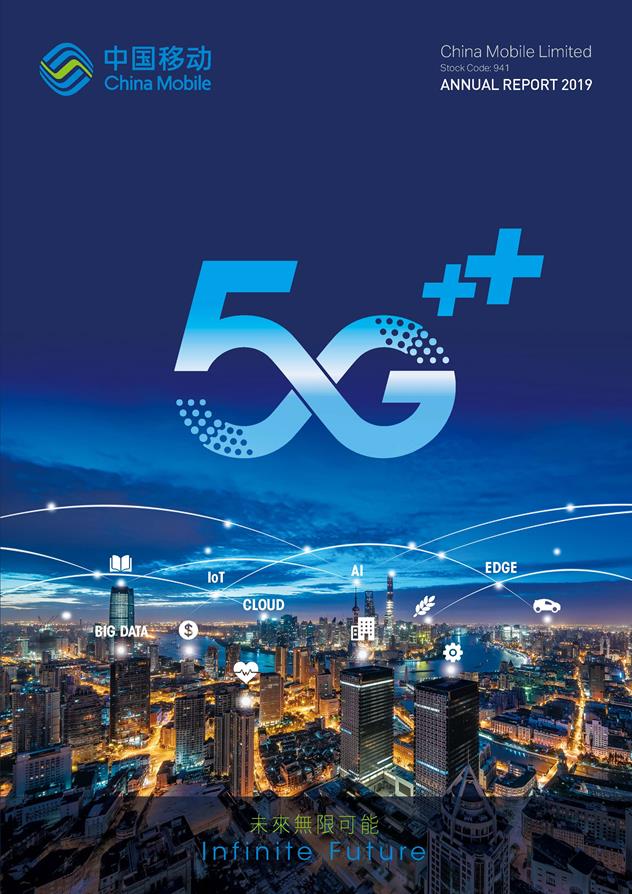
China Mobile Limited Stock Code: 941 ANNUAL REPORT 2019 EDGE AI IoT CLOUD BIG DATA ...... Inf inite Future
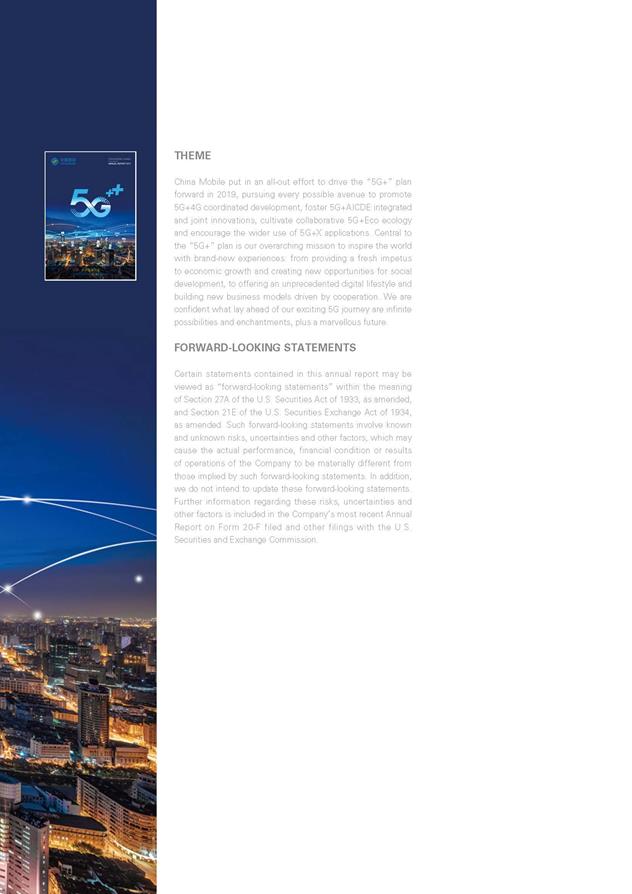
THEME China Mobile put in an all-out effort to drive the “5G+” plan forward in 2019, pursuing every possible avenue to promote 5G+4G coordinated development, foster 5G+AICDE integrated and joint innovations, cultivate collaborative 5G+Eco ecology and encourage the wider use of 5G+X applications. Central to the “5G+” plan is our overarching mission to inspire the world with brand-new experiences: from providing a fresh impetus to economic growth and creating new opportunities for social development, to offering an unprecedented digital lifestyle and building new business models driven by cooperation. We are confident what lay ahead of our exciting 5G journey are infinite possibilities and enchantments, plus a marvellous future. FORWARD-LOOKING STATEMENTS Certain statements contained in this annual report may be viewed as “forward-looking statements” within the meaning of Section 27A of the U.S. Securities Act of 1933, as amended, and Section 21E of the U.S. Securities Exchange Act of 1934, as amended. Such forward-looking statements involve known and unknown risks, uncertainties and other factors, which may cause the actual performance, financial condition or results of operations of the Company to be materially different from those implied by such forward-looking statements. In addition, we do not intend to update these forward-looking statements. Further information regarding these risks, uncertainties and other factors is included in the Company’s most recent Annual Report on Form 20-F filed and other filings with the U.S. Securities and Exchange Commission.
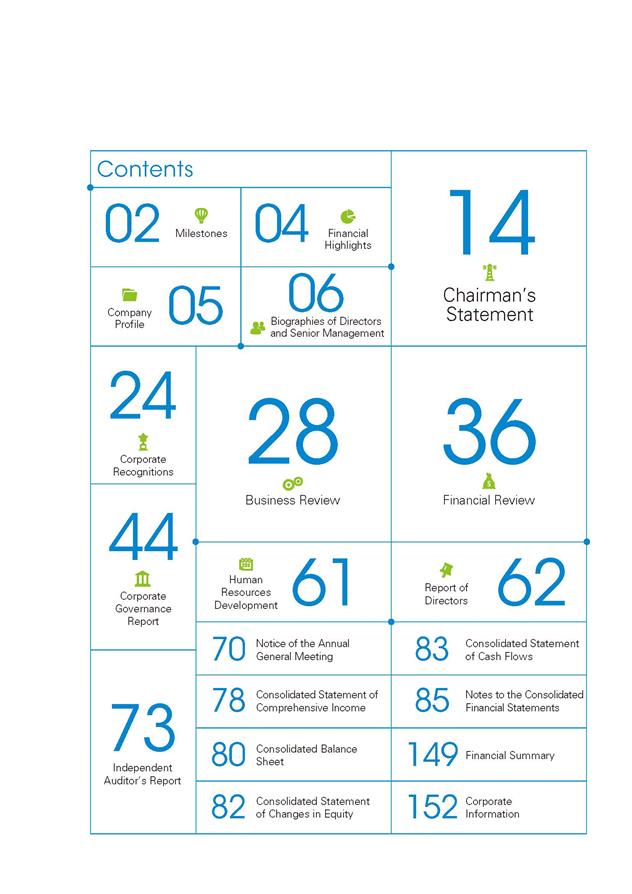
02 04 05 06 6244 70 78 80 152 61 14 Chairman’s Statement Contents Milestones Financial Highlights Biographies of Directors and Senior Management Company Profile 28 Business Review 36 Financial Review Notice of the Annual General Meeting Consolidated Balance Sheet Consolidated Statement of Comprehensive Income 24 Corporate Recognitions Corporate Governance Report 73 Independent Auditor’s Report Report of Directors Human Resources Development Corporate Information 149 Financial Summary 85 Notes to the Consolidated Financial Statements 83 Consolidated Statement of Cash Flows 82 Consolidated Statement of Changes in Equity 14 Chairman’s Statement Contents Milestones Financial Highlights Biographies of Directors and Senior Management Company Profile 28 Business Review 36 Financial Review Notice of the Annual General Meeting Consolidated Balance Sheet Consolidated Statement of Comprehensive Income 24 Corporate Recognitions Corporate Governance Report 73 Independent Auditor’s Report Report of Directors Human Resources Development Corporate Information 149 Financial Summary 85 Notes to the Consolidated Financial Statements 83 Consolidated Statement of Cash Flows 82 Consolidated Statement of Changes in Equity
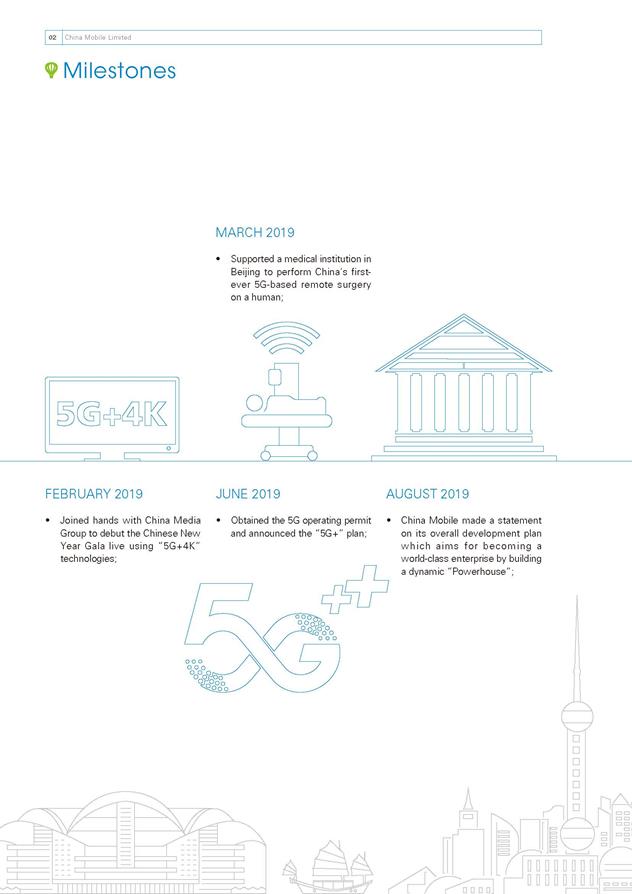
China Mobile Limited02 02 Milestones MARCH 2019 • Supported a medical institution in Beijing to perform China’s first- ever 5G-based remote surgery on a human; FEBRUARY 2019 JUNE 2019 AUGUST 2019 • Joined hands with China Media • Obtained the 5G operating permit • China Mobile made a statement Group to debut the Chinese New and announced the “5G+” plan; on its overall development plan Year Gala live using “5G+4K” which aims for becoming a technologies; world-class enterprise by building a dynamic “Powerhouse”;
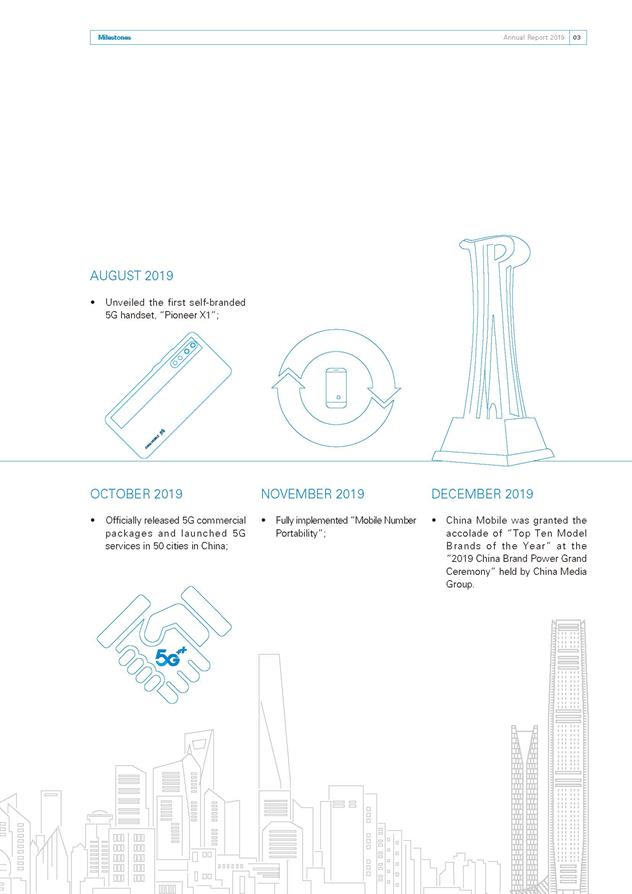
Annual Report 2019 03Milestones 03Milestones AUGUST 2019 • Unveiled the first self-branded 5G handset, “Pioneer X1”; OCTOBER 2019 NOVEMBER 2019 DECEMBER 2019 • Officially released 5G commercial • Fully implemented “Mobile Number • China Mobile was granted the packages and launched 5G Portability”; accolade of “Top Ten Model services in 50 cities in China; Brands of the Year” at the “2019 China Brand Power Grand Ceremony” held by China Media Group.
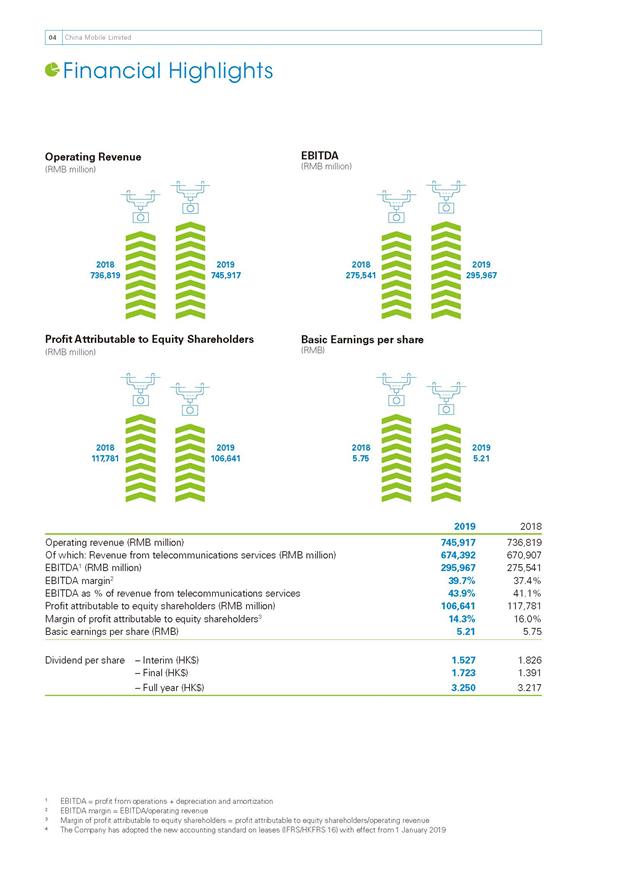
China Mobile Limited04 04 Financial Highlights Operating Revenue EBITDA (RMB million) (RMB million) 2018 2019 2018 2019 736,819 745,917 275,541 295,967 Profit Attributable to Equity Shareholders Basic Earnings per share (RMB million) (RMB) 2018 2019 2018 2019 117,781 106,641 5.75 5.21 2019 2018 Operating revenue (RMB million) 745,917 736,819 Of which: Revenue from telecommunications services (RMB million) 674,392 670,907 EBITDA1 (RMB million) 295,967 275,541 EBITDA margin2 39.7% 37.4% EBITDA as % of revenue from telecommunications services 43.9% 41.1% Profit attributable to equity shareholders (RMB million) 106,641 117,781 Margin of profit attributable to equity shareholders3 14.3% 16.0% Basic earnings per share (RMB) 5.21 5.75 Dividend per share – Interim (HK$) 1.527 1.826 – Final (HK$) 1.723 1.391 – Full year (HK$) 3.250 3.217 1 EBITDA = profit from operations + depreciation and amortization 2 EBITDA margin = EBITDA/operating revenue 3 Margin of profit attributable to equity shareholders = profit attributable to equity shareholders/operating revenue 4 The Company has adopted the new accounting standard on leases (IFRS/HKFRS 16) with effect from 1 January 2019
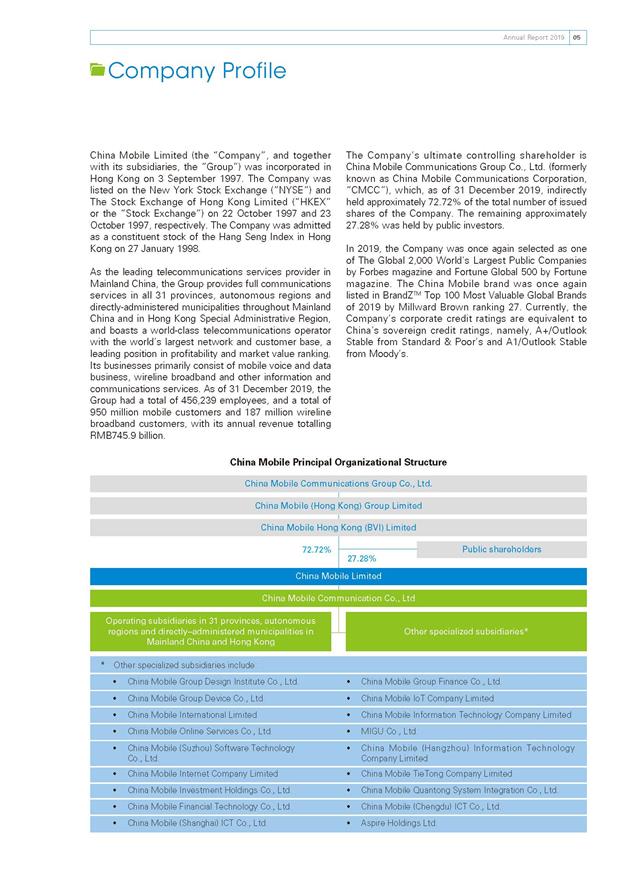
Annual Report 2019 05 05 Company Profile China Mobile Limited (the “Company”, and together with its subsidiaries, the “Group”) was incorporated in Hong Kong on 3 September 1997. The Company was listed on the New York Stock Exchange (“NYSE”) and The Stock Exchange of Hong Kong Limited (“HKEX” or the “Stock Exchange”) on 22 October 1997 and 23 October 1997, respectively. The Company was admitted as a constituent stock of the Hang Seng Index in Hong Kong on 27 January 1998. As the leading telecommunications services provider in Mainland China, the Group provides full communications services in all 31 provinces, autonomous regions and directly-administered municipalities throughout Mainland China and in Hong Kong Special Administrative Region, and boasts a world-class telecommunications operator with the world’s largest network and customer base, a leading position in profitability and market value ranking. Its businesses primarily consist of mobile voice and data business, wireline broadband and other information and communications services. As of 31 December 2019, the Group had a total of 456,239 employees, and a total of 950 million mobile customers and 187 million wireline broadband customers, with its annual revenue totalling RMB745.9 billion. The Company’s ultimate controlling shareholder is China Mobile Communications Group Co., Ltd. (formerly known as China Mobile Communications Corporation, “CMCC”), which, as of 31 December 2019, indirectly held approximately 72.72% of the total number of issued shares of the Company. The remaining approximately 27.28% was held by public investors. In 2019, the Company was once again selected as one of The Global 2,000 World’s Largest Public Companies by Forbes magazine and Fortune Global 500 by Fortune magazine. The China Mobile brand was once again listed in BrandZTM Top 100 Most Valuable Global Brands of 2019 by Millward Brown ranking 27. Currently, the Company’s corporate credit ratings are equivalent to China’s sovereign credit ratings, namely, A+/Outlook Stable from Standard & Poor’s and A1/Outlook Stable from Moody’s. China Mobile Principal Organizational Structure China Mobile Communications Group Co., Ltd. China Mobile (Hong Kong) Group Limited 72.72% 27.28% China Mobile Hong Kong (BVI) Limited China Mobile Limited Public shareholders Operating subsidiaries in 31 provinces, autonomous regions and directly–administered municipalities in Mainland China and Hong Kong Other specialized subsidiaries* China Mobile Communication Co., Ltd * Other specialized subsidiaries include: • China Mobile Group Design Institute Co., Ltd. • China Mobile Group Finance Co., Ltd. • China Mobile Group Device Co., Ltd. • China Mobile IoT Company Limited • China Mobile International Limited • China Mobile Information Technology Company Limited • China Mobile Online Services Co., Ltd. • MIGU Co., Ltd. • China Mobile (Suzhou) Software Technology • China Mobile (Hangzhou) Information Technology Co., Ltd. Company Limited • China Mobile Internet Company Limited • China Mobile TieTong Company Limited • China Mobile Investment Holdings Co., Ltd. • China Mobile Quantong System Integration Co., Ltd. • China Mobile Financial Technology Co., Ltd. • China Mobile (Chengdu) ICT Co., Ltd. • China Mobile (Shanghai) ICT Co., Ltd. • Aspire Holdings Ltd.
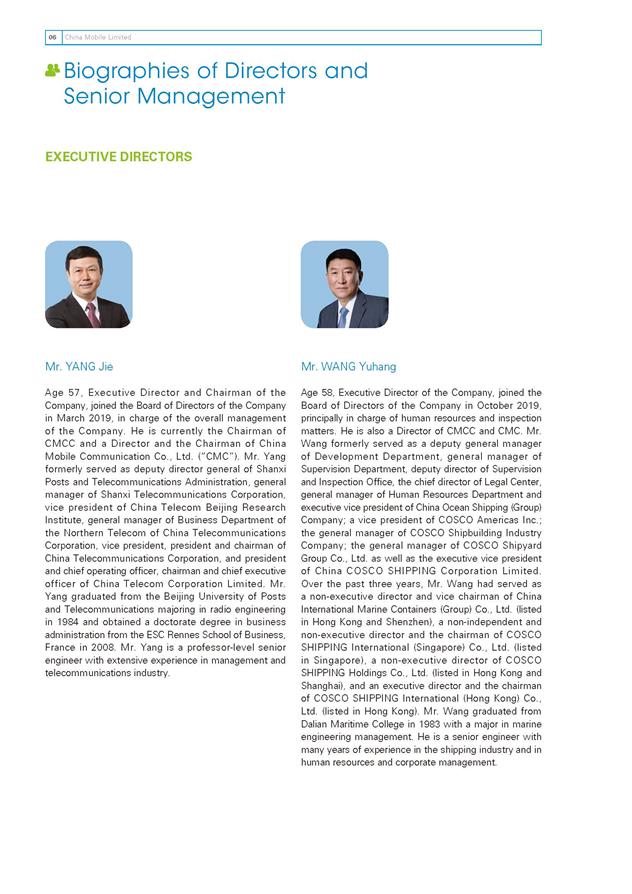
06 06 Biographies of Directors and Senior Management EXECUTIVE DIRECTORS Mr. YANG Jie Age 57, Executive Director and Chairman of the Company, joined the Board of Directors of the Company in March 2019, in charge of the overall management of the Company. He is currently the Chairman of CMCC and a Director and the Chairman of China Mobile Communication Co., Ltd. (“CMC”). Mr. Yang formerly served as deputy director general of Shanxi Posts and Telecommunications Administration, general manager of Shanxi Telecommunications Corporation, vice president of China Telecom Beijing Research Institute, general manager of Business Department of the Northern Telecom of China Telecommunications Corporation, vice president, president and chairman of China Telecommunications Corporation, and president and chief operating officer, chairman and chief executive officer of China Telecom Corporation Limited. Mr. Yang graduated from the Beijing University of Posts and Telecommunications majoring in radio engineering in 1984 and obtained a doctorate degree in business administration from the ESC Rennes School of Business, France in 2008. Mr. Yang is a professor-level senior engineer with extensive experience in management and telecommunications industry. Mr. WANG Yuhang Age 58, Executive Director of the Company, joined the Board of Directors of the Company in October 2019, principally in charge of human resources and inspection matters. He is also a Director of CMCC and CMC. Mr. Wang formerly served as a deputy general manager of Development Department, general manager of Supervision Department, deputy director of Supervision and Inspection Office, the chief director of Legal Center, general manager of Human Resources Department and executive vice president of China Ocean Shipping (Group) Company; a vice president of COSCO Americas Inc.; the general manager of COSCO Shipbuilding Industry Company; the general manager of COSCO Shipyard Group Co., Ltd. as well as the executive vice president of China COSCO SHIPPING Corporation Limited. Over the past three years, Mr. Wang had served as a non-executive director and vice chairman of China International Marine Containers (Group) Co., Ltd. (listed in Hong Kong and Shenzhen), a non-independent and non-executive director and the chairman of COSCO SHIPPING International (Singapore) Co., Ltd. (listed in Singapore), a non-executive director of COSCO SHIPPING Holdings Co., Ltd. (listed in Hong Kong and Shanghai), and an executive director and the chairman of COSCO SHIPPING International (Hong Kong) Co., Ltd. (listed in Hong Kong). Mr. Wang graduated from Dalian Maritime College in 1983 with a major in marine engineering management. He is a senior engineer with many years of experience in the shipping industry and in human resources and corporate management.
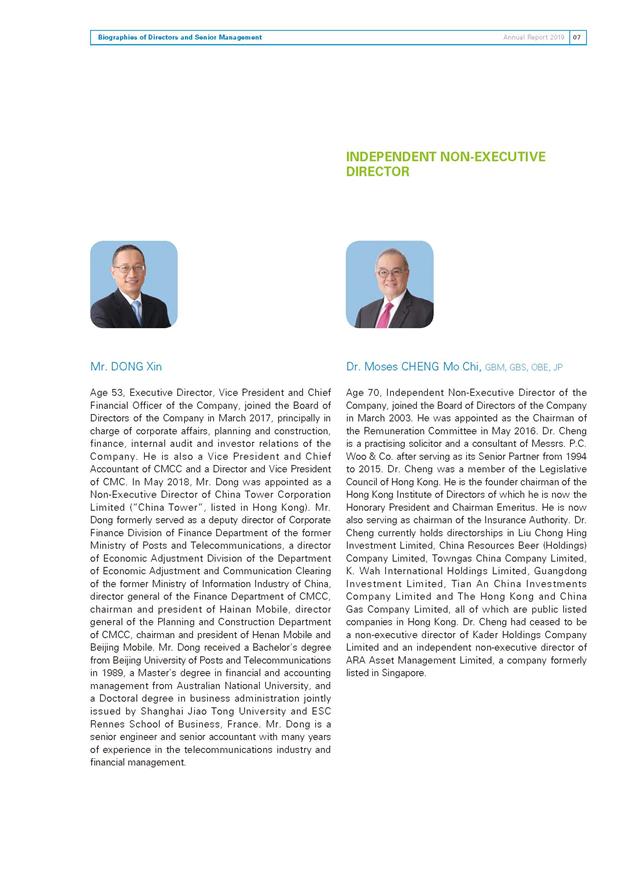
07Biographies of Directors and Senior Management 07Biographies of Directors and Senior Management Mr. DONG Xin Age 53, Executive Director, Vice President and Chief Financial Officer of the Company, joined the Board of Directors of the Company in March 2017, principally in charge of corporate affairs, planning and construction, finance, internal audit and investor relations of the Company. He is also a Vice President and Chief Accountant of CMCC and a Director and Vice President of CMC. In May 2018, Mr. Dong was appointed as a Non-Executive Director of China Tower Corporation Limited (“China Tower”, listed in Hong Kong). Mr. Dong formerly served as a deputy director of Corporate Finance Division of Finance Department of the former Ministry of Posts and Telecommunications, a director of Economic Adjustment Division of the Department of Economic Adjustment and Communication Clearing of the former Ministry of Information Industry of China, director general of the Finance Department of CMCC, chairman and president of Hainan Mobile, director general of the Planning and Construction Department of CMCC, chairman and president of Henan Mobile and Beijing Mobile. Mr. Dong received a Bachelor’s degree from Beijing University of Posts and Telecommunications in 1989, a Master’s degree in financial and accounting management from Australian National University, and a Doctoral degree in business administration jointly issued by Shanghai Jiao Tong University and ESC Rennes School of Business, France. Mr. Dong is a senior engineer and senior accountant with many years of experience in the telecommunications industry and financial management. INDEPENDENT NON-EXECUTIVE DIRECTOR Dr. Moses CHENG Mo Chi, GBM, GBS, OBE, JP Age 70, Independent Non-Executive Director of the Company, joined the Board of Directors of the Company in March 2003. He was appointed as the Chairman of the Remuneration Committee in May 2016. Dr. Cheng is a practising solicitor and a consultant of Messrs. P.C. Woo & Co. after serving as its Senior Partner from 1994 to 2015. Dr. Cheng was a member of the Legislative Council of Hong Kong. He is the founder chairman of the Hong Kong Institute of Directors of which he is now the Honorary President and Chairman Emeritus. He is now also serving as chairman of the Insurance Authority. Dr. Cheng currently holds directorships in Liu Chong Hing Investment Limited, China Resources Beer (Holdings) Company Limited, Towngas China Company Limited, K. Wah International Holdings Limited, Guangdong Investment Limited, Tian An China Investments Company Limited and The Hong Kong and China Gas Company Limited, all of which are public listed companies in Hong Kong. Dr. Cheng had ceased to be a non-executive director of Kader Holdings Company Limited and an independent non-executive director of ARA Asset Management Limited, a company formerly listed in Singapore.
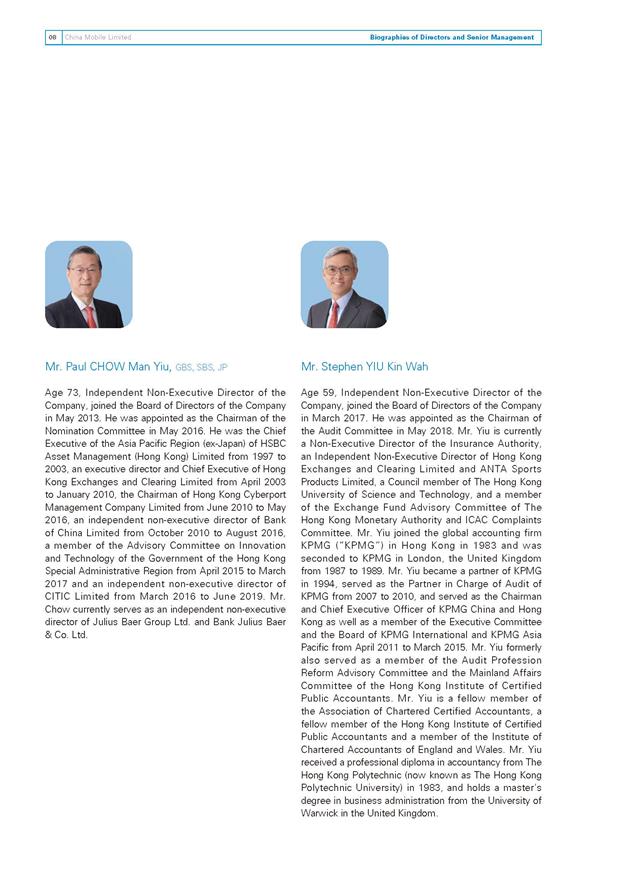
08 Biographies of Directors and Senior Management 08 Biographies of Directors and Senior Management Mr. Paul CHOW Man Yiu, GBS, SBS, JP Age 73, Independent Non-Executive Director of the Company, joined the Board of Directors of the Company in May 2013. He was appointed as the Chairman of the Nomination Committee in May 2016. He was the Chief Executive of the Asia Pacific Region (ex-Japan) of HSBC Asset Management (Hong Kong) Limited from 1997 to 2003, an executive director and Chief Executive of Hong Kong Exchanges and Clearing Limited from April 2003 to January 2010, the Chairman of Hong Kong Cyberport Management Company Limited from June 2010 to May 2016, an independent non-executive director of Bank of China Limited from October 2010 to August 2016, a member of the Advisory Committee on Innovation and Technology of the Government of the Hong Kong Special Administrative Region from April 2015 to March 2017 and an independent non-executive director of CITIC Limited from March 2016 to June 2019. Mr. Chow currently serves as an independent non-executive director of Julius Baer Group Ltd. and Bank Julius Baer & Co. Ltd. Mr. Stephen YIU Kin Wah Age 59, Independent Non-Executive Director of the Company, joined the Board of Directors of the Company in March 2017. He was appointed as the Chairman of the Audit Committee in May 2018. Mr. Yiu is currently a Non-Executive Director of the Insurance Authority, an Independent Non-Executive Director of Hong Kong Exchanges and Clearing Limited and ANTA Sports Products Limited, a Council member of The Hong Kong University of Science and Technology, and a member of the Exchange Fund Advisory Committee of The Hong Kong Monetary Authority and ICAC Complaints Committee. Mr. Yiu joined the global accounting firm KPMG (“KPMG”) in Hong Kong in 1983 and was seconded to KPMG in London, the United Kingdom from 1987 to 1989. Mr. Yiu became a partner of KPMG in 1994, served as the Partner in Charge of Audit of KPMG from 2007 to 2010, and served as the Chairman and Chief Executive Officer of KPMG China and Hong Kong as well as a member of the Executive Committee and the Board of KPMG International and KPMG Asia Pacific from April 2011 to March 2015. Mr. Yiu formerly also served as a member of the Audit Profession Reform Advisory Committee and the Mainland Affairs Committee of the Hong Kong Institute of Certified Public Accountants. Mr. Yiu is a fellow member of the Association of Chartered Certified Accountants, a fellow member of the Hong Kong Institute of Certified Public Accountants and a member of the Institute of Chartered Accountants of England and Wales. Mr. Yiu received a professional diploma in accountancy from The Hong Kong Polytechnic (now known as The Hong Kong Polytechnic University) in 1983, and holds a master’s degree in business administration from the University of Warwick in the United Kingdom.
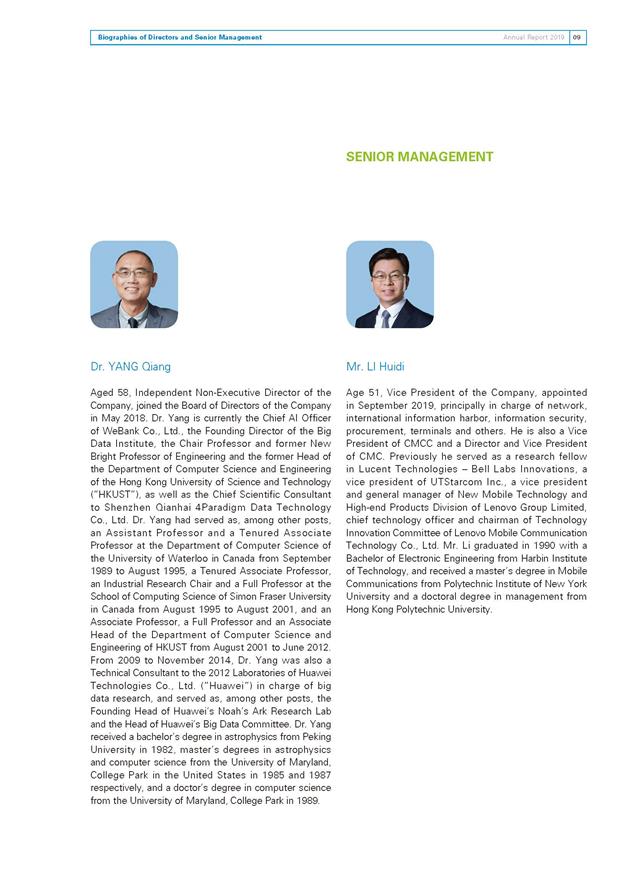
09Biographies of Directors and Senior Management 09Biographies of Directors and Senior Management SENIOR MANAGEMENT Dr. YANG Qiang Aged 58, Independent Non-Executive Director of the Company, joined the Board of Directors of the Company in May 2018. Dr. Yang is currently the Chief AI Officer of WeBank Co., Ltd., the Founding Director of the Big Data Institute, the Chair Professor and former New Bright Professor of Engineering and the former Head of the Department of Computer Science and Engineering of the Hong Kong University of Science and Technology (“HKUST”), as well as the Chief Scientific Consultant to Shenzhen Qianhai 4Paradigm Data Technology Co., Ltd. Dr. Yang had served as, among other posts, an Assistant Professor and a Tenured Associate Professor at the Department of Computer Science of the University of Waterloo in Canada from September 1989 to August 1995, a Tenured Associate Professor, an Industrial Research Chair and a Full Professor at the School of Computing Science of Simon Fraser University in Canada from August 1995 to August 2001, and an Associate Professor, a Full Professor and an Associate Head of the Department of Computer Science and Engineering of HKUST from August 2001 to June 2012. From 2009 to November 2014, Dr. Yang was also a Technical Consultant to the 2012 Laboratories of Huawei Technologies Co., Ltd. (“Huawei”) in charge of big data research, and served as, among other posts, the Founding Head of Huawei’s Noah’s Ark Research Lab and the Head of Huawei’s Big Data Committee. Dr. Yang received a bachelor’s degree in astrophysics from Peking University in 1982, master’s degrees in astrophysics and computer science from the University of Maryland, College Park in the United States in 1985 and 1987 respectively, and a doctor’s degree in computer science from the University of Maryland, College Park in 1989. Mr. LI Huidi Age 51, Vice President of the Company, appointed in September 2019, principally in charge of network, international information harbor, information security, procurement, terminals and others. He is also a Vice President of CMCC and a Director and Vice President of CMC. Previously he served as a research fellow in Lucent Technologies – Bell Labs Innovations, a vice president of UTStarcom Inc., a vice president and general manager of New Mobile Technology and High-end Products Division of Lenovo Group Limited, chief technology officer and chairman of Technology Innovation Committee of Lenovo Mobile Communication Technology Co., Ltd. Mr. Li graduated in 1990 with a Bachelor of Electronic Engineering from Harbin Institute of Technology, and received a master’s degree in Mobile Communications from Polytechnic Institute of New York University and a doctoral degree in management from Hong Kong Polytechnic University.
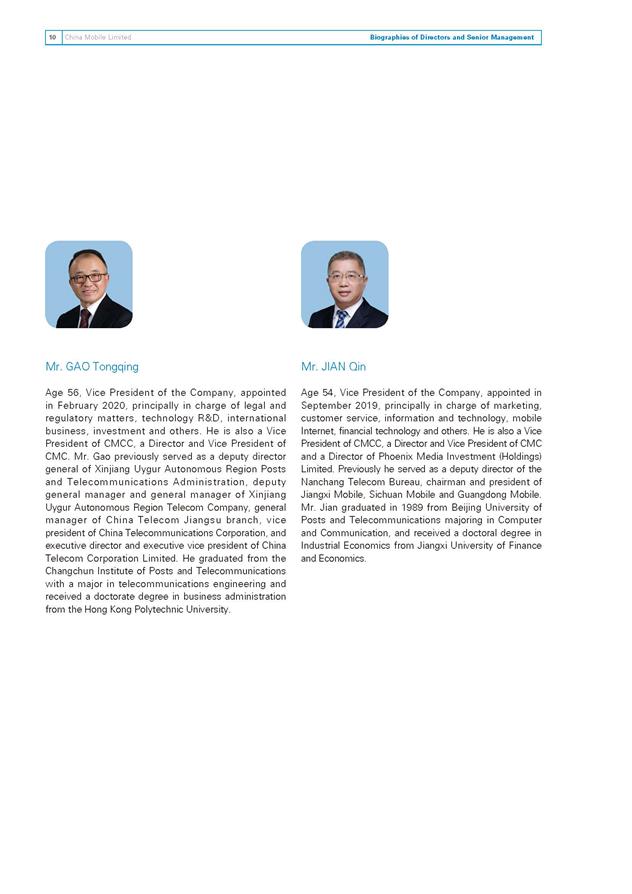
10 Biographies of Directors and Senior Management 10 Biographies of Directors and Senior Management Mr. GAO Tongqing Age 56, Vice President of the Company, appointed in February 2020, principally in charge of legal and regulatory matters, technology R&D, international business, investment and others. He is also a Vice President of CMCC, a Director and Vice President of CMC. Mr. Gao previously served as a deputy director general of Xinjiang Uygur Autonomous Region Posts and Telecommunications Administration, deputy general manager and general manager of Xinjiang Uygur Autonomous Region Telecom Company, general manager of China Telecom Jiangsu branch, vice president of China Telecommunications Corporation, and executive director and executive vice president of China Telecom Corporation Limited. He graduated from the Changchun Institute of Posts and Telecommunications with a major in telecommunications engineering and received a doctorate degree in business administration from the Hong Kong Polytechnic University. Mr. JIAN Qin Age 54, Vice President of the Company, appointed in September 2019, principally in charge of marketing, customer service, information and technology, mobile Internet, financial technology and others. He is also a Vice President of CMCC, a Director and Vice President of CMC and a Director of Phoenix Media Investment (Holdings) Limited. Previously he served as a deputy director of the Nanchang Telecom Bureau, chairman and president of Jiangxi Mobile, Sichuan Mobile and Guangdong Mobile. Mr. Jian graduated in 1989 from Beijing University of Posts and Telecommunications majoring in Computer and Communication, and received a doctoral degree in Industrial Economics from Jiangxi University of Finance and Economics.
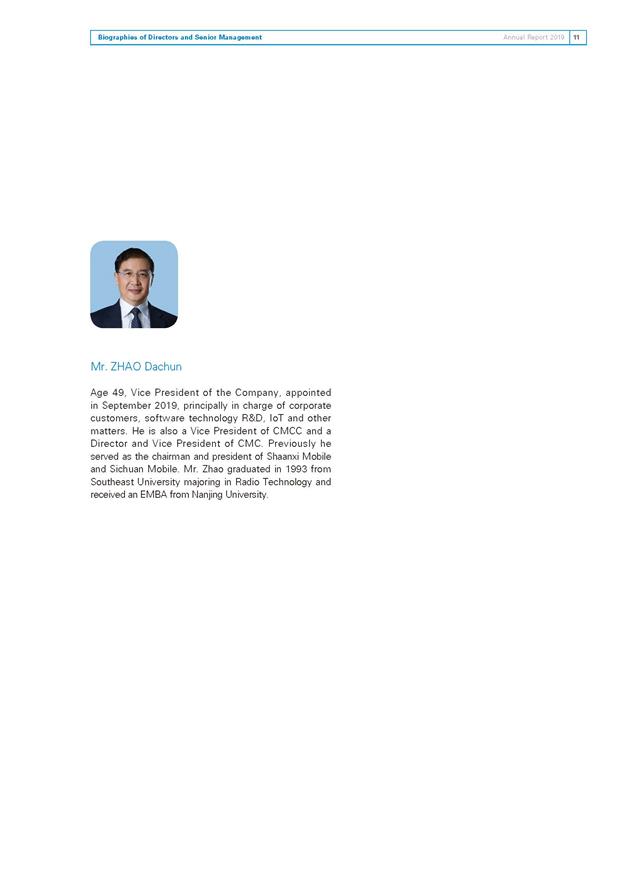
11Biographies of Directors and Senior Management 11Biographies of Directors and Senior Management Mr. ZHAO Dachun Age 49, Vice President of the Company, appointed in September 2019, principally in charge of corporate customers, software technology R&D, IoT and other matters. He is also a Vice President of CMCC and a Director and Vice President of CMC. Previously he served as the chairman and president of Shaanxi Mobile and Sichuan Mobile. Mr. Zhao graduated in 1993 from Southeast University majoring in Radio Technology and received an EMBA from Nanjing University.
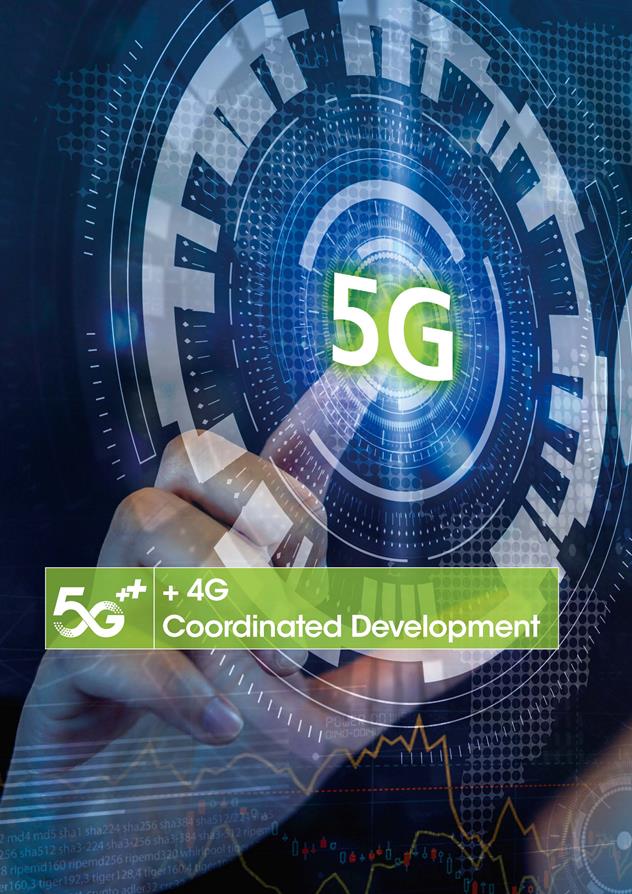
+ 4G Coordinated Development + 4G Coordinated Development

4g 100m 48mph
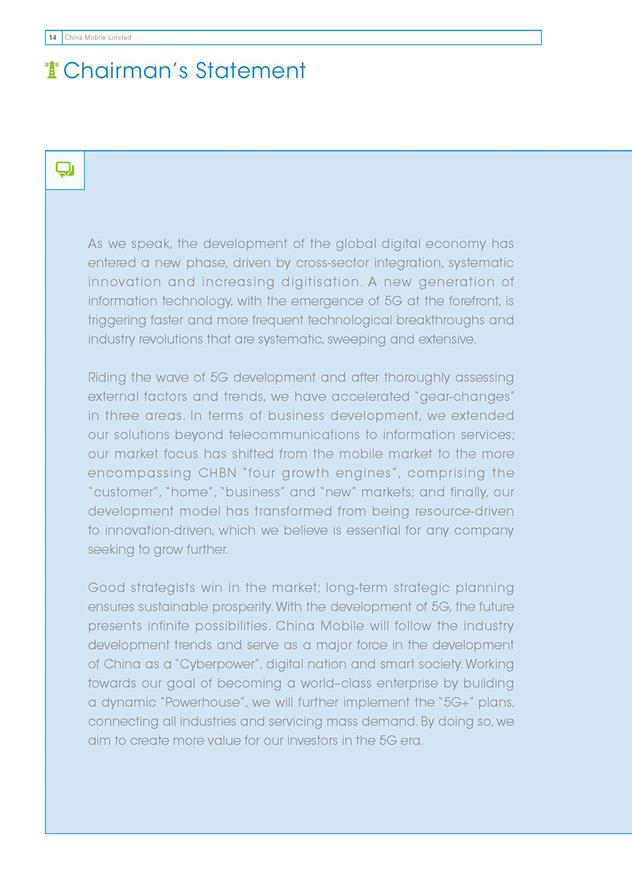
14 14 Chairman’s Statement As we speak, the development of the global digital economy has entered a new phase, driven by cross-sector integration, systematic innovation and increasing digitisation. A new generation of information technology, with the emergence of 5G at the forefront, is triggering faster and more frequent technological breakthroughs and industry revolutions that are systematic, sweeping and extensive. Riding the wave of 5G development and after thoroughly assessing external factors and trends, we have accelerated “gear-changes” in three areas. In terms of business development, we extended our solutions beyond telecommunications to information services; our market focus has shifted from the mobile market to the more encompassing CHBN “four growth engines”, comprising the “customer”, “home”, “business” and “new” markets; and finally, our development model has transformed from being resource-driven to innovation-driven, which we believe is essential for any company seeking to grow further. Good strategists win in the market; long-term strategic planning ensures sustainable prosperity. With the development of 5G, the future presents infinite possibilities. China Mobile will follow the industry development trends and serve as a major force in the development of China as a “Cyberpower”, digital nation and smart society. Working towards our goal of becoming a world–class enterprise by building a dynamic “Powerhouse”, we will further implement the “5G+” plans, connecting all industries and servicing mass demand. By doing so, we aim to create more value for our investors in the 5G era.
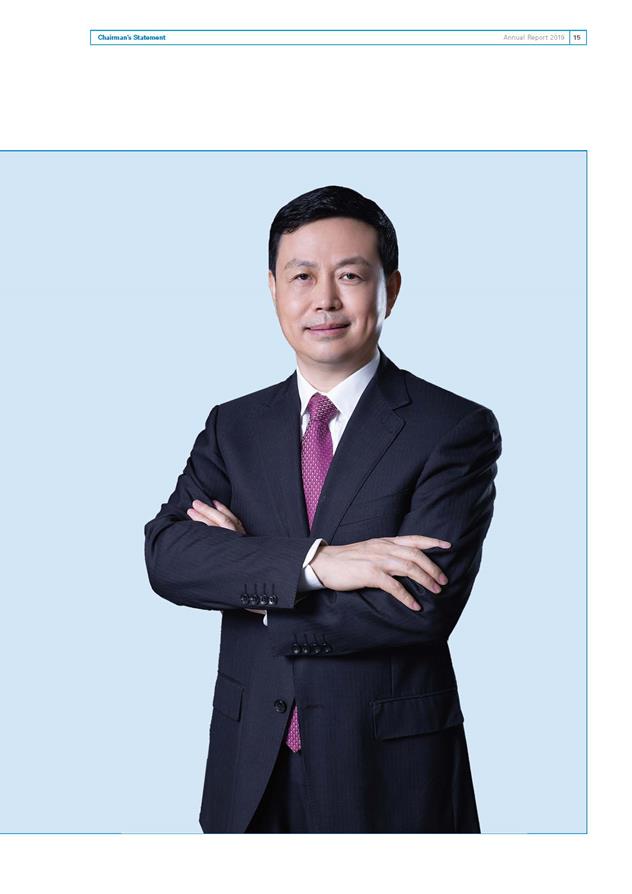
15Chairman’s Statement 15Chairman’s Statement
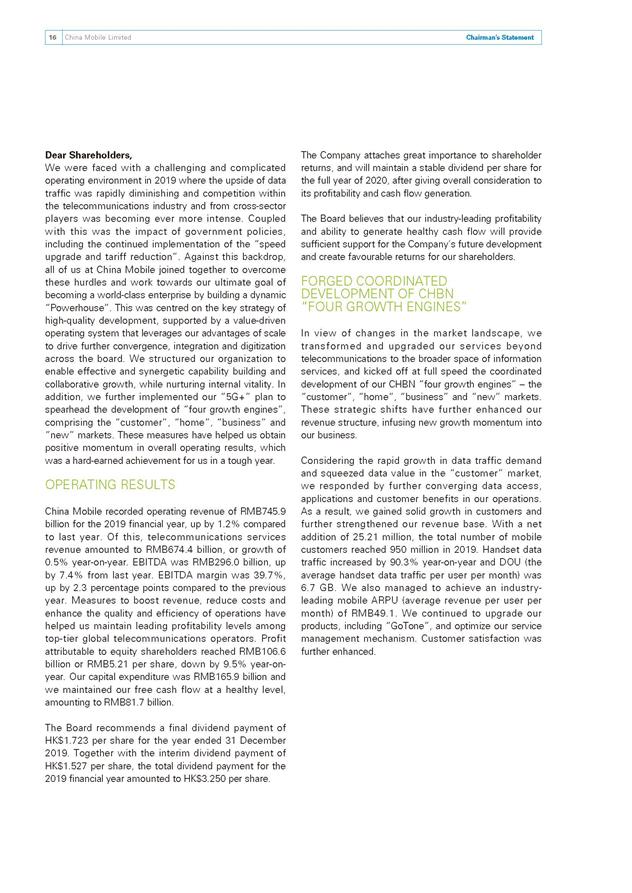
China Mobile Limited16 Chairman’s Statement 16 Chairman’s Statement Dear Shareholders, We were faced with a challenging and complicated operating environment in 2019 where the upside of data traffic was rapidly diminishing and competition within the telecommunications industry and from cross-sector players was becoming ever more intense. Coupled with this was the impact of government policies, including the continued implementation of the “speed upgrade and tariff reduction”. Against this backdrop, all of us at China Mobile joined together to overcome these hurdles and work towards our ultimate goal of becoming a world-class enterprise by building a dynamic “Powerhouse”. This was centred on the key strategy of high-quality development, supported by a value-driven operating system that leverages our advantages of scale to drive further convergence, integration and digitization across the board. We structured our organization to enable effective and synergetic capability building and collaborative growth, while nurturing internal vitality. In addition, we further implemented our “5G+” plan to spearhead the development of “four growth engines”, comprising the “customer”, “home”, “business” and “new” markets. These measures have helped us obtain positive momentum in overall operating results, which was a hard-earned achievement for us in a tough year. OPERATING RESULTS China Mobile recorded operating revenue of RMB745.9 billion for the 2019 financial year, up by 1.2% compared to last year. Of this, telecommunications services revenue amounted to RMB674.4 billion, or growth of 0.5% year-on-year. EBITDA was RMB296.0 billion, up by 7.4% from last year. EBITDA margin was 39.7%, up by 2.3 percentage points compared to the previous year. Measures to boost revenue, reduce costs and enhance the quality and efficiency of operations have helped us maintain leading profitability levels among top-tier global telecommunications operators. Profit attributable to equity shareholders reached RMB106.6 billion or RMB5.21 per share, down by 9.5% year-onyear. Our capital expenditure was RMB165.9 billion and we maintained our free cash flow at a healthy level, amounting to RMB81.7 billion. The Board recommends a final dividend payment of HK$1.723 per share for the year ended 31 December 2019. Together with the interim dividend payment of HK$1.527 per share, the total dividend payment for the 2019 financial year amounted to HK$3.250 per share. The Company attaches great importance to shareholder returns, and will maintain a stable dividend per share for the full year of 2020, after giving overall consideration to its profitability and cash flow generation. The Board believes that our industry-leading profitability and ability to generate healthy cash flow will provide sufficient support for the Company’s future development and create favourable returns for our shareholders. FORGED COORDINATED DEVELOPMENT OF CHBN “FOUR GROWTH ENGINES” In view of changes in the market landscape, we transformed and upgraded our services beyond telecommunications to the broader space of information services, and kicked off at full speed the coordinated development of our CHBN “four growth engines” – the “customer”, “home”, “business” and “new” markets. These strategic shifts have further enhanced our revenue structure, infusing new growth momentum into our business. Considering the rapid growth in data traffic demand and squeezed data value in the “customer” market, we responded by further converging data access, applications and customer benefits in our operations. As a result, we gained solid growth in customers and further strengthened our revenue base. With a net addition of 25.21 million, the total number of mobile customers reached 950 million in 2019. Handset data traffic increased by 90.3% year-on-year and DOU (the average handset data traffic per user per month) was 6.7 GB. We also managed to achieve an industry- leading mobile ARPU (average revenue per user per month) of RMB49.1. We continued to upgrade our products, including “GoTone”, and optimize our service management mechanism. Customer satisfaction was further enhanced.

Annual Report 2019 17Chairman’s Statement 17Chairman’s Statement With regard to the “home” market, we focused our efforts on scale expansion, brand building, ecology cultivation and value lifting, while delivering better one- stop marketing, installation, maintenance and customer services. We further promoted smart family operations and as a result, this business was able to deliver strong growth. The number of household broadband customers increased by 17.1% year-on-year and reached 172 million. Among them, our digital set-top box “Mobaihe” registered a total of 122 million customers, representing a penetration rate of 70.9%. Meanwhile, household broadband blended ARPU reached RMB35.3. The “business” market was our new growth engine and we strove to nurture new growth points by fully leveraging our cloud and network convergence advantages, building on our DICT (data, information and communications technology) infrastructure comprising IDC, ICT, Mobile Cloud, big data and other corporate applications and information services. Buoyed by our active promotion of our “Network + Cloud + DICT” smart services, customers and revenue recorded rapid growth. As of the end of 2019, the number of our corporate customers increased to 10.28 million, representing year-on-year growth of 43.2%. Focusing on key sectors such as industry, agriculture, education, public administration, healthcare, transportation and finance, we deepened go-to-market resources to promote DICT solutions that cater to sector-specific scenarios. This strategy has boosted DICT revenue to RMB26.1 billion, or growth of 48.3% year-on-year, contributing a larger portion of our overall revenue. In the “new” market, we continued to grow four new areas – international business, equity investment, digital content and FinTech. Our increased efforts have generated initial results. In 2019, our international business gained traction with year-on-year revenue growth of 31.4%. Centring on the principles of value contribution, ecosystem formation and investment- derived sector synergy, we have increased efforts to pursue equity investment, and income from equity investment contributed 11.9% to our net profit. Monthly active users for “MIGU Video” and the core functions of “and-Wallet” increased by 46.4% and 58.9% year-onyear respectively.
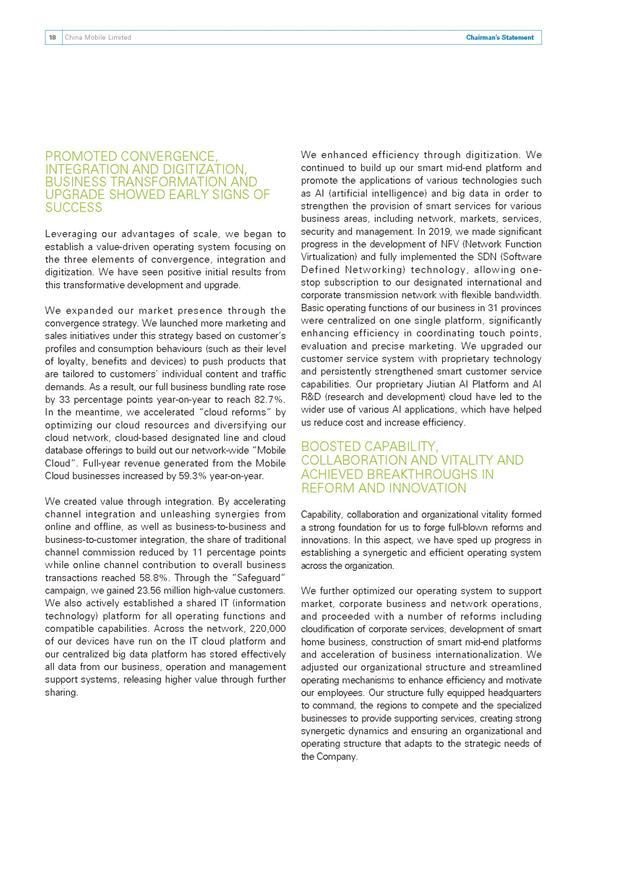
China Mobile Limited18 Chairman’s Statement 18 Chairman’s Statement PROMOTED CONVERGENCE, INTEGRATION AND DIGITIZATION, BUSINESS TRANSFORMATION AND UPGRADE SHOWED EARLY SIGNS OF SUCCESS Leveraging our advantages of scale, we began to establish a value-driven operating system focusing on the three elements of convergence, integration and digitization. We have seen positive initial results from this transformative development and upgrade. We expanded our market presence through the convergence strategy. We launched more marketing and sales initiatives under this strategy based on customer’s profiles and consumption behaviours (such as their level of loyalty, benefits and devices) to push products that are tailored to customers’ individual content and traffic demands. As a result, our full business bundling rate rose by 33 percentage points year-on-year to reach 82.7%. In the meantime, we accelerated “cloud reforms” by optimizing our cloud resources and diversifying our cloud network, cloud-based designated line and cloud database offerings to build out our network-wide “Mobile Cloud”. Full-year revenue generated from the Mobile Cloud businesses increased by 59.3% year-on-year. We created value through integration. By accelerating channel integration and unleashing synergies from online and offline, as well as business-to-business and business-to-customer integration, the share of traditional channel commission reduced by 11 percentage points while online channel contribution to overall business transactions reached 58.8%. Through the “Safeguard” campaign, we gained 23.56 million high-value customers. We also actively established a shared IT (information technology) platform for all operating functions and compatible capabilities. Across the network, 220,000 of our devices have run on the IT cloud platform and our centralized big data platform has stored effectively all data from our business, operation and management support systems, releasing higher value through further sharing. We enhanced efficiency through digitization. We continued to build up our smart mid-end platform and promote the applications of various technologies such as AI (artificial intelligence) and big data in order to strengthen the provision of smart services for various business areas, including network, markets, services, security and management. In 2019, we made significant progress in the development of NFV (Network Function Virtualization) and fully implemented the SDN (Software Defined Networking) technology, allowing one- stop subscription to our designated international and corporate transmission network with flexible bandwidth. Basic operating functions of our business in 31 provinces were centralized on one single platform, significantly enhancing efficiency in coordinating touch points, evaluation and precise marketing. We upgraded our customer service system with proprietary technology and persistently strengthened smart customer service capabilities. Our proprietary Jiutian AI Platform and AI R&D (research and development) cloud have led to the wider use of various AI applications, which have helped us reduce cost and increase efficiency. BOOSTED CAPABILITY, COLLABORATION AND VITALITY AND ACHIEVED BREAKTHROUGHS IN REFORM AND INNOVATION Capability, collaboration and organizational vitality formed a strong foundation for us to forge full-blown reforms and innovations. In this aspect, we have sped up progress in establishing a synergetic and efficient operating system across the organization. We further optimized our operating system to support market, corporate business and network operations, and proceeded with a number of reforms including cloudification of corporate services, development of smart home business, construction of smart mid-end platforms and acceleration of business internationalization. We adjusted our organizational structure and streamlined operating mechanisms to enhance efficiency and motivate our employees. Our structure fully equipped headquarters to command, the regions to compete and the specialized businesses to provide supporting services, creating strong synergetic dynamics and ensuring an organizational and operating structure that adapts to the strategic needs of the Company.
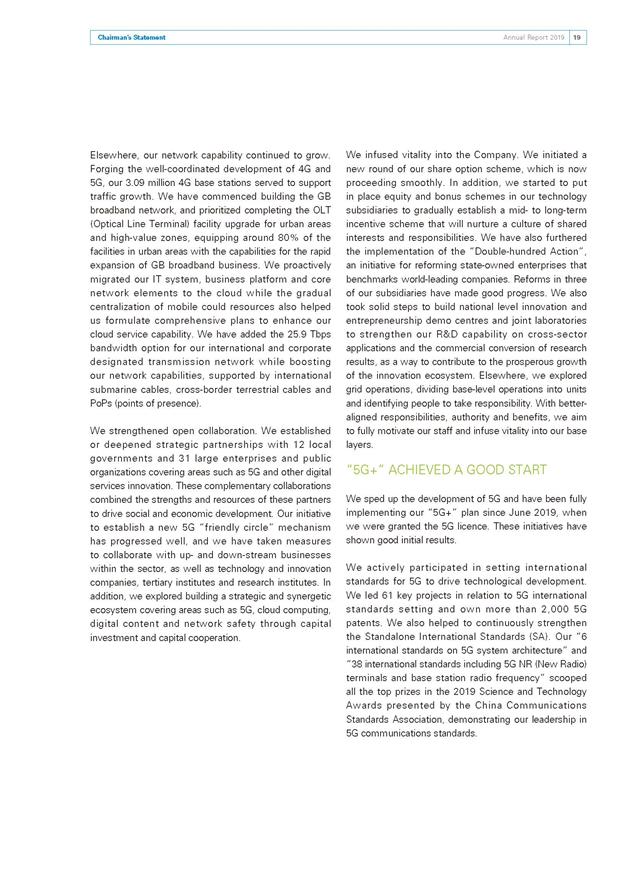
Annual Report 2019 19Chairman’s Statement 19Chairman’s Statement Elsewhere, our network capability continued to grow. Forging the well-coordinated development of 4G and 5G, our 3.09 million 4G base stations served to support traffic growth. We have commenced building the GB broadband network, and prioritized completing the OLT (Optical Line Terminal) facility upgrade for urban areas and high-value zones, equipping around 80% of the facilities in urban areas with the capabilities for the rapid expansion of GB broadband business. We proactively migrated our IT system, business platform and core network elements to the cloud while the gradual centralization of mobile could resources also helped us formulate comprehensive plans to enhance our cloud service capability. We have added the 25.9 Tbps bandwidth option for our international and corporate designated transmission network while boosting our network capabilities, supported by international submarine cables, cross-border terrestrial cables and PoPs (points of presence). We strengthened open collaboration. We established or deepened strategic partnerships with 12 local governments and 31 large enterprises and public organizations covering areas such as 5G and other digital services innovation. These complementary collaborations combined the strengths and resources of these partners to drive social and economic development. Our initiative to establish a new 5G “friendly circle” mechanism has progressed well, and we have taken measures to collaborate with up- and down-stream businesses within the sector, as well as technology and innovation companies, tertiary institutes and research institutes. In addition, we explored building a strategic and synergetic ecosystem covering areas such as 5G, cloud computing, digital content and network safety through capital investment and capital cooperation. We infused vitality into the Company. We initiated a new round of our share option scheme, which is now proceeding smoothly. In addition, we started to put in place equity and bonus schemes in our technology subsidiaries to gradually establish a mid- to long-term incentive scheme that will nurture a culture of shared interests and responsibilities. We have also furthered the implementation of the “Double-hundred Action”, an initiative for reforming state-owned enterprises that benchmarks world-leading companies. Reforms in three of our subsidiaries have made good progress. We also took solid steps to build national level innovation and entrepreneurship demo centres and joint laboratories to strengthen our R&D capability on cross-sector applications and the commercial conversion of research results, as a way to contribute to the prosperous growth of the innovation ecosystem. Elsewhere, we explored grid operations, dividing base-level operations into units and identifying people to take responsibility. With better- aligned responsibilities, authority and benefits, we aim to fully motivate our staff and infuse vitality into our base layers. “5G+” ACHIEVED A GOOD START We sped up the development of 5G and have been fully implementing our “5G+” plan since June 2019, when we were granted the 5G licence. These initiatives have shown good initial results. We actively participated in setting international standards for 5G to drive technological development. We led 61 key projects in relation to 5G international standards setting and own more than 2,000 5G patents. We also helped to continuously strengthen the Standalone International Standards (SA). Our “6 international standards on 5G system architecture” and “38 international standards including 5G NR (New Radio) terminals and base station radio frequency” scooped all the top prizes in the 2019 Science and Technology Awards presented by the China Communications Standards Association, demonstrating our leadership in 5G communications standards.
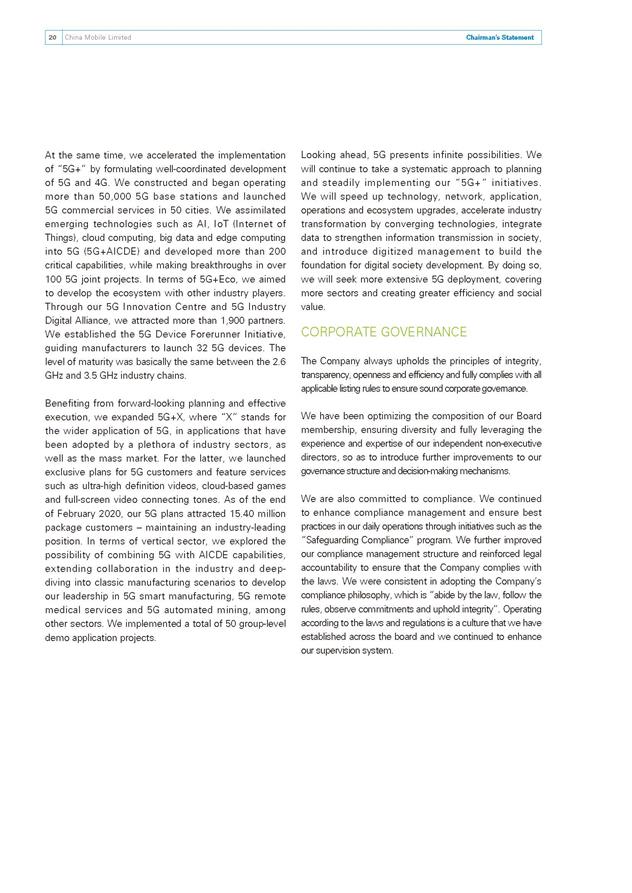
China Mobile Limited20 Chairman’s Statement 20 Chairman’s Statement At the same time, we accelerated the implementation of “5G+” by formulating well-coordinated development of 5G and 4G. We constructed and began operating more than 50,000 5G base stations and launched 5G commercial services in 50 cities. We assimilated emerging technologies such as AI, IoT (Internet of Things), cloud computing, big data and edge computing into 5G (5G+AICDE) and developed more than 200 critical capabilities, while making breakthroughs in over 100 5G joint projects. In terms of 5G+Eco, we aimed to develop the ecosystem with other industry players. Through our 5G Innovation Centre and 5G Industry Digital Alliance, we attracted more than 1,900 partners. We established the 5G Device Forerunner Initiative, guiding manufacturers to launch 32 5G devices. The level of maturity was basically the same between the 2.6 GHz and 3.5 GHz industry chains. Benefiting from forward-looking planning and effective execution, we expanded 5G+X, where “X” stands for the wider application of 5G, in applications that have been adopted by a plethora of industry sectors, as well as the mass market. For the latter, we launched exclusive plans for 5G customers and feature services such as ultra-high definition videos, cloud-based games and full-screen video connecting tones. As of the end of February 2020, our 5G plans attracted 15.40 million package customers – maintaining an industry-leading position. In terms of vertical sector, we explored the possibility of combining 5G with AICDE capabilities, extending collaboration in the industry and deep- diving into classic manufacturing scenarios to develop our leadership in 5G smart manufacturing, 5G remote medical services and 5G automated mining, among other sectors. We implemented a total of 50 group-level demo application projects. Looking ahead, 5G presents infinite possibilities. We will continue to take a systematic approach to planning and steadily implementing our “5G+” initiatives. We will speed up technology, network, application, operations and ecosystem upgrades, accelerate industry transformation by converging technologies, integrate data to strengthen information transmission in society, and introduce digitized management to build the foundation for digital society development. By doing so, we will seek more extensive 5G deployment, covering more sectors and creating greater efficiency and social value. CORPORATE GOVERNANCE The Company always upholds the principles of integrity, transparency, openness and efficiency and fully complies with all applicable listing rules to ensure sound corporate governance. We have been optimizing the composition of our Board membership, ensuring diversity and fully leveraging the experience and expertise of our independent non-executive directors, so as to introduce further improvements to our governance structure and decision-making mechanisms. We are also committed to compliance. We continued to enhance compliance management and ensure best practices in our daily operations through initiatives such as the “Safeguarding Compliance” program. We further improved our compliance management structure and reinforced legal accountability to ensure that the Company complies with the laws. We were consistent in adopting the Company’s compliance philosophy, which is “abide by the law, follow the rules, observe commitments and uphold integrity”. Operating according to the laws and regulations is a culture that we have established across the board and we continued to enhance our supervision system.
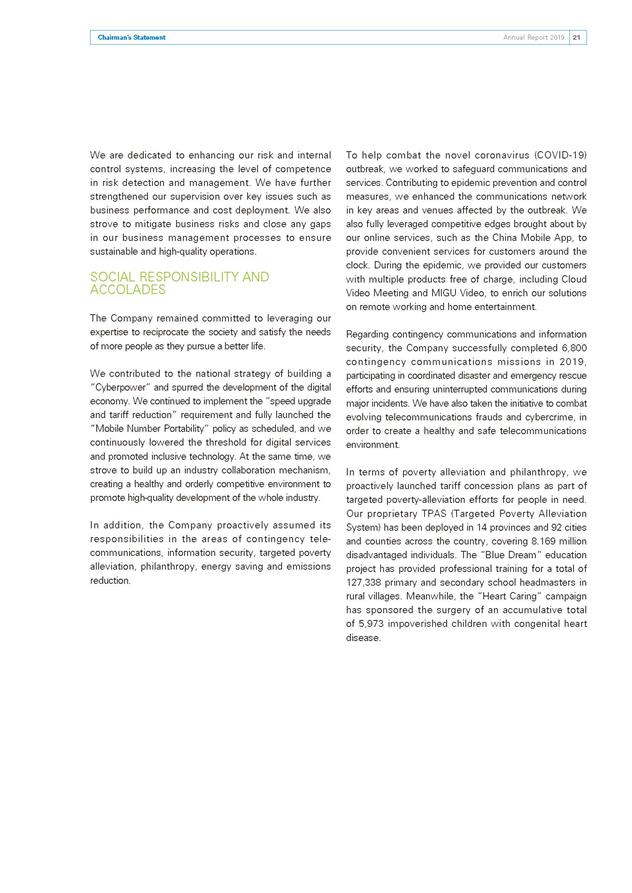
Annual Report 2019 21Chairman’s Statement 21Chairman’s Statement We are dedicated to enhancing our risk and internal control systems, increasing the level of competence in risk detection and management. We have further strengthened our supervision over key issues such as business performance and cost deployment. We also strove to mitigate business risks and close any gaps in our business management processes to ensure sustainable and high-quality operations. SOCIAL RESPONSIBILITY AND ACCOLADES The Company remained committed to leveraging our expertise to reciprocate the society and satisfy the needs of more people as they pursue a better life. We contributed to the national strategy of building a “Cyberpower” and spurred the development of the digital economy. We continued to implement the “speed upgrade and tariff reduction” requirement and fully launched the “Mobile Number Portability” policy as scheduled, and we continuously lowered the threshold for digital services and promoted inclusive technology. At the same time, we strove to build up an industry collaboration mechanism, creating a healthy and orderly competitive environment to promote high-quality development of the whole industry. In addition, the Company proactively assumed its responsibilities in the areas of contingency telecommunications, information security, targeted poverty alleviation, philanthropy, energy saving and emissions reduction. To help combat the novel coronavirus (COVID-19) outbreak, we worked to safeguard communications and services. Contributing to epidemic prevention and control measures, we enhanced the communications network in key areas and venues affected by the outbreak. We also fully leveraged competitive edges brought about by our online services, such as the China Mobile App, to provide convenient services for customers around the clock. During the epidemic, we provided our customers with multiple products free of charge, including Cloud Video Meeting and MIGU Video, to enrich our solutions on remote working and home entertainment. Regarding contingency communications and information security, the Company successfully completed 6,800 contingency communications missions in 2019, participating in coordinated disaster and emergency rescue efforts and ensuring uninterrupted communications during major incidents. We have also taken the initiative to combat evolving telecommunications frauds and cybercrime, in order to create a healthy and safe telecommunications environment. In terms of poverty alleviation and philanthropy, we proactively launched tariff concession plans as part of targeted poverty-alleviation efforts for people in need. Our proprietary TPAS (Targeted Poverty Alleviation System) has been deployed in 14 provinces and 92 cities and counties across the country, covering 8.169 million disadvantaged individuals. The “Blue Dream” education project has provided professional training for a total of 127,338 primary and secondary school headmasters in rural villages. Meanwhile, the “Heart Caring” campaign has sponsored the surgery of an accumulative total of 5,973 impoverished children with congenital heart disease.
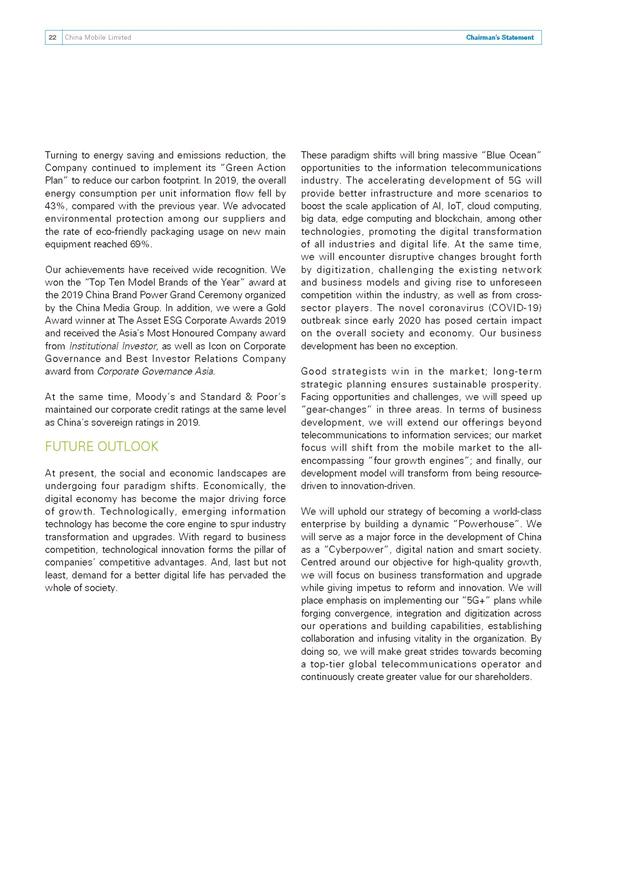
China Mobile Limited22 Chairman’s Statement 22 Chairman’s Statement Turning to energy saving and emissions reduction, the Company continued to implement its “Green Action Plan” to reduce our carbon footprint. In 2019, the overall energy consumption per unit information flow fell by 43%, compared with the previous year. We advocated environmental protection among our suppliers and the rate of eco-friendly packaging usage on new main equipment reached 69%. Our achievements have received wide recognition. We won the “Top Ten Model Brands of the Year” award at the 2019 China Brand Power Grand Ceremony organized by the China Media Group. In addition, we were a Gold Award winner at The Asset ESG Corporate Awards 2019 and received the Asia’s Most Honoured Company award from Institutional Investor, as well as Icon on Corporate Governance and Best Investor Relations Company award from Corporate Governance Asia. At the same time, Moody’s and Standard & Poor’s maintained our corporate credit ratings at the same level as China’s sovereign ratings in 2019. FUTURE OUTLOOK At present, the social and economic landscapes are undergoing four paradigm shifts. Economically, the digital economy has become the major driving force of growth. Technologically, emerging information technology has become the core engine to spur industry transformation and upgrades. With regard to business competition, technological innovation forms the pillar of companies’ competitive advantages. And, last but not least, demand for a better digital life has pervaded the whole of society. These paradigm shifts will bring massive “Blue Ocean” opportunities to the information telecommunications industry. The accelerating development of 5G will provide better infrastructure and more scenarios to boost the scale application of AI, IoT, cloud computing, big data, edge computing and blockchain, among other technologies, promoting the digital transformation of all industries and digital life. At the same time, we will encounter disruptive changes brought forth by digitization, challenging the existing network and business models and giving rise to unforeseen competition within the industry, as well as from cross- sector players. The novel coronavirus (COVID-19) outbreak since early 2020 has posed certain impact on the overall society and economy. Our business development has been no exception. Good strategists win in the market; long-term strategic planning ensures sustainable prosperity. Facing opportunities and challenges, we will speed up “gear-changes” in three areas. In terms of business development, we will extend our offerings beyond telecommunications to information services; our market focus will shift from the mobile market to the all- encompassing “four growth engines”; and finally, our development model will transform from being resource- driven to innovation-driven. We will uphold our strategy of becoming a world-class enterprise by building a dynamic “Powerhouse”. We will serve as a major force in the development of China as a “Cyberpower”, digital nation and smart society. Centred around our objective for high-quality growth, we will focus on business transformation and upgrade while giving impetus to reform and innovation. We will place emphasis on implementing our “5G+” plans while forging convergence, integration and digitization across our operations and building capabilities, establishing collaboration and infusing vitality in the organization. By doing so, we will make great strides towards becoming a top-tier global telecommunications operator and continuously create greater value for our shareholders.
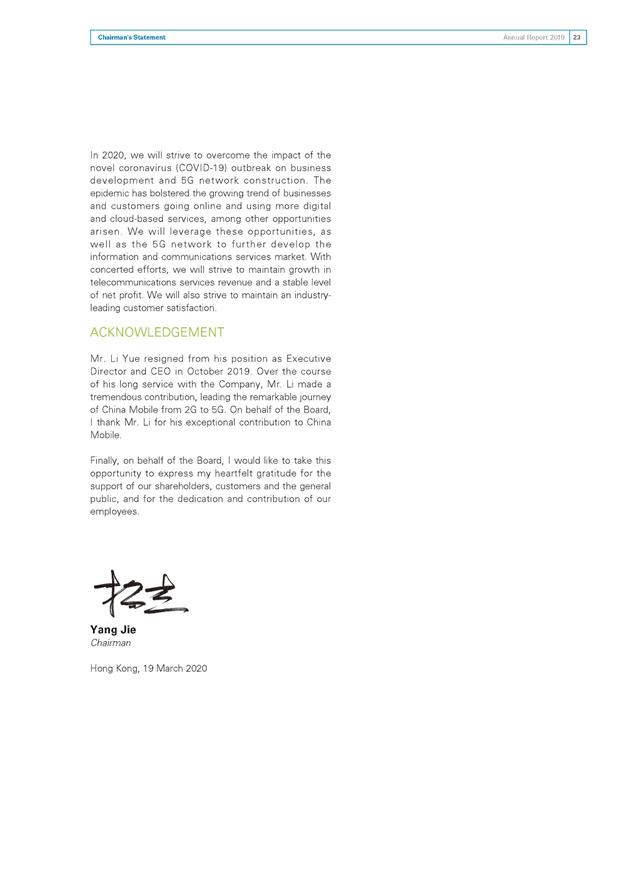
Annual Report 2019 23Chairman’s Statement 23Chairman’s Statement In 2020, we will strive to overcome the impact of the novel coronavirus (COVID-19) outbreak on business development and 5G network construction. The epidemic has bolstered the growing trend of businesses and customers going online and using more digital and cloud-based services, among other opportunities arisen. We will leverage these opportunities, as well as the 5G network to further develop the information and communications services market. With concerted efforts, we will strive to maintain growth in telecommunications services revenue and a stable level of net profit. We will also strive to maintain an industry- leading customer satisfaction. ACKNOWLEDGEMENT Mr. Li Yue resigned from his position as Executive Director and CEO in October 2019. Over the course of his long service with the Company, Mr. Li made a tremendous contribution, leading the remarkable journey of China Mobile from 2G to 5G. On behalf of the Board, I thank Mr. Li for his exceptional contribution to China Mobile. Finally, on behalf of the Board, I would like to take this opportunity to express my heartfelt gratitude for the support of our shareholders, customers and the general public, and for the dedication and contribution of our employees. Yang Jie Chairman Hong Kong, 19 March 2020
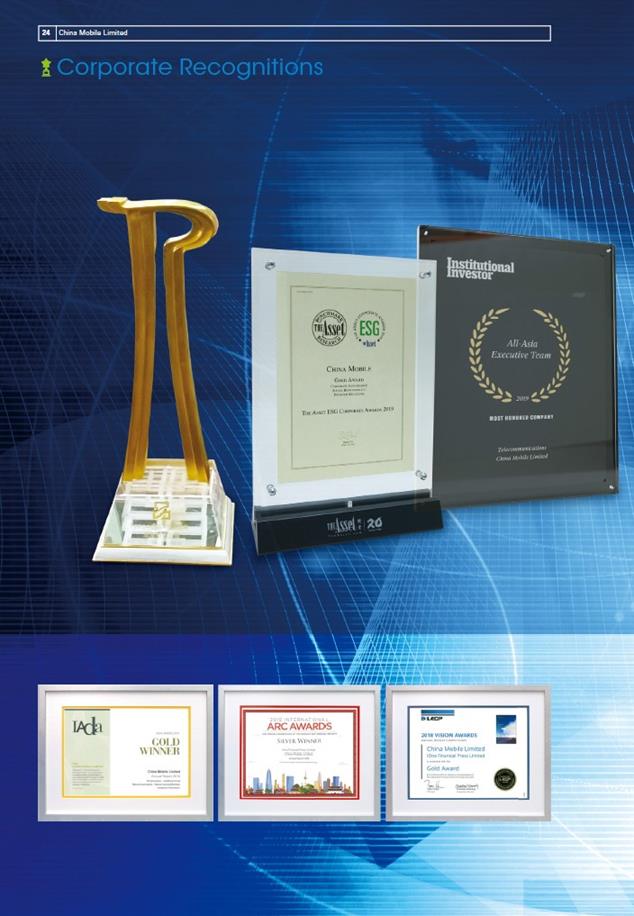
24 China Mobile Limited Corporate Recognitions INSTITUTIONAL INVESTOR ALL ASIA GOLD WINNER ARC AWARDS GOLD AWARD
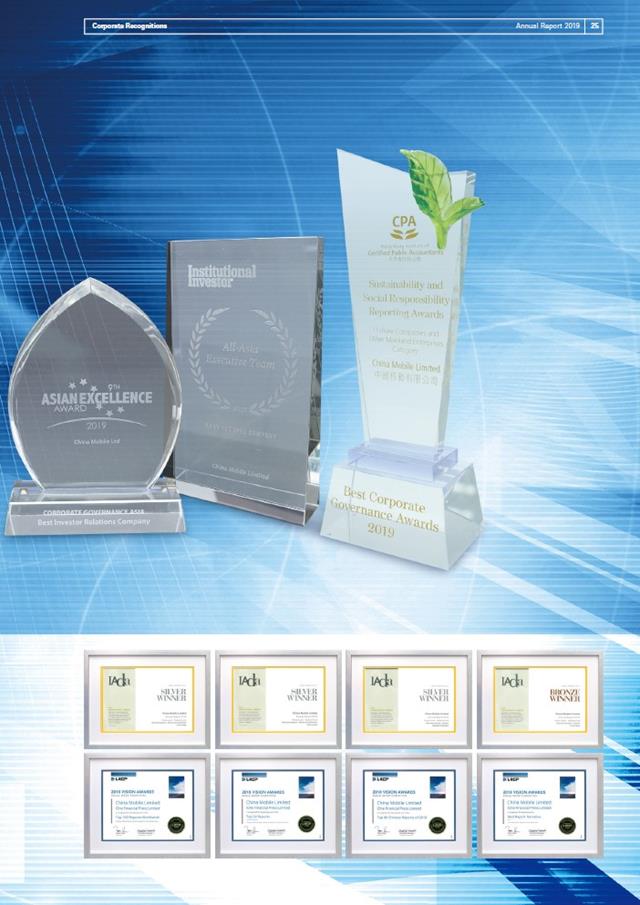
Institional invester cpa BEST CORPORATE GOVERNANCE AWARDS 2019 GOLD WINNER ASIAN EXCELLENCE AWARD 2019

Corporate Recognitions Annual Report 2019 25 Big data lot

+ AICDE Integrated Innovations + AICDE AI EDGE CLOUD Integrated Innovations
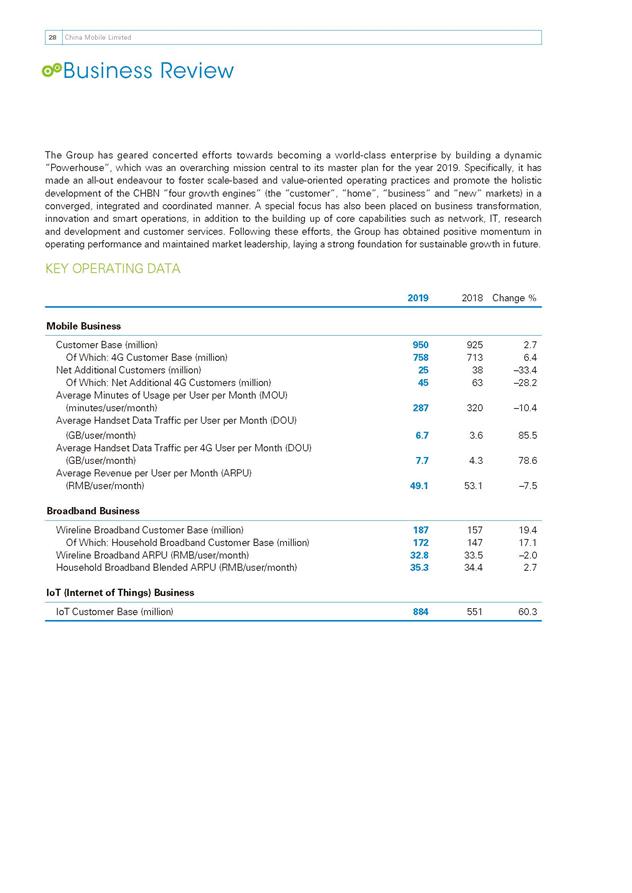
China Mobile Limited28 28 Business Review The Group has geared concerted efforts towards becoming a world-class enterprise by building a dynamic “Powerhouse”, which was an overarching mission central to its master plan for the year 2019. Specifically, it has made an all-out endeavour to foster scale-based and value-oriented operating practices and promote the holistic development of the CHBN “four growth engines” (the “customer”, “home”, “business” and “new” markets) in a converged, integrated and coordinated manner. A special focus has also been placed on business transformation, innovation and smart operations, in addition to the building up of core capabilities such as network, IT, research and development and customer services. Following these efforts, the Group has obtained positive momentum in operating performance and maintained market leadership, laying a strong foundation for sustainable growth in future. KEY OPERATING DATA 2019 2018 Change % Mobile Business Customer Base (million) 950 925 2.7 Of Which: 4G Customer Base (million) 758 713 6.4 Net Additional Customers (million) 25 38 –33.4 Of Which: Net Additional 4G Customers (million) 45 63 –28.2 Average Minutes of Usage per User per Month (MOU) (minutes/user/month) 287 320 –10.4 Average Handset Data Traffic per User per Month (DOU) (GB/user/month) 6.7 3.6 85.5 Average Handset Data Traffic per 4G User per Month (DOU) (GB/user/month) 7.7 4.3 78.6 Average Revenue per User per Month (ARPU) (RMB/user/month) 49.1 53.1 –7.5 Broadband Business Wireline Broadband Customer Base (million) 187 157 19.4 Of Which: Household Broadband Customer Base (million) 172 147 17.1 Wireline Broadband ARPU (RMB/user/month) 32.8 33.5 –2.0 Household Broadband Blended ARPU (RMB/user/month) 35.3 34.4 2.7 IoT (Internet of Things) Business IoT Customer Base (million) 884 551 60.3
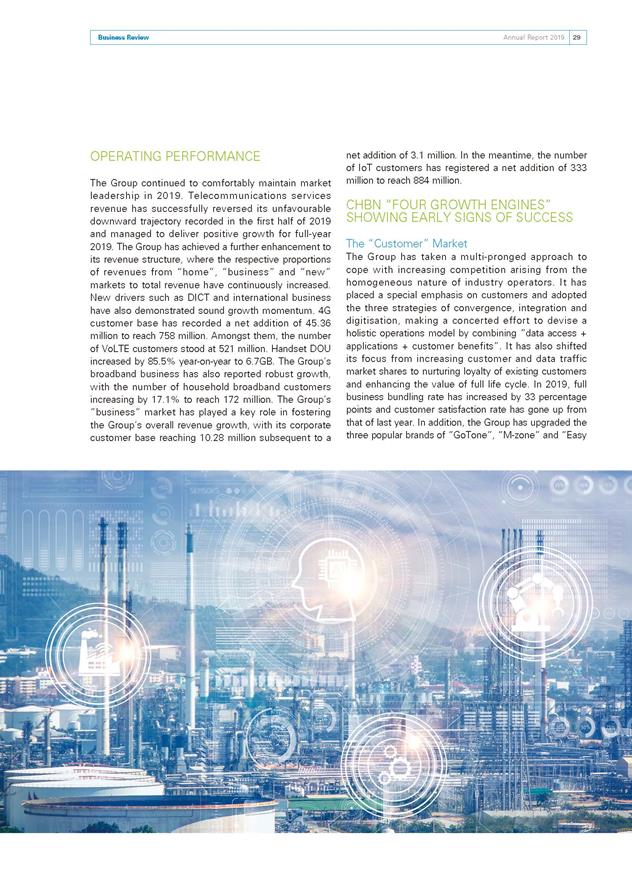
Annual Report 2019 29Business Review 29Business Review OPERATING PERFORMANCE The Group continued to comfortably maintain market leadership in 2019. Telecommunications services revenue has successfully reversed its unfavourable downward trajectory recorded in the first half of 2019 and managed to deliver positive growth for full-year 2019. The Group has achieved a further enhancement to its revenue structure, where the respective proportions of revenues from “home”, “business” and “new” markets to total revenue have continuously increased. New drivers such as DICT and international business have also demonstrated sound growth momentum. 4G customer base has recorded a net addition of 45.36 million to reach 758 million. Amongst them, the number of VoLTE customers stood at 521 million. Handset DOU increased by 85.5% year-on-year to 6.7GB. The Group’s broadband business has also reported robust growth, with the number of household broadband customers increasing by 17.1% to reach 172 million. The Group’s “business” market has played a key role in fostering the Group’s overall revenue growth, with its corporate customer base reaching 10.28 million subsequent to a net addition of 3.1 million. In the meantime, the number of IoT customers has registered a net addition of 333 million to reach 884 million. CHBN “FOUR GROWTH ENGINES” SHOWING EARLY SIGNS OF SUCCESS The “Customer” Market The Group has taken a multi-pronged approach to cope with increasing competition arising from the homogeneous nature of industry operators. It has placed a special emphasis on customers and adopted the three strategies of convergence, integration and digitisation, making a concerted effort to devise a holistic operations model by combining “data access + applications + customer benefits”. It has also shifted its focus from increasing customer and data traffic market shares to nurturing loyalty of existing customers and enhancing the value of full life cycle. In 2019, full business bundling rate has increased by 33 percentage points and customer satisfaction rate has gone up from that of last year. In addition, the Group has upgraded the three popular brands of “GoTone”, “M-zone” and “Easy
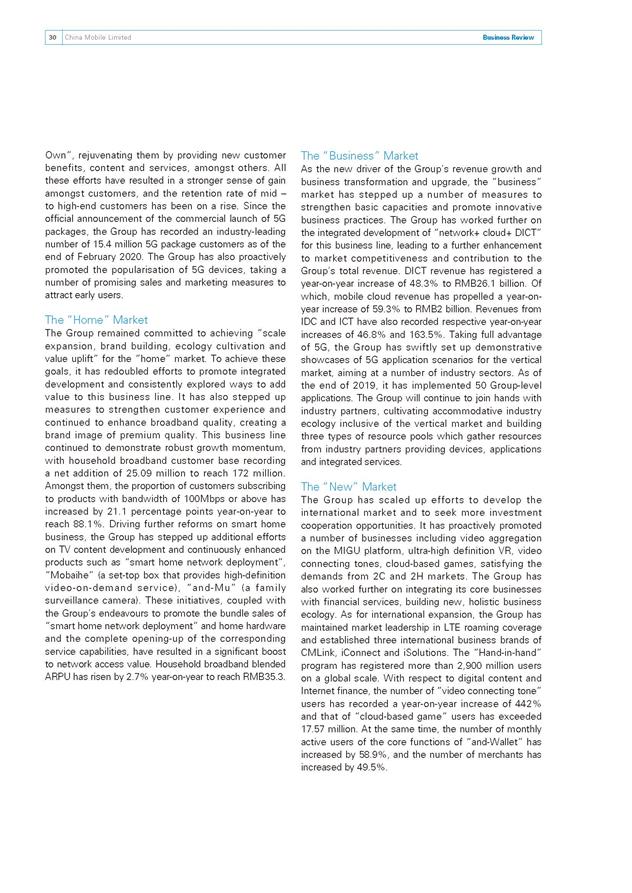
China Mobile Limited30 Business Review 30 Business Review Own”, rejuvenating them by providing new customer benefits, content and services, amongst others. All these efforts have resulted in a stronger sense of gain amongst customers, and the retention rate of mid – to high-end customers has been on a rise. Since the official announcement of the commercial launch of 5G packages, the Group has recorded an industry-leading number of 15.4 million 5G package customers as of the end of February 2020. The Group has also proactively promoted the popularisation of 5G devices, taking a number of promising sales and marketing measures to attract early users. The “Home” Market The Group remained committed to achieving “scale expansion, brand building, ecology cultivation and value uplift” for the “home” market. To achieve these goals, it has redoubled efforts to promote integrated development and consistently explored ways to add value to this business line. It has also stepped up measures to strengthen customer experience and continued to enhance broadband quality, creating a brand image of premium quality. This business line continued to demonstrate robust growth momentum, with household broadband customer base recording a net addition of 25.09 million to reach 172 million. Amongst them, the proportion of customers subscribing to products with bandwidth of 100Mbps or above has increased by 21.1 percentage points year-on-year to reach 88.1%. Driving further reforms on smart home business, the Group has stepped up additional efforts on TV content development and continuously enhanced products such as “smart home network deployment”, “Mobaihe” (a set-top box that provides high-definition video-on-demand service), “and-Mu” (a family surveillance camera). These initiatives, coupled with the Group’s endeavours to promote the bundle sales of “smart home network deployment” and home hardware and the complete opening-up of the corresponding service capabilities, have resulted in a significant boost to network access value. Household broadband blended ARPU has risen by 2.7% year-on-year to reach RMB35.3. The “Business” Market As the new driver of the Group’s revenue growth and business transformation and upgrade, the “business” market has stepped up a number of measures to strengthen basic capacities and promote innovative business practices. The Group has worked further on the integrated development of “network+ cloud+ DICT” for this business line, leading to a further enhancement to market competitiveness and contribution to the Group’s total revenue. DICT revenue has registered a year-on-year increase of 48.3% to RMB26.1 billion. Of which, mobile cloud revenue has propelled a year-onyear increase of 59.3% to RMB2 billion. Revenues from IDC and ICT have also recorded respective year-on-year increases of 46.8% and 163.5%. Taking full advantage of 5G, the Group has swiftly set up demonstrative showcases of 5G application scenarios for the vertical market, aiming at a number of industry sectors. As of the end of 2019, it has implemented 50 Group-level applications. The Group will continue to join hands with industry partners, cultivating accommodative industry ecology inclusive of the vertical market and building three types of resource pools which gather resources from industry partners providing devices, applications and integrated services. The “New” Market The Group has scaled up efforts to develop the international market and to seek more investment cooperation opportunities. It has proactively promoted a number of businesses including video aggregation on the MIGU platform, ultra-high definition VR, video connecting tones, cloud-based games, satisfying the demands from 2C and 2H markets. The Group has also worked further on integrating its core businesses with financial services, building new, holistic business ecology. As for international expansion, the Group has maintained market leadership in LTE roaming coverage and established three international business brands of CMLink, iConnect and iSolutions. The “Hand-in-hand” program has registered more than 2,900 million users on a global scale. With respect to digital content and Internet finance, the number of “video connecting tone” users has recorded a year-on-year increase of 442% and that of “cloud-based game” users has exceeded 17.57 million. At the same time, the number of monthly active users of the core functions of “and-Wallet” has increased by 58.9%, and the number of merchants has increased by 49.5%.
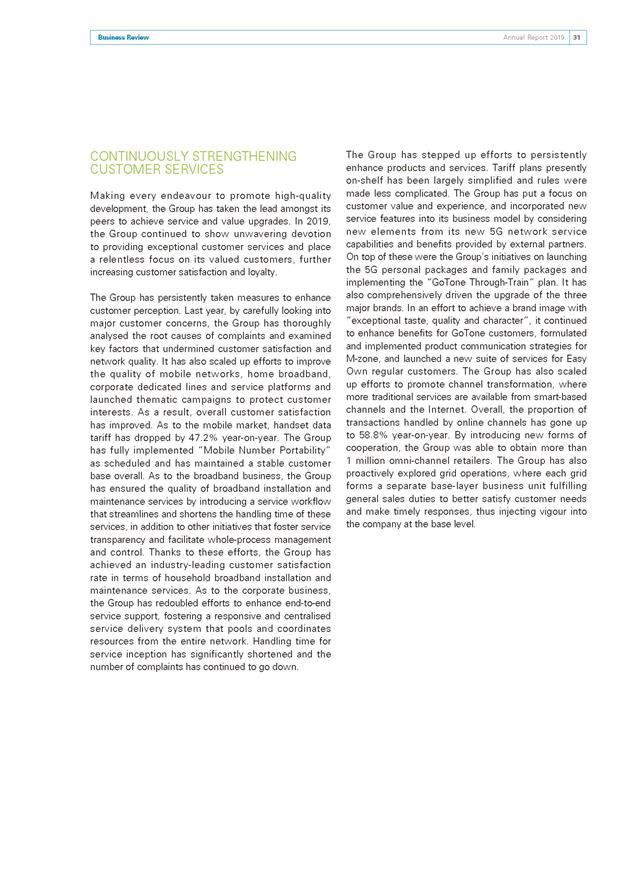
Annual Report 2019 31Business Review 31Business Review CONTINUOUSLY STRENGTHENING CUSTOMER SERVICES Making every endeavour to promote high-quality development, the Group has taken the lead amongst its peers to achieve service and value upgrades. In 2019, the Group continued to show unwavering devotion to providing exceptional customer services and place a relentless focus on its valued customers, further increasing customer satisfaction and loyalty. The Group has persistently taken measures to enhance customer perception. Last year, by carefully looking into major customer concerns, the Group has thoroughly analysed the root causes of complaints and examined key factors that undermined customer satisfaction and network quality. It has also scaled up efforts to improve the quality of mobile networks, home broadband, corporate dedicated lines and service platforms and launched thematic campaigns to protect customer interests. As a result, overall customer satisfaction has improved. As to the mobile market, handset data tariff has dropped by 47.2% year-on-year. The Group has fully implemented “Mobile Number Portability” as scheduled and has maintained a stable customer base overall. As to the broadband business, the Group has ensured the quality of broadband installation and maintenance services by introducing a service workflow that streamlines and shortens the handling time of these services, in addition to other initiatives that foster service transparency and facilitate whole-process management and control. Thanks to these efforts, the Group has achieved an industry-leading customer satisfaction rate in terms of household broadband installation and maintenance services. As to the corporate business, the Group has redoubled efforts to enhance end-to-end service support, fostering a responsive and centralised service delivery system that pools and coordinates resources from the entire network. Handling time for service inception has significantly shortened and the number of complaints has continued to go down. The Group has stepped up efforts to persistently enhance products and services. Tariff plans presently on-shelf has been largely simplified and rules were made less complicated. The Group has put a focus on customer value and experience, and incorporated new service features into its business model by considering new elements from its new 5G network service capabilities and benefits provided by external partners. On top of these were the Group’s initiatives on launching the 5G personal packages and family packages and implementing the “GoTone Through-Train” plan. It has also comprehensively driven the upgrade of the three major brands. In an effort to achieve a brand image with “exceptional taste, quality and character”, it continued to enhance benefits for GoTone customers, formulated and implemented product communication strategies for M-zone, and launched a new suite of services for Easy Own regular customers. The Group has also scaled up efforts to promote channel transformation, where more traditional services are available from smart-based channels and the Internet. Overall, the proportion of transactions handled by online channels has gone up to 58.8% year-on-year. By introducing new forms of cooperation, the Group was able to obtain more than 1 million omni-channel retailers. The Group has also proactively explored grid operations, where each grid forms a separate base-layer business unit fulfilling general sales duties to better satisfy customer needs and make timely responses, thus injecting vigour into the company at the base level.
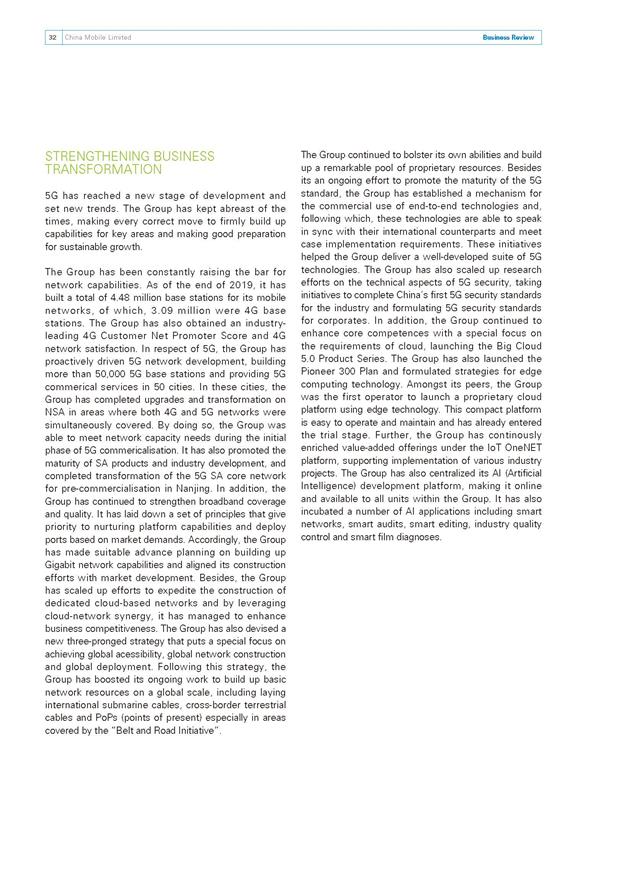
China Mobile Limited32 Business Review 32 Business Review STRENGTHENING BUSINESS TRANSFORMATION 5G has reached a new stage of development and set new trends. The Group has kept abreast of the times, making every correct move to firmly build up capabilities for key areas and making good preparation for sustainable growth. The Group has been constantly raising the bar for network capabilities. As of the end of 2019, it has built a total of 4.48 million base stations for its mobile networks, of which, 3.09 million were 4G base stations. The Group has also obtained an industry- leading 4G Customer Net Promoter Score and 4G network satisfaction. In respect of 5G, the Group has proactively driven 5G network development, building more than 50,000 5G base stations and providing 5G commerical services in 50 cities. In these cities, the Group has completed upgrades and transformation on NSA in areas where both 4G and 5G networks were simultaneously covered. By doing so, the Group was able to meet network capacity needs during the initial phase of 5G commericalisation. It has also promoted the maturity of SA products and industry development, and completed transformation of the 5G SA core network for pre-commercialisation in Nanjing. In addition, the Group has continued to strengthen broadband coverage and quality. It has laid down a set of principles that give priority to nurturing platform capabilities and deploy ports based on market demands. Accordingly, the Group has made suitable advance planning on building up Gigabit network capabilities and aligned its construction efforts with market development. Besides, the Group has scaled up efforts to expedite the construction of dedicated cloud-based networks and by leveraging cloud-network synergy, it has managed to enhance business competitiveness. The Group has also devised a new three-pronged strategy that puts a special focus on achieving global acessibility, global network construction and global deployment. Following this strategy, the Group has boosted its ongoing work to build up basic network resources on a global scale, including laying international submarine cables, cross-border terrestrial cables and PoPs (points of present) especially in areas covered by the “Belt and Road Initiative”. The Group continued to bolster its own abilities and build up a remarkable pool of proprietary resources. Besides its an ongoing effort to promote the maturity of the 5G standard, the Group has established a mechanism for the commercial use of end-to-end technologies and, following which, these technologies are able to speak in sync with their international counterparts and meet case implementation requirements. These initiatives helped the Group deliver a well-developed suite of 5G technologies. The Group has also scaled up research efforts on the technical aspects of 5G security, taking initiatives to complete China’s first 5G security standards for the industry and formulating 5G security standards for corporates. In addition, the Group continued to enhance core competences with a special focus on the requirements of cloud, launching the Big Cloud 5.0 Product Series. The Group has also launched the Pioneer 300 Plan and formulated strategies for edge computing technology. Amongst its peers, the Group was the first operator to launch a proprietary cloud platform using edge technology. This compact platform is easy to operate and maintain and has already entered the trial stage. Further, the Group has continously enriched value-added offerings under the IoT OneNET platform, supporting implementation of various industry projects. The Group has also centralized its AI (Artificial Intelligence) development platform, making it online and available to all units within the Group. It has also incubated a number of AI applications including smart networks, smart audits, smart editing, industry quality control and smart film diagnoses.
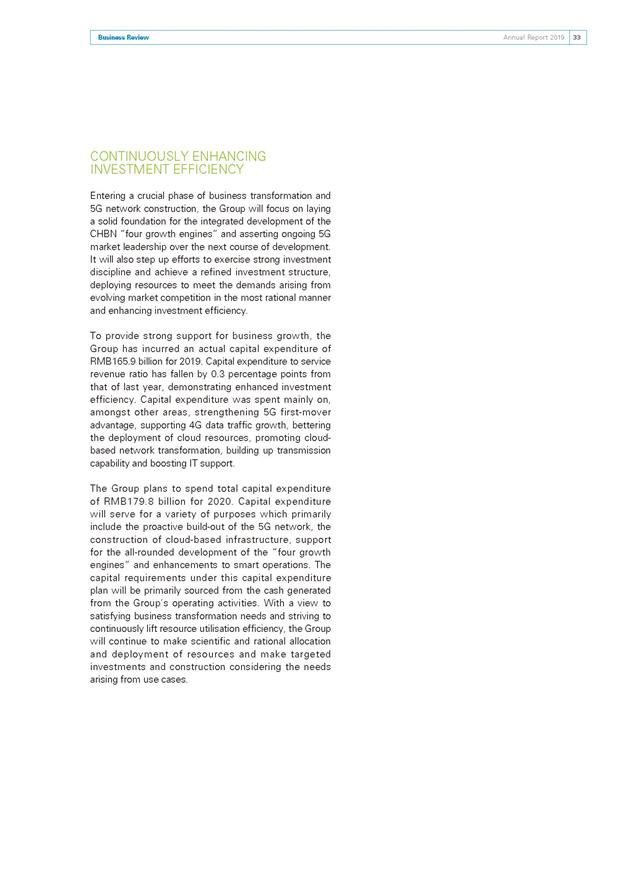
Annual Report 2019 33Business Review 33Business Review CONTINUOUSLY ENHANCING INVESTMENT EFFICIENCY Entering a crucial phase of business transformation and 5G network construction, the Group will focus on laying a solid foundation for the integrated development of the CHBN “four growth engines” and asserting ongoing 5G market leadership over the next course of development. It will also step up efforts to exercise strong investment discipline and achieve a refined investment structure, deploying resources to meet the demands arising from evolving market competition in the most rational manner and enhancing investment efficiency. To provide strong support for business growth, the Group has incurred an actual capital expenditure of RMB165.9 billion for 2019. Capital expenditure to service revenue ratio has fallen by 0.3 percentage points from that of last year, demonstrating enhanced investment efficiency. Capital expenditure was spent mainly on, amongst other areas, strengthening 5G first-mover advantage, supporting 4G data traffic growth, bettering the deployment of cloud resources, promoting cloud- based network transformation, building up transmission capability and boosting IT support. The Group plans to spend total capital expenditure of RMB179.8 billion for 2020. Capital expenditure will serve for a variety of purposes which primarily include the proactive build-out of the 5G network, the construction of cloud-based infrastructure, support for the all-rounded development of the “four growth engines” and enhancements to smart operations. The capital requirements under this capital expenditure plan will be primarily sourced from the cash generated from the Group’s operating activities. With a view to satisfying business transformation needs and striving to continuously lift resource utilisation efficiency, the Group will continue to make scientific and rational allocation and deployment of resources and make targeted investments and construction considering the needs arising from use cases.
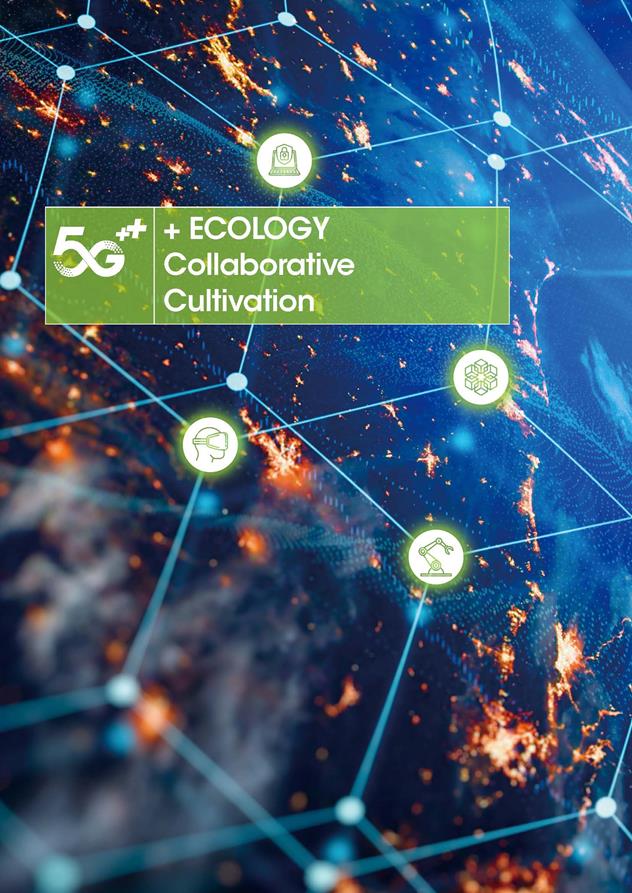
+ ECOLOGY Collaborative Cultivation + ECOLOGY Collaborative Cultivation

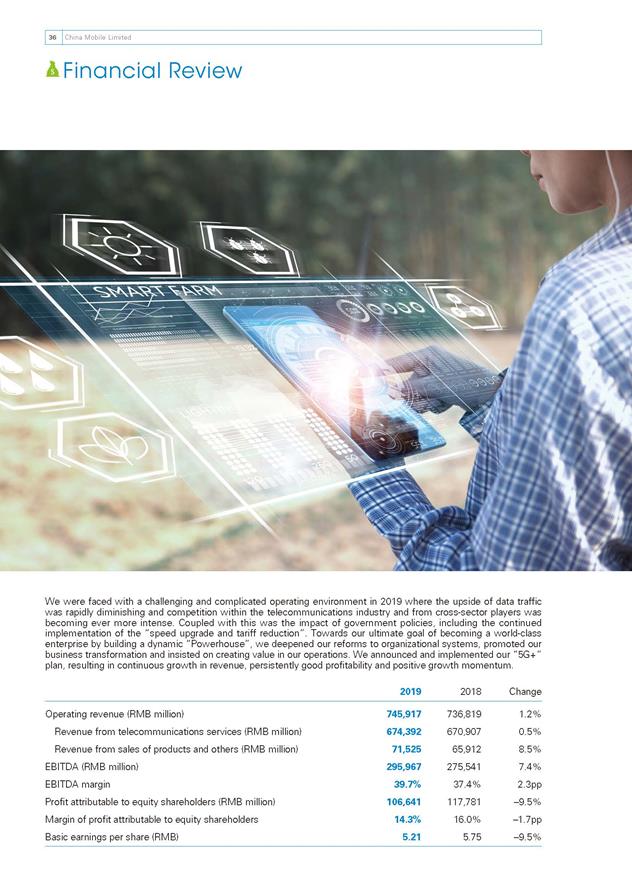
China Mobile Limited36 36 Financial Review We were faced with a challenging and complicated operating environment in 2019 where the upside of data traffic was rapidly diminishing and competition within the telecommunications industry and from cross-sector players was becoming ever more intense. Coupled with this was the impact of government policies, including the continued implementation of the “speed upgrade and tariff reduction”. Towards our ultimate goal of becoming a world-class enterprise by building a dynamic “Powerhouse”, we deepened our reforms to organizational systems, promoted our business transformation and insisted on creating value in our operations. We announced and implemented our “5G+” plan, resulting in continuous growth in revenue, persistently good profitability and positive growth momentum. 2019 2018 Change Operating revenue (RMB million) 745,917 736,819 1.2% Revenue from telecommunications services (RMB million) 674,392 670,907 0.5% Revenue from sales of products and others (RMB million) 71,525 65,912 8.5% EBITDA (RMB million) 295,967 275,541 7.4% EBITDA margin 39.7% 37.4% 2.3pp Profit attributable to equity shareholders (RMB million) 106,641 117,781 –9.5% Margin of profit attributable to equity shareholders 14.3% 16.0% –1.7pp Basic earnings per share (RMB) 5.21 5.75 –9.5%
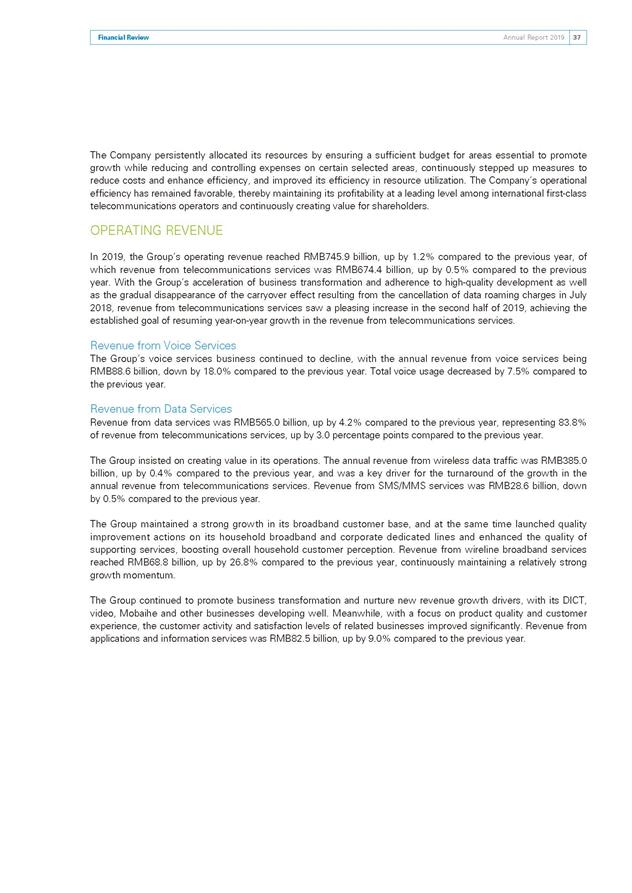
Annual Report 2019 37Financial Review 37Financial Review The Company persistently allocated its resources by ensuring a sufficient budget for areas essential to promote growth while reducing and controlling expenses on certain selected areas, continuously stepped up measures to reduce costs and enhance efficiency, and improved its efficiency in resource utilization. The Company’s operational efficiency has remained favorable, thereby maintaining its profitability at a leading level among international first-class telecommunications operators and continuously creating value for shareholders. OPERATING REVENUE In 2019, the Group’s operating revenue reached RMB745.9 billion, up by 1.2% compared to the previous year, of which revenue from telecommunications services was RMB674.4 billion, up by 0.5% compared to the previous year. With the Group’s acceleration of business transformation and adherence to high-quality development as well as the gradual disappearance of the carryover effect resulting from the cancellation of data roaming charges in July 2018, revenue from telecommunications services saw a pleasing increase in the second half of 2019, achieving the established goal of resuming year-on-year growth in the revenue from telecommunications services. Revenue from Voice Services The Group’s voice services business continued to decline, with the annual revenue from voice services being RMB88.6 billion, down by 18.0% compared to the previous year. Total voice usage decreased by 7.5% compared to the previous year. Revenue from Data Services Revenue from data services was RMB565.0 billion, up by 4.2% compared to the previous year, representing 83.8% of revenue from telecommunications services, up by 3.0 percentage points compared to the previous year. The Group insisted on creating value in its operations. The annual revenue from wireless data traffic was RMB385.0 billion, up by 0.4% compared to the previous year, and was a key driver for the turnaround of the growth in the annual revenue from telecommunications services. Revenue from SMS/MMS services was RMB28.6 billion, down by 0.5% compared to the previous year. The Group maintained a strong growth in its broadband customer base, and at the same time launched quality improvement actions on its household broadband and corporate dedicated lines and enhanced the quality of supporting services, boosting overall household customer perception. Revenue from wireline broadband services reached RMB68.8 billion, up by 26.8% compared to the previous year, continuously maintaining a relatively strong growth momentum. The Group continued to promote business transformation and nurture new revenue growth drivers, with its DICT, video, Mobaihe and other businesses developing well. Meanwhile, with a focus on product quality and customer experience, the customer activity and satisfaction levels of related businesses improved significantly. Revenue from applications and information services was RMB82.5 billion, up by 9.0% compared to the previous year.
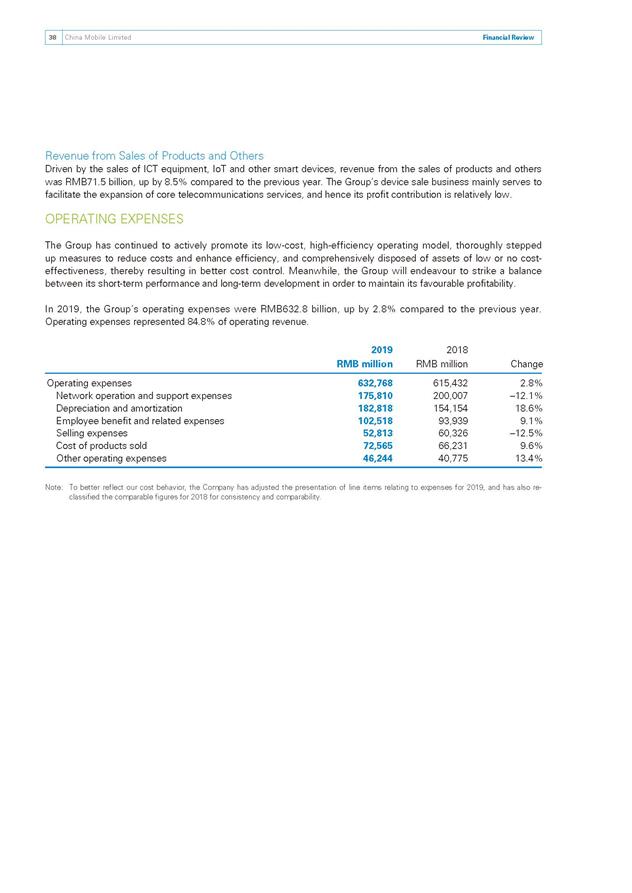
China Mobile Limited38 Financial Review 38 Financial Review Revenue from Sales of Products and Others Driven by the sales of ICT equipment, IoT and other smart devices, revenue from the sales of products and others was RMB71.5 billion, up by 8.5% compared to the previous year. The Group’s device sale business mainly serves to facilitate the expansion of core telecommunications services, and hence its profit contribution is relatively low. OPERATING EXPENSES The Group has continued to actively promote its low-cost, high-efficiency operating model, thoroughly stepped up measures to reduce costs and enhance efficiency, and comprehensively disposed of assets of low or no cost- effectiveness, thereby resulting in better cost control. Meanwhile, the Group will endeavour to strike a balance between its short-term performance and long-term development in order to maintain its favourable profitability. In 2019, the Group’s operating expenses were RMB632.8 billion, up by 2.8% compared to the previous year. Operating expenses represented 84.8% of operating revenue. 2019 2018 RMB million RMB million Change Operating expenses 632,768 615,432 2.8% Network operation and support expenses 175,810 200,007 –12.1% Depreciation and amortization 182,818 154,154 18.6% Employee benefit and related expenses 102,518 93,939 9.1% Selling expenses 52,813 60,326 –12.5% Cost of products sold 72,565 66,231 9.6% Other operating expenses 46,244 40,775 13.4% Note: To better reflect our cost behavior, the Company has adjusted the presentation of line items relating to expenses for 2019, and has also reclassified the comparable figures for 2018 for consistency and comparability.
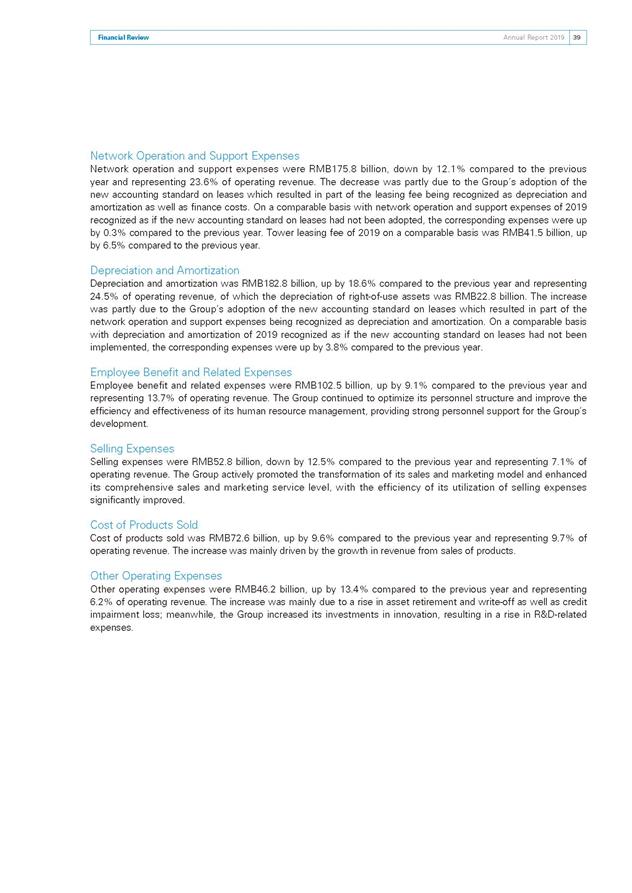
Annual Report 2019 39Financial Review 39Financial Review Network Operation and Support Expenses Network operation and support expenses were RMB175.8 billion, down by 12.1% compared to the previous year and representing 23.6% of operating revenue. The decrease was partly due to the Group’s adoption of the new accounting standard on leases which resulted in part of the leasing fee being recognized as depreciation and amortization as well as finance costs. On a comparable basis with network operation and support expenses of 2019 recognized as if the new accounting standard on leases had not been adopted, the corresponding expenses were up by 0.3% compared to the previous year. Tower leasing fee of 2019 on a comparable basis was RMB41.5 billion, up by 6.5% compared to the previous year. Depreciation and Amortization Depreciation and amortization was RMB182.8 billion, up by 18.6% compared to the previous year and representing 24.5% of operating revenue, of which the depreciation of right-of-use assets was RMB22.8 billion. The increase was partly due to the Group’s adoption of the new accounting standard on leases which resulted in part of the network operation and support expenses being recognized as depreciation and amortization. On a comparable basis with depreciation and amortization of 2019 recognized as if the new accounting standard on leases had not been implemented, the corresponding expenses were up by 3.8% compared to the previous year. Employee Benefit and Related Expenses Employee benefit and related expenses were RMB102.5 billion, up by 9.1% compared to the previous year and representing 13.7% of operating revenue. The Group continued to optimize its personnel structure and improve the efficiency and effectiveness of its human resource management, providing strong personnel support for the Group’s development. Selling Expenses Selling expenses were RMB52.8 billion, down by 12.5% compared to the previous year and representing 7.1% of operating revenue. The Group actively promoted the transformation of its sales and marketing model and enhanced its comprehensive sales and marketing service level, with the efficiency of its utilization of selling expenses significantly improved. Cost of Products Sold Cost of products sold was RMB72.6 billion, up by 9.6% compared to the previous year and representing 9.7% of operating revenue. The increase was mainly driven by the growth in revenue from sales of products. Other Operating Expenses Other operating expenses were RMB46.2 billion, up by 13.4% compared to the previous year and representing 6.2% of operating revenue. The increase was mainly due to a rise in asset retirement and write-off as well as credit impairment loss; meanwhile, the Group increased its investments in innovation, resulting in a rise in R&D-related expenses.
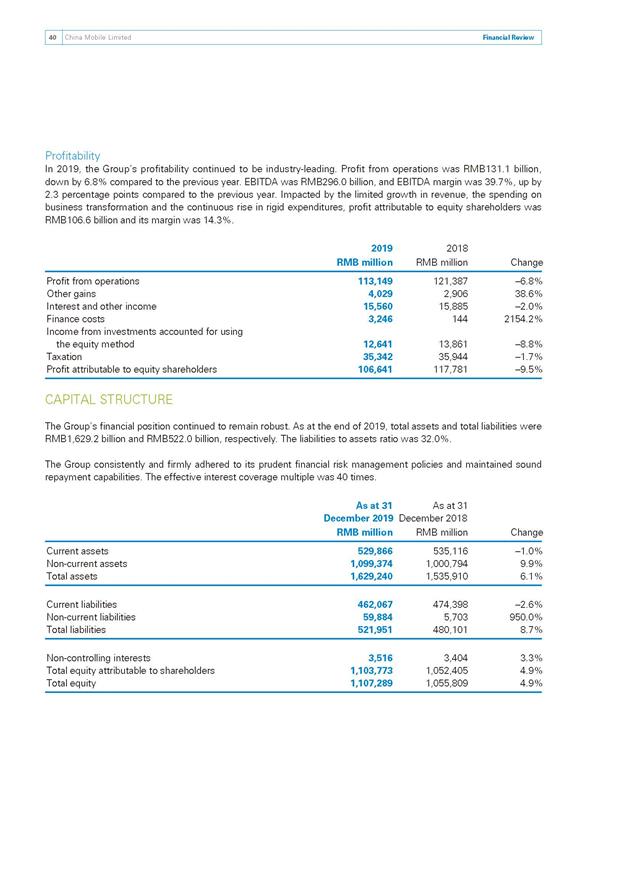
China Mobile Limited40 Financial Review 40 Financial Review Profitability In 2019, the Group’s profitability continued to be industry-leading. Profit from operations was RMB131.1 billion, down by 6.8% compared to the previous year. EBITDA was RMB296.0 billion, and EBITDA margin was 39.7%, up by 2.3 percentage points compared to the previous year. Impacted by the limited growth in revenue, the spending on business transformation and the continuous rise in rigid expenditures, profit attributable to equity shareholders was RMB106.6 billion and its margin was 14.3%. 2019 2018 RMB million RMB million Change Profit from operations 113,149 121,387 –6.8% Other gains 4,029 2,906 38.6% Interest and other income 15,560 15,885 –2.0% Finance costs 3,246 144 2154.2% Income from investments accounted for using the equity method 12,641 13,861 –8.8% Taxation 35,342 35,944 –1.7% Profit attributable to equity shareholders 106,641 117,781 –9.5% CAPITAL STRUCTURE The Group’s financial position continued to remain robust. As at the end of 2019, total assets and total liabilities were RMB1,629.2 billion and RMB522.0 billion, respectively. The liabilities to assets ratio was 32.0%. The Group consistently and firmly adhered to its prudent financial risk management policies and maintained sound repayment capabilities. The effective interest coverage multiple was 40 times. As at 31 As at 31 December 2019 December 2018 RMB million RMB million Change Current assets 529,866 535,116 –1.0% Non-current assets 1,099,374 1,000,794 9.9% Total assets 1,629,240 1,535,910 6.1% Current liabilities 462,067 474,398 –2.6% Non-current liabilities 59,884 5,703 950.0% Total liabilities 521,951 480,101 8.7% Non-controlling interests 3,516 3,404 3.3% Total equity attributable to shareholders 1,103,773 1,052,405 4.9% Total equity 1,107,289 1,055,809 4.9%
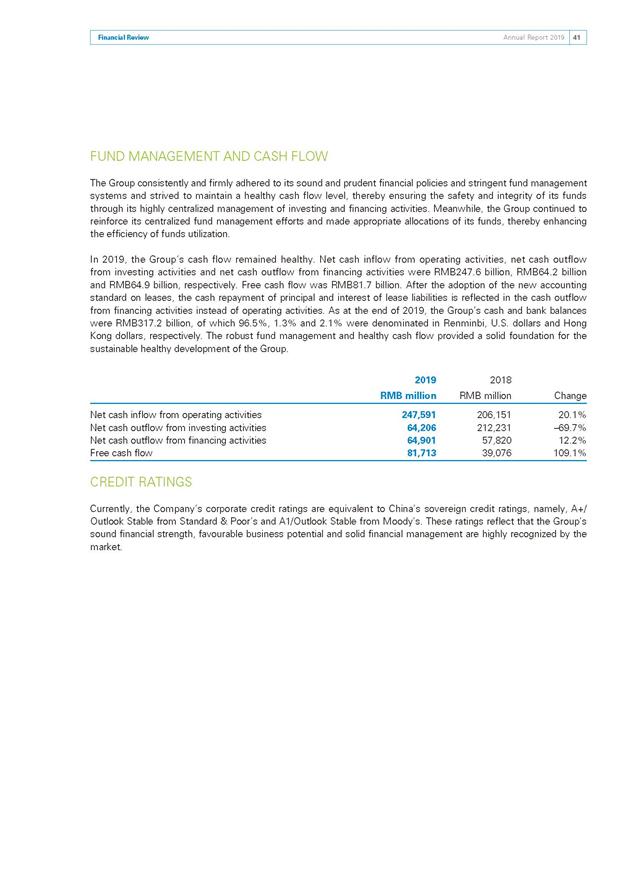
Annual Report 2019 41Financial Review 41Financial Review FUND MANAGEMENT AND CASH FLOW The Group consistently and firmly adhered to its sound and prudent financial policies and stringent fund management systems and strived to maintain a healthy cash flow level, thereby ensuring the safety and integrity of its funds through its highly centralized management of investing and financing activities. Meanwhile, the Group continued to reinforce its centralized fund management efforts and made appropriate allocations of its funds, thereby enhancing the efficiency of funds utilization. In 2019, the Group’s cash flow remained healthy. Net cash inflow from operating activities, net cash outflow from investing activities and net cash outflow from financing activities were RMB247.6 billion, RMB64.2 billion and RMB64.9 billion, respectively. Free cash flow was RMB81.7 billion. After the adoption of the new accounting standard on leases, the cash repayment of principal and interest of lease liabilities is reflected in the cash outflow from financing activities instead of operating activities. As at the end of 2019, the Group’s cash and bank balances were RMB317.2 billion, of which 96.5%, 1.3% and 2.1% were denominated in Renminbi, U.S. dollars and Hong Kong dollars, respectively. The robust fund management and healthy cash flow provided a solid foundation for the sustainable healthy development of the Group. 2019 2018 RMB million RMB million Change Net cash inflow from operating activities 247,591 206,151 20.1% Net cash outflow from investing activities 64,206 212,231 –69.7% Net cash outflow from financing activities 64,901 57,820 12.2% Free cash flow 81,713 39,076 109.1% CREDIT RATINGS Currently, the Company’s corporate credit ratings are equivalent to China’s sovereign credit ratings, namely, A+/ Outlook Stable from Standard & Poor’s and A1/Outlook Stable from Moody’s. These ratings reflect that the Group’s sound financial strength, favourable business potential and solid financial management are highly recognized by the market.

+ X Wider Applications + X Wider Applications

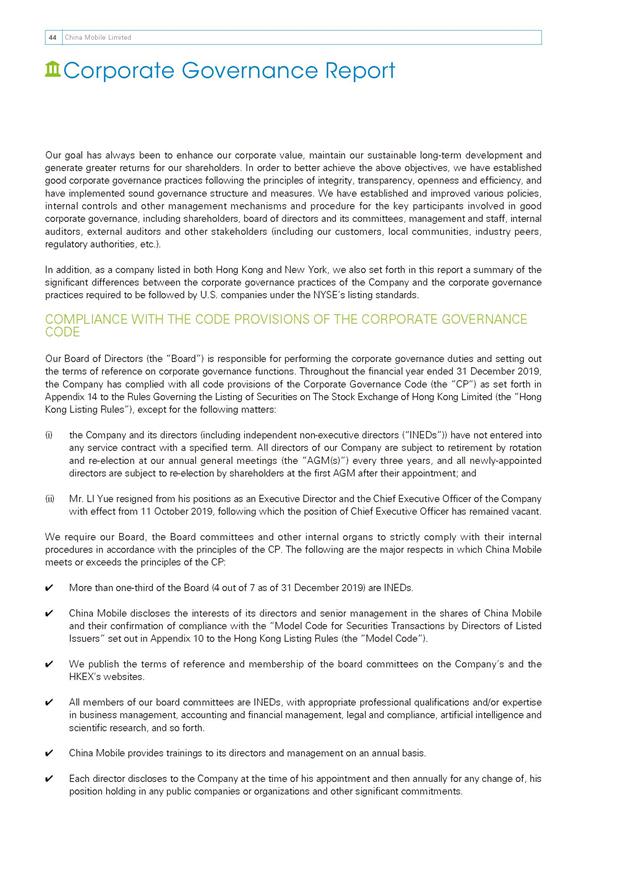
China Mobile Limited44 44 Corporate Governance Report Our goal has always been to enhance our corporate value, maintain our sustainable long-term development and generate greater returns for our shareholders. In order to better achieve the above objectives, we have established good corporate governance practices following the principles of integrity, transparency, openness and efficiency, and have implemented sound governance structure and measures. We have established and improved various policies, internal controls and other management mechanisms and procedure for the key participants involved in good corporate governance, including shareholders, board of directors and its committees, management and staff, internal auditors, external auditors and other stakeholders (including our customers, local communities, industry peers, regulatory authorities, etc.). In addition, as a company listed in both Hong Kong and New York, we also set forth in this report a summary of the significant differences between the corporate governance practices of the Company and the corporate governance practices required to be followed by U.S. companies under the NYSE’s listing standards. COMPLIANCE WITH THE CODE PROVISIONS OF THE CORPORATE GOVERNANCE CODE Our Board of Directors (the “Board”) is responsible for performing the corporate governance duties and setting out the terms of reference on corporate governance functions. Throughout the financial year ended 31 December 2019, the Company has complied with all code provisions of the Corporate Governance Code (the “CP”) as set forth in Appendix 14 to the Rules Governing the Listing of Securities on The Stock Exchange of Hong Kong Limited (the “Hong Kong Listing Rules”), except for the following matters: (i) the Company and its directors (including independent non-executive directors (“INEDs”)) have not entered into any service contract with a specified term. All directors of our Company are subject to retirement by rotation and re-election at our annual general meetings (the “AGM(s)”) every three years, and all newly-appointed directors are subject to re-election by shareholders at the first AGM after their appointment; and (ii) Mr. LI Yue resigned from his positions as an Executive Director and the Chief Executive Officer of the Company with effect from 11 October 2019, following which the position of Chief Executive Officer has remained vacant. We require our Board, the Board committees and other internal organs to strictly comply with their internal procedures in accordance with the principles of the CP. The following are the major respects in which China Mobile meets or exceeds the principles of the CP: . More than one-third of the Board (4 out of 7 as of 31 December 2019) are INEDs. . China Mobile discloses the interests of its directors and senior management in the shares of China Mobile and their confirmation of compliance with the “Model Code for Securities Transactions by Directors of Listed Issuers” set out in Appendix 10 to the Hong Kong Listing Rules (the “Model Code”). . We publish the terms of reference and membership of the board committees on the Company’s and the HKEX’s websites. . All members of our board committees are INEDs, with appropriate professional qualifications and/or expertise in business management, accounting and financial management, legal and compliance, artificial intelligence and scientific research, and so forth. . China Mobile provides trainings to its directors and management on an annual basis. . Each director discloses to the Company at the time of his appointment and then annually for any change of, his position holding in any public companies or organizations and other significant commitments.
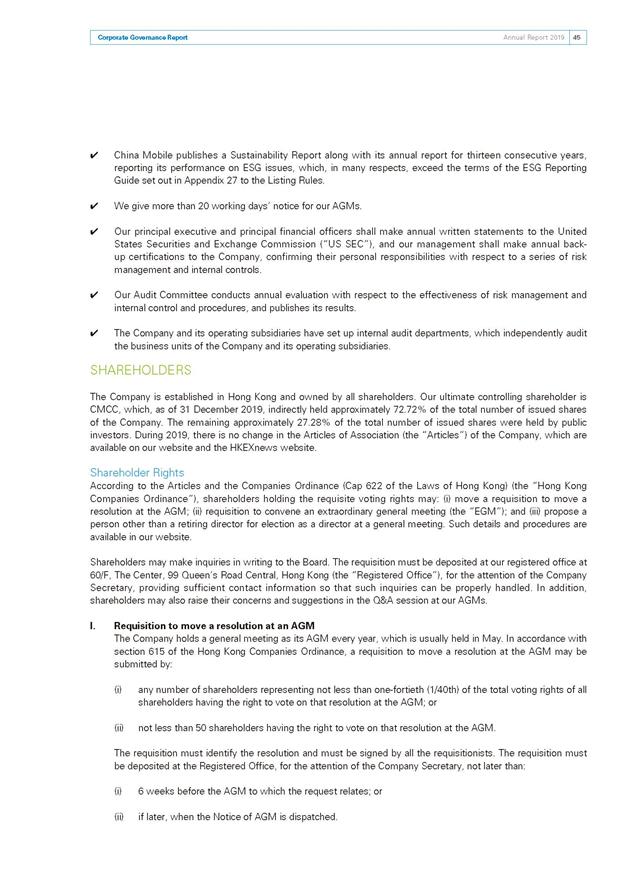
Annual Report 2019 45Corporate Governance Report 45Corporate Governance Report . China Mobile publishes a Sustainability Report along with its annual report for thirteen consecutive years, reporting its performance on ESG issues, which, in many respects, exceed the terms of the ESG Reporting Guide set out in Appendix 27 to the Listing Rules. . We give more than 20 working days’ notice for our AGMs. . Our principal executive and principal financial officers shall make annual written statements to the United States Securities and Exchange Commission (“US SEC”), and our management shall make annual backup certifications to the Company, confirming their personal responsibilities with respect to a series of risk management and internal controls. . Our Audit Committee conducts annual evaluation with respect to the effectiveness of risk management and internal control and procedures, and publishes its results. . The Company and its operating subsidiaries have set up internal audit departments, which independently audit the business units of the Company and its operating subsidiaries. SHAREHOLDERS The Company is established in Hong Kong and owned by all shareholders. Our ultimate controlling shareholder is CMCC, which, as of 31 December 2019, indirectly held approximately 72.72% of the total number of issued shares of the Company. The remaining approximately 27.28% of the total number of issued shares were held by public investors. During 2019, there is no change in the Articles of Association (the “Articles”) of the Company, which are available on our website and the HKEXnews website. Shareholder Rights According to the Articles and the Companies Ordinance (Cap 622 of the Laws of Hong Kong) (the “Hong Kong Companies Ordinance”), shareholders holding the requisite voting rights may: (i) move a requisition to move a resolution at the AGM; (ii) requisition to convene an extraordinary general meeting (the “EGM”); and (iii) propose a person other than a retiring director for election as a director at a general meeting. Such details and procedures are available in our website. Shareholders may make inquiries in writing to the Board. The requisition must be deposited at our registered office at 60/F, The Center, 99 Queen’s Road Central, Hong Kong (the “Registered Office”), for the attention of the Company Secretary, providing sufficient contact information so that such inquiries can be properly handled. In addition, shareholders may also raise their concerns and suggestions in the Q&A session at our AGMs. I. Requisition to move a resolution at an AGM The Company holds a general meeting as its AGM every year, which is usually held in May. In accordance with section 615 of the Hong Kong Companies Ordinance, a requisition to move a resolution at the AGM may be submitted by: (i) any number of shareholders representing not less than one-fortieth (1/40th) of the total voting rights of all shareholders having the right to vote on that resolution at the AGM; or (ii) not less than 50 shareholders having the right to vote on that resolution at the AGM. The requisition must identify the resolution and must be signed by all the requisitionists. The requisition must be deposited at the Registered Office, for the attention of the Company Secretary, not later than: (i) 6 weeks before the AGM to which the request relates; or (ii) if later, when the Notice of AGM is dispatched.
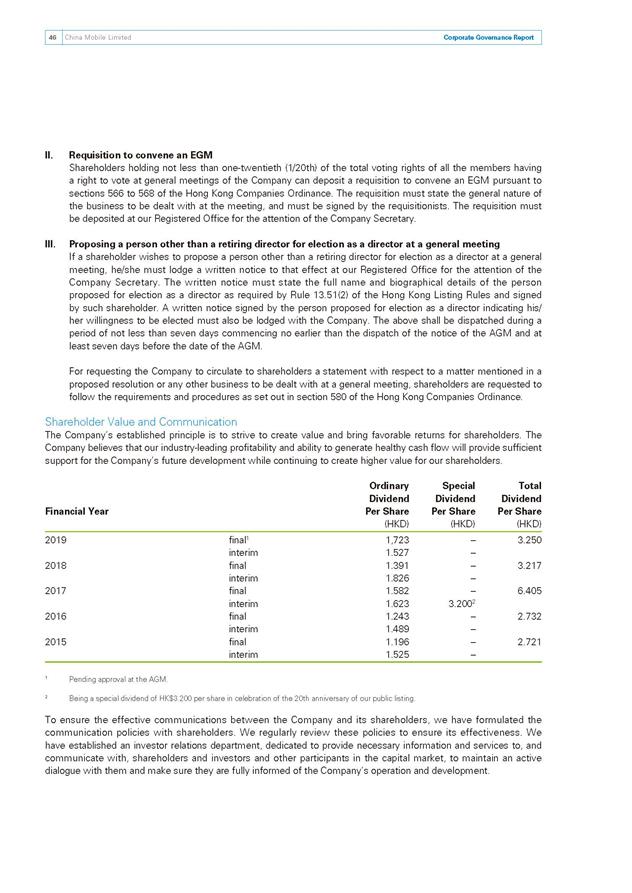
46 China Mobile Limited Corporate Governance Report II. Requisition to convene an EGM Shareholders holding not less than one-twentieth (1/20th) of the total voting rights of all the members having a right to vote at general meetings of the Company can deposit a requisition to convene an EGM pursuant to sections 566 to 568 of the Hong Kong Companies Ordinance. The requisition must state the general nature of the business to be dealt with at the meeting, and must be signed by the requisitionists. The requisition must be deposited at our Registered Office for the attention of the Company Secretary. III. Proposing a person other than a retiring director for election as a director at a general meeting If a shareholder wishes to propose a person other than a retiring director for election as a director at a general meeting, he/she must lodge a written notice to that effect at our Registered Office for the attention of the Company Secretary. The written notice must state the full name and biographical details of the person proposed for election as a director as required by Rule 13.51(2) of the Hong Kong Listing Rules and signed by such shareholder. A written notice signed by the person proposed for election as a director indicating his/ her willingness to be elected must also be lodged with the Company. The above shall be dispatched during a period of not less than seven days commencing no earlier than the dispatch of the notice of the AGM and at least seven days before the date of the AGM. For requesting the Company to circulate to shareholders a statement with respect to a matter mentioned in a proposed resolution or any other business to be dealt with at a general meeting, shareholders are requested to follow the requirements and procedures as set out in section 580 of the Hong Kong Companies Ordinance. Shareholder Value and Communication The Company’s established principle is to strive to create value and bring favorable returns for shareholders. The Company believes that our industry-leading profitability and ability to generate healthy cash flow will provide sufficient support for the Company’s future development while continuing to create higher value for our shareholders. Ordinary Special Total Dividend Dividend Dividend Financial Year Per Share Per Share Per Share (HKD) (HKD) (HKD) 2019 final1 1,723 – 3.250 interim 1.527 – 2018 final 1.391 – 3.217 interim 1.826 – 2017 final 1.582 – 6.405 interim 1.623 3.2002 2016 final 1.243 – 2.732 interim 1.489 – 2015 final 1.196 – 2.721 interim 1.525 – 1 Pending approval at the AGM. 2 Being a special dividend of HK$3.200 per share in celebration of the 20th anniversary of our public listing. To ensure the effective communications between the Company and its shareholders, we have formulated the communication policies with shareholders. We regularly review these policies to ensure its effectiveness. We have established an investor relations department, dedicated to provide necessary information and services to, and communicate with, shareholders and investors and other participants in the capital market, to maintain an active dialogue with them and make sure they are fully informed of the Company’s operation and development.
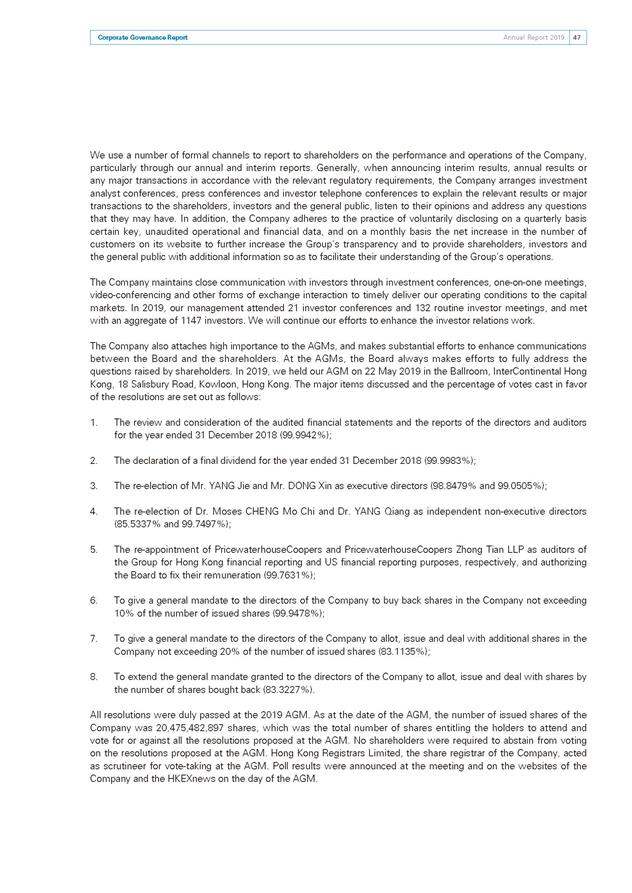
Annual Report 2019 47Corporate Governance Report 47Corporate Governance Report We use a number of formal channels to report to shareholders on the performance and operations of the Company, particularly through our annual and interim reports. Generally, when announcing interim results, annual results or any major transactions in accordance with the relevant regulatory requirements, the Company arranges investment analyst conferences, press conferences and investor telephone conferences to explain the relevant results or major transactions to the shareholders, investors and the general public, listen to their opinions and address any questions that they may have. In addition, the Company adheres to the practice of voluntarily disclosing on a quarterly basis certain key, unaudited operational and financial data, and on a monthly basis the net increase in the number of customers on its website to further increase the Group’s transparency and to provide shareholders, investors and the general public with additional information so as to facilitate their understanding of the Group’s operations. The Company maintains close communication with investors through investment conferences, one-on-one meetings, video-conferencing and other forms of exchange interaction to timely deliver our operating conditions to the capital markets. In 2019, our management attended 21 investor conferences and 132 routine investor meetings, and met with an aggregate of 1147 investors. We will continue our efforts to enhance the investor relations work. The Company also attaches high importance to the AGMs, and makes substantial efforts to enhance communications between the Board and the shareholders. At the AGMs, the Board always makes efforts to fully address the questions raised by shareholders. In 2019, we held our AGM on 22 May 2019 in the Ballroom, InterContinental Hong Kong, 18 Salisbury Road, Kowloon, Hong Kong. The major items discussed and the percentage of votes cast in favor of the resolutions are set out as follows: 1. The review and consideration of the audited financial statements and the reports of the directors and auditors for the year ended 31 December 2018 (99.9942%); 2. The declaration of a final dividend for the year ended 31 December 2018 (99.9983%); 3. The re-election of Mr. YANG Jie and Mr. DONG Xin as executive directors (98.8479% and 99.0505%); 4. The re-election of Dr. Moses CHENG Mo Chi and Dr. YANG Qiang as independent non-executive directors (85.5337% and 99.7497%); 5. The re-appointment of PricewaterhouseCoopers and PricewaterhouseCoopers Zhong Tian LLP as auditors of the Group for Hong Kong financial reporting and US financial reporting purposes, respectively, and authorizing the Board to fix their remuneration (99.7631%); 6. To give a general mandate to the directors of the Company to buy back shares in the Company not exceeding 10% of the number of issued shares (99.9478%); 7. To give a general mandate to the directors of the Company to allot, issue and deal with additional shares in the Company not exceeding 20% of the number of issued shares (83.1135%); 8. To extend the general mandate granted to the directors of the Company to allot, issue and deal with shares by the number of shares bought back (83.3227%). All resolutions were duly passed at the 2019 AGM. As at the date of the AGM, the number of issued shares of the Company was 20,475,482,897 shares, which was the total number of shares entitling the holders to attend and vote for or against all the resolutions proposed at the AGM. No shareholders were required to abstain from voting on the resolutions proposed at the AGM. Hong Kong Registrars Limited, the share registrar of the Company, acted as scrutineer for vote-taking at the AGM. Poll results were announced at the meeting and on the websites of the Company and the HKEXnews on the day of the AGM.
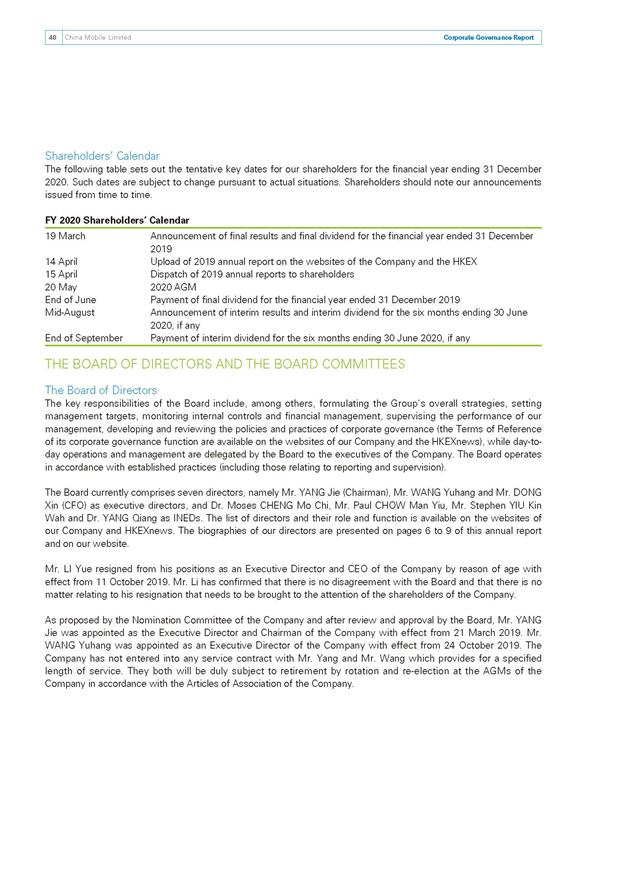
China Mobile Limited48 Corporate Governance Report 48 Corporate Governance Report Shareholders’ Calendar The following table sets out the tentative key dates for our shareholders for the financial year ending 31 December 2020. Such dates are subject to change pursuant to actual situations. Shareholders should note our announcements issued from time to time. FY 2020 Shareholders’ Calendar 19 March Announcement of final results and final dividend for the financial year ended 31 December 2019 14 April Upload of 2019 annual report on the websites of the Company and the HKEX 15 April Dispatch of 2019 annual reports to shareholders 20 May 2020 AGM End of June Payment of final dividend for the financial year ended 31 December 2019 Mid-August Announcement of interim results and interim dividend for the six months ending 30 June 2020, if any End of September Payment of interim dividend for the six months ending 30 June 2020, if any THE BOARD OF DIRECTORS AND THE BOARD COMMITTEES The Board of Directors The key responsibilities of the Board include, among others, formulating the Group’s overall strategies, setting management targets, monitoring internal controls and financial management, supervising the performance of our management, developing and reviewing the policies and practices of corporate governance (the Terms of Reference of its corporate governance function are available on the websites of our Company and the HKEXnews), while day-today operations and management are delegated by the Board to the executives of the Company. The Board operates in accordance with established practices (including those relating to reporting and supervision). The Board currently comprises seven directors, namely Mr. YANG Jie (Chairman), Mr. WANG Yuhang and Mr. DONG Xin (CFO) as executive directors, and Dr. Moses CHENG Mo Chi, Mr. Paul CHOW Man Yiu, Mr. Stephen YIU Kin Wah and Dr. YANG Qiang as INEDs. The list of directors and their role and function is available on the websites of our Company and HKEXnews. The biographies of our directors are presented on pages 6 to 9 of this annual report and on our website. Mr. LI Yue resigned from his positions as an Executive Director and CEO of the Company by reason of age with effect from 11 October 2019. Mr. Li has confirmed that there is no disagreement with the Board and that there is no matter relating to his resignation that needs to be brought to the attention of the shareholders of the Company. As proposed by the Nomination Committee of the Company and after review and approval by the Board, Mr. YANG Jie was appointed as the Executive Director and Chairman of the Company with effect from 21 March 2019. Mr. WANG Yuhang was appointed as an Executive Director of the Company with effect from 24 October 2019. The Company has not entered into any service contract with Mr. Yang and Mr. Wang which provides for a specified length of service. They both will be duly subject to retirement by rotation and re-election at the AGMs of the Company in accordance with the Articles of Association of the Company.
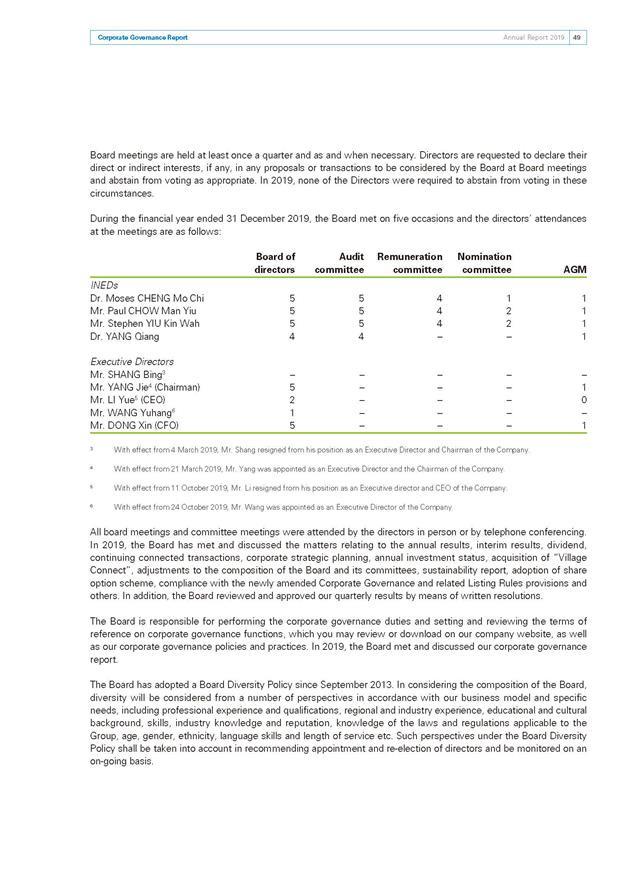
Corporate Governance Report Annual Report 2019 49 Board meetings are held at least once a quarter and as and when necessary. Directors are requested to declare their direct or indirect interests, if any, in any proposals or transactions to be considered by the Board at Board meetings and abstain from voting as appropriate. In 2019, none of the Directors were required to abstain from voting in these circumstances. During the financial year ended 31 December 2019, the Board met on five occasions and the directors’ attendances at the meetings are as follows: Board of Audit Remuneration Nomination directors committee committee committee AGM INEDs Dr. Moses CHENG Mo Chi 5 5 4 1 1 Mr. Paul CHOW Man Yiu 5 5 4 2 1 Mr. Stephen YIU Kin Wah 5 5 4 2 1 Dr. YANG Qiang 4 4 – – 1 Executive Directors Mr. SHANG Bing3 – – – – – Mr. YANG Jie4 (Chairman) 5 – – – 1 Mr. LI Yue5 (CEO) 2 – – – 0 Mr. WANG Yuhang6 1 – – – – Mr. DONG Xin (CFO) 5 – – – 1 3 With effect from 4 March 2019, Mr. Shang resigned from his position as an Executive Director and Chairman of the Company. 4 With effect from 21 March 2019, Mr. Yang was appointed as an Executive Director and the Chairman of the Company. 5 With effect from 11 October 2019, Mr. Li resigned from his position as an Executive director and CEO of the Company. 6 With effect from 24 October 2019, Mr. Wang was appointed as an Executive Director of the Company. All board meetings and committee meetings were attended by the directors in person or by telephone conferencing. In 2019, the Board has met and discussed the matters relating to the annual results, interim results, dividend, continuing connected transactions, corporate strategic planning, annual investment status, acquisition of “Village Connect”, adjustments to the composition of the Board and its committees, sustainability report, adoption of share option scheme, compliance with the newly amended Corporate Governance and related Listing Rules provisions and others. In addition, the Board reviewed and approved our quarterly results by means of written resolutions. The Board is responsible for performing the corporate governance duties and setting and reviewing the terms of reference on corporate governance functions, which you may review or download on our company website, as well as our corporate governance policies and practices. In 2019, the Board met and discussed our corporate governance report. The Board has adopted a Board Diversity Policy since September 2013. In considering the composition of the Board, diversity will be considered from a number of perspectives in accordance with our business model and specific needs, including professional experience and qualifications, regional and industry experience, educational and cultural background, skills, industry knowledge and reputation, knowledge of the laws and regulations applicable to the Group, age, gender, ethnicity, language skills and length of service etc. Such perspectives under the Board Diversity Policy shall be taken into account in recommending appointment and re-election of directors and be monitored on an on-going basis.
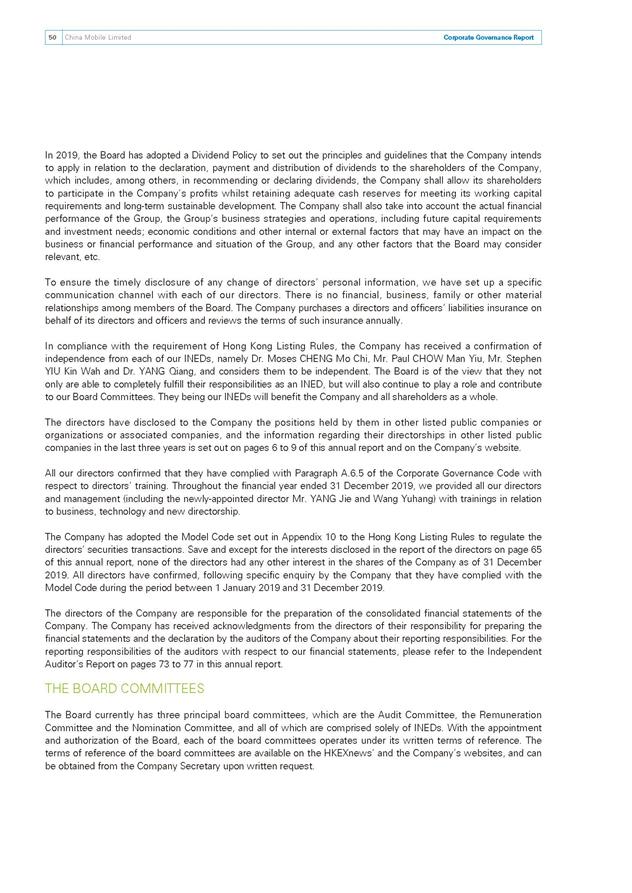
China Mobile Limited50 Corporate Governance Report 50 Corporate Governance Report In 2019, the Board has adopted a Dividend Policy to set out the principles and guidelines that the Company intends to apply in relation to the declaration, payment and distribution of dividends to the shareholders of the Company, which includes, among others, in recommending or declaring dividends, the Company shall allow its shareholders to participate in the Company’s profits whilst retaining adequate cash reserves for meeting its working capital requirements and long-term sustainable development. The Company shall also take into account the actual financial performance of the Group, the Group’s business strategies and operations, including future capital requirements and investment needs; economic conditions and other internal or external factors that may have an impact on the business or financial performance and situation of the Group, and any other factors that the Board may consider relevant, etc. To ensure the timely disclosure of any change of directors’ personal information, we have set up a specific communication channel with each of our directors. There is no financial, business, family or other material relationships among members of the Board. The Company purchases a directors and officers’ liabilities insurance on behalf of its directors and officers and reviews the terms of such insurance annually. In compliance with the requirement of Hong Kong Listing Rules, the Company has received a confirmation of independence from each of our INEDs, namely Dr. Moses CHENG Mo Chi, Mr. Paul CHOW Man Yiu, Mr. Stephen YIU Kin Wah and Dr. YANG Qiang, and considers them to be independent. The Board is of the view that they not only are able to completely fulfill their responsibilities as an INED, but will also continue to play a role and contribute to our Board Committees. They being our INEDs will benefit the Company and all shareholders as a whole. The directors have disclosed to the Company the positions held by them in other listed public companies or organizations or associated companies, and the information regarding their directorships in other listed public companies in the last three years is set out on pages 6 to 9 of this annual report and on the Company’s website. All our directors confirmed that they have complied with Paragraph A.6.5 of the Corporate Governance Code with respect to directors’ training. Throughout the financial year ended 31 December 2019, we provided all our directors and management (including the newly-appointed director Mr. YANG Jie and Wang Yuhang) with trainings in relation to business, technology and new directorship. The Company has adopted the Model Code set out in Appendix 10 to the Hong Kong Listing Rules to regulate the directors’ securities transactions. Save and except for the interests disclosed in the report of the directors on page 65 of this annual report, none of the directors had any other interest in the shares of the Company as of 31 December 2019. All directors have confirmed, following specific enquiry by the Company that they have complied with the Model Code during the period between 1 January 2019 and 31 December 2019. The directors of the Company are responsible for the preparation of the consolidated financial statements of the Company. The Company has received acknowledgments from the directors of their responsibility for preparing the financial statements and the declaration by the auditors of the Company about their reporting responsibilities. For the reporting responsibilities of the auditors with respect to our financial statements, please refer to the Independent Auditor’s Report on pages 73 to 77 in this annual report. THE BOARD COMMITTEES The Board currently has three principal board committees, which are the Audit Committee, the Remuneration Committee and the Nomination Committee, and all of which are comprised solely of INEDs. With the appointment and authorization of the Board, each of the board committees operates under its written terms of reference. The terms of reference of the board committees are available on the HKEXnews’ and the Company’s websites, and can be obtained from the Company Secretary upon written request.
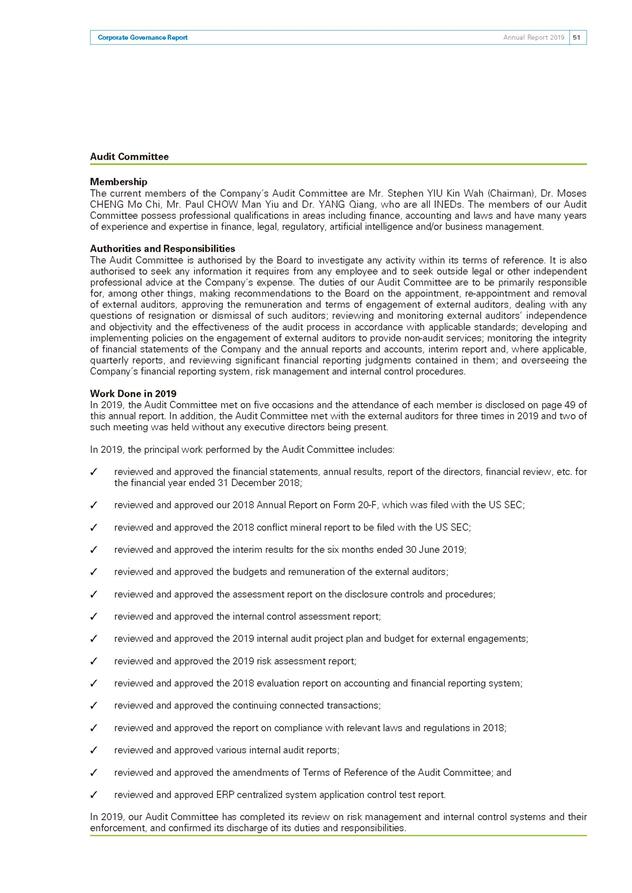
Annual Report 2019 51Corporate Governance Report 51Corporate Governance Report Audit Committee Membership The current members of the Company’s Audit Committee are Mr. Stephen YIU Kin Wah (Chairman), Dr. Moses CHENG Mo Chi, Mr. Paul CHOW Man Yiu and Dr. YANG Qiang, who are all INEDs. The members of our Audit Committee possess professional qualifications in areas including finance, accounting and laws and have many years of experience and expertise in finance, legal, regulatory, artificial intelligence and/or business management. Authorities and Responsibilities The Audit Committee is authorised by the Board to investigate any activity within its terms of reference. It is also authorised to seek any information it requires from any employee and to seek outside legal or other independent professional advice at the Company’s expense. The duties of our Audit Committee are to be primarily responsible for, among other things, making recommendations to the Board on the appointment, re-appointment and removal of external auditors, approving the remuneration and terms of engagement of external auditors, dealing with any questions of resignation or dismissal of such auditors; reviewing and monitoring external auditors’ independence and objectivity and the effectiveness of the audit process in accordance with applicable standards; developing and implementing policies on the engagement of external auditors to provide non-audit services; monitoring the integrity of financial statements of the Company and the annual reports and accounts, interim report and, where applicable, quarterly reports, and reviewing significant financial reporting judgments contained in them; and overseeing the Company’s financial reporting system, risk management and internal control procedures. Work Done in 2019 In 2019, the Audit Committee met on five occasions and the attendance of each member is disclosed on page 49 of this annual report. In addition, the Audit Committee met with the external auditors for three times in 2019 and two of such meeting was held without any executive directors being present. In 2019, the principal work performed by the Audit Committee includes: . reviewed and approved the financial statements, annual results, report of the directors, financial review, etc. for the financial year ended 31 December 2018; . reviewed and approved our 2018 Annual Report on Form 20-F, which was filed with the US SEC; . reviewed and approved the 2018 conflict mineral report to be filed with the US SEC; . reviewed and approved the interim results for the six months ended 30 June 2019; . reviewed and approved the budgets and remuneration of the external auditors; . reviewed and approved the assessment report on the disclosure controls and procedures; . reviewed and approved the internal control assessment report; . reviewed and approved the 2019 internal audit project plan and budget for external engagements; . reviewed and approved the 2019 risk assessment report; . reviewed and approved the 2018 evaluation report on accounting and financial reporting system; . reviewed and approved the continuing connected transactions; . reviewed and approved the report on compliance with relevant laws and regulations in 2018; . reviewed and approved various internal audit reports; . reviewed and approved the amendments of Terms of Reference of the Audit Committee; and . reviewed and approved ERP centralized system application control test report. In 2019, our Audit Committee has completed its review on risk management and internal control systems and their enforcement, and confirmed its discharge of its duties and responsibilities.
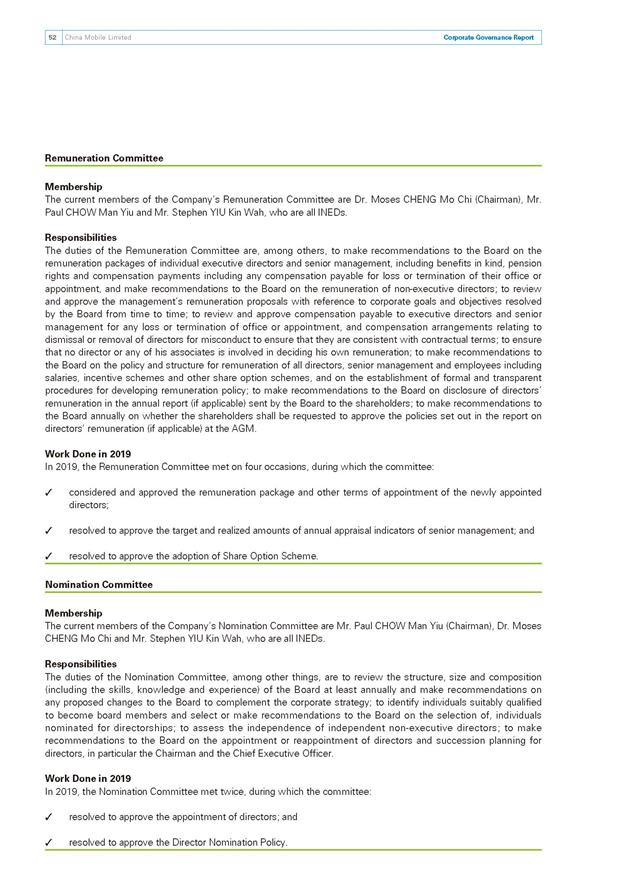
China Mobile Limited52 Corporate Governance Report 52 Corporate Governance Report Remuneration Committee Membership The current members of the Company’s Remuneration Committee are Dr. Moses CHENG Mo Chi (Chairman), Mr. Paul CHOW Man Yiu and Mr. Stephen YIU Kin Wah, who are all INEDs. Responsibilities The duties of the Remuneration Committee are, among others, to make recommendations to the Board on the remuneration packages of individual executive directors and senior management, including benefits in kind, pension rights and compensation payments including any compensation payable for loss or termination of their office or appointment, and make recommendations to the Board on the remuneration of non-executive directors; to review and approve the management’s remuneration proposals with reference to corporate goals and objectives resolved by the Board from time to time; to review and approve compensation payable to executive directors and senior management for any loss or termination of office or appointment, and compensation arrangements relating to dismissal or removal of directors for misconduct to ensure that they are consistent with contractual terms; to ensure that no director or any of his associates is involved in deciding his own remuneration; to make recommendations to the Board on the policy and structure for remuneration of all directors, senior management and employees including salaries, incentive schemes and other share option schemes, and on the establishment of formal and transparent procedures for developing remuneration policy; to make recommendations to the Board on disclosure of directors’ remuneration in the annual report (if applicable) sent by the Board to the shareholders; to make recommendations to the Board annually on whether the shareholders shall be requested to approve the policies set out in the report on directors’ remuneration (if applicable) at the AGM. Work Done in 2019 In 2019, the Remuneration Committee met on four occasions, during which the committee: . considered and approved the remuneration package and other terms of appointment of the newly appointed directors; . resolved to approve the target and realized amounts of annual appraisal indicators of senior management; and . resolved to approve the adoption of Share Option Scheme. Nomination Committee Membership The current members of the Company’s Nomination Committee are Mr. Paul CHOW Man Yiu (Chairman), Dr. Moses CHENG Mo Chi and Mr. Stephen YIU Kin Wah, who are all INEDs. Responsibilities The duties of the Nomination Committee, among other things, are to review the structure, size and composition (including the skills, knowledge and experience) of the Board at least annually and make recommendations on any proposed changes to the Board to complement the corporate strategy; to identify individuals suitably qualified to become board members and select or make recommendations to the Board on the selection of, individuals nominated for directorships; to assess the independence of independent non-executive directors; to make recommendations to the Board on the appointment or reappointment of directors and succession planning for directors, in particular the Chairman and the Chief Executive Officer. Work Done in 2019 In 2019, the Nomination Committee met twice, during which the committee: . resolved to approve the appointment of directors; and . resolved to approve the Director Nomination Policy.
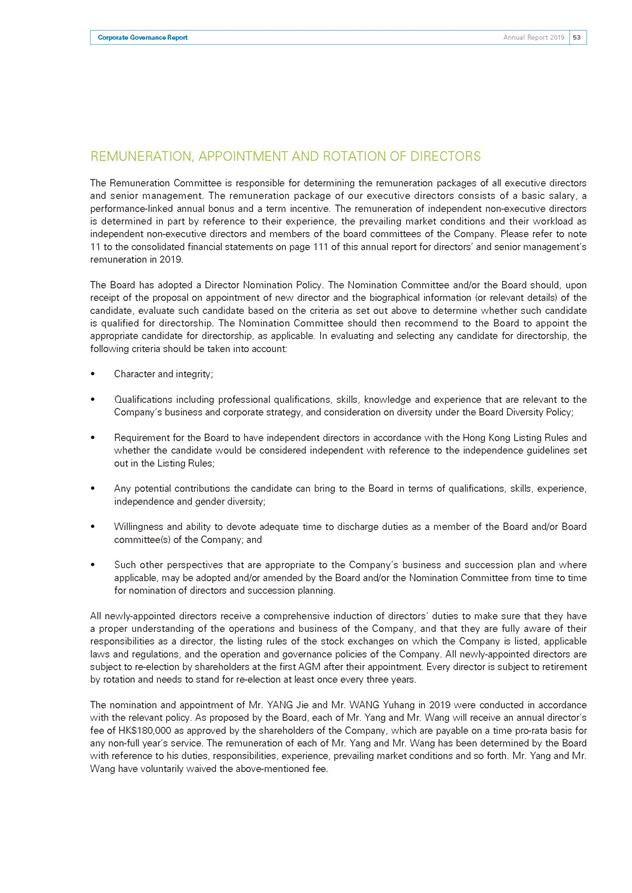
Annual Report 2019 53Corporate Governance Report 53Corporate Governance Report REMUNERATION, APPOINTMENT AND ROTATION OF DIRECTORS The Remuneration Committee is responsible for determining the remuneration packages of all executive directors and senior management. The remuneration package of our executive directors consists of a basic salary, a performance-linked annual bonus and a term incentive. The remuneration of independent non-executive directors is determined in part by reference to their experience, the prevailing market conditions and their workload as independent non-executive directors and members of the board committees of the Company. Please refer to note 11 to the consolidated financial statements on page 111 of this annual report for directors’ and senior management’s remuneration in 2019. The Board has adopted a Director Nomination Policy. The Nomination Committee and/or the Board should, upon receipt of the proposal on appointment of new director and the biographical information (or relevant details) of the candidate, evaluate such candidate based on the criteria as set out above to determine whether such candidate is qualified for directorship. The Nomination Committee should then recommend to the Board to appoint the appropriate candidate for directorship, as applicable. In evaluating and selecting any candidate for directorship, the following criteria should be taken into account: • Character and integrity; • Qualifications including professional qualifications, skills, knowledge and experience that are relevant to the Company’s business and corporate strategy, and consideration on diversity under the Board Diversity Policy; • Requirement for the Board to have independent directors in accordance with the Hong Kong Listing Rules and whether the candidate would be considered independent with reference to the independence guidelines set out in the Listing Rules; • Any potential contributions the candidate can bring to the Board in terms of qualifications, skills, experience, independence and gender diversity; • Willingness and ability to devote adequate time to discharge duties as a member of the Board and/or Board committee(s) of the Company; and • Such other perspectives that are appropriate to the Company’s business and succession plan and where applicable, may be adopted and/or amended by the Board and/or the Nomination Committee from time to time for nomination of directors and succession planning. All newly-appointed directors receive a comprehensive induction of directors’ duties to make sure that they have a proper understanding of the operations and business of the Company, and that they are fully aware of their responsibilities as a director, the listing rules of the stock exchanges on which the Company is listed, applicable laws and regulations, and the operation and governance policies of the Company. All newly-appointed directors are subject to re-election by shareholders at the first AGM after their appointment. Every director is subject to retirement by rotation and needs to stand for re-election at least once every three years. The nomination and appointment of Mr. YANG Jie and Mr. WANG Yuhang in 2019 were conducted in accordance with the relevant policy. As proposed by the Board, each of Mr. Yang and Mr. Wang will receive an annual director’s fee of HK$180,000 as approved by the shareholders of the Company, which are payable on a time pro-rata basis for any non-full year’s service. The remuneration of each of Mr. Yang and Mr. Wang has been determined by the Board with reference to his duties, responsibilities, experience, prevailing market conditions and so forth. Mr. Yang and Mr. Wang have voluntarily waived the above-mentioned fee.
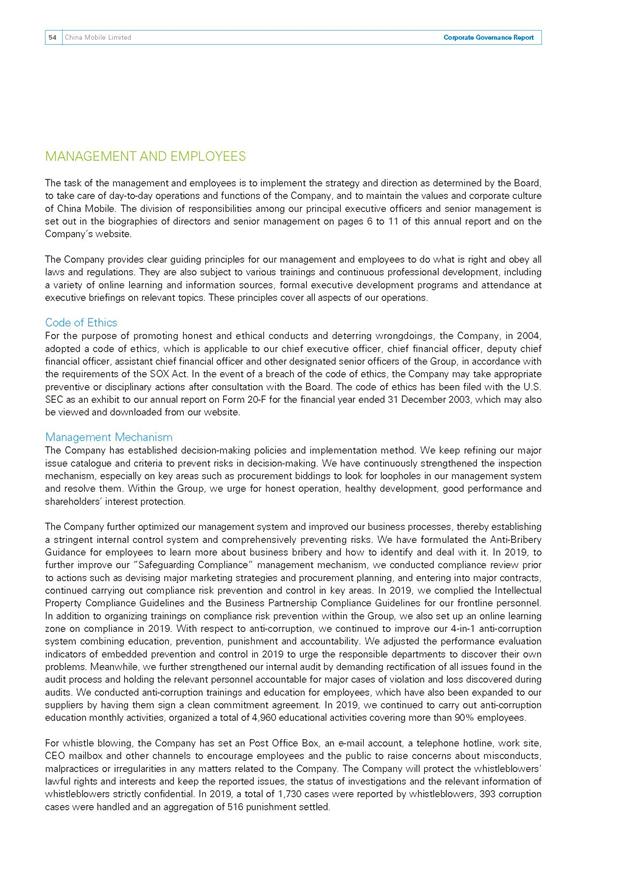
China Mobile Limited54 Corporate Governance Report 54 Corporate Governance Report MANAGEMENT AND EMPLOYEES The task of the management and employees is to implement the strategy and direction as determined by the Board, to take care of day-to-day operations and functions of the Company, and to maintain the values and corporate culture of China Mobile. The division of responsibilities among our principal executive officers and senior management is set out in the biographies of directors and senior management on pages 6 to 11 of this annual report and on the Company’s website. The Company provides clear guiding principles for our management and employees to do what is right and obey all laws and regulations. They are also subject to various trainings and continuous professional development, including a variety of online learning and information sources, formal executive development programs and attendance at executive briefings on relevant topics. These principles cover all aspects of our operations. Code of Ethics For the purpose of promoting honest and ethical conducts and deterring wrongdoings, the Company, in 2004, adopted a code of ethics, which is applicable to our chief executive officer, chief financial officer, deputy chief financial officer, assistant chief financial officer and other designated senior officers of the Group, in accordance with the requirements of the SOX Act. In the event of a breach of the code of ethics, the Company may take appropriate preventive or disciplinary actions after consultation with the Board. The code of ethics has been filed with the U.S. SEC as an exhibit to our annual report on Form 20-F for the financial year ended 31 December 2003, which may also be viewed and downloaded from our website. Management Mechanism The Company has established decision-making policies and implementation method. We keep refining our major issue catalogue and criteria to prevent risks in decision-making. We have continuously strengthened the inspection mechanism, especially on key areas such as procurement biddings to look for loopholes in our management system and resolve them. Within the Group, we urge for honest operation, healthy development, good performance and shareholders’ interest protection. The Company further optimized our management system and improved our business processes, thereby establishing a stringent internal control system and comprehensively preventing risks. We have formulated the Anti-Bribery Guidance for employees to learn more about business bribery and how to identify and deal with it. In 2019, to further improve our “Safeguarding Compliance” management mechanism, we conducted compliance review prior to actions such as devising major marketing strategies and procurement planning, and entering into major contracts, continued carrying out compliance risk prevention and control in key areas. In 2019, we complied the Intellectual Property Compliance Guidelines and the Business Partnership Compliance Guidelines for our frontline personnel. In addition to organizing trainings on compliance risk prevention within the Group, we also set up an online learning zone on compliance in 2019. With respect to anti-corruption, we continued to improve our 4-in-1 anti-corruption system combining education, prevention, punishment and accountability. We adjusted the performance evaluation indicators of embedded prevention and control in 2019 to urge the responsible departments to discover their own problems. Meanwhile, we further strengthened our internal audit by demanding rectification of all issues found in the audit process and holding the relevant personnel accountable for major cases of violation and loss discovered during audits. We conducted anti-corruption trainings and education for employees, which have also been expanded to our suppliers by having them sign a clean commitment agreement. In 2019, we continued to carry out anti-corruption education monthly activities, organized a total of 4,960 educational activities covering more than 90% employees. For whistle blowing, the Company has set an Post Office Box, an e-mail account, a telephone hotline, work site, CEO mailbox and other channels to encourage employees and the public to raise concerns about misconducts, malpractices or irregularities in any matters related to the Company. The Company will protect the whistleblowers’ lawful rights and interests and keep the reported issues, the status of investigations and the relevant information of whistleblowers strictly confidential. In 2019, a total of 1,730 cases were reported by whistleblowers, 393 corruption cases were handled and an aggregation of 516 punishment settled.
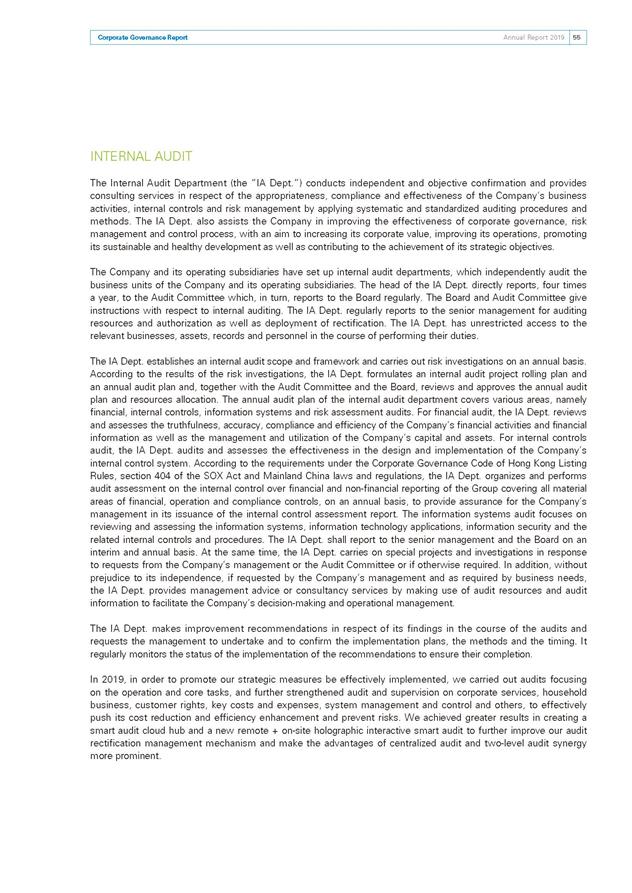
Annual Report 2019 55Corporate Governance Report 55Corporate Governance Report INTERNAL AUDIT The Internal Audit Department (the “IA Dept.”) conducts independent and objective confirmation and provides consulting services in respect of the appropriateness, compliance and effectiveness of the Company’s business activities, internal controls and risk management by applying systematic and standardized auditing procedures and methods. The IA Dept. also assists the Company in improving the effectiveness of corporate governance, risk management and control process, with an aim to increasing its corporate value, improving its operations, promoting its sustainable and healthy development as well as contributing to the achievement of its strategic objectives. The Company and its operating subsidiaries have set up internal audit departments, which independently audit the business units of the Company and its operating subsidiaries. The head of the IA Dept. directly reports, four times a year, to the Audit Committee which, in turn, reports to the Board regularly. The Board and Audit Committee give instructions with respect to internal auditing. The IA Dept. regularly reports to the senior management for auditing resources and authorization as well as deployment of rectification. The IA Dept. has unrestricted access to the relevant businesses, assets, records and personnel in the course of performing their duties. The IA Dept. establishes an internal audit scope and framework and carries out risk investigations on an annual basis. According to the results of the risk investigations, the IA Dept. formulates an internal audit project rolling plan and an annual audit plan and, together with the Audit Committee and the Board, reviews and approves the annual audit plan and resources allocation. The annual audit plan of the internal audit department covers various areas, namely financial, internal controls, information systems and risk assessment audits. For financial audit, the IA Dept. reviews and assesses the truthfulness, accuracy, compliance and efficiency of the Company’s financial activities and financial information as well as the management and utilization of the Company’s capital and assets. For internal controls audit, the IA Dept. audits and assesses the effectiveness in the design and implementation of the Company’s internal control system. According to the requirements under the Corporate Governance Code of Hong Kong Listing Rules, section 404 of the SOX Act and Mainland China laws and regulations, the IA Dept. organizes and performs audit assessment on the internal control over financial and non-financial reporting of the Group covering all material areas of financial, operation and compliance controls, on an annual basis, to provide assurance for the Company’s management in its issuance of the internal control assessment report. The information systems audit focuses on reviewing and assessing the information systems, information technology applications, information security and the related internal controls and procedures. The IA Dept. shall report to the senior management and the Board on an interim and annual basis. At the same time, the IA Dept. carries on special projects and investigations in response to requests from the Company’s management or the Audit Committee or if otherwise required. In addition, without prejudice to its independence, if requested by the Company’s management and as required by business needs, the IA Dept. provides management advice or consultancy services by making use of audit resources and audit information to facilitate the Company’s decision-making and operational management. The IA Dept. makes improvement recommendations in respect of its findings in the course of the audits and requests the management to undertake and to confirm the implementation plans, the methods and the timing. It regularly monitors the status of the implementation of the recommendations to ensure their completion. In 2019, in order to promote our strategic measures be effectively implemented, we carried out audits focusing on the operation and core tasks, and further strengthened audit and supervision on corporate services, household business, customer rights, key costs and expenses, system management and control and others, to effectively push its cost reduction and efficiency enhancement and prevent risks. We achieved greater results in creating a smart audit cloud hub and a new remote + on-site holographic interactive smart audit to further improve our audit rectification management mechanism and make the advantages of centralized audit and two-level audit synergy more prominent.
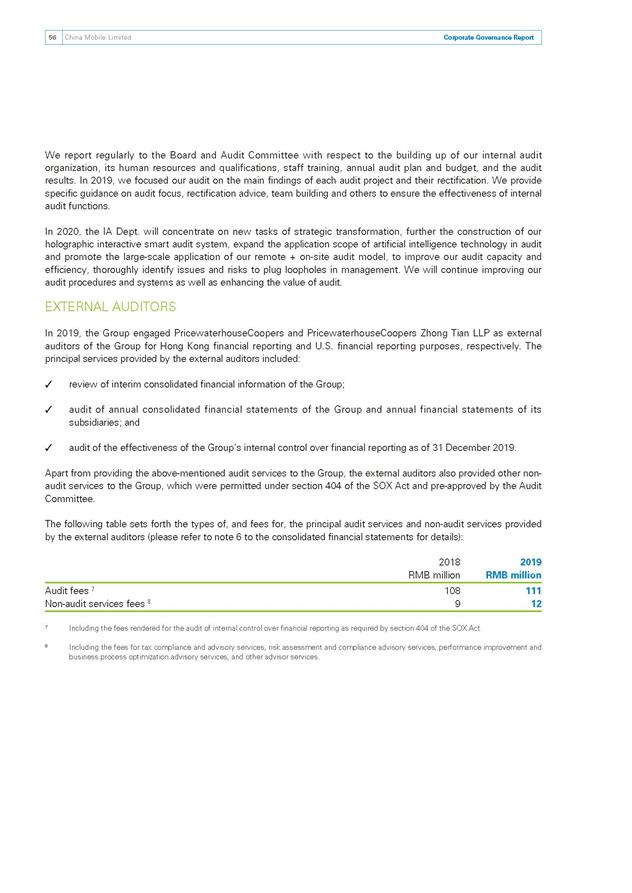
China Mobile Limited56 Corporate Governance Report 56 Corporate Governance Report We report regularly to the Board and Audit Committee with respect to the building up of our internal audit organization, its human resources and qualifications, staff training, annual audit plan and budget, and the audit results. In 2019, we focused our audit on the main findings of each audit project and their rectification. We provide specific guidance on audit focus, rectification advice, team building and others to ensure the effectiveness of internal audit functions. In 2020, the IA Dept. will concentrate on new tasks of strategic transformation, further the construction of our holographic interactive smart audit system, expand the application scope of artificial intelligence technology in audit and promote the large-scale application of our remote + on-site audit model, to improve our audit capacity and efficiency, thoroughly identify issues and risks to plug loopholes in management. We will continue improving our audit procedures and systems as well as enhancing the value of audit. EXTERNAL AUDITORS In 2019, the Group engaged PricewaterhouseCoopers and PricewaterhouseCoopers Zhong Tian LLP as external auditors of the Group for Hong Kong financial reporting and U.S. financial reporting purposes, respectively. The principal services provided by the external auditors included: . review of interim consolidated financial information of the Group; . audit of annual consolidated financial statements of the Group and annual financial statements of its subsidiaries; and . audit of the effectiveness of the Group’s internal control over financial reporting as of 31 December 2019. Apart from providing the above-mentioned audit services to the Group, the external auditors also provided other non- audit services to the Group, which were permitted under section 404 of the SOX Act and pre-approved by the Audit Committee. The following table sets forth the types of, and fees for, the principal audit services and non-audit services provided by the external auditors (please refer to note 6 to the consolidated financial statements for details): 2018 2019 RMB million RMB million Audit fees 7 108 111 Non-audit services fees 8 9 12 7 Including the fees rendered for the audit of internal control over financial reporting as required by section 404 of the SOX Act. 8 Including the fees for tax compliance and advisory services, risk assessment and compliance advisory services, performance improvement and business process optimization advisory services, and other advisor services.
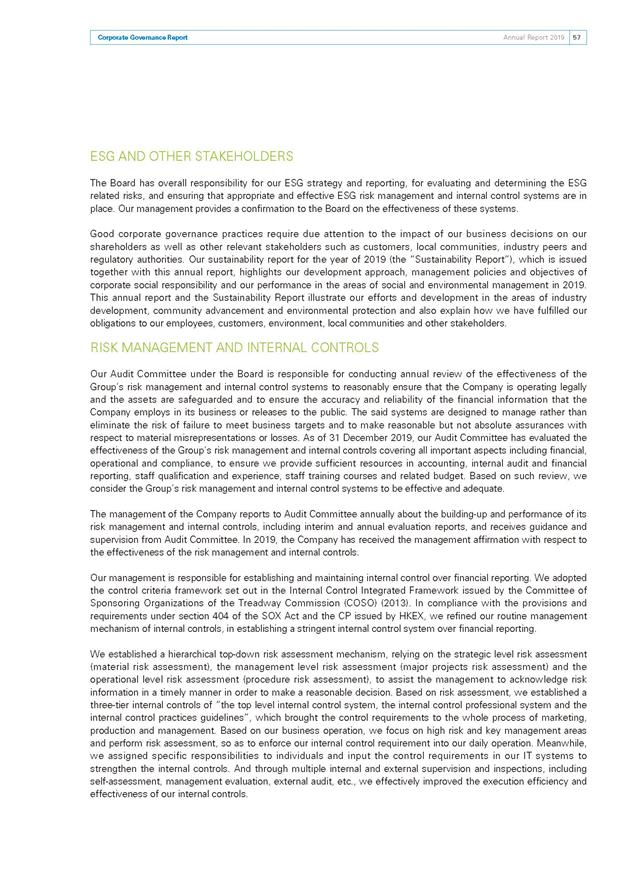
Annual Report 2019 57Corporate Governance Report 57Corporate Governance Report ESG AND OTHER STAKEHOLDERS The Board has overall responsibility for our ESG strategy and reporting, for evaluating and determining the ESG related risks, and ensuring that appropriate and effective ESG risk management and internal control systems are in place. Our management provides a confirmation to the Board on the effectiveness of these systems. Good corporate governance practices require due attention to the impact of our business decisions on our shareholders as well as other relevant stakeholders such as customers, local communities, industry peers and regulatory authorities. Our sustainability report for the year of 2019 (the “Sustainability Report”), which is issued together with this annual report, highlights our development approach, management policies and objectives of corporate social responsibility and our performance in the areas of social and environmental management in 2019. This annual report and the Sustainability Report illustrate our efforts and development in the areas of industry development, community advancement and environmental protection and also explain how we have fulfilled our obligations to our employees, customers, environment, local communities and other stakeholders. RISK MANAGEMENT AND INTERNAL CONTROLS Our Audit Committee under the Board is responsible for conducting annual review of the effectiveness of the Group’s risk management and internal control systems to reasonably ensure that the Company is operating legally and the assets are safeguarded and to ensure the accuracy and reliability of the financial information that the Company employs in its business or releases to the public. The said systems are designed to manage rather than eliminate the risk of failure to meet business targets and to make reasonable but not absolute assurances with respect to material misrepresentations or losses. As of 31 December 2019, our Audit Committee has evaluated the effectiveness of the Group’s risk management and internal controls covering all important aspects including financial, operational and compliance, to ensure we provide sufficient resources in accounting, internal audit and financial reporting, staff qualification and experience, staff training courses and related budget. Based on such review, we consider the Group’s risk management and internal control systems to be effective and adequate. The management of the Company reports to Audit Committee annually about the building-up and performance of its risk management and internal controls, including interim and annual evaluation reports, and receives guidance and supervision from Audit Committee. In 2019, the Company has received the management affirmation with respect to the effectiveness of the risk management and internal controls. Our management is responsible for establishing and maintaining internal control over financial reporting. We adopted the control criteria framework set out in the Internal Control Integrated Framework issued by the Committee of Sponsoring Organizations of the Treadway Commission (COSO) (2013). In compliance with the provisions and requirements under section 404 of the SOX Act and the CP issued by HKEX, we refined our routine management mechanism of internal controls, in establishing a stringent internal control system over financial reporting. We established a hierarchical top-down risk assessment mechanism, relying on the strategic level risk assessment (material risk assessment), the management level risk assessment (major projects risk assessment) and the operational level risk assessment (procedure risk assessment), to assist the management to acknowledge risk information in a timely manner in order to make a reasonable decision. Based on risk assessment, we established a three-tier internal controls of “the top level internal control system, the internal control professional system and the internal control practices guidelines”, which brought the control requirements to the whole process of marketing, production and management. Based on our business operation, we focus on high risk and key management areas and perform risk assessment, so as to enforce our internal control requirement into our daily operation. Meanwhile, we assigned specific responsibilities to individuals and input the control requirements in our IT systems to strengthen the internal controls. And through multiple internal and external supervision and inspections, including self-assessment, management evaluation, external audit, etc., we effectively improved the execution efficiency and effectiveness of our internal controls.
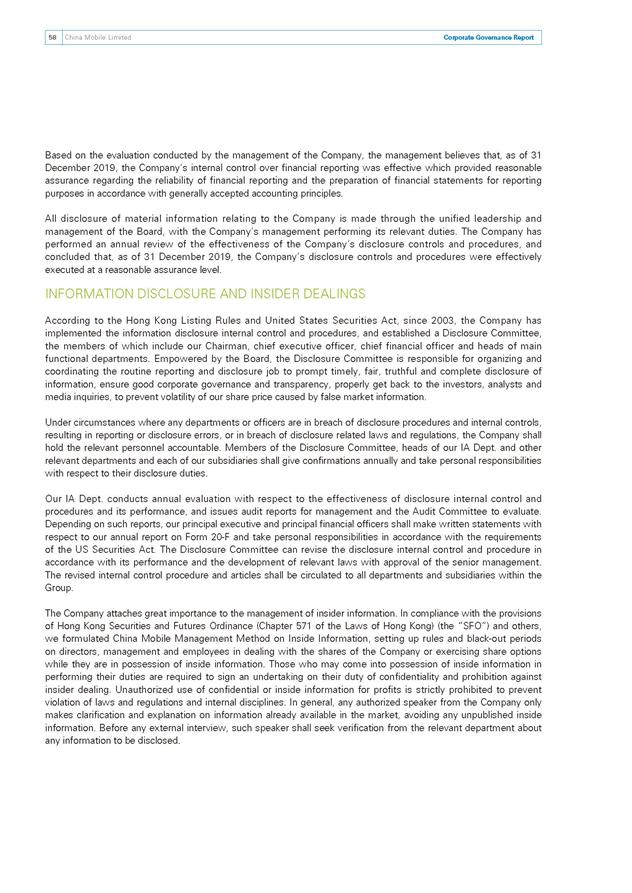
China Mobile Limited58 Corporate Governance Report 58 Corporate Governance Report Based on the evaluation conducted by the management of the Company, the management believes that, as of 31 December 2019, the Company’s internal control over financial reporting was effective which provided reasonable assurance regarding the reliability of financial reporting and the preparation of financial statements for reporting purposes in accordance with generally accepted accounting principles. All disclosure of material information relating to the Company is made through the unified leadership and management of the Board, with the Company’s management performing its relevant duties. The Company has performed an annual review of the effectiveness of the Company’s disclosure controls and procedures, and concluded that, as of 31 December 2019, the Company’s disclosure controls and procedures were effectively executed at a reasonable assurance level. INFORMATION DISCLOSURE AND INSIDER DEALINGS According to the Hong Kong Listing Rules and United States Securities Act, since 2003, the Company has implemented the information disclosure internal control and procedures, and established a Disclosure Committee, the members of which include our Chairman, chief executive officer, chief financial officer and heads of main functional departments. Empowered by the Board, the Disclosure Committee is responsible for organizing and coordinating the routine reporting and disclosure job to prompt timely, fair, truthful and complete disclosure of information, ensure good corporate governance and transparency, properly get back to the investors, analysts and media inquiries, to prevent volatility of our share price caused by false market information. Under circumstances where any departments or officers are in breach of disclosure procedures and internal controls, resulting in reporting or disclosure errors, or in breach of disclosure related laws and regulations, the Company shall hold the relevant personnel accountable. Members of the Disclosure Committee, heads of our IA Dept. and other relevant departments and each of our subsidiaries shall give confirmations annually and take personal responsibilities with respect to their disclosure duties. Our IA Dept. conducts annual evaluation with respect to the effectiveness of disclosure internal control and procedures and its performance, and issues audit reports for management and the Audit Committee to evaluate. Depending on such reports, our principal executive and principal financial officers shall make written statements with respect to our annual report on Form 20-F and take personal responsibilities in accordance with the requirements of the US Securities Act. The Disclosure Committee can revise the disclosure internal control and procedure in accordance with its performance and the development of relevant laws with approval of the senior management. The revised internal control procedure and articles shall be circulated to all departments and subsidiaries within the Group. The Company attaches great importance to the management of insider information. In compliance with the provisions of Hong Kong Securities and Futures Ordinance (Chapter 571 of the Laws of Hong Kong) (the “SFO”) and others, we formulated China Mobile Management Method on Inside Information, setting up rules and black-out periods on directors, management and employees in dealing with the shares of the Company or exercising share options while they are in possession of inside information. Those who may come into possession of inside information in performing their duties are required to sign an undertaking on their duty of confidentiality and prohibition against insider dealing. Unauthorized use of confidential or inside information for profits is strictly prohibited to prevent violation of laws and regulations and internal disciplines. In general, any authorized speaker from the Company only makes clarification and explanation on information already available in the market, avoiding any unpublished inside information. Before any external interview, such speaker shall seek verification from the relevant department about any information to be disclosed.
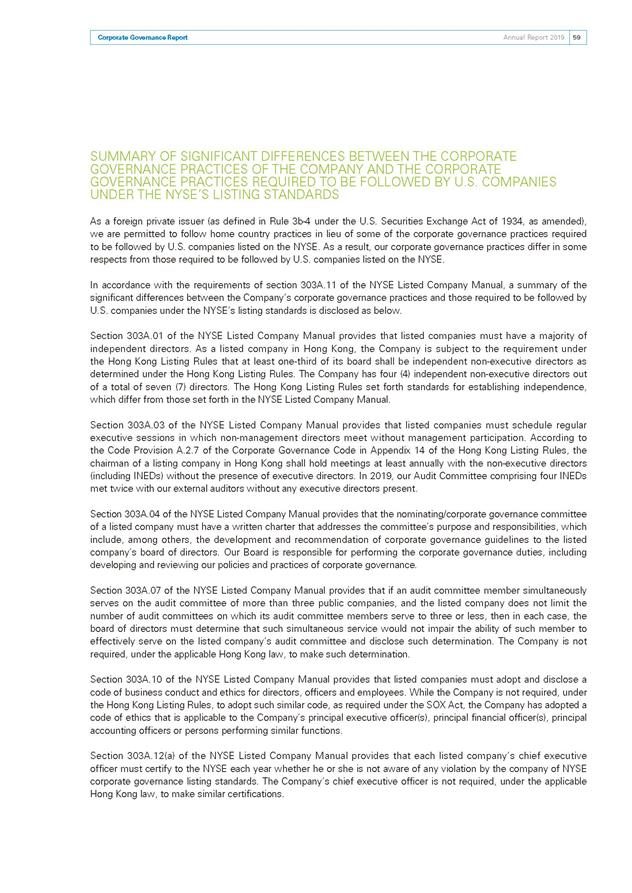
Annual Report 2019 59Corporate Governance Report 59Corporate Governance Report SUMMARY OF SIGNIFICANT DIFFERENCES BETWEEN THE CORPORATE GOVERNANCE PRACTICES OF THE COMPANY AND THE CORPORATE GOVERNANCE PRACTICES REQUIRED TO BE FOLLOWED BY U.S. COMPANIES UNDER THE NYSE’S LISTING STANDARDS As a foreign private issuer (as defined in Rule 3b-4 under the U.S. Securities Exchange Act of 1934, as amended), we are permitted to follow home country practices in lieu of some of the corporate governance practices required to be followed by U.S. companies listed on the NYSE. As a result, our corporate governance practices differ in some respects from those required to be followed by U.S. companies listed on the NYSE. In accordance with the requirements of section 303A.11 of the NYSE Listed Company Manual, a summary of the significant differences between the Company’s corporate governance practices and those required to be followed by U.S. companies under the NYSE’s listing standards is disclosed as below. Section 303A.01 of the NYSE Listed Company Manual provides that listed companies must have a majority of independent directors. As a listed company in Hong Kong, the Company is subject to the requirement under the Hong Kong Listing Rules that at least one-third of its board shall be independent non-executive directors as determined under the Hong Kong Listing Rules. The Company has four (4) independent non-executive directors out of a total of seven (7) directors. The Hong Kong Listing Rules set forth standards for establishing independence, which differ from those set forth in the NYSE Listed Company Manual. Section 303A.03 of the NYSE Listed Company Manual provides that listed companies must schedule regular executive sessions in which non-management directors meet without management participation. According to the Code Provision A.2.7 of the Corporate Governance Code in Appendix 14 of the Hong Kong Listing Rules, the chairman of a listing company in Hong Kong shall hold meetings at least annually with the non-executive directors (including INEDs) without the presence of executive directors. In 2019, our Audit Committee comprising four INEDs met twice with our external auditors without any executive directors present. Section 303A.04 of the NYSE Listed Company Manual provides that the nominating/corporate governance committee of a listed company must have a written charter that addresses the committee’s purpose and responsibilities, which include, among others, the development and recommendation of corporate governance guidelines to the listed company’s board of directors. Our Board is responsible for performing the corporate governance duties, including developing and reviewing our policies and practices of corporate governance. Section 303A.07 of the NYSE Listed Company Manual provides that if an audit committee member simultaneously serves on the audit committee of more than three public companies, and the listed company does not limit the number of audit committees on which its audit committee members serve to three or less, then in each case, the board of directors must determine that such simultaneous service would not impair the ability of such member to effectively serve on the listed company’s audit committee and disclose such determination. The Company is not required, under the applicable Hong Kong law, to make such determination. Section 303A.10 of the NYSE Listed Company Manual provides that listed companies must adopt and disclose a code of business conduct and ethics for directors, officers and employees. While the Company is not required, under the Hong Kong Listing Rules, to adopt such similar code, as required under the SOX Act, the Company has adopted a code of ethics that is applicable to the Company’s principal executive officer(s), principal financial officer(s), principal accounting officers or persons performing similar functions. Section 303A.12(a) of the NYSE Listed Company Manual provides that each listed company’s chief executive officer must certify to the NYSE each year whether he or she is not aware of any violation by the company of NYSE corporate governance listing standards. The Company’s chief executive officer is not required, under the applicable Hong Kong law, to make similar certifications.
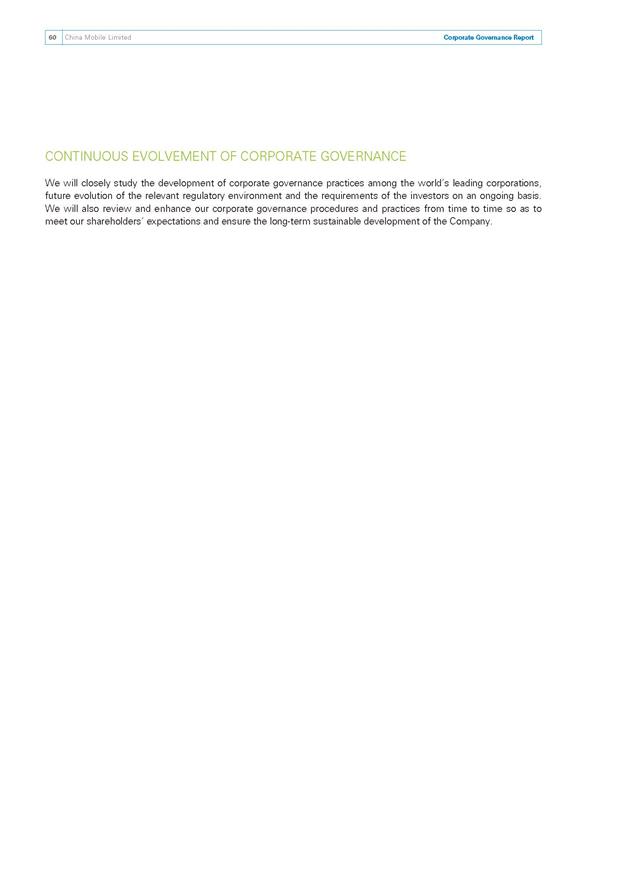
China Mobile Limited60 Corporate Governance Report 60 Corporate Governance Report CONTINUOUS EVOLVEMENT OF CORPORATE GOVERNANCE We will closely study the development of corporate governance practices among the world’s leading corporations, future evolution of the relevant regulatory environment and the requirements of the investors on an ongoing basis. We will also review and enhance our corporate governance procedures and practices from time to time so as to meet our shareholders’ expectations and ensure the long-term sustainable development of the Company.
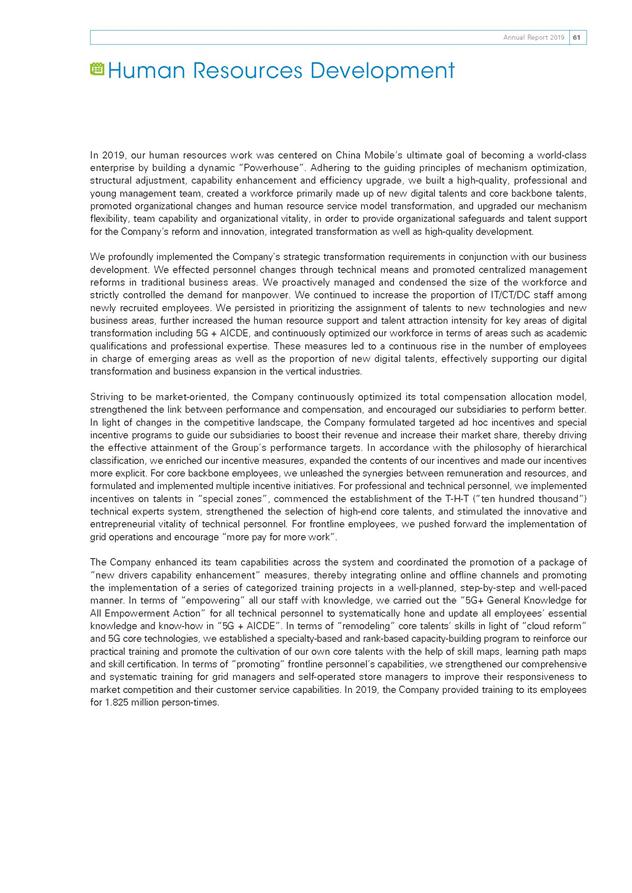
Annual Report 2019 61 61 Human Resources Development In 2019, our human resources work was centered on China Mobile’s ultimate goal of becoming a world-class enterprise by building a dynamic “Powerhouse”. Adhering to the guiding principles of mechanism optimization, structural adjustment, capability enhancement and efficiency upgrade, we built a high-quality, professional and young management team, created a workforce primarily made up of new digital talents and core backbone talents, promoted organizational changes and human resource service model transformation, and upgraded our mechanism flexibility, team capability and organizational vitality, in order to provide organizational safeguards and talent support for the Company’s reform and innovation, integrated transformation as well as high-quality development. We profoundly implemented the Company’s strategic transformation requirements in conjunction with our business development. We effected personnel changes through technical means and promoted centralized management reforms in traditional business areas. We proactively managed and condensed the size of the workforce and strictly controlled the demand for manpower. We continued to increase the proportion of IT/CT/DC staff among newly recruited employees. We persisted in prioritizing the assignment of talents to new technologies and new business areas, further increased the human resource support and talent attraction intensity for key areas of digital transformation including 5G + AICDE, and continuously optimized our workforce in terms of areas such as academic qualifications and professional expertise. These measures led to a continuous rise in the number of employees in charge of emerging areas as well as the proportion of new digital talents, effectively supporting our digital transformation and business expansion in the vertical industries. Striving to be market-oriented, the Company continuously optimized its total compensation allocation model, strengthened the link between performance and compensation, and encouraged our subsidiaries to perform better. In light of changes in the competitive landscape, the Company formulated targeted ad hoc incentives and special incentive programs to guide our subsidiaries to boost their revenue and increase their market share, thereby driving the effective attainment of the Group’s performance targets. In accordance with the philosophy of hierarchical classification, we enriched our incentive measures, expanded the contents of our incentives and made our incentives more explicit. For core backbone employees, we unleashed the synergies between remuneration and resources, and formulated and implemented multiple incentive initiatives. For professional and technical personnel, we implemented incentives on talents in “special zones”, commenced the establishment of the T-H-T (“ten hundred thousand”) technical experts system, strengthened the selection of high-end core talents, and stimulated the innovative and entrepreneurial vitality of technical personnel. For frontline employees, we pushed forward the implementation of grid operations and encourage “more pay for more work”. The Company enhanced its team capabilities across the system and coordinated the promotion of a package of “new drivers capability enhancement” measures, thereby integrating online and offline channels and promoting the implementation of a series of categorized training projects in a well-planned, step-by-step and well-paced manner. In terms of “empowering” all our staff with knowledge, we carried out the “5G+ General Knowledge for All Empowerment Action” for all technical personnel to systematically hone and update all employees’ essential knowledge and know-how in “5G + AICDE”. In terms of “remodeling” core talents’ skills in light of “cloud reform” and 5G core technologies, we established a specialty-based and rank-based capacity-building program to reinforce our practical training and promote the cultivation of our own core talents with the help of skill maps, learning path maps and skill certification. In terms of “promoting” frontline personnel’s capabilities, we strengthened our comprehensive and systematic training for grid managers and self-operated store managers to improve their responsiveness to market competition and their customer service capabilities. In 2019, the Company provided training to its employees for 1.825 million person-times.
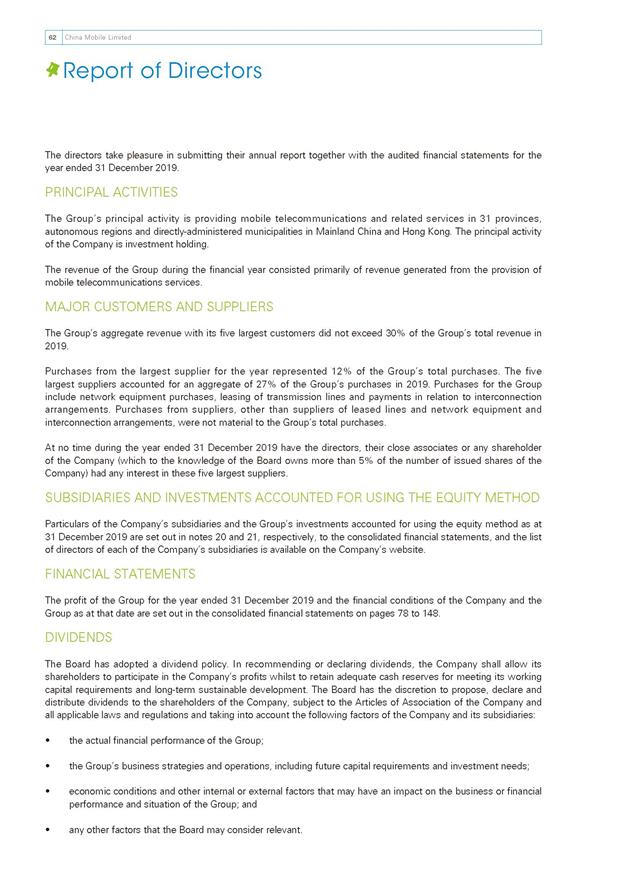
China Mobile Limited62 62 Report of Directors The directors take pleasure in submitting their annual report together with the audited financial statements for the year ended 31 December 2019. PRINCIPAL ACTIVITIES The Group’s principal activity is providing mobile telecommunications and related services in 31 provinces, autonomous regions and directly-administered municipalities in Mainland China and Hong Kong. The principal activity of the Company is investment holding. The revenue of the Group during the financial year consisted primarily of revenue generated from the provision of mobile telecommunications services. MAJOR CUSTOMERS AND SUPPLIERS The Group’s aggregate revenue with its five largest customers did not exceed 30% of the Group’s total revenue in 2019. Purchases from the largest supplier for the year represented 12% of the Group’s total purchases. The five largest suppliers accounted for an aggregate of 27% of the Group’s purchases in 2019. Purchases for the Group include network equipment purchases, leasing of transmission lines and payments in relation to interconnection arrangements. Purchases from suppliers, other than suppliers of leased lines and network equipment and interconnection arrangements, were not material to the Group’s total purchases. At no time during the year ended 31 December 2019 have the directors, their close associates or any shareholder of the Company (which to the knowledge of the Board owns more than 5% of the number of issued shares of the Company) had any interest in these five largest suppliers. SUBSIDIARIES AND INVESTMENTS ACCOUNTED FOR USING THE EQUITY METHOD Particulars of the Company’s subsidiaries and the Group’s investments accounted for using the equity method as at 31 December 2019 are set out in notes 20 and 21, respectively, to the consolidated financial statements, and the list of directors of each of the Company’s subsidiaries is available on the Company’s website. FINANCIAL STATEMENTS The profit of the Group for the year ended 31 December 2019 and the financial conditions of the Company and the Group as at that date are set out in the consolidated financial statements on pages 78 to 148. DIVIDENDS The Board has adopted a dividend policy. In recommending or declaring dividends, the Company shall allow its shareholders to participate in the Company’s profits whilst to retain adequate cash reserves for meeting its working capital requirements and long-term sustainable development. The Board has the discretion to propose, declare and distribute dividends to the shareholders of the Company, subject to the Articles of Association of the Company and all applicable laws and regulations and taking into account the following factors of the Company and its subsidiaries: • the actual financial performance of the Group; • the Group’s business strategies and operations, including future capital requirements and investment needs; • economic conditions and other internal or external factors that may have an impact on the business or financial performance and situation of the Group; and • any other factors that the Board may consider relevant.
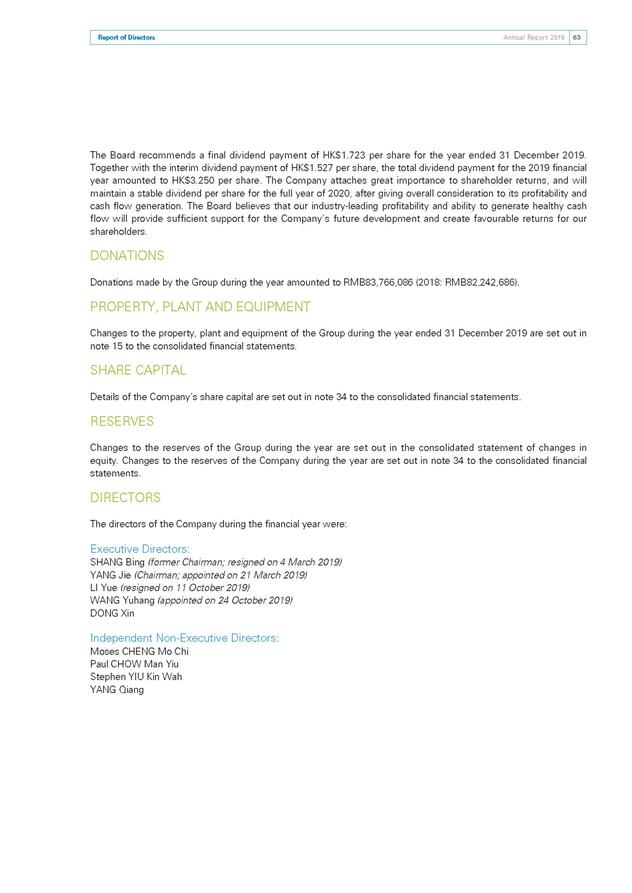
Annual Report 2019 63Report of Directors 63Report of Directors The Board recommends a final dividend payment of HK$1.723 per share for the year ended 31 December 2019. Together with the interim dividend payment of HK$1.527 per share, the total dividend payment for the 2019 financial year amounted to HK$3.250 per share. The Company attaches great importance to shareholder returns, and will maintain a stable dividend per share for the full year of 2020, after giving overall consideration to its profitability and cash flow generation. The Board believes that our industry-leading profitability and ability to generate healthy cash flow will provide sufficient support for the Company’s future development and create favourable returns for our shareholders. DONATIONS Donations made by the Group during the year amounted to RMB83,766,086 (2018: RMB82,242,686). PROPERTY, PLANT AND EQUIPMENT Changes to the property, plant and equipment of the Group during the year ended 31 December 2019 are set out in note 15 to the consolidated financial statements. SHARE CAPITAL Details of the Company’s share capital are set out in note 34 to the consolidated financial statements. RESERVES Changes to the reserves of the Group during the year are set out in the consolidated statement of changes in equity. Changes to the reserves of the Company during the year are set out in note 34 to the consolidated financial statements. DIRECTORS The directors of the Company during the financial year were: Executive Directors: SHANG Bing (former Chairman; resigned on 4 March 2019) YANG Jie (Chairman; appointed on 21 March 2019) LI Yue (resigned on 11 October 2019) WANG Yuhang (appointed on 24 October 2019) DONG Xin Independent Non-Executive Directors: Moses CHENG Mo Chi Paul CHOW Man Yiu Stephen YIU Kin Wah YANG Qiang
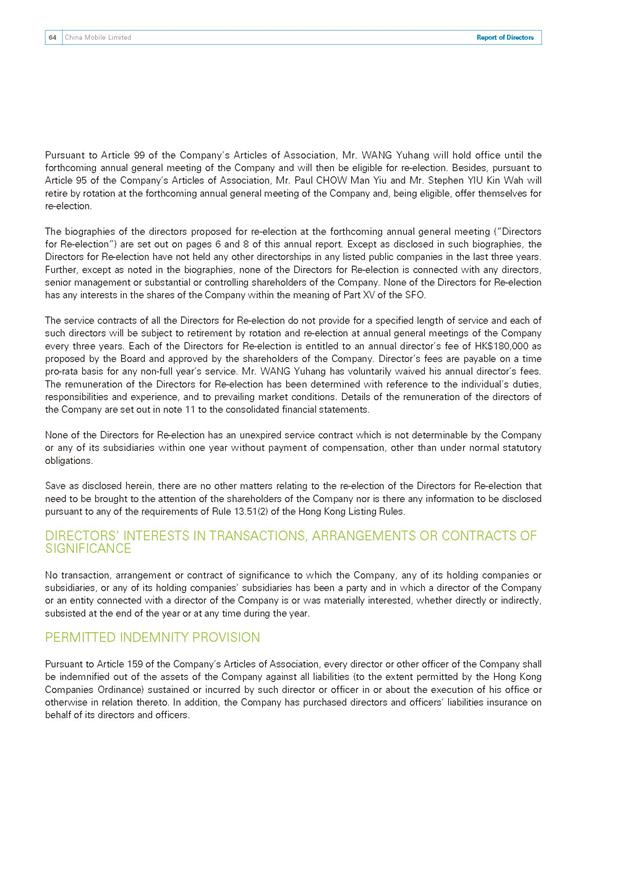
China Mobile Limited64 Report of Directors 64 Report of Directors Pursuant to Article 99 of the Company’s Articles of Association, Mr. WANG Yuhang will hold office until the forthcoming annual general meeting of the Company and will then be eligible for re-election. Besides, pursuant to Article 95 of the Company’s Articles of Association, Mr. Paul CHOW Man Yiu and Mr. Stephen YIU Kin Wah will retire by rotation at the forthcoming annual general meeting of the Company and, being eligible, offer themselves for re-election. The biographies of the directors proposed for re-election at the forthcoming annual general meeting (“Directors for Re-election”) are set out on pages 6 and 8 of this annual report. Except as disclosed in such biographies, the Directors for Re-election have not held any other directorships in any listed public companies in the last three years. Further, except as noted in the biographies, none of the Directors for Re-election is connected with any directors, senior management or substantial or controlling shareholders of the Company. None of the Directors for Re-election has any interests in the shares of the Company within the meaning of Part XV of the SFO. The service contracts of all the Directors for Re-election do not provide for a specified length of service and each of such directors will be subject to retirement by rotation and re-election at annual general meetings of the Company every three years. Each of the Directors for Re-election is entitled to an annual director’s fee of HK$180,000 as proposed by the Board and approved by the shareholders of the Company. Director’s fees are payable on a time pro-rata basis for any non-full year’s service. Mr. WANG Yuhang has voluntarily waived his annual director’s fees. The remuneration of the Directors for Re-election has been determined with reference to the individual’s duties, responsibilities and experience, and to prevailing market conditions. Details of the remuneration of the directors of the Company are set out in note 11 to the consolidated financial statements. None of the Directors for Re-election has an unexpired service contract which is not determinable by the Company or any of its subsidiaries within one year without payment of compensation, other than under normal statutory obligations. Save as disclosed herein, there are no other matters relating to the re-election of the Directors for Re-election that need to be brought to the attention of the shareholders of the Company nor is there any information to be disclosed pursuant to any of the requirements of Rule 13.51(2) of the Hong Kong Listing Rules. DIRECTORS’ INTERESTS IN TRANSACTIONS, ARRANGEMENTS OR CONTRACTS OF SIGNIFICANCE No transaction, arrangement or contract of significance to which the Company, any of its holding companies or subsidiaries, or any of its holding companies’ subsidiaries has been a party and in which a director of the Company or an entity connected with a director of the Company is or was materially interested, whether directly or indirectly, subsisted at the end of the year or at any time during the year. PERMITTED INDEMNITY PROVISION Pursuant to Article 159 of the Company’s Articles of Association, every director or other officer of the Company shall be indemnified out of the assets of the Company against all liabilities (to the extent permitted by the Hong Kong Companies Ordinance) sustained or incurred by such director or officer in or about the execution of his office or otherwise in relation thereto. In addition, the Company has purchased directors and officers’ liabilities insurance on behalf of its directors and officers.
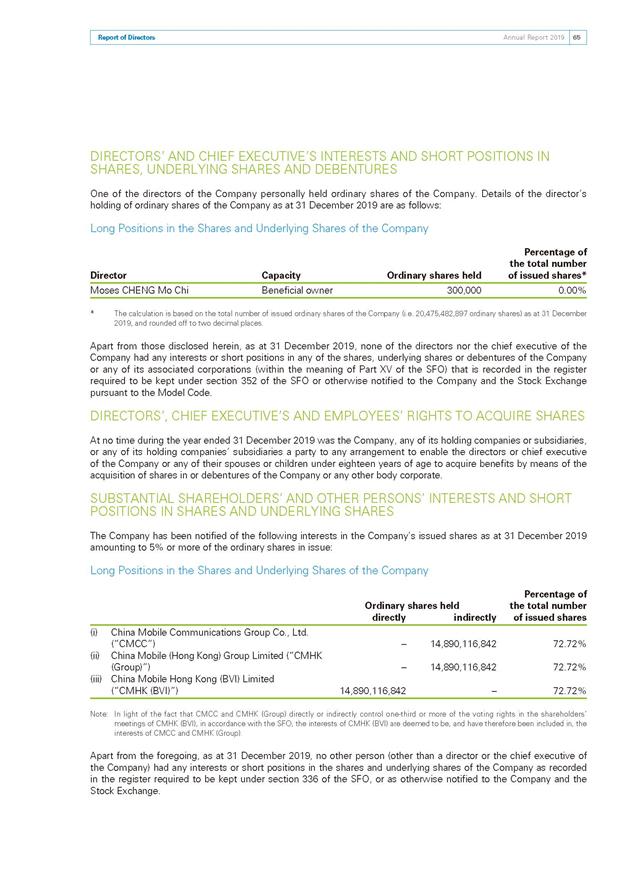
Report of Directors Annual Report 2019 65 DIRECTORS’ AND CHIEF EXECUTIVE’S INTERESTS AND SHORT POSITIONS IN SHARES, UNDERLYING SHARES AND DEBENTURES One of the directors of the Company personally held ordinary shares of the Company. Details of the director’s holding of ordinary shares of the Company as at 31 December 2019 are as follows: Long Positions in the Shares and Underlying Shares of the Company Percentage of the total number Director Capacity Ordinary shares held of issued shares* Moses CHENG Mo Chi Beneficial owner 300,000 0.00% * The calculation is based on the total number of issued ordinary shares of the Company (i.e. 20,475,482,897 ordinary shares) as at 31 December 2019, and rounded off to two decimal places. Apart from those disclosed herein, as at 31 December 2019, none of the directors nor the chief executive of the Company had any interests or short positions in any of the shares, underlying shares or debentures of the Company or any of its associated corporations (within the meaning of Part XV of the SFO) that is recorded in the register required to be kept under section 352 of the SFO or otherwise notified to the Company and the Stock Exchange pursuant to the Model Code. DIRECTORS’, CHIEF EXECUTIVE’S AND EMPLOYEES’ RIGHTS TO ACQUIRE SHARES At no time during the year ended 31 December 2019 was the Company, any of its holding companies or subsidiaries, or any of its holding companies’ subsidiaries a party to any arrangement to enable the directors or chief executive of the Company or any of their spouses or children under eighteen years of age to acquire benefits by means of the acquisition of shares in or debentures of the Company or any other body corporate. SUBSTANTIAL SHAREHOLDERS’ AND OTHER PERSONS’ INTERESTS AND SHORT POSITIONS IN SHARES AND UNDERLYING SHARES The Company has been notified of the following interests in the Company’s issued shares as at 31 December 2019 amounting to 5% or more of the ordinary shares in issue: Long Positions in the Shares and Underlying Shares of the Company Percentage of Ordinary shares held the total number directly indirectly of issued shares (i) China Mobile Communications Group Co., Ltd. (“CMCC”) – 14,890,116,842 72.72% (ii) China Mobile (Hong Kong) Group Limited (“CMHK (Group)”) – 14,890,116,842 72.72% (iii) China Mobile Hong Kong (BVI) Limited (“CMHK (BVI)”) 14,890,116,842 – 72.72% Note: In light of the fact that CMCC and CMHK (Group) directly or indirectly control one-third or more of the voting rights in the shareholders’ meetings of CMHK (BVI), in accordance with the SFO, the interests of CMHK (BVI) are deemed to be, and have therefore been included in, the interests of CMCC and CMHK (Group). Apart from the foregoing, as at 31 December 2019, no other person (other than a director or the chief executive of the Company) had any interests or short positions in the shares and underlying shares of the Company as recorded in the register required to be kept under section 336 of the SFO, or as otherwise notified to the Company and the Stock Exchange.
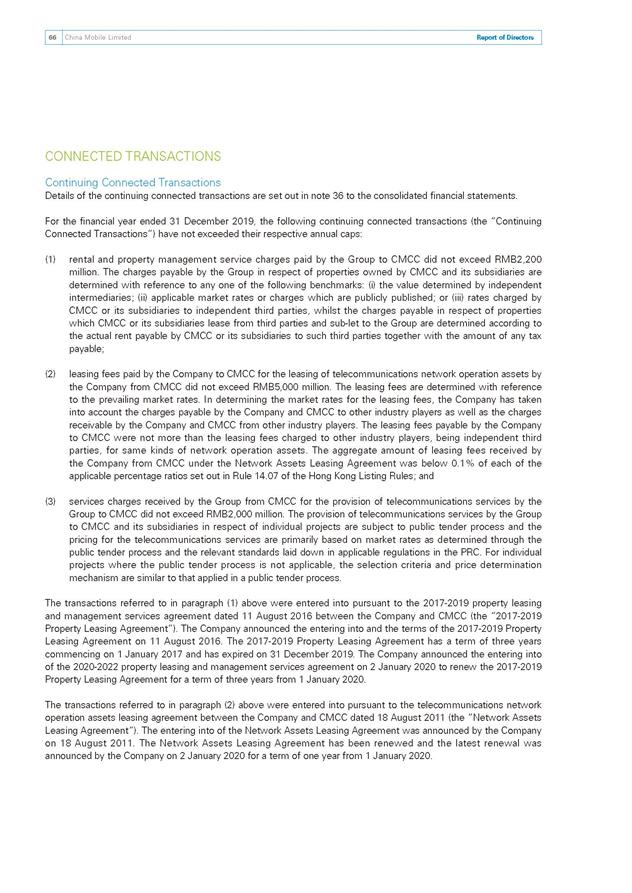
China Mobile Limited66 Report of Directors 66 Report of Directors CONNECTED TRANSACTIONS Continuing Connected Transactions Details of the continuing connected transactions are set out in note 36 to the consolidated financial statements. For the financial year ended 31 December 2019, the following continuing connected transactions (the “Continuing Connected Transactions”) have not exceeded their respective annual caps: (1) rental and property management service charges paid by the Group to CMCC did not exceed RMB2,200 million. The charges payable by the Group in respect of properties owned by CMCC and its subsidiaries are determined with reference to any one of the following benchmarks: (i) the value determined by independent intermediaries; (ii) applicable market rates or charges which are publicly published; or (iii) rates charged by CMCC or its subsidiaries to independent third parties, whilst the charges payable in respect of properties which CMCC or its subsidiaries lease from third parties and sub-let to the Group are determined according to the actual rent payable by CMCC or its subsidiaries to such third parties together with the amount of any tax payable; (2) leasing fees paid by the Company to CMCC for the leasing of telecommunications network operation assets by the Company from CMCC did not exceed RMB5,000 million. The leasing fees are determined with reference to the prevailing market rates. In determining the market rates for the leasing fees, the Company has taken into account the charges payable by the Company and CMCC to other industry players as well as the charges receivable by the Company and CMCC from other industry players. The leasing fees payable by the Company to CMCC were not more than the leasing fees charged to other industry players, being independent third parties, for same kinds of network operation assets. The aggregate amount of leasing fees received by the Company from CMCC under the Network Assets Leasing Agreement was below 0.1% of each of the applicable percentage ratios set out in Rule 14.07 of the Hong Kong Listing Rules; and (3) services charges received by the Group from CMCC for the provision of telecommunications services by the Group to CMCC did not exceed RMB2,000 million. The provision of telecommunications services by the Group to CMCC and its subsidiaries in respect of individual projects are subject to public tender process and the pricing for the telecommunications services are primarily based on market rates as determined through the public tender process and the relevant standards laid down in applicable regulations in the PRC. For individual projects where the public tender process is not applicable, the selection criteria and price determination mechanism are similar to that applied in a public tender process. The transactions referred to in paragraph (1) above were entered into pursuant to the 2017-2019 property leasing and management services agreement dated 11 August 2016 between the Company and CMCC (the “2017-2019 Property Leasing Agreement”). The Company announced the entering into and the terms of the 2017-2019 Property Leasing Agreement on 11 August 2016. The 2017-2019 Property Leasing Agreement has a term of three years commencing on 1 January 2017 and has expired on 31 December 2019. The Company announced the entering into of the 2020-2022 property leasing and management services agreement on 2 January 2020 to renew the 2017-2019 Property Leasing Agreement for a term of three years from 1 January 2020. The transactions referred to in paragraph (2) above were entered into pursuant to the telecommunications network operation assets leasing agreement between the Company and CMCC dated 18 August 2011 (the “Network Assets Leasing Agreement”). The entering into of the Network Assets Leasing Agreement was announced by the Company on 18 August 2011. The Network Assets Leasing Agreement has been renewed and the latest renewal was announced by the Company on 2 January 2020 for a term of one year from 1 January 2020.
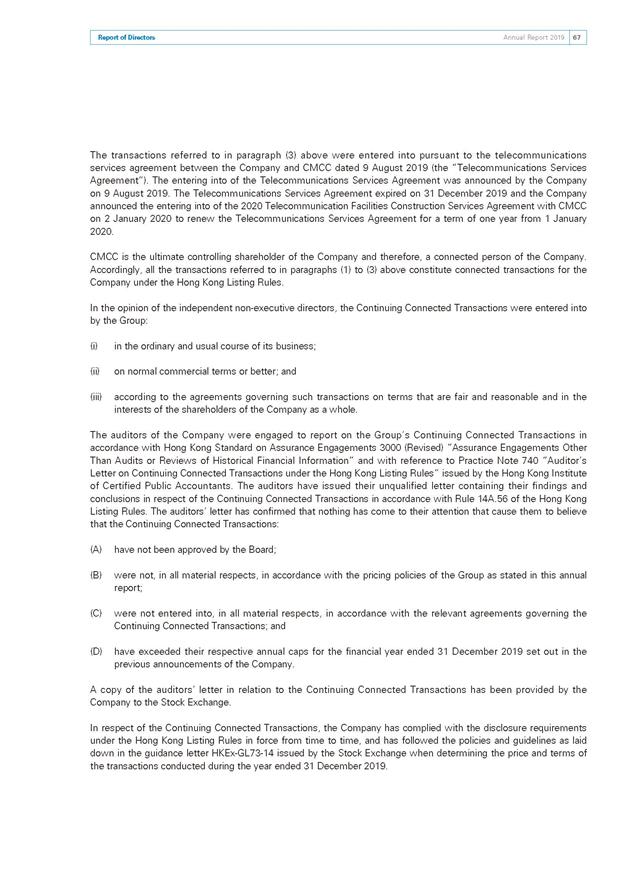
Annual Report 2019 67Report of Directors 67Report of Directors The transactions referred to in paragraph (3) above were entered into pursuant to the telecommunications services agreement between the Company and CMCC dated 9 August 2019 (the “Telecommunications Services Agreement”). The entering into of the Telecommunications Services Agreement was announced by the Company on 9 August 2019. The Telecommunications Services Agreement expired on 31 December 2019 and the Company announced the entering into of the 2020 Telecommunication Facilities Construction Services Agreement with CMCC on 2 January 2020 to renew the Telecommunications Services Agreement for a term of one year from 1 January 2020. CMCC is the ultimate controlling shareholder of the Company and therefore, a connected person of the Company. Accordingly, all the transactions referred to in paragraphs (1) to (3) above constitute connected transactions for the Company under the Hong Kong Listing Rules. In the opinion of the independent non-executive directors, the Continuing Connected Transactions were entered into by the Group: (i) in the ordinary and usual course of its business; (ii) on normal commercial terms or better; and (iii) according to the agreements governing such transactions on terms that are fair and reasonable and in the interests of the shareholders of the Company as a whole. The auditors of the Company were engaged to report on the Group’s Continuing Connected Transactions in accordance with Hong Kong Standard on Assurance Engagements 3000 (Revised) “Assurance Engagements Other Than Audits or Reviews of Historical Financial Information” and with reference to Practice Note 740 “Auditor’s Letter on Continuing Connected Transactions under the Hong Kong Listing Rules” issued by the Hong Kong Institute of Certified Public Accountants. The auditors have issued their unqualified letter containing their findings and conclusions in respect of the Continuing Connected Transactions in accordance with Rule 14A.56 of the Hong Kong Listing Rules. The auditors’ letter has confirmed that nothing has come to their attention that cause them to believe that the Continuing Connected Transactions: (A) have not been approved by the Board; (B) were not, in all material respects, in accordance with the pricing policies of the Group as stated in this annual report; (C) were not entered into, in all material respects, in accordance with the relevant agreements governing the Continuing Connected Transactions; and (D) have exceeded their respective annual caps for the financial year ended 31 December 2019 set out in the previous announcements of the Company. A copy of the auditors’ letter in relation to the Continuing Connected Transactions has been provided by the Company to the Stock Exchange. In respect of the Continuing Connected Transactions, the Company has complied with the disclosure requirements under the Hong Kong Listing Rules in force from time to time, and has followed the policies and guidelines as laid down in the guidance letter HKEx-GL73-14 issued by the Stock Exchange when determining the price and terms of the transactions conducted during the year ended 31 December 2019.
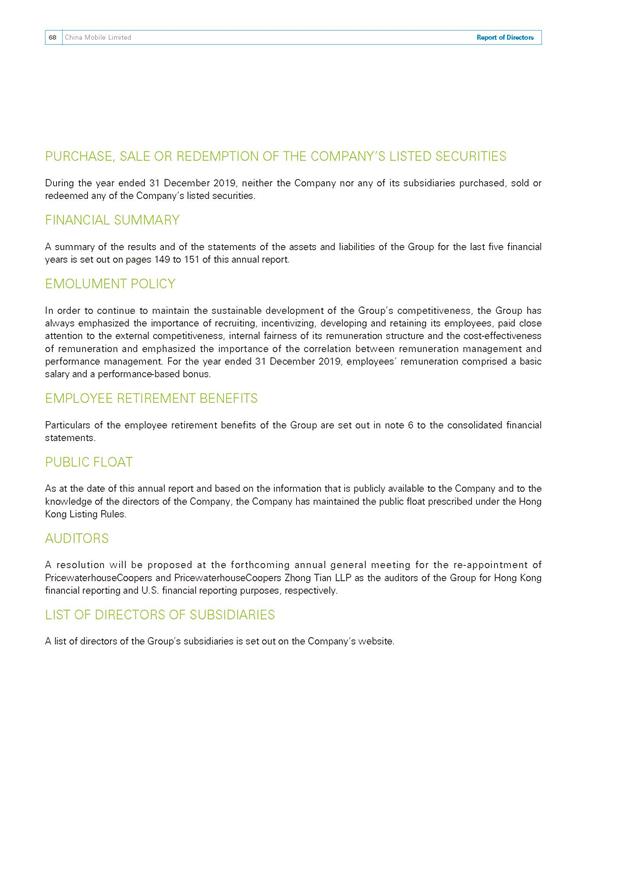
China Mobile Limited68 Report of Directors 68 Report of Directors PURCHASE, SALE OR REDEMPTION OF THE COMPANY’S LISTED SECURITIES During the year ended 31 December 2019, neither the Company nor any of its subsidiaries purchased, sold or redeemed any of the Company’s listed securities. FINANCIAL SUMMARY A summary of the results and of the statements of the assets and liabilities of the Group for the last five financial years is set out on pages 149 to 151 of this annual report. EMOLUMENT POLICY In order to continue to maintain the sustainable development of the Group’s competitiveness, the Group has always emphasized the importance of recruiting, incentivizing, developing and retaining its employees, paid close attention to the external competitiveness, internal fairness of its remuneration structure and the cost-effectiveness of remuneration and emphasized the importance of the correlation between remuneration management and performance management. For the year ended 31 December 2019, employees’ remuneration comprised a basic salary and a performance-based bonus. EMPLOYEE RETIREMENT BENEFITS Particulars of the employee retirement benefits of the Group are set out in note 6 to the consolidated financial statements. PUBLIC FLOAT As at the date of this annual report and based on the information that is publicly available to the Company and to the knowledge of the directors of the Company, the Company has maintained the public float prescribed under the Hong Kong Listing Rules. AUDITORS A resolution will be proposed at the forthcoming annual general meeting for the re-appointment of PricewaterhouseCoopers and PricewaterhouseCoopers Zhong Tian LLP as the auditors of the Group for Hong Kong financial reporting and U.S. financial reporting purposes, respectively. LIST OF DIRECTORS OF SUBSIDIARIES A list of directors of the Group’s subsidiaries is set out on the Company’s website.
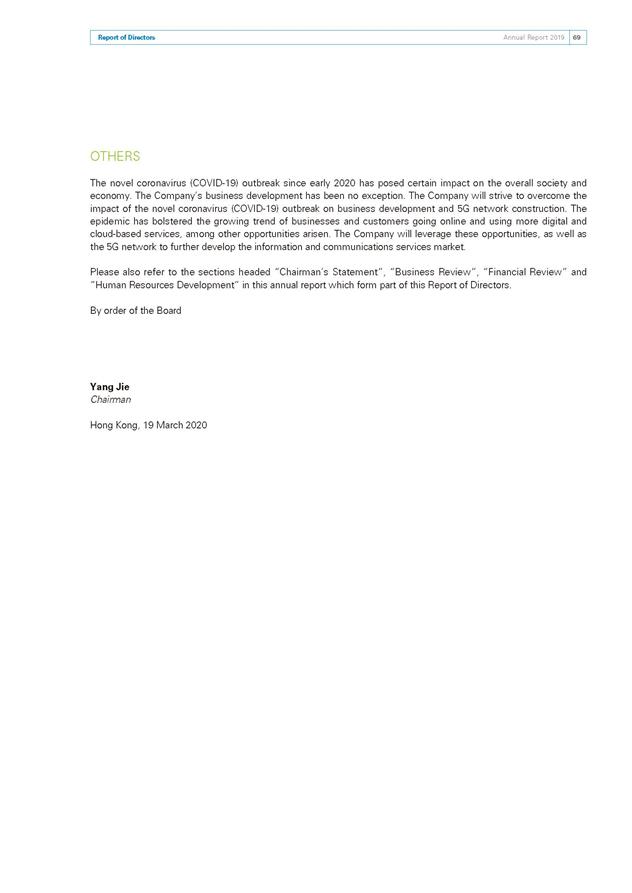
Annual Report 2019 69Report of Directors 69Report of Directors OTHERS The novel coronavirus (COVID-19) outbreak since early 2020 has posed certain impact on the overall society and economy. The Company’s business development has been no exception. The Company will strive to overcome the impact of the novel coronavirus (COVID-19) outbreak on business development and 5G network construction. The epidemic has bolstered the growing trend of businesses and customers going online and using more digital and cloud-based services, among other opportunities arisen. The Company will leverage these opportunities, as well as the 5G network to further develop the information and communications services market. Please also refer to the sections headed “Chairman’s Statement”, “Business Review”, “Financial Review” and “Human Resources Development” in this annual report which form part of this Report of Directors. By order of the Board Yang Jie Chairman Hong Kong, 19 March 2020
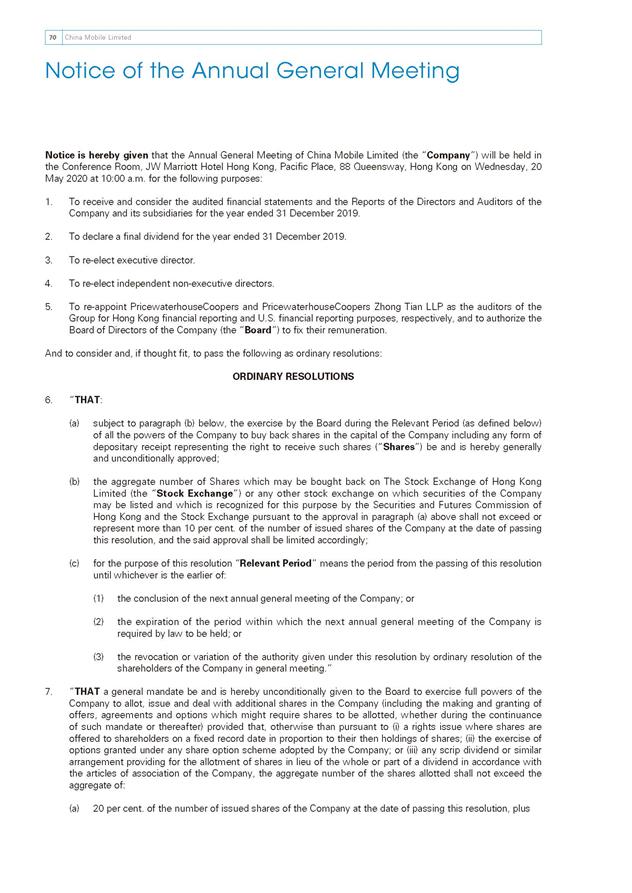
China Mobile Limited70 70 Notice of the Annual General Meeting Notice is hereby given that the Annual General Meeting of China Mobile Limited (the “Company”) will be held in the Conference Room, JW Marriott Hotel Hong Kong, Pacific Place, 88 Queensway, Hong Kong on Wednesday, 20 May 2020 at 10:00 a.m. for the following purposes: 1. To receive and consider the audited financial statements and the Reports of the Directors and Auditors of the Company and its subsidiaries for the year ended 31 December 2019. 2. To declare a final dividend for the year ended 31 December 2019. 3. To re-elect executive director. 4. To re-elect independent non-executive directors. 5. To re-appoint PricewaterhouseCoopers and PricewaterhouseCoopers Zhong Tian LLP as the auditors of the Group for Hong Kong financial reporting and U.S. financial reporting purposes, respectively, and to authorize the Board of Directors of the Company (the “Board”) to fix their remuneration. And to consider and, if thought fit, to pass the following as ordinary resolutions: ORDINARY RESOLUTIONS 6. “THAT: (a) subject to paragraph (b) below, the exercise by the Board during the Relevant Period (as defined below) of all the powers of the Company to buy back shares in the capital of the Company including any form of depositary receipt representing the right to receive such shares (“Shares”) be and is hereby generally and unconditionally approved; (b) the aggregate number of Shares which may be bought back on The Stock Exchange of Hong Kong Limited (the “Stock Exchange”) or any other stock exchange on which securities of the Company may be listed and which is recognized for this purpose by the Securities and Futures Commission of Hong Kong and the Stock Exchange pursuant to the approval in paragraph (a) above shall not exceed or represent more than 10 per cent. of the number of issued shares of the Company at the date of passing this resolution, and the said approval shall be limited accordingly; (c) for the purpose of this resolution “Relevant Period” means the period from the passing of this resolution until whichever is the earlier of: (1) the conclusion of the next annual general meeting of the Company; or (2) the expiration of the period within which the next annual general meeting of the Company is required by law to be held; or (3) the revocation or variation of the authority given under this resolution by ordinary resolution of the shareholders of the Company in general meeting.” 7. “THAT a general mandate be and is hereby unconditionally given to the Board to exercise full powers of the Company to allot, issue and deal with additional shares in the Company (including the making and granting of offers, agreements and options which might require shares to be allotted, whether during the continuance of such mandate or thereafter) provided that, otherwise than pursuant to (i) a rights issue where shares are offered to shareholders on a fixed record date in proportion to their then holdings of shares; (ii) the exercise of options granted under any share option scheme adopted by the Company; or (iii) any scrip dividend or similar arrangement providing for the allotment of shares in lieu of the whole or part of a dividend in accordance with the articles of association of the Company, the aggregate number of the shares allotted shall not exceed the aggregate of: (a) 20 per cent. of the number of issued shares of the Company at the date of passing this resolution, plus
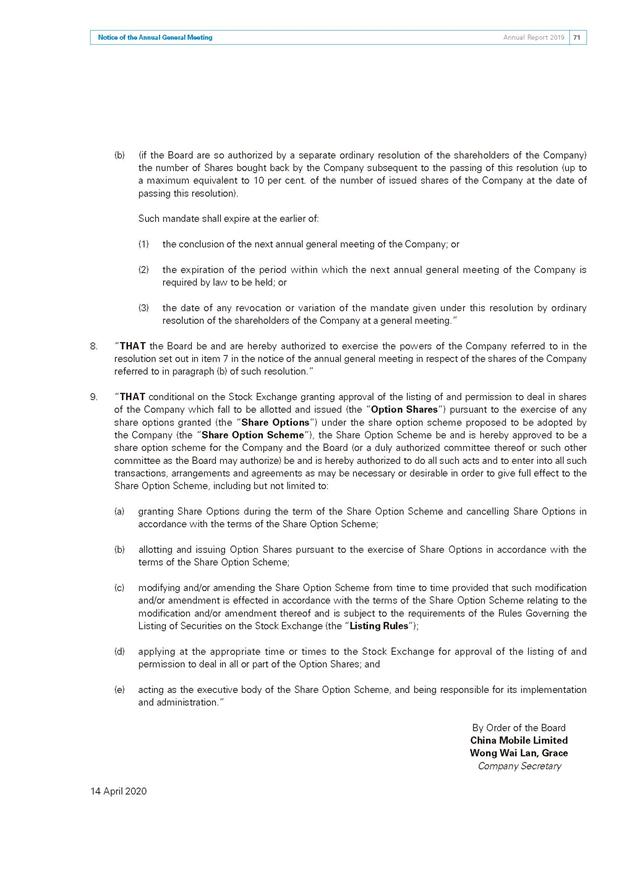
Annual Report 2019 71Notice of the Annual General Meeting 71Notice of the Annual General Meeting (b) (if the Board are so authorized by a separate ordinary resolution of the shareholders of the Company) the number of Shares bought back by the Company subsequent to the passing of this resolution (up to a maximum equivalent to 10 per cent. of the number of issued shares of the Company at the date of passing this resolution). Such mandate shall expire at the earlier of: (1) the conclusion of the next annual general meeting of the Company; or (2) the expiration of the period within which the next annual general meeting of the Company is required by law to be held; or (3) the date of any revocation or variation of the mandate given under this resolution by ordinary resolution of the shareholders of the Company at a general meeting.” 8. “THAT the Board be and are hereby authorized to exercise the powers of the Company referred to in the resolution set out in item 7 in the notice of the annual general meeting in respect of the shares of the Company referred to in paragraph (b) of such resolution.” 9. “THAT conditional on the Stock Exchange granting approval of the listing of and permission to deal in shares of the Company which fall to be allotted and issued (the “Option Shares”) pursuant to the exercise of any share options granted (the “Share Options”) under the share option scheme proposed to be adopted by the Company (the “Share Option Scheme”), the Share Option Scheme be and is hereby approved to be a share option scheme for the Company and the Board (or a duly authorized committee thereof or such other committee as the Board may authorize) be and is hereby authorized to do all such acts and to enter into all such transactions, arrangements and agreements as may be necessary or desirable in order to give full effect to the Share Option Scheme, including but not limited to: (a) granting Share Options during the term of the Share Option Scheme and cancelling Share Options in accordance with the terms of the Share Option Scheme; (b) allotting and issuing Option Shares pursuant to the exercise of Share Options in accordance with the terms of the Share Option Scheme; (c) modifying and/or amending the Share Option Scheme from time to time provided that such modification and/or amendment is effected in accordance with the terms of the Share Option Scheme relating to the modification and/or amendment thereof and is subject to the requirements of the Rules Governing the Listing of Securities on the Stock Exchange (the “Listing Rules”); (d) applying at the appropriate time or times to the Stock Exchange for approval of the listing of and permission to deal in all or part of the Option Shares; and (e) acting as the executive body of the Share Option Scheme, and being responsible for its implementation and administration.” By Order of the Board China Mobile Limited Wong Wai Lan, Grace Company Secretary 14 April 2020
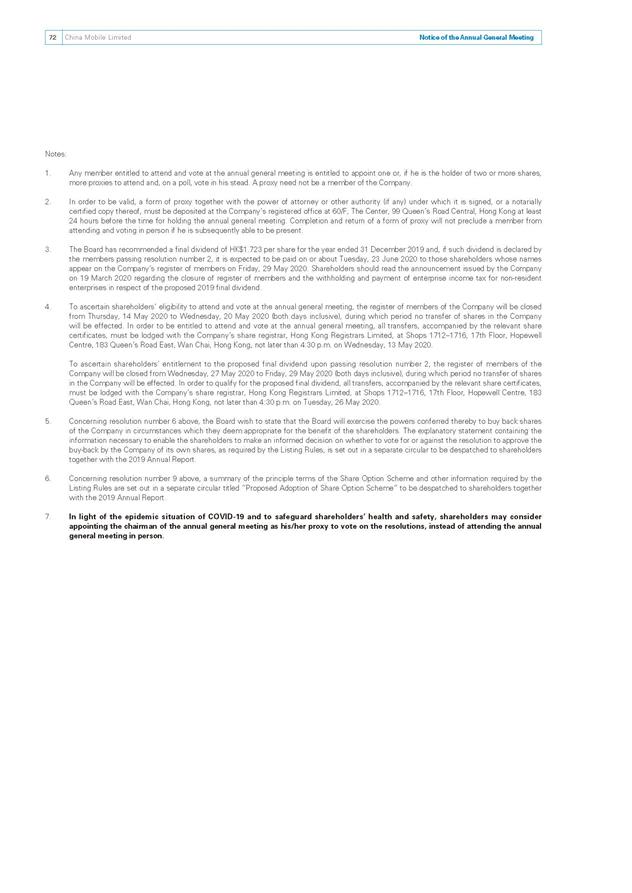
China Mobile Limited72 Notice of the Annual General Meeting 72 Notice of the Annual General Meeting Notes: 1. Any member entitled to attend and vote at the annual general meeting is entitled to appoint one or, if he is the holder of two or more shares, more proxies to attend and, on a poll, vote in his stead. A proxy need not be a member of the Company. 2. In order to be valid, a form of proxy together with the power of attorney or other authority (if any) under which it is signed, or a notarially certified copy thereof, must be deposited at the Company’s registered office at 60/F, The Center, 99 Queen’s Road Central, Hong Kong at least 24 hours before the time for holding the annual general meeting. Completion and return of a form of proxy will not preclude a member from attending and voting in person if he is subsequently able to be present. 3. The Board has recommended a final dividend of HK$1.723 per share for the year ended 31 December 2019 and, if such dividend is declared by the members passing resolution number 2, it is expected to be paid on or about Tuesday, 23 June 2020 to those shareholders whose names appear on the Company’s register of members on Friday, 29 May 2020. Shareholders should read the announcement issued by the Company on 19 March 2020 regarding the closure of register of members and the withholding and payment of enterprise income tax for non-resident enterprises in respect of the proposed 2019 final dividend. 4. To ascertain shareholders’ eligibility to attend and vote at the annual general meeting, the register of members of the Company will be closed from Thursday, 14 May 2020 to Wednesday, 20 May 2020 (both days inclusive), during which period no transfer of shares in the Company will be effected. In order to be entitled to attend and vote at the annual general meeting, all transfers, accompanied by the relevant share certificates, must be lodged with the Company’s share registrar, Hong Kong Registrars Limited, at Shops 1712–1716, 17th Floor, Hopewell Centre, 183 Queen’s Road East, Wan Chai, Hong Kong, not later than 4:30 p.m. on Wednesday, 13 May 2020. To ascertain shareholders’ entitlement to the proposed final dividend upon passing resolution number 2, the register of members of the Company will be closed from Wednesday, 27 May 2020 to Friday, 29 May 2020 (both days inclusive), during which period no transfer of shares in the Company will be effected. In order to qualify for the proposed final dividend, all transfers, accompanied by the relevant share certificates, must be lodged with the Company’s share registrar, Hong Kong Registrars Limited, at Shops 1712–1716, 17th Floor, Hopewell Centre, 183 Queen’s Road East, Wan Chai, Hong Kong, not later than 4:30 p.m. on Tuesday, 26 May 2020. 5. Concerning resolution number 6 above, the Board wish to state that the Board will exercise the powers conferred thereby to buy back shares of the Company in circumstances which they deem appropriate for the benefit of the shareholders. The explanatory statement containing the information necessary to enable the shareholders to make an informed decision on whether to vote for or against the resolution to approve the buy-back by the Company of its own shares, as required by the Listing Rules, is set out in a separate circular to be despatched to shareholders together with the 2019 Annual Report. 6. Concerning resolution number 9 above, a summary of the principle terms of the Share Option Scheme and other information required by the Listing Rules are set out in a separate circular titled “Proposed Adoption of Share Option Scheme” to be despatched to shareholders together with the 2019 Annual Report. 7. In light of the epidemic situation of COVID-19 and to safeguard shareholders’ health and safety, shareholders may consider appointing the chairman of the annual general meeting as his/her proxy to vote on the resolutions, instead of attending the annual general meeting in person.
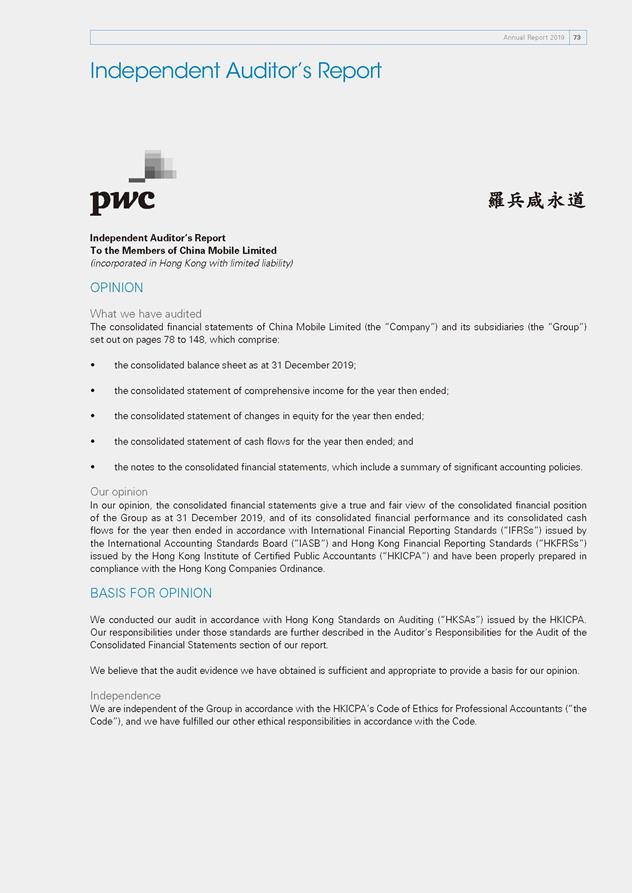
Annual Report 2019 73 73 Independent Auditor’s Report PWC Independent Auditor’s Report To the Members of China Mobile Limited (incorporated in Hong Kong with limited liability) OPINION What we have audited The consolidated financial statements of China Mobile Limited (the “Company”) and its subsidiaries (the “Group”) set out on pages 78 to 148, which comprise: • the consolidated balance sheet as at 31 December 2019; • the consolidated statement of comprehensive income for the year then ended; • the consolidated statement of changes in equity for the year then ended; • the consolidated statement of cash flows for the year then ended; and • the notes to the consolidated financial statements, which include a summary of significant accounting policies. Our opinion In our opinion, the consolidated financial statements give a true and fair view of the consolidated financial position of the Group as at 31 December 2019, and of its consolidated financial performance and its consolidated cash flows for the year then ended in accordance with International Financial Reporting Standards (“IFRSs”) issued by the International Accounting Standards Board (“IASB”) and Hong Kong Financial Reporting Standards (“HKFRSs”) issued by the Hong Kong Institute of Certified Public Accountants (“HKICPA”) and have been properly prepared in compliance with the Hong Kong Companies Ordinance. BASIS FOR OPINION We conducted our audit in accordance with Hong Kong Standards on Auditing (“HKSAs”) issued by the HKICPA. Our responsibilities under those standards are further described in the Auditor’s Responsibilities for the Audit of the Consolidated Financial Statements section of our report. We believe that the audit evidence we have obtained is sufficient and appropriate to provide a basis for our opinion. Independence We are independent of the Group in accordance with the HKICPA’s Code of Ethics for Professional Accountants (“the Code”), and we have fulfilled our other ethical responsibilities in accordance with the Code.
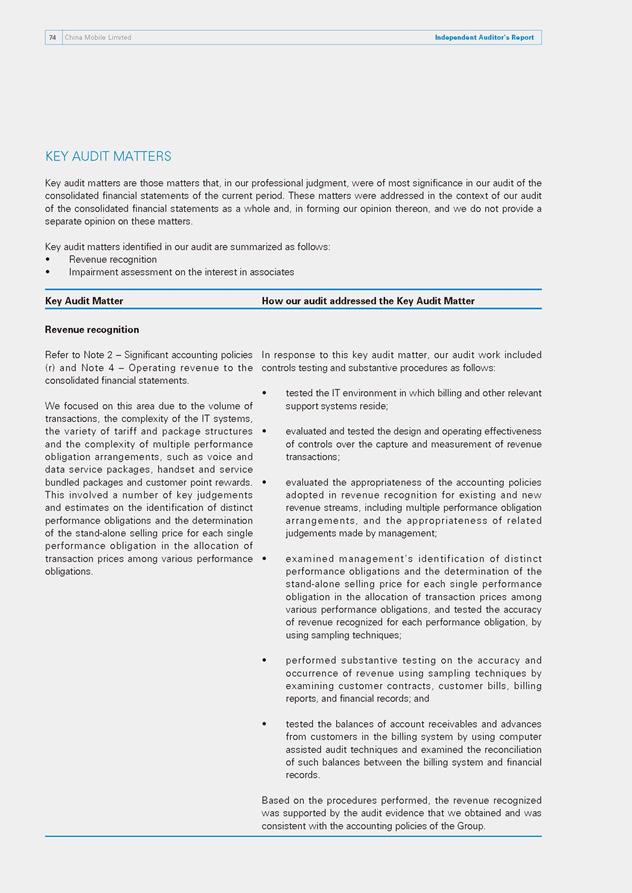
China Mobile Limited74 Independent Auditor’s Report 74 Independent Auditor’s Report KEY AUDIT MATTERS Key audit matters are those matters that, in our professional judgment, were of most significance in our audit of the consolidated financial statements of the current period. These matters were addressed in the context of our audit of the consolidated financial statements as a whole and, in forming our opinion thereon, and we do not provide a separate opinion on these matters. Key audit matters identified in our audit are summarized as follows: • Revenue recognition • Impairment assessment on the interest in associates Key Audit Matter How our audit addressed the Key Audit Matter Revenue recognition Refer to Note 2 – Significant accounting policies (r) and Note 4 – Operating revenue to the consolidated financial statements. We focused on this area due to the volume of transactions, the complexity of the IT systems, the variety of tariff and package structures and the complexity of multiple performance obligation arrangements, such as voice and data service packages, handset and service bundled packages and customer point rewards. This involved a number of key judgements and estimates on the identification of distinct performance obligations and the determination of the stand-alone selling price for each single performance obligation in the allocation of transaction prices among various performance obligations. In response to this key audit matter, our audit work included controls testing and substantive procedures as follows: • tested the IT environment in which billing and other relevant support systems reside; • evaluated and tested the design and operating effectiveness of controls over the capture and measurement of revenue transactions; • evaluated the appropriateness of the accounting policies adopted in revenue recognition for existing and new revenue streams, including multiple performance obligation arrangements, and the appropriateness of related judgements made by management; • examined management’s identification of distinct performance obligations and the determination of the stand-alone selling price for each single performance obligation in the allocation of transaction prices among various performance obligations, and tested the accuracy of revenue recognized for each performance obligation, by using sampling techniques; • performed substantive testing on the accuracy and occurrence of revenue using sampling techniques by examining customer contracts, customer bills, billing reports, and financial records; and • tested the balances of account receivables and advances from customers in the billing system by using computer assisted audit techniques and examined the reconciliation of such balances between the billing system and financial records. Based on the procedures performed, the revenue recognized was supported by the audit evidence that we obtained and was consistent with the accounting policies of the Group.
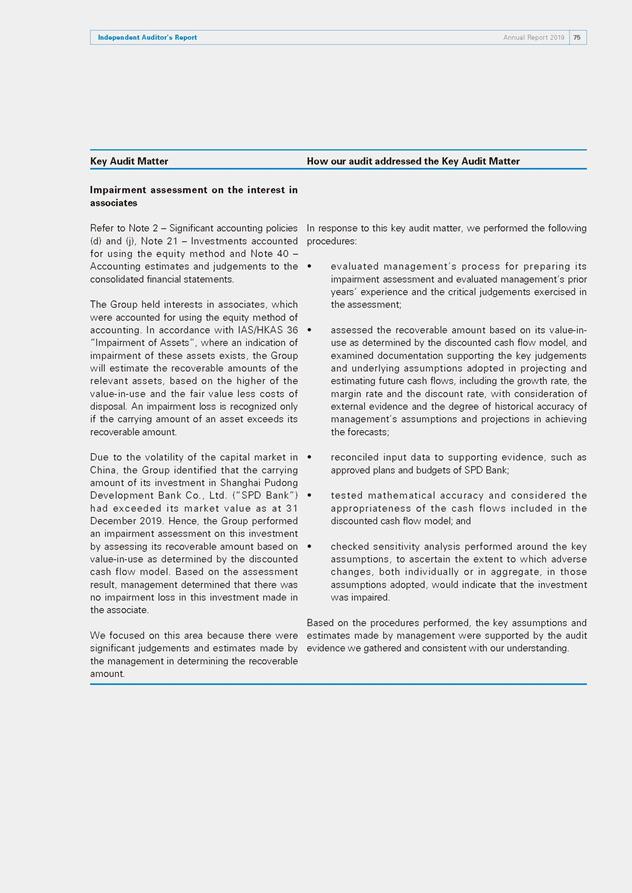
Annual Report 2019 75Independent Auditor’s Report 75Independent Auditor’s Report Key Audit Matter How our audit addressed the Key Audit Matter Impairment assessment on the interest in associates Refer to Note 2 – Significant accounting policies (d) and (j), Note 21 – Investments accounted for using the equity method and Note 40 – Accounting estimates and judgements to the consolidated financial statements. The Group held interests in associates, which were accounted for using the equity method of accounting. In accordance with IAS/HKAS 36 “Impairment of Assets”, where an indication of impairment of these assets exists, the Group will estimate the recoverable amounts of the relevant assets, based on the higher of the value-in-use and the fair value less costs of disposal. An impairment loss is recognized only if the carrying amount of an asset exceeds its recoverable amount. Due to the volatility of the capital market in China, the Group identified that the carrying amount of its investment in Shanghai Pudong Development Bank Co., Ltd. (“SPD Bank”) had exceeded its market value as at 31 December 2019. Hence, the Group performed an impairment assessment on this investment by assessing its recoverable amount based on value-in-use as determined by the discounted cash flow model. Based on the assessment result, management determined that there was no impairment loss in this investment made in the associate. We focused on this area because there were significant judgements and estimates made by the management in determining the recoverable amount. In response to this key audit matter, we performed the following procedures: • evaluated management’s process for preparing its impairment assessment and evaluated management’s prior years’ experience and the critical judgements exercised in the assessment; • assessed the recoverable amount based on its value-inuse as determined by the discounted cash flow model, and examined documentation supporting the key judgements and underlying assumptions adopted in projecting and estimating future cash flows, including the growth rate, the margin rate and the discount rate, with consideration of external evidence and the degree of historical accuracy of management’s assumptions and projections in achieving the forecasts; • reconciled input data to supporting evidence, such as approved plans and budgets of SPD Bank; • tested mathematical accuracy and considered the appropriateness of the cash flows included in the discounted cash flow model; and • checked sensitivity analysis performed around the key assumptions, to ascertain the extent to which adverse changes, both individually or in aggregate, in those assumptions adopted, would indicate that the investment was impaired. Based on the procedures performed, the key assumptions and estimates made by management were supported by the audit evidence we gathered and consistent with our understanding.
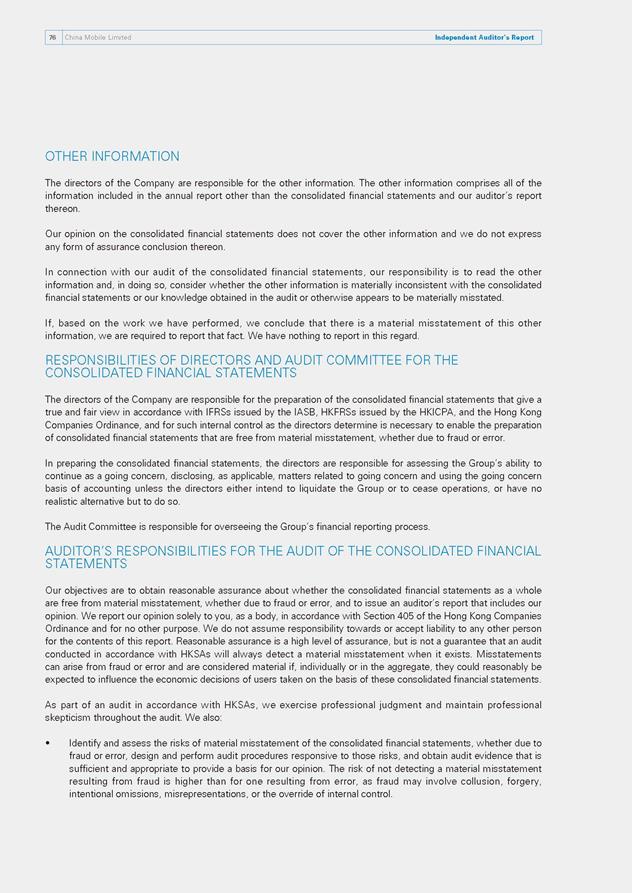
China Mobile Limited76 Independent Auditor’s Report 76 Independent Auditor’s Report OTHER INFORMATION The directors of the Company are responsible for the other information. The other information comprises all of the information included in the annual report other than the consolidated financial statements and our auditor’s report thereon. Our opinion on the consolidated financial statements does not cover the other information and we do not express any form of assurance conclusion thereon. In connection with our audit of the consolidated financial statements, our responsibility is to read the other information and, in doing so, consider whether the other information is materially inconsistent with the consolidated financial statements or our knowledge obtained in the audit or otherwise appears to be materially misstated. If, based on the work we have performed, we conclude that there is a material misstatement of this other information, we are required to report that fact. We have nothing to report in this regard. RESPONSIBILITIES OF DIRECTORS AND AUDIT COMMITTEE FOR THE CONSOLIDATED FINANCIAL STATEMENTS The directors of the Company are responsible for the preparation of the consolidated financial statements that give a true and fair view in accordance with IFRSs issued by the IASB, HKFRSs issued by the HKICPA, and the Hong Kong Companies Ordinance, and for such internal control as the directors determine is necessary to enable the preparation of consolidated financial statements that are free from material misstatement, whether due to fraud or error. In preparing the consolidated financial statements, the directors are responsible for assessing the Group’s ability to continue as a going concern, disclosing, as applicable, matters related to going concern and using the going concern basis of accounting unless the directors either intend to liquidate the Group or to cease operations, or have no realistic alternative but to do so. The Audit Committee is responsible for overseeing the Group’s financial reporting process. AUDITOR’S RESPONSIBILITIES FOR THE AUDIT OF THE CONSOLIDATED FINANCIAL STATEMENTS Our objectives are to obtain reasonable assurance about whether the consolidated financial statements as a whole are free from material misstatement, whether due to fraud or error, and to issue an auditor’s report that includes our opinion. We report our opinion solely to you, as a body, in accordance with Section 405 of the Hong Kong Companies Ordinance and for no other purpose. We do not assume responsibility towards or accept liability to any other person for the contents of this report. Reasonable assurance is a high level of assurance, but is not a guarantee that an audit conducted in accordance with HKSAs will always detect a material misstatement when it exists. Misstatements can arise from fraud or error and are considered material if, individually or in the aggregate, they could reasonably be expected to influence the economic decisions of users taken on the basis of these consolidated financial statements. As part of an audit in accordance with HKSAs, we exercise professional judgment and maintain professional skepticism throughout the audit. We also: • Identify and assess the risks of material misstatement of the consolidated financial statements, whether due to fraud or error, design and perform audit procedures responsive to those risks, and obtain audit evidence that is sufficient and appropriate to provide a basis for our opinion. The risk of not detecting a material misstatement resulting from fraud is higher than for one resulting from error, as fraud may involve collusion, forgery, intentional omissions, misrepresentations, or the override of internal control.
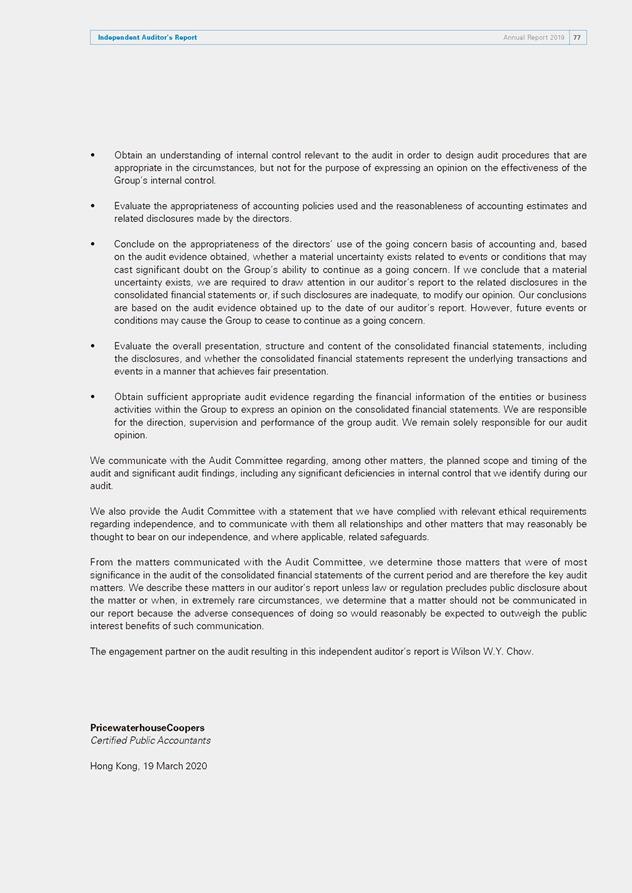
Annual Report 2019 77Independent Auditor’s Report 77Independent Auditor’s Report • Obtain an understanding of internal control relevant to the audit in order to design audit procedures that are appropriate in the circumstances, but not for the purpose of expressing an opinion on the effectiveness of the Group’s internal control. • Evaluate the appropriateness of accounting policies used and the reasonableness of accounting estimates and related disclosures made by the directors. • Conclude on the appropriateness of the directors’ use of the going concern basis of accounting and, based on the audit evidence obtained, whether a material uncertainty exists related to events or conditions that may cast significant doubt on the Group’s ability to continue as a going concern. If we conclude that a material uncertainty exists, we are required to draw attention in our auditor’s report to the related disclosures in the consolidated financial statements or, if such disclosures are inadequate, to modify our opinion. Our conclusions are based on the audit evidence obtained up to the date of our auditor’s report. However, future events or conditions may cause the Group to cease to continue as a going concern. • Evaluate the overall presentation, structure and content of the consolidated financial statements, including the disclosures, and whether the consolidated financial statements represent the underlying transactions and events in a manner that achieves fair presentation. • Obtain sufficient appropriate audit evidence regarding the financial information of the entities or business activities within the Group to express an opinion on the consolidated financial statements. We are responsible for the direction, supervision and performance of the group audit. We remain solely responsible for our audit opinion. We communicate with the Audit Committee regarding, among other matters, the planned scope and timing of the audit and significant audit findings, including any significant deficiencies in internal control that we identify during our audit. We also provide the Audit Committee with a statement that we have complied with relevant ethical requirements regarding independence, and to communicate with them all relationships and other matters that may reasonably be thought to bear on our independence, and where applicable, related safeguards. From the matters communicated with the Audit Committee, we determine those matters that were of most significance in the audit of the consolidated financial statements of the current period and are therefore the key audit matters. We describe these matters in our auditor’s report unless law or regulation precludes public disclosure about the matter or when, in extremely rare circumstances, we determine that a matter should not be communicated in our report because the adverse consequences of doing so would reasonably be expected to outweigh the public interest benefits of such communication. The engagement partner on the audit resulting in this independent auditor’s report is Wilson W.Y. Chow. PricewaterhouseCoopers Certified Public Accountants Hong Kong, 19 March 2020
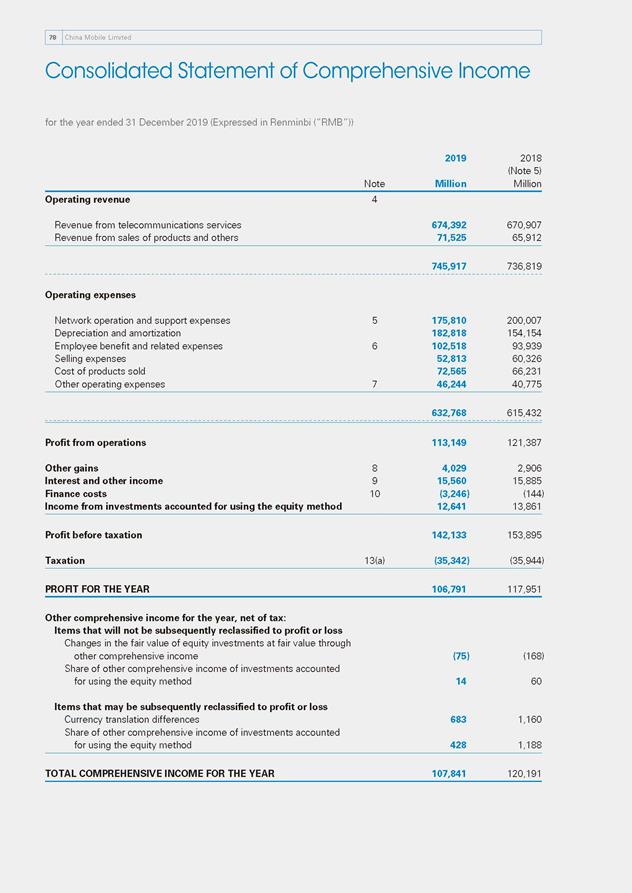
China Mobile Limited78 78 Consolidated Statement of Comprehensive Income for the year ended 31 December 2019 (Expressed in Renminbi (“RMB”)) Note 2019 Million 2018 (Note 5) Million Operating revenue Revenue from telecommunications services Revenue from sales of products and others 4 674,392 71,525 670,907 65,912 745,917 736,819 Operating expenses Network operation and support expenses Depreciation and amortization Employee benefit and related expenses Selling expenses Cost of products sold Other operating expenses 5 6 7 175,810 182,818 102,518 52,813 72,565 46,244 200,007 154,154 93,939 60,326 66,231 40,775 632,768 615,432 Profit from operations Other gains Interest and other income Finance costs Income from investments accounted for using the equity method 8 9 10 113,149 4,029 15,560 (3,246) 12,641 121,387 2,906 15,885 (144) 13,861 Profit before taxation Taxation 13(a) 142,133 (35,342) 153,895 (35,944) PROFIT FOR THE YEAR 106,791 117,951 Other comprehensive income for the year, net of tax: Items that will not be subsequently reclassified to profit or loss Changes in the fair value of equity investments at fair value through other comprehensive income Share of other comprehensive income of investments accounted for using the equity method Items that may be subsequently reclassified to profit or loss Currency translation differences Share of other comprehensive income of investments accounted for using the equity method (75) 14 683 428 (168) 60 1,160 1,188 TOTAL COMPREHENSIVE INCOME FOR THE YEAR 107,841 120,191
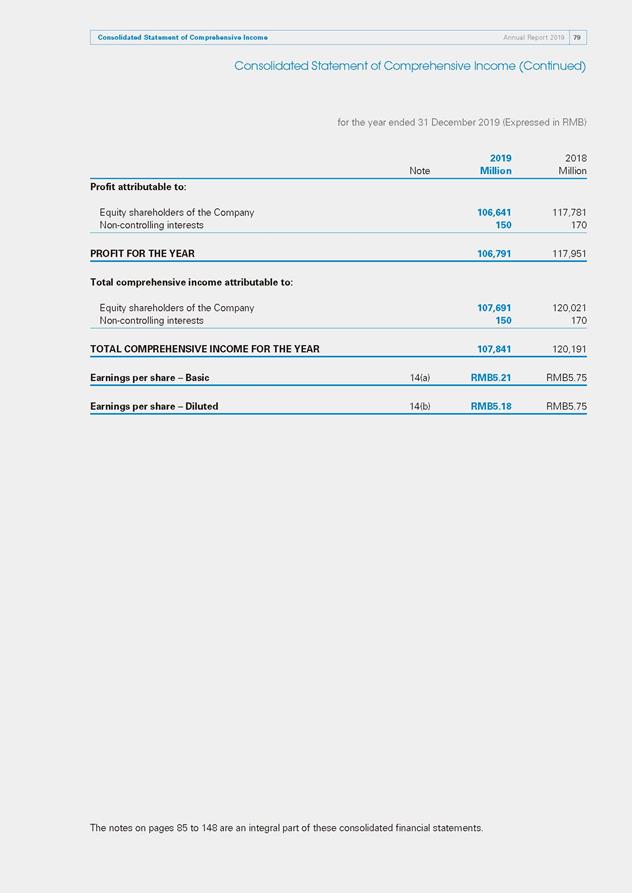
Annual Report 2019 79Consolidated Statement of Comprehensive Income 79Consolidated Statement of Comprehensive Income Consolidated Statement of Comprehensive Income (Continued) for the year ended 31 December 2019 (Expressed in RMB) 2019 2018 Note Million Million Profit attributable to: Equity shareholders of the Company Non-controlling interests 106,641 150 117,781 170 PROFIT FOR THE YEAR 106,791 117,951 Total comprehensive income attributable to: Equity shareholders of the Company Non-controlling interests 107,691 150 120,021 170 TOTAL COMPREHENSIVE INCOME FOR THE YEAR 107,841 120,191 Earnings per share – Basic 14(a) RMB5.21 RMB5.75 Earnings per share – Diluted 14(b) RMB5.18 RMB5.75 The notes on pages 85 to 148 are an integral part of these consolidated financial statements.

80 China Mobile Limited Consolidated Balance Sheet as at 31 December 2019 (Expressed in RMB) As at As at 31 December 31 December 2019 2018 Note Million Million Assets Non-current assets Property, plant and equipment 15 674,832 666,496 Right-of-use assets 16(a) 74,308 – Construction in progress 17 67,978 72,180 Land use rights and others 18 27,455 27,778 Goodwill 19 35,343 35,343 Other intangible assets 3,475 2,620 Investments accounted for using the equity method 21 155,228 145,325 Deferred tax assets 22 32,628 29,654 Financial assets at fair value through other comprehensive income 23 513 587 Restricted bank deposits 24 10,063 12,369 Other non-current assets 4(a) 17,551 8,442 1,099,374 1,000,794 Current assets Inventories 25 7,338 8,857 Contract assets 4(a) 5,003 5,022 Accounts receivable 26 32,694 26,540 Other receivables 27 34,133 39,543 Prepayments and other current assets 27 26,708 27,002 Amount due from ultimate holding company 28 1,350 570 Prepaid income tax 1,278 1,959 Financial assets at fair value through profit or loss 23 114,259 76,425 Restricted bank deposits 24 371 9 Bank deposits 29 130,799 291,887 Cash and cash equivalents 30 175,933 57,302 529,866 535,116 Total assets 1,629,240 1,535,910 Equity and liabilities Liabilities Current liabilities Accounts payable 31 164,818 190,847 Bills payable 2,896 3,221 Deferred revenue 32 57,825 63,185 Accrued expenses and other payables 33 182,368 195,572 Amount due to ultimate holding company 28 21,677 11,020 Income tax payable 9,815 10,553 Lease liabilities 3 22,668 – 462,067 474,398
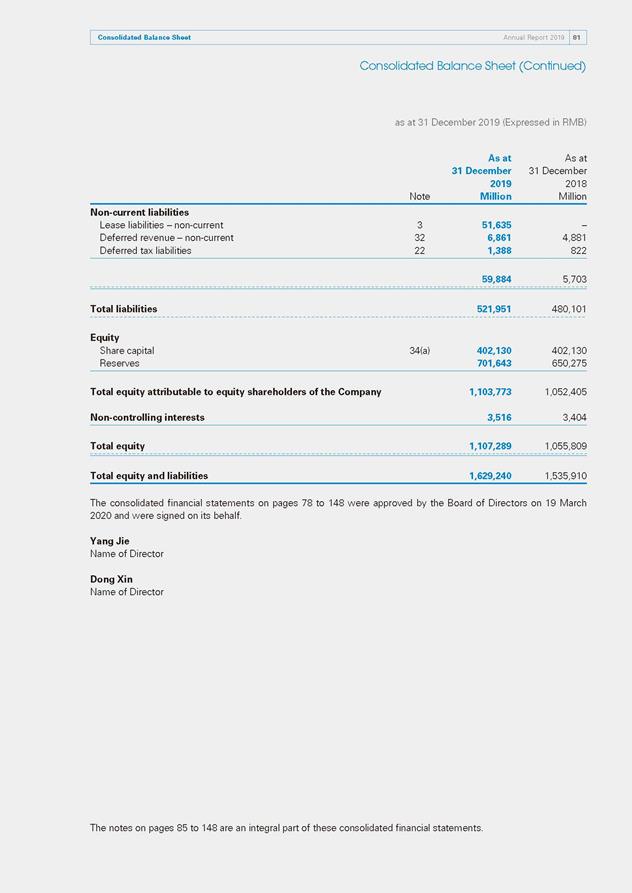
Consolidated Balance Sheet Annual Report 2019 81 Consolidated Balance Sheet (Continued) as at 31 December 2019 (Expressed in RMB) Non-current liabilities Lease liabilities – non-current Deferred revenue – non-current Deferred tax liabilities Note 3 32 22 As at 31 December 2019 Million 51,635 6,861 1,388 As at 31 December 2018 Million – 4,881 822 59,884 5,703 Total liabilities 521,951 480,101 Equity Share capital Reserves 34(a) 402,130 701,643 402,130 650,275 Total equity attributable to equity shareholders of the Company 1,103,773 1,052,405 Non-controlling interests 3,516 3,404 Total equity 1,107,289 1,055,809 Total equity and liabilities 1,629,240 1,535,910 The consolidated financial statements on pages 78 to 148 were approved by the Board of Directors on 19 March 2020 and were signed on its behalf. Yang Jie Name of Director Dong Xin Name of Director The notes on pages 85 to 148 are an integral part of these consolidated financial statements.
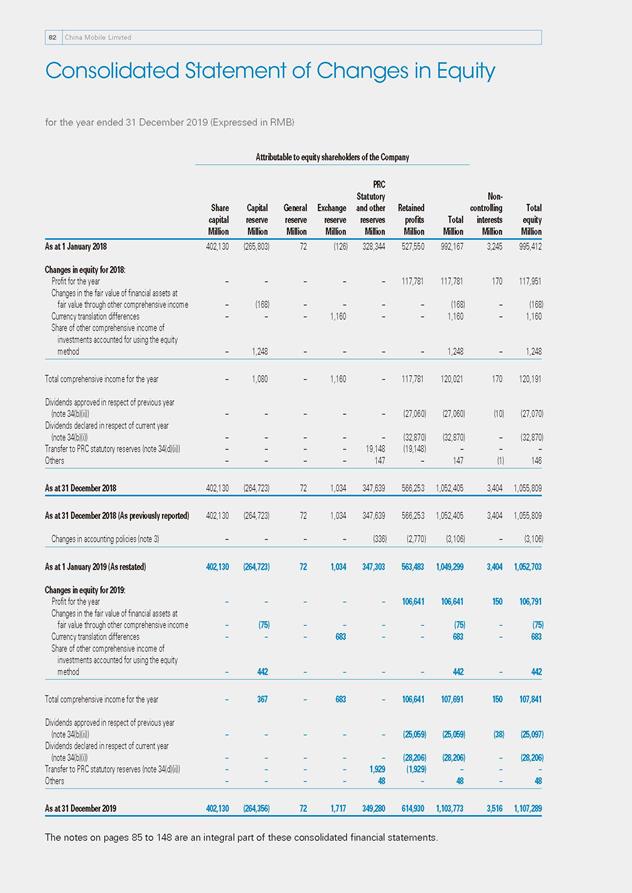
82 China Mobile Limited Consolidated Statement of Changes in Equity for the year ended 31 December 2019 (Expressed in RMB) Attributable to equity shareholders of the Company PRC Statutory Non- Share Capital General Exchange and other Retained controlling Total capital reserve reserve reserve reserves profits Total interests equity Million Million Million Million Million Million Million Million Million As at 1 January 2018 402,130 (265,803) 72 (126) 328,344 527,550 992,167 3,245 995,412 Changes in equity for 2018: Profit for the year – – – – – 117,781 117,781 170 117,951 Changes in the fair value of financial assets at fair value through other comprehensive income – (168) – – – – (168) – (168) Currency translation differences – – – 1,160 – – 1,160 – 1,160 Share of other comprehensive income of investments accounted for using the equity method – 1,248 – – – – 1,248 – 1,248 Total comprehensive income for the year – 1,080 – 1,160 – 117,781 120,021 170 120,191 Dividends approved in respect of previous year (note 34(b)(ii)) – – – – – (27,060) (27,060) (10) (27,070) Dividends declared in respect of current year (note 34(b)(i)) – – – – – (32,870) (32,870) – (32,870) Transfer to PRC statutory reserves (note 34(d)(ii)) – – – – 19,148 (19,148) – – – Others – – – – 147 – 147 (1) 146 As at 31 December 2018 402,130 (264,723) 72 1,034 347,639 566,253 1,052,405 3,404 1,055,809 As at 31 December 2018 (As previously reported) 402,130 (264,723) 72 1,034 347,639 566,253 1,052,405 3,404 1,055,809 Changes in accounting policies (note 3) – – – – (336) (2,770) (3,106) – (3,106) As at 1 January 2019 (As restated) 402,130 (264,723) 72 1,034 347,303 563,483 1,049,299 3,404 1,052,703 Changes in equity for 2019: Profit for the year – – – – – 106,641 106,641 150 106,791 Changes in the fair value of financial assets at fair value through other comprehensive income – (75) – – – – (75) – (75) Currency translation differences – – – 683 – – 683 – 683 Share of other comprehensive income of investments accounted for using the equity method – 442 – – – – 442 – 442 Total comprehensive income for the year – 367 – 683 – 106,641 107,691 150 107,841 Dividends approved in respect of previous year (note 34(b)(ii)) – – – – – (25,059) (25,059) (38) (25,097) Dividends declared in respect of current year (note 34(b)(i)) – – – – – (28,206) (28,206) – (28,206) Transfer to PRC statutory reserves (note 34(d)(ii)) – – – – 1,929 (1,929) – – – Others – – – – 48 – 48 – 48 As at 31 December 2019 402,130 (264,356) 72 1,717 349,280 614,930 1,103,773 3,516 1,107,289 The notes on pages 85 to 148 are an integral part of these consolidated financial statements.
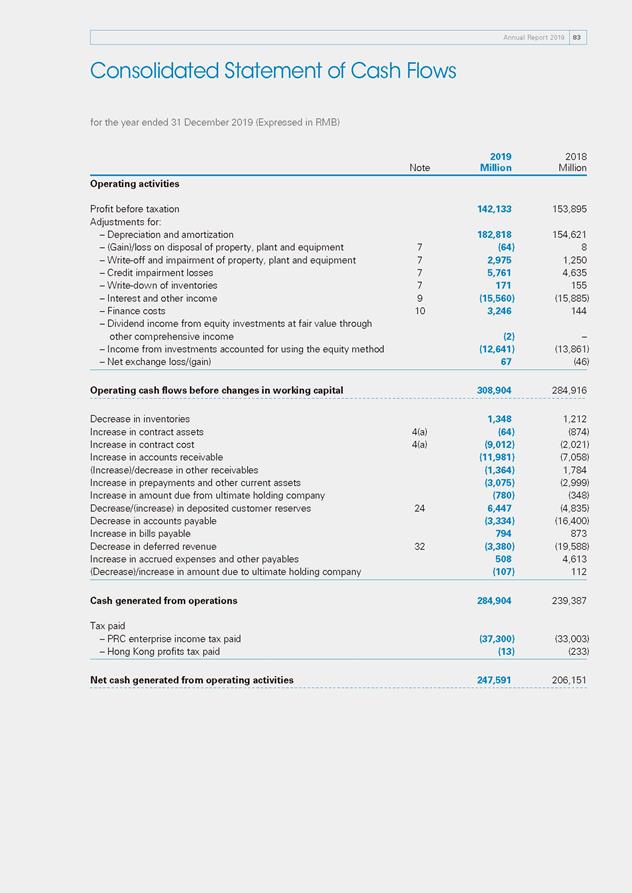
Annual Report 2019 83 Consolidated Statement of Cash Flows for the year ended 31 December 2019 (Expressed in RMB) 2019 2018 Note Million Million Operating activities Profit before taxation 142,133 153,895 Adjustments for: – Depreciation and amortization 182,818 154,621 – (Gain)/loss on disposal of property, plant and equipment 7 (64) 8 – Write-off and impairment of property, plant and equipment 7 2,975 1,250 – Credit impairment losses 7 5,761 4,635 – Write-down of inventories 7 171 155 – Interest and other income 9 (15,560) (15,885) – Finance costs 10 3,246 144 – Dividend income from equity investments at fair value through other comprehensive income (2) – – Income from investments accounted for using the equity method (12,641) (13,861) – Net exchange loss/(gain) 67 (46) Operating cash flows before changes in working capital 308,904 284,916 Decrease in inventories 1,348 1,212 Increase in contract assets 4(a) (64) (874) Increase in contract cost 4(a) (9,012) (2,021) Increase in accounts receivable (11,981) (7,058) (Increase)/decrease in other receivables (1,364) 1,784 Increase in prepayments and other current assets (3,075) (2,999) Increase in amount due from ultimate holding company (780) (348) Decrease/(increase) in deposited customer reserves 24 6,447 (4,835) Decrease in accounts payable (3,334) (16,400) Increase in bills payable 794 873 Decrease in deferred revenue 32 (3,380) (19,588) Increase in accrued expenses and other payables 508 4,613 (Decrease)/increase in amount due to ultimate holding company (107) 112 Cash generated from operations 284,904 239,387 Tax paid – PRC enterprise income tax paid (37,300) (33,003) – Hong Kong profits tax paid (13) (233) Net cash generated from operating activities 247,591 206,151
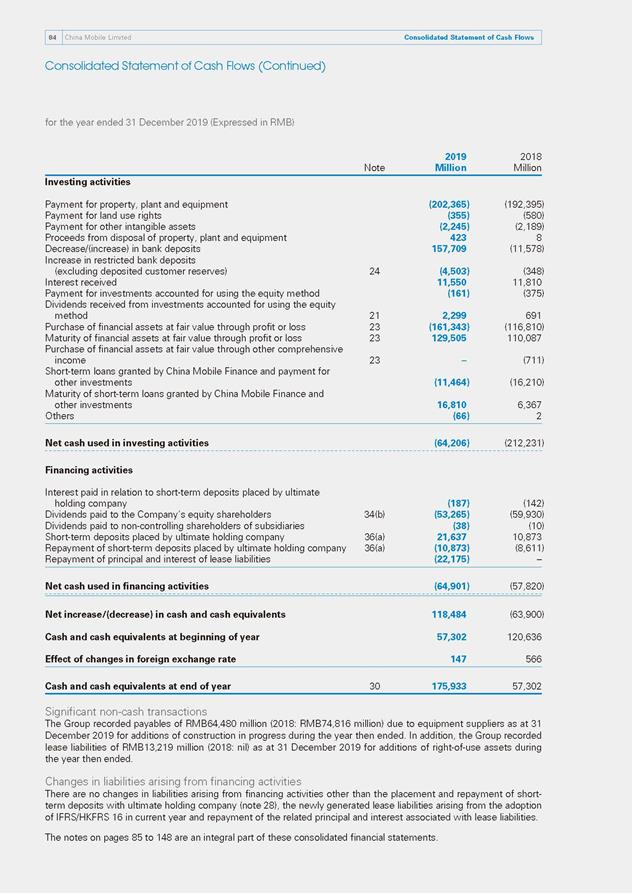
84 China Mobile Limited Consolidated Statement of Cash Flows Consolidated Statement of Cash Flows (Continued) for the year ended 31 December 2019 (Expressed in RMB) 2019 2018 Note Million Million Investing activities Payment for property, plant and equipment Payment for land use rights Payment for other intangible assets Proceeds from disposal of property, plant and equipment Decrease/(increase) in bank deposits Increase in restricted bank deposits (excluding deposited customer reserves) Interest received Payment for investments accounted for using the equity method Dividends received from investments accounted for using the equity method Purchase of financial assets at fair value through profit or loss Maturity of financial assets at fair value through profit or loss Purchase of financial assets at fair value through other comprehensive income Short-term loans granted by China Mobile Finance and payment for other investments Maturity of short-term loans granted by China Mobile Finance and other investments Others 24 21 23 23 23 (202,365) (355) (2,245) 423 157,709 (4,503) 11,550 (161) 2,299 (161,343) 129,505 – (11,464) 16,810 (66) (192,395) (580) (2,189) 8 (11,578) (348) 11,810 (375) 691 (116,810) 110,087 (711) (16,210) 6,367 2 Net cash used in investing activities (64,206) (212,231) Financing activities Interest paid in relation to short-term deposits placed by ultimate holding company Dividends paid to the Company’s equity shareholders Dividends paid to non-controlling shareholders of subsidiaries Short-term deposits placed by ultimate holding company Repayment of short-term deposits placed by ultimate holding company Repayment of principal and interest of lease liabilities 34(b) 36(a) 36(a) (187) (53,265) (38) 21,637 (10,873) (22,175) (142) (59,930) (10) 10,873 (8,611) – Net cash used in financing activities (64,901) (57,820) Net increase/(decrease) in cash and cash equivalents 118,484 (63,900) Cash and cash equivalents at beginning of year 57,302 120,636 Effect of changes in foreign exchange rate 147 566 Cash and cash equivalents at end of year 30 175,933 57,302 Significant non-cash transactions The Group recorded payables of RMB64,480 million (2018: RMB74,816 million) due to equipment suppliers as at 31 December 2019 for additions of construction in progress during the year then ended. In addition, the Group recorded lease liabilities of RMB13,219 million (2018: nil) as at 31 December 2019 for additions of right-of-use assets during the year then ended. Changes in liabilities arising from financing activities There are no changes in liabilities arising from financing activities other than the placement and repayment of short- term deposits with ultimate holding company (note 28), the newly generated lease liabilities arising from the adoption of IFRS/HKFRS 16 in current year and repayment of the related principal and interest associated with lease liabilities. The notes on pages 85 to 148 are an integral part of these consolidated financial statements.
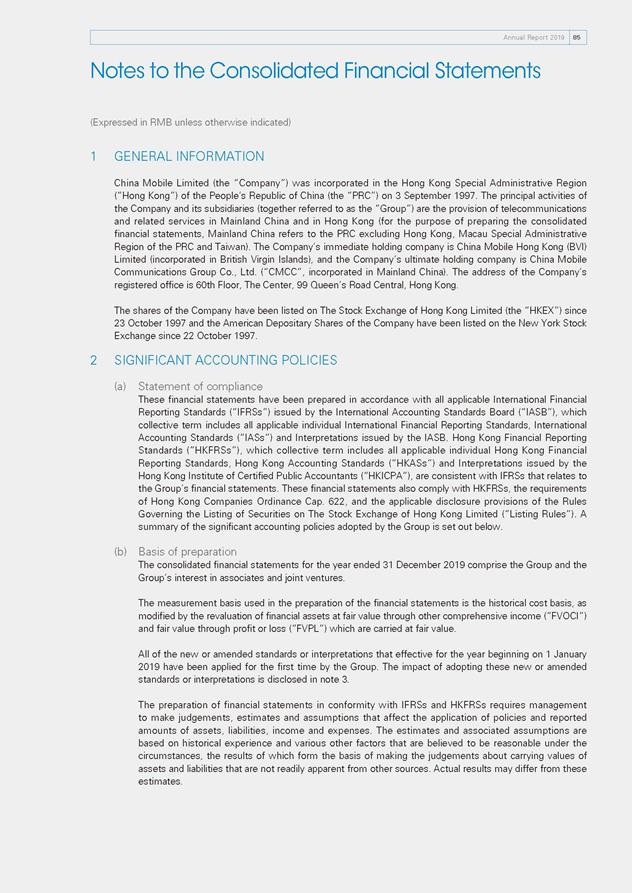
Annual Report 2019 85 85 Notes to the Consolidated Financial Statements (Expressed in RMB unless otherwise indicated) 1 GENERAL INFORMATION China Mobile Limited (the “Company”) was incorporated in the Hong Kong Special Administrative Region (“Hong Kong”) of the People’s Republic of China (the “PRC”) on 3 September 1997. The principal activities of the Company and its subsidiaries (together referred to as the “Group”) are the provision of telecommunications and related services in Mainland China and in Hong Kong (for the purpose of preparing the consolidated financial statements, Mainland China refers to the PRC excluding Hong Kong, Macau Special Administrative Region of the PRC and Taiwan). The Company’s immediate holding company is China Mobile Hong Kong (BVI) Limited (incorporated in British Virgin Islands), and the Company’s ultimate holding company is China Mobile Communications Group Co., Ltd. (“CMCC”, incorporated in Mainland China). The address of the Company’s registered office is 60th Floor, The Center, 99 Queen’s Road Central, Hong Kong. The shares of the Company have been listed on The Stock Exchange of Hong Kong Limited (the “HKEX”) since 23 October 1997 and the American Depositary Shares of the Company have been listed on the New York Stock Exchange since 22 October 1997. 2 SIGNIFICANT ACCOUNTING POLICIES (a) Statement of compliance These financial statements have been prepared in accordance with all applicable International Financial Reporting Standards (“IFRSs”) issued by the International Accounting Standards Board (“IASB”), which collective term includes all applicable individual International Financial Reporting Standards, International Accounting Standards (“IASs”) and Interpretations issued by the IASB. Hong Kong Financial Reporting Standards (“HKFRSs”), which collective term includes all applicable individual Hong Kong Financial Reporting Standards, Hong Kong Accounting Standards (“HKASs”) and Interpretations issued by the Hong Kong Institute of Certified Public Accountants (“HKICPA”), are consistent with IFRSs that relates to the Group’s financial statements. These financial statements also comply with HKFRSs, the requirements of Hong Kong Companies Ordinance Cap. 622, and the applicable disclosure provisions of the Rules Governing the Listing of Securities on The Stock Exchange of Hong Kong Limited (“Listing Rules”). A summary of the significant accounting policies adopted by the Group is set out below. (b) Basis of preparation The consolidated financial statements for the year ended 31 December 2019 comprise the Group and the Group’s interest in associates and joint ventures. The measurement basis used in the preparation of the financial statements is the historical cost basis, as modified by the revaluation of financial assets at fair value through other comprehensive income (“FVOCI”) and fair value through profit or loss (“FVPL”) which are carried at fair value. All of the new or amended standards or interpretations that effective for the year beginning on 1 January 2019 have been applied for the first time by the Group. The impact of adopting these new or amended standards or interpretations is disclosed in note 3. The preparation of financial statements in conformity with IFRSs and HKFRSs requires management to make judgements, estimates and assumptions that affect the application of policies and reported amounts of assets, liabilities, income and expenses. The estimates and associated assumptions are based on historical experience and various other factors that are believed to be reasonable under the circumstances, the results of which form the basis of making the judgements about carrying values of assets and liabilities that are not readily apparent from other sources. Actual results may differ from these estimates.
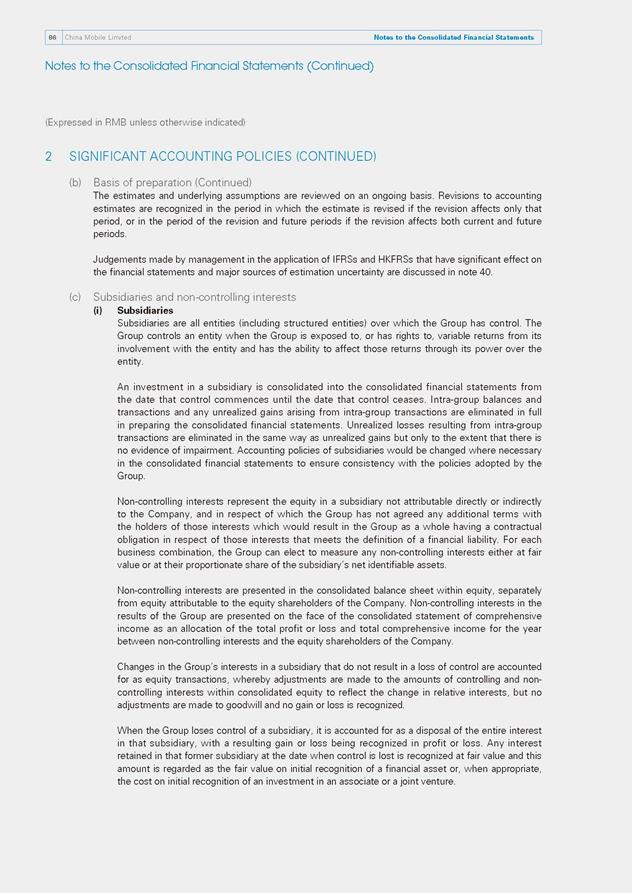
China Mobile Limited86 Notes to the Consolidated Financial Statements 86 Notes to the Consolidated Financial Statements Notes to the Consolidated Financial Statements (Continued) (Expressed in RMB unless otherwise indicated) SIGNIFICANT ACCOUNTING POLICIES (CONTINUED) (b) Basis of preparation (Continued) The estimates and underlying assumptions are reviewed on an ongoing basis. Revisions to accounting estimates are recognized in the period in which the estimate is revised if the revision affects only that period, or in the period of the revision and future periods if the revision affects both current and future periods. Judgements made by management in the application of IFRSs and HKFRSs that have significant effect on the financial statements and major sources of estimation uncertainty are discussed in note 40. (c) Subsidiaries and non-controlling interests (i) Subsidiaries Subsidiaries are all entities (including structured entities) over which the Group has control. The Group controls an entity when the Group is exposed to, or has rights to, variable returns from its involvement with the entity and has the ability to affect those returns through its power over the entity. An investment in a subsidiary is consolidated into the consolidated financial statements from the date that control commences until the date that control ceases. Intra-group balances and transactions and any unrealized gains arising from intra-group transactions are eliminated in full in preparing the consolidated financial statements. Unrealized losses resulting from intra-group transactions are eliminated in the same way as unrealized gains but only to the extent that there is no evidence of impairment. Accounting policies of subsidiaries would be changed where necessary in the consolidated financial statements to ensure consistency with the policies adopted by the Group. Non-controlling interests represent the equity in a subsidiary not attributable directly or indirectly to the Company, and in respect of which the Group has not agreed any additional terms with the holders of those interests which would result in the Group as a whole having a contractual obligation in respect of those interests that meets the definition of a financial liability. For each business combination, the Group can elect to measure any non-controlling interests either at fair value or at their proportionate share of the subsidiary’s net identifiable assets. Non-controlling interests are presented in the consolidated balance sheet within equity, separately from equity attributable to the equity shareholders of the Company. Non-controlling interests in the results of the Group are presented on the face of the consolidated statement of comprehensive income as an allocation of the total profit or loss and total comprehensive income for the year between non-controlling interests and the equity shareholders of the Company. Changes in the Group’s interests in a subsidiary that do not result in a loss of control are accounted for as equity transactions, whereby adjustments are made to the amounts of controlling and non- controlling interests within consolidated equity to reflect the change in relative interests, but no adjustments are made to goodwill and no gain or loss is recognized. When the Group loses control of a subsidiary, it is accounted for as a disposal of the entire interest in that subsidiary, with a resulting gain or loss being recognized in profit or loss. Any interest retained in that former subsidiary at the date when control is lost is recognized at fair value and this amount is regarded as the fair value on initial recognition of a financial asset or, when appropriate, the cost on initial recognition of an investment in an associate or a joint venture.
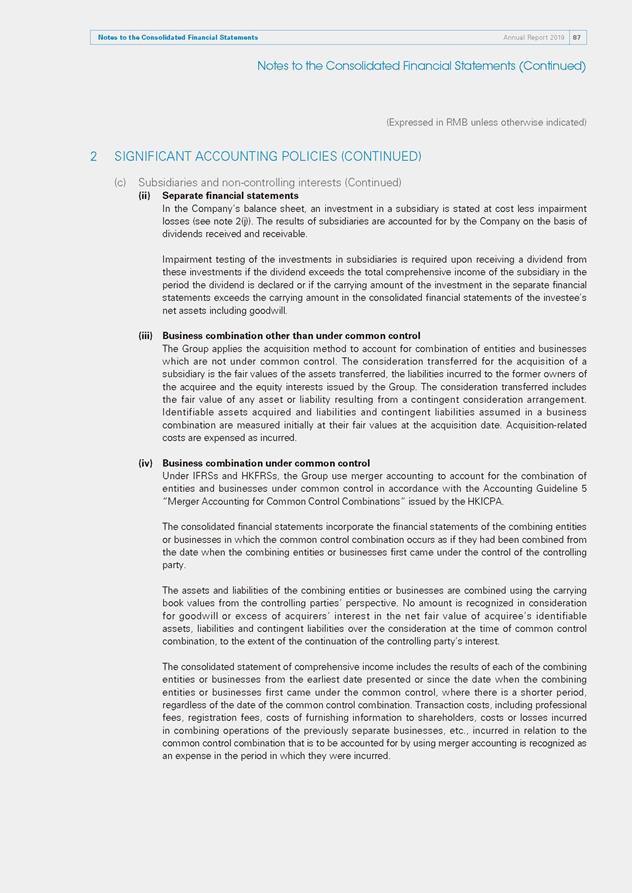
Annual Report 2019 87Notes to the Consolidated Financial Statements 87Notes to the Consolidated Financial Statements Notes to the Consolidated Financial Statements (Continued) (Expressed in RMB unless otherwise indicated) SIGNIFICANT ACCOUNTING POLICIES (CONTINUED) (c) Subsidiaries and non-controlling interests (Continued) (ii) Separate financial statements In the Company’s balance sheet, an investment in a subsidiary is stated at cost less impairment losses (see note 2(j)). The results of subsidiaries are accounted for by the Company on the basis of dividends received and receivable. Impairment testing of the investments in subsidiaries is required upon receiving a dividend from these investments if the dividend exceeds the total comprehensive income of the subsidiary in the period the dividend is declared or if the carrying amount of the investment in the separate financial statements exceeds the carrying amount in the consolidated financial statements of the investee’s net assets including goodwill. (iii) Business combination other than under common control The Group applies the acquisition method to account for combination of entities and businesses which are not under common control. The consideration transferred for the acquisition of a subsidiary is the fair values of the assets transferred, the liabilities incurred to the former owners of the acquiree and the equity interests issued by the Group. The consideration transferred includes the fair value of any asset or liability resulting from a contingent consideration arrangement. Identifiable assets acquired and liabilities and contingent liabilities assumed in a business combination are measured initially at their fair values at the acquisition date. Acquisition-related costs are expensed as incurred. (iv) Business combination under common control Under IFRSs and HKFRSs, the Group use merger accounting to account for the combination of entities and businesses under common control in accordance with the Accounting Guideline 5 “Merger Accounting for Common Control Combinations” issued by the HKICPA. The consolidated financial statements incorporate the financial statements of the combining entities or businesses in which the common control combination occurs as if they had been combined from the date when the combining entities or businesses first came under the control of the controlling party. The assets and liabilities of the combining entities or businesses are combined using the carrying book values from the controlling parties’ perspective. No amount is recognized in consideration for goodwill or excess of acquirers’ interest in the net fair value of acquiree’s identifiable assets, liabilities and contingent liabilities over the consideration at the time of common control combination, to the extent of the continuation of the controlling party’s interest. The consolidated statement of comprehensive income includes the results of each of the combining entities or businesses from the earliest date presented or since the date when the combining entities or businesses first came under the common control, where there is a shorter period, regardless of the date of the common control combination. Transaction costs, including professional fees, registration fees, costs of furnishing information to shareholders, costs or losses incurred in combining operations of the previously separate businesses, etc., incurred in relation to the common control combination that is to be accounted for by using merger accounting is recognized as an expense in the period in which they were incurred.
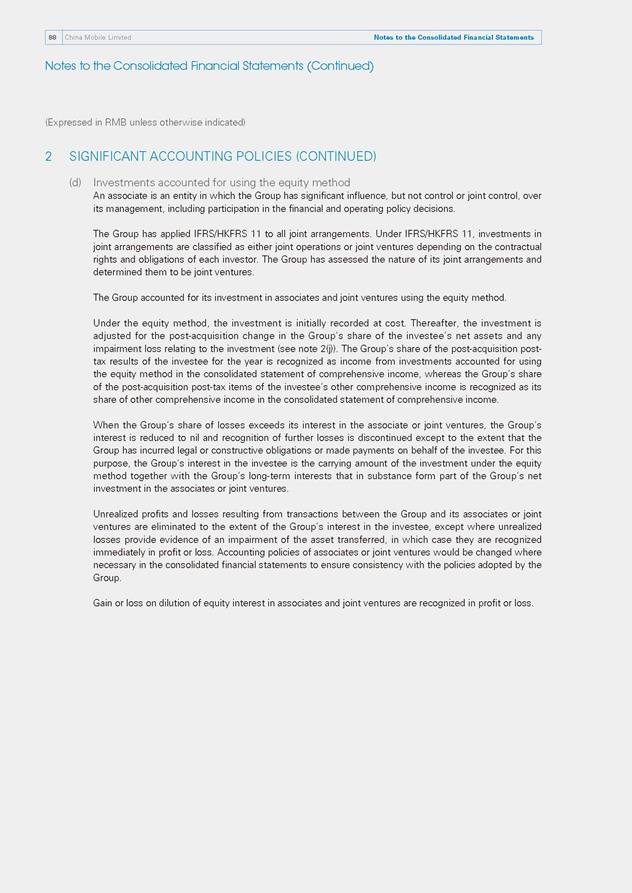
China Mobile Limited88 Notes to the Consolidated Financial Statements 88 Notes to the Consolidated Financial Statements Notes to the Consolidated Financial Statements (Continued) (Expressed in RMB unless otherwise indicated) SIGNIFICANT ACCOUNTING POLICIES (CONTINUED) (d) Investments accounted for using the equity method An associate is an entity in which the Group has significant influence, but not control or joint control, over its management, including participation in the financial and operating policy decisions. The Group has applied IFRS/HKFRS 11 to all joint arrangements. Under IFRS/HKFRS 11, investments in joint arrangements are classified as either joint operations or joint ventures depending on the contractual rights and obligations of each investor. The Group has assessed the nature of its joint arrangements and determined them to be joint ventures. The Group accounted for its investment in associates and joint ventures using the equity method. Under the equity method, the investment is initially recorded at cost. Thereafter, the investment is adjusted for the post-acquisition change in the Group’s share of the investee’s net assets and any impairment loss relating to the investment (see note 2(j)). The Group’s share of the post-acquisition post- tax results of the investee for the year is recognized as income from investments accounted for using the equity method in the consolidated statement of comprehensive income, whereas the Group’s share of the post-acquisition post-tax items of the investee’s other comprehensive income is recognized as its share of other comprehensive income in the consolidated statement of comprehensive income. When the Group’s share of losses exceeds its interest in the associate or joint ventures, the Group’s interest is reduced to nil and recognition of further losses is discontinued except to the extent that the Group has incurred legal or constructive obligations or made payments on behalf of the investee. For this purpose, the Group’s interest in the investee is the carrying amount of the investment under the equity method together with the Group’s long-term interests that in substance form part of the Group’s net investment in the associates or joint ventures. Unrealized profits and losses resulting from transactions between the Group and its associates or joint ventures are eliminated to the extent of the Group’s interest in the investee, except where unrealized losses provide evidence of an impairment of the asset transferred, in which case they are recognized immediately in profit or loss. Accounting policies of associates or joint ventures would be changed where necessary in the consolidated financial statements to ensure consistency with the policies adopted by the Group. Gain or loss on dilution of equity interest in associates and joint ventures are recognized in profit or loss.
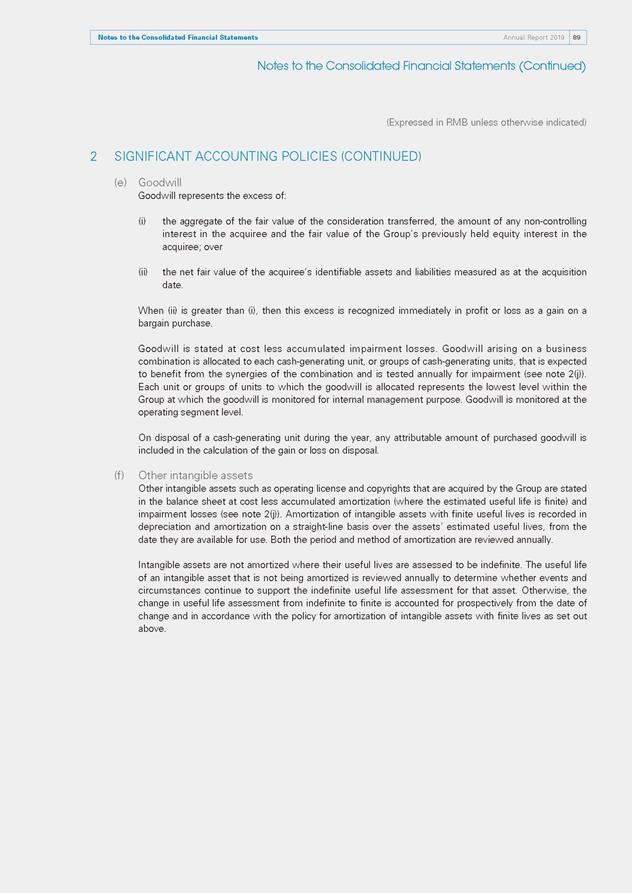
Annual Report 2019 89Notes to the Consolidated Financial Statements 89Notes to the Consolidated Financial Statements Notes to the Consolidated Financial Statements (Continued) (Expressed in RMB unless otherwise indicated) SIGNIFICANT ACCOUNTING POLICIES (CONTINUED) (e) Goodwill Goodwill represents the excess of: (i) the aggregate of the fair value of the consideration transferred, the amount of any non-controlling interest in the acquiree and the fair value of the Group’s previously held equity interest in the acquiree; over (ii) the net fair value of the acquiree’s identifiable assets and liabilities measured as at the acquisition date. When (ii) is greater than (i), then this excess is recognized immediately in profit or loss as a gain on a bargain purchase. Goodwill is stated at cost less accumulated impairment losses. Goodwill arising on a business combination is allocated to each cash-generating unit, or groups of cash-generating units, that is expected to benefit from the synergies of the combination and is tested annually for impairment (see note 2(j)). Each unit or groups of units to which the goodwill is allocated represents the lowest level within the Group at which the goodwill is monitored for internal management purpose. Goodwill is monitored at the operating segment level. On disposal of a cash-generating unit during the year, any attributable amount of purchased goodwill is included in the calculation of the gain or loss on disposal. (f) Other intangible assets Other intangible assets such as operating license and copyrights that are acquired by the Group are stated in the balance sheet at cost less accumulated amortization (where the estimated useful life is finite) and impairment losses (see note 2(j)). Amortization of intangible assets with finite useful lives is recorded in depreciation and amortization on a straight-line basis over the assets’ estimated useful lives, from the date they are available for use. Both the period and method of amortization are reviewed annually. Intangible assets are not amortized where their useful lives are assessed to be indefinite. The useful life of an intangible asset that is not being amortized is reviewed annually to determine whether events and circumstances continue to support the indefinite useful life assessment for that asset. Otherwise, the change in useful life assessment from indefinite to finite is accounted for prospectively from the date of change and in accordance with the policy for amortization of intangible assets with finite lives as set out above.
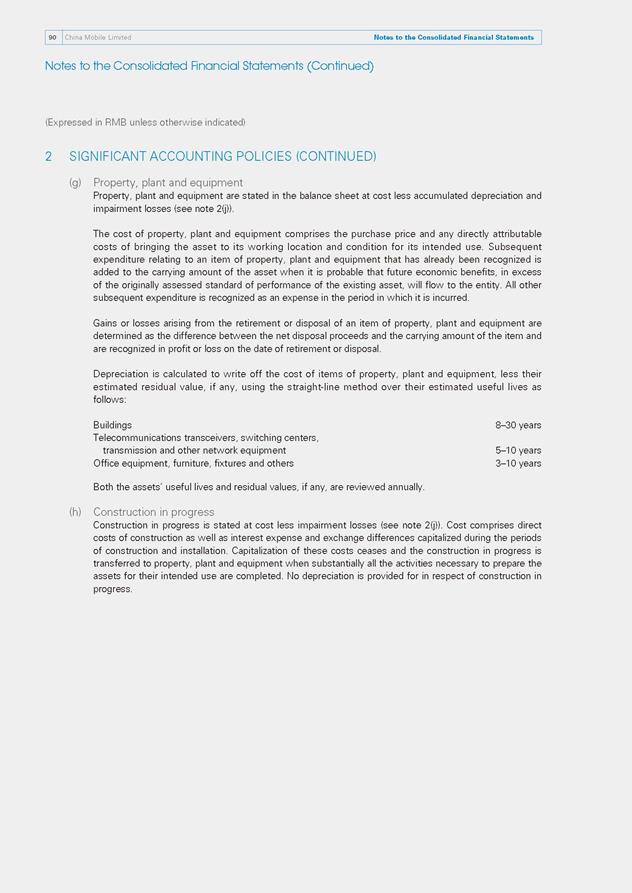
China Mobile Limited90 Notes to the Consolidated Financial Statements 90 Notes to the Consolidated Financial Statements Notes to the Consolidated Financial Statements (Continued) (Expressed in RMB unless otherwise indicated) SIGNIFICANT ACCOUNTING POLICIES (CONTINUED) (g) Property, plant and equipment Property, plant and equipment are stated in the balance sheet at cost less accumulated depreciation and impairment losses (see note 2(j)). The cost of property, plant and equipment comprises the purchase price and any directly attributable costs of bringing the asset to its working location and condition for its intended use. Subsequent expenditure relating to an item of property, plant and equipment that has already been recognized is added to the carrying amount of the asset when it is probable that future economic benefits, in excess of the originally assessed standard of performance of the existing asset, will flow to the entity. All other subsequent expenditure is recognized as an expense in the period in which it is incurred. Gains or losses arising from the retirement or disposal of an item of property, plant and equipment are determined as the difference between the net disposal proceeds and the carrying amount of the item and are recognized in profit or loss on the date of retirement or disposal. Depreciation is calculated to write off the cost of items of property, plant and equipment, less their estimated residual value, if any, using the straight-line method over their estimated useful lives as follows: Buildings 8–30 years Telecommunications transceivers, switching centers, transmission and other network equipment 5–10 years Office equipment, furniture, fixtures and others 3–10 years Both the assets’ useful lives and residual values, if any, are reviewed annually. (h) Construction in progress Construction in progress is stated at cost less impairment losses (see note 2(j)). Cost comprises direct costs of construction as well as interest expense and exchange differences capitalized during the periods of construction and installation. Capitalization of these costs ceases and the construction in progress is transferred to property, plant and equipment when substantially all the activities necessary to prepare the assets for their intended use are completed. No depreciation is provided for in respect of construction in progress.
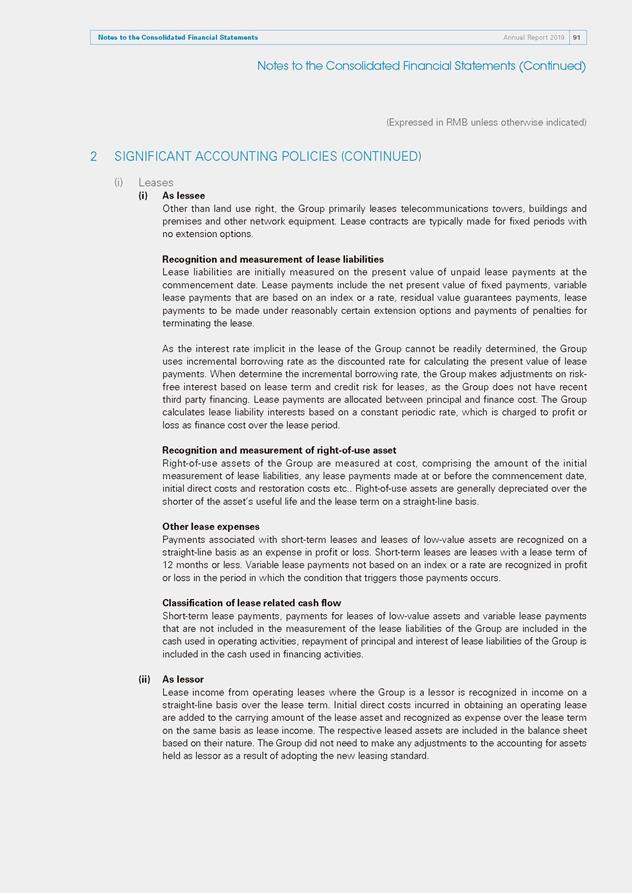
Annual Report 2019 91Notes to the Consolidated Financial Statements 91Notes to the Consolidated Financial Statements Notes to the Consolidated Financial Statements (Continued) (Expressed in RMB unless otherwise indicated) SIGNIFICANT ACCOUNTING POLICIES (CONTINUED) (i) Leases (i) As lessee Other than land use right, the Group primarily leases telecommunications towers, buildings and premises and other network equipment. Lease contracts are typically made for fixed periods with no extension options. Recognition and measurement of lease liabilities Lease liabilities are initially measured on the present value of unpaid lease payments at the commencement date. Lease payments include the net present value of fixed payments, variable lease payments that are based on an index or a rate, residual value guarantees payments, lease payments to be made under reasonably certain extension options and payments of penalties for terminating the lease. As the interest rate implicit in the lease of the Group cannot be readily determined, the Group uses incremental borrowing rate as the discounted rate for calculating the present value of lease payments. When determine the incremental borrowing rate, the Group makes adjustments on risk- free interest based on lease term and credit risk for leases, as the Group does not have recent third party financing. Lease payments are allocated between principal and finance cost. The Group calculates lease liability interests based on a constant periodic rate, which is charged to profit or loss as finance cost over the lease period. Recognition and measurement of right-of-use asset Right-of-use assets of the Group are measured at cost, comprising the amount of the initial measurement of lease liabilities, any lease payments made at or before the commencement date, initial direct costs and restoration costs etc.. Right-of-use assets are generally depreciated over the shorter of the asset’s useful life and the lease term on a straight-line basis. Other lease expenses Payments associated with short-term leases and leases of low-value assets are recognized on a straight-line basis as an expense in profit or loss. Short-term leases are leases with a lease term of 12 months or less. Variable lease payments not based on an index or a rate are recognized in profit or loss in the period in which the condition that triggers those payments occurs. Classification of lease related cash flow Short-term lease payments, payments for leases of low-value assets and variable lease payments that are not included in the measurement of the lease liabilities of the Group are included in the cash used in operating activities, repayment of principal and interest of lease liabilities of the Group is included in the cash used in financing activities. (ii) As lessor Lease income from operating leases where the Group is a lessor is recognized in income on a straight-line basis over the lease term. Initial direct costs incurred in obtaining an operating lease are added to the carrying amount of the lease asset and recognized as expense over the lease term on the same basis as lease income. The respective leased assets are included in the balance sheet based on their nature. The Group did not need to make any adjustments to the accounting for assets held as lessor as a result of adopting the new leasing standard.
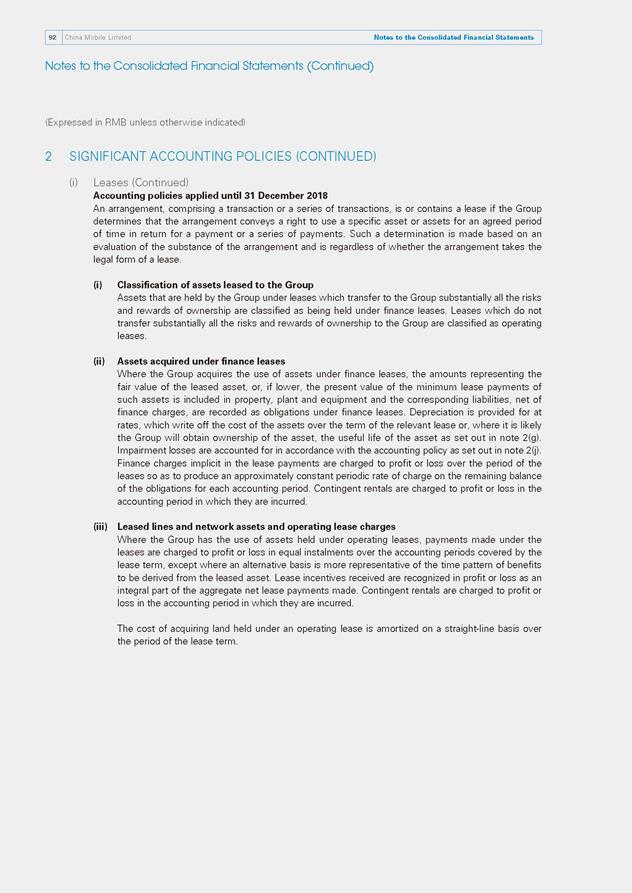
China Mobile Limited92 Notes to the Consolidated Financial Statements 92 Notes to the Consolidated Financial Statements Notes to the Consolidated Financial Statements (Continued) (Expressed in RMB unless otherwise indicated) SIGNIFICANT ACCOUNTING POLICIES (CONTINUED) (i) Leases (Continued) Accounting policies applied until 31 December 2018 An arrangement, comprising a transaction or a series of transactions, is or contains a lease if the Group determines that the arrangement conveys a right to use a specific asset or assets for an agreed period of time in return for a payment or a series of payments. Such a determination is made based on an evaluation of the substance of the arrangement and is regardless of whether the arrangement takes the legal form of a lease. (i) Classification of assets leased to the Group Assets that are held by the Group under leases which transfer to the Group substantially all the risks and rewards of ownership are classified as being held under finance leases. Leases which do not transfer substantially all the risks and rewards of ownership to the Group are classified as operating leases. (ii) Assets acquired under finance leases Where the Group acquires the use of assets under finance leases, the amounts representing the fair value of the leased asset, or, if lower, the present value of the minimum lease payments of such assets is included in property, plant and equipment and the corresponding liabilities, net of finance charges, are recorded as obligations under finance leases. Depreciation is provided for at rates, which write off the cost of the assets over the term of the relevant lease or, where it is likely the Group will obtain ownership of the asset, the useful life of the asset as set out in note 2(g). Impairment losses are accounted for in accordance with the accounting policy as set out in note 2(j). Finance charges implicit in the lease payments are charged to profit or loss over the period of the leases so as to produce an approximately constant periodic rate of charge on the remaining balance of the obligations for each accounting period. Contingent rentals are charged to profit or loss in the accounting period in which they are incurred. (iii) Leased lines and network assets and operating lease charges Where the Group has the use of assets held under operating leases, payments made under the leases are charged to profit or loss in equal instalments over the accounting periods covered by the lease term, except where an alternative basis is more representative of the time pattern of benefits to be derived from the leased asset. Lease incentives received are recognized in profit or loss as an integral part of the aggregate net lease payments made. Contingent rentals are charged to profit or loss in the accounting period in which they are incurred. The cost of acquiring land held under an operating lease is amortized on a straight-line basis over the period of the lease term.
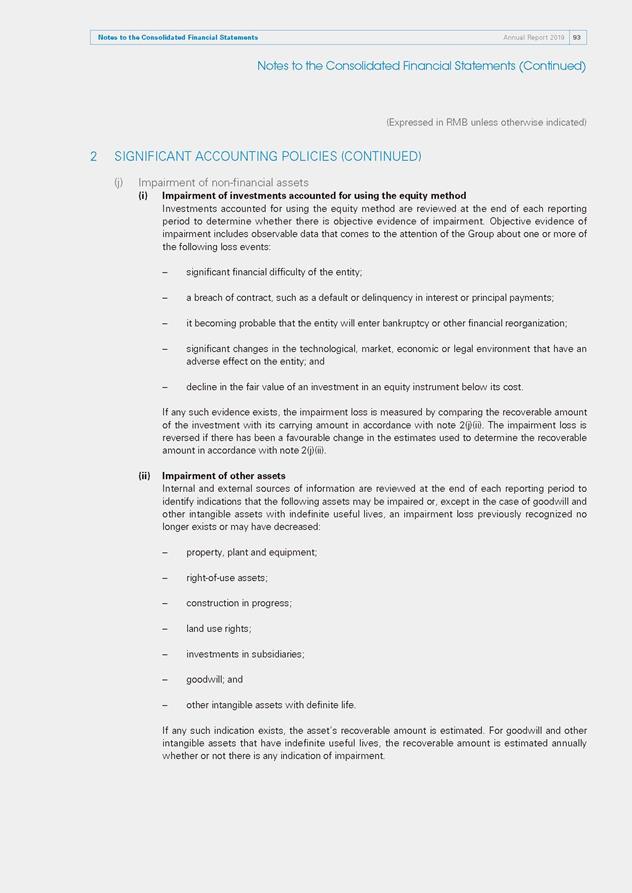
Notes to the Consolidated Financial Statements Annual Report 2019 93 Notes to the Consolidated Financial Statements (Continued) (Expressed in RMB unless otherwise indicated) SIGNIFICANT ACCOUNTING POLICIES (CONTINUED) (j) Impairment of non-financial assets (i) Impairment of investments accounted for using the equity method Investments accounted for using the equity method are reviewed at the end of each reporting period to determine whether there is objective evidence of impairment. Objective evidence of impairment includes observable data that comes to the attention of the Group about one or more of the following loss events: – significant financial difficulty of the entity; – a breach of contract, such as a default or delinquency in interest or principal payments; – it becoming probable that the entity will enter bankruptcy or other financial reorganization; – significant changes in the technological, market, economic or legal environment that have an adverse effect on the entity; and – decline in the fair value of an investment in an equity instrument below its cost. If any such evidence exists, the impairment loss is measured by comparing the recoverable amount of the investment with its carrying amount in accordance with note 2(j)(ii). The impairment loss is reversed if there has been a favourable change in the estimates used to determine the recoverable amount in accordance with note 2(j)(ii). (ii) Impairment of other assets Internal and external sources of information are reviewed at the end of each reporting period to identify indications that the following assets may be impaired or, except in the case of goodwill and other intangible assets with indefinite useful lives, an impairment loss previously recognized no longer exists or may have decreased: – property, plant and equipment; – right-of-use assets; – construction in progress; – land use rights; – investments in subsidiaries; – goodwill; and – other intangible assets with definite life. If any such indication exists, the asset’s recoverable amount is estimated. For goodwill and other intangible assets that have indefinite useful lives, the recoverable amount is estimated annually whether or not there is any indication of impairment.
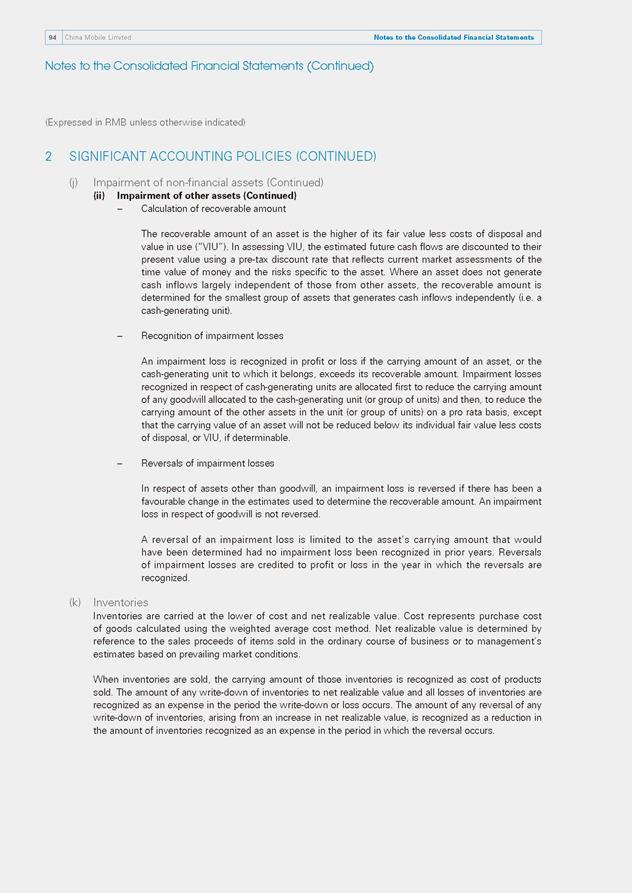
94 China Mobile Limited Notes to the Consolidated Financial Statements Notes to the Consolidated Financial Statements (Continued) (Expressed in RMB unless otherwise indicated) SIGNIFICANT ACCOUNTING POLICIES (CONTINUED) (j) Impairment of non-financial assets (Continued) (ii) Impairment of other assets (Continued) – Calculation of recoverable amount The recoverable amount of an asset is the higher of its fair value less costs of disposal and value in use (“VIU”). In assessing VIU, the estimated future cash flows are discounted to their present value using a pre-tax discount rate that reflects current market assessments of the time value of money and the risks specific to the asset. Where an asset does not generate cash inflows largely independent of those from other assets, the recoverable amount is determined for the smallest group of assets that generates cash inflows independently (i.e. a cash-generating unit). – Recognition of impairment losses An impairment loss is recognized in profit or loss if the carrying amount of an asset, or the cash-generating unit to which it belongs, exceeds its recoverable amount. Impairment losses recognized in respect of cash-generating units are allocated first to reduce the carrying amount of any goodwill allocated to the cash-generating unit (or group of units) and then, to reduce the carrying amount of the other assets in the unit (or group of units) on a pro rata basis, except that the carrying value of an asset will not be reduced below its individual fair value less costs of disposal, or VIU, if determinable. – Reversals of impairment losses In respect of assets other than goodwill, an impairment loss is reversed if there has been a favourable change in the estimates used to determine the recoverable amount. An impairment loss in respect of goodwill is not reversed. A reversal of an impairment loss is limited to the asset’s carrying amount that would have been determined had no impairment loss been recognized in prior years. Reversals of impairment losses are credited to profit or loss in the year in which the reversals are recognized. (k) Inventories Inventories are carried at the lower of cost and net realizable value. Cost represents purchase cost of goods calculated using the weighted average cost method. Net realizable value is determined by reference to the sales proceeds of items sold in the ordinary course of business or to management’s estimates based on prevailing market conditions. When inventories are sold, the carrying amount of those inventories is recognized as cost of products sold. The amount of any write-down of inventories to net realizable value and all losses of inventories are recognized as an expense in the period the write-down or loss occurs. The amount of any reversal of any write-down of inventories, arising from an increase in net realizable value, is recognized as a reduction in the amount of inventories recognized as an expense in the period in which the reversal occurs.
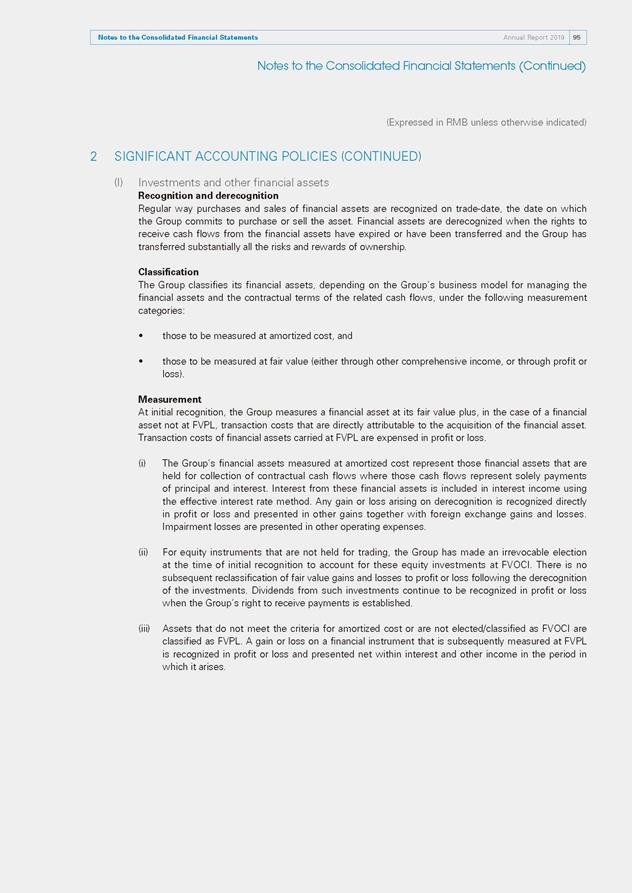
Annual Report 2019 95Notes to the Consolidated Financial Statements 95Notes to the Consolidated Financial Statements Notes to the Consolidated Financial Statements (Continued) (Expressed in RMB unless otherwise indicated) SIGNIFICANT ACCOUNTING POLICIES (CONTINUED) (l) Investments and other financial assets Recognition and derecognition Regular way purchases and sales of financial assets are recognized on trade-date, the date on which the Group commits to purchase or sell the asset. Financial assets are derecognized when the rights to receive cash flows from the financial assets have expired or have been transferred and the Group has transferred substantially all the risks and rewards of ownership. Classification The Group classifies its financial assets, depending on the Group’s business model for managing the financial assets and the contractual terms of the related cash flows, under the following measurement categories: • those to be measured at amortized cost, and • those to be measured at fair value (either through other comprehensive income, or through profit or loss). Measurement At initial recognition, the Group measures a financial asset at its fair value plus, in the case of a financial asset not at FVPL, transaction costs that are directly attributable to the acquisition of the financial asset. Transaction costs of financial assets carried at FVPL are expensed in profit or loss. (i) The Group’s financial assets measured at amortized cost represent those financial assets that are held for collection of contractual cash flows where those cash flows represent solely payments of principal and interest. Interest from these financial assets is included in interest income using the effective interest rate method. Any gain or loss arising on derecognition is recognized directly in profit or loss and presented in other gains together with foreign exchange gains and losses. Impairment losses are presented in other operating expenses. (ii) For equity instruments that are not held for trading, the Group has made an irrevocable election at the time of initial recognition to account for these equity investments at FVOCI. There is no subsequent reclassification of fair value gains and losses to profit or loss following the derecognition of the investments. Dividends from such investments continue to be recognized in profit or loss when the Group’s right to receive payments is established. (iii) Assets that do not meet the criteria for amortized cost or are not elected/classified as FVOCI are classified as FVPL. A gain or loss on a financial instrument that is subsequently measured at FVPL is recognized in profit or loss and presented net within interest and other income in the period in which it arises.
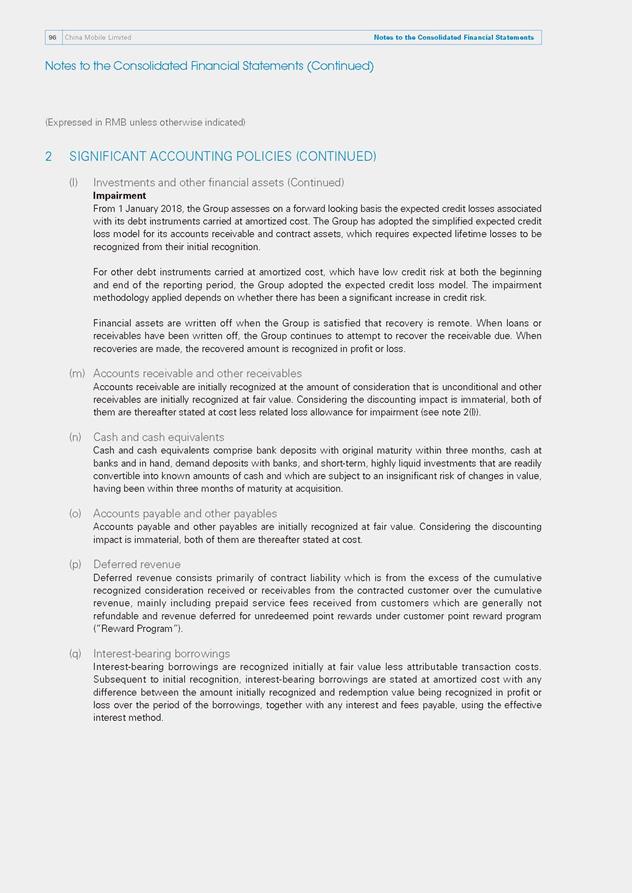
China Mobile Limited96 Notes to the Consolidated Financial Statements 96 Notes to the Consolidated Financial Statements Notes to the Consolidated Financial Statements (Continued) (Expressed in RMB unless otherwise indicated) SIGNIFICANT ACCOUNTING POLICIES (CONTINUED) (l) Investments and other financial assets (Continued) Impairment From 1 January 2018, the Group assesses on a forward looking basis the expected credit losses associated with its debt instruments carried at amortized cost. The Group has adopted the simplified expected credit loss model for its accounts receivable and contract assets, which requires expected lifetime losses to be recognized from their initial recognition. For other debt instruments carried at amortized cost, which have low credit risk at both the beginning and end of the reporting period, the Group adopted the expected credit loss model. The impairment methodology applied depends on whether there has been a significant increase in credit risk. Financial assets are written off when the Group is satisfied that recovery is remote. When loans or receivables have been written off, the Group continues to attempt to recover the receivable due. When recoveries are made, the recovered amount is recognized in profit or loss. (m) Accounts receivable and other receivables Accounts receivable are initially recognized at the amount of consideration that is unconditional and other receivables are initially recognized at fair value. Considering the discounting impact is immaterial, both of them are thereafter stated at cost less related loss allowance for impairment (see note 2(l)). (n) Cash and cash equivalents Cash and cash equivalents comprise bank deposits with original maturity within three months, cash at banks and in hand, demand deposits with banks, and short-term, highly liquid investments that are readily convertible into known amounts of cash and which are subject to an insignificant risk of changes in value, having been within three months of maturity at acquisition. (o) Accounts payable and other payables Accounts payable and other payables are initially recognized at fair value. Considering the discounting impact is immaterial, both of them are thereafter stated at cost. (p) Deferred revenue Deferred revenue consists primarily of contract liability which is from the excess of the cumulative recognized consideration received or receivables from the contracted customer over the cumulative revenue, mainly including prepaid service fees received from customers which are generally not refundable and revenue deferred for unredeemed point rewards under customer point reward program (“Reward Program”). (q) Interest-bearing borrowings Interest-bearing borrowings are recognized initially at fair value less attributable transaction costs. Subsequent to initial recognition, interest-bearing borrowings are stated at amortized cost with any difference between the amount initially recognized and redemption value being recognized in profit or loss over the period of the borrowings, together with any interest and fees payable, using the effective interest method.
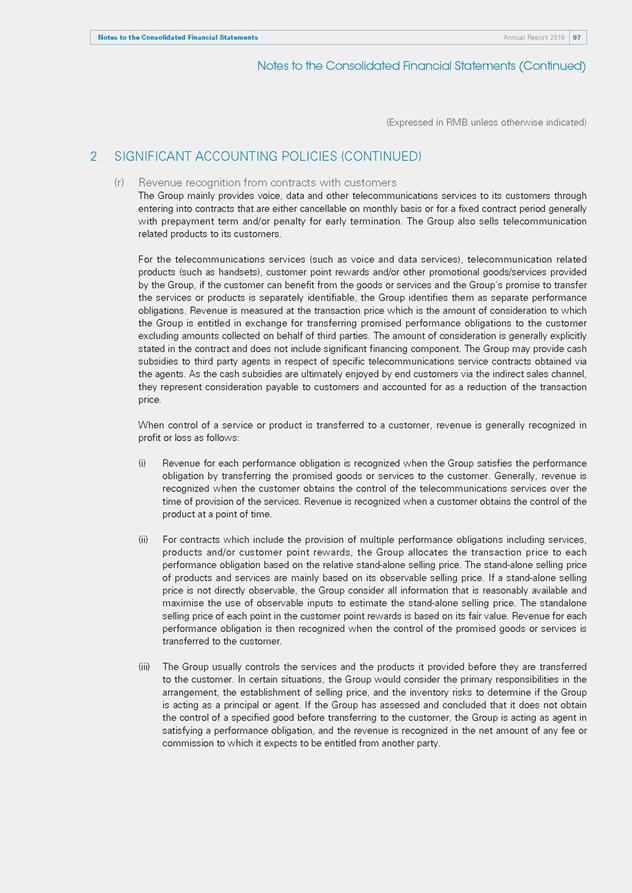
Annual Report 2019 97Notes to the Consolidated Financial Statements 97Notes to the Consolidated Financial Statements Notes to the Consolidated Financial Statements (Continued) (Expressed in RMB unless otherwise indicated) SIGNIFICANT ACCOUNTING POLICIES (CONTINUED) (r) Revenue recognition from contracts with customers The Group mainly provides voice, data and other telecommunications services to its customers through entering into contracts that are either cancellable on monthly basis or for a fixed contract period generally with prepayment term and/or penalty for early termination. The Group also sells telecommunication related products to its customers. For the telecommunications services (such as voice and data services), telecommunication related products (such as handsets), customer point rewards and/or other promotional goods/services provided by the Group, if the customer can benefit from the goods or services and the Group’s promise to transfer the services or products is separately identifiable, the Group identifies them as separate performance obligations. Revenue is measured at the transaction price which is the amount of consideration to which the Group is entitled in exchange for transferring promised performance obligations to the customer excluding amounts collected on behalf of third parties. The amount of consideration is generally explicitly stated in the contract and does not include significant financing component. The Group may provide cash subsidies to third party agents in respect of specific telecommunications service contracts obtained via the agents. As the cash subsidies are ultimately enjoyed by end customers via the indirect sales channel, they represent consideration payable to customers and accounted for as a reduction of the transaction price. When control of a service or product is transferred to a customer, revenue is generally recognized in profit or loss as follows: (i) Revenue for each performance obligation is recognized when the Group satisfies the performance obligation by transferring the promised goods or services to the customer. Generally, revenue is recognized when the customer obtains the control of the telecommunications services over the time of provision of the services. Revenue is recognized when a customer obtains the control of the product at a point of time. (ii) For contracts which include the provision of multiple performance obligations including services, products and/or customer point rewards, the Group allocates the transaction price to each performance obligation based on the relative stand-alone selling price. The stand-alone selling price of products and services are mainly based on its observable selling price. If a stand-alone selling price is not directly observable, the Group consider all information that is reasonably available and maximise the use of observable inputs to estimate the stand-alone selling price. The standalone selling price of each point in the customer point rewards is based on its fair value. Revenue for each performance obligation is then recognized when the control of the promised goods or services is transferred to the customer. (iii) The Group usually controls the services and the products it provided before they are transferred to the customer. In certain situations, the Group would consider the primary responsibilities in the arrangement, the establishment of selling price, and the inventory risks to determine if the Group is acting as a principal or agent. If the Group has assessed and concluded that it does not obtain the control of a specified good before transferring to the customer, the Group is acting as agent in satisfying a performance obligation, and the revenue is recognized in the net amount of any fee or commission to which it expects to be entitled from another party.
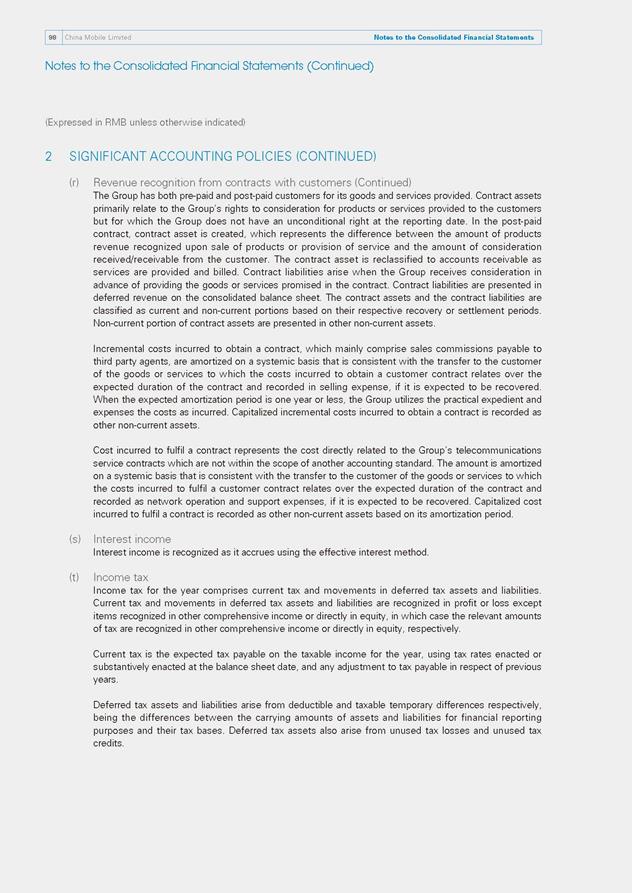
China Mobile Limited98 Notes to the Consolidated Financial Statements 98 Notes to the Consolidated Financial Statements Notes to the Consolidated Financial Statements (Continued) (Expressed in RMB unless otherwise indicated) SIGNIFICANT ACCOUNTING POLICIES (CONTINUED) (r) Revenue recognition from contracts with customers (Continued) The Group has both pre-paid and post-paid customers for its goods and services provided. Contract assets primarily relate to the Group’s rights to consideration for products or services provided to the customers but for which the Group does not have an unconditional right at the reporting date. In the post-paid contract, contract asset is created, which represents the difference between the amount of products revenue recognized upon sale of products or provision of service and the amount of consideration received/receivable from the customer. The contract asset is reclassified to accounts receivable as services are provided and billed. Contract liabilities arise when the Group receives consideration in advance of providing the goods or services promised in the contract. Contract liabilities are presented in deferred revenue on the consolidated balance sheet. The contract assets and the contract liabilities are classified as current and non-current portions based on their respective recovery or settlement periods. Non-current portion of contract assets are presented in other non-current assets. Incremental costs incurred to obtain a contract, which mainly comprise sales commissions payable to third party agents, are amortized on a systemic basis that is consistent with the transfer to the customer of the goods or services to which the costs incurred to obtain a customer contract relates over the expected duration of the contract and recorded in selling expense, if it is expected to be recovered. When the expected amortization period is one year or less, the Group utilizes the practical expedient and expenses the costs as incurred. Capitalized incremental costs incurred to obtain a contract is recorded as other non-current assets. Cost incurred to fulfil a contract represents the cost directly related to the Group’s telecommunications service contracts which are not within the scope of another accounting standard. The amount is amortized on a systemic basis that is consistent with the transfer to the customer of the goods or services to which the costs incurred to fulfil a customer contract relates over the expected duration of the contract and recorded as network operation and support expenses, if it is expected to be recovered. Capitalized cost incurred to fulfil a contract is recorded as other non-current assets based on its amortization period. (s) Interest income Interest income is recognized as it accrues using the effective interest method. (t) Income tax Income tax for the year comprises current tax and movements in deferred tax assets and liabilities. Current tax and movements in deferred tax assets and liabilities are recognized in profit or loss except items recognized in other comprehensive income or directly in equity, in which case the relevant amounts of tax are recognized in other comprehensive income or directly in equity, respectively. Current tax is the expected tax payable on the taxable income for the year, using tax rates enacted or substantively enacted at the balance sheet date, and any adjustment to tax payable in respect of previous years. Deferred tax assets and liabilities arise from deductible and taxable temporary differences respectively, being the differences between the carrying amounts of assets and liabilities for financial reporting purposes and their tax bases. Deferred tax assets also arise from unused tax losses and unused tax credits.
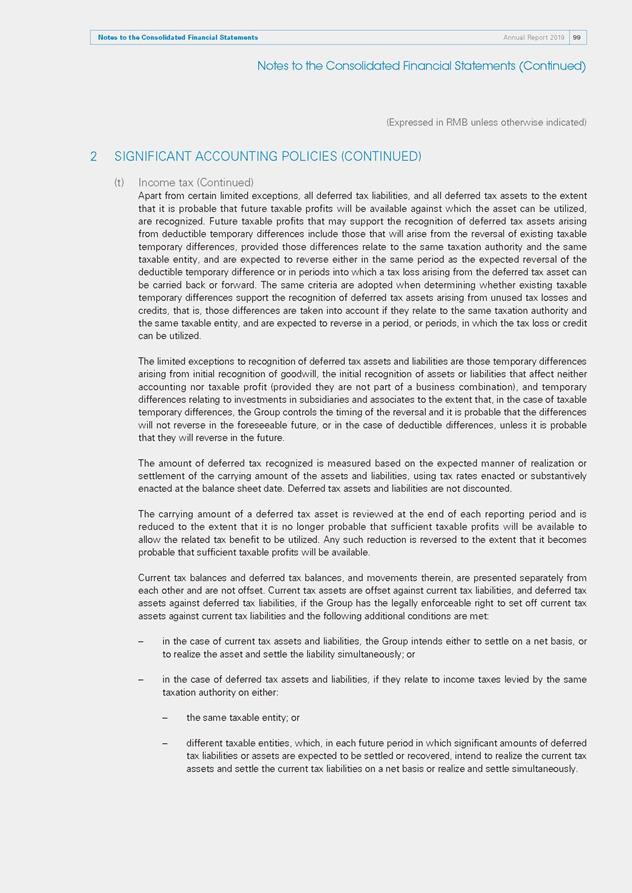
Notes to the Consolidated Financial Statements Annual Report 2019 99 Notes to the Consolidated Financial Statements (Continued) (Expressed in RMB unless otherwise indicated) SIGNIFICANT ACCOUNTING POLICIES (CONTINUED) (t) Income tax (Continued) Apart from certain limited exceptions, all deferred tax liabilities, and all deferred tax assets to the extent that it is probable that future taxable profits will be available against which the asset can be utilized, are recognized. Future taxable profits that may support the recognition of deferred tax assets arising from deductible temporary differences include those that will arise from the reversal of existing taxable temporary differences, provided those differences relate to the same taxation authority and the same taxable entity, and are expected to reverse either in the same period as the expected reversal of the deductible temporary difference or in periods into which a tax loss arising from the deferred tax asset can be carried back or forward. The same criteria are adopted when determining whether existing taxable temporary differences support the recognition of deferred tax assets arising from unused tax losses and credits, that is, those differences are taken into account if they relate to the same taxation authority and the same taxable entity, and are expected to reverse in a period, or periods, in which the tax loss or credit can be utilized. The limited exceptions to recognition of deferred tax assets and liabilities are those temporary differences arising from initial recognition of goodwill, the initial recognition of assets or liabilities that affect neither accounting nor taxable profit (provided they are not part of a business combination), and temporary differences relating to investments in subsidiaries and associates to the extent that, in the case of taxable temporary differences, the Group controls the timing of the reversal and it is probable that the differences will not reverse in the foreseeable future, or in the case of deductible differences, unless it is probable that they will reverse in the future. The amount of deferred tax recognized is measured based on the expected manner of realization or settlement of the carrying amount of the assets and liabilities, using tax rates enacted or substantively enacted at the balance sheet date. Deferred tax assets and liabilities are not discounted. The carrying amount of a deferred tax asset is reviewed at the end of each reporting period and is reduced to the extent that it is no longer probable that sufficient taxable profits will be available to allow the related tax benefit to be utilized. Any such reduction is reversed to the extent that it becomes probable that sufficient taxable profits will be available. Current tax balances and deferred tax balances, and movements therein, are presented separately from each other and are not offset. Current tax assets are offset against current tax liabilities, and deferred tax assets against deferred tax liabilities, if the Group has the legally enforceable right to set off current tax assets against current tax liabilities and the following additional conditions are met: – in the case of current tax assets and liabilities, the Group intends either to settle on a net basis, or to realize the asset and settle the liability simultaneously; or – in the case of deferred tax assets and liabilities, if they relate to income taxes levied by the same taxation authority on either: – the same taxable entity; or – different taxable entities, which, in each future period in which significant amounts of deferred tax liabilities or assets are expected to be settled or recovered, intend to realize the current tax assets and settle the current tax liabilities on a net basis or realize and settle simultaneously.
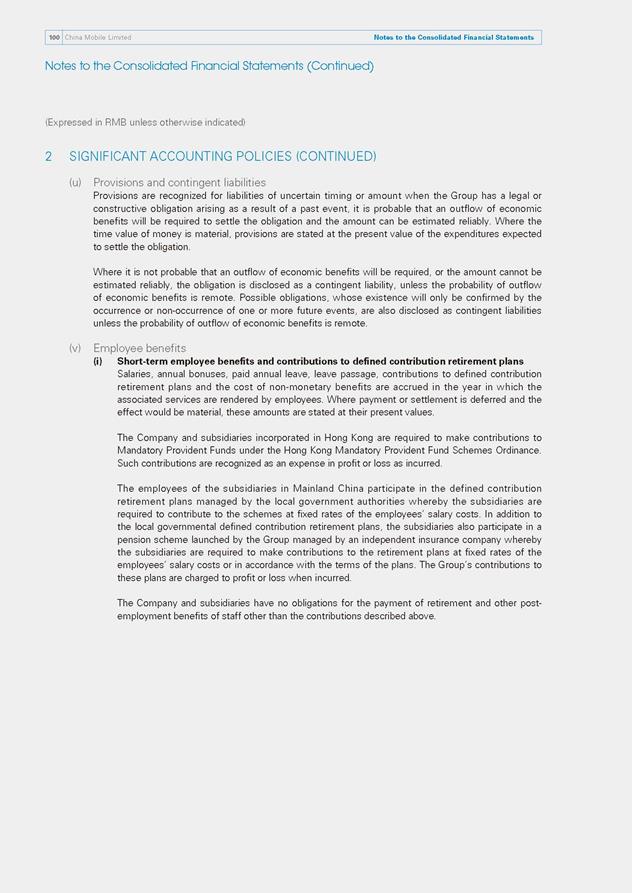
China Mobile Limited100 Notes to the Consolidated Financial Statements 100 Notes to the Consolidated Financial Statements Notes to the Consolidated Financial Statements (Continued) (Expressed in RMB unless otherwise indicated) SIGNIFICANT ACCOUNTING POLICIES (CONTINUED) (u) Provisions and contingent liabilities Provisions are recognized for liabilities of uncertain timing or amount when the Group has a legal or constructive obligation arising as a result of a past event, it is probable that an outflow of economic benefits will be required to settle the obligation and the amount can be estimated reliably. Where the time value of money is material, provisions are stated at the present value of the expenditures expected to settle the obligation. Where it is not probable that an outflow of economic benefits will be required, or the amount cannot be estimated reliably, the obligation is disclosed as a contingent liability, unless the probability of outflow of economic benefits is remote. Possible obligations, whose existence will only be confirmed by the occurrence or non-occurrence of one or more future events, are also disclosed as contingent liabilities unless the probability of outflow of economic benefits is remote. (v) Employee benefits (i) Short-term employee benefits and contributions to defined contribution retirement plans Salaries, annual bonuses, paid annual leave, leave passage, contributions to defined contribution retirement plans and the cost of non-monetary benefits are accrued in the year in which the associated services are rendered by employees. Where payment or settlement is deferred and the effect would be material, these amounts are stated at their present values. The Company and subsidiaries incorporated in Hong Kong are required to make contributions to Mandatory Provident Funds under the Hong Kong Mandatory Provident Fund Schemes Ordinance. Such contributions are recognized as an expense in profit or loss as incurred. The employees of the subsidiaries in Mainland China participate in the defined contribution retirement plans managed by the local government authorities whereby the subsidiaries are required to contribute to the schemes at fixed rates of the employees’ salary costs. In addition to the local governmental defined contribution retirement plans, the subsidiaries also participate in a pension scheme launched by the Group managed by an independent insurance company whereby the subsidiaries are required to make contributions to the retirement plans at fixed rates of the employees’ salary costs or in accordance with the terms of the plans. The Group’s contributions to these plans are charged to profit or loss when incurred. The Company and subsidiaries have no obligations for the payment of retirement and other post- employment benefits of staff other than the contributions described above.
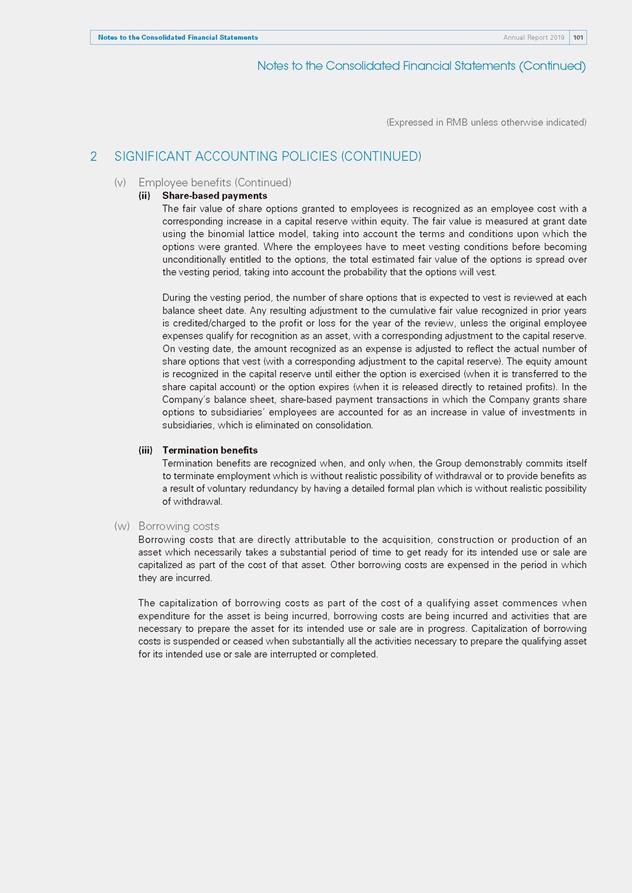
Annual Report 2019 101Notes to the Consolidated Financial Statements 101Notes to the Consolidated Financial Statements Notes to the Consolidated Financial Statements (Continued) (Expressed in RMB unless otherwise indicated) SIGNIFICANT ACCOUNTING POLICIES (CONTINUED) (v) Employee benefits (Continued) (ii) Share-based payments The fair value of share options granted to employees is recognized as an employee cost with a corresponding increase in a capital reserve within equity. The fair value is measured at grant date using the binomial lattice model, taking into account the terms and conditions upon which the options were granted. Where the employees have to meet vesting conditions before becoming unconditionally entitled to the options, the total estimated fair value of the options is spread over the vesting period, taking into account the probability that the options will vest. During the vesting period, the number of share options that is expected to vest is reviewed at each balance sheet date. Any resulting adjustment to the cumulative fair value recognized in prior years is credited/charged to the profit or loss for the year of the review, unless the original employee expenses qualify for recognition as an asset, with a corresponding adjustment to the capital reserve. On vesting date, the amount recognized as an expense is adjusted to reflect the actual number of share options that vest (with a corresponding adjustment to the capital reserve). The equity amount is recognized in the capital reserve until either the option is exercised (when it is transferred to the share capital account) or the option expires (when it is released directly to retained profits). In the Company’s balance sheet, share-based payment transactions in which the Company grants share options to subsidiaries’ employees are accounted for as an increase in value of investments in subsidiaries, which is eliminated on consolidation. (iii) Termination benefits Termination benefits are recognized when, and only when, the Group demonstrably commits itself to terminate employment which is without realistic possibility of withdrawal or to provide benefits as a result of voluntary redundancy by having a detailed formal plan which is without realistic possibility of withdrawal. (w) Borrowing costs Borrowing costs that are directly attributable to the acquisition, construction or production of an asset which necessarily takes a substantial period of time to get ready for its intended use or sale are capitalized as part of the cost of that asset. Other borrowing costs are expensed in the period in which they are incurred. The capitalization of borrowing costs as part of the cost of a qualifying asset commences when expenditure for the asset is being incurred, borrowing costs are being incurred and activities that are necessary to prepare the asset for its intended use or sale are in progress. Capitalization of borrowing costs is suspended or ceased when substantially all the activities necessary to prepare the qualifying asset for its intended use or sale are interrupted or completed.
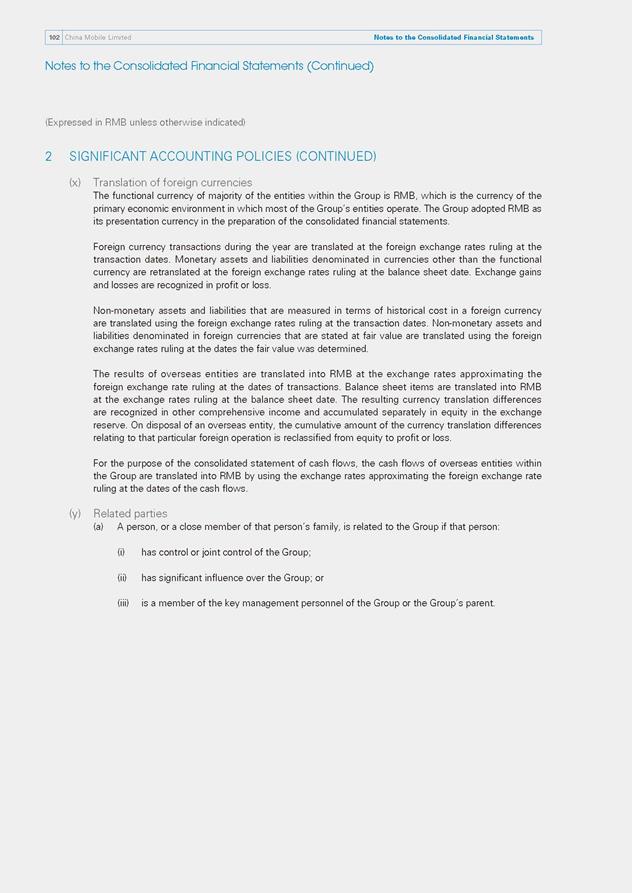
China Mobile Limited102 Notes to the Consolidated Financial Statements 102 Notes to the Consolidated Financial Statements Notes to the Consolidated Financial Statements (Continued) (Expressed in RMB unless otherwise indicated) SIGNIFICANT ACCOUNTING POLICIES (CONTINUED) (x) Translation of foreign currencies The functional currency of majority of the entities within the Group is RMB, which is the currency of the primary economic environment in which most of the Group’s entities operate. The Group adopted RMB as its presentation currency in the preparation of the consolidated financial statements. Foreign currency transactions during the year are translated at the foreign exchange rates ruling at the transaction dates. Monetary assets and liabilities denominated in currencies other than the functional currency are retranslated at the foreign exchange rates ruling at the balance sheet date. Exchange gains and losses are recognized in profit or loss. Non-monetary assets and liabilities that are measured in terms of historical cost in a foreign currency are translated using the foreign exchange rates ruling at the transaction dates. Non-monetary assets and liabilities denominated in foreign currencies that are stated at fair value are translated using the foreign exchange rates ruling at the dates the fair value was determined. The results of overseas entities are translated into RMB at the exchange rates approximating the foreign exchange rate ruling at the dates of transactions. Balance sheet items are translated into RMB at the exchange rates ruling at the balance sheet date. The resulting currency translation differences are recognized in other comprehensive income and accumulated separately in equity in the exchange reserve. On disposal of an overseas entity, the cumulative amount of the currency translation differences relating to that particular foreign operation is reclassified from equity to profit or loss. For the purpose of the consolidated statement of cash flows, the cash flows of overseas entities within the Group are translated into RMB by using the exchange rates approximating the foreign exchange rate ruling at the dates of the cash flows. (y) Related parties (a) A person, or a close member of that person’s family, is related to the Group if that person: (i) has control or joint control of the Group; (ii) has significant influence over the Group; or (iii) is a member of the key management personnel of the Group or the Group’s parent.
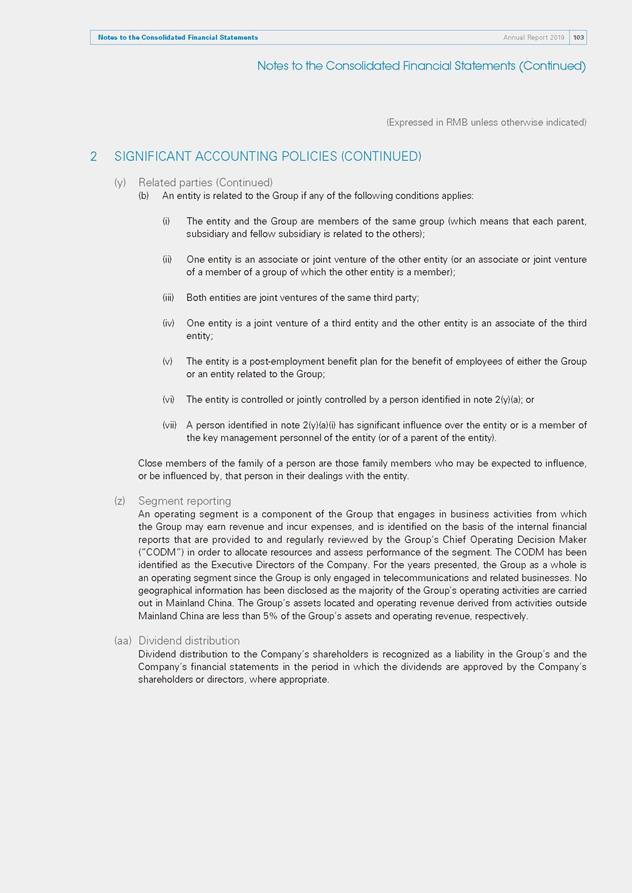
Annual Report 2019 103 Notes to the Consolidated Financial Statements 103 Notes to the Consolidated Financial Statements Notes to the Consolidated Financial Statements (Continued) (Expressed in RMB unless otherwise indicated) SIGNIFICANT ACCOUNTING POLICIES (CONTINUED) (y) Related parties (Continued) (b) An entity is related to the Group if any of the following conditions applies: (i) The entity and the Group are members of the same group (which means that each parent, subsidiary and fellow subsidiary is related to the others); (ii) One entity is an associate or joint venture of the other entity (or an associate or joint venture of a member of a group of which the other entity is a member); (iii) Both entities are joint ventures of the same third party; (iv) One entity is a joint venture of a third entity and the other entity is an associate of the third entity; (v) The entity is a post-employment benefit plan for the benefit of employees of either the Group or an entity related to the Group; (vi) The entity is controlled or jointly controlled by a person identified in note 2(y)(a); or (vii) A person identified in note 2(y)(a)(i) has significant influence over the entity or is a member of the key management personnel of the entity (or of a parent of the entity). Close members of the family of a person are those family members who may be expected to influence, or be influenced by, that person in their dealings with the entity. (z) Segment reporting An operating segment is a component of the Group that engages in business activities from which the Group may earn revenue and incur expenses, and is identified on the basis of the internal financial reports that are provided to and regularly reviewed by the Group’s Chief Operating Decision Maker (“CODM”) in order to allocate resources and assess performance of the segment. The CODM has been identified as the Executive Directors of the Company. For the years presented, the Group as a whole is an operating segment since the Group is only engaged in telecommunications and related businesses. No geographical information has been disclosed as the majority of the Group’s operating activities are carried out in Mainland China. The Group’s assets located and operating revenue derived from activities outside Mainland China are less than 5% of the Group’s assets and operating revenue, respectively. (aa) Dividend distribution Dividend distribution to the Company’s shareholders is recognized as a liability in the Group’s and the Company’s financial statements in the period in which the dividends are approved by the Company’s shareholders or directors, where appropriate.
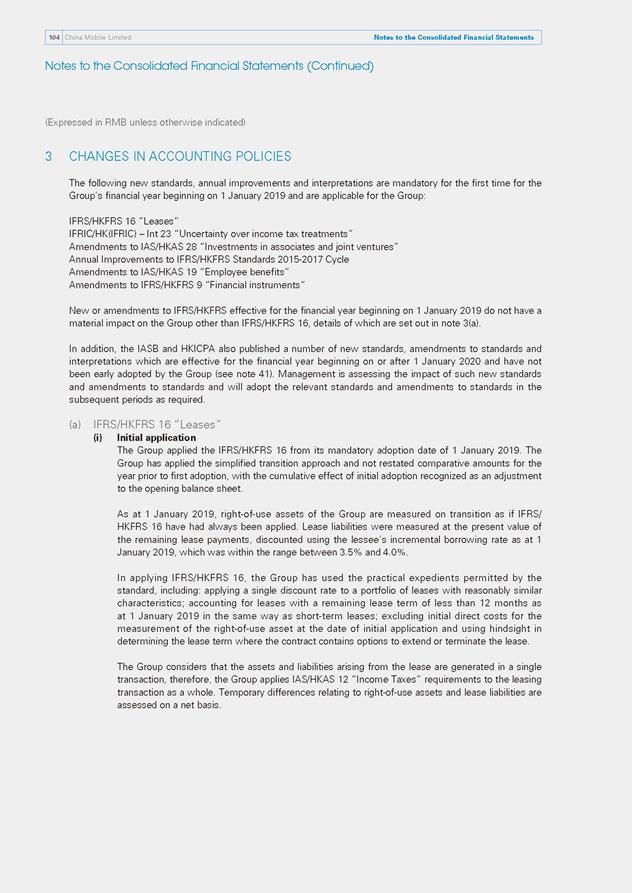
China Mobile Limited104 Notes to the Consolidated Financial Statements 104 Notes to the Consolidated Financial Statements Notes to the Consolidated Financial Statements (Continued) (Expressed in RMB unless otherwise indicated) 3 CHANGES IN ACCOUNTING POLICIES The following new standards, annual improvements and interpretations are mandatory for the first time for the Group’s financial year beginning on 1 January 2019 and are applicable for the Group: IFRS/HKFRS 16 “Leases” IFRIC/HK(IFRIC) – Int 23 “Uncertainty over income tax treatments” Amendments to IAS/HKAS 28 “Investments in associates and joint ventures” Annual Improvements to IFRS/HKFRS Standards 2015-2017 Cycle Amendments to IAS/HKAS 19 “Employee benefits” Amendments to IFRS/HKFRS 9 “Financial instruments” New or amendments to IFRS/HKFRS effective for the financial year beginning on 1 January 2019 do not have a material impact on the Group other than IFRS/HKFRS 16, details of which are set out in note 3(a). In addition, the IASB and HKICPA also published a number of new standards, amendments to standards and interpretations which are effective for the financial year beginning on or after 1 January 2020 and have not been early adopted by the Group (see note 41). Management is assessing the impact of such new standards and amendments to standards and will adopt the relevant standards and amendments to standards in the subsequent periods as required. (a) IFRS/HKFRS 16 “Leases” (i) Initial application The Group applied the IFRS/HKFRS 16 from its mandatory adoption date of 1 January 2019. The Group has applied the simplified transition approach and not restated comparative amounts for the year prior to first adoption, with the cumulative effect of initial adoption recognized as an adjustment to the opening balance sheet. As at 1 January 2019, right-of-use assets of the Group are measured on transition as if IFRS/ HKFRS 16 have had always been applied. Lease liabilities were measured at the present value of the remaining lease payments, discounted using the lessee’s incremental borrowing rate as at 1 January 2019, which was within the range between 3.5% and 4.0%. In applying IFRS/HKFRS 16, the Group has used the practical expedients permitted by the standard, including: applying a single discount rate to a portfolio of leases with reasonably similar characteristics; accounting for leases with a remaining lease term of less than 12 months as at 1 January 2019 in the same way as short-term leases; excluding initial direct costs for the measurement of the right-of-use asset at the date of initial application and using hindsight in determining the lease term where the contract contains options to extend or terminate the lease. The Group considers that the assets and liabilities arising from the lease are generated in a single transaction, therefore, the Group applies IAS/HKAS 12 “Income Taxes” requirements to the leasing transaction as a whole. Temporary differences relating to right-of-use assets and lease liabilities are assessed on a net basis.
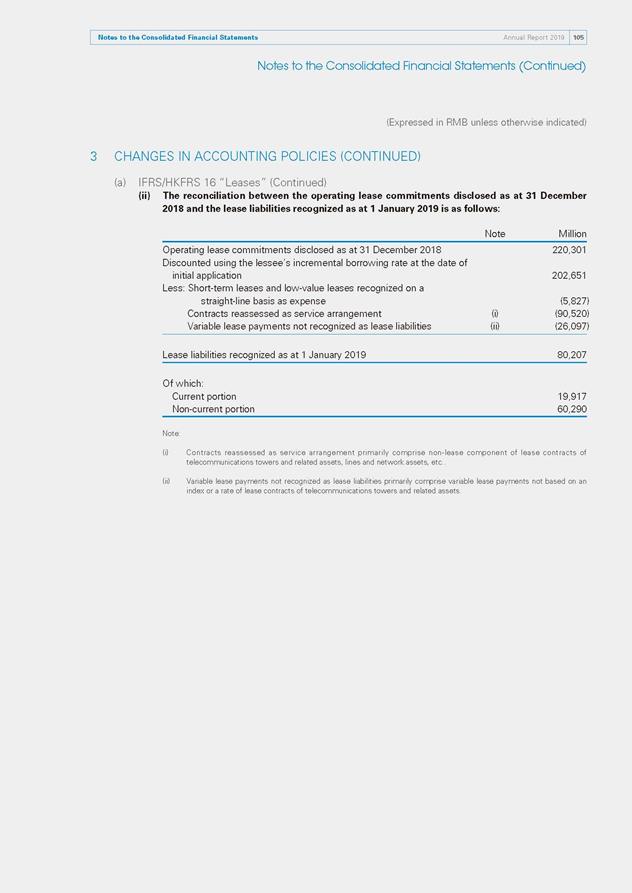
Annual Report 2019 105 Notes to the Consolidated Financial Statements 105 Notes to the Consolidated Financial Statements Notes to the Consolidated Financial Statements (Continued) (Expressed in RMB unless otherwise indicated) CHANGES IN ACCOUNTING POLICIES (CONTINUED) (a) IFRS/HKFRS 16 “Leases” (Continued) (ii) The reconciliation between the operating lease commitments disclosed as at 31 December 2018 and the lease liabilities recognized as at 1 January 2019 is as follows: Note Million Operating lease commitments disclosed as at 31 December 2018 220,301 Discounted using the lessee’s incremental borrowing rate at the date of initial application 202,651 Less: Short-term leases and low-value leases recognized on a straight-line basis as expense (5,827) Contracts reassessed as service arrangement (i) (90,520) Variable lease payments not recognized as lease liabilities (ii) (26,097) Lease liabilities recognized as at 1 January 2019 80,207 Of which: Current portion 19,917 Non-current portion 60,290 Note: (i) Contracts reassessed as service arrangement primarily comprise non-lease component of lease contracts of telecommunications towers and related assets, lines and network assets, etc.. (ii) Variable lease payments not recognized as lease liabilities primarily comprise variable lease payments not based on an index or a rate of lease contracts of telecommunications towers and related assets.
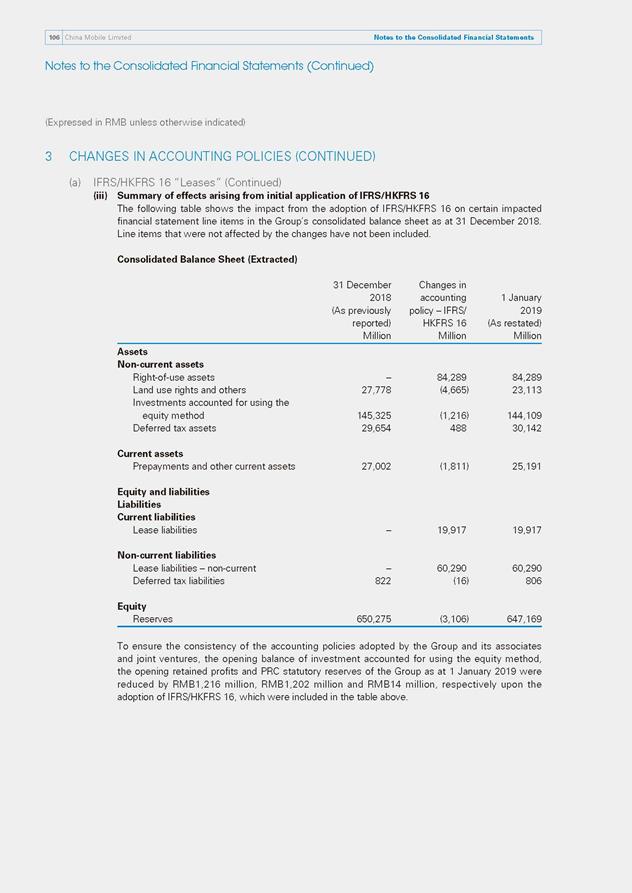
106 China Mobile Limited Notes to the Consolidated Financial Statements Notes to the Consolidated Financial Statements (Continued) (Expressed in RMB unless otherwise indicated) CHANGES IN ACCOUNTING POLICIES (CONTINUED) (a) IFRS/HKFRS 16 “Leases” (Continued) (iii) Summary of effects arising from initial application of IFRS/HKFRS 16 The following table shows the impact from the adoption of IFRS/HKFRS 16 on certain impacted financial statement line items in the Group’s consolidated balance sheet as at 31 December 2018. Line items that were not affected by the changes have not been included. Consolidated Balance Sheet (Extracted) 31 December 2018 (As previously reported) Million Changes in accounting policy – IFRS/ HKFRS 16 Million 1 January 2019 (As restated) Million Assets Non-current assets Right-of-use assets – 84,289 84,289 Land use rights and others 27,778 (4,665) 23,113 Investments accounted for using the equity method 145,325 (1,216) 144,109 Deferred tax assets 29,654 488 30,142 Current assets Prepayments and other current assets 27,002 (1,811) 25,191 Equity and liabilities Liabilities Current liabilities Lease liabilities – 19,917 19,917 Non-current liabilities Lease liabilities – non-current – 60,290 60,290 Deferred tax liabilities 822 (16) 806 Equity Reserves 650,275 (3,106) 647,169 To ensure the consistency of the accounting policies adopted by the Group and its associates and joint ventures, the opening balance of investment accounted for using the equity method, the opening retained profits and PRC statutory reserves of the Group as at 1 January 2019 were reduced by RMB1,216 million, RMB1,202 million and RMB14 million, respectively upon the adoption of IFRS/HKFRS 16, which were included in the table above.
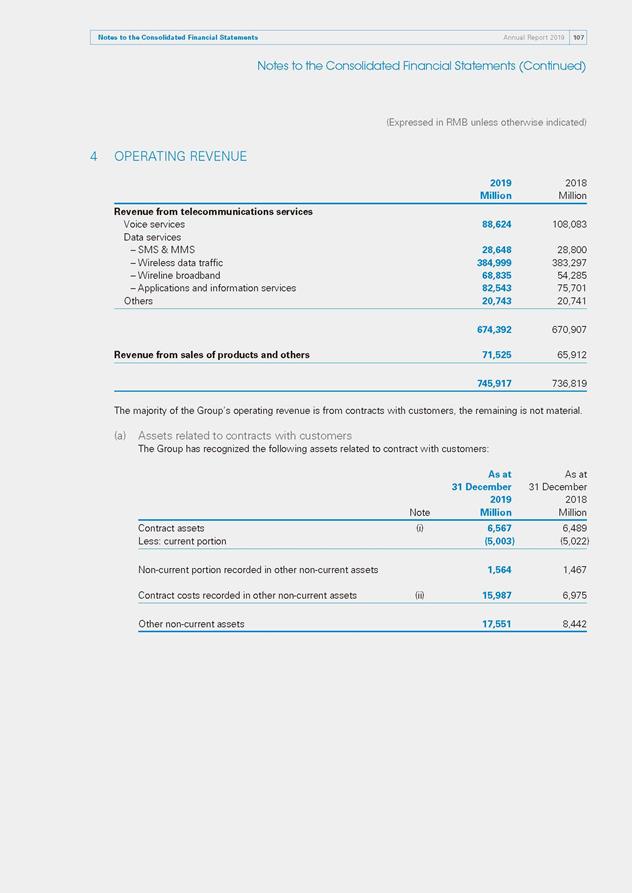
Annual Report 2019 107 Notes to the Consolidated Financial Statements 107 Notes to the Consolidated Financial Statements Notes to the Consolidated Financial Statements (Continued) (Expressed in RMB unless otherwise indicated) OPERATING REVENUE 2019 2018 Million Million Revenue from telecommunications services Voice services 88,624 108,083 Data services – SMS & MMS 28,648 28,800 – Wireless data traffic 384,999 383,297 – Wireline broadband 68,835 54,285 – Applications and information services 82,543 75,701 Others 20,743 20,741 674,392 670,907 Revenue from sales of products and others 71,525 65,912 745,917 736,819 The majority of the Group’s operating revenue is from contracts with customers, the remaining is not material. (a) Assets related to contracts with customers The Group has recognized the following assets related to contract with customers: Note As at 31 December 31 December 2019 Million As at 2018 Million Contract assets Less: current portion (i) 6,567 (5,003) 6,489 (5,022) Non-current portion recorded in other non-current assets Contract costs recorded in other non-current assets (ii) 1,564 15,987 1,467 6,975 Other non-current assets 17,551 8,442
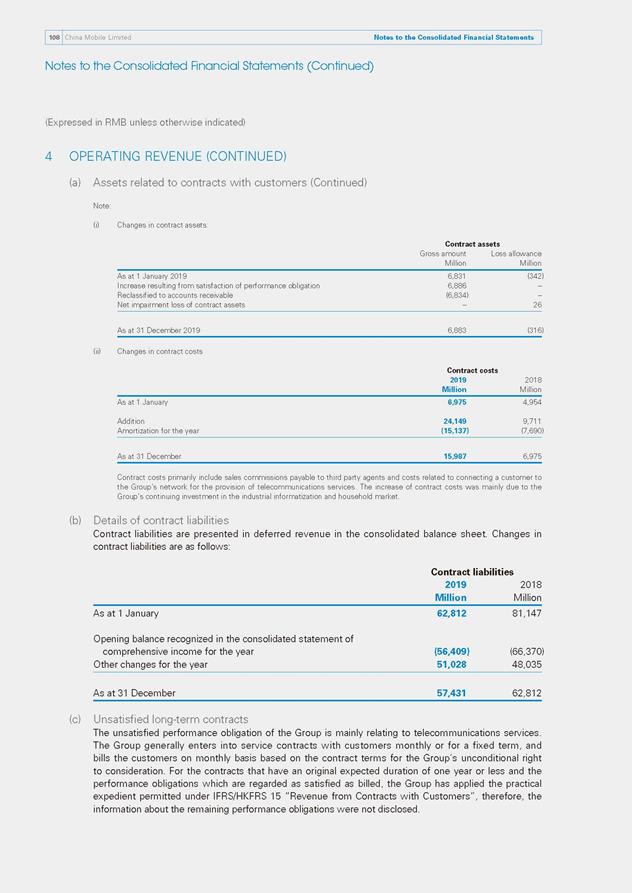
108 China Mobile Limited Notes to the Consolidated Financial Statements Notes to the Consolidated Financial Statements (Continued) (Expressed in RMB unless otherwise indicated) OPERATING REVENUE (CONTINUED) (a) Assets related to contracts with customers (Continued) Note: (i) Changes in contract assets: Contract assets Gross amount Loss allowance Million Million As at 1 January 2019 6,831 (342) Increase resulting from satisfaction of performance obligation 6,886 – Reclassified to accounts receivable (6,834) – Net impairment loss of contract assets – As at 31 December 2019 6,883 (316) (ii) Changes in contract costs Contract costs 2019 2018 Million Million As at 1 January 6,975 4,954 Addition 24,149 9,711 Amortization for the year (15,137) (7,690) As at 31 December 15,987 6,975 Contract costs primarily include sales commissions payable to third party agents and costs related to connecting a customer to the Group’s network for the provision of telecommunications services. The increase of contract costs was mainly due to the Group’s continuing investment in the industrial informatization and household market. (b) Details of contract liabilities Contract liabilities are presented in deferred revenue in the consolidated balance sheet. Changes in contract liabilities are as follows: Contract liabilities 2019 2018 Million Million As at 1 January 62,812 81,147 Opening balance recognized in the consolidated statement of comprehensive income for the year (56,409) (66,370) Other changes for the year 51,028 48,035 As at 31 December 57,431 62,812 (c) Unsatisfied long-term contracts The unsatisfied performance obligation of the Group is mainly relating to telecommunications services. The Group generally enters into service contracts with customers monthly or for a fixed term, and bills the customers on monthly basis based on the contract terms for the Group’s unconditional right to consideration. For the contracts that have an original expected duration of one year or less and the performance obligations which are regarded as satisfied as billed, the Group has applied the practical expedient permitted under IFRS/HKFRS 15 “Revenue from Contracts with Customers”, therefore, the information about the remaining performance obligations were not disclosed.
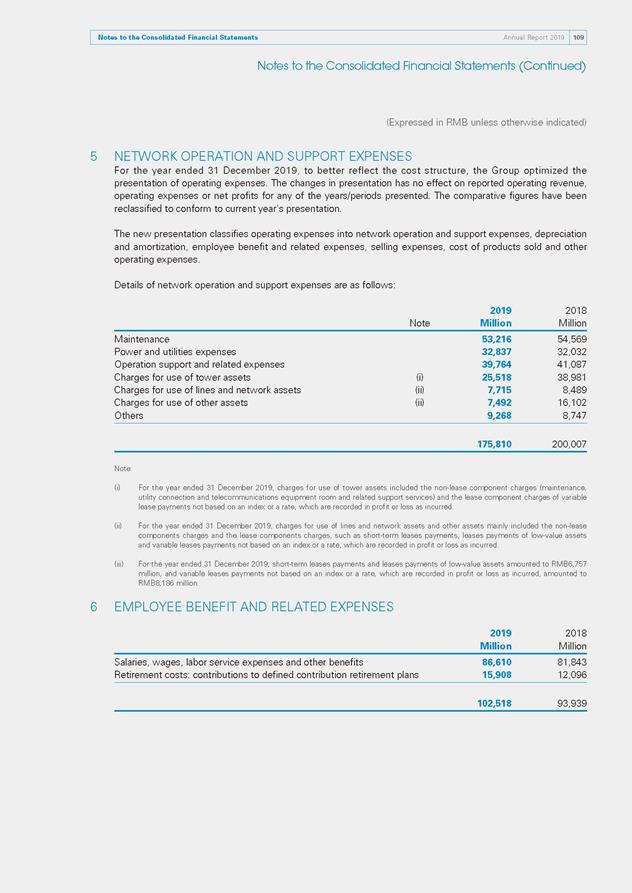
Annual Report 2019 109 Notes to the Consolidated Financial Statements 109 Notes to the Consolidated Financial Statements Notes to the Consolidated Financial Statements (Continued) (Expressed in RMB unless otherwise indicated) NETWORK OPERATION AND SUPPORT EXPENSES For the year ended 31 December 2019, to better reflect the cost structure, the Group optimized the presentation of operating expenses. The changes in presentation has no effect on reported operating revenue, operating expenses or net profits for any of the years/periods presented. The comparative figures have been reclassified to conform to current year’s presentation. The new presentation classifies operating expenses into network operation and support expenses, depreciation and amortization, employee benefit and related expenses, selling expenses, cost of products sold and other operating expenses. Details of network operation and support expenses are as follows: 2019 2018 Note Million Million Maintenance 53,216 54,569 Power and utilities expenses 32,837 32,032 Operation support and related expenses 39,764 41,087 Charges for use of tower assets (i) 25,518 38,981 Charges for use of lines and network assets (ii) 7,715 8,489 Charges for use of other assets (ii) 7,492 16,102 Others 9,268 8,747 175,810 200,007 Note: (i) For the year ended 31 December 2019, charges for use of tower assets included the non-lease component charges (maintenance, utility connection and telecommunications equipment room and related support services) and the lease component charges of variable lease payments not based on an index or a rate, which are recorded in profit or loss as incurred. (ii) For the year ended 31 December 2019, charges for use of lines and network assets and other assets mainly included the non-lease components charges and the lease components charges, such as short-term leases payments, leases payments of low-value assets and variable leases payments not based on an index or a rate, which are recorded in profit or loss as incurred. (iii) For the year ended 31 December 2019, short-term leases payments and leases payments of low-value assets amounted to RMB6,757 million, and variable leases payments not based on an index or a rate, which are recorded in profit or loss as incurred, amounted to RMB8,186 million. EMPLOYEE BENEFIT AND RELATED EXPENSES 2019 2018 Million Million Salaries, wages, labor service expenses and other benefits 86,610 81,843 Retirement costs: contributions to defined contribution retirement plans 15,908 12,096 102,518 93,939
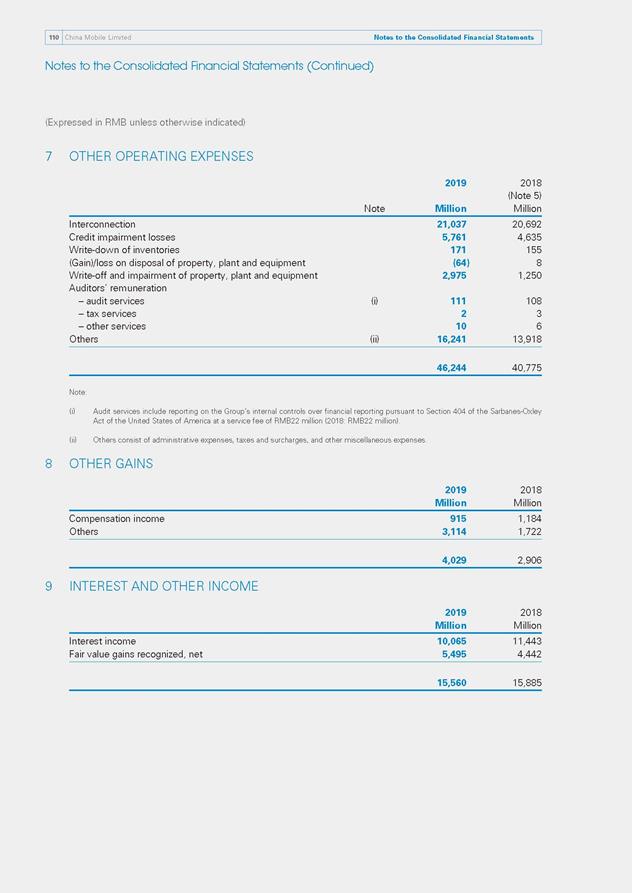
China Mobile Limited110 Notes to the Consolidated Financial Statements 110 Notes to the Consolidated Financial Statements Notes to the Consolidated Financial Statements (Continued) (Expressed in RMB unless otherwise indicated) OTHER OPERATING EXPENSES 2019 2018 (Note 5) Note Million Million Interconnection 21,037 20,692 Credit impairment losses 5,761 4,635 Write-down of inventories 171 155 (Gain)/loss on disposal of property, plant and equipment (64) 8 Write-off and impairment of property, plant and equipment 2,975 1,250 Auditors’ remuneration – audit services (i) 111 108 – tax services 2 3 – other services 10 6 Others (ii) 16,241 13,918 46,244 40,775 Note: (i) Audit services include reporting on the Group’s internal controls over financial reporting pursuant to Section 404 of the Sarbanes-Oxley Act of the United States of America at a service fee of RMB22 million (2018: RMB22 million). (ii) Others consist of administrative expenses, taxes and surcharges, and other miscellaneous expenses. OTHER GAINS 2019 2018 Million Million Compensation income 915 1,184 Others 3,114 1,722 4,029 2,906 INTEREST AND OTHER INCOME 2019 2018 Million Million Interest income 10,065 11,443 Fair value gains recognized, net 5,495 4,442 15,560 15,885
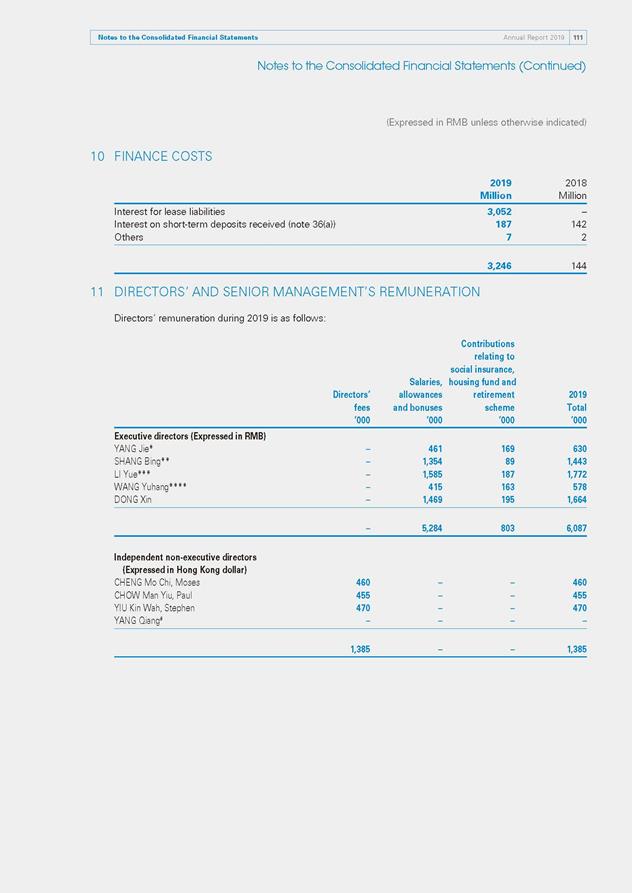
Notes to the Consolidated Financial Statements Annual Report 2019 111 Notes to the Consolidated Financial Statements (Continued) (Expressed in RMB unless otherwise indicated) 10 FINANCE COSTS 2019 2018 Million Million Interest for lease liabilities 3,052 – Interest on short-term deposits received (note 36(a)) 187 142 Others 7 2 3,246 144 11 DIRECTORS’ AND SENIOR MANAGEMENT’S REMUNERATION Directors’ remuneration during 2019 is as follows: Contributions relating to social insurance, Salaries, housing fund and Directors’ allowances retirement 2019 fees and bonuses scheme Total ’000 ’000 ’000 ’000 Executive directors (Expressed in RMB) YANG Jie* – 461 169 630 SHANG Bing** – 1,354 89 1,443 LI Yue*** – 1,585 187 1,772 WANG Yuhang**** – 415 163 578 DONG Xin – 1,469 195 1,664 – 5,284 803 6,087 Independent non-executive directors (Expressed in Hong Kong dollar) CHENG Mo Chi, Moses 460 – –460 CHOW Man Yiu, Paul 455 – –455 YIU Kin Wah, Stephen 470 – –470 YANG Qiang# –––– 1,385 – – 1,385
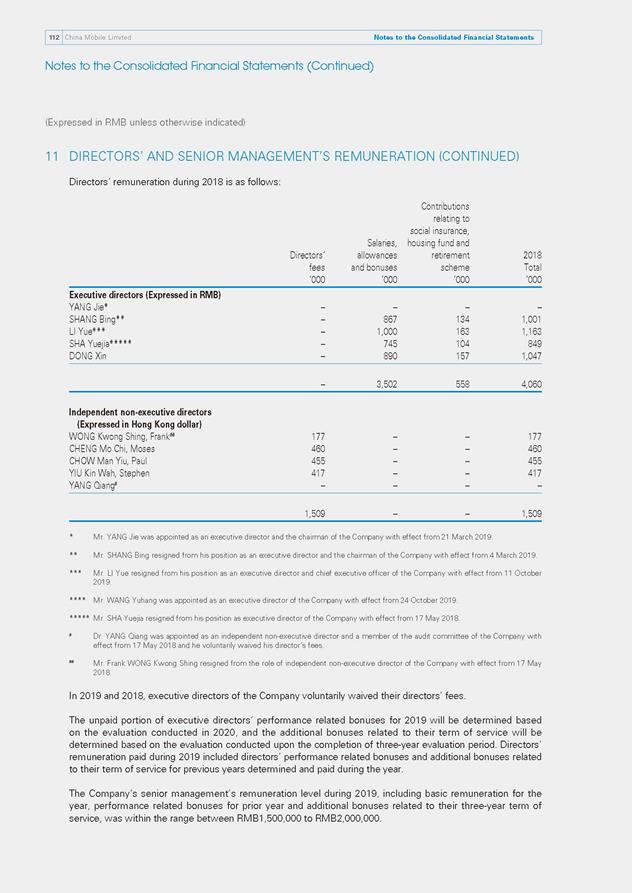
112 China Mobile Limited Notes to the Consolidated Financial Statements Notes to the Consolidated Financial Statements (Continued) (Expressed in RMB unless otherwise indicated) 11 DIRECTORS’ AND SENIOR MANAGEMENT’S REMUNERATION (CONTINUED) Directors’ remuneration during 2018 is as follows: Contributions relating to social insurance, Salaries, housing fund and Directors’ allowances retirement 2018 fees and bonuses scheme Total ’000 ’000 ’000 ’000 Executive directors (Expressed in RMB) YANG Jie* – – – – SHANG Bing** – 867 134 1,001 LI Yue*** – 1,000 163 1,163 SHA Yuejia***** – 745 104 849 DONG Xin – 890 157 1,047 – 3,502 558 4,060 Independent non-executive directors (Expressed in Hong Kong dollar) WONG Kwong Shing, Frank## 177 – – 177 CHENG Mo Chi, Moses 460 – – 460 CHOW Man Yiu, Paul 455 – – 455 YIU Kin Wah, Stephen 417 – – 417 YANG Qiang# – – – – 1,509 – – 1,509 * Mr. YANG Jie was appointed as an executive director and the chairman of the Company with effect from 21 March 2019. ** Mr. SHANG Bing resigned from his position as an executive director and the chairman of the Company with effect from 4 March 2019. *** Mr. LI Yue resigned from his position as an executive director and chief executive officer of the Company with effect from 11 October 2019. **** Mr. WANG Yuhang was appointed as an executive director of the Company with effect from 24 October 2019. ***** Mr. SHA Yuejia resigned from his position as executive director of the Company with effect from 17 May 2018. # Dr. YANG Qiang was appointed as an independent non-executive director and a member of the audit committee of the Company with effect from 17 May 2018 and he voluntarily waived his director’s fees. ## Mr. Frank WONG Kwong Shing resigned from the role of independent non-executive director of the Company with effect from 17 May 2018. In 2019 and 2018, executive directors of the Company voluntarily waived their directors’ fees. The unpaid portion of executive directors’ performance related bonuses for 2019 will be determined based on the evaluation conducted in 2020, and the additional bonuses related to their term of service will be determined based on the evaluation conducted upon the completion of three-year evaluation period. Directors’ remuneration paid during 2019 included directors’ performance related bonuses and additional bonuses related to their term of service for previous years determined and paid during the year. The Company’s senior management’s remuneration level during 2019, including basic remuneration for the year, performance related bonuses for prior year and additional bonuses related to their three-year term of service, was within the range between RMB1,500,000 to RMB2,000,000.
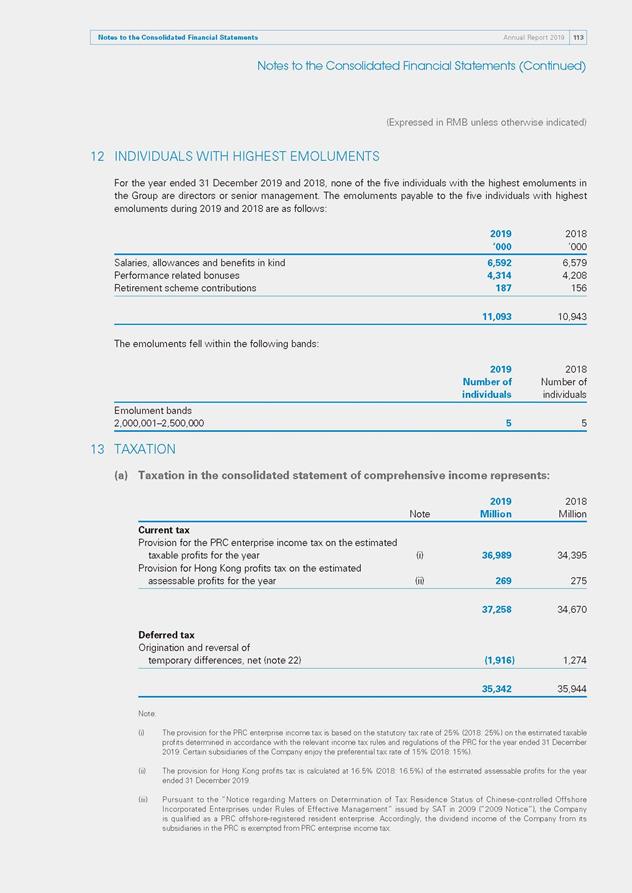
Annual Report 2019 113 Notes to the Consolidated Financial Statements 113 Notes to the Consolidated Financial Statements Notes to the Consolidated Financial Statements (Continued) (Expressed in RMB unless otherwise indicated) 12 INDIVIDUALS WITH HIGHEST EMOLUMENTS For the year ended 31 December 2019 and 2018, none of the five individuals with the highest emoluments in the Group are directors or senior management. The emoluments payable to the five individuals with highest emoluments during 2019 and 2018 are as follows: 2019 2018 ’000 ’000 Salaries, allowances and benefits in kind 6,592 6,579 Performance related bonuses 4,314 4,208 Retirement scheme contributions 187 156 11,093 10,943 The emoluments fell within the following bands: 2019 2018 Number of Number of individuals individuals Emolument bands 2,000,001–2,500,000 5 13 TAXATION (a) Taxation in the consolidated statement of comprehensive income represents: 2019 2018 Note Million Million Current tax Provision for the PRC enterprise income tax on the estimated taxable profits for the year (i) 36,989 34,395 Provision for Hong Kong profits tax on the estimated assessable profits for the year (ii) 269 275 37,258 34,670 Deferred tax Origination and reversal of temporary differences, net (note 22) (1,916) 1,274 35,342 35,944 Note: (i) The provision for the PRC enterprise income tax is based on the statutory tax rate of 25% (2018: 25%) on the estimated taxable profits determined in accordance with the relevant income tax rules and regulations of the PRC for the year ended 31 December 2019. Certain subsidiaries of the Company enjoy the preferential tax rate of 15% (2018: 15%). (ii) The provision for Hong Kong profits tax is calculated at 16.5% (2018: 16.5%) of the estimated assessable profits for the year ended 31 December 2019. (iii) Pursuant to the “Notice regarding Matters on Determination of Tax Residence Status of Chinese-controlled Offshore Incorporated Enterprises under Rules of Effective Management” issued by SAT in 2009 (“2009 Notice”), the Company is qualified as a PRC offshore-registered resident enterprise. Accordingly, the dividend income of the Company from its subsidiaries in the PRC is exempted from PRC enterprise income tax.
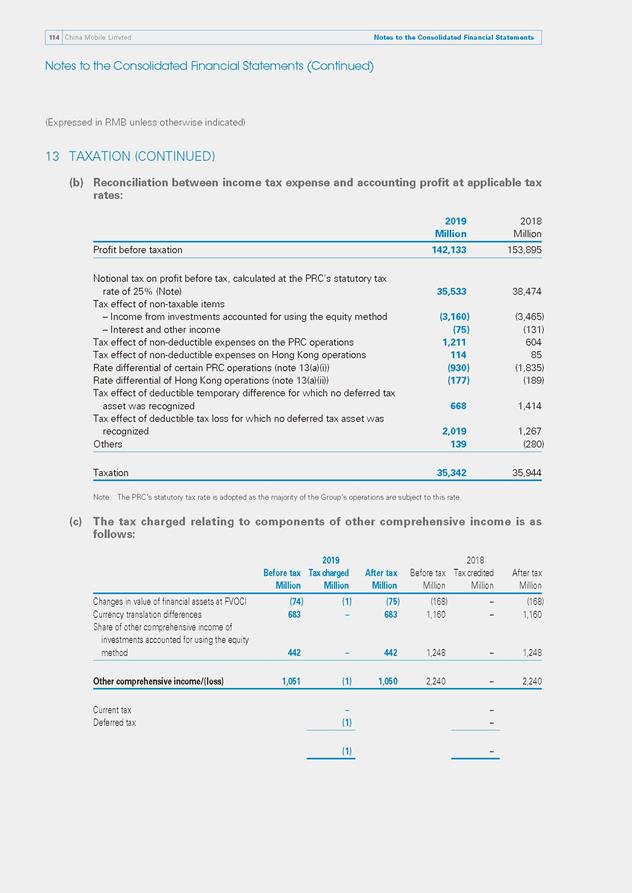
114 China Mobile Limited Notes to the Consolidated Financial Statements Notes to the Consolidated Financial Statements (Continued) (Expressed in RMB unless otherwise indicated) 13 TAXATION (CONTINUED) (b) Reconciliation between income tax expense and accounting profit at applicable tax rates: 2019 2018 Million Million Profit before taxation 142,133 153,895 Notional tax on profit before tax, calculated at the PRC’s statutory tax rate of 25% (Note) 35,533 38,474 Tax effect of non-taxable items – Income from investments accounted for using the equity method (3,160) (3,465) – Interest and other income (75) (131) Tax effect of non-deductible expenses on the PRC operations 1,211 604 Tax effect of non-deductible expenses on Hong Kong operations 114 85 Rate differential of certain PRC operations (note 13(a)(i)) (930) (1,835) Rate differential of Hong Kong operations (note 13(a)(ii)) (177) (189) Tax effect of deductible temporary difference for which no deferred tax asset was recognized 668 1,414 Tax effect of deductible tax loss for which no deferred tax asset was recognized 2,019 1,267 Others 139 (280) Taxation 35,342 35,944 Note: The PRC’s statutory tax rate is adopted as the majority of the Group’s operations are subject to this rate. (c) The tax charged relating to components of other comprehensive income is as follows: 2019 2018 Before tax Tax charged After tax Before tax Tax credited After tax Million Million Million Million Million Million Changes in value of financial assets at FVOCI (74) (1) (75) (168) – (168) Currency translation differences 683 – 683 1,160 – 1,160 Share of other comprehensive income of investments accounted for using the equity method 442 – 442 1,248 – 1,248 Other comprehensive income/(loss) 1,051 (1) 1,050 2,240 – 2,240 Current tax – – Deferred tax (1) – (1) –
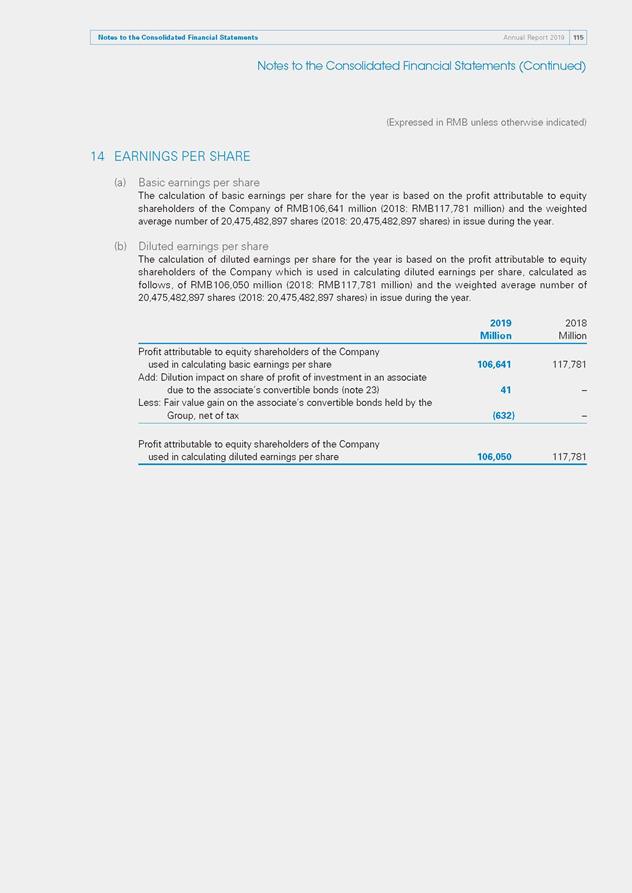
Notes to the Consolidated Financial Statements Annual Report 2019 115 Notes to the Consolidated Financial Statements (Continued) (Expressed in RMB unless otherwise indicated) 14 EARNINGS PER SHARE (a) Basic earnings per share The calculation of basic earnings per share for the year is based on the profit attributable to equity shareholders of the Company of RMB106,641 million (2018: RMB117,781 million) and the weighted average number of 20,475,482,897 shares (2018: 20,475,482,897 shares) in issue during the year. (b) Diluted earnings per share The calculation of diluted earnings per share for the year is based on the profit attributable to equity shareholders of the Company which is used in calculating diluted earnings per share, calculated as follows, of RMB106,050 million (2018: RMB117,781 million) and the weighted average number of 20,475,482,897 shares (2018: 20,475,482,897 shares) in issue during the year. 2019 2018 Million Million Profit attributable to equity shareholders of the Company used in calculating basic earnings per share 106,641 117,781 Add: Dilution impact on share of profit of investment in an associate due to the associate’s convertible bonds (note 23) 41 – Less: Fair value gain on the associate’s convertible bonds held by the Group, net of tax (632) – Profit attributable to equity shareholders of the Company used in calculating diluted earnings per share 106,050 117,781
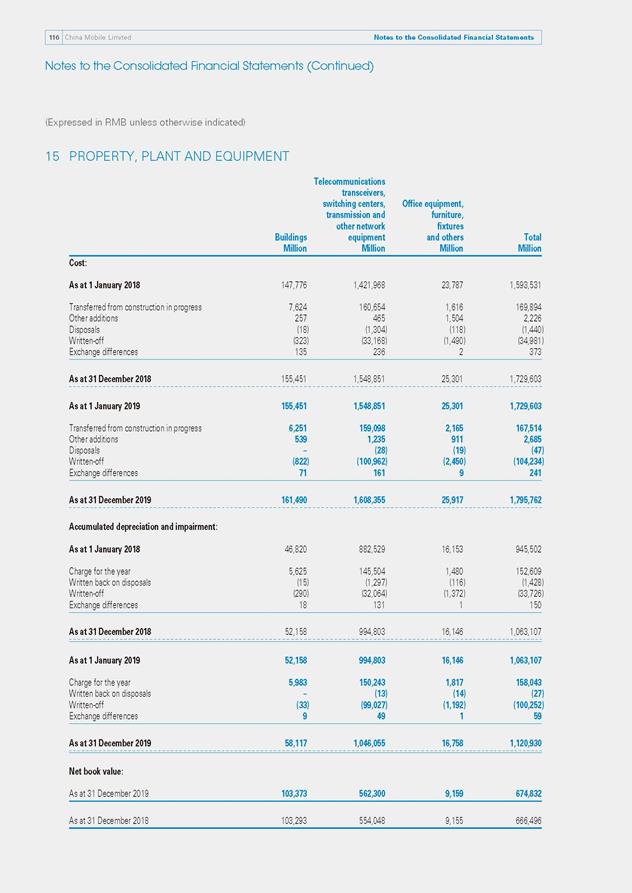
116 China Mobile Limited Notes to the Consolidated Financial Statements Notes to the Consolidated Financial Statements (Continued) (Expressed in RMB unless otherwise indicated) 15 PROPERTY, PLANT AND EQUIPMENT Buildings Million Telecommunications transceivers, switching centers, transmission and other network equipment Million Office equipment, furniture, fixtures and others Total Million Million Cost: As at 1 January 2018 147,776 1,421,968 23,787 1,593,531 Transferred from construction in progress 7,624 160,654 1,616 169,894 Other additions 257 465 1,504 2,226 Disposals (18) (1,304) (118) (1,440) Written-off (323) (33,168) (1,490) (34,981) Exchange differences 135 236 2 373 As at 31 December 2018 155,451 1,548,851 25,301 1,729,603 As at 1 January 2019 155,451 1,548,851 25,301 1,729,603 Transferred from construction in progress 6,251 159,098 2,165 167,514 Other additions 539 1,235 911 2,685 Disposals – (28) (19) (47) Written-off (822) (100,962) (2,450) (104,234) Exchange differences 71 161 9 241 As at 31 December 2019 161,490 1,608,355 25,917 1,795,762 Accumulated depreciation and impairment: As at 1 January 2018 46,820 882,529 16,153 945,502 Charge for the year 5,625 145,504 1,480 152,609 Written back on disposals (15) (1,297) (116) (1,428) Written-off (290) (32,064) (1,372) (33,726) Exchange differences 18 131 1 150 As at 31 December 2018 52,158 994,803 16,146 1,063,107 As at 1 January 2019 52,158 994,803 16,146 1,063,107 Charge for the year 5,983 150,243 1,817 158,043 Written back on disposals – (13) (14) (27) Written-off (33) (99,027) (1,192) (100,252) Exchange differences 9 49 1 59 As at 31 December 2019 58,117 1,046,055 16,758 1,120,930 Net book value: As at 31 December 2019 103,373 562,300 9,159 674,832 As at 31 December 2018 103,293 554,048 9,155 666,496
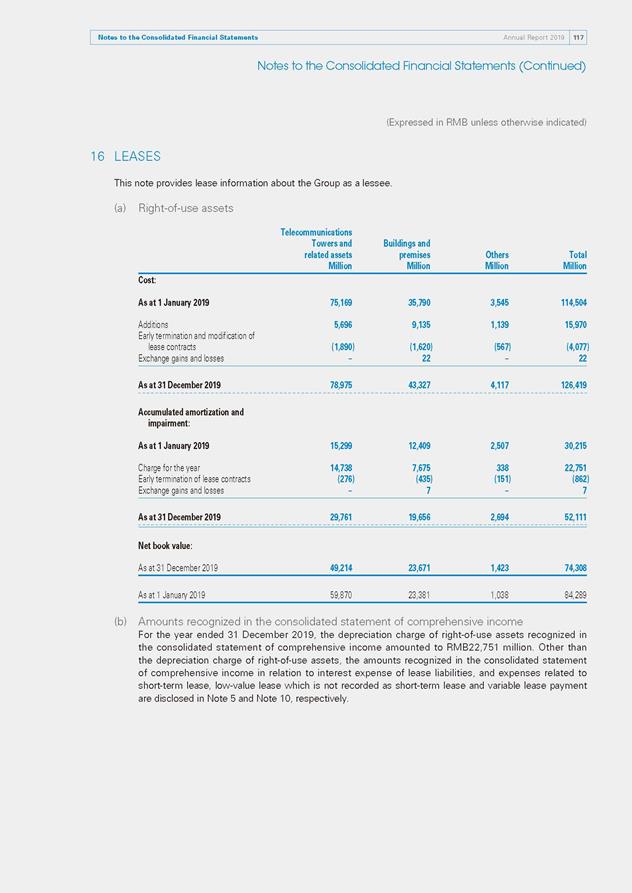
Notes to the Consolidated Financial Statements Annual Report 2019 117 Notes to the Consolidated Financial Statements (Continued) (Expressed in RMB unless otherwise indicated) 16 LEASES This note provides lease information about the Group as a lessee. (a) Right-of-use assets Telecommunications Towers and related assets Million Buildings and premises Million Others Million Total Million Cost: As at 1 January 2019 75,169 35,790 3,545 114,504 Additions 5,696 9,135 1,139 15,970 Early termination and modification of lease contracts (1,890) (1,620) (567) (4,077) Exchange gains and losses –22 –22 As at 31 December 2019 78,975 43,327 4,117 126,419 Accumulated amortization and impairment: As at 1 January 2019 15,299 12,409 2,507 30,215 Charge for the year 14,738 7,675 338 22,751 Early termination of lease contracts (276) (435) (151) (862) Exchange gains and losses –7–7 As at 31 December 2019 29,761 19,656 2,694 52,111 Net book value: As at 31 December 2019 49,214 23,671 1,423 74,308 As at 1 January 2019 59,870 23,381 1,038 84,289 (b) Amounts recognized in the consolidated statement of comprehensive income For the year ended 31 December 2019, the depreciation charge of right-of-use assets recognized in the consolidated statement of comprehensive income amounted to RMB22,751 million. Other than the depreciation charge of right-of-use assets, the amounts recognized in the consolidated statement of comprehensive income in relation to interest expense of lease liabilities, and expenses related to short-term lease, low-value lease which is not recorded as short-term lease and variable lease payment are disclosed in Note 5 and Note 10, respectively.
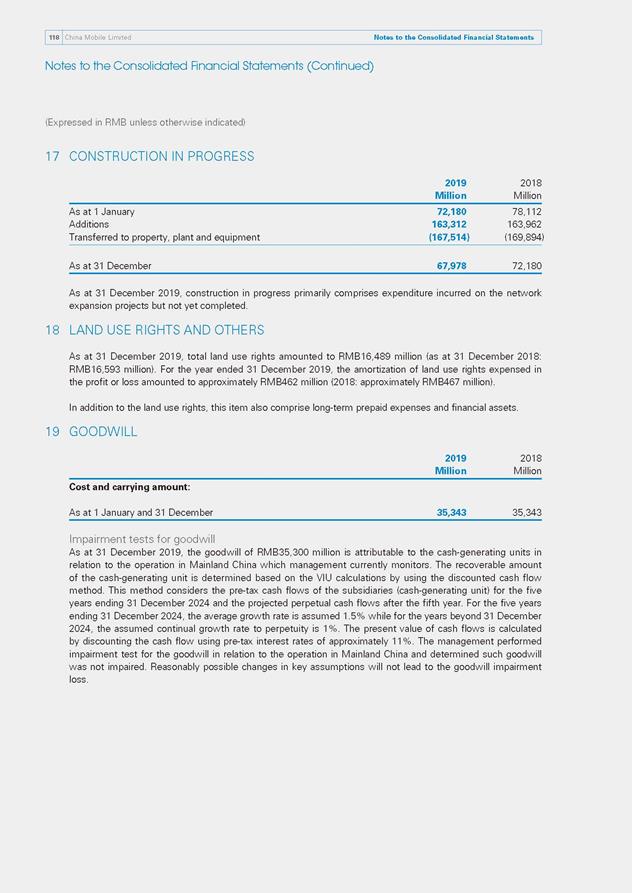
China Mobile Limited118 Notes to the Consolidated Financial Statements 118 Notes to the Consolidated Financial Statements Notes to the Consolidated Financial Statements (Continued) (Expressed in RMB unless otherwise indicated) 17 CONSTRUCTION IN PROGRESS 2019 2018 Million Million As at 1 January 72,180 78,112 Additions 163,312 163,962 Transferred to property, plant and equipment (167,514) (169,894) As at 31 December 67,978 72,180 As at 31 December 2019, construction in progress primarily comprises expenditure incurred on the network expansion projects but not yet completed. 18 LAND USE RIGHTS AND OTHERS As at 31 December 2019, total land use rights amounted to RMB16,489 million (as at 31 December 2018: RMB16,593 million). For the year ended 31 December 2019, the amortization of land use rights expensed in the profit or loss amounted to approximately RMB462 million (2018: approximately RMB467 million). In addition to the land use rights, this item also comprise long-term prepaid expenses and financial assets. 19 GOODWILL 2019 2018 Million Million Cost and carrying amount: As at 1 January and 31 December 35,343 35,343 Impairment tests for goodwill As at 31 December 2019, the goodwill of RMB35,300 million is attributable to the cash-generating units in relation to the operation in Mainland China which management currently monitors. The recoverable amount of the cash-generating unit is determined based on the VIU calculations by using the discounted cash flow method. This method considers the pre-tax cash flows of the subsidiaries (cash-generating unit) for the five years ending 31 December 2024 and the projected perpetual cash flows after the fifth year. For the five years ending 31 December 2024, the average growth rate is assumed 1.5% while for the years beyond 31 December 2024, the assumed continual growth rate to perpetuity is 1%. The present value of cash flows is calculated by discounting the cash flow using pre-tax interest rates of approximately 11%. The management performed impairment test for the goodwill in relation to the operation in Mainland China and determined such goodwill was not impaired. Reasonably possible changes in key assumptions will not lead to the goodwill impairment loss.
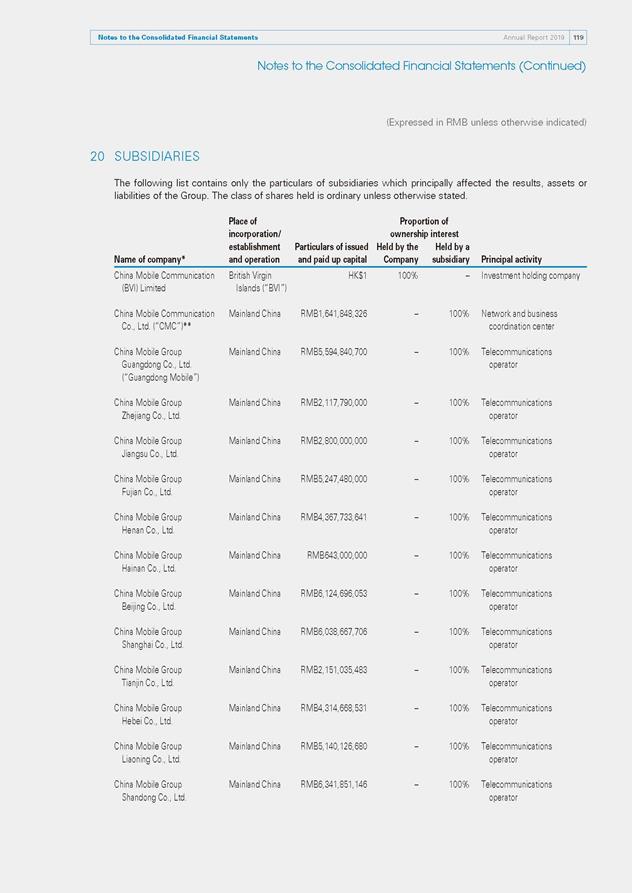
Notes to the Consolidated Financial Statements Annual Report 2019 119 Notes to the Consolidated Financial Statements (Continued) (Expressed in RMB unless otherwise indicated) 20 SUBSIDIARIES The following list contains only the particulars of subsidiaries which principally affected the results, assets or liabilities of the Group. The class of shares held is ordinary unless otherwise stated. Place of Proportion of incorporation/ ownership interest establishment Particulars of issued Held by the Held by a Name of company* and operation and paid up capital Company subsidiary Principal activity China Mobile Communication British Virgin HK$1 100% – Investment holding company (BVI) Limited Islands (“BVI”) China Mobile Communication Mainland China RMB1,641,848,326 – 100% Network and business Co., Ltd. (“CMC”)** coordination center China Mobile Group Mainland China RMB5,594,840,700 – 100% Telecommunications Guangdong Co., Ltd. operator (“Guangdong Mobile”) China Mobile Group Mainland China RMB2,117,790,000 – 100% Telecommunications Zhejiang Co., Ltd. operator China Mobile Group Mainland China RMB2,800,000,000 – 100% Telecommunications Jiangsu Co., Ltd. operator China Mobile Group Mainland China RMB5,247,480,000 – 100% Telecommunications Fujian Co., Ltd. operator China Mobile Group Mainland China RMB4,367,733,641 – 100% Telecommunications Henan Co., Ltd. operator China Mobile Group Mainland China RMB643,000,000 – 100% Telecommunications Hainan Co., Ltd. operator China Mobile Group Mainland China RMB6,124,696,053 – 100% Telecommunications Beijing Co., Ltd. operator China Mobile Group Mainland China RMB6,038,667,706 – 100% Telecommunications Shanghai Co., Ltd. operator China Mobile Group Mainland China RMB2,151,035,483 – 100% Telecommunications Tianjin Co., Ltd. operator China Mobile Group Mainland China RMB4,314,668,531 – 100% Telecommunications Hebei Co., Ltd. operator China Mobile Group Mainland China RMB5,140,126,680 – 100% Telecommunications Liaoning Co., Ltd. operator China Mobile Group Mainland China RMB6,341,851,146 – 100% Telecommunications Shandong Co., Ltd. operator
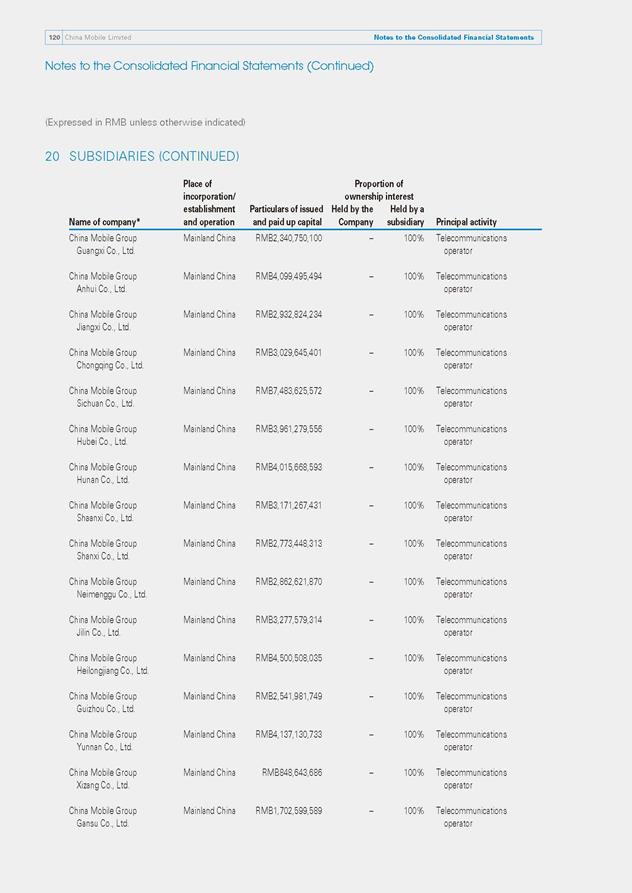
120 China Mobile Limited Notes to the Consolidated Financial Statements Notes to the Consolidated Financial Statements (Continued) (Expressed in RMB unless otherwise indicated) 20 SUBSIDIARIES (CONTINUED) Place of Proportion of incorporation/ ownership interest establishment Particulars of issued Held by the Held by a Name of company* and operation and paid up capital Company subsidiary Principal activity China Mobile Group Mainland China RMB2,340,750,100 – 100% Telecommunications Guangxi Co., Ltd. operator China Mobile Group Mainland China RMB4,099,495,494 – 100% Telecommunications Anhui Co., Ltd. operator China Mobile Group Mainland China RMB2,932,824,234 – 100% Telecommunications Jiangxi Co., Ltd. operator China Mobile Group Mainland China RMB3,029,645,401 – 100% Telecommunications Chongqing Co., Ltd. operator China Mobile Group Mainland China RMB7,483,625,572 – 100% Telecommunications Sichuan Co., Ltd. operator China Mobile Group Mainland China RMB3,961,279,556 – 100% Telecommunications Hubei Co., Ltd. operator China Mobile Group Mainland China RMB4,015,668,593 – 100% Telecommunications Hunan Co., Ltd. operator China Mobile Group Mainland China RMB3,171,267,431 – 100% Telecommunications Shaanxi Co., Ltd. operator China Mobile Group Mainland China RMB2,773,448,313 – 100% Telecommunications Shanxi Co., Ltd. operator China Mobile Group Mainland China RMB2,862,621,870 – 100% Telecommunications Neimenggu Co., Ltd. operator China Mobile Group Mainland China RMB3,277,579,314 – 100% Telecommunications Jilin Co., Ltd. operator China Mobile Group Mainland China RMB4,500,508,035 – 100% Telecommunications Heilongjiang Co., Ltd. operator China Mobile Group Mainland China RMB2,541,981,749 – 100% Telecommunications Guizhou Co., Ltd. operator China Mobile Group Mainland China RMB4,137,130,733 – 100% Telecommunications Yunnan Co., Ltd. operator China Mobile Group Mainland China RMB848,643,686 – 100% Telecommunications Xizang Co., Ltd. operator China Mobile Group Mainland China RMB1,702,599,589 – 100% Telecommunications Gansu Co., Ltd. operator
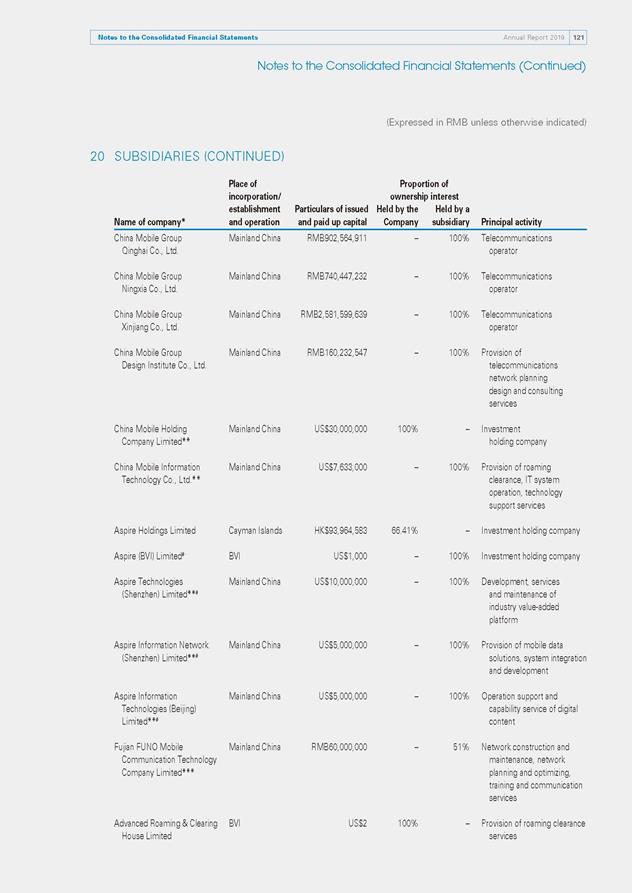
Notes to the Consolidated Financial Statements Annual Report 2019 121 Notes to the Consolidated Financial Statements (Continued) (Expressed in RMB unless otherwise indicated) 20 SUBSIDIARIES (CONTINUED) Name of company* Place of incorporation/ establishment and operation Particulars of issued and paid up capital Proportion of ownership interest Held by the Held by a Company subsidiary Principal activity China Mobile Group Mainland China RMB902,564,911 – 100% Telecommunications Qinghai Co., Ltd. operator China Mobile Group Mainland China RMB740,447,232 – 100% Telecommunications Ningxia Co., Ltd. operator China Mobile Group Mainland China RMB2,581,599,639 – 100% Telecommunications Xinjiang Co., Ltd. operator China Mobile Group Mainland China RMB160,232,547 – 100% Provision of Design Institute Co., Ltd. telecommunications network planning design and consulting services China Mobile Holding Mainland China US$30,000,000 100% – Investment Company Limited** holding company China Mobile Information Mainland China US$7,633,000 – 100% Provision of roaming Technology Co., Ltd.** clearance, IT system operation, technology support services Aspire Holdings Limited Cayman Islands HK$93,964,583 66.41% – Investment holding company Aspire (BVI) Limited# BVI US$1,000 – 100% Investment holding company Aspire Technologies Mainland China US$10,000,000 – 100% Development, services (Shenzhen) Limited**# and maintenance of industry value-added platform Aspire Information Network Mainland China US$5,000,000 – 100% Provision of mobile data (Shenzhen) Limited**# solutions, system integration and development Aspire Information Mainland China US$5,000,000 – 100% Operation support and Technologies (Beijing) capability service of digital Limited**# content Fujian FUNO Mobile Mainland China RMB60,000,000 – 51% Network construction and Communication Technology maintenance, network Company Limited*** planning and optimizing, training and communication services Advanced Roaming & Clearing BVI US$2 100% – Provision of roaming clearance House Limited services
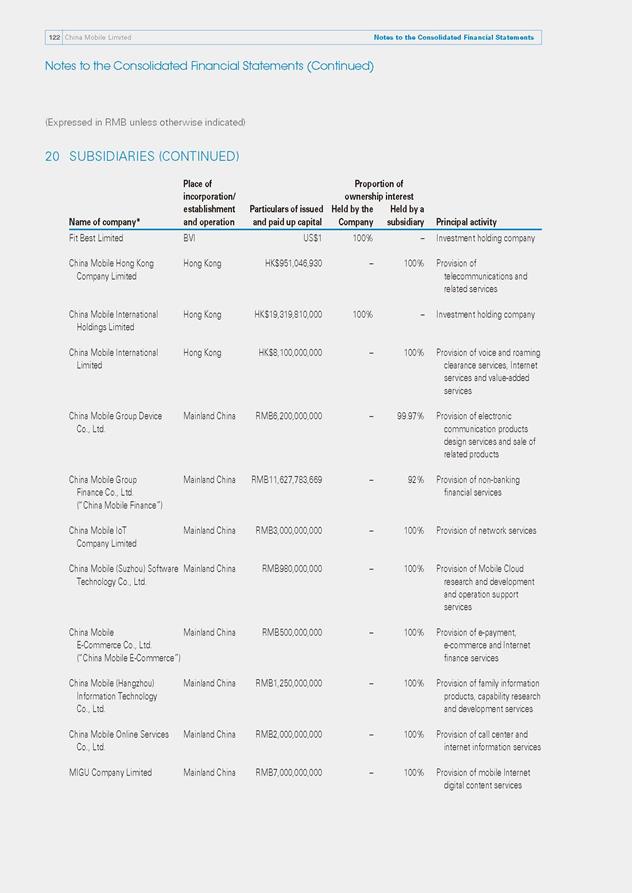
122 China Mobile Limited Notes to the Consolidated Financial Statements Notes to the Consolidated Financial Statements (Continued) (Expressed in RMB unless otherwise indicated) 20 SUBSIDIARIES (CONTINUED) Place of Proportion of incorporation/ ownership interest establishment Particulars of issued Held by the Held by a Name of company* and operation and paid up capital Company subsidiary Principal activity Fit Best Limited BVI US$1 100% – Investment holding company China Mobile Hong Kong Hong Kong HK$951,046,930 – 100% Provision of Company Limited telecommunications and related services China Mobile International Hong Kong HK$19,319,810,000 100% – Investment holding company Holdings Limited China Mobile International Hong Kong HK$8,100,000,000 – 100% Provision of voice and roaming Limited clearance services, Internet services and value-added services China Mobile Group Device Mainland China RMB6,200,000,000 – 99.97% Provision of electronic Co., Ltd. communication products design services and sale of related products China Mobile Group Mainland China RMB11,627,783,669 – 92% Provision of non-banking Finance Co., Ltd. financial services (“China Mobile Finance”) China Mobile IoT Mainland China RMB3,000,000,000 – 100% Provision of network services Company Limited China Mobile (Suzhou) Software Mainland China RMB980,000,000 – 100% Provision of Mobile Cloud Technology Co., Ltd. research and development and operation support services China Mobile Mainland China RMB500,000,000 – 100% Provision of e-payment, E-Commerce Co., Ltd. e-commerce and Internet (“China Mobile E-Commerce”) finance services China Mobile (Hangzhou) Mainland China RMB1,250,000,000 – 100% Provision of family information Information Technology products, capability research Co., Ltd. and development services China Mobile Online Services Mainland China RMB2,000,000,000 – 100% Provision of call center and Co., Ltd. internet information services MIGU Company Limited Mainland China RMB7,000,000,000 – 100% Provision of mobile Internet digital content services
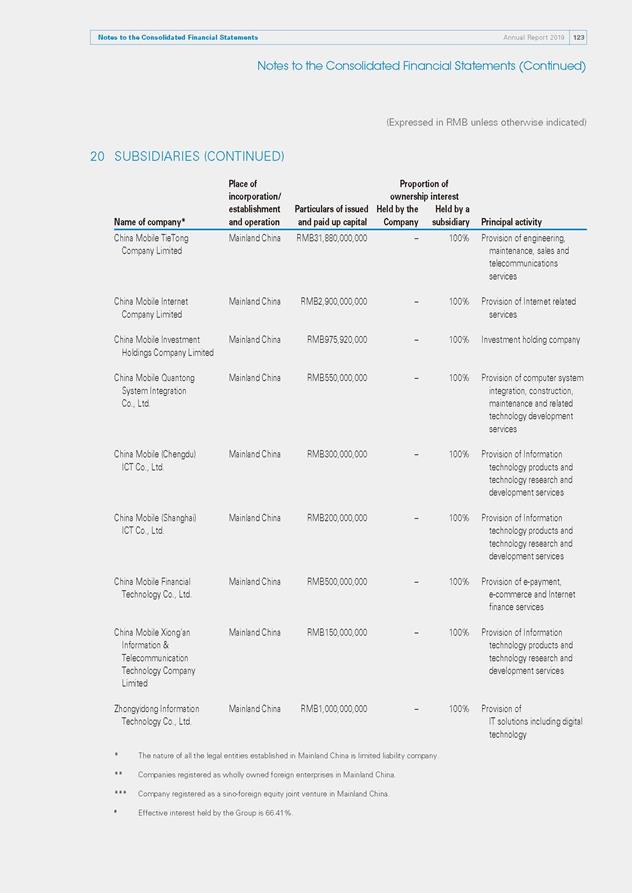
Notes to the Consolidated Financial Statements Annual Report 2019 123 Notes to the Consolidated Financial Statements (Continued) (Expressed in RMB unless otherwise indicated) 20 SUBSIDIARIES (CONTINUED) Name of company* Place of incorporation/ establishment and operation Particulars of issued and paid up capital Proportion of ownership interest Held by the Held by a Company subsidiary Principal activity China Mobile TieTong Mainland China RMB31,880,000,000 – 100% Provision of engineering, Company Limited maintenance, sales and telecommunications services China Mobile Internet Mainland China RMB2,900,000,000 – 100% Provision of Internet related Company Limited services China Mobile Investment Mainland China RMB975,920,000 – 100% Investment holding company Holdings Company Limited China Mobile Quantong Mainland China RMB550,000,000 – 100% Provision of computer system System Integration integration, construction, Co., Ltd. maintenance and related technology development services China Mobile (Chengdu) Mainland China RMB300,000,000 – 100% Provision of Information ICT Co., Ltd. technology products and technology research and development services China Mobile (Shanghai) Mainland China RMB200,000,000 – 100% Provision of Information ICT Co., Ltd. technology products and technology research and development services China Mobile Financial Mainland China RMB500,000,000 – 100% Provision of e-payment, Technology Co., Ltd. e-commerce and Internet finance services China Mobile Xiong’an Mainland China RMB150,000,000 – 100% Provision of Information Information & technology products and Telecommunication technology research and Technology Company development services Limited Zhongyidong Information Mainland China RMB1,000,000,000 – 100% Provision of Technology Co., Ltd. IT solutions including digital technology * The nature of all the legal entities established in Mainland China is limited liability company. ** Companies registered as wholly owned foreign enterprises in Mainland China. *** Company registered as a sino-foreign equity joint venture in Mainland China. # Effective interest held by the Group is 66.41%.
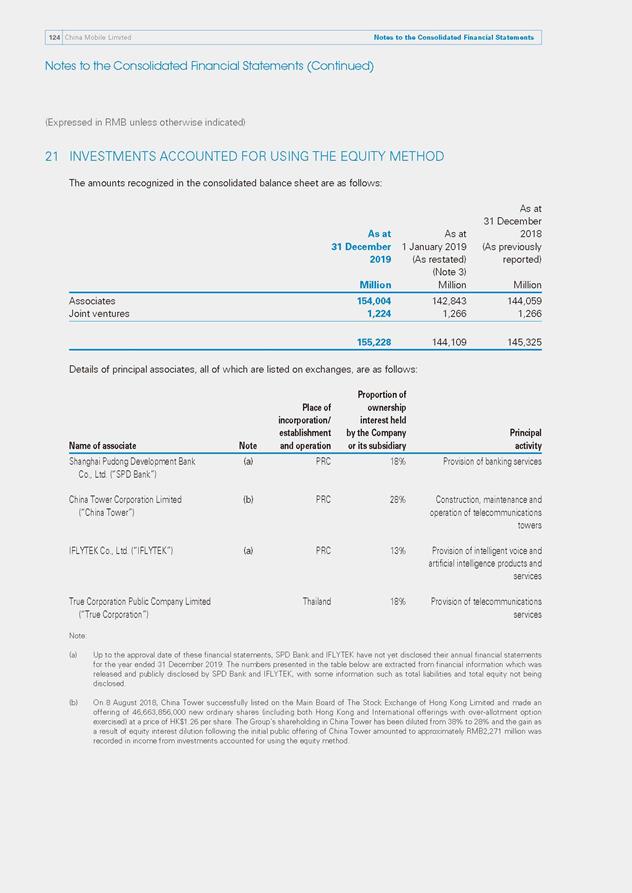
China Mobile Limited124 Notes to the Consolidated Financial Statements 124 Notes to the Consolidated Financial Statements Notes to the Consolidated Financial Statements (Continued) (Expressed in RMB unless otherwise indicated) 21 INVESTMENTS ACCOUNTED FOR USING THE EQUITY METHOD The amounts recognized in the consolidated balance sheet are as follows: As at 31 December 2019 Million As at 1 January 2019 (As restated) (Note 3) Million As at 31 December 2018 (As previously reported) Million Associates Joint ventures 154,004 1,224 142,843 1,266 144,059 1,266 155,228 144,109 145,325 Details of principal associates, all of which are listed on exchanges, are as follows: Proportion of Place of ownership incorporation/ interest held establishment by the Company Name of associate Note and operation or its subsidiary Principal activity Shanghai Pudong Development Bank (a) PRC 18% Provision of banking services Co., Ltd. (“SPD Bank”) China Tower Corporation Limited (b) PRC 28% Construction, maintenance and (“China Tower”) operation of telecommunications towers IFLYTEK Co., Ltd. (“IFLYTEK”) (a) PRC 13% Provision of intelligent voice and artificial intelligence products and services True Corporation Public Company Limited Thailand 18% Provision of telecommunications (“True Corporation”) services Note: (a) Up to the approval date of these financial statements, SPD Bank and IFLYTEK have not yet disclosed their annual financial statements for the year ended 31 December 2019. The numbers presented in the table below are extracted from financial information which was released and publicly disclosed by SPD Bank and IFLYTEK, with some information such as total liabilities and total equity not being disclosed. (b) On 8 August 2018, China Tower successfully listed on the Main Board of The Stock Exchange of Hong Kong Limited and made an offering of 46,663,856,000 new ordinary shares (including both Hong Kong and International offerings with over-allotment option exercised) at a price of HK$1.26 per share. The Group’s shareholding in China Tower has been diluted from 38% to 28% and the gain as a result of equity interest dilution following the initial public offering of China Tower amounted to approximately RMB2,271 million was recorded in income from investments accounted for using the equity method.
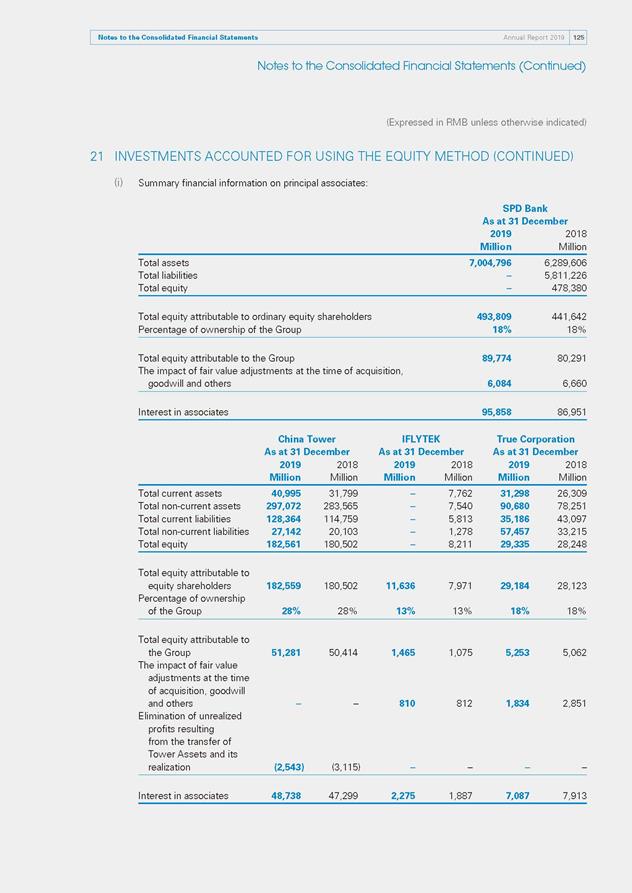
Notes to the Consolidated Financial Statements Annual Report 2019 125 Notes to the Consolidated Financial Statements (Continued) (Expressed in RMB unless otherwise indicated) 21 INVESTMENTS ACCOUNTED FOR USING THE EQUITY METHOD (CONTINUED) (i) Summary financial information on principal associates: SPD Bank As at 31 December 2019 2018 Million Million Total assets 7,004,796 6,289,606 Total liabilities – 5,811,226 Total equity – 478,380 Total equity attributable to ordinary equity shareholders 493,809 441,642 Percentage of ownership of the Group 18% 18% Total equity attributable to the Group 89,774 80,291 The impact of fair value adjustments at the time of acquisition, goodwill and others 6,084 6,660 Interest in associates 95,858 86,951 China Tower IFLYTEK True Corporation As at 31 December As at 31 December As at 31 December 2019 2018 2019 2018 2019 2018 Million Million Million Million Million Million Total current assets 40,995 31,799 – 7,762 31,298 26,309 Total non-current assets 297,072 283,565 – 7,540 90,680 78,251 Total current liabilities 128,364 114,759 – 5,813 35,186 43,097 Total non-current liabilities 27,142 20,103 – 1,278 57,457 33,215 Total equity 182,561 180,502 – 8,211 29,335 28,248 Total equity attributable to equity shareholders 182,559 180,502 11,636 7,971 29,184 28,123 Percentage of ownership of the Group 28% 28% 13% 13% 18% 18% Total equity attributable to the Group 51,281 50,414 1,465 1,075 5,253 5,062 The impact of fair value adjustments at the time of acquisition, goodwill and others – – 810 812 1,834 2,851 Elimination of unrealized profits resulting from the transfer of Tower Assets and its realization (2,543) (3,115) – – – – Interest in associates 48,738 47,299 2,275 1,887 7,087 7,913
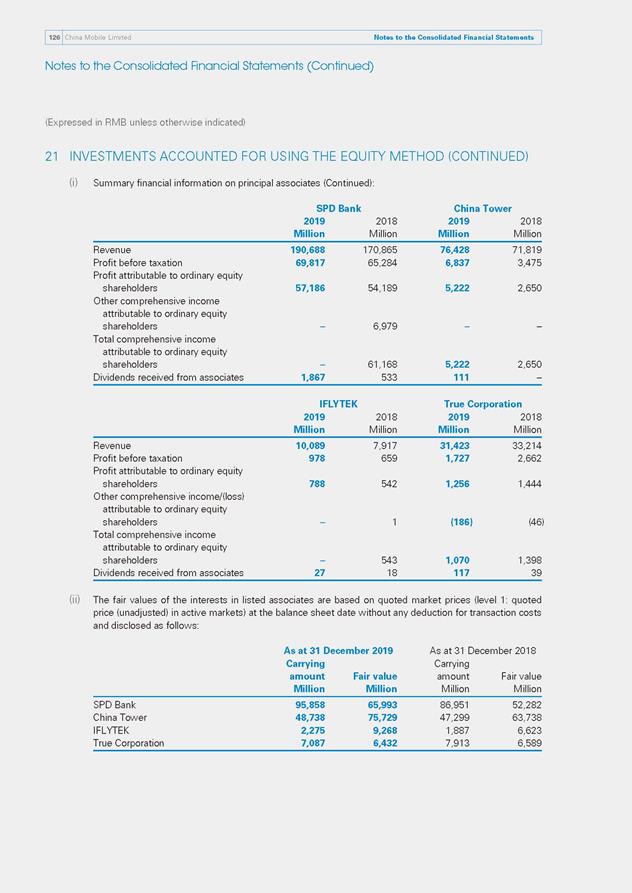
126 China Mobile Limited Notes to the Consolidated Financial Statements Notes to the Consolidated Financial Statements (Continued) (Expressed in RMB unless otherwise indicated) 21 INVESTMENTS ACCOUNTED FOR USING THE EQUITY METHOD (CONTINUED) (i) Summary financial information on principal associates (Continued): SPD Bank 2019 Million 2018 Million China Tower 2019 Million 2018 Million Revenue 190,688 170,865 76,428 71,819 Profit before taxation 69,817 65,284 6,837 3,475 Profit attributable to ordinary equity shareholders 57,186 54,189 5,222 2,650 Other comprehensive income attributable to ordinary equity shareholders – 6,979 – – Total comprehensive income attributable to ordinary equity shareholders – 61,168 5,222 2,650 Dividends received from associates 1,867 533 111 – IFLYTEK True Corporation 2019 2018 2019 2018 Million Million Million Million Revenue 10,089 7,917 31,423 33,214 Profit before taxation 978 659 1,727 2,662 Profit attributable to ordinary equity shareholders 788 542 1,256 1,444 Other comprehensive income/(loss) attributable to ordinary equity shareholders – 1 (186) (46) Total comprehensive income attributable to ordinary equity shareholders – 543 1,070 1,398 Dividends received from associates 27 18 117 39 (ii) The fair values of the interests in listed associates are based on quoted market prices (level 1: quoted price (unadjusted) in active markets) at the balance sheet date without any deduction for transaction costs and disclosed as follows: As at 31 December 2019 As at 31 December 2018 Carrying Carrying amount Fair value amount Fair value Million Million Million Million SPD Bank 95,858 65,993 86,951 52,282 China Tower 48,738 75,729 47,299 63,738 IFLYTEK 2,275 9,268 1,887 6,623 True Corporation 7,087 6,432 7,913 6,589
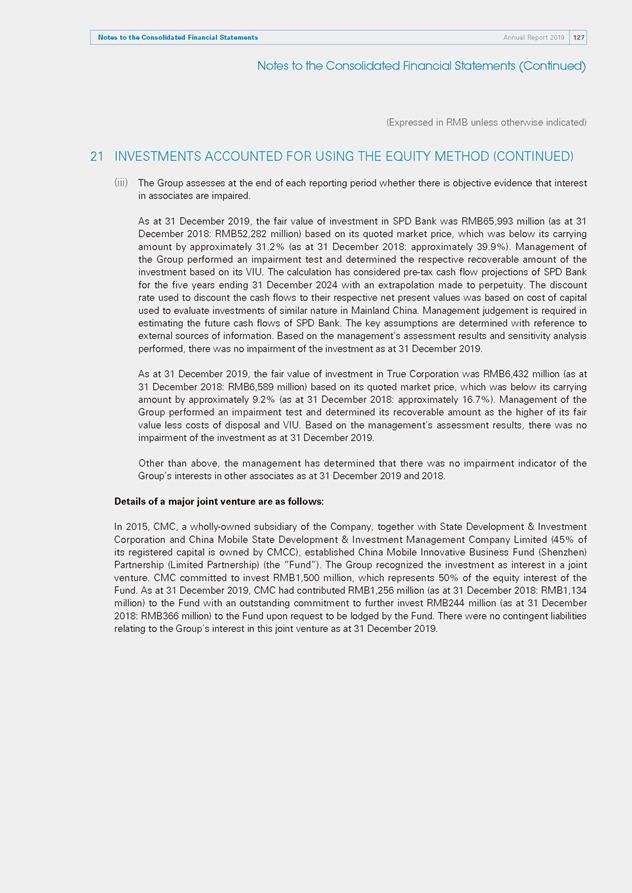
Annual Report 2019 127Notes to the Consolidated Financial Statements 127Notes to the Consolidated Financial Statements Notes to the Consolidated Financial Statements (Continued) (Expressed in RMB unless otherwise indicated) 21 INVESTMENTS ACCOUNTED FOR USING THE EQUITY METHOD (CONTINUED) (iii) The Group assesses at the end of each reporting period whether there is objective evidence that interest in associates are impaired. As at 31 December 2019, the fair value of investment in SPD Bank was RMB65,993 million (as at 31 December 2018: RMB52,282 million) based on its quoted market price, which was below its carrying amount by approximately 31.2% (as at 31 December 2018: approximately 39.9%). Management of the Group performed an impairment test and determined the respective recoverable amount of the investment based on its VIU. The calculation has considered pre-tax cash flow projections of SPD Bank for the five years ending 31 December 2024 with an extrapolation made to perpetuity. The discount rate used to discount the cash flows to their respective net present values was based on cost of capital used to evaluate investments of similar nature in Mainland China. Management judgement is required in estimating the future cash flows of SPD Bank. The key assumptions are determined with reference to external sources of information. Based on the management’s assessment results and sensitivity analysis performed, there was no impairment of the investment as at 31 December 2019. As at 31 December 2019, the fair value of investment in True Corporation was RMB6,432 million (as at 31 December 2018: RMB6,589 million) based on its quoted market price, which was below its carrying amount by approximately 9.2% (as at 31 December 2018: approximately 16.7%). Management of the Group performed an impairment test and determined its recoverable amount as the higher of its fair value less costs of disposal and VIU. Based on the management’s assessment results, there was no impairment of the investment as at 31 December 2019. Other than above, the management has determined that there was no impairment indicator of the Group’s interests in other associates as at 31 December 2019 and 2018. Details of a major joint venture are as follows: In 2015, CMC, a wholly-owned subsidiary of the Company, together with State Development & Investment Corporation and China Mobile State Development & Investment Management Company Limited (45% of its registered capital is owned by CMCC), established China Mobile Innovative Business Fund (Shenzhen) Partnership (Limited Partnership) (the “Fund”). The Group recognized the investment as interest in a joint venture. CMC committed to invest RMB1,500 million, which represents 50% of the equity interest of the Fund. As at 31 December 2019, CMC had contributed RMB1,256 million (as at 31 December 2018: RMB1,134 million) to the Fund with an outstanding commitment to further invest RMB244 million (as at 31 December 2018: RMB366 million) to the Fund upon request to be lodged by the Fund. There were no contingent liabilities relating to the Group’s interest in this joint venture as at 31 December 2019.
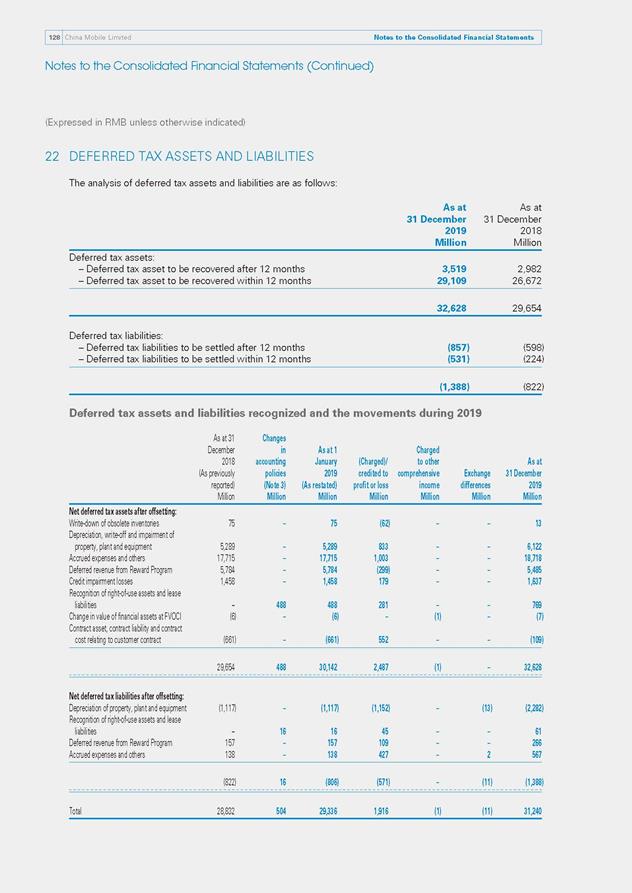
128 China Mobile Limited Notes to the Consolidated Financial Statements Notes to the Consolidated Financial Statements (Continued) (Expressed in RMB unless otherwise indicated) 22 DEFERRED TAX ASSETS AND LIABILITIES The analysis of deferred tax assets and liabilities are as follows: As at As at 31 December 31 December 2019 2018 Million Million Deferred tax assets: – Deferred tax asset to be recovered after 12 months 3,519 2,982 – Deferred tax asset to be recovered within 12 months 29,109 26,672 32,628 29,654 Deferred tax liabilities: – Deferred tax liabilities to be settled after 12 months (857) (598) – Deferred tax liabilities to be settled within 12 months (531) (224) (1,388) (822) Deferred tax assets and liabilities recognized and the movements during 2019 As at 31 Changes December in As at 1 Charged 2018 accounting January (Charged)/ to other As at (As previously policies 2019 credited to comprehensive Exchange 31 December reported) (Note 3) (As restated) profit or loss income differences 2019 Million Million Million Million Million Million Million Net deferred tax assets after offsetting: Write-down of obsolete inventories 75 – 75 (62) – – 13 Depreciation, write-off and impairment of property, plant and equipment 5,289 – 5,289 833 – – 6,122 Accrued expenses and others 17,715 – 17,715 1,003 – – 18,718 Deferred revenue from Reward Program 5,784 – 5,784 (299) – – 5,485 Credit impairment losses 1,458 – 1,458 179 – – 1,637 Recognition of right-of-use assets and lease liabilities – 488488281 – –769 Change in value of financial assets at FVOCI (6) – (6) – (1) – (7) Contract asset, contract liability and contract cost relating to customer contract (661) – (661) 552 – – (109) 29,654 488 30,142 2,487 (1) – 32,628 Net deferred tax liabilities after offsetting: Depreciation of property, plant and equipment (1,117) – (1,117) (1,152) – (13) (2,282) Recognition of right-of-use assets and lease liabilities – 161645 – –61 Deferred revenue from Reward Program 157 – 157 109 – – 266 Accrued expenses and others 138 – 138 427 – 2 567 (822) 16 (806) (571) – (11) (1,388) Total 28,832 504 29,336 1,916 (1) (11) 31,240
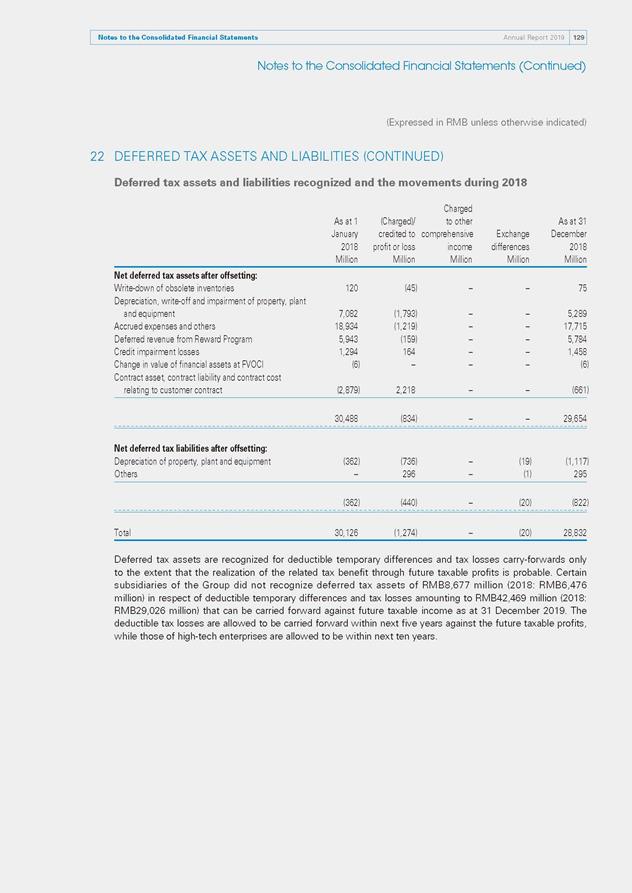
Notes to the Consolidated Financial Statements Annual Report 2019 129 Notes to the Consolidated Financial Statements (Continued) (Expressed in RMB unless otherwise indicated) 22 DEFERRED TAX ASSETS AND LIABILITIES (CONTINUED) Deferred tax assets and liabilities recognized and the movements during 2018 Charged As at 1 (Charged)/ to other As at 31 January credited to comprehensive Exchange December 2018 profit or loss income differences 2018 Million Million Million Million Million Net deferred tax assets after offsetting: Write-down of obsolete inventories 120 (45) – – 75 Depreciation, write-off and impairment of property, plant and equipment 7,082 (1,793) – – 5,289 Accrued expenses and others 18,934 (1,219) – – 17,715 Deferred revenue from Reward Program 5,943 (159) – – 5,784 Credit impairment losses 1,294 164 – – 1,458 Change in value of financial assets at FVOCI (6) – – – (6) Contract asset, contract liability and contract cost relating to customer contract (2,879) 2,218 – – (661) 30,488 (834) – – 29,654 Net deferred tax liabilities after offsetting: Depreciation of property, plant and equipment (362) (736) – (19) (1,117) Others – 296 – (1) 295 (362) (440) – (20) (822) Total 30,126 (1,274) – (20) 28,832 Deferred tax assets are recognized for deductible temporary differences and tax losses carry-forwards only to the extent that the realization of the related tax benefit through future taxable profits is probable. Certain subsidiaries of the Group did not recognize deferred tax assets of RMB8,677 million (2018: RMB6,476 million) in respect of deductible temporary differences and tax losses amounting to RMB42,469 million (2018: RMB29,026 million) that can be carried forward against future taxable income as at 31 December 2019. The deductible tax losses are allowed to be carried forward within next five years against the future taxable profits, while those of high-tech enterprises are allowed to be within next ten years.
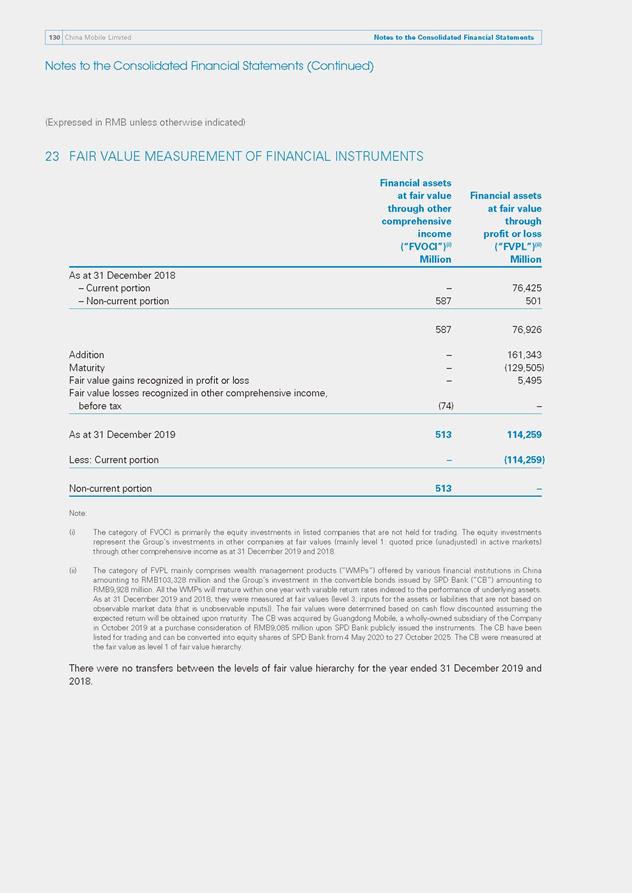
130 China Mobile Limited Notes to the Consolidated Financial Statements Notes to the Consolidated Financial Statements (Continued) (Expressed in RMB unless otherwise indicated) 23 FAIR VALUE MEASUREMENT OF FINANCIAL INSTRUMENTS Financial assets at fair value Financial assets through other at fair value comprehensive through income profit or loss (“FVOCI”)(i) (“FVPL”)(ii) Million Million As at 31 December 2018 – Current portion – 76,425 – Non-current portion 587 501 587 76,926 Addition – 161,343 Maturity – (129,505) Fair value gains recognized in profit or loss – 5,495 Fair value losses recognized in other comprehensive income, before tax (74) – As at 31 December 2019 513 114,259 Less: Current portion – (114,259) Non-current portion 513 – Note: (i) The category of FVOCI is primarily the equity investments in listed companies that are not held for trading. The equity investments represent the Group’s investments in other companies at fair values (mainly level 1: quoted price (unadjusted) in active markets) through other comprehensive income as at 31 December 2019 and 2018. (ii) The category of FVPL mainly comprises wealth management products (“WMPs”) offered by various financial institutions in China amounting to RMB103,328 million and the Group’s investment in the convertible bonds issued by SPD Bank (“CB”) amounting to RMB9,928 million. All the WMPs will mature within one year with variable return rates indexed to the performance of underlying assets. As at 31 December 2019 and 2018, they were measured at fair values (level 3: inputs for the assets or liabilities that are not based on observable market data (that is unobservable inputs)). The fair values were determined based on cash flow discounted assuming the expected return will be obtained upon maturity. The CB was acquired by Guangdong Mobile, a wholly-owned subsidiary of the Company in October 2019 at a purchase consideration of RMB9,085 million upon SPD Bank publicly issued the instruments. The CB have been listed for trading and can be converted into equity shares of SPD Bank from 4 May 2020 to 27 October 2025. The CB were measured at the fair value as level 1 of fair value hierarchy. There were no transfers between the levels of fair value hierarchy for the year ended 31 December 2019 and 2018.
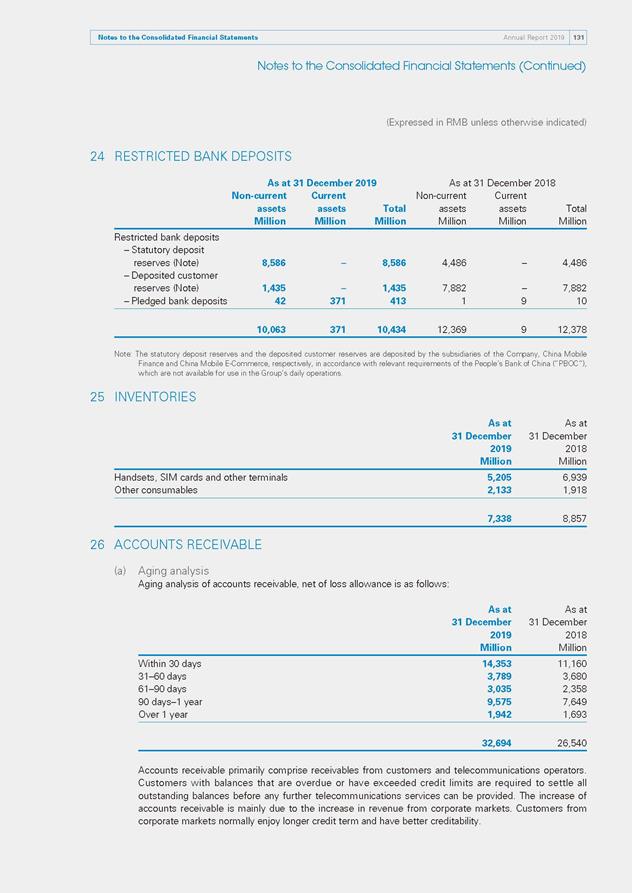
Notes to the Consolidated Financial Statements Annual Report 2019 131 Notes to the Consolidated Financial Statements (Continued) (Expressed in RMB unless otherwise indicated) 24 RESTRICTED BANK DEPOSITS As at 31 December 2019 As at 31 December 2018 Non-current assets Million Current assets Million Total Million Non-current assets Million Current assets Million Total Million Restricted bank deposits – Statutory deposit reserves (Note) 8,586 – Deposited customer reserves (Note) 1,435 – Pledged bank deposits 42 – – 371 8,586 1,435 413 4,486 7,882 1 – – 9 4,486 7,882 10 10,063 371 10,434 12,369 9 12,378 Note: The statutory deposit reserves and the deposited customer reserves are deposited by the subsidiaries of the Company, China Mobile Finance and China Mobile E-Commerce, respectively, in accordance with relevant requirements of the People’s Bank of China (“PBOC”), which are not available for use in the Group’s daily operations. 25 INVENTORIES As at As at 31 December 31 December 2019 2018 Million Million Handsets, SIM cards and other terminals Other consumables 26 ACCOUNTS RECEIVABLE (a) Aging analysis Aging analysis of accounts receivable, net of loss allowance iWithin 30 days 31–60 days 61–90 days 90 days–1 year Over 1 year 5,205 6,939 2,133 1,918 7,338 8,857 s as follows: As at As at 31 December 31 December 2019 2018 Million Million 14,353 11,160 3,789 3,680 3,035 2,358 9,575 7,649 1,942 1,693 32,694 26,540 Accounts receivable primarily comprise receivables from customers and telecommunications operators. Customers with balances that are overdue or have exceeded credit limits are required to settle all outstanding balances before any further telecommunications services can be provided. The increase of accounts receivable is mainly due to the increase in revenue from corporate markets. Customers from corporate markets normally enjoy longer credit term and have better creditability.

China Mobile Limited132 Notes to the Consolidated Financial Statements 132 Notes to the Consolidated Financial Statements Notes to the Consolidated Financial Statements (Continued) (Expressed in RMB unless otherwise indicated) 26 ACCOUNTS RECEIVABLE (CONTINUED) (b) Impairment loss allowance of accounts receivable The following table summarizes the changes in impairment loss allowance of accounts receivable: 2019 2018 Million Million As at 1 January 7,269 5,863 Credit loss recognized 5,833 4,480 Accounts receivable written off (3,545) (3,074) As at 31 December 9,557 7,269 27 OTHER RECEIVABLES, PREPAYMENTS AND OTHER CURRENT ASSETS Other receivables, which are measured at amortized cost, are expected to be recovered within one year. They primarily include interest receivable from banks, utilities deposits, rental deposits, short-term loans and short- term debt investments; Among which, short-term loans granted to China Tower through China Mobile Finance was RMB7,450 million (as at 31 December 2018: RMB11,000 million), and other short-term loans granted to banks and other financial institutions as well as short-term debt investments purchased through China Mobile Finance was RMB11,464 million (as at 31 December 2018: RMB13,260 million). The interest rates of short- term loans are mutually agreed among the parties with reference to the market interest rates. Prepayments and other current assets primarily consist of maintenance prepayments, power and utilities prepayments and input value-added tax to be deducted. As at 31 December 2019 and 2018, there were no significant overdue amounts for other receivables. 28 AMOUNTS DUE FROM/TO ULTIMATE HOLDING COMPANY Amount due from ultimate holding company is unsecured, interest free, repayable on demand and arising in the ordinary course of business. As at 31 December 2019, amount due to ultimate holding company comprises the short-term deposits of CMCC and its subsidiaries excluding the Group (“CMCC Group”) in China Mobile Finance amounting to RMB21,637 million (as at 31 December 2018: RMB10,873 million) and the corresponding interest payable arising from the deposits. The deposits are unsecured and carry interest at prevailing market rate. 29 BANK DEPOSITS Bank deposits represent term deposits with banks with original maturity exceeding three months. The applicable interest rate is determined in accordance with the benchmark interest rate published by PBOC or with reference to the market interest rate.
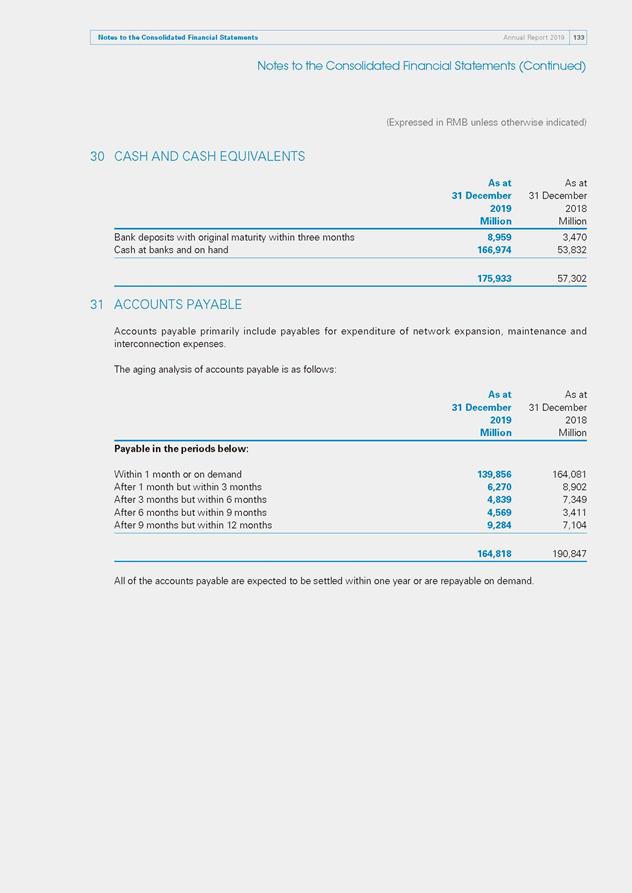
Annual Report 2019 133Notes to the Consolidated Financial Statements 133Notes to the Consolidated Financial Statements Notes to the Consolidated Financial Statements (Continued) (Expressed in RMB unless otherwise indicated) 30 CASH AND CASH EQUIVALENTS As at As at 31 December 31 December 2019 2018 Million Million Bank deposits with original maturity within three months 8,959 3,470 Cash at banks and on hand 166,974 53,832 175,933 57,302 31 ACCOUNTS PAYABLE Accounts payable primarily include payables for expenditure of network expansion, maintenance and interconnection expenses. The aging analysis of accounts payable is as follows: As at 31 December 2019 Million As at 31 December 2018 Million Payable in the periods below: Within 1 month or on demand 139,856 164,081 After 1 month but within 3 months 6,270 8,902 After 3 months but within 6 months 4,839 7,349 After 6 months but within 9 months 4,569 3,411 After 9 months but within 12 months 9,284 7,104 164,818 190,847 All of the accounts payable are expected to be settled within one year or are repayable on demand.
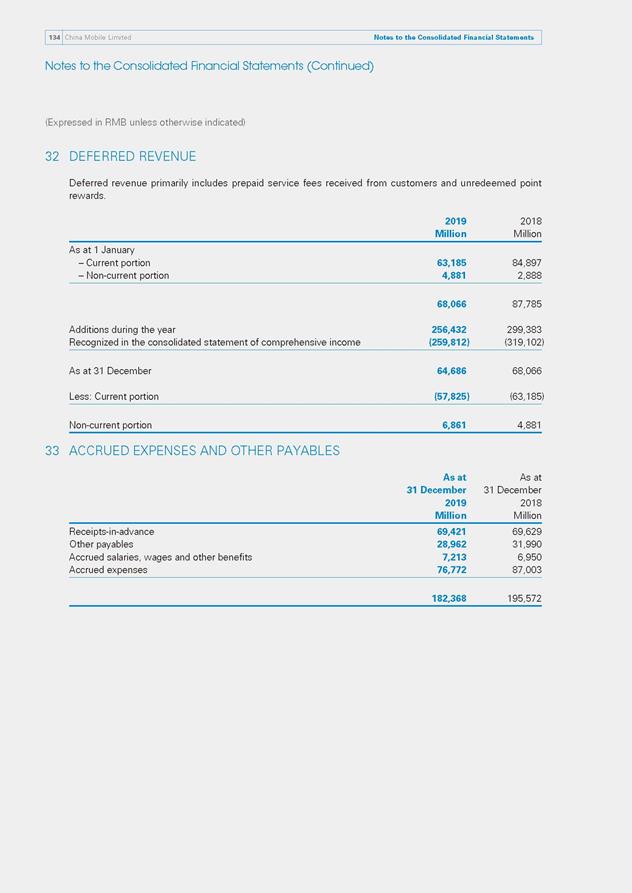
China Mobile Limited134 Notes to the Consolidated Financial Statements 134 Notes to the Consolidated Financial Statements Notes to the Consolidated Financial Statements (Continued) (Expressed in RMB unless otherwise indicated) 32 DEFERRED REVENUE Deferred revenue primarily includes prepaid service fees received from customers and unredeemed point rewards. 2019 2018 Million Million As at 1 January – Current portion – Non-current portion 63,185 4,881 84,897 2,888 68,066 87,785 Additions during the year Recognized in the consolidated statement of comprehensive income 256,432 (259,812) 299,383 (319,102) As at 31 December 64,686 68,066 Less: Current portion (57,825) (63,185) Non-current portion 6,861 4,881 33 ACCRUED EXPENSES AND OTHER PAYABLES Receipts-in-advance Other payables Accrued salaries, wages and other benefits Accrued expenses As at 31 December 2019 Million 69,421 28,962 7,213 76,772 As at 31 December 2018 Million 69,629 31,990 6,950 87,003 182,368 195,572
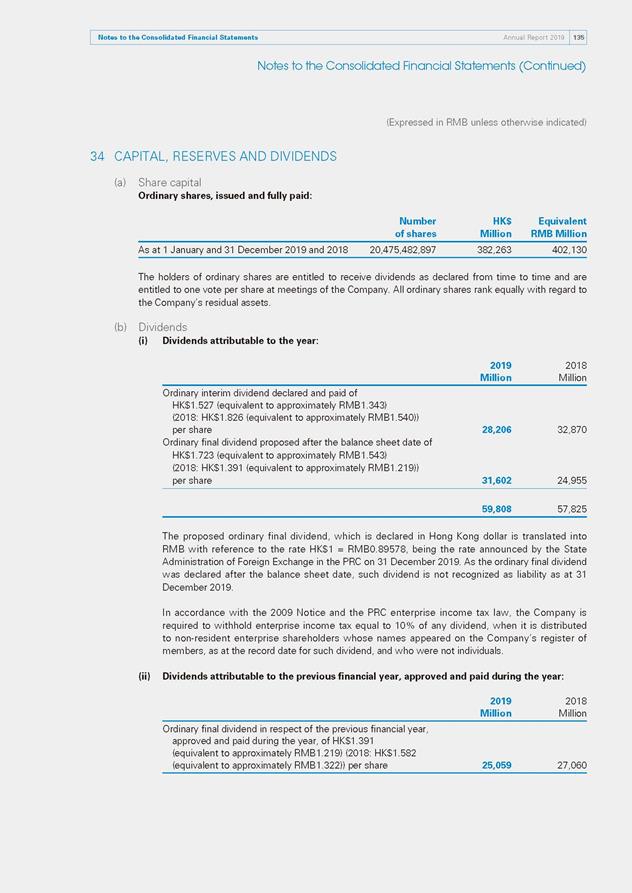
Annual Report 2019 135Notes to the Consolidated Financial Statements 135Notes to the Consolidated Financial Statements Notes to the Consolidated Financial Statements (Continued) (Expressed in RMB unless otherwise indicated) 34 CAPITAL, RESERVES AND DIVIDENDS (a) Share capital Ordinary shares, issued and fully paid: Number HK$ Equivalent of shares Million RMB Million As at 1 January and 31 December 2019 and 2018 20,475,482,897 382,263 402,130 The holders of ordinary shares are entitled to receive dividends as declared from time to time and are entitled to one vote per share at meetings of the Company. All ordinary shares rank equally with regard to the Company’s residual assets. (b) Dividends (i) Dividends attributable to the year: 2019 2018 Million Million Ordinary interim dividend declared and paid of HK$1.527 (equivalent to approximately RMB1.343) (2018: HK$1.826 (equivalent to approximately RMB1.540)) per share 28,206 32,870 Ordinary final dividend proposed after the balance sheet date of HK$1.723 (equivalent to approximately RMB1.543) (2018: HK$1.391 (equivalent to approximately RMB1.219)) per share 31,602 24,955 59,808 57,825 The proposed ordinary final dividend, which is declared in Hong Kong dollar is translated into RMB with reference to the rate HK$1 = RMB0.89578, being the rate announced by the State Administration of Foreign Exchange in the PRC on 31 December 2019. As the ordinary final dividend was declared after the balance sheet date, such dividend is not recognized as liability as at 31 December 2019. In accordance with the 2009 Notice and the PRC enterprise income tax law, the Company is required to withhold enterprise income tax equal to 10% of any dividend, when it is distributed to non-resident enterprise shareholders whose names appeared on the Company’s register of members, as at the record date for such dividend, and who were not individuals. (ii) Dividends attributable to the previous financial year, approved and paid during the year: 2019 2018 Million Million Ordinary final dividend in respect of the previous financial year, approved and paid during the year, of HK$1.391 (equivalent to approximately RMB1.219) (2018: HK$1.582 (equivalent to approximately RMB1.322)) per share 25,059 27,060
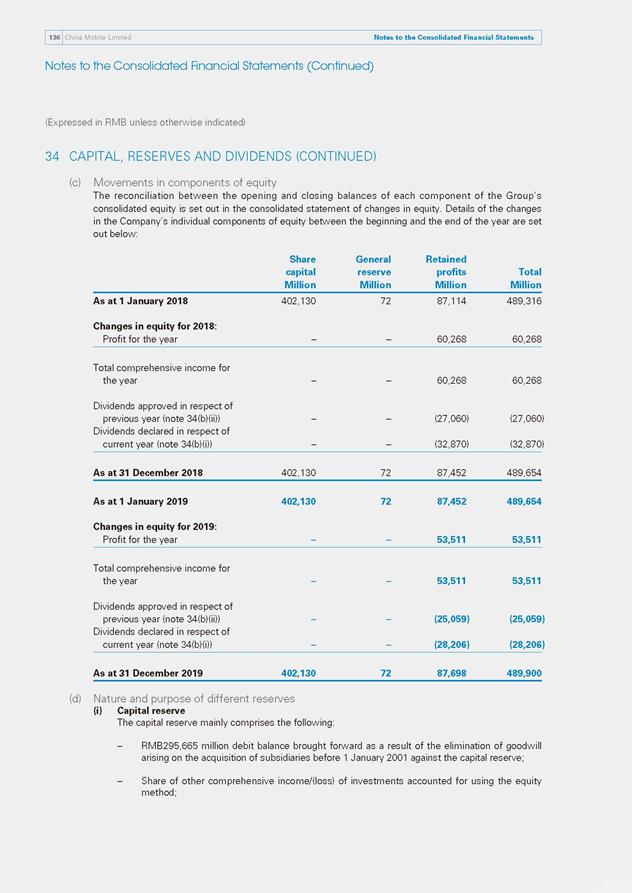
136 China Mobile Limited Notes to the Consolidated Financial Statements Notes to the Consolidated Financial Statements (Continued) (Expressed in RMB unless otherwise indicated) 34 CAPITAL, RESERVES AND DIVIDENDS (CONTINUED) (c) Movements in components of equity The reconciliation between the opening and closing balances of each component of the Group’s consolidated equity is set out in the consolidated statement of changes in equity. Details of the changes in the Company’s individual components of equity between the beginning and the end of the year are set out below: Share General Retained capital reserve profits Total Million Million Million Million As at 1 January 2018 402,130 72 87,114 489,316 Changes in equity for 2018: Profit for the year – – 60,268 60,268 Total comprehensive income for the year – – 60,268 60,268 Dividends approved in respect of previous year (note 34(b)(ii)) – – (27,060) (27,060) Dividends declared in respect of current year (note 34(b)(i)) – – (32,870) (32,870) As at 31 December 2018 402,130 72 87,452 489,654 As at 1 January 2019 402,130 72 87,452 489,654 Changes in equity for 2019: Profit for the year – – 53,511 53,511 Total comprehensive income for the year – – 53,511 53,511 Dividends approved in respect of previous year (note 34(b)(ii)) – – (25,059) (25,059) Dividends declared in respect of current year (note 34(b)(i)) – – (28,206) (28,206) As at 31 December 2019 402,130 72 87,698 489,900 (d) Nature and purpose of different reserves (i) Capital reserve The capital reserve mainly comprises the following: – RMB295,665 million debit balance brought forward as a result of the elimination of goodwill arising on the acquisition of subsidiaries before 1 January 2001 against the capital reserve; – Share of other comprehensive income/(loss) of investments accounted for using the equity method;
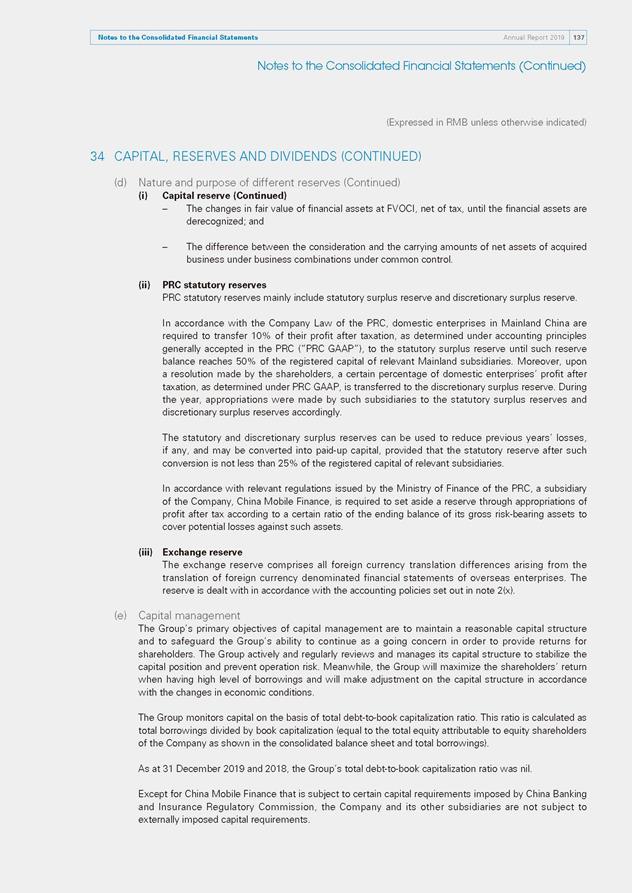
Notes to the Consolidated Financial Statements Annual Report 2019 137 Notes to the Consolidated Financial Statements (Continued) (Expressed in RMB unless otherwise indicated) 34 CAPITAL, RESERVES AND DIVIDENDS (CONTINUED) (d) Nature and purpose of different reserves (Continued) (i) Capital reserve (Continued) – The changes in fair value of financial assets at FVOCI, net of tax, until the financial assets are derecognized; and – The difference between the consideration and the carrying amounts of net assets of acquired business under business combinations under common control. (ii) PRC statutory reserves PRC statutory reserves mainly include statutory surplus reserve and discretionary surplus reserve. In accordance with the Company Law of the PRC, domestic enterprises in Mainland China are required to transfer 10% of their profit after taxation, as determined under accounting principles generally accepted in the PRC (“PRC GAAP”), to the statutory surplus reserve until such reserve balance reaches 50% of the registered capital of relevant Mainland subsidiaries. Moreover, upon a resolution made by the shareholders, a certain percentage of domestic enterprises’ profit after taxation, as determined under PRC GAAP, is transferred to the discretionary surplus reserve. During the year, appropriations were made by such subsidiaries to the statutory surplus reserves and discretionary surplus reserves accordingly. The statutory and discretionary surplus reserves can be used to reduce previous years’ losses, if any, and may be converted into paid-up capital, provided that the statutory reserve after such conversion is not less than 25% of the registered capital of relevant subsidiaries. In accordance with relevant regulations issued by the Ministry of Finance of the PRC, a subsidiary of the Company, China Mobile Finance, is required to set aside a reserve through appropriations of profit after tax according to a certain ratio of the ending balance of its gross risk-bearing assets to cover potential losses against such assets. (iii) Exchange reserve The exchange reserve comprises all foreign currency translation differences arising from the translation of foreign currency denominated financial statements of overseas enterprises. The reserve is dealt with in accordance with the accounting policies set out in note 2(x). (e) Capital management The Group’s primary objectives of capital management are to maintain a reasonable capital structure and to safeguard the Group’s ability to continue as a going concern in order to provide returns for shareholders. The Group actively and regularly reviews and manages its capital structure to stabilize the capital position and prevent operation risk. Meanwhile, the Group will maximize the shareholders’ return when having high level of borrowings and will make adjustment on the capital structure in accordance with the changes in economic conditions. The Group monitors capital on the basis of total debt-to-book capitalization ratio. This ratio is calculated as total borrowings divided by book capitalization (equal to the total equity attributable to equity shareholders of the Company as shown in the consolidated balance sheet and total borrowings). As at 31 December 2019 and 2018, the Group’s total debt-to-book capitalization ratio was nil. Except for China Mobile Finance that is subject to certain capital requirements imposed by China Banking and Insurance Regulatory Commission, the Company and its other subsidiaries are not subject to externally imposed capital requirements.
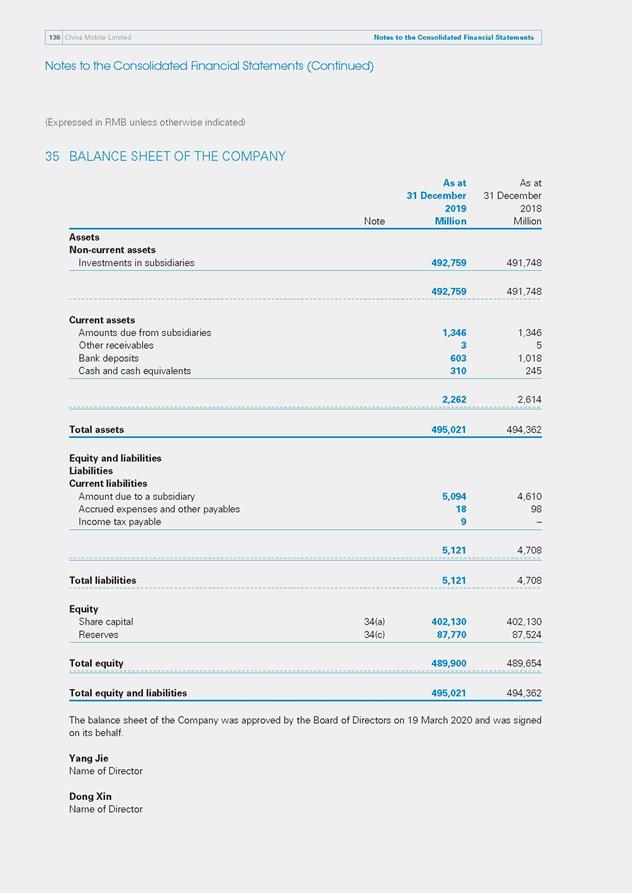
138 China Mobile Limited Notes to the Consolidated Financial Statements Notes to the Consolidated Financial Statements (Continued) (Expressed in RMB unless otherwise indicated) 35 BALANCE SHEET OF THE COMPANY As at As at 31 December 31 December 2019 2018 Note Million Million Assets Non-current assets Investments in subsidiaries 492,759 491,748 492,759 491,748 Current assets Amounts due from subsidiaries 1,346 1,346 Other receivables 3 5 Bank deposits 603 1,018 Cash and cash equivalents 310 245 2,262 2,614 Total assets 495,021 494,362 Equity and liabilities Liabilities Current liabilities Amount due to a subsidiary 5,094 4,610 Accrued expenses and other payables 18 98 Income tax payable 9 – 5,121 4,708 Total liabilities 5,121 4,708 Equity Share capital 34(a) 402,130 402,130 Reserves 34(c) 87,770 87,524 Total equity 489,900 489,654 Total equity and liabilities 495,021 494,362 The balance sheet of the Company was approved by the Board of Directors on 19 March 2020 and was signed on its behalf. Yang Jie Name of Director Dong Xin Name of Director
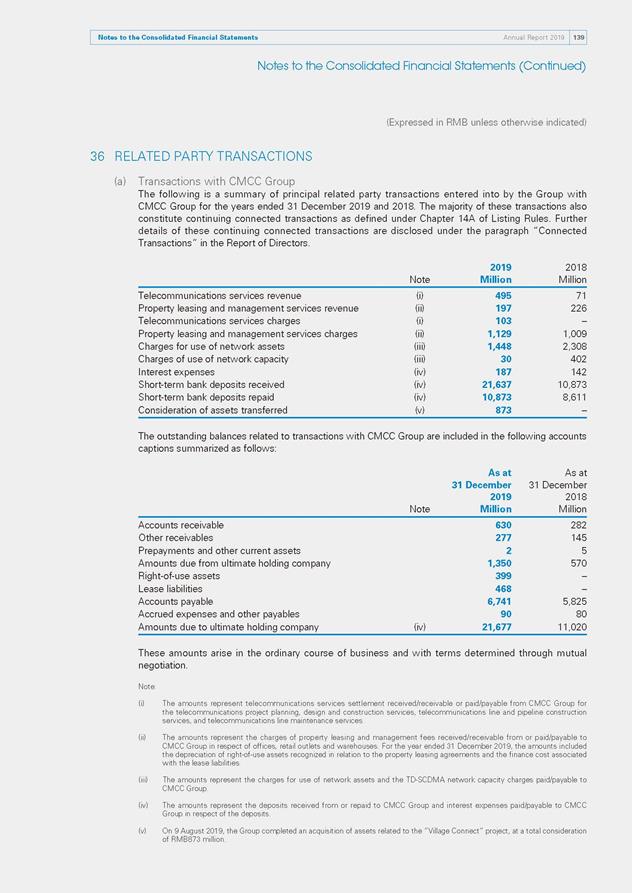
Notes to the Consolidated Financial Statements Annual Report 2019 139 Notes to the Consolidated Financial Statements (Continued) (Expressed in RMB unless otherwise indicated) 36 RELATED PARTY TRANSACTIONS (a) Transactions with CMCC Group The following is a summary of principal related party transactions entered into by the Group with CMCC Group for the years ended 31 December 2019 and 2018. The majority of these transactions also constitute continuing connected transactions as defined under Chapter 14A of Listing Rules. Further details of these continuing connected transactions are disclosed under the paragraph “Connected Transactions” in the Report of Directors. 2019 2018 Note Million Million Telecommunications services revenue (i) 495 71 Property leasing and management services revenue (ii) 197 226 Telecommunications services charges (i) 103 – Property leasing and management services charges (ii) 1,129 1,009 Charges for use of network assets (iii) 1,448 2,308 Charges of use of network capacity (iii) 30 402 Interest expenses (iv) 187 142 Short-term bank deposits received (iv) 21,637 10,873 Short-term bank deposits repaid (iv) 10,873 8,611 Consideration of assets transferred (v) 873 – The outstanding balances related to transactions with CMCC Group are included in the following accounts captions summarized as follows: Note As at 31 December 2019 Million As at 31 December 2018 Million Accounts receivable 630 282 Other receivables 277 145 Prepayments and other current assets 2 5 Amounts due from ultimate holding company 1,350 570 Right-of-use assets 399 – Lease liabilities 468 – Accounts payable 6,741 5,825 Accrued expenses and other payables 90 80 Amounts due to ultimate holding company (iv) 21,677 11,020 These amounts arise in the ordinary course of business and with terms determined through mutual negotiation. Note: (i) The amounts represent telecommunications services settlement received/receivable or paid/payable from CMCC Group for the telecommunications project planning, design and construction services, telecommunications line and pipeline construction services, and telecommunications line maintenance services. (ii) The amounts represent the charges of property leasing and management fees received/receivable from or paid/payable to CMCC Group in respect of offices, retail outlets and warehouses. For the year ended 31 December 2019, the amounts included the depreciation of right-of-use assets recognized in relation to the property leasing agreements and the finance cost associated with the lease liabilities. (iii) The amounts represent the charges for use of network assets and the TD-SCDMA network capacity charges paid/payable to CMCC Group. (iv) The amounts represent the deposits received from or repaid to CMCC Group and interest expenses paid/payable to CMCC Group in respect of the deposits. (v) On 9 August 2019, the Group completed an acquisition of assets related to the “Village Connect” project, at a total consideration of RMB873 million.
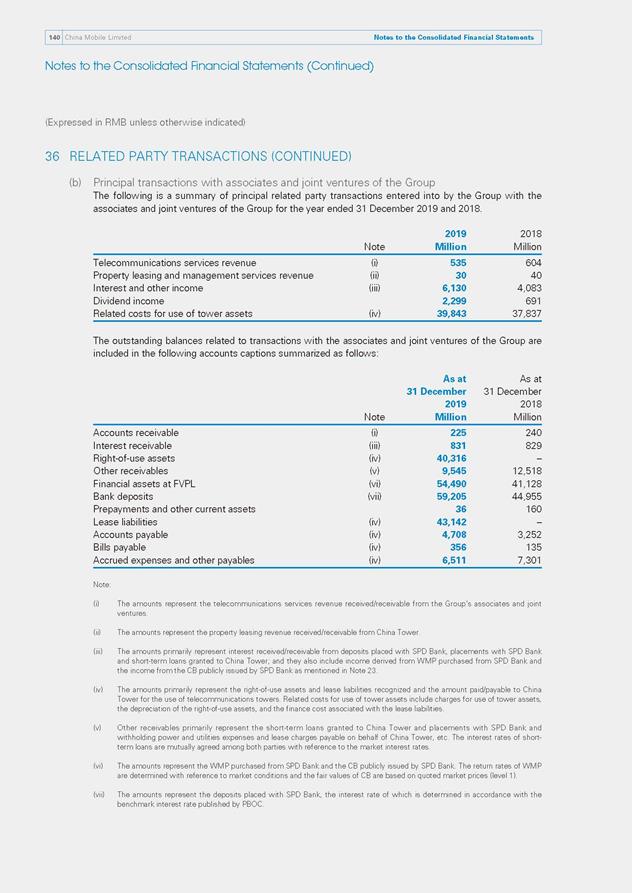
140 China Mobile Limited Notes to the Consolidated Financial Statements Notes to the Consolidated Financial Statements (Continued) (Expressed in RMB unless otherwise indicated) 36 RELATED PARTY TRANSACTIONS (CONTINUED) (b) Principal transactions with associates and joint ventures of the Group The following is a summary of principal related party transactions entered into by the Group with the associates and joint ventures of the Group for the year ended 31 December 2019 and 2018. 2019 2018 Note Million Million Telecommunications services revenue (i) 535 604 Property leasing and management services revenue (ii) 30 40 Interest and other income (iii) 6,130 4,083 Dividend income 2,299 691 Related costs for use of tower assets (iv) 39,843 37,837 The outstanding balances related to transactions with the associates and joint ventures of the Group are included in the following accounts captions summarized as follows: Note As at 31 December 2019 Million As at 31 December 2018 Million Accounts receivable (i) 225 240 Interest receivable (iii) 831 829 Right-of-use assets (iv) 40,316 – Other receivables (v) 9,545 12,518 Financial assets at FVPL (vi) 54,490 41,128 Bank deposits (vii) 59,205 44,955 Prepayments and other current assets 36 160 Lease liabilities (iv) 43,142 – Accounts payable (iv) 4,708 3,252 Bills payable (iv) 356 135 Accrued expenses and other payables (iv) 6,511 7,301 Note: (i) The amounts represent the telecommunications services revenue received/receivable from the Group’s associates and joint ventures. (ii) The amounts represent the property leasing revenue received/receivable from China Tower. (iii) The amounts primarily represent interest received/receivable from deposits placed with SPD Bank, placements with SPD Bank and short-term loans granted to China Tower; and they also include income derived from WMP purchased from SPD Bank and the income from the CB publicly issued by SPD Bank as mentioned in Note 23. (iv) The amounts primarily represent the right-of-use assets and lease liabilities recognized and the amount paid/payable to China Tower for the use of telecommunications towers. Related costs for use of tower assets include charges for use of tower assets, the depreciation of the right-of-use assets, and the finance cost associated with the lease liabilities. (v) Other receivables primarily represent the short-term loans granted to China Tower and placements with SPD Bank and withholding power and utilities expenses and lease charges payable on behalf of China Tower, etc. The interest rates of short- term loans are mutually agreed among both parties with reference to the market interest rates. (vi) The amounts represent the WMP purchased from SPD Bank and the CB publicly issued by SPD Bank. The return rates of WMP are determined with reference to market conditions and the fair values of CB are based on quoted market prices (level 1). (vii) The amounts represent the deposits placed with SPD Bank, the interest rate of which is determined in accordance with the benchmark interest rate published by PBOC.
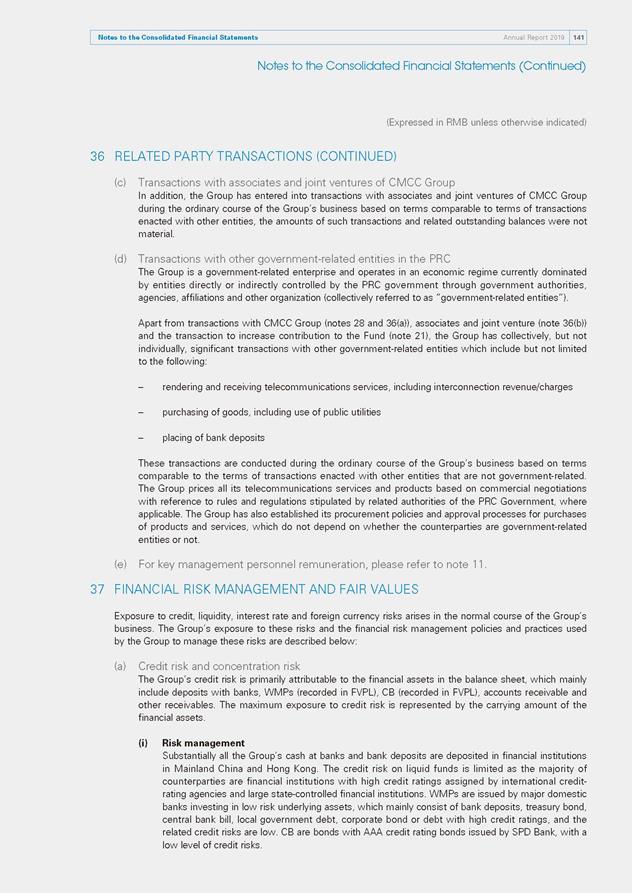
Notes to the Consolidated Financial Statements Annual Report 2019 141 Notes to the Consolidated Financial Statements (Continued) (Expressed in RMB unless otherwise indicated) 36 RELATED PARTY TRANSACTIONS (CONTINUED) (c) Transactions with associates and joint ventures of CMCC Group In addition, the Group has entered into transactions with associates and joint ventures of CMCC Group during the ordinary course of the Group’s business based on terms comparable to terms of transactions enacted with other entities, the amounts of such transactions and related outstanding balances were not material. (d) Transactions with other government-related entities in the PRC The Group is a government-related enterprise and operates in an economic regime currently dominated by entities directly or indirectly controlled by the PRC government through government authorities, agencies, affiliations and other organization (collectively referred to as “government-related entities”). Apart from transactions with CMCC Group (notes 28 and 36(a)), associates and joint venture (note 36(b)) and the transaction to increase contribution to the Fund (note 21), the Group has collectively, but not individually, significant transactions with other government-related entities which include but not limited to the following: – rendering and receiving telecommunications services, including interconnection revenue/charges – purchasing of goods, including use of public utilities – placing of bank deposits These transactions are conducted during the ordinary course of the Group’s business based on terms comparable to the terms of transactions enacted with other entities that are not government-related. The Group prices all its telecommunications services and products based on commercial negotiations with reference to rules and regulations stipulated by related authorities of the PRC Government, where applicable. The Group has also established its procurement policies and approval processes for purchases of products and services, which do not depend on whether the counterparties are government-related entities or not. (e) For key management personnel remuneration, please refer to note 11. 37 FINANCIAL RISK MANAGEMENT AND FAIR VALUES Exposure to credit, liquidity, interest rate and foreign currency risks arises in the normal course of the Group’s business. The Group’s exposure to these risks and the financial risk management policies and practices used by the Group to manage these risks are described below: (a) Credit risk and concentration risk The Group’s credit risk is primarily attributable to the financial assets in the balance sheet, which mainly include deposits with banks, WMPs (recorded in FVPL), CB (recorded in FVPL), accounts receivable and other receivables. The maximum exposure to credit risk is represented by the carrying amount of the financial assets. (i) Risk management Substantially all the Group’s cash at banks and bank deposits are deposited in financial institutions in Mainland China and Hong Kong. The credit risk on liquid funds is limited as the majority of counterparties are financial institutions with high credit ratings assigned by international credit- rating agencies and large state-controlled financial institutions. WMPs are issued by major domestic banks investing in low risk underlying assets, which mainly consist of bank deposits, treasury bond, central bank bill, local government debt, corporate bond or debt with high credit ratings, and the related credit risks are low. CB are bonds with AAA credit rating bonds issued by SPD Bank, with a low level of credit risks.
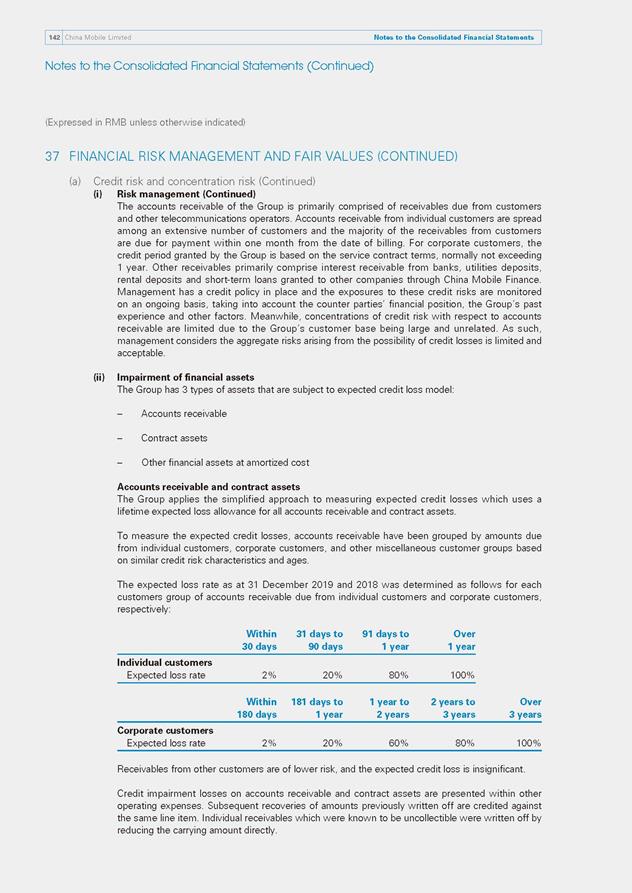
142 China Mobile Limited Notes to the Consolidated Financial Statements Notes to the Consolidated Financial Statements (Continued) (Expressed in RMB unless otherwise indicated) 37 FINANCIAL RISK MANAGEMENT AND FAIR VALUES (CONTINUED) (a) Credit risk and concentration risk (Continued) (i) Risk management (Continued) The accounts receivable of the Group is primarily comprised of receivables due from customers and other telecommunications operators. Accounts receivable from individual customers are spread among an extensive number of customers and the majority of the receivables from customers are due for payment within one month from the date of billing. For corporate customers, the credit period granted by the Group is based on the service contract terms, normally not exceeding 1 year. Other receivables primarily comprise interest receivable from banks, utilities deposits, rental deposits and short-term loans granted to other companies through China Mobile Finance. Management has a credit policy in place and the exposures to these credit risks are monitored on an ongoing basis, taking into account the counter parties’ financial position, the Group’s past experience and other factors. Meanwhile, concentrations of credit risk with respect to accounts receivable are limited due to the Group’s customer base being large and unrelated. As such, management considers the aggregate risks arising from the possibility of credit losses is limited and acceptable. (ii) Impairment of financial assets The Group has 3 types of assets that are subject to expected credit loss model: – Accounts receivable – Contract assets – Other financial assets at amortized cost Accounts receivable and contract assets The Group applies the simplified approach to measuring expected credit losses which uses a lifetime expected loss allowance for all accounts receivable and contract assets. To measure the expected credit losses, accounts receivable have been grouped by amounts due from individual customers, corporate customers, and other miscellaneous customer groups based on similar credit risk characteristics and ages. The expected loss rate as at 31 December 2019 and 2018 was determined as follows for each customers group of accounts receivable due from individual customers and corporate customers, respectively: Individual customers Expected loss rate Within 30 days 2% 31 days to 90 days 20% 91 days to 1 year 80% Over 1 year 100% Corporate customers Expected loss rate Within 180 days 2% 181 days to 1 year 20% 1 year to 2 years 60% 2 years to 3 years 80% Over 3 years 100% Receivables from other customers are of lower risk, and the expected credit loss is insignificant. Credit impairment losses on accounts receivable and contract assets are presented within other operating expenses. Subsequent recoveries of amounts previously written off are credited against the same line item. Individual receivables which were known to be uncollectible were written off by reducing the carrying amount directly.
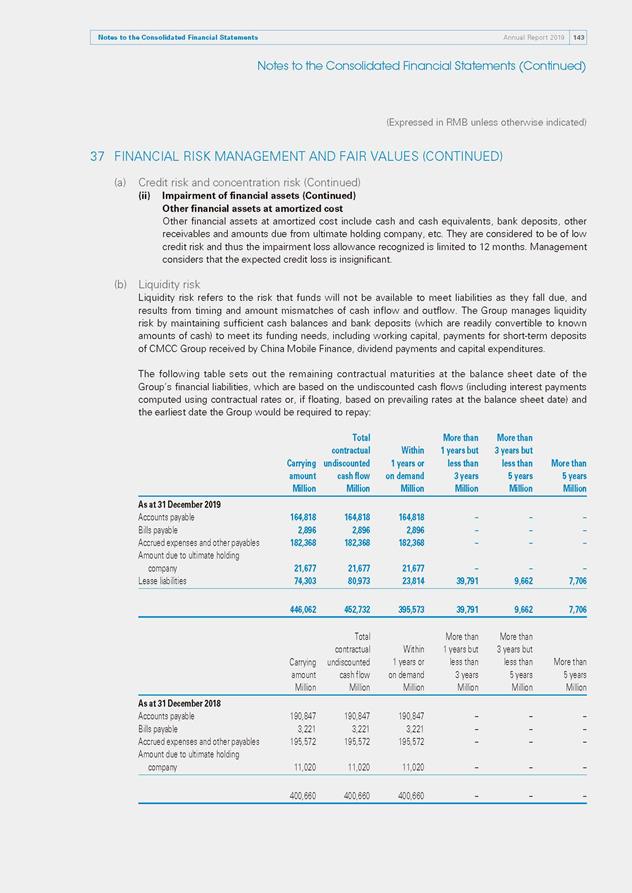
Notes to the Consolidated Financial Statements Annual Report 2019 143 Notes to the Consolidated Financial Statements (Continued) (Expressed in RMB unless otherwise indicated) 37 FINANCIAL RISK MANAGEMENT AND FAIR VALUES (CONTINUED) (a) Credit risk and concentration risk (Continued) (ii) Impairment of financial assets (Continued) Other financial assets at amortized cost Other financial assets at amortized cost include cash and cash equivalents, bank deposits, other receivables and amounts due from ultimate holding company, etc. They are considered to be of low credit risk and thus the impairment loss allowance recognized is limited to 12 months. Management considers that the expected credit loss is insignificant. (b) Liquidity risk Liquidity risk refers to the risk that funds will not be available to meet liabilities as they fall due, and results from timing and amount mismatches of cash inflow and outflow. The Group manages liquidity risk by maintaining sufficient cash balances and bank deposits (which are readily convertible to known amounts of cash) to meet its funding needs, including working capital, payments for short-term deposits of CMCC Group received by China Mobile Finance, dividend payments and capital expenditures. The following table sets out the remaining contractual maturities at the balance sheet date of the Group’s financial liabilities, which are based on the undiscounted cash flows (including interest payments computed using contractual rates or, if floating, based on prevailing rates at the balance sheet date) and the earliest date the Group would be required to repay: Total More than More than contractual Within 1 years but 3 years but Carrying undiscounted 1 years or less than less than More than amount cash flow on demand 3 years 5 years 5 years Million Million Million Million Million Million As at 31 December 2019 Accounts payable 164,818 164,818 164,818 – – – Bills payable 2,896 2,896 2,896 – – – Accrued expenses and other payables 182,368 182,368 182,368 – – – Amount due to ultimate holding company 21,677 21,677 21,677 – – – Lease liabilities 74,303 80,973 23,814 39,791 9,662 7,706 446,062 452,732 395,573 39,791 9,662 7,706 Total More than More than contractual Within 1 years but 3 years but Carrying undiscounted 1 years or less than less than More than amount cash flow on demand 3 years 5 years 5 years Million Million Million Million Million Million As at 31 December 2018 Accounts payable 190,847 190,847 190,847 – – – Bills payable 3,221 3,221 3,221 – – – Accrued expenses and other payables 195,572 195,572 195,572 – – – Amount due to ultimate holding company 11,020 11,020 11,020 – – – 400,660 400,660 400,660 – – –
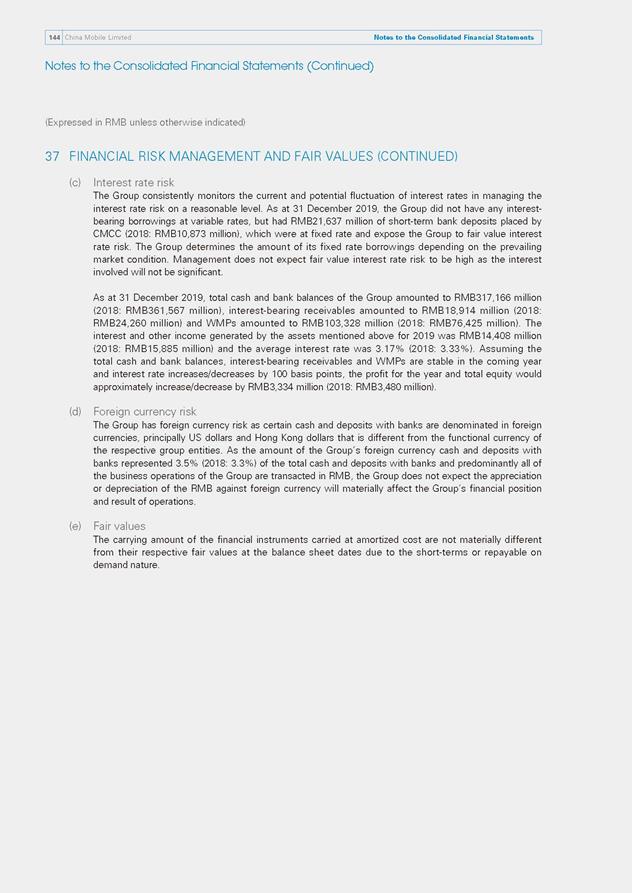
China Mobile Limited144 Notes to the Consolidated Financial Statements 144 Notes to the Consolidated Financial Statements Notes to the Consolidated Financial Statements (Continued) (Expressed in RMB unless otherwise indicated) 37 FINANCIAL RISK MANAGEMENT AND FAIR VALUES (CONTINUED) (c) Interest rate risk The Group consistently monitors the current and potential fluctuation of interest rates in managing the interest rate risk on a reasonable level. As at 31 December 2019, the Group did not have any interest- bearing borrowings at variable rates, but had RMB21,637 million of short-term bank deposits placed by CMCC (2018: RMB10,873 million), which were at fixed rate and expose the Group to fair value interest rate risk. The Group determines the amount of its fixed rate borrowings depending on the prevailing market condition. Management does not expect fair value interest rate risk to be high as the interest involved will not be significant. As at 31 December 2019, total cash and bank balances of the Group amounted to RMB317,166 million (2018: RMB361,567 million), interest-bearing receivables amounted to RMB18,914 million (2018: RMB24,260 million) and WMPs amounted to RMB103,328 million (2018: RMB76,425 million). The interest and other income generated by the assets mentioned above for 2019 was RMB14,408 million (2018: RMB15,885 million) and the average interest rate was 3.17% (2018: 3.33%). Assuming the total cash and bank balances, interest-bearing receivables and WMPs are stable in the coming year and interest rate increases/decreases by 100 basis points, the profit for the year and total equity would approximately increase/decrease by RMB3,334 million (2018: RMB3,480 million). (d) Foreign currency risk The Group has foreign currency risk as certain cash and deposits with banks are denominated in foreign currencies, principally US dollars and Hong Kong dollars that is different from the functional currency of the respective group entities. As the amount of the Group’s foreign currency cash and deposits with banks represented 3.5% (2018: 3.3%) of the total cash and deposits with banks and predominantly all of the business operations of the Group are transacted in RMB, the Group does not expect the appreciation or depreciation of the RMB against foreign currency will materially affect the Group’s financial position and result of operations. (e) Fair values The carrying amount of the financial instruments carried at amortized cost are not materially different from their respective fair values at the balance sheet dates due to the short-terms or repayable on demand nature.
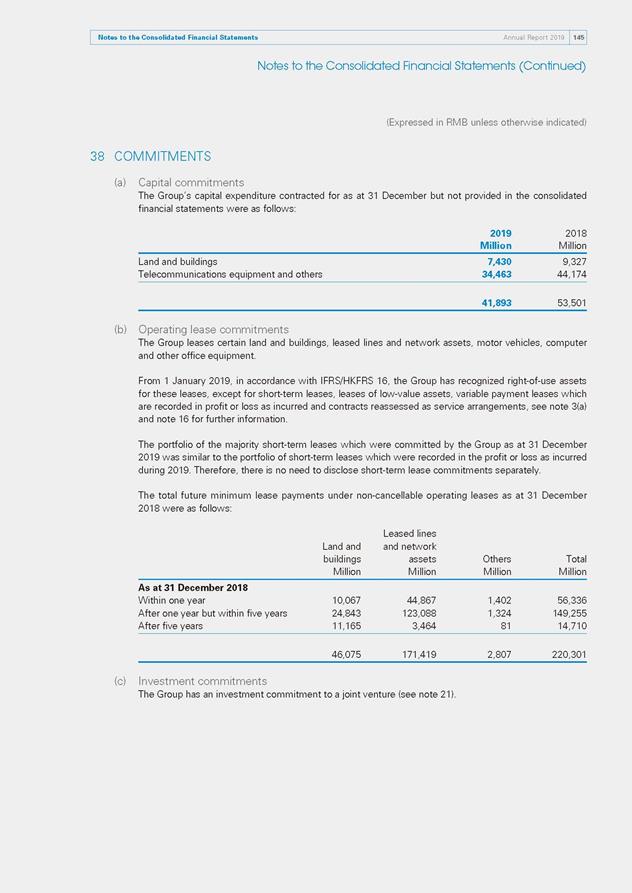
Annual Report 2019 145Notes to the Consolidated Financial Statements 145Notes to the Consolidated Financial Statements Notes to the Consolidated Financial Statements (Continued) (Expressed in RMB unless otherwise indicated) 38 COMMITMENTS (a) Capital commitments The Group’s capital expenditure contracted for as at 31 December but not provided in the consolidated financial statements were as follows: 2019 2018 Million Million Land and buildings 7,430 9,327 Telecommunications equipment and others 34,463 44,174 41,893 53,501 (b) Operating lease commitments The Group leases certain land and buildings, leased lines and network assets, motor vehicles, computer and other office equipment. From 1 January 2019, in accordance with IFRS/HKFRS 16, the Group has recognized right-of-use assets for these leases, except for short-term leases, leases of low-value assets, variable payment leases which are recorded in profit or loss as incurred and contracts reassessed as service arrangements, see note 3(a) and note 16 for further information. The portfolio of the majority short-term leases which were committed by the Group as at 31 December 2019 was similar to the portfolio of short-term leases which were recorded in the profit or loss as incurred during 2019. Therefore, there is no need to disclose short-term lease commitments separately. The total future minimum lease payments under non-cancellable operating leases as at 31 December 2018 were as follows: Leased lines Land and and network buildings assets Others Total Million Million Million Million As at 31 December 2018 Within one year 10,067 44,867 1,402 56,336 After one year but within five years 24,843 123,088 1,324 149,255 After five years 11,165 3,464 81 14,710 46,075 171,419 2,807 220,301 (c) Investment commitments The Group has an investment commitment to a joint venture (see note 21).
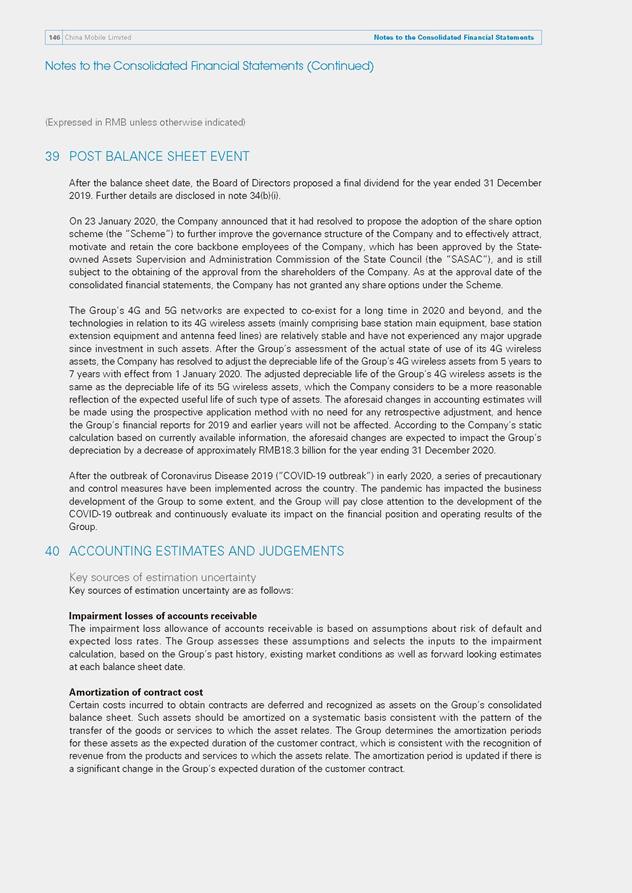
China Mobile Limited146 Notes to the Consolidated Financial Statements 146 Notes to the Consolidated Financial Statements Notes to the Consolidated Financial Statements (Continued) (Expressed in RMB unless otherwise indicated) 39 POST BALANCE SHEET EVENT After the balance sheet date, the Board of Directors proposed a final dividend for the year ended 31 December 2019. Further details are disclosed in note 34(b)(i). On 23 January 2020, the Company announced that it had resolved to propose the adoption of the share option scheme (the “Scheme”) to further improve the governance structure of the Company and to effectively attract, motivate and retain the core backbone employees of the Company, which has been approved by the State- owned Assets Supervision and Administration Commission of the State Council (the “SASAC”), and is still subject to the obtaining of the approval from the shareholders of the Company. As at the approval date of the consolidated financial statements, the Company has not granted any share options under the Scheme. The Group’s 4G and 5G networks are expected to co-exist for a long time in 2020 and beyond, and the technologies in relation to its 4G wireless assets (mainly comprising base station main equipment, base station extension equipment and antenna feed lines) are relatively stable and have not experienced any major upgrade since investment in such assets. After the Group’s assessment of the actual state of use of its 4G wireless assets, the Company has resolved to adjust the depreciable life of the Group’s 4G wireless assets from 5 years to 7 years with effect from 1 January 2020. The adjusted depreciable life of the Group’s 4G wireless assets is the same as the depreciable life of its 5G wireless assets, which the Company considers to be a more reasonable reflection of the expected useful life of such type of assets. The aforesaid changes in accounting estimates will be made using the prospective application method with no need for any retrospective adjustment, and hence the Group’s financial reports for 2019 and earlier years will not be affected. According to the Company’s static calculation based on currently available information, the aforesaid changes are expected to impact the Group’s depreciation by a decrease of approximately RMB18.3 billion for the year ending 31 December 2020. After the outbreak of Coronavirus Disease 2019 (“COVID-19 outbreak”) in early 2020, a series of precautionary and control measures have been implemented across the country. The pandemic has impacted the business development of the Group to some extent, and the Group will pay close attention to the development of the COVID-19 outbreak and continuously evaluate its impact on the financial position and operating results of the Group. 40 ACCOUNTING ESTIMATES AND JUDGEMENTS Key sources of estimation uncertainty Key sources of estimation uncertainty are as follows: Impairment losses of accounts receivable The impairment loss allowance of accounts receivable is based on assumptions about risk of default and expected loss rates. The Group assesses these assumptions and selects the inputs to the impairment calculation, based on the Group’s past history, existing market conditions as well as forward looking estimates at each balance sheet date. Amortization of contract cost Certain costs incurred to obtain contracts are deferred and recognized as assets on the Group’s consolidated balance sheet. Such assets should be amortized on a systematic basis consistent with the pattern of the transfer of the goods or services to which the asset relates. The Group determines the amortization periods for these assets as the expected duration of the customer contract, which is consistent with the recognition of revenue from the products and services to which the assets relate. The amortization period is updated if there is a significant change in the Group’s expected duration of the customer contract.
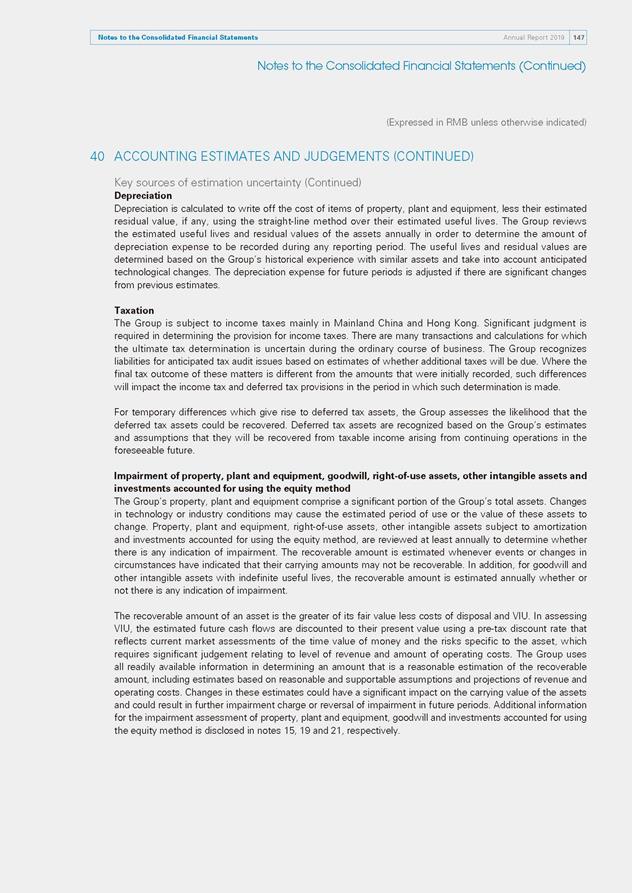
Annual Report 2019 147Notes to the Consolidated Financial Statements 147Notes to the Consolidated Financial Statements Notes to the Consolidated Financial Statements (Continued) (Expressed in RMB unless otherwise indicated) 40 ACCOUNTING ESTIMATES AND JUDGEMENTS (CONTINUED) Key sources of estimation uncertainty (Continued) Depreciation Depreciation is calculated to write off the cost of items of property, plant and equipment, less their estimated residual value, if any, using the straight-line method over their estimated useful lives. The Group reviews the estimated useful lives and residual values of the assets annually in order to determine the amount of depreciation expense to be recorded during any reporting period. The useful lives and residual values are determined based on the Group’s historical experience with similar assets and take into account anticipated technological changes. The depreciation expense for future periods is adjusted if there are significant changes from previous estimates. Taxation The Group is subject to income taxes mainly in Mainland China and Hong Kong. Significant judgment is required in determining the provision for income taxes. There are many transactions and calculations for which the ultimate tax determination is uncertain during the ordinary course of business. The Group recognizes liabilities for anticipated tax audit issues based on estimates of whether additional taxes will be due. Where the final tax outcome of these matters is different from the amounts that were initially recorded, such differences will impact the income tax and deferred tax provisions in the period in which such determination is made. For temporary differences which give rise to deferred tax assets, the Group assesses the likelihood that the deferred tax assets could be recovered. Deferred tax assets are recognized based on the Group’s estimates and assumptions that they will be recovered from taxable income arising from continuing operations in the foreseeable future. Impairment of property, plant and equipment, goodwill, right-of-use assets, other intangible assets and investments accounted for using the equity method The Group’s property, plant and equipment comprise a significant portion of the Group’s total assets. Changes in technology or industry conditions may cause the estimated period of use or the value of these assets to change. Property, plant and equipment, right-of-use assets, other intangible assets subject to amortization and investments accounted for using the equity method, are reviewed at least annually to determine whether there is any indication of impairment. The recoverable amount is estimated whenever events or changes in circumstances have indicated that their carrying amounts may not be recoverable. In addition, for goodwill and other intangible assets with indefinite useful lives, the recoverable amount is estimated annually whether or not there is any indication of impairment. The recoverable amount of an asset is the greater of its fair value less costs of disposal and VIU. In assessing VIU, the estimated future cash flows are discounted to their present value using a pre-tax discount rate that reflects current market assessments of the time value of money and the risks specific to the asset, which requires significant judgement relating to level of revenue and amount of operating costs. The Group uses all readily available information in determining an amount that is a reasonable estimation of the recoverable amount, including estimates based on reasonable and supportable assumptions and projections of revenue and operating costs. Changes in these estimates could have a significant impact on the carrying value of the assets and could result in further impairment charge or reversal of impairment in future periods. Additional information for the impairment assessment of property, plant and equipment, goodwill and investments accounted for using the equity method is disclosed in notes 15, 19 and 21, respectively.
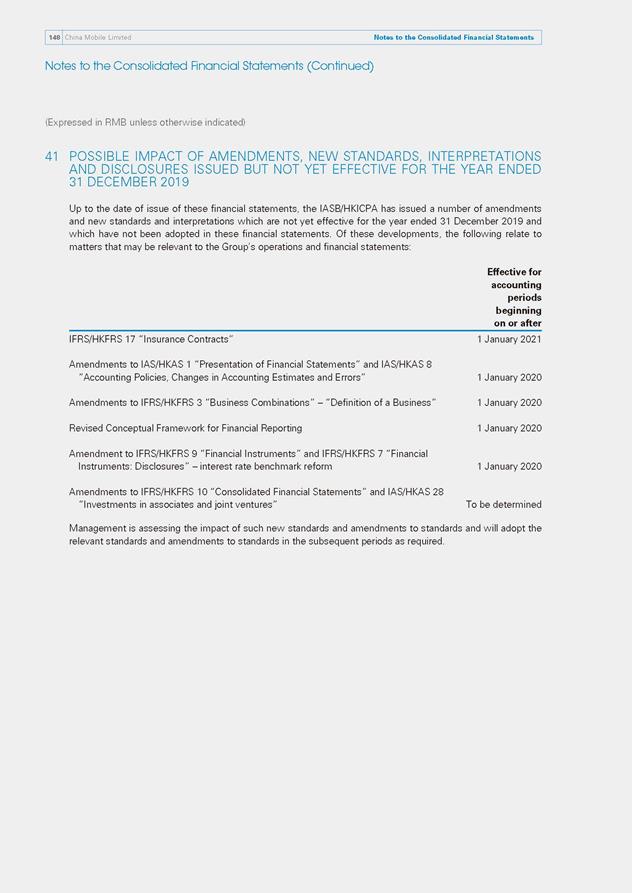
China Mobile Limited148 Notes to the Consolidated Financial Statements 148 Notes to the Consolidated Financial Statements Notes to the Consolidated Financial Statements (Continued) (Expressed in RMB unless otherwise indicated) 41 POSSIBLE IMPACT OF AMENDMENTS, NEW STANDARDS, INTERPRETATIONS AND DISCLOSURES ISSUED BUT NOT YET EFFECTIVE FOR THE YEAR ENDED 31 DECEMBER 2019 Up to the date of issue of these financial statements, the IASB/HKICPA has issued a number of amendments and new standards and interpretations which are not yet effective for the year ended 31 December 2019 and which have not been adopted in these financial statements. Of these developments, the following relate to matters that may be relevant to the Group’s operations and financial statements: Effective for accounting periods beginning on or after IFRS/HKFRS 17 “Insurance Contracts” 1 January 2021 Amendments to IAS/HKAS 1 “Presentation of Financial Statements” and IAS/HKAS 8 “Accounting Policies, Changes in Accounting Estimates and Errors” 1 January 2020 Amendments to IFRS/HKFRS 3 “Business Combinations” – “Definition of a Business” 1 January 2020 Revised Conceptual Framework for Financial Reporting 1 January 2020 Amendment to IFRS/HKFRS 9 “Financial Instruments” and IFRS/HKFRS 7 “Financial Instruments: Disclosures” – interest rate benchmark reform 1 January 2020 Amendments to IFRS/HKFRS 10 “Consolidated Financial Statements” and IAS/HKAS 28 “Investments in associates and joint ventures” To be determined Management is assessing the impact of such new standards and amendments to standards and will adopt the relevant standards and amendments to standards in the subsequent periods as required.
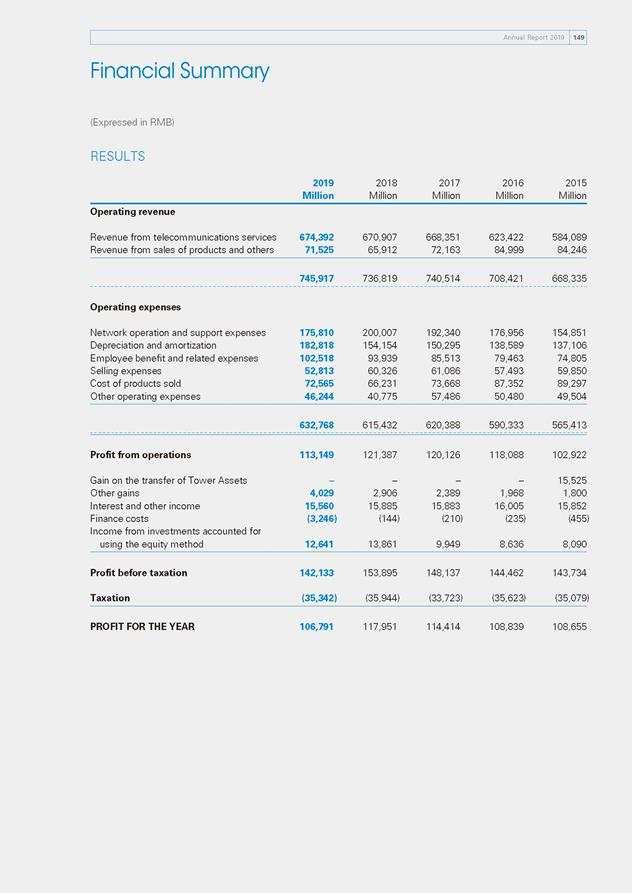
Annual Report 2019 149 Financial Summary (Expressed in RMB) RESULTS 2019 2018 2017 2016 2015 Million Million Million Million Million Operating revenue Revenue from telecommunications services 674,392 670,907 668,351 623,422 584,089 Revenue from sales of products and others 71,525 65,912 72,163 84,999 84,246 745,917 736,819 740,514 708,421 668,335 Operating expenses Network operation and support expenses 175,810 200,007 192,340 176,956 154,851 Depreciation and amortization 182,818 154,154 150,295 138,589 137,106 Employee benefit and related expenses 102,518 93,939 85,513 79,463 74,805 Selling expenses 52,813 60,326 61,086 57,493 59,850 Cost of products sold 72,565 66,231 73,668 87,352 89,297 Other operating expenses 46,244 40,775 57,486 50,480 49,504 632,768 615,432 620,388 590,333 565,413 Profit from operations 113,149 121,387 120,126 118,088 102,922 Gain on the transfer of Tower Assets – – – – 15,525 Other gains 4,029 2,906 2,389 1,968 1,800 Interest and other income 15,560 15,885 15,883 16,005 15,852 Finance costs (3,246) (144) (210) (235) (455) Income from investments accounted for using the equity method 12,641 13,861 9,949 8,636 8,090 Profit before taxation 142,133 153,895 148,137 144,462 143,734 Taxation (35,342) (35,944) (33,723) (35,623) (35,079) PROFIT FOR THE YEAR 106,791 117,951 114,414 108,839 108,655
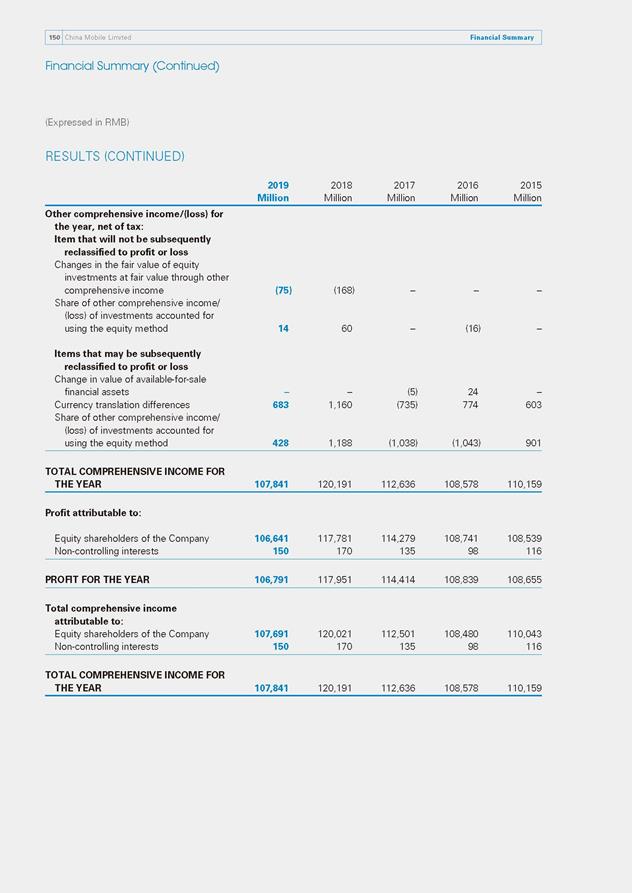
150 China Mobile Limited Financial Summary Financial Summary (Continued) (Expressed in RMB) RESULTS (CONTINUED) 2019 2018 2017 2016 2015 Million Million Million Million Million Other comprehensive income/(loss) for the year, net of tax: Item that will not be subsequently reclassified to profit or loss Changes in the fair value of equity investments at fair value through other comprehensive income Share of other comprehensive income/ (loss) of investments accounted for using the equity method (75) 14 (168) 60 – – – (16) – – Items that may be subsequently reclassified to profit or loss Change in value of available-for-sale financial assets Currency translation differences Share of other comprehensive income/ (loss) of investments accounted for using the equity method – 683 428 – 1,160 1,188 (5) (735) (1,038) 24 774 (1,043) – 603 901 TOTAL COMPREHENSIVE INCOME FOR THE YEAR 107,841 120,191 112,636 108,578 110,159 Profit attributable to: Equity shareholders of the Company Non-controlling interests 106,641 150 117,781 170 114,279 135 108,741 98 108,539 116 PROFIT FOR THE YEAR 106,791 117,951 114,414 108,839 108,655 Total comprehensive income attributable to: Equity shareholders of the Company Non-controlling interests 107,691 150 120,021 170 112,501 135 108,480 98 110,043 116 TOTAL COMPREHENSIVE INCOME FOR THE YEAR 107,841 120,191 112,636 108,578 110,159
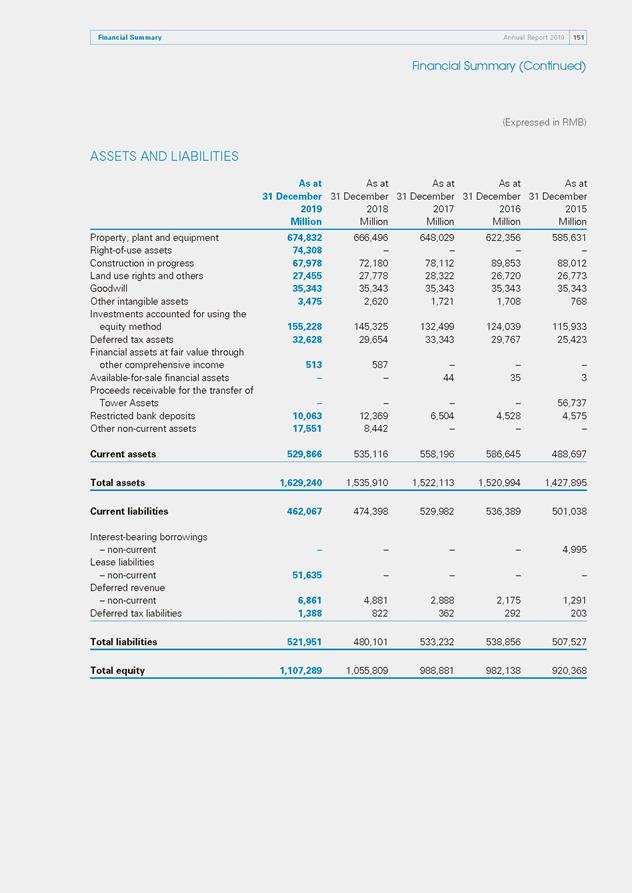
Financial Summary Annual Report 2019 151 Financial Summary (Continued) (Expressed in RMB) ASSETS AND LIABILITIES As at As at As at As at As at 31 December 31 December 31 December 31 December 31 December 2019 2018 2017 2016 2015 Million Million Million Million Million Property, plant and equipment 674,832 666,496 648,029 622,356 585,631 Right-of-use assets 74,308 – – – – Construction in progress 67,978 72,180 78,112 89,853 88,012 Land use rights and others 27,455 27,778 28,322 26,720 26,773 Goodwill 35,343 35,343 35,343 35,343 35,343 Other intangible assets 3,475 2,620 1,721 1,708 768 Investments accounted for using the equity method 155,228 145,325 132,499 124,039 115,933 Deferred tax assets 32,628 29,654 33,343 29,767 25,423 Financial assets at fair value through other comprehensive income 513 587 – – – Available-for-sale financial assets – – 44 35 3 Proceeds receivable for the transfer of Tower Assets – – – – 56,737 Restricted bank deposits 10,063 12,369 6,504 4,528 4,575 Other non-current assets 17,551 8,442 – – – Current assets 529,866 535,116 558,196 586,645 488,697 Total assets 1,629,240 1,535,910 1,522,113 1,520,994 1,427,895 Current liabilities 462,067 474,398 529,982 536,389 501,038 Interest-bearing borrowings – non-current – – – – 4,995 Lease liabilities – non-current 51,635 – – – – Deferred revenue – non-current 6,861 4,881 2,888 2,175 1,291 Deferred tax liabilities 1,388 822 362 292 203 Total liabilities 521,951 480,101 533,232 538,856 507,527 Total equity 1,107,289 1,055,809 988,881 982,138 920,368
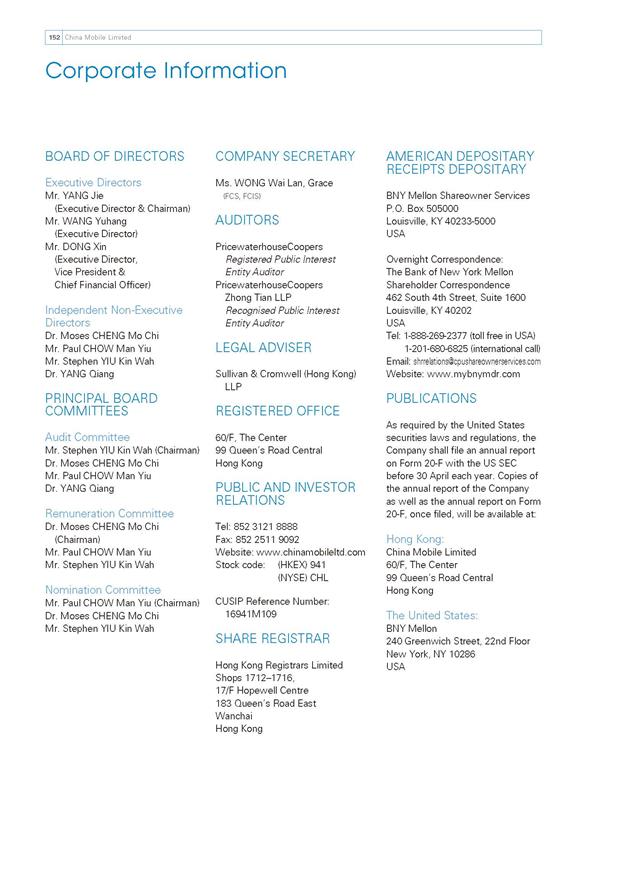
China Mobile Limited152 152 Corporate Information BOARD OF DIRECTORS Executive Directors Mr. YANG Jie (Executive Director & Chairman) Mr. WANG Yuhang (Executive Director) Mr. DONG Xin (Executive Director, Vice President & Chief Financial Officer) Independent Non-Executive Directors Dr. Moses CHENG Mo Chi Mr. Paul CHOW Man Yiu Mr. Stephen YIU Kin Wah Dr. YANG Qiang PRINCIPAL BOARD COMMITTEES Audit Committee Mr. Stephen YIU Kin Wah (Chairman) Dr. Moses CHENG Mo Chi Mr. Paul CHOW Man Yiu Dr. YANG Qiang Remuneration Committee Dr. Moses CHENG Mo Chi (Chairman) Mr. Paul CHOW Man Yiu Mr. Stephen YIU Kin Wah Nomination Committee Mr. Paul CHOW Man Yiu (Chairman) Dr. Moses CHENG Mo Chi Mr. Stephen YIU Kin Wah COMPANY SECRETARY Ms. WONG Wai Lan, Grace (FCS, FCIS) AUDITORS PricewaterhouseCoopers Registered Public Interest Entity Auditor PricewaterhouseCoopers Zhong Tian LLP Recognised Public Interest Entity Auditor LEGAL ADVISER Sullivan & Cromwell (Hong Kong) LLP REGISTERED OFFICE 60/F, The Center 99 Queen’s Road Central Hong Kong PUBLIC AND INVESTOR RELATIONS Tel: 852 3121 8888 Fax: 852 2511 9092 Website: www.chinamobileltd.com Stock code: (HKEX) 941 (NYSE) CHL CUSIP Reference Number: 16941M109 SHARE REGISTRAR Hong Kong Registrars Limited Shops 1712–1716, 17/F Hopewell Centre 183 Queen’s Road East Wanchai Hong Kong AMERICAN DEPOSITARY RECEIPTS DEPOSITARY BNY Mellon Shareowner Services P.O. Box 505000 Louisville, KY 40233-5000 USA Overnight Correspondence: The Bank of New York Mellon Shareholder Correspondence 462 South 4th Street, Suite 1600 Louisville, KY 40202 USA Tel: 1-888-269-2377 (toll free in USA) 1-201-680-6825 (international call) Email: [email protected] Website: www.mybnymdr.com PUBLICATIONS As required by the United States securities laws and regulations, the Company shall file an annual report on Form 20-F with the US SEC before 30 April each year. Copies of the annual report of the Company as well as the annual report on Form 20-F, once filed, will be available at: Hong Kong: China Mobile Limited 60/F, The Center 99 Queen’s Road Central Hong Kong The United States: BNY Mellon 240 Greenwich Street, 22nd Floor New York, NY 10286 USA

China Mobile Limited 60/F., The Center, 99 Queens Road Central, Hong Kong Tel : (852) 3121 8888 Fax : (852) 3121 8809 Website: www.chinamobileltd.com Welcome to China Mobile Limited’s website This annual report is printed on environmentally friendly paper
Exhibit 2.1
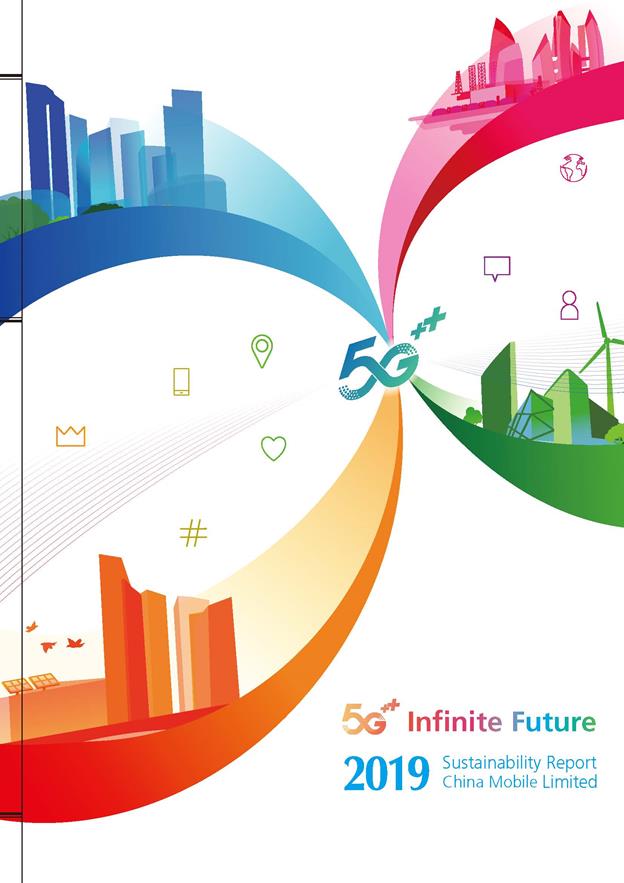
5g+ 2019 Infinite Future Sustainability Report China Mobile Limited
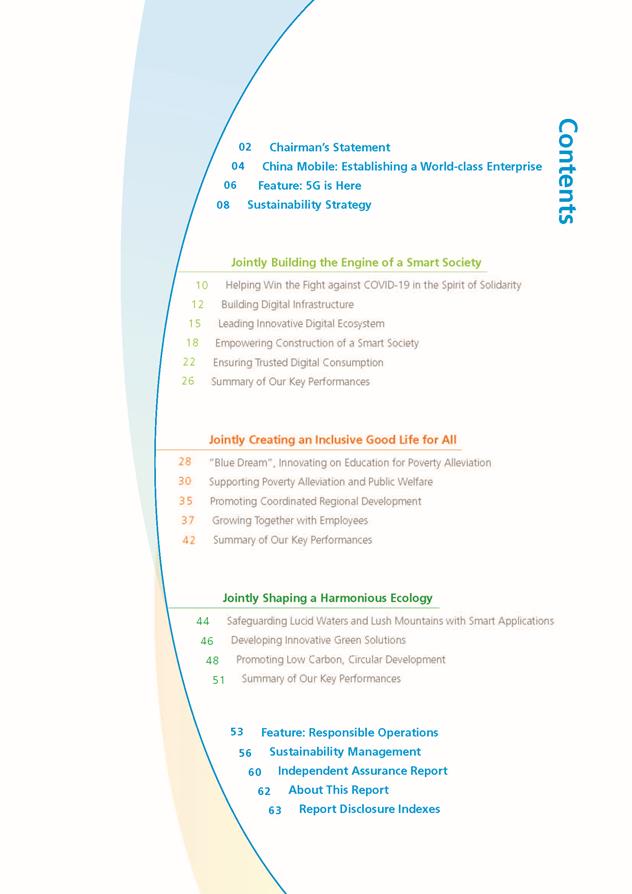
02 04 06 08 10 12 15 18 22 26 28 30 35 37 42 44 46 48 51 53 56 60 62 63 Chairman’s Statement China Mobile: Establishing a World-class Enterprise Feature: 5G is Here Sustainability Strategy Jointly Building the Engine of a Smart Society Helping Win the Fight against COVID-19 in the Spirit of Solidarity Building Digital Infrastructure Leading Innovative Digital Ecosystem Empowering Construction of a Smart Society Ensuring Trusted Digital Consumption Summary of Our Key Performances Jointly Creating an Inclusive Good Life for All ”Blue Dream”, Innovating on Education for Poverty Alleviation Supporting Poverty Alleviation and Public Welfare Promoting Coordinated Regional Development Growing Together with Employees Summary of Our Key Performances Jointly Shaping a Harmonious Ecology Safeguarding Lucid Waters and Lush Mountains with Smart Applications Developing Innovative Green Solutions Promoting Low Carbon, Circular Development Summary of Our Key Performances Feature: Responsible Operations Sustainability Management Independent Assurance Report About This Report Report Disclosure Indexes Contents
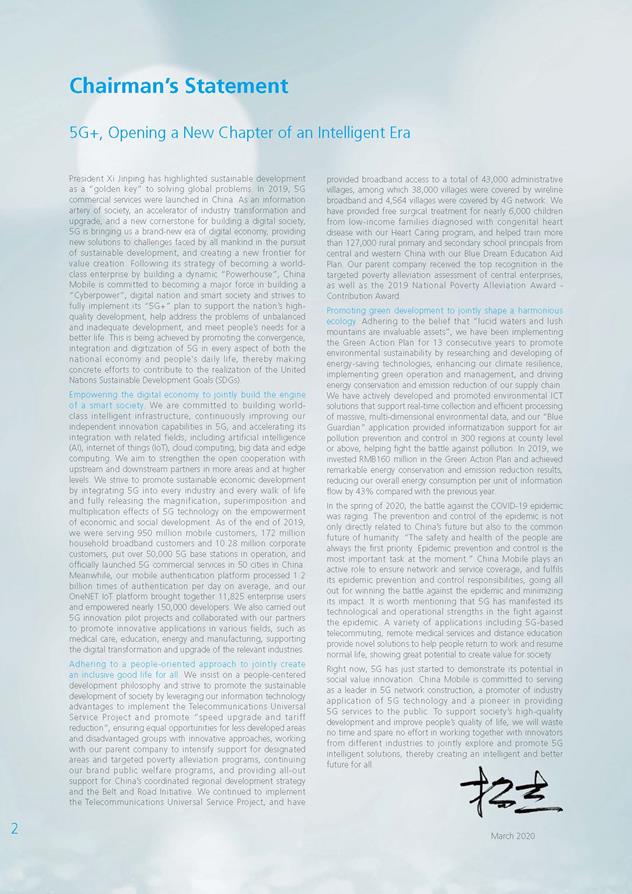
2 March 2020 5G+, Opening a New Chapter of an Intelligent Era President Xi Jinping has highlighted sustainable development as a “golden key” to solving global problems. In 2019, 5G commercial services were launched in China. As an information artery of society, an accelerator of industry transformation and upgrade, and a new cornerstone for building a digital society, 5G is bringing us a brand-new era of digital economy, providing new solutions to challenges faced by all mankind in the pursuit of sustainable development, and creating a new frontier for value creation. Following its strategy of becoming a worldclass enterprise by building a dynamic “Powerhouse”, China Mobile is committed to becoming a major force in building a “Cyberpower”, digital nation and smart society and strives to fully implement its “5G+” plan to support the nation’s highquality development, help address the problems of unbalanced and inadequate development, and meet people’s needs for a better life. This is being achieved by promoting the convergence, integration and digitization of 5G in every aspect of both the national economy and people's daily life, thereby making concrete efforts to contribute to the realization of the United Nations Sustainable Development Goals (SDGs). Empowering the digital economy to jointly build the engine of a smart society. We are committed to building worldclass intelligent infrastructure, continuously improving our independent innovation capabilities in 5G, and accelerating its integration with related fields, including artificial intelligence (AI), internet of things (IoT), cloud computing, big data and edge computing. We aim to strengthen the open cooperation with upstream and downstream partners in more areas and at higher levels. We strive to promote sustainable economic development by integrating 5G into every industry and every walk of life and fully releasing the magnification, superimposition and multiplication effects of 5G technology on the empowerment of economic and social development. As of the end of 2019, we were serving 950 million mobile customers, 172 million household broadband customers and 10.28 million corporate customers, put over 50,000 5G base stations in operation, and officially launched 5G commercial services in 50 cities in China. Meanwhile, our mobile authentication platform processed 1.2 billion times of authentication per day on average, and our OneNET IoT platform brought together 11,825 enterprise users and empowered nearly 150,000 developers. We also carried out 5G innovation pilot projects and collaborated with our partners to promote innovative applications in various fields, such as medical care, education, energy and manufacturing, supporting the digital transformation and upgrade of the relevant industries. Adhering to a people-oriented approach to jointly create an inclusive good life for all. We insist on a people-centered development philosophy and strive to promote the sustainable development of society by leveraging our information technology advantages to implement the Telecommunications Universal Service Project and promote “speed upgrade and tariff reduction”, ensuring equal opportunities for less developed areas and disadvantaged groups with innovative approaches, working with our parent company to intensify support for designated areas and targeted poverty alleviation programs, continuing our brand public welfare programs, and providing all-out support for China’s coordinated regional development strategy and the Belt and Road Initiative. We continued to implement the Telecommunications Universal Service Project, and have Chairman’s Statement provided broadband access to a total of 43,000 administrative villages, among which 38,000 villages were covered by wireline broadband and 4,564 villages were covered by 4G network. We have provided free surgical treatment for nearly 6,000 children from low-income families diagnosed with congenital heart disease with our Heart Caring program, and helped train more than 127,000 rural primary and secondary school principals from central and western China with our Blue Dream Education Aid Plan. Our parent company received the top recognition in the targeted poverty alleviation assessment of central enterprises, as well as the 2019 National Poverty Alleviation Award - Contribution Award. Promoting green development to jointly shape a harmonious ecology. Adhering to the belief that “lucid waters and lush mountains are invaluable assets”, we have been implementing the Green Action Plan for 13 consecutive years to promote environmental sustainability by researching and developing of energy-saving technologies, enhancing our climate resilience, implementing green operation and management, and driving energy conservation and emission reduction of our supply chain. We have actively developed and promoted environmental ICT solutions that support real-time collection and efficient processing of massive, multi-dimensional environmental data, and our “Blue Guardian” application provided informatization support for air pollution prevention and control in 300 regions at county level or above, helping fight the battle against pollution. In 2019, we invested RMB160 million in the Green Action Plan and achieved remarkable energy conservation and emission reduction results, reducing our overall energy consumption per unit of information flow by 43% compared with the previous year. In the spring of 2020, the battle against the COVID-19 epidemic was raging. The prevention and control of the epidemic is not only directly related to China’s future but also to the common future of humanity. “The safety and health of the people are always the first priority. Epidemic prevention and control is the most important task at the moment.” China Mobile plays an active role to ensure network and service coverage, and fulfils its epidemic prevention and control responsibilities, going all out for winning the battle against the epidemic and minimizing its impact. It is worth mentioning that 5G has manifested its technological and operational strengths in the fight against the epidemic. A variety of applications including 5G-based telecommuting, remote medical services and distance education provide novel solutions to help people return to work and resume normal life, showing great potential to create value for society. Right now, 5G has just started to demonstrate its potential in social value innovation. China Mobile is committed to serving as a leader in 5G network construction, a promoter of industry application of 5G technology and a pioneer in providing 5G services to the public. To support society’s high-quality development and improve people’s quality of life, we will waste no time and spare no effort in working together with innovators from different industries to jointly explore and promote 5G intelligent solutions, thereby creating an intelligent and better future for all. 2
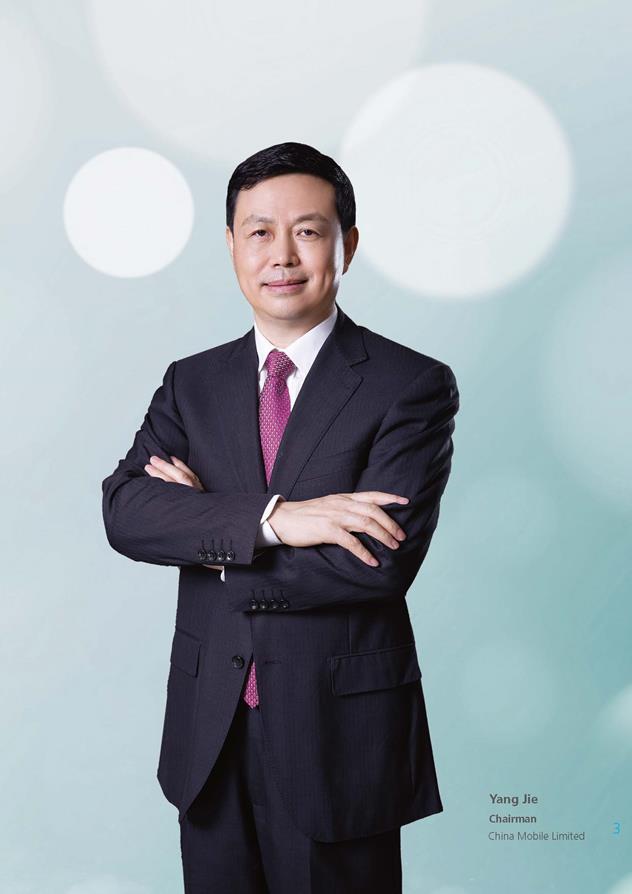
3 China Mobile Limited Chairman Yang Jie 3
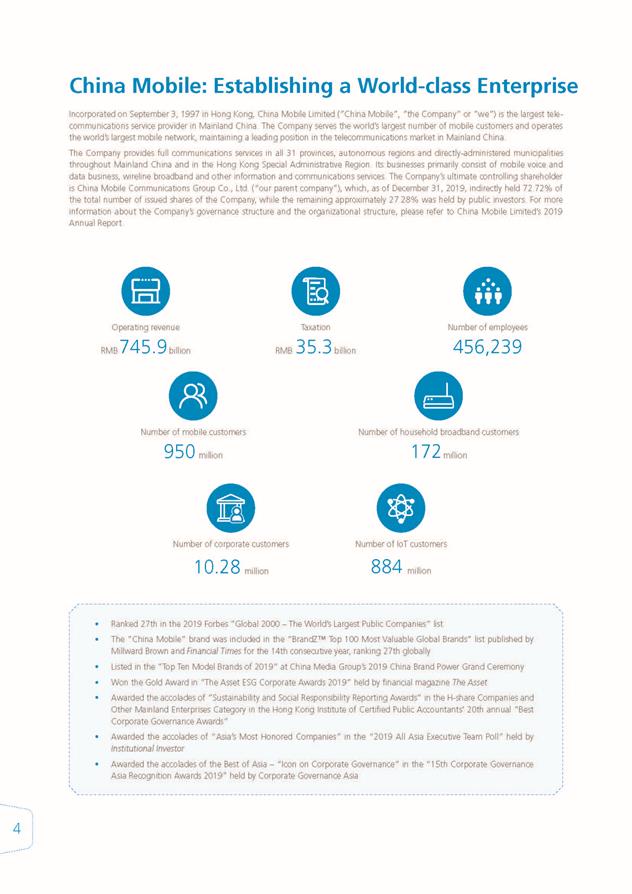
4 China Mobile: Establishing a World-class Enterprise Incorporated on September 3, 1997 in Hong Kong, China Mobile Limited (”China Mobile”, ”the Company” or ”we”) is the largest telecommunications service provider in Mainland China. The Company serves the world’s largest number of mobile customers and operates the world’s largest mobile network, maintaining a leading position in the telecommunications market in Mainland China. The Company provides full communications services in all 31 provinces, autonomous regions and directly-administered municipalities throughout Mainland China and in the Hong Kong Special Administrative Region. Its businesses primarily consist of mobile voice and data business, wireline broadband and other information and communications services. The Company’s ultimate controlling shareholder is China Mobile Communications Group Co., Ltd. (“our parent company”), which, as of December 31, 2019, indirectly held 72.72% of the total number of issued shares of the Company, while the remaining approximately 27.28% was held by public investors. For more information about the Company’s governance structure and the organizational structure, please refer to China Mobile Limited’s 2019 Annual Report. Ranked 27th in the 2019 Forbes ”Global 2000 – The World’s Largest Public Companies” list The ”China Mobile” brand was included in the ”BrandZ™ Top 100 Most Valuable Global Brands” list published by Millward Brown and Financial Times for the 14th consecutive year, ranking 27th globally Listed in the ”Top Ten Model Brands of 2019” at China Media Group’s 2019 China Brand Power Grand Ceremony Won the Gold Award in ”The Asset ESG Corporate Awards 2019” held by financial magazine The Asset Awarded the accolades of ”Sustainability and Social Responsibility Reporting Awards” in the H-share Companies and Other Mainland Enterprises Category in the Hong Kong Institute of Certified Public Accountants’ 20th annual ”Best Corporate Governance Awards” Awarded the accolades of “Asia’s Most Honored Companies” in the “2019 All Asia Executive Team Poll” held by Institutional Investor Awarded the accolades of the Best of Asia – “Icon on Corporate Governance” in the “15th Corporate Governance Asia Recognition Awards 2019” held by Corporate Governance Asia Operating revenue Taxation Number of household broadband customers 172million Number of mobile customers 950 million Number of corporate customers 10.28 million Number of employees 456,239 Number of IoT customers 884 million RMB745.9billion RMB 35.3billion
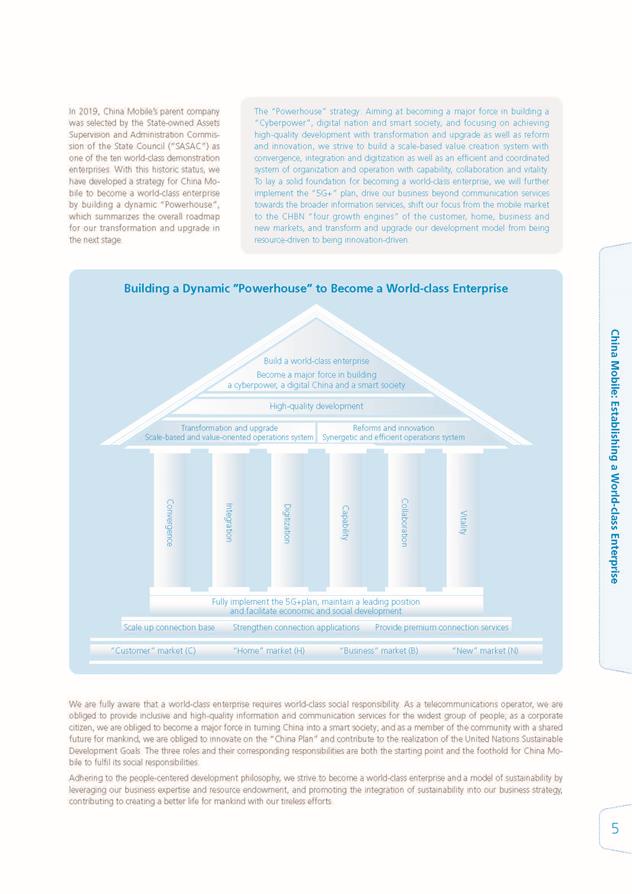
5 China Mobile: Establishing a World-class Enterprise In 2019, China Mobile’s parent company was selected by the State-owned Assets Supervision and Administration Commission of the State Council (“SASAC”) as one of the ten world-class demonstration enterprises. With this historic status, we have developed a strategy for China Mobile to become a world-class enterprise by building a dynamic “Powerhouse”, which summarizes the overall roadmap for our transformation and upgrade in the next stage. The “Powerhouse” strategy: Aiming at becoming a major force in building a “Cyberpower”, digital nation and smart society, and focusing on achieving high-quality development with transformation and upgrade as well as reform and innovation, we strive to build a scale-based value creation system with convergence, integration and digitization as well as an efficient and coordinated system of organization and operation with capability, collaboration and vitality. To lay a solid foundation for becoming a world-class enterprise, we will further implement the “5G+” plan, drive our business beyond communication services towards the broader information services, shift our focus from the mobile market to the CHBN “four growth engines” of the customer, home, business and new markets, and transform and upgrade our development model from being resource-driven to being innovation-driven. We are fully aware that a world-class enterprise requires world-class social responsibility. As a telecommunications operator, we are obliged to provide inclusive and high-quality information and communication services for the widest group of people; as a corporate citizen, we are obliged to become a major force in turning China into a smart society; and as a member of the community with a shared future for mankind, we are obliged to innovate on the “China Plan” and contribute to the realization of the United Nations Sustainable Development Goals. The three roles and their corresponding responsibilities are both the starting point and the foothold for China Mobile to fulfil its social responsibilities. Adhering to the people-centered development philosophy, we strive to become a world-class enterprise and a model of sustainability by leveraging our business expertise and resource endowment, and promoting the integration of sustainability into our business strategy, contributing to creating a better life for mankind with our tireless efforts. Building a Dynamic ”Powerhouse” to Become a World-class Enterprise Reforms and innovation Synergetic and efficient operations system Transformation and upgrade Scale-based and value-oriented operations system High-quality development Build a world-class enterprise Become a major force in building a cyberpower, a digital China and a smart society Convergence Integration Digitization Capability Collaboration Vitality “Customer” market (C) “Home” market (H) “Business” market (B) “New” market (N) Scale up connection base Strengthen connection applications Provide premium connection services Fully implement the 5G+plan, maintain a leading position and facilitate economic and social development
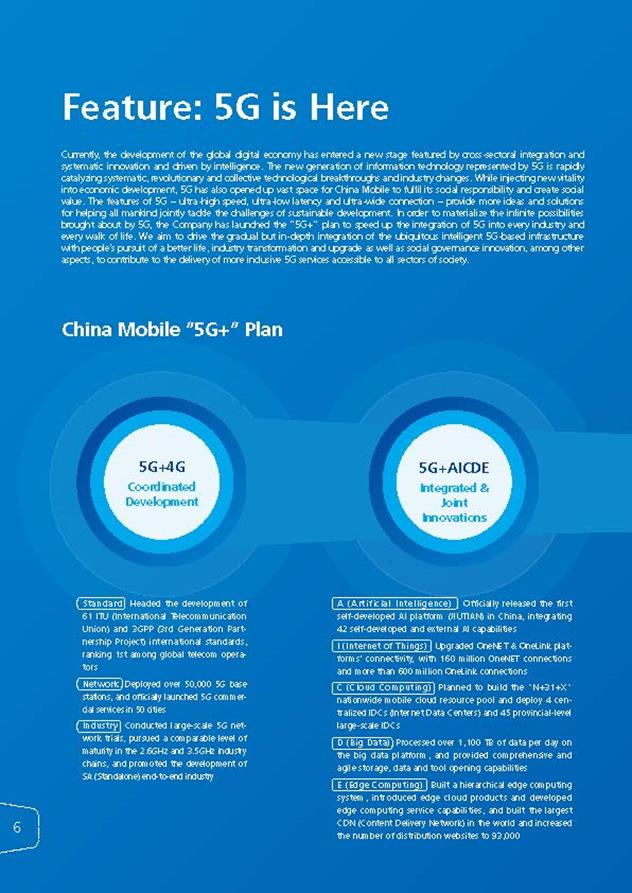
6 Feature: 5G is Here Currently, the development of the global digital economy has entered a new stage featured by cross-sectoral integration and systematic innovation and driven by intelligence. The new generation of information technology represented by 5G is rapidly catalyzing systematic, revolutionary and collective technological breakthroughs and industry changes. While injecting new vitality into economic development, 5G has also opened up vast space for China Mobile to fulfil its social responsibility and create social value. The features of 5G – ultra-high speed, ultra-low latency and ultra-wide connection – provide more ideas and solutions for helping all mankind jointly tackle the challenges of sustainable development. In order to materialize the infinite possibilities brought about by 5G, the Company has launched the “5G+” plan to speed up the integration of 5G into every industry and every walk of life. We aim to drive the gradual but in-depth integration of the ubiquitous intelligent 5G-based infrastructure with people’s pursuit of a better life, industry transformation and upgrade as well as social governance innovation, among other aspects, to contribute to the delivery of more inclusive 5G services accessible to all sectors of society. China Mobile ”5G+” Plan 5G+4G Coordinated Development 5G+AICDE Integrated & Joint Innovations Standard Headed the development of 61 ITU (International Telecommunication Union) and 3GPP (3rd Generation Partnership Project) international standards, ranking 1st among global telecom operators Network Deployed over 50,000 5G base stations, and officially launched 5G commercial services in 50 cities Industry Conducted large-scale 5G network trials, pursued a comparable level of maturity in the 2.6GHz and 3.5GHz industry chains, and promoted the development of SA (Standalone) end-to-end industry A (Artificial Intelligence) Officially released the first self-developed AI platform (JIUTIAN) in China, integrating 42 self-developed and external AI capabilities I (Internet of Things) Upgraded OneNET & OneLink platforms’ connectivity, with 160 million OneNET connections and more than 600 million OneLink connections C (Cloud Computing) Planned to build the “N+31+X” nationwide mobile cloud resource pool and deploy 4 centralized IDCs (Internet Data Centers) and 45 provincial-level large-scale IDCs D (Big Data) Processed over 1,100 TB of data per day on the big data platform, and provided comprehensive and agile storage, data and tool opening capabilities E (Edge Computing) Built a hierarchical edge computing system, introduced edge cloud products and developed edge computing service capabilities, and built the largest CDN (Content Delivery Network) in the world and increased the number of distribution websites to 93,000 6
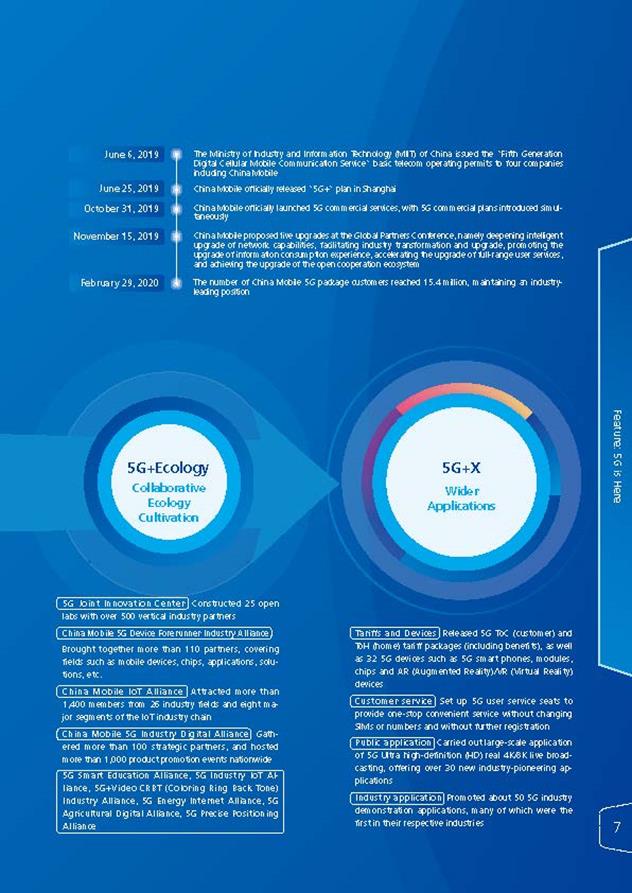
Feature: 5G is Here 5G+Ecology Collaborative Ecology Cultivation 5G+X Wider Applications June 6, 2019 June 25, 2019 October 31, 2019 November 15, 2019 February 29, 2020 The Ministry of Industry and Information Technology (MIIT) of China issued the “Fifth Generation Digital Cellular Mobile Communication Service” basic telecom operating permits to four companies including China Mobile China Mobile proposed five upgrades at the Global Partners Conference, namely deepening intelligent upgrade of network capabilities, facilitating industry transformation and upgrade, promoting the upgrade of information consumption experience, accelerating the upgrade of full-range user services, and achieving the upgrade of the open cooperation ecosystem China Mobile officially released ”5G+” plan in Shanghai China Mobile officially launched 5G commercial services, with 5G commercial plans introduced simultaneously The number of China Mobile 5G package customers reached 15.4 million, maintaining an industryleading position Tariffs and Devices Released 5G ToC (customer) and ToH (home) tariff packages (including benefits), as well as 32 5G devices such as 5G smart phones, modules, chips and AR (Augmented Reality)/VR (Virtual Reality) devices Customer service Set up 5G user service seats to provide one-stop convenient service without changing SIMs or numbers and without further registration Public application Carried out large-scale application of 5G Ultra high-definition (HD) real 4K/8K live broadcasting, offering over 30 new industry-pioneering applications Industry application Promoted about 50 5G industry demonstration applications, many of which were the first in their respective industries 5G Joint Innovation Center Constructed 25 open labs with over 500 vertical industry partners China Mobile 5G Device Forerunner Industry Alliance Brought together more than 110 partners, covering fields such as mobile devices, chips, applications, solutions, etc. China Mobile IoT Alliance Attracted more than 1,400 members from 26 industry fields and eight major segments of the IoT industry chain China Mobile 5G Industry Digital Alliance Gathered more than 100 strategic partners, and hosted more than 1,000 product promotion events nationwide 5G Smart Education Alliance, 5G Industry IoT Alliance, 5G+Video CRBT (Coloring Ring Back Tone) Industry Alliance, 5G Energy Internet Alliance, 5G Agricultural Digital Alliance, 5G Precise Positioning Alliance 7
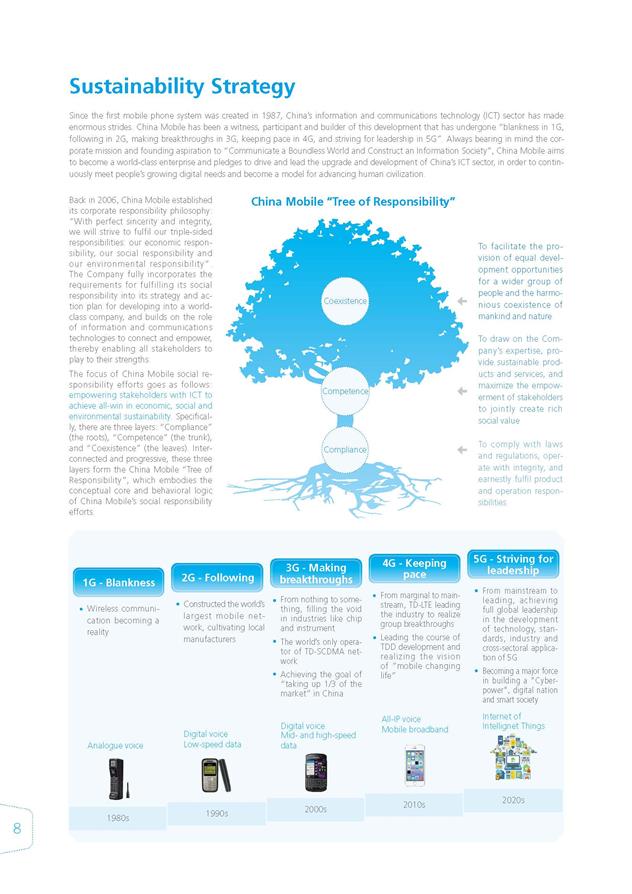
8 Sustainability Strategy Since the first mobile phone system was created in 1987, China’s information and communications technology (ICT) sector has made enormous strides. China Mobile has been a witness, participant and builder of this development that has undergone “blankness in 1G, following in 2G, making breakthroughs in 3G, keeping pace in 4G, and striving for leadership in 5G”. Always bearing in mind the corporate mission and founding aspiration to “Communicate a Boundless World and Construct an Information Society”, China Mobile aims to become a world-class enterprise and pledges to drive and lead the upgrade and development of China’s ICT sector, in order to continuously meet people’s growing digital needs and become a model for advancing human civilization. Back in 2006, China Mobile established its corporate responsibility philosophy: “With perfect sincerity and integrity, we will strive to fulfil our triple-sided responsibilities: our economic responsibility, our social responsibility and our environmental responsibility”. The Company fully incorporates the requirements for fulfilling its social responsibility into its strategy and action plan for developing into a worldclass company, and builds on the role of information and communications technologies to connect and empower, thereby enabling all stakeholders to play to their strengths. The focus of China Mobile social responsibility efforts goes as follows: empowering stakeholders with ICT to achieve all-win in economic, social and environmental sustainability. Specifically, there are three layers: “Compliance” (the roots), “Competence” (the trunk), and “Coexistence” (the leaves). Interconnected and progressive, these three layers form the China Mobile “Tree of Responsibility”, which embodies the conceptual core and behavioral logic of China Mobile’s social responsibility efforts. China Mobile “Tree of Responsibility” Coexistence Competence Compliance To comply with laws and regulations, operate with integrity, and earnestly fulfil product and operation responsibilities To draw on the Company’s expertise, provide sustainable products and services, and maximize the empowerment of stakeholders to jointly create rich social value To facilitate the provision of equal development opportunities for a wider group of people and the harmonious coexistence of mankind and nature 1G - Blankness Wireless communication becoming a reality Constructed the world’s largest mobile network, cultivating local manufacturers From mainstream to leading, achieving full global leadership in the development of technology, standards, industry and cross-sectoral application of 5G Becoming a major force in building a “Cyberpower”, digital nation and smart society From marginal to mainstream, TD-LTE leading the industry to realize group breakthroughs Leading the course of TDD development and realizing the vision of ”mobile changing life” From nothing to something, filling the void in industries like chip and instrument The world’s only operator of TD-SCDMA network Achieving the goal of “taking up 1/3 of the market” in China 2G - Following 3G - Making breakthroughs 4G - Keeping pace 5G - Striving for leadership 1980s Analogue voice 1990s Digital voice Low-speed data 2000s Digital voice Mid- and high-speed data 2010s All-IP voice Mobile broadband 2020s Internet of Intellignet Things
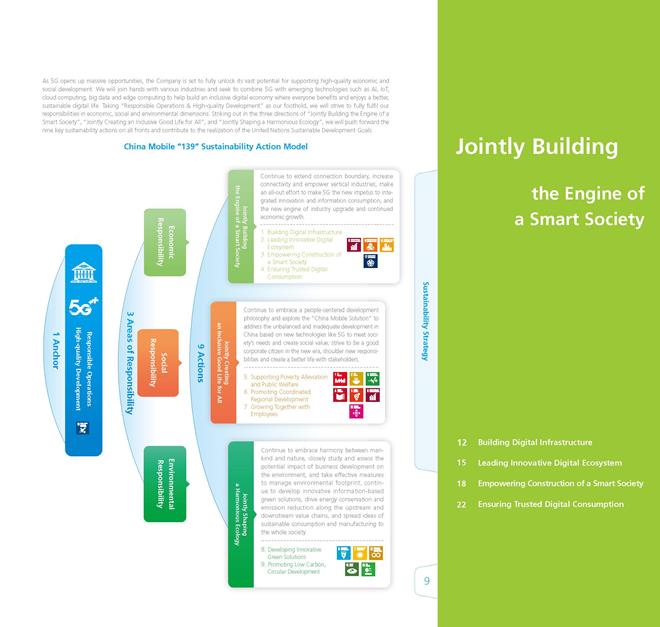
As 5G opens up massive opportunities, the Company is set to fully unlock its vast potential for supporting high-quality economic and social development. We will join hands with various industries and seek to combine 5G with emerging technologies such as AI, IoT, cloud computing, big data and edge computing to help build an inclusive digital economy where everyone benefits and enjoys a better, sustainable digital life. Taking “Responsible Operations & High-quality Development” as our foothold, we will strive to fully fulfil our responsibilities in economic, social and environmental dimensions. Striking out in the three directions of “Jointly Building the Engine of a Smart Society”, “Jointly Creating an Inclusive Good Life for All”, and “Jointly Shaping a Harmonious Ecology”, we will push forward the nine key sustainability actions on all fronts and contribute to the realization of the United Nations Sustainable Development Goals. China Mobile “139” Sustainability Action Model the Engine of a Smart Society Jointly Building Building Digital Infrastructure Leading Innovative Digital Ecosystem Empowering Construction of a Smart Society 22 Ensuring Trusted Digital Consumption 18 15 12 Continue to embrace harmony between mankind and nature, closely study and assess the potential impact of business development on the environment, and take effective measures to manage environmental footprint; continue to develop innovative information-based green solutions, drive energy conservation and emission reduction along the upstream and downstream value chains, and spread ideas of sustainable consumption and manufacturing to the whole society. 1 Anchor 3 Areas of Responsibility 9 Actions Responsible Operations High-quality Development Jointly Building the Engine of a Smart Society Jointly Creating an Inclusive Good Life for All Jointly Shaping a Harmonious Ecology Economic Responsibility Environmental Social Responsibility Responsibility Continue to extend connection boundary, increase connectivity and empower vertical industries; make an all-out effort to make 5G the new impetus to integrated innovation and information consumption, and the new engine of industry upgrade and continued economic growth. Continue to embrace a people-centered development philosophy and explore the “China Mobile Solution” to address the unbalanced and inadequate development in China based on new technologies like 5G to meet society’s needs and create social value; strive to be a good corporate citizen in the new era, shoulder new responsibilities and create a better life with stakeholders. 1. Building Digital Infrastructure 2. Leading Innovative Digital Ecosystem 3. Empowering Construction of a Smart Society 4. Ensuring Trusted Digital Consumption 5. Supporting Poverty Alleviation and Public Welfare 6. Promoting Coordinated Regional Development 7. Growing Together with Employees 8. Developing Innovative Green Solutions 9. Promoting Low Carbon, Circular Development 9
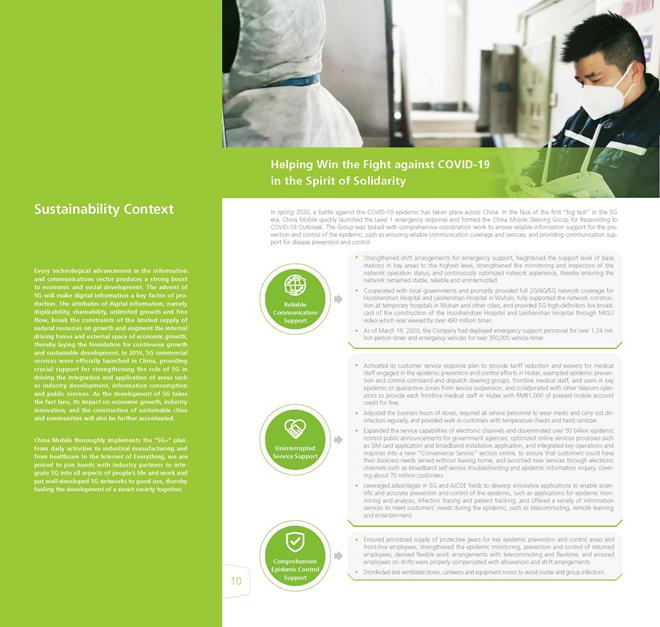
Sustainability Context Every technological advancement in the information and communications sector produces a strong boost to economic and social development. The advent of 5G will make digital information a key factor of production. The attributes of digital information, namely duplicability, shareability, unlimited growth and free flow, break the constraints of the limited supply of natural resources on growth and augment the internal driving forces and external space of economic growth, thereby laying the foundation for continuous growth and sustainable development. In 2019, 5G commercial services were officially launched in China, providing crucial support for strengthening the role of 5G in driving the integration and application of areas such as industry development, information consumption and public services. As the development of 5G takes the fast lane, its impact on economic growth, industry innovation, and the construction of sustainable cities and communities will also be further accentuated. China Mobile thoroughly implements the ”5G+” plan. From daily activities to industrial manufacturing and from healthcare to the Internet of Everything, we are poised to join hands with industry partners to integrate 5G into all aspects of people’s life and work and put well-developed 5G networks to good use, thereby fueling the development of a smart society together. Helping Win the Fight against COVID-19 in the Spirit of Solidarity In spring 2020, a battle against the COVID-19 epidemic has taken place across China. In the face of the first “big test” in the 5G era, China Mobile quickly launched the Level 1 emergency response and formed the China Mobile Steering Group for Responding to COVID-19 Outbreak. The Group was tasked with comprehensive coordination work to ensure reliable information support for the prevention and control of the epidemic, such as ensuring reliable communication coverage and services, and providing communication support for disease prevention and control. Reliable Communication Support Strengthened shift arrangements for emergency support, heightened the support level of base stations in key areas to the highest level, strengthened the monitoring and inspection of the network operation status, and continuously optimized network experience, thereby ensuring the network remained stable, reliable and uninterrupted. Cooperated with local governments and promptly provided full 2G/4G/5G network coverage for Huoshenshan Hospital and Leishenshan Hospital in Wuhan, fully supported the network construction at temporary hospitals in Wuhan and other cities, and provided 5G high-definition live broadcast of the construction of the Huoshenshan Hospital and Leishenshan Hospital through MIGU video which was viewed by over 490 million times. As of March 16, 2020, the Company had deployed emergency support personnel for over 1.24 million person-times and emergency vehicles for over 350,000 vehicle-times. Ensured prioritized supply of protective gears for key epidemic prevention and control areas and front-line employees, strengthened the epidemic monitoring, prevention and control of returned employees, devised flexible work arrangements with telecommuting and flexitime, and ensured employees on shifts were properly compensated with allowances and shift arrangements. Disinfected and ventilated stores, canteens and equipment rooms to avoid cluster and group infections. Activated its customer service response plan to provide tariff reduction and waivers for medical staff engaged in the epidemic prevention and control efforts in Hubei; exempted epidemic prevention and control command and dispatch steering groups, frontline medical staff, and users in key epidemic or quarantine zones from service suspension; and collaborated with other telecom operators to provide each frontline medical staff in Hubei with RMB1,000 of prepaid mobile account credit for free. Adjusted the business hours of stores, required all service personnel to wear masks and carry out disinfection regularly, and provided walk-in customers with temperature checks and hand sanitizer. Expanded the service capabilities of electronic channels and disseminated over 50 billion epidemic control public announcements for government agencies; optimized online services processes such as SIM card application and broadband installation application, and integrated key operations and inquiries into a new “Convenience Service” section online, to ensure that customers could have their business needs served without leaving home; and launched new services through electronic channels such as broadband self-service troubleshooting and epidemic information inquiry, covering about 70 million customers. Leveraged advantages in 5G and AICDE fields to develop innovative applications to enable scientific and accurate prevention and control of the epidemic, such as applications for epidemic monitoring and analysis, infection tracing and patient tracking; and offered a variety of information services to meet customers’ needs during the epidemic, such as telecommuting, remote learning and entertainment. Uninterrupted Service Support Comprehensive Epidemic Control Support
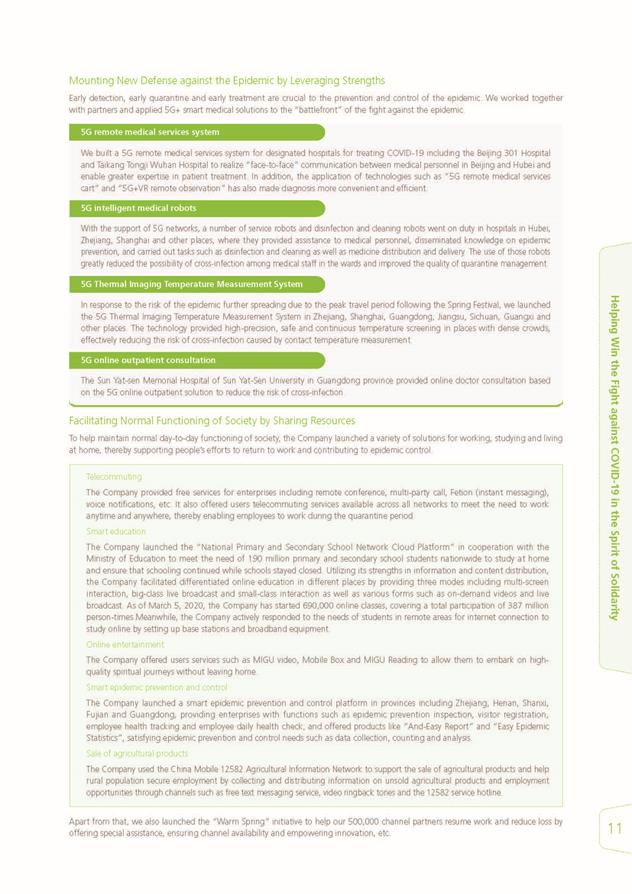
Mounting New Defense against the Epidemic by Leveraging Strengths Early detection, early quarantine and early treatment are crucial to the prevention and control of the epidemic. We worked together with partners and applied 5G+ smart medical solutions to the “battlefront” of the fight against the epidemic. Facilitating Normal Functioning of Society by Sharing Resources To help maintain normal day-to-day functioning of society, the Company launched a variety of solutions for working, studying and living at home, thereby supporting people’s efforts to return to work and contributing to epidemic control. Apart from that, we also launched the “Warm Spring” initiative to help our 500,000 channel partners resume work and reduce loss by offering special assistance, ensuring channel availability and empowering innovation, etc. 5G Thermal Imaging Temperature Measurement System 5G online outpatient consultation 5G intelligent medical robots With the support of 5G networks, a number of service robots and disinfection and cleaning robots went on duty in hospitals in Hubei, Zhejiang, Shanghai and other places, where they provided assistance to medical personnel, disseminated knowledge on epidemic prevention, and carried out tasks such as disinfection and cleaning as well as medicine distribution and delivery. The use of those robots greatly reduced the possibility of cross-infection among medical staff in the wards and improved the quality of quarantine management. In response to the risk of the epidemic further spreading due to the peak travel period following the Spring Festival, we launched the 5G Thermal Imaging Temperature Measurement System in Zhejiang, Shanghai, Guangdong, Jiangsu, Sichuan, Guangxi and other places. The technology provided high-precision, safe and continuous temperature screening in places with dense crowds, effectively reducing the risk of cross-infection caused by contact temperature measurement. The Sun Yat-sen Memorial Hospital of Sun Yat-Sen University in Guangdong province provided online doctor consultation based on the 5G online outpatient solution to reduce the risk of cross-infection.5G remote medical services system We built a 5G remote medical services system for designated hospitals for treating COVID-19 including the Beijing 301 Hospital and Taikang Tongji Wuhan Hospital to realize “face-to-face” communication between medical personnel in Beijing and Hubei and enable greater expertise in patient treatment. In addition, the application of technologies such as “5G remote medical services cart” and “5G+VR remote observation” has also made diagnosis more convenient and efficient.Telecommuting The Company provided free services for enterprises including remote conference, multi-party call, Fetion (instant messaging), voice notifications, etc. It also offered users telecommuting services available across all networks to meet the need to work anytime and anywhere, thereby enabling employees to work during the quarantine period. Smart education The Company launched the “National Primary and Secondary School Network Cloud Platform” in cooperation with the Ministry of Education to meet the need of 190 million primary and secondary school students nationwide to study at home and ensure that schooling continued while schools stayed closed. Utilizing its strengths in information and content distribution, the Company facilitated differentiated online education in different places by providing three modes including multi-screen interaction, big-class live broadcast and small-class interaction as well as various forms such as on-demand videos and live broadcast. As of March 5, 2020, the Company has started 690,000 online classes, covering a total participation of 387 million person-times.Meanwhile, the Company actively responded to the needs of students in remote areas for internet connection to study online by setting up base stations and broadband equipment. Online entertainment The Company offered users services such as MIGU video, Mobile Box and MIGU Reading to allow them to embark on highquality spiritual journeys without leaving home. Smart epidemic prevention and control The Company launched a smart epidemic prevention and control platform in provinces including Zhejiang, Henan, Shanxi, Fujian and Guangdong, providing enterprises with functions such as epidemic prevention inspection, visitor registration, employee health tracking and employee daily health check; and offered products like “And-Easy Report” and “Easy Epidemic Statistics”, satisfying epidemic prevention and control needs such as data collection, counting and analysis. Sale of agricultural products The Company used the China Mobile 12582 Agricultural Information Network to support the sale of agricultural products and help rural population secure employment by collecting and distributing information on unsold agricultural products and employment opportunities through channels such as free text messaging service, video ringback tones and the 12582 service hotline.Helping Win the Fight against COVID-19 in the Spirit of Solidarity
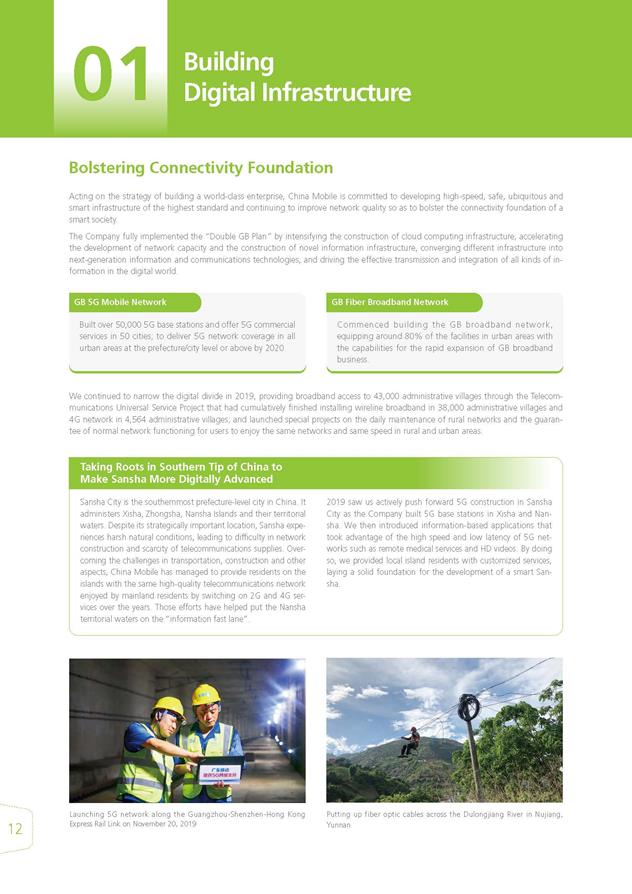
01 Building Digital Infrastructure Acting on the strategy of building a world-class enterprise, China Mobile is committed to developing high-speed, safe, ubiquitous and smart infrastructure of the highest standard and continuing to improve network quality so as to bolster the connectivity foundation of a smart society. Bolstering Connectivity Foundation Taking Roots in Southern Tip of China to Make Sansha More Digitally Advanced The Company fully implemented the “Double GB Plan” by intensifying the construction of cloud computing infrastructure, accelerating the development of network capacity and the construction of novel information infrastructure, converging different infrastructure into next-generation information and communications technologies, and driving the effective transmission and integration of all kinds of information in the digital world. We continued to narrow the digital divide in 2019, providing broadband access to 43,000 administrative villages through the Telecommunications Universal Service Project that had cumulatively finished installing wireline broadband in 38,000 administrative villages and 4G network in 4,564 administrative villages; and launched special projects on the daily maintenance of rural networks and the guarantee of normal network functioning for users to enjoy the same networks and same speed in rural and urban areas. Sansha City is the southernmost prefecture-level city in China. It administers Xisha, Zhongsha, Nansha Islands and their territorial waters. Despite its strategically important location, Sansha experiences harsh natural conditions, leading to difficulty in network construction and scarcity of telecommunications supplies. Overcoming the challenges in transportation, construction and other aspects, China Mobile has managed to provide residents on the islands with the same high-quality telecommunications network enjoyed by mainland residents by switching on 2G and 4G services over the years. Those efforts have helped put the Nansha territorial waters on the “information fast lane”. 2019 saw us actively push forward 5G construction in Sansha City as the Company built 5G base stations in Xisha and Nansha. We then introduced information-based applications that took advantage of the high speed and low latency of 5G networks such as remote medical services and HD videos. By doing so, we provided local island residents with customized services, laying a solid foundation for the development of a smart Sansha. Launching 5G network along the Guangzhou-Shenzhen-Hong Kong Express Rail Link on November 20, 2019 Putting up fiber optic cables across the Dulongjiang River in Nujiang, Yunnan Built over 50,000 5G base stations and offer 5G commercial services in 50 cities; to deliver 5G network coverage in all urban areas at the prefecture/city level or above by 2020. Commenced building the GB broadband network, equipping around 80% of the facilities in urban areas with the capabilities for the rapid expansion of GB broadband business. GB 5G Mobile Network GB Fiber Broadband Netwo
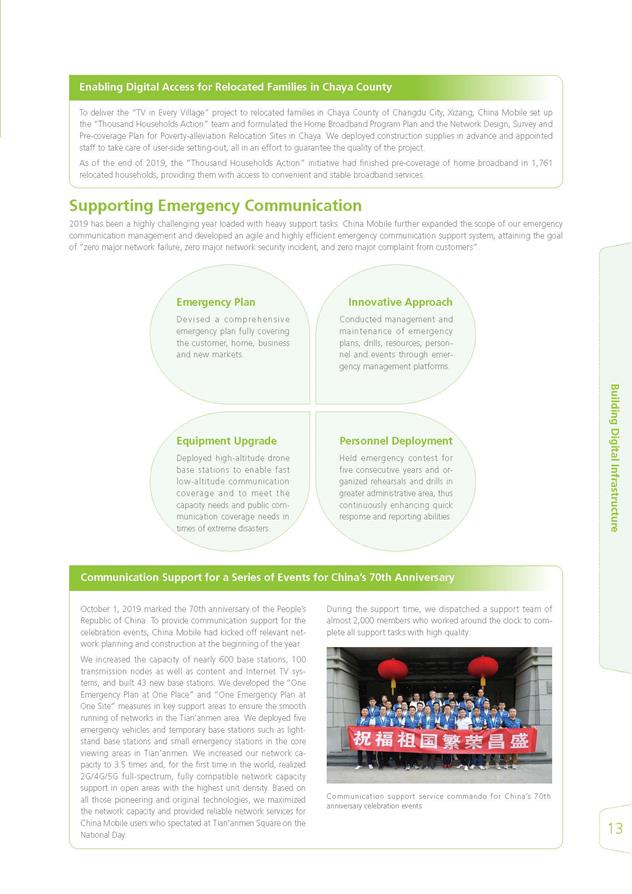
Building Digital Infrastructure 13 October 1, 2019 marked the 70th anniversary of the People’s Republic of China. To provide communication support for the celebration events, China Mobile had kicked off relevant network planning and construction at the beginning of the year. We increased the capacity of nearly 600 base stations, 100 transmission nodes as well as content and Internet TV systems, and built 43 new base stations. We developed the “One Emergency Plan at One Place” and “One Emergency Plan at One Site” measures in key support areas to ensure the smooth running of networks in the Tian’anmen area. We deployed five emergency vehicles and temporary base stations such as lightstand base stations and small emergency stations in the core viewing areas in Tian’anmen. We increased our network capacity to 3.5 times and, for the first time in the world, realized 2G/4G/5G full-spectrum, fully compatible network capacity support in open areas with the highest unit density. Based on all those pioneering and original technologies, we maximized the network capacity and provided reliable network services for China Mobile users who spectated at Tian’anmen Square on the National Day. To deliver the “TV in Every Village” project to relocated families in Chaya County of Changdu City, Xizang, China Mobile set up the “Thousand Households Action” team and formulated the Home Broadband Program Plan and the Network Design, Survey and Pre-coverage Plan for Poverty-alleviation Relocation Sites in Chaya. We deployed construction supplies in advance and appointed staff to take care of user-side setting-out, all in an effort to guarantee the quality of the project. As of the end of 2019, the ”Thousand Households Action” initiative had finished pre-coverage of home broadband in 1,761 relocated households, providing them with access to convenient and stable broadband services. Communication Support for a Series of Events for China’s 70th Anniversary Enabling Digital Access for Relocated Families in Chaya County During the support time, we dispatched a support team of almost 2,000 members who worked around the clock to complete all support tasks with high quality. 2019 has been a highly challenging year loaded with heavy support tasks. China Mobile further expanded the scope of our emergency communication management and developed an agile and highly efficient emergency communication support system, attaining the goal of ”zero major network failure, zero major network security incident, and zero major complaint from customers”. Supporting Emergency Communication Communication support service commando for China’s 70th anniversary celebration events Devised a comprehensive emergency plan fully covering the customer, home, business and new markets. Emergency Plan Deployed high-altitude drone base stations to enable fast low-altitude communication coverage and to meet the capacity needs and public communication coverage needs in times of extreme disasters. Equipment Upgrade Conducted management and maintenance of emergency plans, drills, resources, personnel and events through emergency management platforms. Innovative Approach Held emergency contest for five consecutive years and organized rehearsals and drills in greater administrative area, thus continuously enhancing quick response and reporting abilities. Personnel Deployment
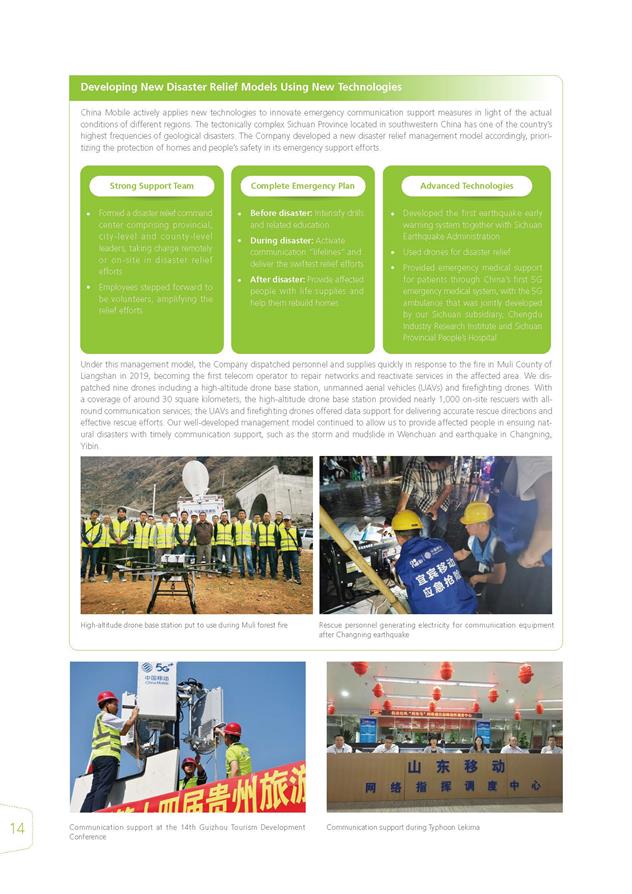
14 China Mobile actively applies new technologies to innovate emergency communication support measures in light of the actual conditions of different regions. The tectonically complex Sichuan Province located in southwestern China has one of the country’s highest frequencies of geological disasters. The Company developed a new disaster relief management model accordingly, prioritizing the protection of homes and people’s safety in its emergency support efforts. Developing New Disaster Relief Models Using New Technologies Under this management model, the Company dispatched personnel and supplies quickly in response to the fire in Muli County of Liangshan in 2019, becoming the first telecom operator to repair networks and reactivate services in the affected area. We dispatched nine drones including a high-altitude drone base station, unmanned aerial vehicles (UAVs) and firefighting drones. With a coverage of around 30 square kilometers, the high-altitude drone base station provided nearly 1,000 on-site rescuers with allround communication services; the UAVs and firefighting drones offered data support for delivering accurate rescue directions and effective rescue efforts. Our well-developed management model continued to allow us to provide affected people in ensuing natural disasters with timely communication support, such as the storm and mudslide in Wenchuan and earthquake in Changning, Yibin. High-altitude drone base station put to use during Muli forest fire Rescue personnel generating electricity for communication equipment after Changning earthquake Communication support at the 14th Guizhou Tourism Development Conference Communication support during Typhoon Lekima Strong Support Team Complete Emergency Plan Advanced Technologies Formed a disaster relief command center comprising provincial, city-level and county-level leaders, taking charge remotely or on-site in disaster relief efforts Employees stepped forward to be volunteers, amplifying the relief efforts Before disaster: Intensify drills and related education During disaster: Activate communication “lifelines” and deliver the swiftest relief efforts After disaster: Provide affected people with life supplies and help them rebuild homes Developed the first earthquake early warning system together with Sichuan Earthquake Administration Used drones for disaster relief Provided emergency medical support for patients through China’s first 5G emergency medical system, with the 5G ambulance that was jointly developed by our Sichuan subsidiary, Chengdu Industry Research Institute and Sichuan Provincial People’s Hospital
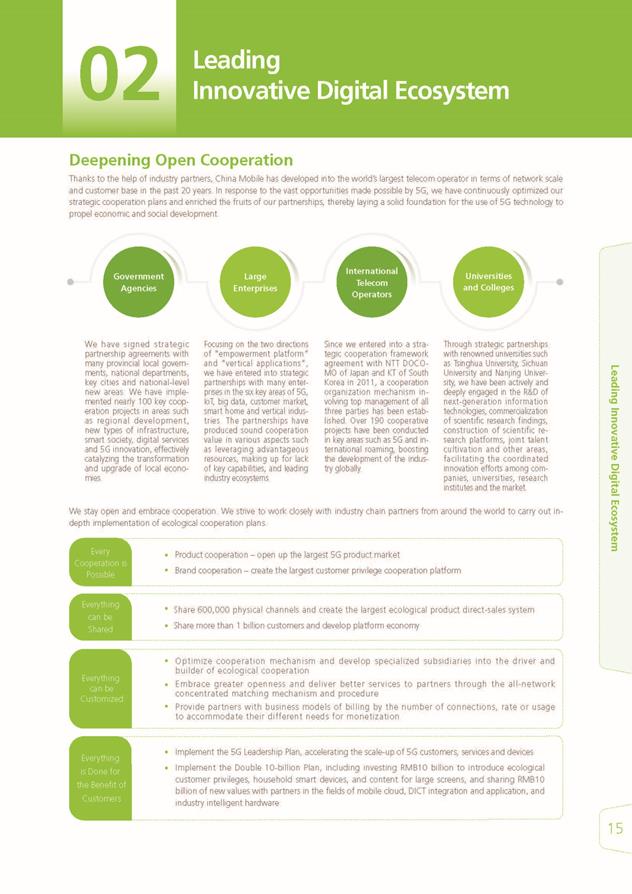
02 Leading Innovative Digital Ecosystem 15 Deepening Open Cooperation Thanks to the help of industry partners, China Mobile has developed into the world’s largest telecom operator in terms of network scale and customer base in the past 20 years. In response to the vast opportunities made possible by 5G, we have continuously optimized our strategic cooperation plans and enriched the fruits of our partnerships, thereby laying a solid foundation for the use of 5G technology to propel economic and social development. Every Cooperation is Possible Optimize cooperation mechanism and develop specialized subsidiaries into the driver and builder of ecological cooperation Embrace greater openness and deliver better services to partners through the all-network concentrated matching mechanism and procedure Provide partners with business models of billing by the number of connections, rate or usage to accommodate their different needs for monetization Implement the 5G Leadership Plan, accelerating the scale-up of 5G customers, services and devices Implement the Double 10-billion Plan, including investing RMB10 billion to introduce ecological customer privileges, household smart devices, and content for large screens, and sharing RMB10 billion of new values with partners in the fields of mobile cloud, DICT integration and application, and industry intelligent hardware Product cooperation – open up the largest 5G product market Brand cooperation – create the largest customer privilege cooperation platform Share 600,000 physical channels and create the largest ecological product direct-sales system Share more than 1 billion customers and develop platform economy We stay open and embrace cooperation. We strive to work closely with industry chain partners from around the world to carry out indepth implementation of ecological cooperation plans. We have signed strategic partnership agreements with many provincial local governments, national departments, key cities and national-level new areas. We have implemented nearly 100 key cooperation projects in areas such as regional development, new types of infrastructure, smart society, digital services and 5G innovation, effectively catalyzing the transformation and upgrade of local economies. Focusing on the two directions of “empowerment platform” and “vertical applications”, we have entered into strategic partnerships with many enterprises in the six key areas of 5G, IoT, big data, customer market, smart home and vertical industries. The partnerships have produced sound cooperation value in various aspects such as leveraging advantageous resources, making up for lack of key capabilities, and leading industry ecosystems. Since we entered into a strategic cooperation framework agreement with NTT DOCOMO of Japan and KT of South Korea in 2011, a cooperation organization mechanism involving top management of all three parties has been established. Over 190 cooperative projects have been conducted in key areas such as 5G and international roaming, boosting the development of the industry globally. Through strategic partnerships with renowned universities such as Tsinghua University, Sichuan University and Nanjing University, we have been actively and deeply engaged in the R&D of next-generation information technologies, commercialization of scientific research findings, construction of scientific research platforms, joint talent cultivation and other areas, facilitating the coordinated innovation efforts among companies, universities, research institutes and the market. Government Agencies Large Enterprises International Telecom Operators Universities and Colleges Everything can be Customized Everything can be Shared Everything is Done for the Benefit of Customers Leading Innovative Digital Ecosystem 02
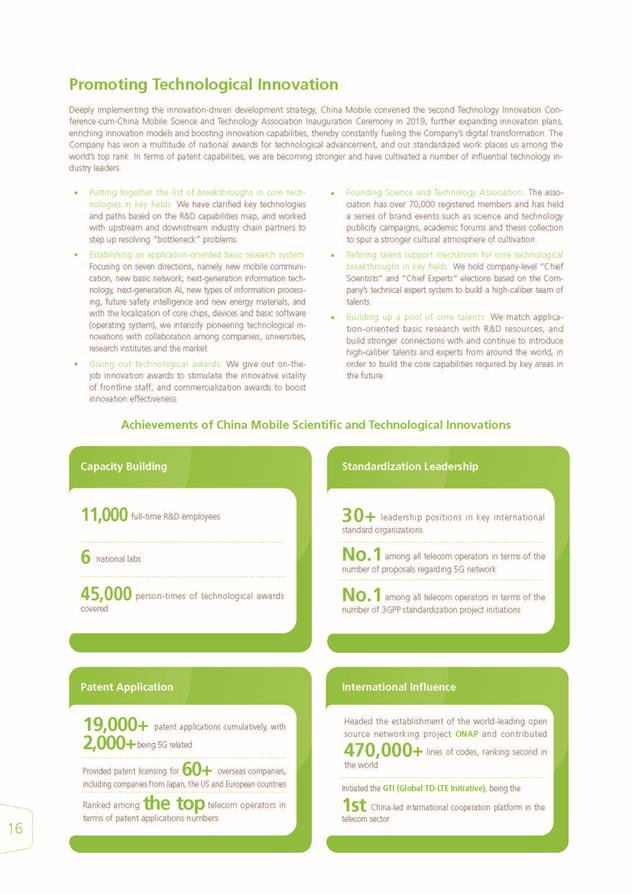
Promoting Technological Innovation Deeply implementing the innovation-driven development strategy, China Mobile convened the second Technology Innovation Conference- cum-China Mobile Science and Technology Association Inauguration Ceremony in 2019, further expanding innovation plans, enriching innovation models and boosting innovation capabilities, thereby constantly fueling the Company’s digital transformation. The Company has won a multitude of national awards for technological advancement, and our standardized work places us among the world’s top rank. In terms of patent capabilities, we are becoming stronger and have cultivated a number of influential technology industry leaders. Putting together the list of breakthroughs in core technologies in key fields: We have clarified key technologies and paths based on the R&D capabilities map, and worked with upstream and downstream industry chain partners to step up resolving ”bottleneck” problems. Establishing an application-oriented basic research system: Focusing on seven directions, namely new mobile communication, new basic network, next-generation information technology, next-generation AI, new types of information processing, future safety intelligence and new energy materials, and with the localization of core chips, devices and basic software (operating system), we intensify pioneering technological innovations with collaboration among companies, universities, research institutes and the market. Giving out technological awards: We give out on-thejob innovation awards to stimulate the innovative vitality of frontline staff, and commercialization awards to boost innovation effectiveness. Founding Science and Technology Association: The association has over 70,000 registered members and has held a series of brand events such as science and technology publicity campaigns, academic forums and thesis collection to spur a stronger cultural atmosphere of cultivation. Refining talent support mechanism for core technological breakthroughs in key fields: We hold company-level “Chief Scientists” and “Chief Experts” elections based on the Company’s technical expert system to build a high-caliber team of talents. Building up a pool of core talents: We match application- oriented basic research with R&D resources, and build stronger connections with and continue to introduce high-caliber talents and experts from around the world, in order to build the core capabilities required by key areas in the future. Achievements of China Mobile Scientific and Technological Innovations Capacity Building Patent Application Standardization Leadership International Influence 11,000 full-time R&D employees 6 national labs Ranked among the top telecom operators in terms of patent applications numbers Provided patent licensing for 60+ overseas companies, including companies from Japan, the US and European countries 19,000+ patent applications cumulatively, with 2,000+ being 5G related No.1 among all telecom operators in terms of the number of 3GPP standardization project initiations 45,000 person-times of technological awards covered No.1 among all telecom operators in terms of the number of proposals regarding 5G network 30+ leadership positions in key international standard organizations Headed the establishment of the world-leading open source networking project ONAP and contributed 470,000+ lines of codes, ranking second in the world Initiated the GTI (Global TD-LTE Initiative); being the 1st China-led international cooperation platform in the telecom sector 16
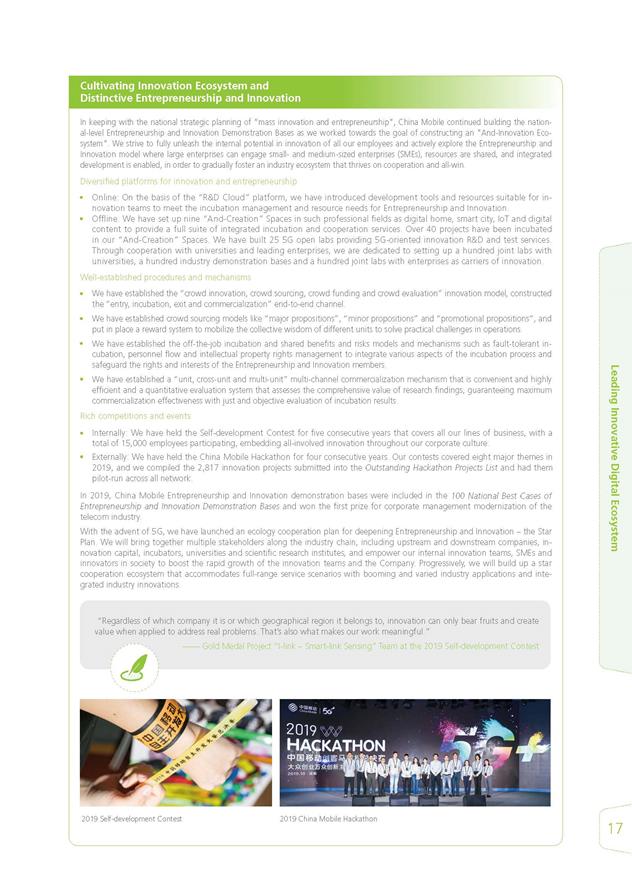
Leading Innovative Digital Ecosystem In keeping with the national strategic planning of “mass innovation and entrepreneurship”, China Mobile continued building the national- level Entrepreneurship and Innovation Demonstration Bases as we worked towards the goal of constructing an “And-Innovation Ecosystem”. We strive to fully unleash the internal potential in innovation of all our employees and actively explore the Entrepreneurship and Innovation model where large enterprises can engage small- and medium-sized enterprises (SMEs), resources are shared, and integrated development is enabled, in order to gradually foster an industry ecosystem that thrives on cooperation and all-win. Cultivating Innovation Ecosystem and Distinctive Entrepreneurship and Innovation Diversified platforms for innovation and entrepreneurship Well-established procedures and mechanisms Online: On the basis of the “R&D Cloud” platform, we have introduced development tools and resources suitable for innovation teams to meet the incubation management and resource needs for Entrepreneurship and Innovation. Offline: We have set up nine “And-Creation” Spaces in such professional fields as digital home, smart city, IoT and digital content to provide a full suite of integrated incubation and cooperation services. Over 40 projects have been incubated in our “And-Creation” Spaces. We have built 25 5G open labs providing 5G-oriented innovation R&D and test services. Through cooperation with universities and leading enterprises, we are dedicated to setting up a hundred joint labs with universities, a hundred industry demonstration bases and a hundred joint labs with enterprises as carriers of innovation. We have established the “crowd innovation, crowd sourcing, crowd funding and crowd evaluation” innovation model, constructed the “entry, incubation, exit and commercialization” end-to-end channel. We have established crowd sourcing models like “major propositions”, “minor propositions” and “promotional propositions”, and put in place a reward system to mobilize the collective wisdom of different units to solve practical challenges in operations. We have established the off-the-job incubation and shared benefits and risks models and mechanisms such as fault-tolerant incubation, personnel flow and intellectual property rights management to integrate various aspects of the incubation process and safeguard the rights and interests of the Entrepreneurship and Innovation members. We have established a “unit, cross-unit and multi-unit” multi-channel commercialization mechanism that is convenient and highly efficient and a quantitative evaluation system that assesses the comprehensive value of research findings, guaranteeing maximum commercialization effectiveness with just and objective evaluation of incubation results. Internally: We have held the Self-development Contest for five consecutive years that covers all our lines of business, with a total of 15,000 employees participating, embedding all-involved innovation throughout our corporate culture. Externally: We have held the China Mobile Hackathon for four consecutive years. Our contests covered eight major themes in 2019, and we compiled the 2,817 innovation projects submitted into the Outstanding Hackathon Projects List and had them pilot-run across all network. Rich competitions and events In 2019, China Mobile Entrepreneurship and Innovation demonstration bases were included in the 100 National Best Cases of Entrepreneurship and Innovation Demonstration Bases and won the first prize for corporate management modernization of the telecom industry. With the advent of 5G, we have launched an ecology cooperation plan for deepening Entrepreneurship and Innovation – the Star Plan. We will bring together multiple stakeholders along the industry chain, including upstream and downstream companies, innovation capital, incubators, universities and scientific research institutes, and empower our internal innovation teams, SMEs and innovators in society to boost the rapid growth of the innovation teams and the Company. Progressively, we will build up a star cooperation ecosystem that accommodates full-range service scenarios with booming and varied industry applications and integrated industry innovations. “Regardless of which company it is or which geographical region it belongs to, innovation can only bear fruits and create value when applied to address real problems. That’s also what makes our work meaningful.” —— Gold Medal Project “I-link – Smart-link Sensing” Team at the 2019 Self-development Contest 2019 Self-development Contest 2019 China Mobile Hackathon 17
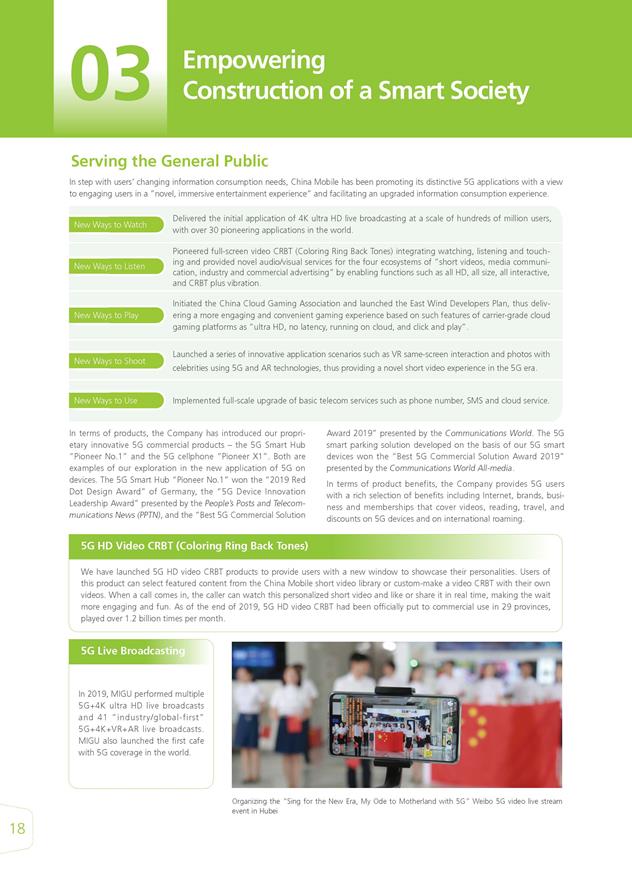
03 18 In step with users’ changing information consumption needs, China Mobile has been promoting its distinctive 5G applications with a view to engaging users in a ”novel, immersive entertainment experience” and facilitating an upgraded information consumption experience. In terms of products, the Company has introduced our proprietary innovative 5G commercial products – the 5G Smart Hub “Pioneer No.1” and the 5G cellphone “Pioneer X1”. Both are examples of our exploration in the new application of 5G on devices. The 5G Smart Hub “Pioneer No.1” won the “2019 Red Dot Design Award” of Germany, the “5G Device Innovation Leadership Award” presented by the People’s Posts and Telecommunications News (PPTN), and the “Best 5G Commercial Solution We have launched 5G HD video CRBT products to provide users with a new window to showcase their personalities. Users of this product can select featured content from the China Mobile short video library or custom-make a video CRBT with their own videos. When a call comes in, the caller can watch this personalized short video and like or share it in real time, making the wait more engaging and fun. As of the end of 2019, 5G HD video CRBT had been officially put to commercial use in 29 provinces, played over 1.2 billion times per month. Serving the General Public Award 2019” presented by the Communications World. The 5G smart parking solution developed on the basis of our 5G smart devices won the “Best 5G Commercial Solution Award 2019” presented by the Communications World All-media. In terms of product benefits, the Company provides 5G users with a rich selection of benefits including Internet, brands, business and memberships that cover videos, reading, travel, and discounts on 5G devices and on international roaming. 5G HD Video CRBT (Coloring Ring Back Tones) New Ways to Watch 新听法 Delivered the initial application of 4K ultra HD live broadcasting at a scale of hundreds of million users, with over 30 pioneering applications in the world. Pioneered full-screen video CRBT (Coloring Ring Back Tones) integrating watching, listening and touching and provided novel audio/visual services for the four ecosystems of “short videos, media communication, industry and commercial advertising” by enabling functions such as all HD, all size, all interactive, and CRBT plus vibration. Initiated the China Cloud Gaming Association and launched the East Wind Developers Plan, thus delivering a more engaging and convenient gaming experience based on such features of carrier-grade cloud gaming platforms as “ultra HD, no latency, running on cloud, and click and play”. Launched a series of innovative application scenarios such as VR same-screen interaction and photos with celebrities using 5G and AR technologies, thus providing a novel short video experience in the 5G era. Implemented full-scale upgrade of basic telecom services such as phone number, SMS and cloud service. In 2019, MIGU performed multiple 5G+4K ultra HD live broadcasts and 41 ”industry/global-first” 5G+4K+VR+AR live broadcasts. MIGU also launched the first cafe with 5G coverage in the world. Organizing the ”Sing for the New Era, My Ode to Motherland with 5G” Weibo 5G video live stream event in Hubei 5G Live Broadcasting Empowering Construction of a Smart Society 03 New Ways to Listen New Ways to Play New Ways to Shoot New Ways to Use
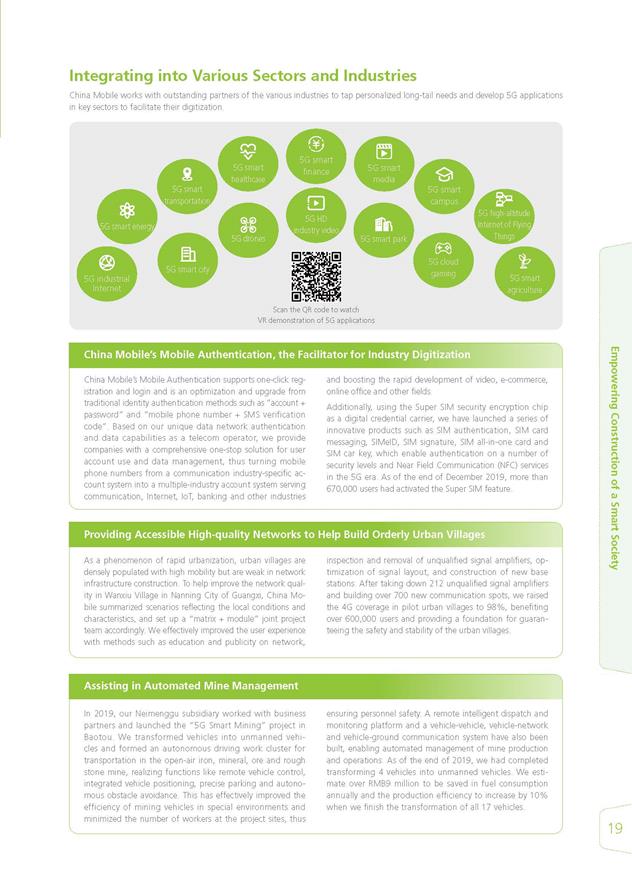
Empowering Construction of a Smart Society China Mobile works with outstanding partners of the various industries to tap personalized long-tail needs and develop 5G applications in key sectors to facilitate their digitization. Integrating into Various Sectors and Industries Assisting in Automated Mine Management In 2019, our Neimenggu subsidiary worked with business partners and launched the “5G Smart Mining” project in Baotou. We transformed vehicles into unmanned vehicles and formed an autonomous driving work cluster for transportation in the open-air iron, mineral, ore and rough stone mine, realizing functions like remote vehicle control, integrated vehicle positioning, precise parking and autonomous obstacle avoidance. This has effectively improved the efficiency of mining vehicles in special environments and minimized the number of workers at the project sites, thus ensuring personnel safety. A remote intelligent dispatch and monitoring platform and a vehicle-vehicle, vehicle-network and vehicle-ground communication system have also been built, enabling automated management of mine production and operations. As of the end of 2019, we had completed transforming 4 vehicles into unmanned vehicles. We estimate over RMB9 million to be saved in fuel consumption annually and the production efficiency to increase by 10% when we finish the transformation of all 17 vehicles. Providing Accessible High-quality Networks to Help Build Orderly Urban Villages As a phenomenon of rapid urbanization, urban villages are densely populated with high mobility but are weak in network infrastructure construction. To help improve the network quality in Wanxiu Village in Nanning City of Guangxi, China Mobile summarized scenarios reflecting the local conditions and characteristics, and set up a “matrix + module” joint project team accordingly. We effectively improved the user experience with methods such as education and publicity on network, inspection and removal of unqualified signal amplifiers, optimization of signal layout, and construction of new base stations. After taking down 212 unqualified signal amplifiers and building over 700 new communication spots, we raised the 4G coverage in pilot urban villages to 98%, benefiting over 600,000 users and providing a foundation for guaranteeing the safety and stability of the urban villages. China Mobile’s Mobile Authentication supports one-click registration and login and is an optimization and upgrade from traditional identity authentication methods such as ”account + password” and ”mobile phone number + SMS verification code”. Based on our unique data network authentication and data capabilities as a telecom operator, we provide companies with a comprehensive one-stop solution for user account use and data management, thus turning mobile phone numbers from a communication industry-specific account system into a multiple-industry account system serving communication, Internet, IoT, banking and other industries China Mobile’s Mobile Authentication, the Facilitator for Industry Digitization and boosting the rapid development of video, e-commerce, online office and other fields. Additionally, using the Super SIM security encryption chip as a digital credential carrier, we have launched a series of innovative products such as SIM authentication, SIM card messaging, SIMeID, SIM signature, SIM all-in-one card and SIM car key, which enable authentication on a number of security levels and Near Field Communication (NFC) services in the 5G era. As of the end of December 2019, more than 670,000 users had activated the Super SIM feature. Scan the QR code to watch VR demonstration of 5G applications 5G industrial Internet 5G smart energy 5G smart transportation 5G smart healthcare 5G smart finance 5G smart media 5G smart campus 5G high-altitude Internet of Flying Things 5G smart agriculture 5G smart city 5G drones 5G HD industry video 5G smart park 5G cloud gaming 19
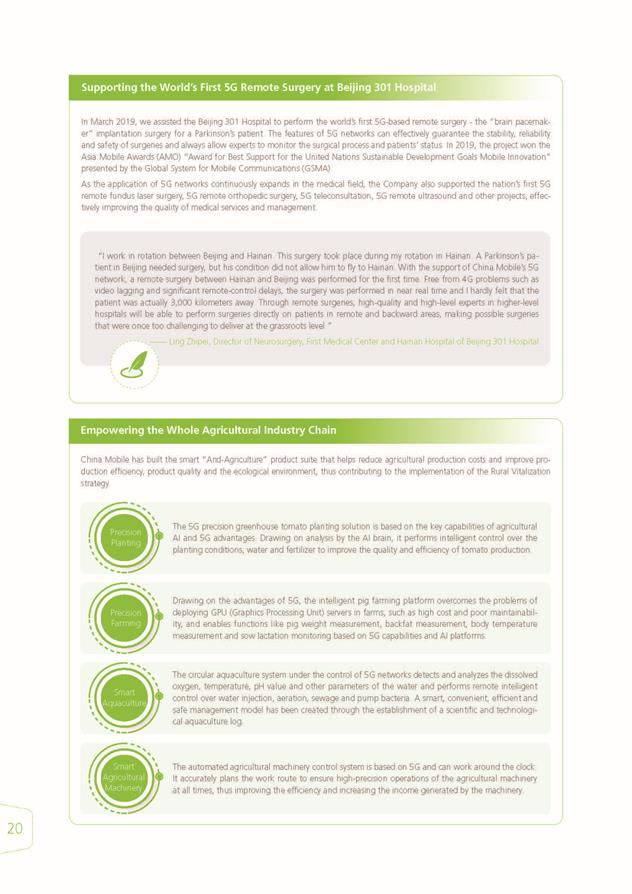
20 In March 2019, we assisted the Beijing 301 Hospital to perform the world’s first 5G-based remote surgery - the “brain pacemaker” implantation surgery for a Parkinson’s patient. The features of 5G networks can effectively guarantee the stability, reliability and safety of surgeries and always allow experts to monitor the surgical process and patients’ status. In 2019, the project won the Asia Mobile Awards (AMO) “Award for Best Support for the United Nations Sustainable Development Goals Mobile Innovation” presented by the Global System for Mobile Communications (GSMA). As the application of 5G networks continuously expands in the medical field, the Company also supported the nation’s first 5G remote fundus laser surgery, 5G remote orthopedic surgery, 5G teleconsultation, 5G remote ultrasound and other projects, effectively improving the quality of medical services and management. Supporting the World’s First 5G Remote Surgery at Beijing 301 Hospital “I work in rotation between Beijing and Hainan. This surgery took place during my rotation in Hainan. A Parkinson’s patient in Beijing needed surgery, but his condition did not allow him to fly to Hainan. With the support of China Mobile’s 5G network, a remote surgery between Hainan and Beijing was performed for the first time. Free from 4G problems such as video lagging and significant remote-control delays, the surgery was performed in near real time and I hardly felt that the patient was actually 3,000 kilometers away. Through remote surgeries, high-quality and high-level experts in higher-level hospitals will be able to perform surgeries directly on patients in remote and backward areas, making possible surgeries that were once too challenging to deliver at the grassroots level.” —— Ling Zhipei, Director of Neurosurgery, First Medical Center and Hainan Hospital of Beijing 301 Hospital China Mobile has built the smart “And-Agriculture” product suite that helps reduce agricultural production costs and improve production efficiency, product quality and the ecological environment, thus contributing to the implementation of the Rural Vitalization strategy. Empowering the Whole Agricultural Industry Chain Precision Planting Precision Farming Smart Aquaculture Smart Agricultural Machinery The 5G precision greenhouse tomato planting solution is based on the key capabilities of agricultural AI and 5G advantages. Drawing on analysis by the AI brain, it performs intelligent control over the planting conditions, water and fertilizer to improve the quality and efficiency of tomato production. Drawing on the advantages of 5G, the intelligent pig farming platform overcomes the problems of deploying GPU (Graphics Processing Unit) servers in farms, such as high cost and poor maintainability, and enables functions like pig weight measurement, backfat measurement, body temperature measurement and sow lactation monitoring based on 5G capabilities and AI platforms. The circular aquaculture system under the control of 5G networks detects and analyzes the dissolved oxygen, temperature, pH value and other parameters of the water and performs remote intelligent control over water injection, aeration, sewage and pump bacteria. A smart, convenient, efficient and safe management model has been created through the establishment of a scientific and technological aquaculture log. The automated agricultural machinery control system is based on 5G and can work around the clock. It accurately plans the work route to ensure high-precision operations of the agricultural machinery at all times, thus improving the efficiency and increasing the income generated by the machinery.
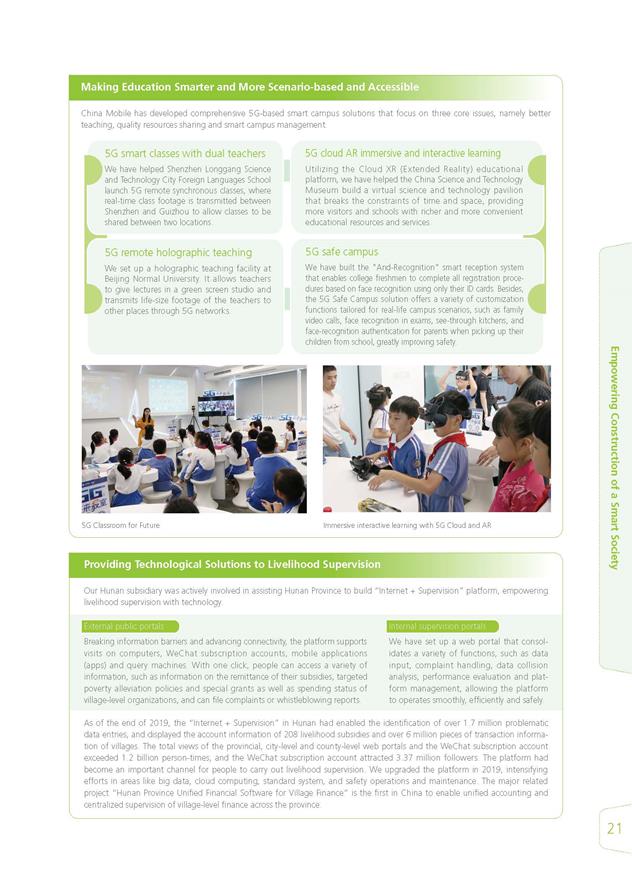
Our Hunan subsidiary was actively involved in assisting Hunan Province to build “Internet + Supervision” platform, empowering livelihood supervision with technology. As of the end of 2019, the “Internet + Supervision” in Hunan had enabled the identification of over 1.7 million problematic data entries, and displayed the account information of 208 livelihood subsidies and over 6 million pieces of transaction information of villages. The total views of the provincial, city-level and county-level web portals and the WeChat subscription account exceeded 1.2 billion person-times, and the WeChat subscription account attracted 3.37 million followers. The platform had become an important channel for people to carry out livelihood supervision. We upgraded the platform in 2019, intensifying efforts in areas like big data, cloud computing, standard system, and safety operations and maintenance. The major related project “Hunan Province Unified Financial Software for Village Finance” is the first in China to enable unified accounting and centralized supervision of village-level finance across the province. 21 Providing Technological Solutions to Livelihood Supervision Internal supervision portals We have set up a web portal that consolidates a variety of functions, such as data input, complaint handling, data collision analysis, performance evaluation and platform management, allowing the platform to operates smoothly, efficiently and safely. External public portals Breaking information barriers and advancing connectivity, the platform supports visits on computers, WeChat subscription accounts, mobile applications (apps) and query machines. With one click, people can access a variety of information, such as information on the remittance of their subsidies, targeted poverty alleviation policies and special grants as well as spending status of village-level organizations, and can file complaints or whistleblowing reports. 5G Classroom for Future Immersive interactive learning with 5G Cloud and AR China Mobile has developed comprehensive 5G-based smart campus solutions that focus on three core issues, namely better teaching, quality resources sharing and smart campus management. Making Education Smarter and More Scenario-based and Accessible 5G cloud AR immersive and interactive learning 5G safe campus 5G smart classes with dual teachers We have helped Shenzhen Longgang Science and Technology City Foreign Languages School launch 5G remote synchronous classes, where real-time class footage is transmitted between Shenzhen and Guizhou to allow classes to be shared between two locations. 5G remote holographic teaching We set up a holographic teaching facility at Beijing Normal University. It allows teachers to give lectures in a green screen studio and transmits life-size footage of the teachers to other places through 5G networks. Utilizing the Cloud XR (Extended Reality) educational platform, we have helped the China Science and Technology Museum build a virtual science and technology pavilion that breaks the constraints of time and space, providing more visitors and schools with richer and more convenient educational resources and services. We have built the “And-Recognition” smart reception system that enables college freshmen to complete all registration procedures based on face recognition using only their ID cards. Besides, the 5G Safe Campus solution offers a variety of customization functions tailored for real-life campus scenarios, such as family video calls, face recognition in exams, see-through kitchens, and face-recognition authentication for parents when picking up their children from school, greatly improving safety. Empowering Construction of a Smart Society
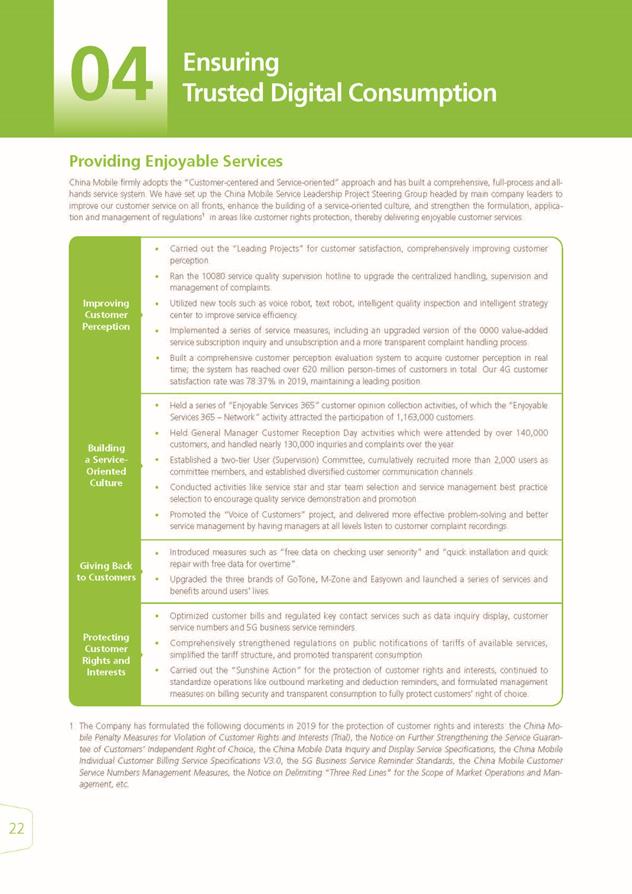
04 22 China Mobile firmly adopts the “Customer-centered and Service-oriented” approach and has built a comprehensive, full-process and allhands service system. We have set up the China Mobile Service Leadership Project Steering Group headed by main company leaders to improve our customer service on all fronts, enhance the building of a service-oriented culture, and strengthen the formulation, application and management of regulations1 in areas like customer rights protection, thereby delivering enjoyable customer services. Providing Enjoyable Services Improving Customer Perception Building a Service- Oriented Culture Giving Back to Customers Protecting Customer Rights and Interests Carried out the “Leading Projects” for customer satisfaction, comprehensively improving customer perception. Ran the 10080 service quality supervision hotline to upgrade the centralized handling, supervision and management of complaints. Utilized new tools such as voice robot, text robot, intelligent quality inspection and intelligent strategy center to improve service efficiency. Implemented a series of service measures, including an upgraded version of the 0000 value-added service subscription inquiry and unsubscription and a more transparent complaint handling process. Built a comprehensive customer perception evaluation system to acquire customer perception in real time; the system has reached over 620 million person-times of customers in total. Our 4G customer satisfaction rate was 78.37% in 2019, maintaining a leading position. Held a series of “Enjoyable Services 365” customer opinion collection activities, of which the “Enjoyable Services 365 – Network” activity attracted the participation of 1,163,000 customers. Held General Manager Customer Reception Day activities which were attended by over 140,000 customers, and handled nearly 130,000 inquiries and complaints over the year. Established a two-tier User (Supervision) Committee, cumulatively recruited more than 2,000 users as committee members, and established diversified customer communication channels. Conducted activities like service star and star team selection and service management best practice selection to encourage quality service demonstration and promotion. Promoted the “Voice of Customers” project, and delivered more effective problem-solving and better service management by having managers at all levels listen to customer complaint recordings. Optimized customer bills and regulated key contact services such as data inquiry display, customer service numbers and 5G business service reminders. Comprehensively strengthened regulations on public notifications of tariffs of available services, simplified the tariff structure, and promoted transparent consumption. Carried out the “Sunshine Action” for the protection of customer rights and interests, continued to standardize operations like outbound marketing and deduction reminders, and formulated management measures on billing security and transparent consumption to fully protect customers’ right of choice. Introduced measures such as “free data on checking user seniority” and “quick installation and quick repair with free data for overtime”. Upgraded the three brands of GoTone, M-Zone and Easyown and launched a series of services and benefits around users’ lives. The Company has formulated the following documents in 2019 for the protection of customer rights and interests: the China Mobile Penalty Measures for Violation of Customer Rights and Interests (Trial), the Notice on Further Strengthening the Service Guarantee of Customers’ Independent Right of Choice, the China Mobile Data Inquiry and Display Service Specifications, the China Mobile Individual Customer Billing Service Specifications V3.0, the 5G Business Service Reminder Standards, the China Mobile Customer Service Numbers Management Measures, the Notice on Delimiting “Three Red Lines” for the Scope of Market Operations and Management, etc. 1: Ensuring Trusted Digital Consumption 04
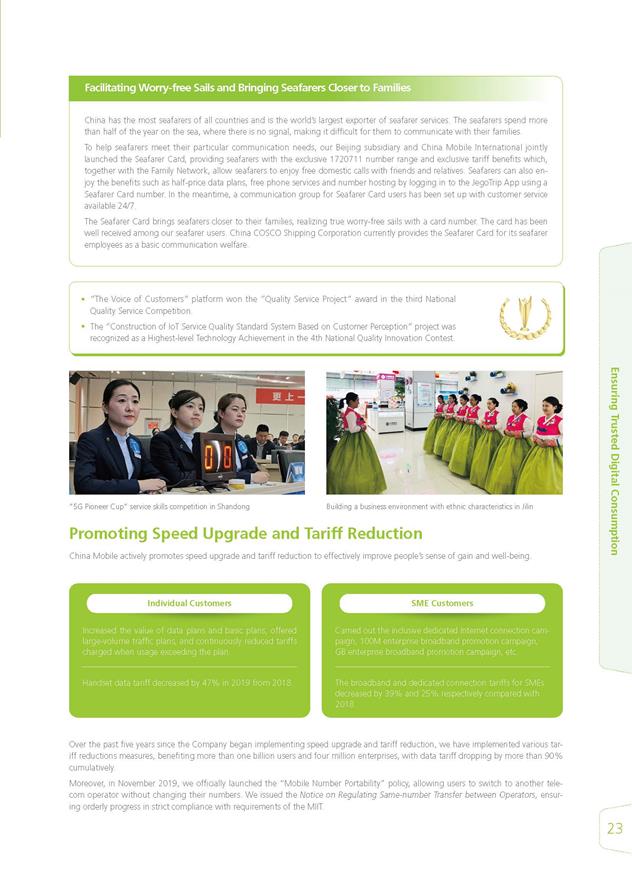
Ensuring Trusted Digital Consumption 23 China has the most seafarers of all countries and is the world’s largest exporter of seafarer services. The seafarers spend more than half of the year on the sea, where there is no signal, making it difficult for them to communicate with their families. To help seafarers meet their particular communication needs, our Beijing subsidiary and China Mobile International jointly launched the Seafarer Card, providing seafarers with the exclusive 1720711 number range and exclusive tariff benefits which, together with the Family Network, allow seafarers to enjoy free domestic calls with friends and relatives. Seafarers can also enjoy the benefits such as half-price data plans, free phone services and number hosting by logging in to the JegoTrip App using a Seafarer Card number. In the meantime, a communication group for Seafarer Card users has been set up with customer service available 24/7. The Seafarer Card brings seafarers closer to their families, realizing true worry-free sails with a card number. The card has been well received among our seafarer users. China COSCO Shipping Corporation currently provides the Seafarer Card for its seafarer employees as a basic communication welfare. Facilitating Worry-free Sails and Bringing Seafarers Closer to Families Building a business environment with ethnic characteristics in Jilin Promoting Speed Upgrade and Tariff Reduction China Mobile actively promotes speed upgrade and tariff reduction to effectively improve people’s sense of gain and well-being. Over the past five years since the Company began implementing speed upgrade and tariff reduction, we have implemented various tariff reductions measures, benefiting more than one billion users and four million enterprises, with data tariff dropping by more than 90% cumulatively. Moreover, in November 2019, we officially launched the “Mobile Number Portability” policy, allowing users to switch to another telecom operator without changing their numbers. We issued the Notice on Regulating Same-number Transfer between Operators, ensuring orderly progress in strict compliance with requirements of the MIIT. Individual Customers SME Customers Increased the value of data plans and basic plans, offered large-volume traffic plans, and continuously reduced tariffs charged when usage exceeding the plan. Handset data tariff decreased by 47% in 2019 from 2018. Carried out the inclusive dedicated Internet connection campaign, 100M enterprise broadband promotion campaign, GB enterprise broadband promotion campaign, etc. The broadband and dedicated connection tariffs for SMEs decreased by 39% and 25% respectively compared with 2018. ”The Voice of Customers” platform won the ”Quality Service Project” award in the third National Quality Service Competition. The ”Construction of IoT Service Quality Standard System Based on Customer Perception” project was recognized as a Highest-level Technology Achievement in the 4th National Quality Innovation Contest. ”5G Pioneer Cup” service skills competition in Shandong
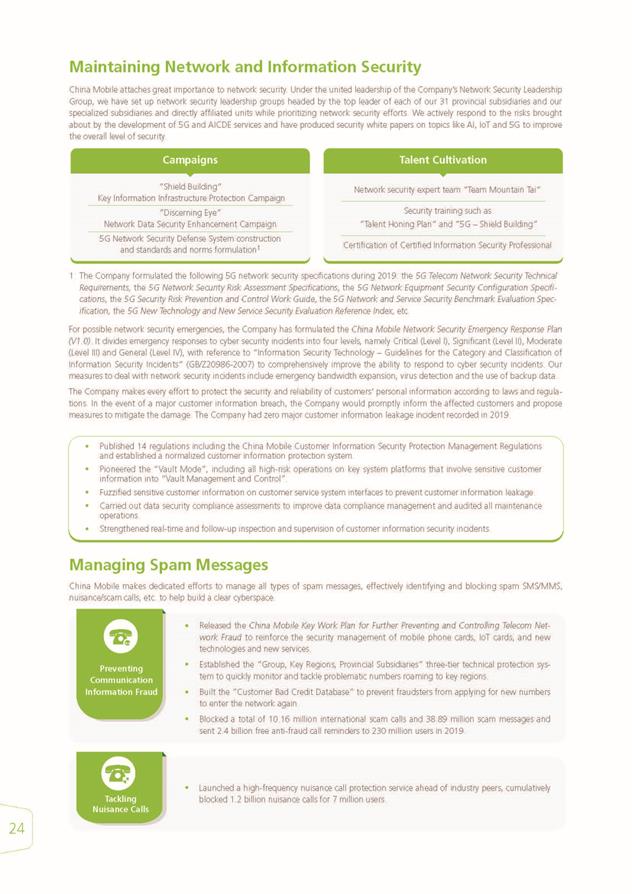
Published 14 regulations including the China Mobile Customer Information Security Protection Management Regulations and established a normalized customer information protection system. Pioneered the “Vault Mode”, including all high-risk operations on key system platforms that involve sensitive customer information into “Vault Management and Control”. Fuzzified sensitive customer information on customer service system interfaces to prevent customer information leakage. Carried out data security compliance assessments to improve data compliance management and audited all maintenance operations. Strengthened real-time and follow-up inspection and supervision of customer information security incidents. 24 Managing Spam Messages China Mobile makes dedicated efforts to manage all types of spam messages, effectively identifying and blocking spam SMS/MMS, nuisance/scam calls, etc. to help build a clear cyberspace. Released the China Mobile Key Work Plan for Further Preventing and Controlling Telecom Network Fraud to reinforce the security management of mobile phone cards, IoT cards, and new technologies and new services. Established the ”Group, Key Regions, Provincial Subsidiaries” three-tier technical protection system to quickly monitor and tackle problematic numbers roaming to key regions. Built the ”Customer Bad Credit Database” to prevent fraudsters from applying for new numbers to enter the network again. Blocked a total of 10.16 million international scam calls and 38.89 million scam messages and sent 2.4 billion free anti-fraud call reminders to 230 million users in 2019. Launched a high-frequency nuisance call protection service ahead of industry peers, cumulatively Tackling blocked 1.2 billion nuisance calls for 7 million users. Nuisance Calls For possible network security emergencies, the Company has formulated the China Mobile Network Security Emergency Response Plan (V1.0). It divides emergency responses to cyber security incidents into four levels, namely Critical (Level I), Significant (Level II), Moderate (Level III) and General (Level IV), with reference to “Information Security Technology – Guidelines for the Category and Classification of Information Security Incidents” (GB/Z20986-2007) to comprehensively improve the ability to respond to cyber security incidents. Our measures to deal with network security incidents include emergency bandwidth expansion, virus detection and the use of backup data. The Company makes every effort to protect the security and reliability of customers’ personal information according to laws and regulations. In the event of a major customer information breach, the Company would promptly inform the affected customers and propose measures to mitigate the damage. The Company had zero major customer information leakage incident recorded in 2019. The Company formulated the following 5G network security specifications during 2019: the 5G Telecom Network Security Technical Requirements, the 5G Network Security Risk Assessment Specifications, the 5G Network Equipment Security Configuration Specifications, the 5G Security Risk Prevention and Control Work Guide, the 5G Network and Service Security Benchmark Evaluation Specification, the 5G New Technology and New Service Security Evaluation Reference Index, etc. 1: China Mobile attaches great importance to network security. Under the united leadership of the Company’s Network Security Leadership Group, we have set up network security leadership groups headed by the top leader of each of our 31 provincial subsidiaries and our specialized subsidiaries and directly affiliated units while prioritizing network security efforts. We actively respond to the risks brought about by the development of 5G and AICDE services and have produced security white papers on topics like AI, IoT and 5G to improve the overall level of security. Maintaining Network and Information Security Campaigns Talent Cultivation ”Shield Building” Key Information Infrastructure Protection Campaign ”Discerning Eye” Network Data Security Enhancement Campaign 5G Network Security Defense System construction and standards and norms formulation1 Network security expert team ”Team Mountain Tai” Security training such as ”Talent Honing Plan” and ”5G – Shield Building” Certification of Certified Information Security Professional Preventing Communication Information Fraud
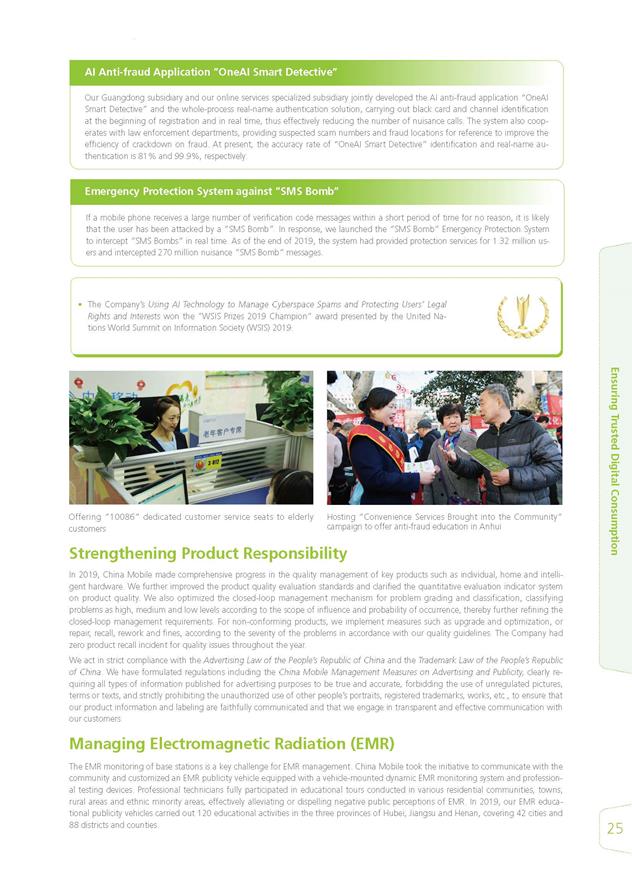
25 In 2019, China Mobile made comprehensive progress in the quality management of key products such as individual, home and intelligent hardware. We further improved the product quality evaluation standards and clarified the quantitative evaluation indicator system on product quality. We also optimized the closed-loop management mechanism for problem grading and classification, classifying problems as high, medium and low levels according to the scope of influence and probability of occurrence, thereby further refining the closed-loop management requirements. For non-conforming products, we implement measures such as upgrade and optimization, or repair, recall, rework and fines, according to the severity of the problems in accordance with our quality guidelines. The Company had zero product recall incident for quality issues throughout the year. We act in strict compliance with the Advertising Law of the People’s Republic of China and the Trademark Law of the People’s Republic of China. We have formulated regulations including the China Mobile Management Measures on Advertising and Publicity, clearly requiring all types of information published for advertising purposes to be true and accurate, forbidding the use of unregulated pictures, terms or texts, and strictly prohibiting the unauthorized use of other people’s portraits, registered trademarks, works, etc., to ensure that our product information and labeling are faithfully communicated and that we engage in transparent and effective communication with our customers. Strengthening Product Responsibility The EMR monitoring of base stations is a key challenge for EMR management. China Mobile took the initiative to communicate with the community and customized an EMR publicity vehicle equipped with a vehicle-mounted dynamic EMR monitoring system and professional testing devices. Professional technicians fully participated in educational tours conducted in various residential communities, towns, rural areas and ethnic minority areas, effectively alleviating or dispelling negative public perceptions of EMR. In 2019, our EMR educational publicity vehicles carried out 120 educational activities in the three provinces of Hubei, Jiangsu and Henan, covering 42 cities and 88 districts and counties. Managing Electromagnetic Radiation (EMR) Our Guangdong subsidiary and our online services specialized subsidiary jointly developed the AI anti-fraud application “OneAI Smart Detective” and the whole-process real-name authentication solution, carrying out black card and channel identification at the beginning of registration and in real time, thus effectively reducing the number of nuisance calls. The system also cooperates with law enforcement departments, providing suspected scam numbers and fraud locations for reference to improve the efficiency of crackdown on fraud. At present, the accuracy rate of “OneAI Smart Detective” identification and real-name authentication is 81% and 99.9%, respectively. If a mobile phone receives a large number of verification code messages within a short period of time for no reason, it is likely that the user has been attacked by a ”SMS Bomb”. In response, we launched the ”SMS Bomb” Emergency Protection System to intercept ”SMS Bombs” in real time. As of the end of 2019, the system had provided protection services for 1.32 million users and intercepted 270 million nuisance ”SMS Bomb” messages. AI Anti-fraud Application ”OneAI Smart Detective” Emergency Protection System against ”SMS Bomb” The Company’s Using AI Technology to Manage Cyberspace Spams and Protecting Users’ Legal Rights and Interests won the ”WSIS Prizes 2019 Champion” award presented by the United Nations World Summit on Information Society (WSIS) 2019. Offering ”10086” dedicated customer service seats to elderly customers Hosting ”Convenience Services Brought into the Community” campaign to offer anti-fraud education in Anhui Ensuring Trusted Digital Consumption
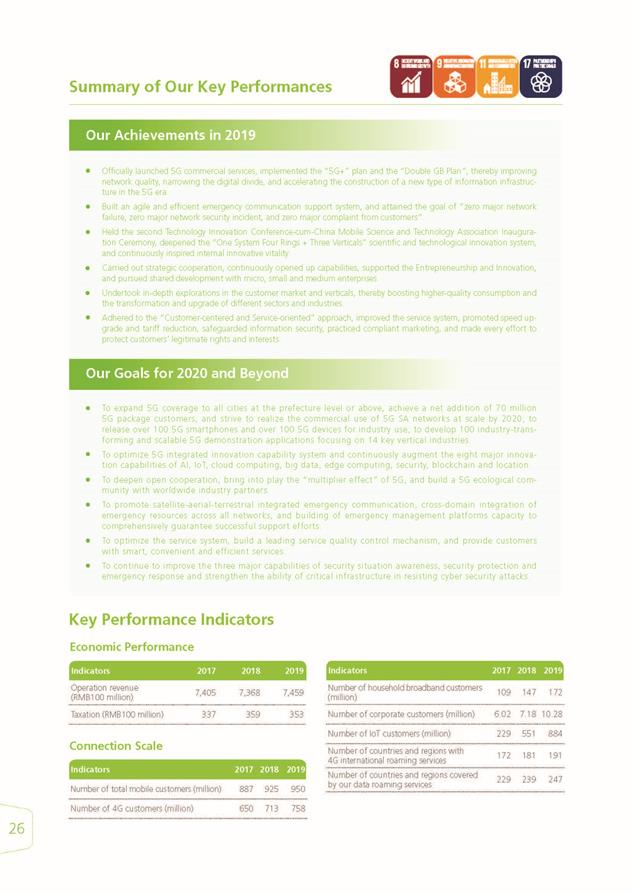
26 Key Performance Indicators Connection Scale Economic Performance Indicators 2017 2018 2019 Number of household broadband customers (million) 109 147 172 Number of corporate customers (million) 6.02 7.18 10.28 Number of IoT customers (million) 229 551 884 Number of countries and regions with 4G international roaming services 172 181 191 Number of countries and regions covered by our data roaming services 229 239 247 Indicators 2017 2018 2019 Number of total mobile customers (million) 887 925 950 Number of 4G customers (million) 650 713 758 Indicators 2017 2018 2019 Operation revenue (RMB100 million) 7,405 7,368 7,459 Taxation (RMB100 million) 337 359 353 Summary of Our Key Performances Our Achievements in 2019 Our Goals for 2020 and Beyond Officially launched 5G commercial services, implemented the “5G+” plan and the “Double GB Plan”, thereby improving network quality, narrowing the digital divide, and accelerating the construction of a new type of information infrastructure in the 5G era. Built an agile and efficient emergency communication support system, and attained the goal of “zero major network failure, zero major network security incident, and zero major complaint from customers”. Held the second Technology Innovation Conference-cum-China Mobile Science and Technology Association Inauguration Ceremony, deepened the “One System Four Rings + Three Verticals” scientific and technological innovation system, and continuously inspired internal innovative vitality. Carried out strategic cooperation, continuously opened up capabilities, supported the Entrepreneurship and Innovation, and pursued shared development with micro, small and medium enterprises. Undertook in-depth explorations in the customer market and verticals, thereby boosting higher-quality consumption and the transformation and upgrade of different sectors and industries. Adhered to the “Customer-centered and Service-oriented” approach, improved the service system, promoted speed upgrade and tariff reduction, safeguarded information security, practiced compliant marketing, and made every effort to protect customers’ legitimate rights and interests. To expand 5G coverage to all cities at the prefecture level or above, achieve a net addition of 70 million 5G package customers, and strive to realize the commercial use of 5G SA networks at scale by 2020; to release over 100 5G smartphones and over 100 5G devices for industry use; to develop 100 industry-transforming and scalable 5G demonstration applications focusing on 14 key vertical industries. To optimize 5G integrated innovation capability system and continuously augment the eight major innovation capabilities of AI, IoT, cloud computing, big data, edge computing, security, blockchain and location. To deepen open cooperation, bring into play the “multiplier effect” of 5G, and build a 5G ecological community with worldwide industry partners. To promote satellite-aerial-terrestrial integrated emergency communication, cross-domain integration of emergency resources across all networks, and building of emergency management platforms capacity to comprehensively guarantee successful support efforts. To optimize the service system, build a leading service quality control mechanism, and provide customers with smart, convenient and efficient services. To continue to improve the three major capabilities of security situation awareness, security protection and emergency response and strengthen the ability of critical infrastructure in resisting cyber security attacks.
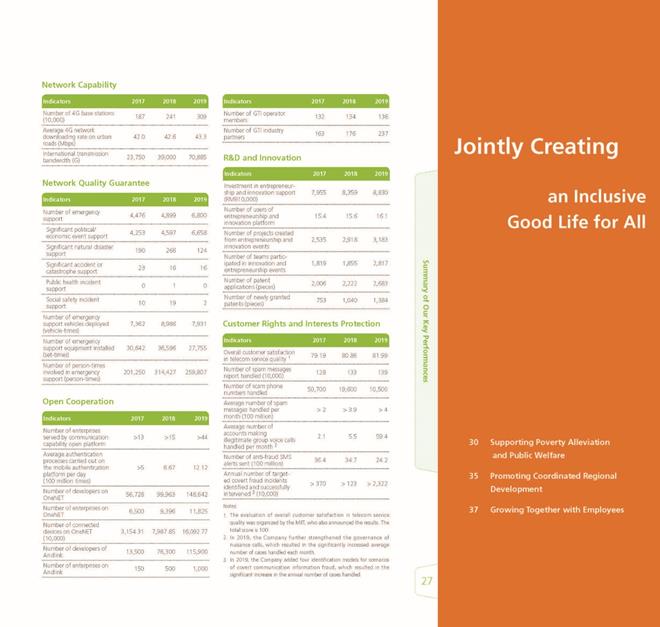
Indicators 2017 2018 2019 Overall customer satisfaction in telecom service quality 1 79.19 80.86 81.99 Number of spam messages report handled (10,000) 128 133 139 Number of scam phone numbers handled 50,700 19,600 10,500 Average number of spam messages handled per month (100 million) > 2 > 3.9 > 4 Average number of accounts making illegitimate group voice calls handled per month 2 2.1 5.5 59.4 Number of anti-fraud SMS alerts sent (100 million) 36.4 34.7 24.2 Annual number of targeted covert fraud incidents identified and successfully intervened 3 (10,000) > 370 > 123 > 2,322 Summary of Our Key Performances 关键绩效表 Network Capability Network Quality Guarantee Customer Rights and Interests Protection R&D and Innovation Open Cooperation The evaluation of overall customer satisfaction in telecom service quality was organized by the MIIT, who also announced the results. The total score is 100. In 2019, the Company further strengthened the governance of nuisance calls, which resulted in the significantly increased average number of cases handled each month. In 2019, the Company added four identification models for scenarios of covert communication information fraud, which resulted in the significant increase in the annual number of cases handled. 1. 2. 3. Notes: an Inclusive Good Life for All Jointly Creating Supporting Poverty Alleviation and Public Welfare Promoting Coordinated Regional Development 37 Growing Together with Employees 35 30 Indicators 2017 2018 2019 Number of emergency support 4,476 4,899 6,800 Significant political/ economic event support 4,253 4,597 6,658 Significant natural disaster support 190 266 124 Significant accident or catastrophe support 23 16 16 Public health incident support 0 1 0 Social safety incident support 10 19 2 Number of emergency support vehicles deployed (vehicle-times) 7,362 8,986 7,931 Number of emergency support equipment installed (set-times) 30,642 36,596 27,755 Number of person-times involved in emergency support (person-times) 201,250 314,427 259,807 Indicators 2017 2018 2019 Investment in entrepreneurship and innovation support (RMB10,000) 7,955 8,359 8,830 Number of users of entrepreneurship and innovation platform 15.4 15.6 16.1 Number of projects created from entrepreneurship and innovation events 2,535 2,918 3,183 Number of teams participated in innovation and entrepreneurship events 1,819 1,855 2,817 Number of patent applications (pieces) 2,006 2,222 2,683 Number of newly granted patents (pieces) 753 1,040 1,384 Indicators 2017 2018 2019 Number of enterprises served by communication capability open platform >13 >15 >44 Average authentication processes carried out on the mobile authentication platform per day (100 million times) >5 6.67 12.12 Number of developers on OneNET 56,728 99,963 148,642 Number of enterprises on OneNET 6,500 9,396 11,825 Number of connected devices on OneNET (10,000) 3,154.31 7,987.85 16,092.77 Number of developers of Andlink 13,500 76,300 115,900 Number of enterprises on Andlink 150 500 1,000 Indicators 2017 2018 2019 Number of GTI operator members 132 134 136 Number of GTI industry partners 163 176 237 Indicators 2017 2018 2019 Number of 4G base stations (10,000) 187 241 309 Average 4G network downloading rate on urban roads (Mbps) 42.0 42.6 43.3 International transmission bandwidth (G) 23,750 39,000 70,885 27
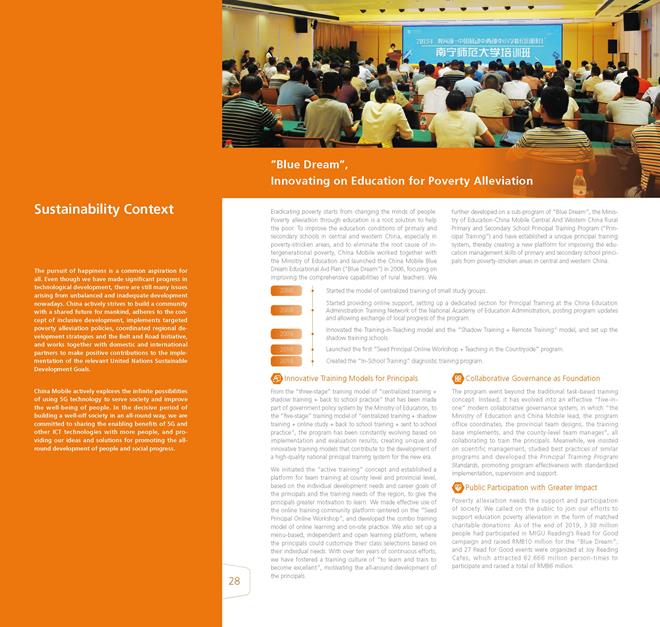
28 ”Blue Dream”, Innovating on Education for Poverty Alleviation Eradicating poverty starts from changing the minds of people. Poverty alleviation through education is a root solution to help the poor. To improve the education conditions of primary and secondary schools in central and western China, especially in poverty-stricken areas, and to eliminate the root cause of intergenerational poverty, China Mobile worked together with the Ministry of Education and launched the China Mobile Blue Dream Educational Aid Plan (“Blue Dream”) in 2006, focusing on improving the comprehensive capabilities of rural teachers. We further developed on a sub-program of “Blue Dream”, the Ministry of Education-China Mobile Central And Western China Rural Primary and Secondary School Principal Training Program (“Principal Training”) and have established a unique principal training system, thereby creating a new platform for improving the education management skills of primary and secondary school principals from poverty-stricken areas in central and western China. 2006 2008 2009 2016 2018 Started the model of centralized training of small study groups. Started providing online support, setting up a dedicated section for Principal Training at the China Education Administration Training Network of the National Academy of Education Administration, posting program updates and allowing exchange of local progress of the program. Innovated the Training-in-Teaching model and the ”Shadow Training + Remote Training” model, and set up the shadow training schools. Launched the first ”Seed Principal Online Workshop + Teaching in the Countryside” program. Created the ”In-School Training” diagnostic training program. Sustainability Context The pursuit of happiness is a common aspiration for all. Even though we have made significant progress in technological development, there are still many issues arising from unbalanced and inadequate development nowadays. China actively strives to build a community with a shared future for mankind, adheres to the concept of inclusive development, implements targeted poverty alleviation policies, coordinated regional development strategies and the Belt and Road Initiative, and works together with domestic and international partners to make positive contributions to the implementation of the relevant United Nations Sustainable Development Goals. China Mobile actively explores the infinite possibilities of using 5G technology to serve society and improve the well-being of people. In the decisive period of building a well-off society in an all-round way, we are committed to sharing the enabling benefits of 5G and other ICT technologies with more people, and providing our ideas and solutions for promoting the allround development of people and social progress. Innovative Training Models for Principals From the “three-stage” training model of “centralized training + shadow training + back to school practice” that has been made part of government policy system by the Ministry of Education, to the “five-stage” training model of “centralized training + shadow training + online study + back to school training + sent to school practice”, the program has been constantly evolving based on implementation and evaluation results, creating unique and innovative training models that contribute to the development of a high-quality national principal training system for the new era. We initiated the ”active training” concept and established a platform for team training at county level and provincial level, based on the individual development needs and career goals of the principals and the training needs of the region, to give the principals greater motivation to learn. We made effective use of the online training community platform centered on the ”Seed Principal Online Workshop”, and developed the combo training model of online learning and on-site practice. We also set up a menu-based, independent and open learning platform, where the principals could customize their class selections based on their individual needs. With over ten years of continuous efforts, we have fostered a training culture of ”to learn and train to become excellent”, motivating the all-around development of the principals. Collaborative Governance as Foundation The program went beyond the traditional task-based training concept. Instead, it has evolved into an effective “five-inone” modern collaborative governance system, in which “the Ministry of Education and China Mobile lead, the program office coordinates, the provincial team designs, the training base implements, and the county-level team manages”, all collaborating to train the principals. Meanwhile, we insisted on scientific management, studied best practices of similar programs and developed the Principal Training Program Standards, promoting program effectiveness with standardized implementation, supervision and support. Public Participation with Greater Impact Poverty alleviation needs the support and participation of society. We called on the public to join our efforts to support education poverty alleviation in the form of matched charitable donations. As of the end of 2019, 3.38 million people had participated in MIGU Reading’s Read for Good campaign and raised RMB10 million for the ”Blue Dream”; and 27 Read for Good events were organized at Joy Reading Cafes, which attracted 62.666 million person-times to participate and raised a total of RMB6 million.
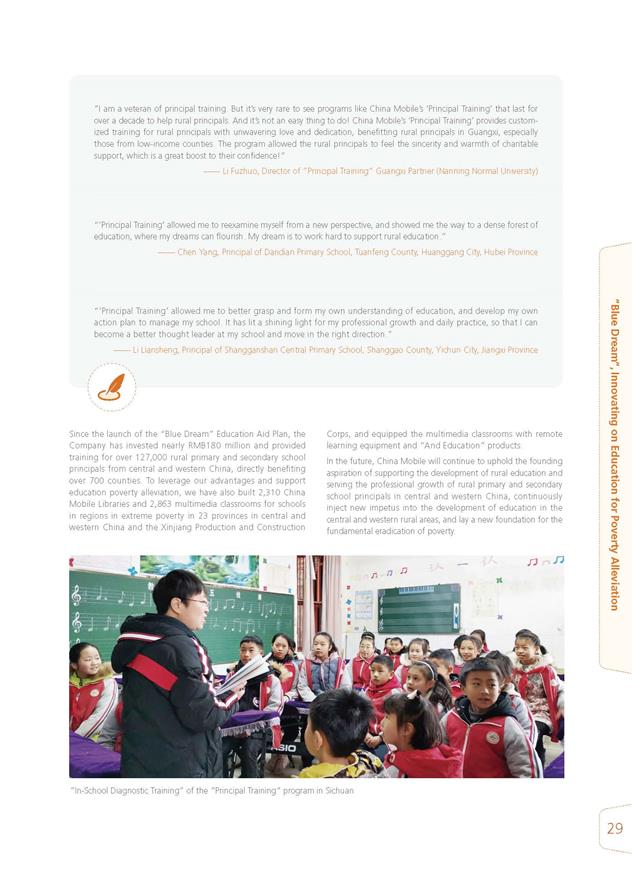
”Blue Dream”, Innovating on Education for Poverty Alleviation 29 “‘Principal Training’ allowed me to better grasp and form my own understanding of education, and develop my own action plan to manage my school. It has lit a shining light for my professional growth and daily practice, so that I can become a better thought leader at my school and move in the right direction.” —— Li Liansheng, Principal of Shangganshan Central Primary School, Shanggao County, Yichun City, Jiangxi Province “‘Principal Training’ allowed me to reexamine myself from a new perspective, and showed me the way to a dense forest of education, where my dreams can flourish. My dream is to work hard to support rural education.” —— Chen Yang, Principal of Dandian Primary School, Tuanfeng County, Huanggang City, Hubei Province ”I am a veteran of principal training. But it’s very rare to see programs like China Mobile’s ‘Principal Training’ that last for over a decade to help rural principals. And it’s not an easy thing to do! China Mobile’s ‘Principal Training’ provides customized training for rural principals with unwavering love and dedication, benefitting rural principals in Guangxi, especially those from low-income counties. The program allowed the rural principals to feel the sincerity and warmth of charitable support, which is a great boost to their confidence!” —— Li Fuzhuo, Director of ”Principal Training” Guangxi Partner (Nanning Normal University) Since the launch of the “Blue Dream” Education Aid Plan, the Company has invested nearly RMB180 million and provided training for over 127,000 rural primary and secondary school principals from central and western China, directly benefiting over 700 counties. To leverage our advantages and support education poverty alleviation, we have also built 2,310 China Mobile Libraries and 2,863 multimedia classrooms for schools in regions in extreme poverty in 23 provinces in central and western China and the Xinjiang Production and Construction Corps, and equipped the multimedia classrooms with remote learning equipment and “And Education” products. In the future, China Mobile will continue to uphold the founding aspiration of supporting the development of rural education and serving the professional growth of rural primary and secondary school principals in central and western China, continuously inject new impetus into the development of education in the central and western rural areas, and lay a new foundation for the fundamental eradication of poverty. ”In-School Diagnostic Training” of the ”Principal Training” program in Sichuan
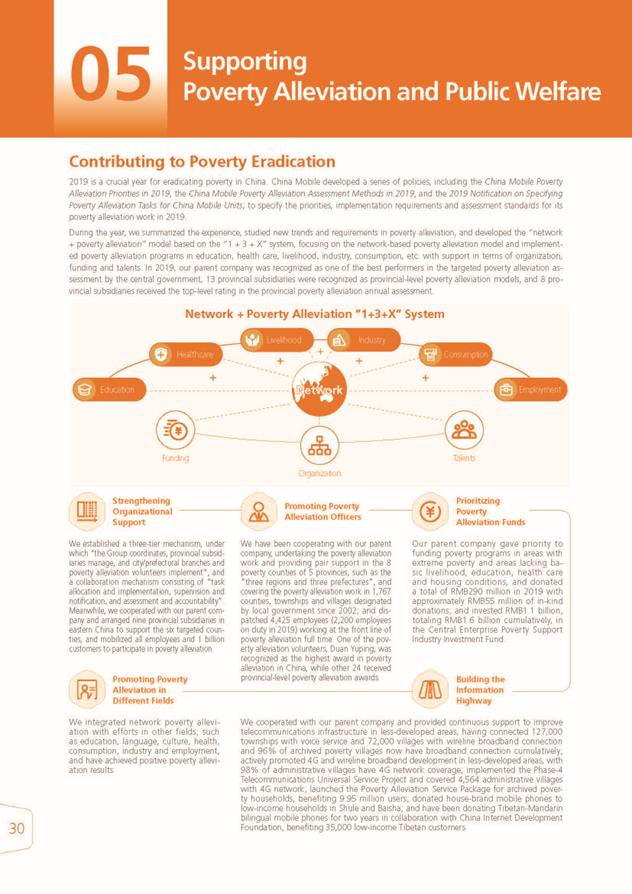
Supporting Poverty Alleviation and Public Welfare 30 Contributing to Poverty Eradication 2019 is a crucial year for eradicating poverty in China. China Mobile developed a series of policies, including the China Mobile Poverty Alleviation Priorities in 2019, the China Mobile Poverty Alleviation Assessment Methods in 2019, and the 2019 Notification on Specifying Poverty Alleviation Tasks for China Mobile Units, to specify the priorities, implementation requirements and assessment standards for its poverty alleviation work in 2019. During the year, we summarized the experience, studied new trends and requirements in poverty alleviation, and developed the “network + poverty alleviation” model based on the “1 + 3 + X” system, focusing on the network-based poverty alleviation model and implemented poverty alleviation programs in education, health care, livelihood, industry, consumption, etc. with support in terms of organization, funding and talents. In 2019, our parent company was recognized as one of the best performers in the targeted poverty alleviation assessment by the central government, 13 provincial subsidiaries were recognized as provincial-level poverty alleviation models, and 8 provincial subsidiaries received the top-level rating in the provincial poverty alleviation annual assessment. Strengthening Organizational Support Promoting Poverty Alleviation Officers Prioritizing Poverty Alleviation Funds Building the Information Highway Promoting Poverty Alleviation in Different Fields We established a three-tier mechanism, under which “the Group coordinates, provincial subsidiaries manage, and city/prefectural branches and poverty alleviation volunteers implement”, and a collaboration mechanism consisting of “task allocation and implementation, supervision and notification, and assessment and accountability”. Meanwhile, we cooperated with our parent company and arranged nine provincial subsidiaries in eastern China to support the six targeted counties, and mobilized all employees and 1 billion customers to participate in poverty alleviation. We integrated network poverty alleviation with efforts in other fields, such as education, language, culture, health, consumption, industry and employment, and have achieved positive poverty alleviation results. We have been cooperating with our parent company, undertaking the poverty alleviation work and providing pair support in the 8 poverty counties of 5 provinces, such as the “three regions and three prefectures”, and covering the poverty alleviation work in 1,767 counties, townships and villages designated by local government since 2002; and dispatched 4,425 employees (2,200 employees on duty in 2019) working at the front line of poverty alleviation full time. One of the poverty alleviation volunteers, Duan Yuping, was recognized as the highest award in poverty alleviation in China, while other 24 received provincial-level poverty alleviation awards. We cooperated with our parent company and provided continuous support to improve telecommunications infrastructure in less-developed areas, having connected 127,000 townships with voice service and 72,000 villages with wireline broadband connection and 96% of archived poverty villages now have broadband connection cumulatively; actively promoted 4G and wireline broadband development in less-developed areas, with 98% of administrative villages have 4G network coverage; implemented the Phase-4 Telecommunications Universal Service Project and covered 4,564 administrative villages with 4G network; launched the Poverty Alleviation Service Package for archived poverty households, benefiting 9.95 million users; donated house-brand mobile phones to low-income households in Shule and Baisha; and have been donating Tibetan-Mandarin bilingual mobile phones for two years in collaboration with China Internet Development Foundation, benefiting 35,000 low-income Tibetan customers. Our parent company gave priority to funding poverty programs in areas with extreme poverty and areas lacking basic livelihood, education, health care and housing conditions, and donated a total of RMB290 million in 2019 with approximately RMB55 million of in-kind donations; and invested RMB1.1 billion, totaling RMB1.6 billion cumulatively, in the Central Enterprise Poverty Support Industry Investment Fund. Network + Poverty Alleviation ”1+3+X” System Education Healthcare Livelihood Industry Consumption Employment Talents Organization Funding Network 05
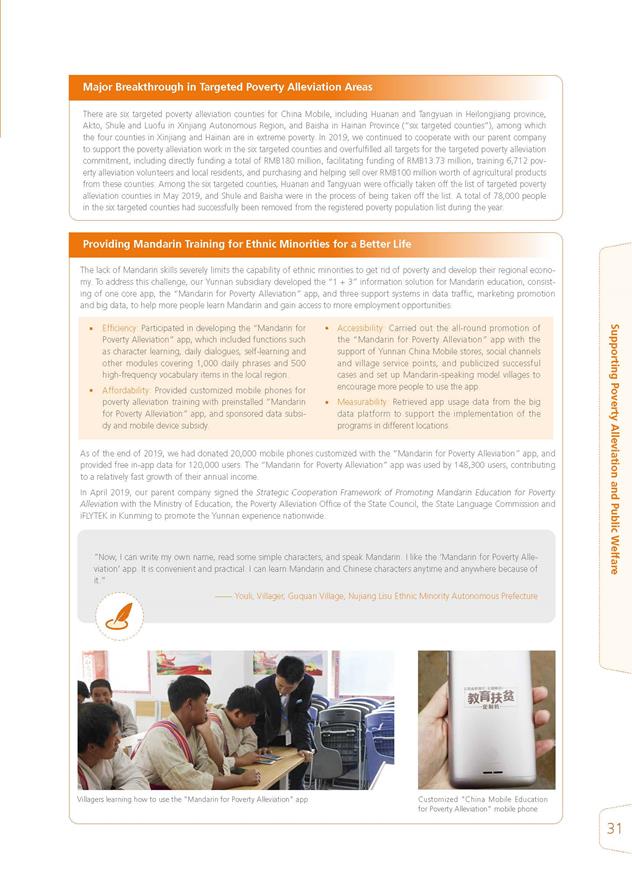
Supporting Poverty Alleviation and Public Welfare 31 Villagers learning how to use the ”Mandarin for Poverty Alleviation” app Customized ”China Mobile Education for Poverty Alleviation” mobile phone Providing Mandarin Training for Ethnic Minorities for a Better Life Efficiency: Participated in developing the “Mandarin for Poverty Alleviation” app, which included functions such as character learning, daily dialogues, self-learning and other modules covering 1,000 daily phrases and 500 high-frequency vocabulary items in the local region. Affordability: Provided customized mobile phones for poverty alleviation training with preinstalled “Mandarin for Poverty Alleviation” app, and sponsored data subsidy and mobile device subsidy. ”Now, I can write my own name, read some simple characters, and speak Mandarin. I like the ‘Mandarin for Poverty Alleviation’ app. It is convenient and practical. I can learn Mandarin and Chinese characters anytime and anywhere because of it.” —— Youli, Villager, Guquan Village, Nujiang Lisu Ethnic Minority Autonomous Prefecture The lack of Mandarin skills severely limits the capability of ethnic minorities to get rid of poverty and develop their regional economy. To address this challenge, our Yunnan subsidiary developed the “1 + 3” information solution for Mandarin education, consisting of one core app, the “Mandarin for Poverty Alleviation” app, and three support systems in data traffic, marketing promotion and big data, to help more people learn Mandarin and gain access to more employment opportunities. Accessibility: Carried out the all-round promotion of the “Mandarin for Poverty Alleviation” app with the support of Yunnan China Mobile stores, social channels and village service points, and publicized successful cases and set up Mandarin-speaking model villages to encourage more people to use the app. Measurability: Retrieved app usage data from the big data platform to support the implementation of the programs in different locations. As of the end of 2019, we had donated 20,000 mobile phones customized with the “Mandarin for Poverty Alleviation” app, and provided free in-app data for 120,000 users. The “Mandarin for Poverty Alleviation” app was used by 148,300 users, contributing to a relatively fast growth of their annual income. In April 2019, our parent company signed the Strategic Cooperation Framework of Promoting Mandarin Education for Poverty Alleviation with the Ministry of Education, the Poverty Alleviation Office of the State Council, the State Language Commission and iFLYTEK in Kunming to promote the Yunnan experience nationwide. There are six targeted poverty alleviation counties for China Mobile, including Huanan and Tangyuan in Heilongjiang province, Akto, Shule and Luofu in Xinjiang Autonomous Region, and Baisha in Hainan Province (“six targeted counties”), among which the four counties in Xinjiang and Hainan are in extreme poverty. In 2019, we continued to cooperate with our parent company to support the poverty alleviation work in the six targeted counties and overfulfilled all targets for the targeted poverty alleviation commitment, including directly funding a total of RMB180 million, facilitating funding of RMB13.73 million, training 6,712 poverty alleviation volunteers and local residents, and purchasing and helping sell over RMB100 million worth of agricultural products from these counties. Among the six targeted counties, Huanan and Tangyuan were officially taken off the list of targeted poverty alleviation counties in May 2019, and Shule and Baisha were in the process of being taken off the list. A total of 78,000 people in the six targeted counties had successfully been removed from the registered poverty population list during the year. Major Breakthrough in Targeted Poverty Alleviation Areas
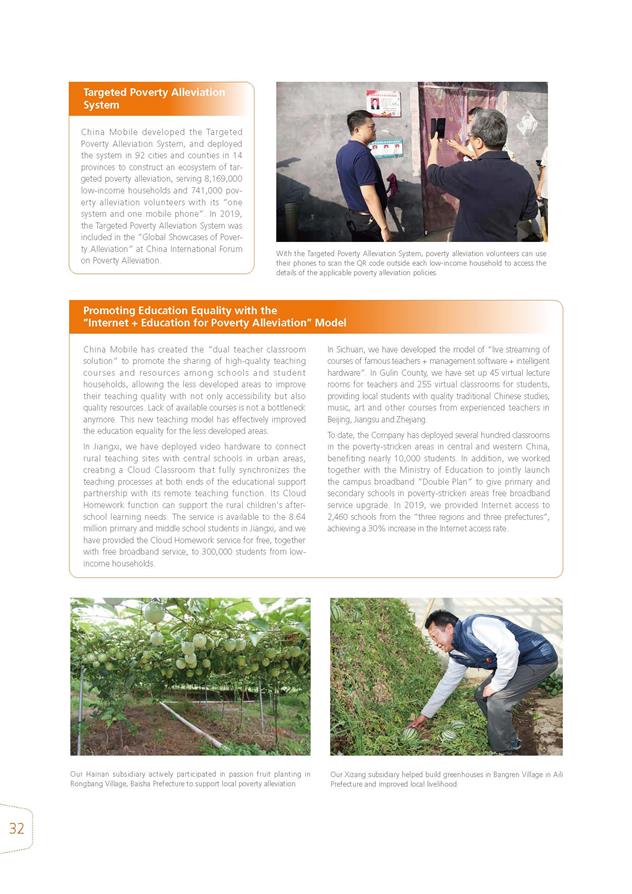
32 China Mobile developed the Targeted Poverty Alleviation System, and deployed the system in 92 cities and counties in 14 provinces to construct an ecosystem of targeted poverty alleviation, serving 8,169,000 low-income households and 741,000 poverty alleviation volunteers with its ”one system and one mobile phone”. In 2019, the Targeted Poverty Alleviation System was included in the ”Global Showcases of Poverty Alleviation” at China International Forum on Poverty Alleviation. With the Targeted Poverty Alleviation System, poverty alleviation volunteers can use their phones to scan the QR code outside each low-income household to access the details of the applicable poverty alleviation policies. Targeted Poverty Alleviation System Our Hainan subsidiary actively participated in passion fruit planting in Rongbang Village, Baisha Prefecture to support local poverty alleviation Our Xizang subsidiary helped build greenhouses in Bangren Village in Aili Prefecture and improved local livelihood Promoting Education Equality with the ”Internet + Education for Poverty Alleviation” Model China Mobile has created the ”dual teacher classroom solution” to promote the sharing of high-quality teaching courses and resources among schools and student households, allowing the less developed areas to improve their teaching quality with not only accessibility but also quality resources. Lack of available courses is not a bottleneck anymore. This new teaching model has effectively improved the education equality for the less developed areas. In Jiangxi, we have deployed video hardware to connect rural teaching sites with central schools in urban areas, creating a Cloud Classroom that fully synchronizes the teaching processes at both ends of the educational support partnership with its remote teaching function. Its Cloud Homework function can support the rural children's afterschool learning needs. The service is available to the 8.64 million primary and middle school students in Jiangxi, and we have provided the Cloud Homework service for free, together with free broadband service, to 300,000 students from lowincome households. In Sichuan, we have developed the model of “live streaming of courses of famous teachers + management software + intelligent hardware”. In Gulin County, we have set up 45 virtual lecture rooms for teachers and 255 virtual classrooms for students, providing local students with quality traditional Chinese studies, music, art and other courses from experienced teachers in Beijing, Jiangsu and Zhejiang. To date, the Company has deployed several hundred classrooms in the poverty-stricken areas in central and western China, benefiting nearly 10,000 students. In addition, we worked together with the Ministry of Education to jointly launch the campus broadband ”Double Plan” to give primary and secondary schools in poverty-stricken areas free broadband service upgrade. In 2019, we provided Internet access to 2,460 schools from the ”three regions and three prefectures”, achieving a 30% increase in the Internet access rate.
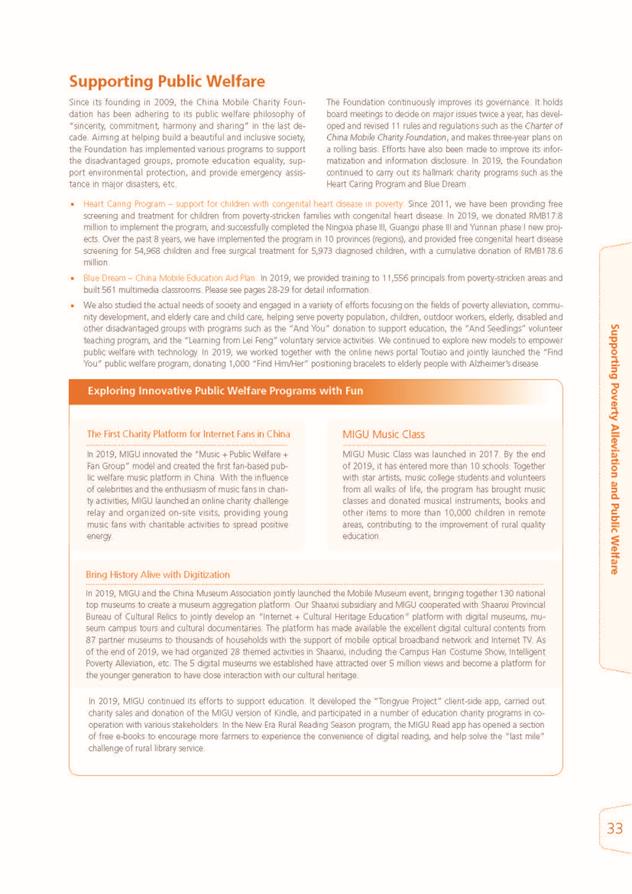
33 Supporting Public Welfare Heart Caring Program – support for children with congenital heart disease in poverty: Since 2011, we have been providing free screening and treatment for children from poverty-stricken families with congenital heart disease. In 2019, we donated RMB17.8 million to implement the program, and successfully completed the Ningxia phase III, Guangxi phase III and Yunnan phase I new projects. Over the past 8 years, we have implemented the program in 10 provinces (regions), and provided free congenital heart disease screening for 54,968 children and free surgical treatment for 5,973 diagnosed children, with a cumulative donation of RMB178.6 million. Blue Dream – China Mobile Education Aid Plan: In 2019, we provided training to 11,556 principals from poverty-stricken areas and built 561 multimedia classrooms. Please see pages 28-29 for detail information. We also studied the actual needs of society and engaged in a variety of efforts focusing on the fields of poverty alleviation, community development, and elderly care and child care, helping serve poverty population, children, outdoor workers, elderly, disabled and other disadvantaged groups with programs such as the “And You” donation to support education, the “And Seedlings” volunteer teaching program, and the “Learning from Lei Feng” voluntary service activities. We continued to explore new models to empower public welfare with technology. In 2019, we worked together with the online news portal Toutiao and jointly launched the “Find You” public welfare program, donating 1,000 “Find Him/Her” positioning bracelets to elderly people with Alzheimer’s disease. In 2019, MIGU continued its efforts to support education. It developed the “Tongyue Project” client-side app, carried out charity sales and donation of the MIGU version of Kindle, and participated in a number of education charity programs in cooperation with various stakeholders. In the New Era Rural Reading Season program, the MIGU Read app has opened a section of free e-books to encourage more farmers to experience the convenience of digital reading, and help solve the “last mile” challenge of rural library service. MIGU Music Class was launched in 2017. By the end of 2019, it has entered more than 10 schools. Together with star artists, music college students and volunteers from all walks of life, the program has brought music classes and donated musical instruments, books and other items to more than 10,000 children in remote areas, contributing to the improvement of rural quality education. Bring History Alive with Digitization In 2019, MIGU and the China Museum Association jointly launched the Mobile Museum event, bringing together 130 national top museums to create a museum aggregation platform. Our Shaanxi subsidiary and MIGU cooperated with Shaanxi Provincial Bureau of Cultural Relics to jointly develop an “Internet + Cultural Heritage Education” platform with digital museums, museum campus tours and cultural documentaries. The platform has made available the excellent digital cultural contents from 87 partner museums to thousands of households with the support of mobile optical broadband network and Internet TV. As of the end of 2019, we had organized 28 themed activities in Shaanxi, including the Campus Han Costume Show, Intelligent Poverty Alleviation, etc. The 5 digital museums we established have attracted over 5 million views and become a platform for the younger generation to have close interaction with our cultural heritage. The First Charity Platform for Internet Fans in China In 2019, MIGU innovated the “Music + Public Welfare + Fan Group” model and created the first fan-based public welfare music platform in China. With the influence of celebrities and the enthusiasm of music fans in charity activities, MIGU launched an online charity challenge relay and organized on-site visits, providing young music fans with charitable activities to spread positive energy. Exploring Innovative Public Welfare Programs with Fun Since its founding in 2009, the China Mobile Charity Foundation has been adhering to its public welfare philosophy of “sincerity, commitment, harmony and sharing” in the last decade. Aiming at helping build a beautiful and inclusive society, the Foundation has implemented various programs to support the disadvantaged groups, promote education equality, support environmental protection, and provide emergency assistance in major disasters, etc. The Foundation continuously improves its governance. It holds board meetings to decide on major issues twice a year, has developed and revised 11 rules and regulations such as the Charter of China Mobile Charity Foundation, and makes three-year plans on a rolling basis. Efforts have also been made to improve its informatization and information disclosure. In 2019, the Foundation continued to carry out its hallmark charity programs such as the Heart Caring Program and Blue Dream . Supporting Poverty Alleviation and Public Welfare MIGU Music Class
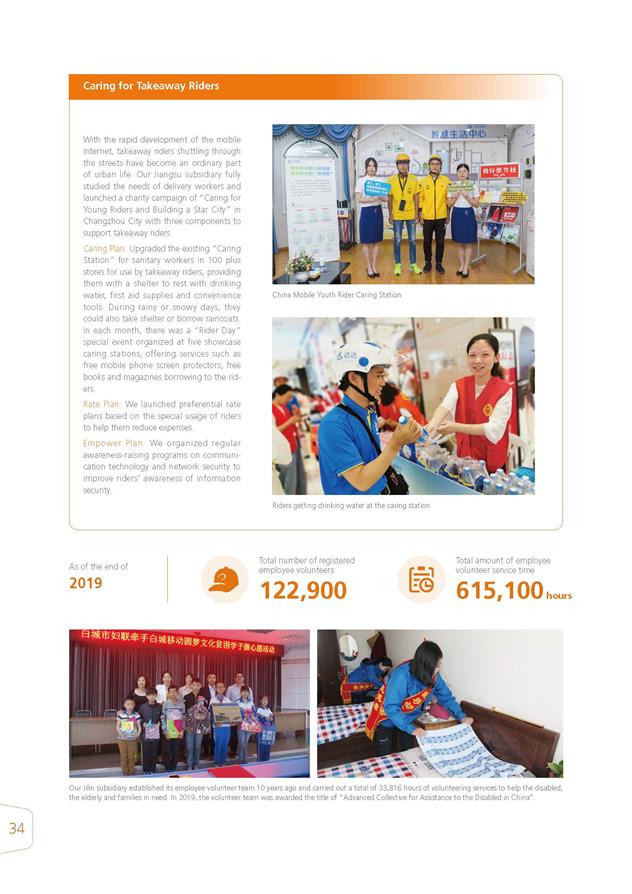
34 With the rapid development of the mobile Internet, takeaway riders shuttling through the streets have become an ordinary part of urban life. Our Jiangsu subsidiary fully studied the needs of delivery workers and launched a charity campaign of “Caring for Young Riders and Building a Star City” in Changzhou City with three components to support takeaway riders. Caring Plan: Upgraded the existing “Caring Station” for sanitary workers in 100 plus stores for use by takeaway riders, providing them with a shelter to rest with drinking water, first aid supplies and convenience tools. During rainy or snowy days, they could also take shelter or borrow raincoats. In each month, there was a “Rider Day” special event organized at five showcase caring stations, offering services such as free mobile phone screen protectors, free books and magazines borrowing to the riders. Rate Plan: We launched preferential rate plans based on the special usage of riders to help them reduce expenses. Empower Plan: We organized regular awareness-raising programs on communication technology and network security to improve riders’ awareness of information security. China Mobile Youth Rider Caring Station Riders getting drinking water at the caring station Our Jilin subsidiary established its employee volunteer team 10 years ago and carried out a total of 33,816 hours of volunteering services to help the disabled, the elderly and families in need. In 2019, the volunteer team was awarded the title of “Advanced Collective for Assistance to the Disabled in China”. Caring for Takeaway Riders Total number of registered employee volunteers Total amount of employee volunteer service time 122,900 615,100 hours As of the end of 2019
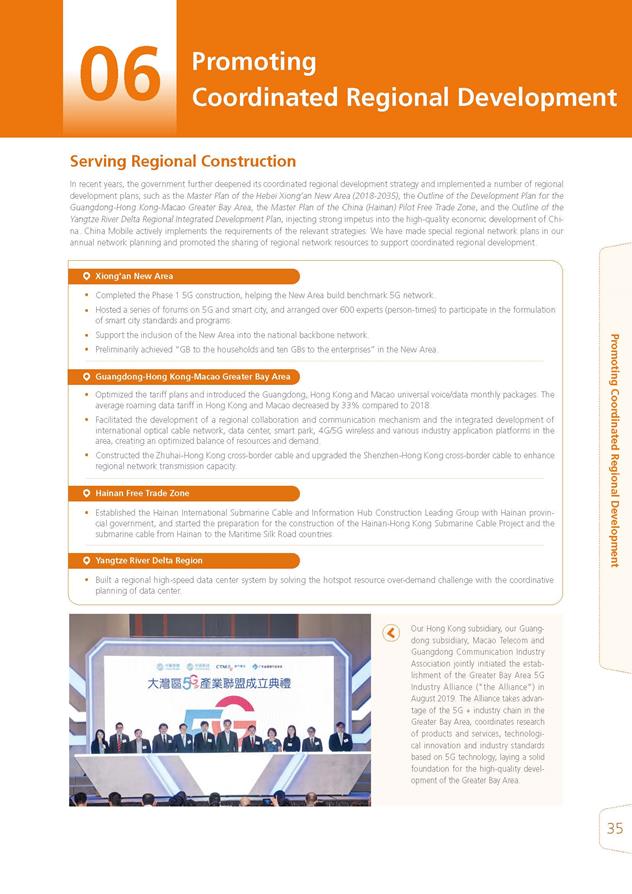
Promoting Coordinated Regional Development 35 In recent years, the government further deepened its coordinated regional development strategy and implemented a number of regional development plans, such as the Master Plan of the Hebei Xiong’an New Area (2018-2035), the Outline of the Development Plan for the Guangdong-Hong Kong-Macao Greater Bay Area, the Master Plan of the China (Hainan) Pilot Free Trade Zone, and the Outline of the Yangtze River Delta Regional Integrated Development Plan, injecting strong impetus into the high-quality economic development of China. China Mobile actively implements the requirements of the relevant strategies. We have made special regional network plans in our annual network planning and promoted the sharing of regional network resources to support coordinated regional development. Serving Regional Construction Xiong'an New Area Guangdong-Hong Kong-Macao Greater Bay Area Hainan Free Trade Zone Yangtze River Delta Region Completed the Phase 1 5G construction, helping the New Area build benchmark 5G network. Hosted a series of forums on 5G and smart city, and arranged over 600 experts (person-times) to participate in the formulation of smart city standards and programs. Support the inclusion of the New Area into the national backbone network. Preliminarily achieved “GB to the households and ten GBs to the enterprises” in the New Area. Optimized the tariff plans and introduced the Guangdong, Hong Kong and Macao universal voice/data monthly packages. The average roaming data tariff in Hong Kong and Macao decreased by 33% compared to 2018. Facilitated the development of a regional collaboration and communication mechanism and the integrated development of international optical cable network, data center, smart park, 4G/5G wireless and various industry application platforms in the area, creating an optimized balance of resources and demand. Constructed the Zhuhai-Hong Kong cross-border cable and upgraded the Shenzhen-Hong Kong cross-border cable to enhance regional network transmission capacity. Established the Hainan International Submarine Cable and Information Hub Construction Leading Group with Hainan provincial government, and started the preparation for the construction of the Hainan-Hong Kong Submarine Cable Project and the submarine cable from Hainan to the Maritime Silk Road countries. Built a regional high-speed data center system by solving the hotspot resource over-demand challenge with the coordinative planning of data center. Our Hong Kong subsidiary, our Guangdong subsidiary, Macao Telecom and Guangdong Communication Industry Association jointly initiated the establishment of the Greater Bay Area 5G Industry Alliance (“the Alliance”) in August 2019. The Alliance takes advantage of the 5G + industry chain in the Greater Bay Area, coordinates research of products and services, technological innovation and industry standards based on 5G technology, laying a solid foundation for the high-quality development of the Greater Bay Area. Promoting Coordinated Regional Development 06
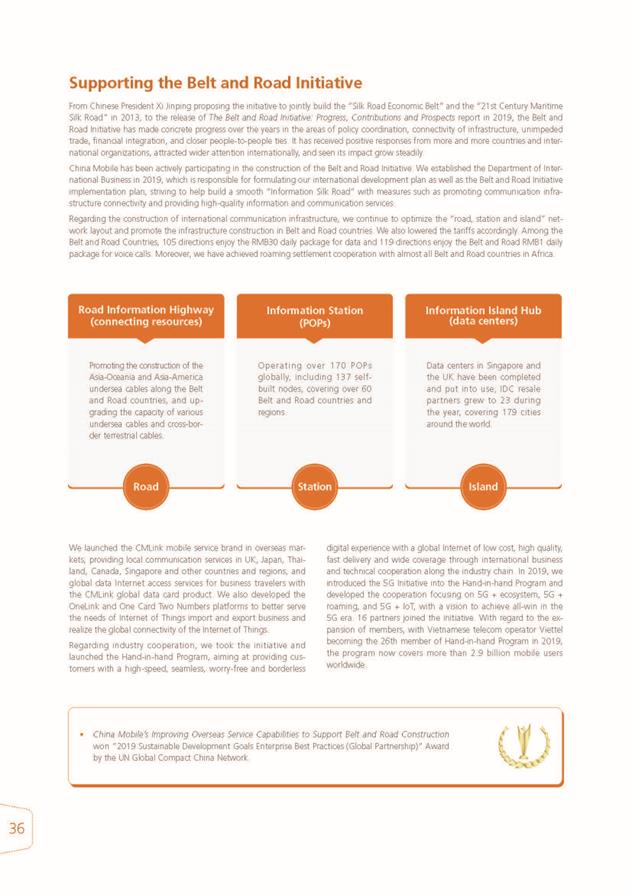
36 Supporting the Belt and Road Initiative From Chinese President Xi Jinping proposing the initiative to jointly build the “Silk Road Economic Belt” and the “21st Century Maritime Silk Road” in 2013, to the release of The Belt and Road Initiative: Progress, Contributions and Prospects report in 2019, the Belt and Road Initiative has made concrete progress over the years in the areas of policy coordination, connectivity of infrastructure, unimpeded trade, financial integration, and closer people-to-people ties. It has received positive responses from more and more countries and international organizations, attracted wider attention internationally, and seen its impact grow steadily. China Mobile has been actively participating in the construction of the Belt and Road Initiative. We established the Department of International Business in 2019, which is responsible for formulating our international development plan as well as the Belt and Road Initiative implementation plan, striving to help build a smooth “Information Silk Road” with measures such as promoting communication infrastructure connectivity and providing high-quality information and communication services. Regarding the construction of international communication infrastructure, we continue to optimize the “road, station and island” network layout and promote the infrastructure construction in Belt and Road countries. We also lowered the tariffs accordingly. Among the Belt and Road Countries, 105 directions enjoy the RMB30 daily package for data and 119 directions enjoy the Belt and Road RMB1 daily package for voice calls. Moreover, we have achieved roaming settlement cooperation with almost all Belt and Road countries in Africa. We launched the CMLink mobile service brand in overseas markets, providing local communication services in UK, Japan, Thailand, Canada, Singapore and other countries and regions, and global data Internet access services for business travelers with the CMLink global data card product. We also developed the OneLink and One Card Two Numbers platforms to better serve the needs of Internet of Things import and export business and realize the global connectivity of the Internet of Things. Regarding industry cooperation, we took the initiative and launched the Hand-in-hand Program, aiming at providing customers with a high-speed, seamless, worry-free and borderless digital experience with a global Internet of low cost, high quality, fast delivery and wide coverage through international business and technical cooperation along the industry chain. In 2019, we introduced the 5G Initiative into the Hand-in-hand Program and developed the cooperation focusing on 5G + ecosystem, 5G + roaming, and 5G + IoT, with a vision to achieve all-win in the 5G era. 16 partners joined the initiative. With regard to the expansion of members, with Vietnamese telecom operator Viettel becoming the 26th member of Hand-in-hand Program in 2019, the program now covers more than 2.9 billion mobile users worldwide. Road Information Highway (connecting resources) Information Station (POPs) Information Island Hub (data centers) Promoting the construction of the Asia-Oceania and Asia-America undersea cables along the Belt and Road countries, and upgrading the capacity of various undersea cables and cross-border terrestrial cables. Operating over 170 POPs globally, including 137 selfbuilt nodes, covering over 60 Belt and Road countries and regions. Data centers in Singapore and the UK have been completed and put into use; IDC resale partners grew to 23 during the year, covering 179 cities around the world. Road China Mobile’s Improving Overseas Service Capabilities to Support Belt and Road Construction won ”2019 Sustainable Development Goals Enterprise Best Practices (Global Partnership)” Award by the UN Global Compact China Network. Station Island
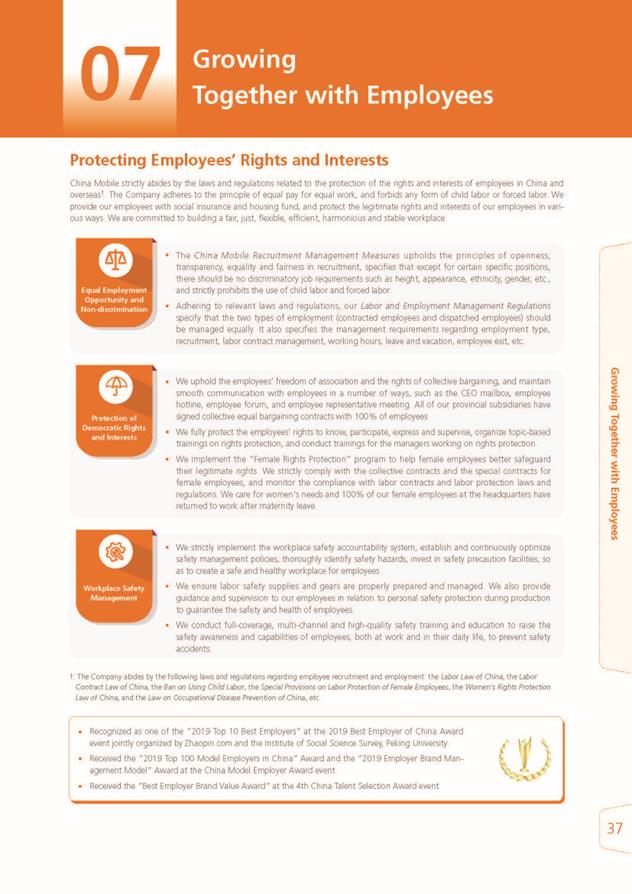
Growing Together with Employees 37 1: The Company abides by the following laws and regulations regarding employee recruitment and employment: the Labor Law of China, the Labor Contract Law of China, the Ban on Using Child Labor, the Special Provisions on Labor Protection of Female Employees, the Women's Rights Protection Law of China, and the Law on Occupational Disease Prevention of China, etc. Recognized as one of the ”2019 Top 10 Best Employers” at the 2019 Best Employer of China Award event jointly organized by Zhaopin.com and the Institute of Social Science Survey, Peking University. Received the ”2019 Top 100 Model Employers in China” Award and the ”2019 Employer Brand Management Model” Award at the China Model Employer Award event. Received the ”Best Employer Brand Value Award” at the 4th China Talent Selection Award event. China Mobile strictly abides by the laws and regulations related to the protection of the rights and interests of employees in China and overseas1. The Company adheres to the principle of equal pay for equal work, and forbids any form of child labor or forced labor. We provide our employees with social insurance and housing fund, and protect the legitimate rights and interests of our employees in various ways. We are committed to building a fair, just, flexible, efficient, harmonious and stable workplace. Protecting Employees’ Rights and Interests Equal Employment Opportunity and Non-discrimination Protection of Democratic Rights and Interests Workplace Safety Management The China Mobile Recruitment Management Measures upholds the principles of openness, transparency, equality and fairness in recruitment, specifies that except for certain specific positions, there should be no discriminatory job requirements such as height, appearance, ethnicity, gender, etc., and strictly prohibits the use of child labor and forced labor. Adhering to relevant laws and regulations, our Labor and Employment Management Regulations specify that the two types of employment (contracted employees and dispatched employees) should be managed equally. It also specifies the management requirements regarding employment type, recruitment, labor contract management, working hours, leave and vacation, employee exit, etc. We uphold the employees’ freedom of association and the rights of collective bargaining, and maintain smooth communication with employees in a number of ways, such as the CEO mailbox, employee hotline, employee forum, and employee representative meeting. All of our provincial subsidiaries have signed collective equal bargaining contracts with 100% of employees. We fully protect the employees’ rights to know, participate, express and supervise, organize topic-based trainings on rights protection, and conduct trainings for the managers working on rights protection. We implement the “Female Rights Protection” program to help female employees better safeguard their legitimate rights. We strictly comply with the collective contracts and the special contracts for female employees, and monitor the compliance with labor contracts and labor protection laws and regulations. We care for women's needs and 100% of our female employees at the headquarters have returned to work after maternity leave. We strictly implement the workplace safety accountability system, establish and continuously optimize safety management policies, thoroughly identify safety hazards, invest in safety precaution facilities, so as to create a safe and healthy workplace for employees. We ensure labor safety supplies and gears are properly prepared and managed. We also provide guidance and supervision to our employees in relation to personal safety protection during production to guarantee the safety and health of employees. We conduct full-coverage, multi-channel and high-quality safety training and education to raise the safety awareness and capabilities of employees, both at work and in their daily life, to prevent safety accidents. Growing Together with Employees 07
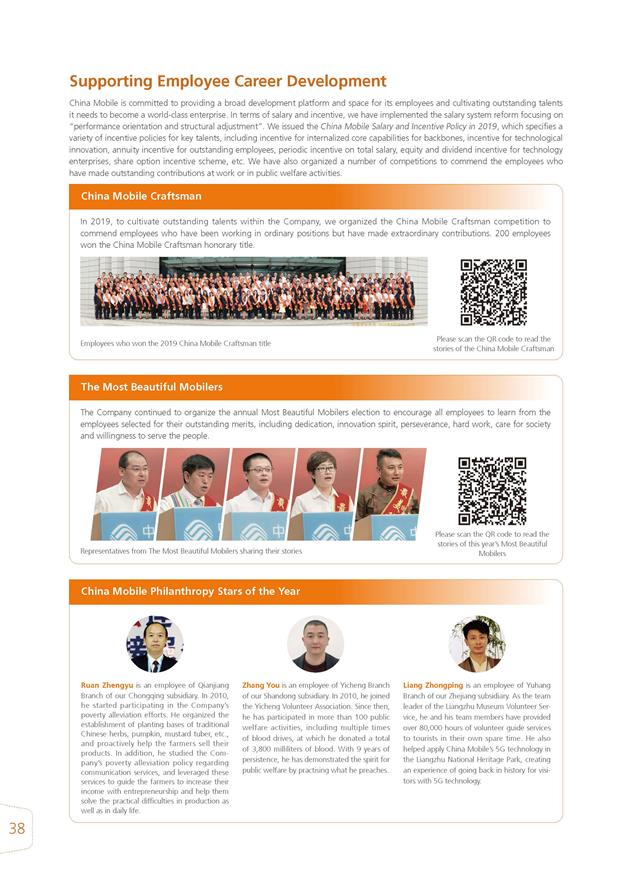
38 Supporting Employee Career Development China Mobile is committed to providing a broad development platform and space for its employees and cultivating outstanding talents it needs to become a world-class enterprise. In terms of salary and incentive, we have implemented the salary system reform focusing on “performance orientation and structural adjustment”. We issued the China Mobile Salary and Incentive Policy in 2019, which specifies a variety of incentive policies for key talents, including incentive for internalized core capabilities for backbones, incentive for technological innovation, annuity incentive for outstanding employees, periodic incentive on total salary, equity and dividend incentive for technology enterprises, share option incentive scheme, etc. We have also organized a number of competitions to commend the employees who have made outstanding contributions at work or in public welfare activities. Employees who won the 2019 China Mobile Craftsman title Representatives from The Most Beautiful Mobilers sharing their stories China Mobile Craftsman The Most Beautiful Mobilers China Mobile Philanthropy Stars of the Year In 2019, to cultivate outstanding talents within the Company, we organized the China Mobile Craftsman competition to commend employees who have been working in ordinary positions but have made extraordinary contributions. 200 employees won the China Mobile Craftsman honorary title. The Company continued to organize the annual Most Beautiful Mobilers election to encourage all employees to learn from the employees selected for their outstanding merits, including dedication, innovation spirit, perseverance, hard work, care for society and willingness to serve the people. Please scan the QR code to read the stories of the China Mobile Craftsman Please scan the QR code to read the stories of this year’s Most Beautiful Mobilers Ruan Zhengyu is an employee of Qianjiang Branch of our Chongqing subsidiary. In 2010, he started participating in the Company’s poverty alleviation efforts. He organized the establishment of planting bases of traditional Chinese herbs, pumpkin, mustard tuber, etc., and proactively help the farmers sell their products. In addition, he studied the Company’s poverty alleviation policy regarding communication services, and leveraged these services to guide the farmers to increase their income with entrepreneurship and help them solve the practical difficulties in production as well as in daily life. Zhang You is an employee of Yicheng Branch of our Shandong subsidiary. In 2010, he joined the Yicheng Volunteer Association. Since then, he has participated in more than 100 public welfare activities, including multiple times of blood drives, at which he donated a total of 3,800 milliliters of blood. With 9 years of persistence, he has demonstrated the spirit for public welfare by practising what he preaches. Liang Zhongping is an employee of Yuhang Branch of our Zhejiang subsidiary. As the team leader of the Liangzhu Museum Volunteer Service, he and his team members have provided over 80,000 hours of volunteer guide services to tourists in their own spare time. He also helped apply China Mobile’s 5G technology in the Liangzhu National Heritage Park, creating an experience of going back in history for visitors with 5G technology.
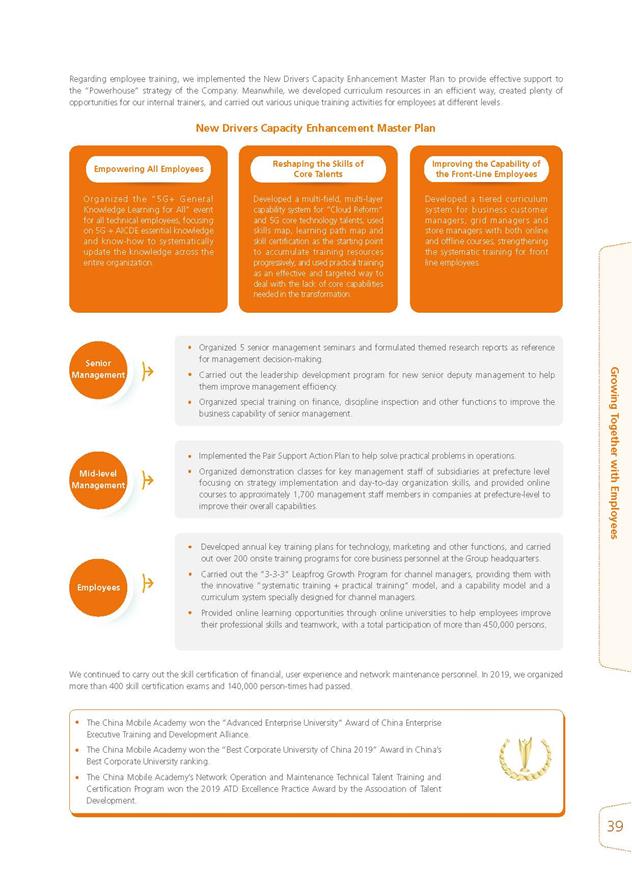
39 Regarding employee training, we implemented the New Drivers Capacity Enhancement Master Plan to provide effective support to the “Powerhouse” strategy of the Company. Meanwhile, we developed curriculum resources in an efficient way, created plenty of opportunities for our internal trainers, and carried out various unique training activities for employees at different levels. Organized the “5G+ General Knowledge Learning for All” event for all technical employees, focusing on 5G + AICDE essential knowledge and know-how to systematically update the knowledge across the entire organization. Developed a multi-field, multi-layer capability system for “Cloud Reform” and 5G core technology talents, used skills map, learning path map and skill certification as the starting point to accumulate training resources progressively, and used practical training as an effective and targeted way to deal with the lack of core capabilities needed in the transformation. Developed a tiered curriculum system for business customer managers, grid managers and store managers with both online and offline courses, strengthening the systematic training for front line employees. New Drivers Capacity Enhancement Master Plan We continued to carry out the skill certification of financial, user experience and network maintenance personnel. In 2019, we organized more than 400 skill certification exams and 140,000 person-times had passed. Implemented the Pair Support Action Plan to help solve practical problems in operations. Organized demonstration classes for key management staff of subsidiaries at prefecture level focusing on strategy implementation and day-to-day organization skills, and provided online courses to approximately 1,700 management staff members in companies at prefecture-level to improve their overall capabilities. Developed annual key training plans for technology, marketing and other functions, and carried out over 200 onsite training programs for core business personnel at the Group headquarters. Carried out the ”3-3-3” Leapfrog Growth Program for channel managers, providing them with the innovative ”systematic training + practical training” model, and a capability model and a curriculum system specially designed for channel managers. Provided online learning opportunities through online universities to help employees improve their professional skills and teamwork, with a total participation of more than 450,000 persons. Organized 5 senior management seminars and formulated themed research reports as reference for management decision-making. Carried out the leadership development program for new senior deputy management to help them improve management efficiency. Organized special training on finance, discipline inspection and other functions to improve the business capability of senior management. The China Mobile Academy won the ”Advanced Enterprise University” Award of China Enterprise Executive Training and Development Alliance. The China Mobile Academy won the “Best Corporate University of China 2019” Award in China’s Best Corporate University ranking. The China Mobile Academy’s Network Operation and Maintenance Technical Talent Training and Certification Program won the 2019 ATD Excellence Practice Award by the Association of Talent Development. Employees Mid-level Management Senior Management Empowering All Employees Reshaping the Skills of Core Talents Improving the Capability of the Front-Line Employees Growing Together with Employees
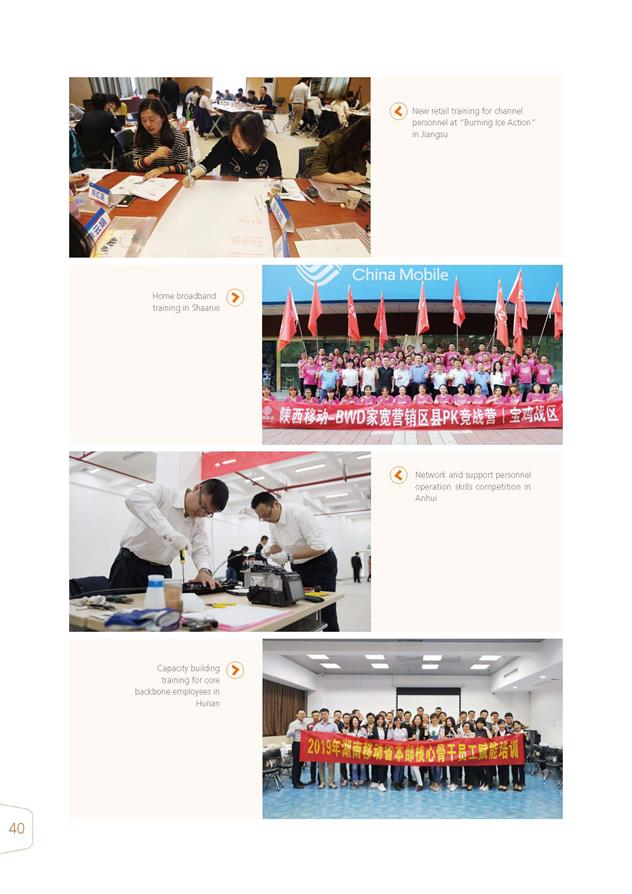
40 New retail training for channel personnel at “Burning Ice Action” in Jiangsu Home broadband training in Shaanxi Network and support personnel operation skills competition in Anhui Capacity building training for core backbone employees in Hunan
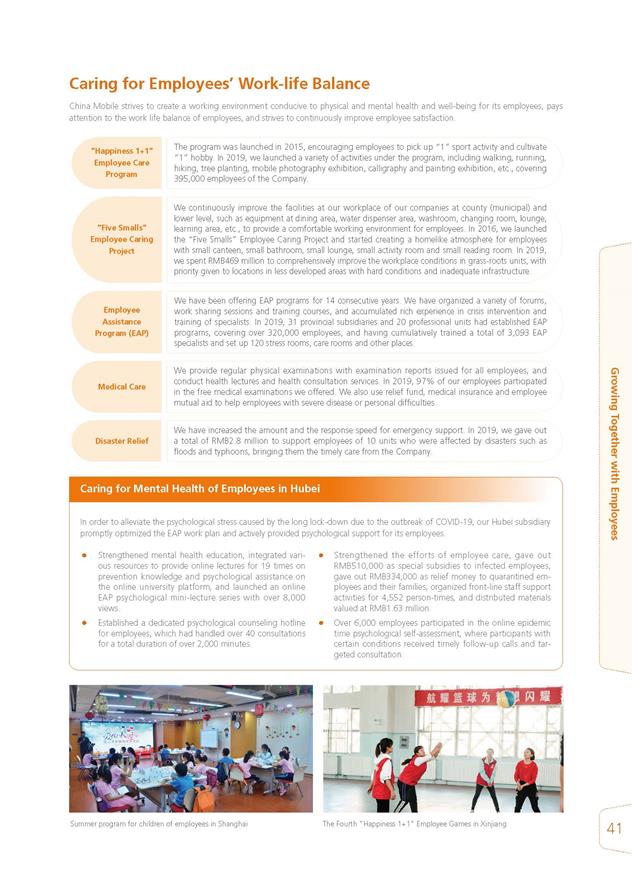
41 China Mobile strives to create a working environment conducive to physical and mental health and well-being for its employees, pays attention to the work life balance of employees, and strives to continuously improve employee satisfaction. Caring for Employees’ Work-life Balance Summer program for children of employees in Shanghai The Fourth ”Happiness 1+1” Employee Games in Xinjiang ”Happiness 1+1” Employee Care Program Medical Care Disaster Relief Employee Assistance Program (EAP) ”Five Smalls” Employee Caring Project Caring for Mental Health of Employees in Hubei Strengthened mental health education, integrated various resources to provide online lectures for 19 times on prevention knowledge and psychological assistance on the online university platform, and launched an online EAP psychological mini-lecture series with over 8,000 views. Established a dedicated psychological counseling hotline for employees, which had handled over 40 consultations for a total duration of over 2,000 minutes. Strengthened the efforts of employee care, gave out RMB510,000 as special subsidies to infected employees, gave out RMB334,000 as relief money to quarantined employees and their families, organized front-line staff support activities for 4,552 person-times, and distributed materials valued at RMB1.63 million. Over 6,000 employees participated in the online epidemic time psychological self-assessment, where participants with certain conditions received timely follow-up calls and targeted consultation. Growing Together with Employees In order to alleviate the psychological stress caused by the long lock-down due to the outbreak of COVID-19, our Hubei subsidiary promptly optimized the EAP work plan and actively provided psychological support for its employees. The program was launched in 2015, encouraging employees to pick up “1” sport activity and cultivate “1” hobby. In 2019, we launched a variety of activities under the program, including walking, running, hiking, tree planting, mobile photography exhibition, calligraphy and painting exhibition, etc., covering 395,000 employees of the Company. We continuously improve the facilities at our workplace of our companies at county (municipal) and lower level, such as equipment at dining area, water dispenser area, washroom, changing room, lounge, learning area, etc., to provide a comfortable working environment for employees. In 2016, we launched the “Five Smalls” Employee Caring Project and started creating a homelike atmosphere for employees with small canteen, small bathroom, small lounge, small activity room and small reading room. In 2019, we spent RMB469 million to comprehensively improve the workplace conditions in grass-roots units, with priority given to locations in less developed areas with hard conditions and inadequate infrastructure. We have been offering EAP programs for 14 consecutive years. We have organized a variety of forums, work sharing sessions and training courses, and accumulated rich experience in crisis intervention and training of specialists. In 2019, 31 provincial subsidiaries and 20 professional units had established EAP programs, covering over 320,000 employees, and having cumulatively trained a total of 3,093 EAP specialists and set up 120 stress rooms, care rooms and other places. We provide regular physical examinations with examination reports issued for all employees, and conduct health lectures and health consultation services. In 2019, 97% of our employees participated in the free medical examinations we offered. We also use relief fund, medical insurance and employee mutual aid to help employees with severe disease or personal difficulties. We have increased the amount and the response speed for emergency support. In 2019, we gave out a total of RMB2.8 million to support employees of 10 units who were affected by disasters such as floods and typhoons, bringing them the timely care from the Company.
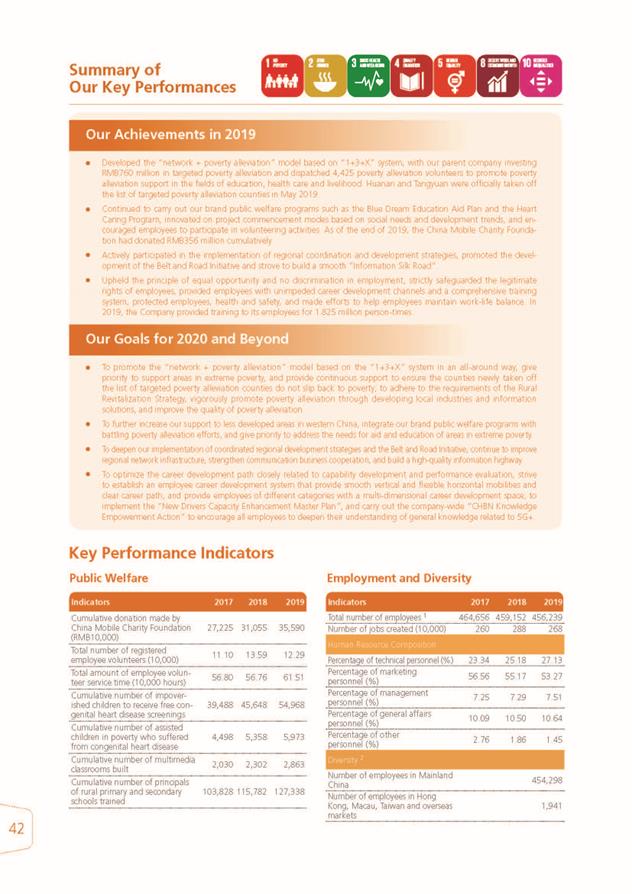
42 Employment and Diversity Summary of Our Key Performances Our Achievements in 2019 Our Goals for 2020 and Beyond Developed the “network + poverty alleviation” model based on “1+3+X” system, with our parent company investing RMB760 million in targeted poverty alleviation and dispatched 4,425 poverty alleviation volunteers to promote poverty alleviation support in the fields of education, health care and livelihood. Huanan and Tangyuan were officially taken off the list of targeted poverty alleviation counties in May 2019. Continued to carry out our brand public welfare programs such as the Blue Dream Education Aid Plan and the Heart Caring Program, innovated on project commencement modes based on social needs and development trends, and encouraged employees to participate in volunteering activities. As of the end of 2019, the China Mobile Charity Foundation had donated RMB356 million cumulatively. Actively participated in the implementation of regional coordination and development strategies, promoted the development of the Belt and Road Initiative and strove to build a smooth ”Information Silk Road”. Upheld the principle of equal opportunity and no discrimination in employment, strictly safeguarded the legitimate rights of employees, provided employees with unimpeded career development channels and a comprehensive training system, protected employees, health and safety, and made efforts to help employees maintain work-life balance. In 2019, the Company provided training to its employees for 1.825 million person-times. To promote the “network + poverty alleviation” model based on the “1+3+X” system in an all-around way, give priority to support areas in extreme poverty, and provide continuous support to ensure the counties newly taken off the list of targeted poverty alleviation counties do not slip back to poverty; to adhere to the requirements of the Rural Revitalization Strategy, vigorously promote poverty alleviation through developing local industries and information solutions, and improve the quality of poverty alleviation. To further increase our support to less developed areas in western China, integrate our brand public welfare programs with battling poverty alleviation efforts, and give priority to address the needs for aid and education of areas in extreme poverty. To deepen our implementation of coordinated regional development strategies and the Belt and Road Initiative, continue to improve regional network infrastructure, strengthen communication business cooperation, and build a high-quality information highway. To optimize the career development path closely related to capability development and performance evaluation, strive to establish an employee career development system that provide smooth vertical and flexible horizontal mobilities and clear career path, and provide employees of different categories with a multi-dimensional career development space; to implement the “New Drivers Capacity Enhancement Master Plan”, and carry out the company-wide “CHBN Knowledge Empowerment Action” to encourage all employees to deepen their understanding of general knowledge related to 5G+. Key Performance Indicators Indicators 2017 2018 2019 Cumulative donation made by China Mobile Charity Foundation (RMB10,000) 27,225 31,055 35,590 Total number of registered employee volunteers (10,000) 11.10 13.59 12.29 Total amount of employee volunteer service time (10,000 hours) 56.80 56.76 61.51 Cumulative number of impoverished children to receive free congenital heart disease screenings 39,488 45,648 54,968 Cumulative number of assisted children in poverty who suffered from congenital heart disease 4,498 5,358 5,973 Cumulative number of multimedia classrooms built 2,030 2,302 2,863 Cumulative number of principals of rural primary and secondary schools trained 103,828 115,782 127,338 Indicators 2017 2018 2019 Total number of employees 1 464,656 459,152 456,239 Number of jobs created (10,000) 260 288 268 Human Resource Composition Percentage of technical personnel (%) 23.34 25.18 27.13 Percentage of marketing personnel (%) 56.56 55.17 53.27 Percentage of management personnel (%) 7.25 7.29 7.51 Percentage of general affairs personnel (%) 10.09 10.50 10.64 Percentage of other personnel (%) 2.76 1.86 1.45 Diversity 2 Number of employees in Mainland China 454,298 Number of employees in Hong Kong, Macau, Taiwan and overseas markets 1,941 Public Welfare
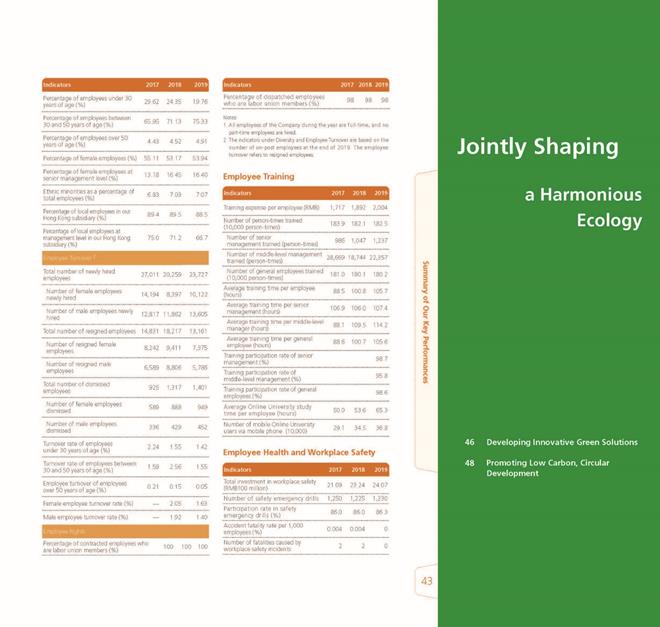
Summary of Our Key Performances Indicators 2017 2018 2019 Percentage of employees under 30 years of age (%) 29.62 24.35 19.76 Percentage of employees between 30 and 50 years of age (%) 65.95 71.13 75.33 Percentage of employees over 50 years of age (%) 4.43 4.52 4.91 Percentage of female employees (%) 55.11 53.17 53.94 Percentage of female employees at senior management level (%) 13.18 16.45 16.40 Ethnic minorities as a percentage of total employees (%) 6.83 7.03 7.07 Percentage of local employees in our Hong Kong subsidiary (%) 89.4 89.5 88.5 Percentage of local employees at management level in our Hong Kong subsidiary (%) 75.0 71.2 66.7 Employee Turnover 2 Total number of newly hired employees 27,011 20,259 23,727 Number of female employees newly hired 14,194 8,397 10,122 Number of male employees newly hired 12,817 11,862 13,605 Total number of resigned employees 14,831 18,217 13,161 Number of resigned female employees 8,242 9,411 7,375 Number of resigned male employees 6,589 8,806 5,786 Total number of dismissed employees 925 1,317 1,401 Number of female employees dismissed 589 888 949 Number of male employees dismissed 336 429 452 Turnover rate of employees under 30 years of age (%) 2.24 1.55 1.42 Turnover rate of employees between 30 and 50 years of age (%) 1.59 2.56 1.55 Employee turnover of employees over 50 years of age (%) 0.21 0.15 0.05 Female employee turnover rate (%) — 2.05 1.63 Male employee turnover rate (%) — 1.92 1.40 Indicators 2017 2018 2019 Total investment in workplace safety (RMB100 million) 21.09 23.24 24.07 Number of safety emergency drills 1,250 1,225 1,230 Participation rate in safety emergency drills (%) 86.0 86.0 86.3 Accident fatality rate per 1,000 employees (%) 0.004 0.004 0 Number of fatalities caused by workplace safety incidents 2 2 0 Indicators 2017 2018 2019 Training expense per employee (RMB) 1,717 1,892 2,004 Number of person-times trained (10,000 person-times) 183.9 182.1 182.5 Number of senior management trained (person-times) 986 1,047 1,237 Number of middle-level management trained (person-times) 28,669 18,744 22,357 Number of general employees trained (10,000 person-times) 181.0 180.1 180.2 Average training time per employee (hours) 88.5 100.8 105.7 Average training time per senior management (hours) 106.9 106.0 107.4 Average training time per middle-level manager (hours) 88.1 109.5 114.2 Average training time per general employee (hours) 88.6 100.7 105.6 Training participation rate of senior management (%) 98.7 Training participation rate of middle-level management (%) 95.8 Training participation rate of general employees (%) 98.6 Average Online University study time per employee (hours) 50.0 53.6 65.3 Number of mobile Online University users via mobile phone (10,000) 29.1 34.5 36.8 Indicators 2017 2018 2019 Percentage of dispatched employees who are labor union members (%) 98 98 98 Employee Rights Percentage of contracted employees who are labor union members (%) 100 100 100 关键绩效表 Notes: 1. All employees of the Company during the year are full-time, and no part-time employees are hired. 2. The indicators under Diversity and Employee Turnover are based on the number of on-post employees at the end of 2019. The employee turnover refers to resigned employees. Developing Innovative Green Solutions Promoting Low Carbon, Circular Development 46 48 a Harmonious Ecology Jointly Shaping Employee Health and Workplace Safety Employee Training 43
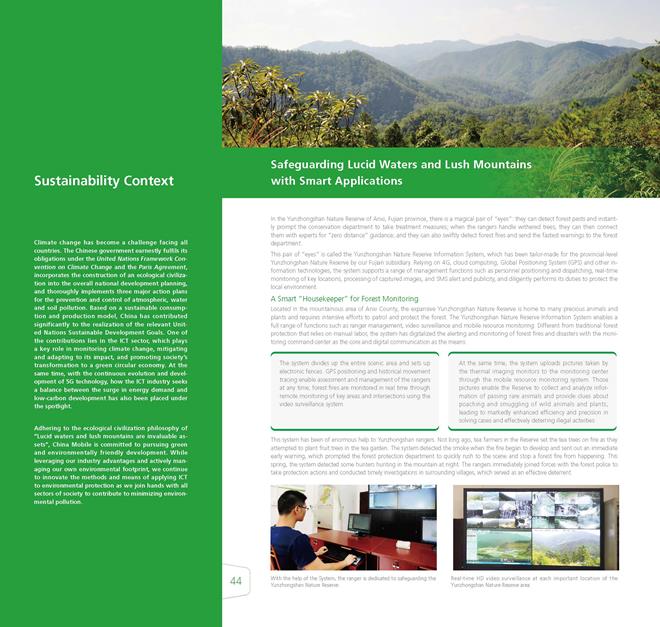
44 Sustainability Context Climate change has become a challenge facing all countries. The Chinese government earnestly fulfils its obligations under the United Nations Framework Convention on Climate Change and the Paris Agreement, incorporates the construction of an ecological civilization into the overall national development planning, and thoroughly implements three major action plans for the prevention and control of atmospheric, water and soil pollution. Based on a sustainable consumption and production model, China has contributed significantly to the realization of the relevant United Nations Sustainable Development Goals. One of the contributions lies in the ICT sector, which plays a key role in monitoring climate change, mitigating and adapting to its impact, and promoting society’s transformation to a green circular economy. At the same time, with the continuous evolution and development of 5G technology, how the ICT industry seeks a balance between the surge in energy demand and low-carbon development has also been placed under the spotlight. Adhering to the ecological civilization philosophy of “Lucid waters and lush mountains are invaluable assets”, China Mobile is committed to pursuing green and environmentally friendly development. While leveraging our industry advantages and actively managing our own environmental footprint, we continue to innovate the methods and means of applying ICT to environmental protection as we join hands with all sectors of society to contribute to minimizing environmental pollution. Safeguarding Lucid Waters and Lush Mountains with Smart Applications In the Yunzhongshan Nature Reserve of Anxi, Fujian province, there is a magical pair of ”eyes”: they can detect forest pests and instantly prompt the conservation department to take treatment measures; when the rangers handle withered trees, they can then connect them with experts for ”zero distance” guidance; and they can also swiftly detect forest fires and send the fastest warnings to the forest department. This pair of “eyes” is called the Yunzhongshan Nature Reserve Information System, which has been tailor-made for the provincial-level Yunzhongshan Nature Reserve by our Fujian subsidiary. Relying on 4G, cloud computing, Global Positioning System (GPS) and other information technologies, the system supports a range of management functions such as personnel positioning and dispatching, real-time monitoring of key locations, processing of captured images, and SMS alert and publicity, and diligently performs its duties to protect the local environment. This system has been of enormous help to Yunzhongshan rangers. Not long ago, tea farmers in the Reserve set the tea trees on fire as they attempted to plant fruit trees in the tea garden. The system detected the smoke when the fire began to develop and sent out an immediate early warning, which prompted the forest protection department to quickly rush to the scene and stop a forest fire from happening. This spring, the system detected some hunters hunting in the mountain at night. The rangers immediately joined forces with the forest police to take protection actions and conducted timely investigations in surrounding villages, which served as an effective deterrent. A Smart ”Housekeeper” for Forest Monitoring Located in the mountainous area of Anxi County, the expansive Yunzhongshan Nature Reserve is home to many precious animals and plants and requires intensive efforts to patrol and protect the forest. The Yunzhongshan Nature Reserve Information System enables a full range of functions such as ranger management, video surveillance and mobile resource monitoring. Different from traditional forest protection that relies on manual labor, the system has digitalized the alerting and monitoring of forest fires and disasters with the monitoring command center as the core and digital communication as the means. With the help of the System, the ranger is dedicated to safeguarding the Yunzhongshan Nature Reserve Real-time HD video surveillance at each important location of the Yunzhongshan Nature Reserve area The system divides up the entire scenic area and sets up electronic fences. GPS positioning and historical movement tracing enable assessment and management of the rangers at any time; forest fires are monitored in real time through remote monitoring of key areas and intersections using the video surveillance system. At the same time, the system uploads pictures taken by the thermal imaging monitors to the monitoring center through the mobile resource monitoring system. Those pictures enable the Reserve to collect and analyze information of passing rare animals and provide clues about poaching and smuggling of wild animals and plants, leading to markedly enhanced efficiency and precision in solving cases and effectively deterring illegal activities.
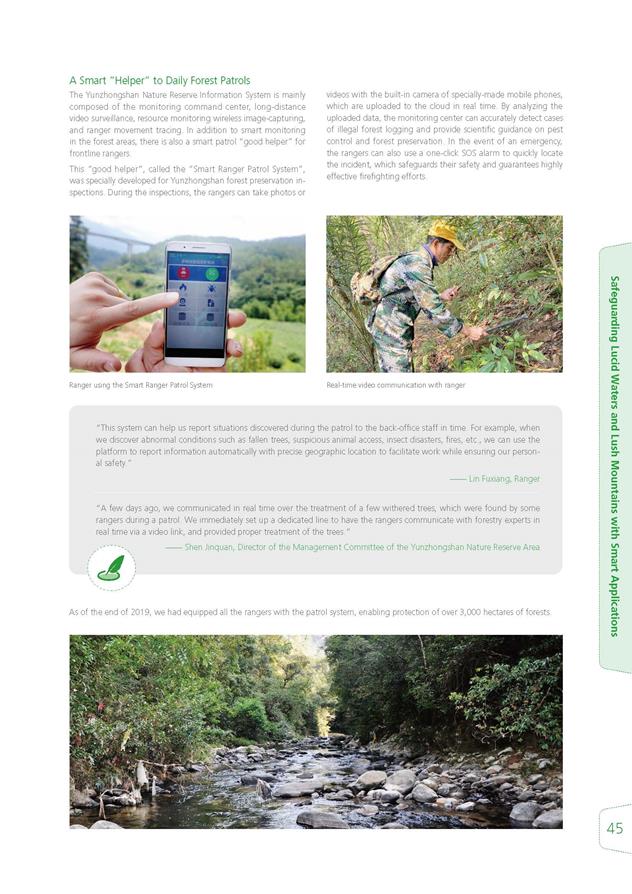
Safeguarding Lucid Waters and Lush Mountains with Smart Applications 45 “A few days ago, we communicated in real time over the treatment of a few withered trees, which were found by some rangers during a patrol. We immediately set up a dedicated line to have the rangers communicate with forestry experts in real time via a video link, and provided proper treatment of the trees.” —— Shen Jinquan, Director of the Management Committee of the Yunzhongshan Nature Reserve Area “This system can help us report situations discovered during the patrol to the back-office staff in time. For example, when we discover abnormal conditions such as fallen trees, suspicious animal access, insect disasters, fires, etc., we can use the platform to report information automatically with precise geographic location to facilitate work while ensuring our personal safety.” —— Lin Fuxiang, Ranger A Smart ”Helper” to Daily Forest Patrols The Yunzhongshan Nature Reserve Information System is mainly composed of the monitoring command center, long-distance video surveillance, resource monitoring wireless image-capturing, and ranger movement tracing. In addition to smart monitoring in the forest areas, there is also a smart patrol “good helper” for frontline rangers. This ”good helper”, called the ”Smart Ranger Patrol System”, was specially developed for Yunzhongshan forest preservation inspections. During the inspections, the rangers can take photos or videos with the built-in camera of specially-made mobile phones, which are uploaded to the cloud in real time. By analyzing the uploaded data, the monitoring center can accurately detect cases of illegal forest logging and provide scientific guidance on pest control and forest preservation. In the event of an emergency, the rangers can also use a one-click SOS alarm to quickly locate the incident, which safeguards their safety and guarantees highly effective firefighting efforts. As of the end of 2019, we had equipped all the rangers with the patrol system, enabling protection of over 3,000 hectares of forests. Ranger using the Smart Ranger Patrol System Real-time video communication with ranger
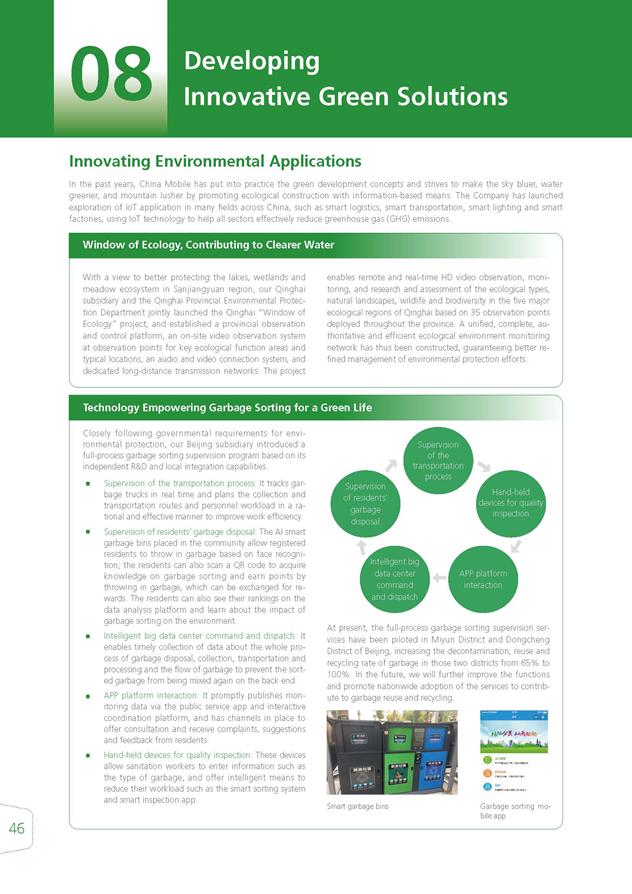
Supervision of residents’ garbage disposal Intelligent big data center command and dispatch Supervision of the transportation process 46 In the past years, China Mobile has put into practice the green development concepts and strives to make the sky bluer, water greener, and mountain lusher by promoting ecological construction with information-based means. The Company has launched exploration of IoT application in many fields across China, such as smart logistics, smart transportation, smart lighting and smart factories, using IoT technology to help all sectors effectively reduce greenhouse gas (GHG) emissions. Innovating Environmental Applications With a view to better protecting the lakes, wetlands and meadow ecosystem in Sanjiangyuan region, our Qinghai subsidiary and the Qinghai Provincial Environmental Protection Department jointly launched the Qinghai “Window of Ecology” project, and established a provincial observation and control platform, an on-site video observation system at observation points for key ecological function areas and typical locations, an audio and video connection system, and dedicated long-distance transmission networks. The project Closely following governmental requirements for environmental protection, our Beijing subsidiary introduced a full-process garbage sorting supervision program based on its independent R&D and local integration capabilities. Window of Ecology, Contributing to Clearer Water Technology Empowering Garbage Sorting for a Green Life enables remote and real-time HD video observation, monitoring, and research and assessment of the ecological types, natural landscapes, wildlife and biodiversity in the five major ecological regions of Qinghai based on 35 observation points deployed throughout the province. A unified, complete, authoritative and efficient ecological environment monitoring network has thus been constructed, guaranteeing better refined management of environmental protection efforts. Supervision of the transportation process: It tracks garbage trucks in real time and plans the collection and transportation routes and personnel workload in a rational and effective manner to improve work efficiency. Supervision of residents’ garbage disposal: The AI smart garbage bins placed in the community allow registered residents to throw in garbage based on face recognition; the residents can also scan a QR code to acquire knowledge on garbage sorting and earn points by throwing in garbage, which can be exchanged for rewards. The residents can also see their rankings on the data analysis platform and learn about the impact of garbage sorting on the environment. Intelligent big data center command and dispatch: It enables timely collection of data about the whole process of garbage disposal, collection, transportation and processing and the flow of garbage to prevent the sorted garbage from being mixed again on the back end. APP platform interaction: It promptly publishes monitoring data via the public service app and interactive coordination platform, and has channels in place to offer consultation and receive complaints, suggestions and feedback from residents. Hand-held devices for quality inspection: These devices allow sanitation workers to enter information such as the type of garbage, and offer intelligent means to reduce their workload such as the smart sorting system and smart inspection app. Hand-held devices for quality inspection APP platform interaction At present, the full-process garbage sorting supervision services have been piloted in Miyun District and Dongcheng District of Beijing, increasing the decontamination, reuse and recycling rate of garbage in those two districts from 65% to 100%. In the future, we will further improve the functions and promote nationwide adoption of the services to contribute to garbage reuse and recycling. Smart garbage bins Garbage sorting mobile app Developing Innovative Green Solutions 08

Developing Innovative Green Solutions 47 Our Energy Conservation Awareness Week continued in 2019. We fully played to our strengths and disseminated low-carbon and green concepts among our stakeholders such as employees, customers and the general public through activities like carbon emissions calculation, “And Machine Swap Service” (the trade-in of old mobile phones for new ones and recycling and refurbishing of optical modems and set top boxes), “Green Box by Your Side” (recycling of used phones, batteries and accessories), Green Life Photography Exhibition, and the publication of the Special Issue on Energy Conservation Awareness. Spreading Green Ideas Scan the QR code to watch China Mobile 2019 Energy Conservation Awareness Week proposal Scan the QR code to learn more about China Mobile Green Action Plan Charity run in celebration of China’s 70th birthday Green class at the private Yumiao Elementary School In Liaoning, our employees made office supplies and daily necessities with waste paper and made vases and unique pen holders and storage boxes with waste newspapers, cultivating a sound atmosphere of energy consumption and low carbon. In Sichuan, we carried out a number of activities such as garbage sorting and recycling, green running and urban ”scanning”, calling on our employees customers and partners to cultivate an environmental awareness in their daily work and life. In Shanxi, we initiated the hand-drawn energy consumption awareness posters event themed “Energy Conservation by My Side” at our business stores in Taiyuan and Yuncheng, promoting green ideas to our customers through delicately drawn posters. “Green Shanghai with You” is a strategic public welfare brand of our Shanghai subsidiary. It works with government agencies and runs diversified programs with a view to intensifying residents’ awareness and actions for loving, protecting and appreciating the environment. Our Shanghai subsidiary hosted a number of environmental protection volunteering campaigns in 2019, which were very well received by the public. Various Green and Environmental Protection Awareness Activities Helping Build Green Urban Homes Charity Run in Celebration of China’s 70th Birthday: We supported activities such as “Scent of Books Exchange for Scent of Flowers” and “One Child and One Tree” at the Charity Run event to allow residents to experience the environmental protection and public welfare concept of “Green Life Starts With Me”. Close-to-nature Family Activity: The event allowed parents and children to experience the wonderful and magical relationship between plants and insects in nature together by watching the ”One Flower One World” painting exhibition. The ”Garbage Sorting” family game further strengthened children's awareness of garbage sorting. Care Activities on Campus: Gifts like ecology photographs and flowers were given to mentally challenged students in the supplementary reading class of Xinzhuang elementary school; educational classes on environmental protection and guided outdoor appreciation courses were given to the private Yumiao Elementary School where the majority of the students were children of migrant workers, and our volunteers also conducted interactive prize quizzes and gave away free plant seeds. Since the project was launched, our Shanghai subsidiary has won honors such as “Excellent Public Welfare Partner” and “Excellent Partner in Shanghai for Volunteer Tree Planting”. In the future, our Shanghai subsidiary will continue to carry out environmental volunteering activities regularly and advocate environmental protection together with the public.
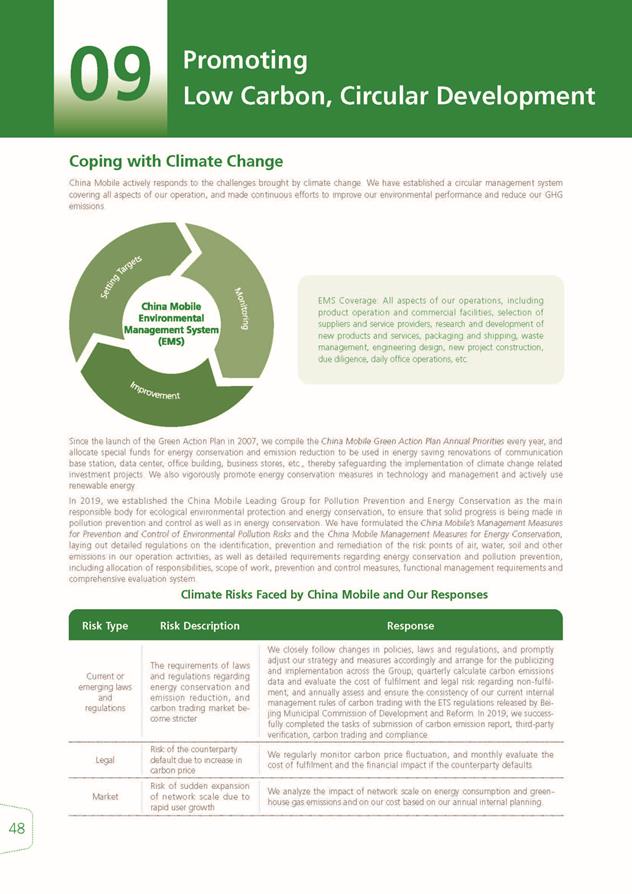
48 Since the launch of the Green Action Plan in 2007, we compile the China Mobile Green Action Plan Annual Priorities every year, and allocate special funds for energy conservation and emission reduction to be used in energy saving renovations of communication base station, data center, office building, business stores, etc., thereby safeguarding the implementation of climate change related investment projects. We also vigorously promote energy conservation measures in technology and management and actively use renewable energy. In 2019, we established the China Mobile Leading Group for Pollution Prevention and Energy Conservation as the main responsible body for ecological environmental protection and energy conservation, to ensure that solid progress is being made in pollution prevention and control as well as in energy conservation. We have formulated the China Mobile’s Management Measures for Prevention and Control of Environmental Pollution Risks and the China Mobile Management Measures for Energy Conservation, laying out detailed regulations on the identification, prevention and remediation of the risk points of air, water, soil and other emissions in our operation activities, as well as detailed requirements regarding energy conservation and pollution prevention, including allocation of responsibilities, scope of work, prevention and control measures, functional management requirements and comprehensive evaluation system. Climate Risks Faced by China Mobile and Our Responses China Mobile actively responds to the challenges brought by climate change. We have established a circular management system covering all aspects of our operation, and made continuous efforts to improve our environmental performance and reduce our GHG emissions. Coping with Climate Change Risk Type Risk Description Response Current or emerging laws and regulations The requirements of laws and regulations regarding energy conservation and emission reduction, and carbon trading market become stricter We closely follow changes in policies, laws and regulations, and promptly adjust our strategy and measures accordingly and arrange for the publicizing and implementation across the Group; quarterly calculate carbon emissions data and evaluate the cost of fulfilment and legal risk regarding non-fulfilment; and annually assess and ensure the consistency of our current internal management rules of carbon trading with the ETS regulations released by Beijing Municipal Commission of Development and Reform. In 2019, we successfully completed the tasks of submission of carbon emission report, third-party verification, carbon trading and compliance. Legal Risk of the counterparty default due to increase in carbon price We regularly monitor carbon price fluctuation, and monthly evaluate the cost of fulfilment and the financial impact if the counterparty defaults. Market Risk of sudden expansion of network scale due to rapid user growth We analyze the impact of network scale on energy consumption and greenhouse gas emissions and on our cost based on our annual internal planning. EMS Coverage: All aspects of our operations, including product operation and commercial facilities, selection of suppliers and service providers, research and development of new products and services, packaging and shipping, waste management, engineering design, new project construction, due diligence, daily office operations, etc. Promoting Low Carbon, Circular Development 09
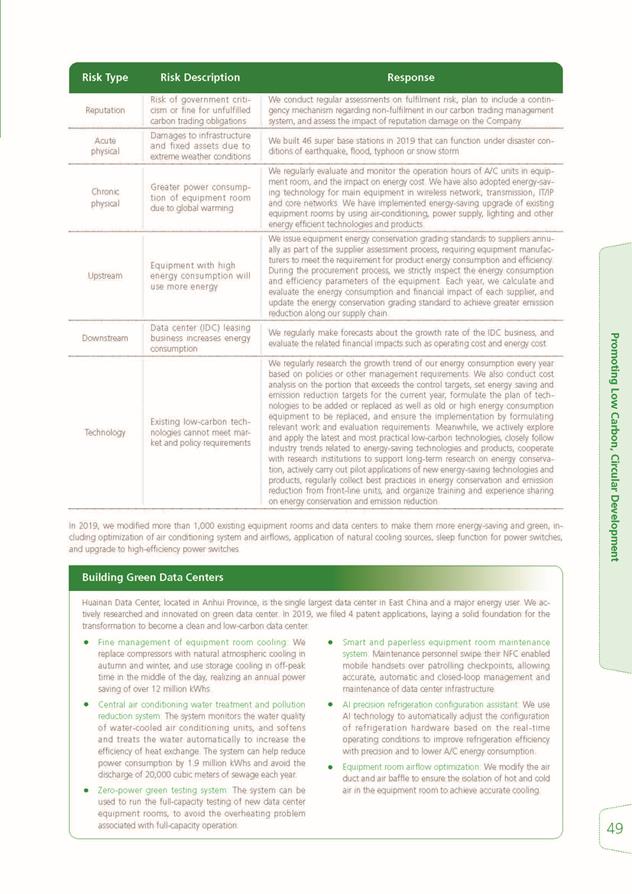
Promoting Low Carbon, Circular Development 49 Huainan Data Center, located in Anhui Province, is the single largest data center in East China and a major energy user. We actively researched and innovated on green data center. In 2019, we filed 4 patent applications, laying a solid foundation for the transformation to become a clean and low-carbon data center. Building Green Data Centers Fine management of equipment room cooling: We replace compressors with natural atmospheric cooling in autumn and winter, and use storage cooling in off-peak time in the middle of the day, realizing an annual power saving of over 12 million kWhs. Central air conditioning water treatment and pollution reduction system: The system monitors the water quality of water-cooled air conditioning units, and softens and treats the water automatically to increase the efficiency of heat exchange. The system can help reduce power consumption by 1.9 million kWhs and avoid the discharge of 20,000 cubic meters of sewage each year. Zero-power green testing system: The system can be used to run the full-capacity testing of new data center equipment rooms, to avoid the overheating problem associated with full-capacity operation. Smart and paperless equipment room maintenance system: Maintenance personnel swipe their NFC enabled mobile handsets over patrolling checkpoints, allowing accurate, automatic and closed-loop management and maintenance of data center infrastructure. AI precision refrigeration configuration assistant: We use AI technology to automatically adjust the configuration of refrigeration hardware based on the real-time operating conditions to improve refrigeration efficiency with precision and to lower A/C energy consumption. Equipment room airflow optimization: We modify the air duct and air baffle to ensure the isolation of hot and cold air in the equipment room to achieve accurate cooling. In 2019, we modified more than 1,000 existing equipment rooms and data centers to make them more energy-saving and green, including optimization of air conditioning system and airflows, application of natural cooling sources, sleep function for power switches, and upgrade to high-efficiency power switches. Risk Type Risk Description Response Reputation Risk of government criticism or fine for unfulfilled carbon trading obligations We conduct regular assessments on fulfilment risk, plan to include a contingency mechanism regarding non-fulfilment in our carbon trading management system, and assess the impact of reputation damage on the Company. Acute physical Damages to infrastructure and fixed assets due to extreme weather conditions We built 46 super base stations in 2019 that can function under disaster conditions of earthquake, flood, typhoon or snow storm. Chronic physical Greater power consumption of equipment room due to global warming We regularly evaluate and monitor the operation hours of A/C units in equipment room, and the impact on energy cost. We have also adopted energy-saving technology for main equipment in wireless network, transmission, IT/IP and core networks. We have implemented energy-saving upgrade of existing equipment rooms by using air-conditioning, power supply, lighting and other energy efficient technologies and products. Upstream Equipment with high energy consumption will use more energy We issue equipment energy conservation grading standards to suppliers annually as part of the supplier assessment process, requiring equipment manufacturers to meet the requirement for product energy consumption and efficiency. During the procurement process, we strictly inspect the energy consumption and efficiency parameters of the equipment. Each year, we calculate and evaluate the energy consumption and financial impact of each supplier, and update the energy conservation grading standard to achieve greater emission reduction along our supply chain. Downstream Data center (IDC) leasing business increases energy consumption We regularly make forecasts about the growth rate of the IDC business, and evaluate the related financial impacts such as operating cost and energy cost. Technology Existing low-carbon technologies cannot meet market and policy requirements We regularly research the growth trend of our energy consumption every year based on policies or other management requirements. We also conduct cost analysis on the portion that exceeds the control targets, set energy saving and emission reduction targets for the current year, formulate the plan of technologies to be added or replaced as well as old or high energy consumption equipment to be replaced, and ensure the implementation by formulating relevant work and evaluation requirements. Meanwhile, we actively explore and apply the latest and most practical low-carbon technologies, closely follow industry trends related to energy-saving technologies and products, cooperate with research institutions to support long-term research on energy conservation, actively carry out pilot applications of new energy-saving technologies and products, regularly collect best practices in energy conservation and emission reduction from front-line units, and organize training and experience sharing on energy conservation and emission reduction.
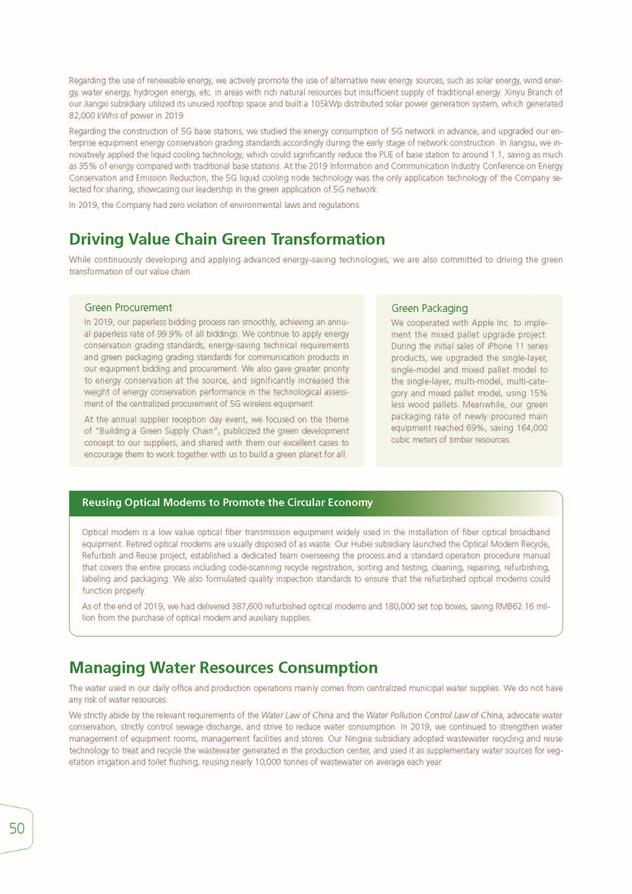
50 Regarding the use of renewable energy, we actively promote the use of alternative new energy sources, such as solar energy, wind energy, water energy, hydrogen energy, etc. in areas with rich natural resources but insufficient supply of traditional energy. Xinyu Branch of our Jiangxi subsidiary utilized its unused rooftop space and built a 105kWp distributed solar power generation system, which generated 82,000 kWhs of power in 2019. Regarding the construction of 5G base stations, we studied the energy consumption of 5G network in advance, and upgraded our enterprise equipment energy conservation grading standards accordingly during the early stage of network construction. In Jiangsu, we innovatively applied the liquid cooling technology, which could significantly reduce the PUE of base station to around 1.1, saving as much as 35% of energy compared with traditional base stations. At the 2019 Information and Communication Industry Conference on Energy Conservation and Emission Reduction, the 5G liquid cooling node technology was the only application technology of the Company selected for sharing, showcasing our leadership in the green application of 5G network. In 2019, the Company had zero violation of environmental laws and regulations. Managing Water Resources Consumption The water used in our daily office and production operations mainly comes from centralized municipal water supplies. We do not have any risk of water resources. We strictly abide by the relevant requirements of the Water Law of China and the Water Pollution Control Law of China, advocate water conservation, strictly control sewage discharge, and strive to reduce water consumption. In 2019, we continued to strengthen water management of equipment rooms, management facilities and stores. Our Ningxia subsidiary adopted wastewater recycling and reuse technology to treat and recycle the wastewater generated in the production center, and used it as supplementary water sources for vegetation irrigation and toilet flushing, reusing nearly 10,000 tonnes of wastewater on average each year. Driving Value Chain Green Transformation While continuously developing and applying advanced energy-saving technologies, we are also committed to driving the green transformation of our value chain. Optical modem is a low value optical fiber transmission equipment widely used in the installation of fiber optical broadband equipment. Retired optical modems are usually disposed of as waste. Our Hubei subsidiary launched the Optical Modem Recycle, Refurbish and Reuse project, established a dedicated team overseeing the process and a standard operation procedure manual that covers the entire process including code-scanning recycle registration, sorting and testing, cleaning, repairing, refurbishing, labeling and packaging. We also formulated quality inspection standards to ensure that the refurbished optical modems could function properly. As of the end of 2019, we had delivered 387,600 refurbished optical modems and 180,000 set top boxes, saving RMB62.16 million from the purchase of optical modem and auxiliary supplies. Reusing Optical Modems to Promote the Circular Economy Green Procurement In 2019, our paperless bidding process ran smoothly, achieving an annual paperless rate of 99.9% of all biddings. We continue to apply energy conservation grading standards, energy-saving technical requirements and green packaging grading standards for communication products in our equipment bidding and procurement. We also gave greater priority to energy conservation at the source, and significantly increased the weight of energy conservation performance in the technological assessment of the centralized procurement of 5G wireless equipment. At the annual supplier reception day event, we focused on the theme of “Building a Green Supply Chain”, publicized the green development concept to our suppliers, and shared with them our excellent cases to encourage them to work together with us to build a green planet for all. Green Packaging We cooperated with Apple Inc. to implement the mixed pallet upgrade project. During the initial sales of iPhone 11 series products, we upgraded the single-layer, single-model and mixed pallet model to the single-layer, multi-model, multi-category and mixed pallet model, using 15% less wood pallets. Meanwhile, our green packaging rate of newly procured main equipment reached 69%, saving 164,000 cubic meters of timber resources.
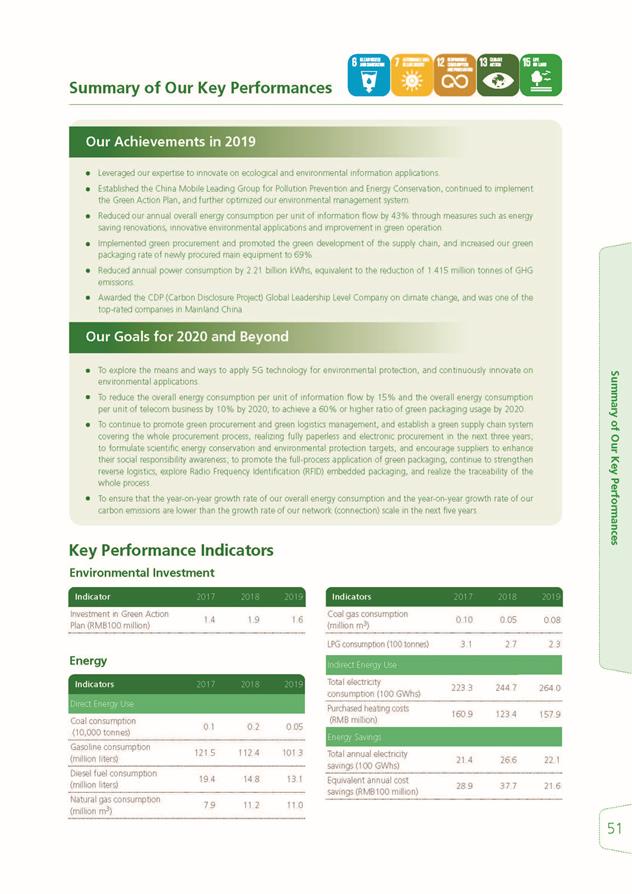
Summary of Our Key Performances 51 Indicator 2017 2018 2019 Investment in Green Action Plan (RMB100 million) 1.4 1.9 1.6 Indicators 2017 2018 2019 Coal gas consumption (million m3) 0.10 0.05 0.08 LPG consumption (100 tonnes) 3.1 2.7 2.3 Indirect Energy Use Total electricity consumption (100 GWhs) 223.3 244.7 264.0 Purchased heating costs (RMB million) 160.9 123.4 157.9 Energy Savings Total annual electricity savings (100 GWhs) 21.4 26.6 22.1 Equivalent annual cost savings (RMB100 million) 28.9 37.7 21.6 Key Performance Indicators Environmental Investment Energy Summary of Our Key Performances Our Achievements in 2019 Our Goals for 2020 and Beyond Leveraged our expertise to innovate on ecological and environmental information applications. Established the China Mobile Leading Group for Pollution Prevention and Energy Conservation, continued to implement the Green Action Plan, and further optimized our environmental management system. Reduced our annual overall energy consumption per unit of information flow by 43% through measures such as energy saving renovations, innovative environmental applications and improvement in green operation. Implemented green procurement and promoted the green development of the supply chain, and increased our green packaging rate of newly procured main equipment to 69%. Reduced annual power consumption by 2.21 billion kWhs, equivalent to the reduction of 1.415 million tonnes of GHG emissions. Awarded the CDP (Carbon Disclosure Project) Global Leadership Level Company on climate change, and was one of the top-rated companies in Mainland China. To explore the means and ways to apply 5G technology for environmental protection, and continuously innovate on environmental applications. To reduce the overall energy consumption per unit of information flow by 15% and the overall energy consumption per unit of telecom business by 10% by 2020; to achieve a 60% or higher ratio of green packaging usage by 2020. To continue to promote green procurement and green logistics management, and establish a green supply chain system covering the whole procurement process, realizing fully paperless and electronic procurement in the next three years; to formulate scientific energy conservation and environmental protection targets, and encourage suppliers to enhance their social responsibility awareness; to promote the full-process application of green packaging, continue to strengthen reverse logistics, explore Radio Frequency Identification (RFID) embedded packaging, and realize the traceability of the whole process. To ensure that the year-on-year growth rate of our overall energy consumption and the year-on-year growth rate of our carbon emissions are lower than the growth rate of our network (connection) scale in the next five years. Indicators 2017 2018 2019 Direct Energy Use Coal consumption (10,000 tonnes) 0.1 0.2 0.05 Gasoline consumption (million liters) 121.5 112.4 101.3 Diesel fuel consumption (million liters) 19.4 14.8 13.1 Natural gas consumption (million m3) 7.9 11.2 11.0
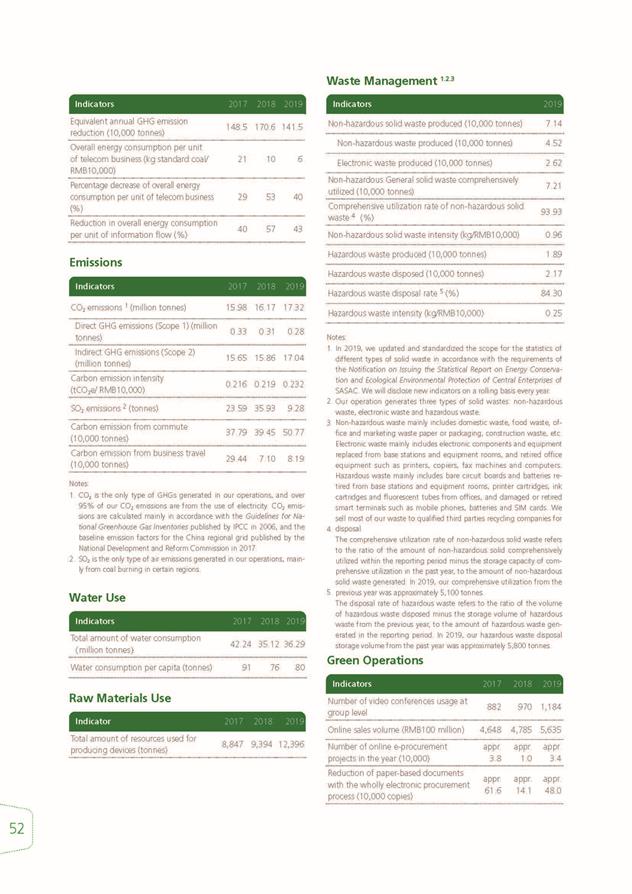
52 Indicators 2017 2018 2019 Equivalent annual GHG emission reduction (10,000 tonnes) 148.5 170.6 141.5 Overall energy consumption per unit of telecom business (kg standard coal/ RMB10,000) 21 10 6 Percentage decrease of overall energy consumption per unit of telecom business (%) 29 53 40 Reduction in overall energy consumption per unit of information flow (%) 40 57 43 Indicators 2017 2018 2019 CO2 emissions 1 (million tonnes) 15.98 16.17 17.32 Direct GHG emissions (Scope 1) (million tonnes) 0.33 0.31 0.28 Indirect GHG emissions (Scope 2) (million tonnes) 15.65 15.86 17.04 Carbon emission intensity (tCO2e/ RMB10,000) 0.216 0.219 0.232 SO2 emissions 2 (tonnes) 23.59 35.93 9.28 Carbon emission from commute (10,000 tonnes) 37.79 39.45 50.77 Carbon emission from business travel (10,000 tonnes) 29.44 7.10 8.19 Indicators 2017 2018 2019 Total amount of water consumption (million tonnes) 42.24 35.12 36.29 Water consumption per capita (tonnes) 91 76 80 Indicator 2017 2018 2019 Total amount of resources used for producing devices (tonnes) 8,847 9,394 12,396 Indicators 2019 Non-hazardous solid waste produced (10,000 tonnes) 7.14 Non-hazardous waste produced (10,000 tonnes) 4.52 Electronic waste produced (10,000 tonnes) 2.62 Non-hazardous General solid waste comprehensively utilized (10,000 tonnes) 7.21 Comprehensive utilization rate of non-hazardous solid waste 4 (%) 93.93 Non-hazardous solid waste intensity (kg/RMB10,000) 0.96 Hazardous waste produced (10,000 tonnes) 1.89 Hazardous waste disposed (10,000 tonnes) 2.17 Hazardous waste disposal rate 5 (%) 84.30 Hazardous waste intensity (kg/RMB10,000) 0.25 Indicators 2017 2018 2019 Number of video conferences usage at group level 882 970 1,184 Online sales volume (RMB100 million) 4,648 4,785 5,635 Number of online e-procurement projects in the year (10,000) appr. 3.8 appr. 1.0 appr. 3.4 Reduction of paper-based documents with the wholly electronic procurement process (10,000 copies) appr. 61.6 appr. 14.1 appr. 48.0 Emissions Water Use Green Operations Raw Materials Use Waste Management 1.2.3 CO2 is the only type of GHGs generated in our operations, and over 95% of our CO2 emissions are from the use of electricity. CO2 emissions are calculated mainly in accordance with the Guidelines for National Greenhouse Gas Inventories published by IPCC in 2006, and the baseline emission factors for the China regional grid published by the National Development and Reform Commission in 2017. SO2 is the only type of air emissions generated in our operations, mainly from coal burning in certain regions. 2. 1. Notes: In 2019, we updated and standardized the scope for the statistics of different types of solid waste in accordance with the requirements of the Notification on Issuing the Statistical Report on Energy Conservation and Ecological Environmental Protection of Central Enterprises of SASAC. We will disclose new indicators on a rolling basis every year. Our operation generates three types of solid wastes: non-hazardous waste, electronic waste and hazardous waste. Non-hazardous waste mainly includes domestic waste, food waste, office and marketing waste paper or packaging, construction waste, etc. Electronic waste mainly includes electronic components and equipment replaced from base stations and equipment rooms, and retired office equipment such as printers, copiers, fax machines and computers. Hazardous waste mainly includes bare circuit boards and batteries retired from base stations and equipment rooms, printer cartridges, ink cartridges and fluorescent tubes from offices, and damaged or retired smart terminals such as mobile phones, batteries and SIM cards. We sell most of our waste to qualified third parties recycling companies for disposal. The comprehensive utilization rate of non-hazardous solid waste refers to the ratio of the amount of non-hazardous solid comprehensively utilized within the reporting period minus the storage capacity of comprehensive utilization in the past year, to the amount of non-hazardous solid waste generated. In 2019, our comprehensive utilization from the previous year was approximately 5,100 tonnes. The disposal rate of hazardous waste refers to the ratio of the volume of hazardous waste disposed minus the storage volume of hazardous waste from the previous year, to the amount of hazardous waste generated in the reporting period. In 2019, our hazardous waste disposal storage volume from the past year was approximately 5,800 tonnes. 1. 3. 2. 4. 5. Notes:
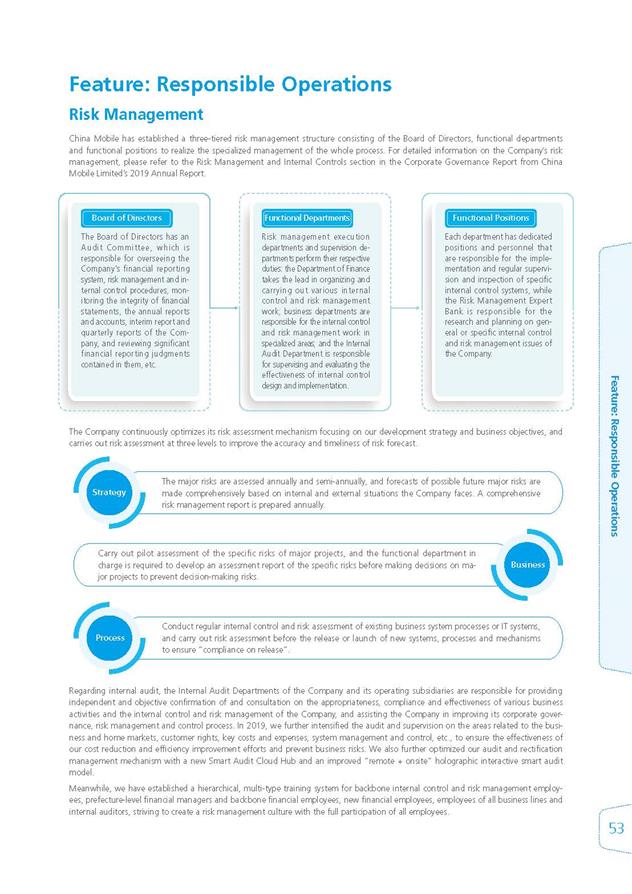
Risk Management China Mobile has established a three-tiered risk management structure consisting of the Board of Directors, functional departments and functional positions to realize the specialized management of the whole process. For detailed information on the Company’s risk management, please refer to the Risk Management and Internal Controls section in the Corporate Governance Report from China Mobile Limited’s 2019 Annual Report. The Company continuously optimizes its risk assessment mechanism focusing on our development strategy and business objectives, and carries out risk assessment at three levels to improve the accuracy and timeliness of risk forecast. Feature: Responsible Operations The Board of Directors has an Audit Committee, which is responsible for overseeing the Company’s financial reporting system, risk management and internal control procedures, monitoring the integrity of financial statements, the annual reports and accounts, interim report and quarterly reports of the Company, and reviewing significant financial reporting judgments contained in them, etc. Risk management execution departments and supervision departments perform their respective duties: the Department of Finance takes the lead in organizing and carrying out various internal control and risk management work; business departments are responsible for the internal control and risk management work in specialized areas; and the Internal Audit Department is responsible for supervising and evaluating the effectiveness of internal control design and implementation. Each department has dedicated positions and personnel that are responsible for the implementation and regular supervision and inspection of specific internal control systems, while the Risk Management Expert Bank is responsible for the research and planning on general or specific internal control and risk management issues of the Company. Board of Directors Functional Departments Functional Positions Regarding internal audit, the Internal Audit Departments of the Company and its operating subsidiaries are responsible for providing independent and objective confirmation of and consultation on the appropriateness, compliance and effectiveness of various business activities and the internal control and risk management of the Company, and assisting the Company in improving its corporate governance, risk management and control process. In 2019, we further intensified the audit and supervision on the areas related to the business and home markets, customer rights, key costs and expenses, system management and control, etc., to ensure the effectiveness of our cost reduction and efficiency improvement efforts and prevent business risks. We also further optimized our audit and rectification management mechanism with a new Smart Audit Cloud Hub and an improved “remote + onsite” holographic interactive smart audit model. Meanwhile, we have established a hierarchical, multi-type training system for backbone internal control and risk management employees, prefecture-level financial managers and backbone financial employees, new financial employees, employees of all business lines and internal auditors, striving to create a risk management culture with the full participation of all employees. The major risks are assessed annually and semi-annually, and forecasts of possible future major risks are made comprehensively based on internal and external situations the Company faces. A comprehensive risk management report is prepared annually. Carry out pilot assessment of the specific risks of major projects, and the functional department in charge is required to develop an assessment report of the specific risks before making decisions on major projects to prevent decision-making risks. Conduct regular internal control and risk assessment of existing business system processes or IT systems, and carry out risk assessment before the release or launch of new systems, processes and mechanisms to ensure ”compliance on release”. Strategy Business Feature: Responsible Operations 53 Process
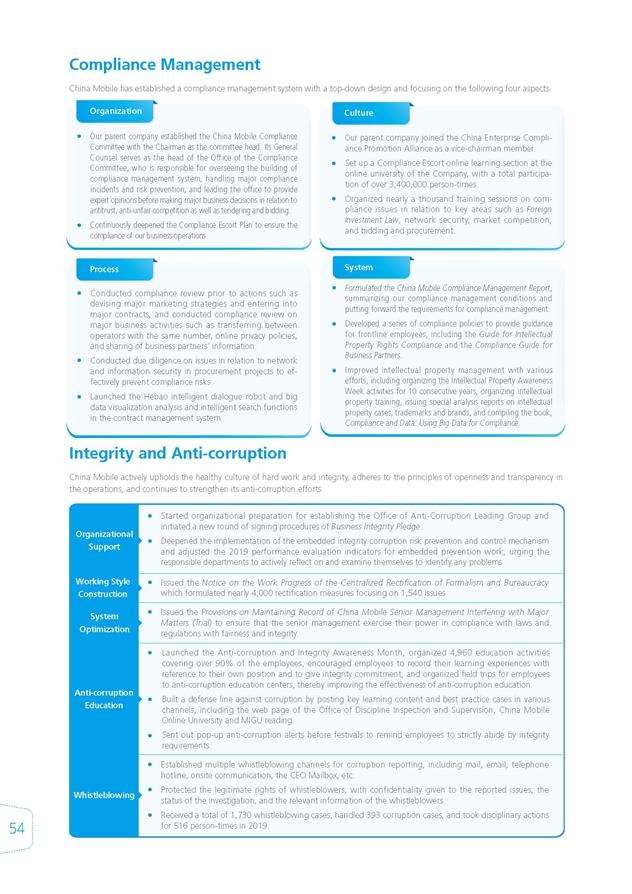
54 Integrity and Anti-corruption China Mobile actively upholds the healthy culture of hard work and integrity, adheres to the principles of openness and transparency in the operations, and continues to strengthen its anti-corruption efforts. Compliance Management China Mobile has established a compliance management system with a top-down design and focusing on the following four aspects. Our parent company established the China Mobile Compliance Committee with the Chairman as the committee head. Its General Counsel serves as the head of the Office of the Compliance Committee, who is responsible for overseeing the building of compliance management system, handling major compliance incidents and risk prevention, and leading the office to provide expert opinions before making major business decisions in relation to antitrust, anti-unfair competition as well as tendering and bidding. Continuously deepened the Compliance Escort Plan to ensure the compliance of our business operations. Conducted compliance review prior to actions such as devising major marketing strategies and entering into major contracts, and conducted compliance review on major business activities such as transferring between operators with the same number, online privacy policies, and sharing of business partners’ information. Conducted due diligence on issues in relation to network and information security in procurement projects to effectively prevent compliance risks. Launched the Hebao intelligent dialogue robot and big data visualization analysis and intelligent search functions in the contract management system. Formulated the China Mobile Compliance Management Report, summarizing our compliance management conditions and putting forward the requirements for compliance management. Developed a series of compliance policies to provide guidance for frontline employees, including the Guide for Intellectual Property Rights Compliance and the Compliance Guide for Business Partners. Improved intellectual property management with various efforts, including organizing the Intellectual Property Awareness Week activities for 10 consecutive years, organizing intellectual property training, issuing special analysis reports on intellectual property cases, trademarks and brands, and compiling the book, Compliance and Data: Using Big Data for Compliance. Our parent company joined the China Enterprise Compliance Promotion Alliance as a vice-chairman member. Set up a Compliance Escort online learning section at the online university of the Company, with a total participation of over 3,400,000 person-times. Organized nearly a thousand training sessions on compliance issues in relation to key areas such as Foreign Investment Law, network security, market competition, and bidding and procurement. Started organizational preparation for establishing the Office of Anti-Corruption Leading Group and initiated a new round of signing procedures of Business Integrity Pledge. Deepened the implementation of the embedded integrity corruption risk prevention and control mechanism and adjusted the 2019 performance evaluation indicators for embedded prevention work, urging the responsible departments to actively reflect on and examine themselves to identify any problems. Issued the Notice on the Work Progress of the Centralized Rectification of Formalism and Bureaucracy which formulated nearly 4,000 rectification measures focusing on 1,540 issues. Issued the Provisions on Maintaining Record of China Mobile Senior Management Interfering with Major Matters (Trial) to ensure that the senior management exercise their power in compliance with laws and regulations with fairness and integrity. Established multiple whistleblowing channels for corruption reporting, including mail, email, telephone hotline, onsite communication, the CEO Mailbox, etc. Protected the legitimate rights of whistleblowers, with confidentiality given to the reported issues, the status of the investigation, and the relevant information of the whistleblowers. Received a total of 1,730 whistleblowing cases, handled 393 corruption cases, and took disciplinary actions for 516 person-times in 2019. Launched the Anti-corruption and Integrity Awareness Month, organized 4,960 education activities covering over 90% of the employees; encouraged employees to record their learning experiences with reference to their own position and to give integrity commitment, and organized field trips for employees to anti-corruption education centers, thereby improving the effectiveness of anti-corruption education. Built a defense line against corruption by posting key learning content and best practice cases in various channels, including the web page of the Office of Discipline Inspection and Supervision, China Mobile Online University and MIGU reading. Sent out pop-up anti-corruption alerts before festivals to remind employees to strictly abide by integrity requirements. Organizational Support System Optimization Anti-corruption Education Whistleblowing Working Style Construction Organization Process System Culture
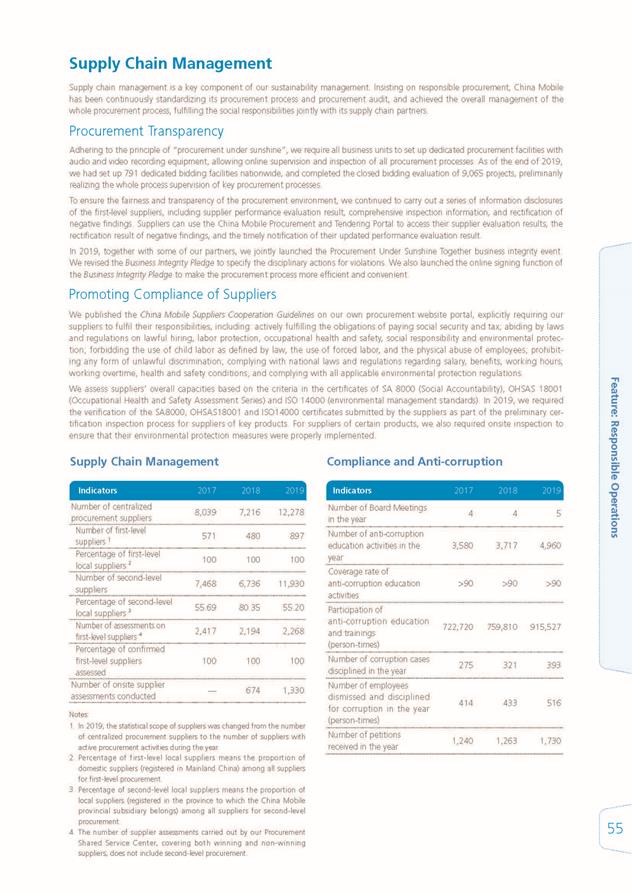
55 In 2019, the statistical scope of suppliers was changed from the number of centralized procurement suppliers to the number of suppliers with active procurement activities during the year. Percentage of first-level local suppliers means the proportion of domestic suppliers (registered in Mainland China) among all suppliers for first-level procurement. Percentage of second-level local suppliers means the proportion of local suppliers (registered in the province to which the China Mobile provincial subsidiary belongs) among all suppliers for second-level procurement. The number of supplier assessments carried out by our Procurement Shared Service Center, covering both winning and non-winning suppliers, does not include second-level procurement. 1. 3. 2. 4. Notes: Supply Chain Management Compliance and Anti-corruption Indicators 2017 2018 2019 Number of centralized procurement suppliers 8,039 7,216 12,278 Number of first-level suppliers 1 571 480 897 Percentage of first-level local suppliers 2 100 100 100 Number of second-level suppliers 7,468 6,736 11,930 Percentage of second-level local suppliers 3 55.69 80.35 55.20 Number of assessments on first-level suppliers 4 2,417 2,194 2,268 Percentage of confirmed first-level suppliers assessed 100 100 100 Number of onsite supplier assessments conducted — 674 1,330 Indicators 2017 2018 2019 Number of Board Meetings in the year 4 4 5 Number of anti-corruption education activities in the year 3,580 3,717 4,960 Coverage rate of anti-corruption education activities >90 >90 >90 Participation of anti-corruption education and trainings (person-times) 722,720 759,810 915,527 Number of corruption cases disciplined in the year 275 321 393 Number of employees dismissed and disciplined for corruption in the year (person-times) 414 433 516 Number of petitions received in the year 1,240 1,263 1,730 We published the China Mobile Suppliers Cooperation Guidelines on our own procurement website portal, explicitly requiring our suppliers to fulfil their responsibilities, including: actively fulfilling the obligations of paying social security and tax; abiding by laws and regulations on lawful hiring, labor protection, occupational health and safety, social responsibility and environmental protection; forbidding the use of child labor as defined by law, the use of forced labor, and the physical abuse of employees; prohibiting any form of unlawful discrimination; complying with national laws and regulations regarding salary, benefits, working hours, working overtime, health and safety conditions; and complying with all applicable environmental protection regulations. We assess suppliers’ overall capacities based on the criteria in the certificates of SA 8000 (Social Accountability), OHSAS 18001 (Occupational Health and Safety Assessment Series) and ISO 14000 (environmental management standards). In 2019, we required the verification of the SA8000, OHSAS18001 and ISO14000 certificates submitted by the suppliers as part of the preliminary certification inspection process for suppliers of key products. For suppliers of certain products, we also required onsite inspection to ensure that their environmental protection measures were properly implemented. Promoting Compliance of Suppliers Adhering to the principle of “procurement under sunshine”, we require all business units to set up dedicated procurement facilities with audio and video recording equipment, allowing online supervision and inspection of all procurement processes. As of the end of 2019, we had set up 791 dedicated bidding facilities nationwide, and completed the closed bidding evaluation of 9,065 projects, preliminarily realizing the whole process supervision of key procurement processes. To ensure the fairness and transparency of the procurement environment, we continued to carry out a series of information disclosures of the first-level suppliers, including supplier performance evaluation result, comprehensive inspection information, and rectification of negative findings. Suppliers can use the China Mobile Procurement and Tendering Portal to access their supplier evaluation results, the rectification result of negative findings, and the timely notification of their updated performance evaluation result. In 2019, together with some of our partners, we jointly launched the Procurement Under Sunshine Together business integrity event. We revised the Business Integrity Pledge to specify the disciplinary actions for violations. We also launched the online signing function of the Business Integrity Pledge to make the procurement process more efficient and convenient. Procurement Transparency Supply Chain Management Supply chain management is a key component of our sustainability management. Insisting on responsible procurement, China Mobile has been continuously standardizing its procurement process and procurement audit, and achieved the overall management of the whole procurement process, fulfilling the social responsibilities jointly with its supply chain partners. Feature: Responsible Operations
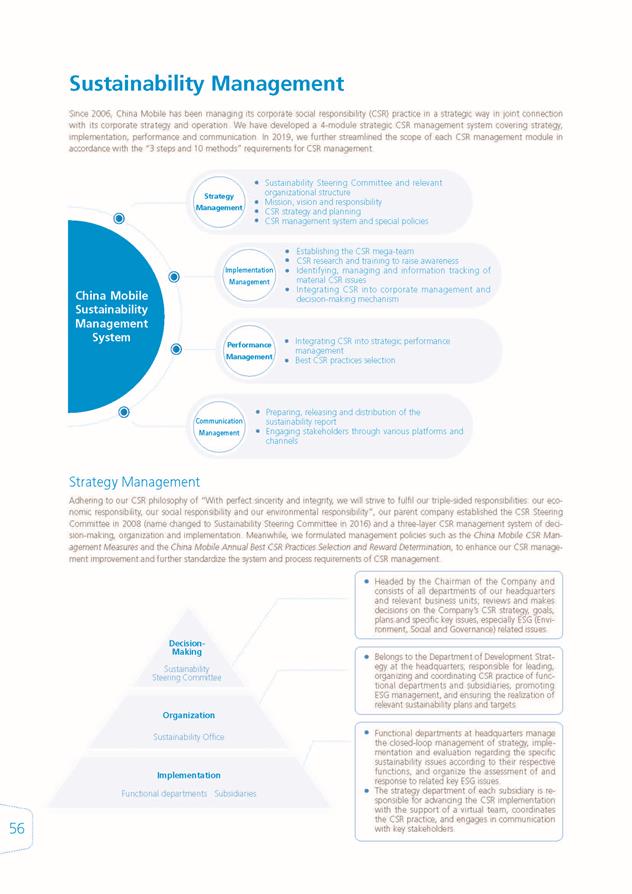
56 Sustainability Management Since 2006, China Mobile has been managing its corporate social responsibility (CSR) practice in a strategic way in joint connection with its corporate strategy and operation. We have developed a 4-module strategic CSR management system covering strategy, implementation, performance and communication. In 2019, we further streamlined the scope of each CSR management module in accordance with the “3 steps and 10 methods” requirements for CSR management. Strategy Management Adhering to our CSR philosophy of “With perfect sincerity and integrity, we will strive to fulfil our triple-sided responsibilities: our economic responsibility, our social responsibility and our environmental responsibility”, our parent company established the CSR Steering Committee in 2008 (name changed to Sustainability Steering Committee in 2016) and a three-layer CSR management system of decision- making, organization and implementation. Meanwhile, we formulated management policies such as the China Mobile CSR Management Measures and the China Mobile Annual Best CSR Practices Selection and Reward Determination, to enhance our CSR management improvement and further standardize the system and process requirements of CSR management. Headed by the Chairman of the Company and consists of all departments of our headquarters and relevant business units; reviews and makes decisions on the Company’s CSR strategy, goals, plans and specific key issues, especially ESG (Environment, Social and Governance) related issues. Belongs to the Department of Development Strategy at the headquarters; responsible for leading, organizing and coordinating CSR practice of functional departments and subsidiaries, promoting ESG management, and ensuring the realization of relevant sustainability plans and targets. Functional departments at headquarters manage the closed-loop management of strategy, implementation and evaluation regarding the specific sustainability issues according to their respective functions, and organize the assessment of and response to related key ESG issues. The strategy department of each subsidiary is responsible for advancing the CSR implementation with the support of a virtual team, coordinates the CSR practice, and engages in communication with key stakeholders. Integrating CSR into strategic performance management Best CSR practices selection Preparing, releasing and distribution of the sustainability report Engaging stakeholders through various platforms and channels Sustainability Steering Committee and relevant organizational structure Mission, vision and responsibility CSR strategy and planning CSR management system and special policies Establishing the CSR mega-team CSR research and training to raise awareness Identifying, managing and information tracking of material CSR issues Integrating CSR into corporate management and decision-making mechanism Strategy Management Implementation Management Performance Management Communication Management China Mobile Sustainability Management System Decision- Making Organization Implementation Sustainability Steering Committee Sustainability Office Functional departments Subsidiaries
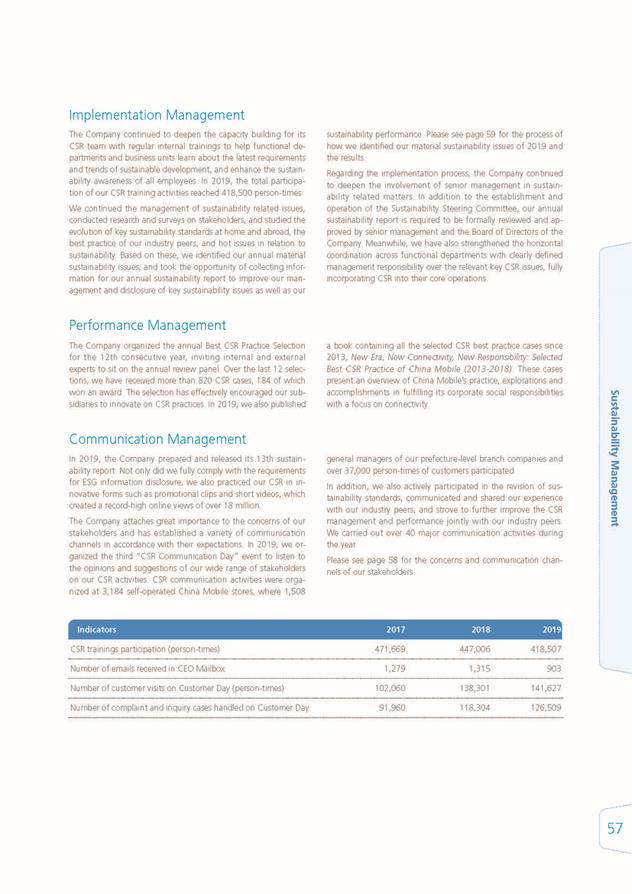
Sustainability Management 57 Implementation Management The Company continued to deepen the capacity building for its CSR team with regular internal trainings to help functional departments and business units learn about the latest requirements and trends of sustainable development, and enhance the sustainability awareness of all employees. In 2019, the total participation of our CSR training activities reached 418,500 person-times. We continued the management of sustainability related issues, conducted research and surveys on stakeholders, and studied the evolution of key sustainability standards at home and abroad, the best practice of our industry peers, and hot issues in relation to sustainability. Based on these, we identified our annual material sustainability issues, and took the opportunity of collecting information for our annual sustainability report to improve our management and disclosure of key sustainability issues as well as our Performance Management The Company organized the annual Best CSR Practice Selection for the 12th consecutive year, inviting internal and external experts to sit on the annual review panel. Over the last 12 selections, we have received more than 820 CSR cases, 184 of which won an award. The selection has effectively encouraged our subsidiaries to innovate on CSR practices. In 2019, we also published Communication Management In 2019, the Company prepared and released its 13th sustainability report. Not only did we fully comply with the requirements for ESG information disclosure, we also practiced our CSR in innovative forms such as promotional clips and short videos, which created a record-high online views of over 18 million. The Company attaches great importance to the concerns of our stakeholders and has established a variety of communication channels in accordance with their expectations. In 2019, we organized the third “CSR Communication Day” event to listen to the opinions and suggestions of our wide range of stakeholders on our CSR activities. CSR communication activities were organized at 3,184 self-operated China Mobile stores, where 1,508 Indicators 2017 2018 2019 CSR trainings participation (person-times) 471,669 447,006 418,507 Number of emails received in CEO Mailbox 1,279 1,315 903 Number of customer visits on Customer Day (person-times) 102,060 138,301 141,627 Number of complaint and inquiry cases handled on Customer Day 91,960 118,304 126,509 sustainability performance. Please see page 59 for the process of how we identified our material sustainability issues of 2019 and the results. Regarding the implementation process, the Company continued to deepen the involvement of senior management in sustainability related matters. In addition to the establishment and operation of the Sustainability Steering Committee, our annual sustainability report is required to be formally reviewed and approved by senior management and the Board of Directors of the Company. Meanwhile, we have also strengthened the horizontal coordination across functional departments with clearly defined management responsibility over the relevant key CSR issues, fully incorporating CSR into their core operations. a book containing all the selected CSR best practice cases since 2013, New Era, New Connectivity, New Responsibility: Selected Best CSR Practice of China Mobile (2013-2018). These cases present an overview of China Mobile’s practice, explorations and accomplishments in fulfilling its corporate social responsibilities with a focus on connectivity. general managers of our prefecture-level branch companies and over 37,000 person-times of customers participated. In addition, we also actively participated in the revision of sustainability standards, communicated and shared our experience with our industry peers, and strove to further improve the CSR management and performance jointly with our industry peers. We carried out over 40 major communication activities during the year. Please see page 58 for the concerns and communication channels of our stakeholders.
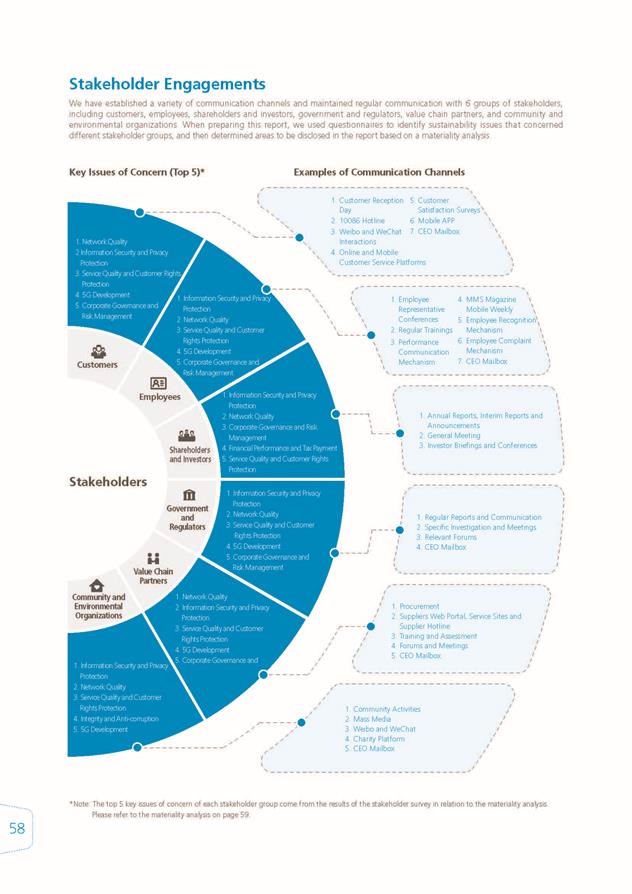
58 Stakeholder Engagements We have established a variety of communication channels and maintained regular communication with 6 groups of stakeholders, including customers, employees, shareholders and investors, government and regulators, value chain partners, and community and environmental organizations. When preparing this report, we used questionnaires to identify sustainability issues that concerned different stakeholder groups, and then determined areas to be disclosed in the report based on a materiality analysis. *Note: The top 5 key issues of concern of each stakeholder group come from the results of the stakeholder survey in relation to the materiality analysis. Please refer to the materiality analysis on page 59. Stakeholders Customers Employees Shareholders and Investors Government and Regulators Community and Environmental Organizations Value Chain Partners 1. Network Quality 2.Information Security and Privacy Protection 3. Service Quality and Customer Rights Protection 4. 5G Development 5. Corporate Governance and Risk Management 1. Information Security and Privacy Protection 2. Network Quality 3. Service Quality and Customer Rights Protection 4. 5G Development 5. Corporate Governance and Risk Management 1. Customer Reception Day 1. Employee Representative Conferences 5. Customer Satisfaction Surveys 4. MMS Magazine Mobile Weekly 2. 10086 Hotline 2. Regular Trainings 6. Mobile APP 5. Employee Recognition Mechanism 3. Weibo and WeChat Interactions 3. Performance Communication Mechanism 7. CEO Mailbox 6. Employee Complaint Mechanism 7. CEO Mailbox 4. Online and Mobile Customer Service Platforms Key Issues of Concern (Top 5)* Examples of Communication Channels 1. Information Security and Privacy Protection 2. Network Quality 3. Corporate Governance and Risk Management 4. Financial Performance and Tax Payment 5. Service Quality and Customer Rights Protection 1. Information Security and Privacy Protection 2. Network Quality 3. Service Quality and Customer Rights Protection 4. 5G Development 5. Corporate Governance and Risk Management 1. Network Quality 2. Information Security and Privacy Protection 3. Service Quality and Customer Rights Protection 4. 5G Development 5. Corporate Governance and 1. Information Security and Privacy Protection 2. Network Quality 3. Service Quality and Customer Rights Protection 4. Integrity and Anti-corruption 5. 5G Development 1. Annual Reports, Interim Reports and Announcements 2. General Meeting 3. Investor Briefings and Conferences 1. Regular Reports and Communication 2. Specific Investigation and Meetings 3. Relevant Forums 4. CEO Mailbox 1. Procurement 2. Suppliers Web Portal, Service Sites and Supplier Hotline 3. Training and Assessment 4. Forums and Meetings 5. CEO Mailbox 1. Community Activities 2. Mass Media 3. Weibo and WeChat 4. Charity Platform 5. CEO Mailbox
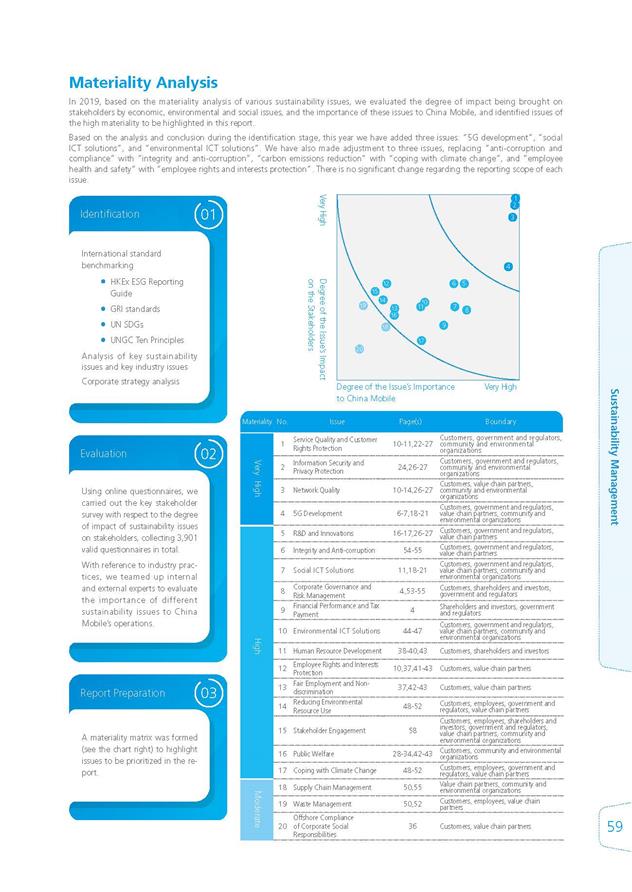
Degree of the Issue’s Impact on the Stakeholders 59 Materiality Analysis In 2019, based on the materiality analysis of various sustainability issues, we evaluated the degree of impact being brought on stakeholders by economic, environmental and social issues, and the importance of these issues to China Mobile, and identified issues of the high materiality to be highlighted in this report. Based on the analysis and conclusion during the identification stage, this year we have added three issues: “5G development”, “social ICT solutions”, and “environmental ICT solutions”. We have also made adjustment to three issues, replacing “anti-corruption and compliance” with “integrity and anti-corruption”, “carbon emissions reduction” with “coping with climate change”, and “employee health and safety” with “employee rights and interests protection”. There is no significant change regarding the reporting scope of each issue. Using online questionnaires, we carried out the key stakeholder survey with respect to the degree of impact of sustainability issues on stakeholders, collecting 3,901 valid questionnaires in total. With reference to industry practices, we teamed up internal and external experts to evaluate the importance of different sustainability issues to China Mobile’s operations. A materiality matrix was formed (see the chart right) to highlight issues to be prioritized in the report. Identification 01 Evaluation Report Preparation Materiality No. Issue Page(s) Boundary 1 Service Quality and Customer Rights Protection 10-11,22-27 Customers, government and regulators, community and environmental organizations 2 Information Security and Privacy Protection 24,26-27 Customers, government and regulators, community and environmental organizations 3 Network Quality 10-14,26-27 Customers, value chain partners, community and environmental organizations 4 5G Development 6-7,18-21 Customers, government and regulators, value chain partners, community and environmental organizations 5 R&D and Innovations 16-17,26-27 Customers, government and regulators, value chain partners 6 Integrity and Anti-corruption 54-55 Customers, government and regulators, value chain partners 7 Social ICT Solutions 11,18-21 Customers, government and regulators, value chain partners, community and environmental organizations 8 Corporate Governance and Risk Management 4,53-55 Customers, shareholders and investors, government and regulators 9 Financial Performance and Tax Payment 4 Shareholders and investors, government and regulators 10 Environmental ICT Solutions 44-47 Customers, government and regulators, value chain partners, community and environmental organizations 11 Human Resource Development 38-40,43 Customers, shareholders and investors 12 Employee Rights and Interests Protection 10,37,41-43 Customers, value chain partners 13 Fair Employment and Nondiscrimination 37,42-43 Customers, value chain partners 14 Reducing Environmental Resource Use 48-52 Customers, employees, government and regulators, value chain partners 15 Stakeholder Engagement 58 Customers, employees, shareholders and investors, government and regulators, value chain partners, community and environmental organizations 16 Public Welfare 28-34,42-43 Customers, community and environmental organizations 17 Coping with Climate Change 48-52 Customers, employees, government and regulators, value chain partners 18 Supply Chain Management 50,55 Value chain partners, community and environmental organizations 19 Waste Management 50,52 Customers, employees, value chain partners 20 Offshore Compliance of Corporate Social Responsibilities 36 Customers, value chain partners Very High Very High 1 2 3 4 6 5 7 8 9 10 11 12 13 14 15 16 19 18 20 17 HKEx ESG Reporting Guide GRI standards UN SDGs UNGC Ten Principles International standard benchmarking Analysis of key sustainability issues and key industry issues Corporate strategy analysis Degree of the Issue’s Importance to China Mobile Very High High Moderate Sustainability Management 02 03
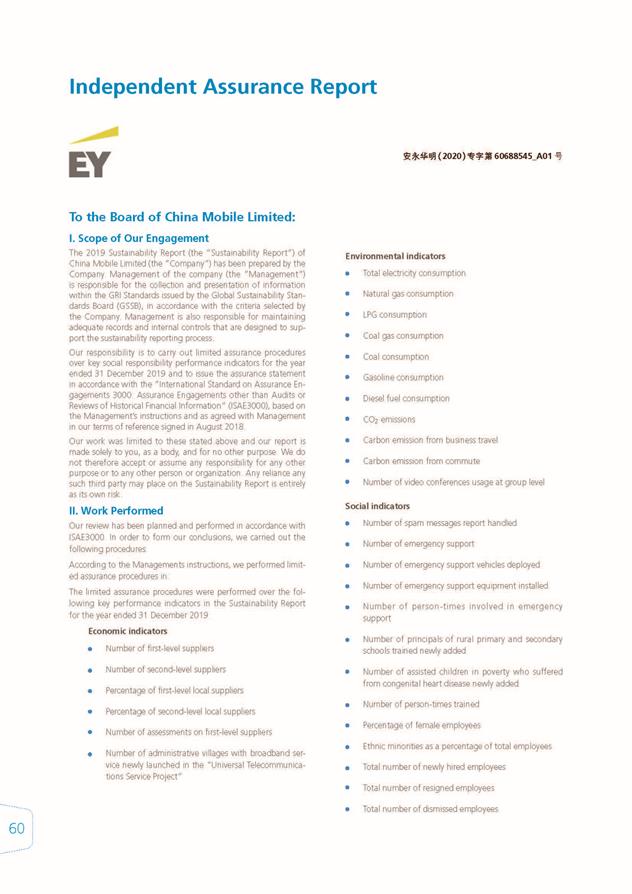
60 Independent Assurance Report To the Board of China Mobile Limited: I. Scope of Our Engagement The 2019 Sustainability Report (the ”Sustainability Report”) of China Mobile Limited (the ”Company”) has been prepared by the Company. Management of the company (the ”Management”) is responsible for the collection and presentation of information within the GRI Standards issued by the Global Sustainability Standards Board (GSSB), in accordance with the criteria selected by the Company. Management is also responsible for maintaining adequate records and internal controls that are designed to support the sustainability reporting process. Our responsibility is to carry out limited assurance procedures over key social responsibility performance indicators for the year ended 31 December 2019 and to issue the assurance statement in accordance with the ”International Standard on Assurance Engagements 3000: Assurance Engagements other than Audits or Reviews of Historical Financial Information” (ISAE3000), based on the Management’s instructions and as agreed with Management in our terms of reference signed in August 2018. Our work was limited to these stated above and our report is made solely to you, as a body, and for no other purpose. We do not therefore accept or assume any responsibility for any other purpose or to any other person or organization. Any reliance any such third party may place on the Sustainability Report is entirely as its own risk. II. Work Performed Our review has been planned and performed in accordance with ISAE3000. In order to form our conclusions, we carried out the following procedures: According to the Managements instructions, we performed limited assurance procedures in: The limited assurance procedures were performed over the following key performance indicators in the Sustainability Report for the year ended 31 December 2019: Number of first-level suppliers Number of second-level suppliers Percentage of first-level local suppliers Percentage of second-level local suppliers Number of assessments on first-level suppliers Number of administrative villages with broadband service newly launched in the ”Universal Telecommunications Service Project” Economic indicators Total electricity consumption Natural gas consumption LPG consumption Coal gas consumption Coal consumption Gasoline consumption Diesel fuel consumption CO2 emissions Carbon emission from business travel Carbon emission from commute Number of video conferences usage at group level Number of spam messages report handled Number of emergency support Number of emergency support vehicles deployed Number of emergency support equipment installed Number of person-times involved in emergency support Number of principals of rural primary and secondary schools trained newly added Number of assisted children in poverty who suffered from congenital heart disease newly added Number of person-times trained Percentage of female employees Ethnic minorities as a percentage of total employees Total number of newly hired employees Total number of resigned employees Total number of dismissed employees Environmental indicators 安永華明(2020)專字第60688545_A01 號 Social indicators
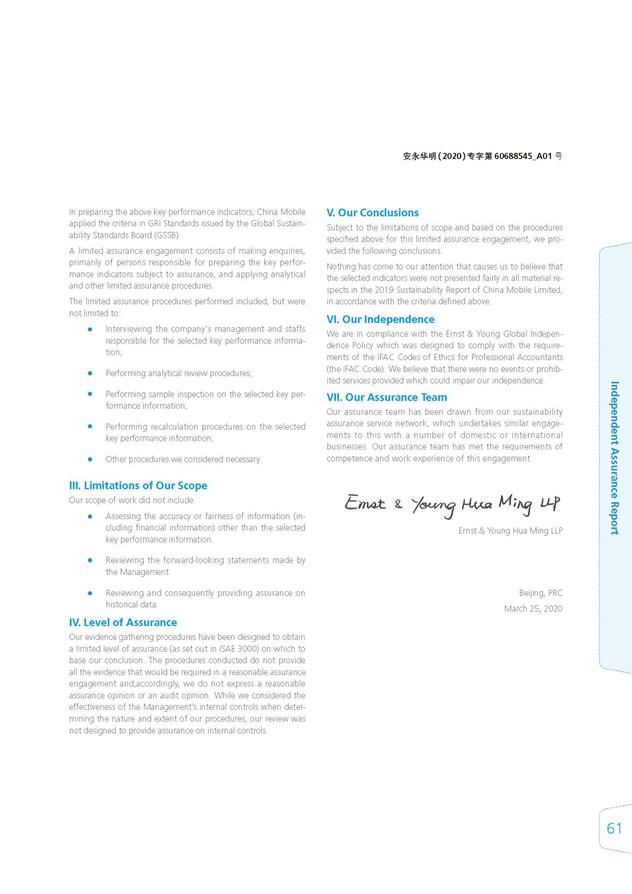
Independent Assurance Report 61 Interviewing the company's management and staffs responsible for the selected key performance information; Performing analytical review procedures; Performing sample inspection on the selected key performance information; Performing recalculation procedures on the selected key performance information; Other procedures we considered necessary. Assessing the accuracy or fairness of information (including financial information) other than the selected key performance information. Reviewing the forward-looking statements made by the Management. Reviewing and consequently providing assurance on historical data. 安永華明(2020)專字第60688545_A01 號 In preparing the above key performance indicators, China Mobile applied the criteria in GRI Standards issued by the Global Sustainability Standards Board (GSSB). A limited assurance engagement consists of making enquiries, primarily of persons responsible for preparing the key performance indicators subject to assurance, and applying analytical and other limited assurance procedures. The limited assurance procedures performed included, but were not limited to: III. Limitations of Our Scope Our scope of work did not include: IV. Level of Assurance Our evidence gathering procedures have been designed to obtain a limited level of assurance (as set out in ISAE 3000) on which to base our conclusion. The procedures conducted do not provide all the evidence that would be required in a reasonable assurance engagement and,accordingly, we do not express a reasonable assurance opinion or an audit opinion. While we considered the effectiveness of the Management’s internal controls when determining the nature and extent of our procedures, our review was not designed to provide assurance on internal controls. VI. Our Independence We are in compliance with the Ernst & Young Global Independence Policy which was designed to comply with the requirements of the IFAC Codes of Ethics for Professional Accountants (the IFAC Code). We believe that there were no events or prohibited services provided which could impair our independence. VII. Our Assurance Team Our assurance team has been drawn from our sustainability assurance service network, which undertakes similar engagements to this with a number of domestic or international businesses. Our assurance team has met the requirements of competence and work experience of this engagement. Ernst & Young Hua Ming LLP Beijing, PRC March 25, 2020 V. Our Conclusions Subject to the limitations of scope and based on the procedures specified above for this limited assurance engagement, we provided the following conclusions: Nothing has come to our attention that causes us to believe that the selected indicators were not presented fairly in all material respects in the 2019 Sustainability Report of China Mobile Limited, in accordance with the criteria defined above.
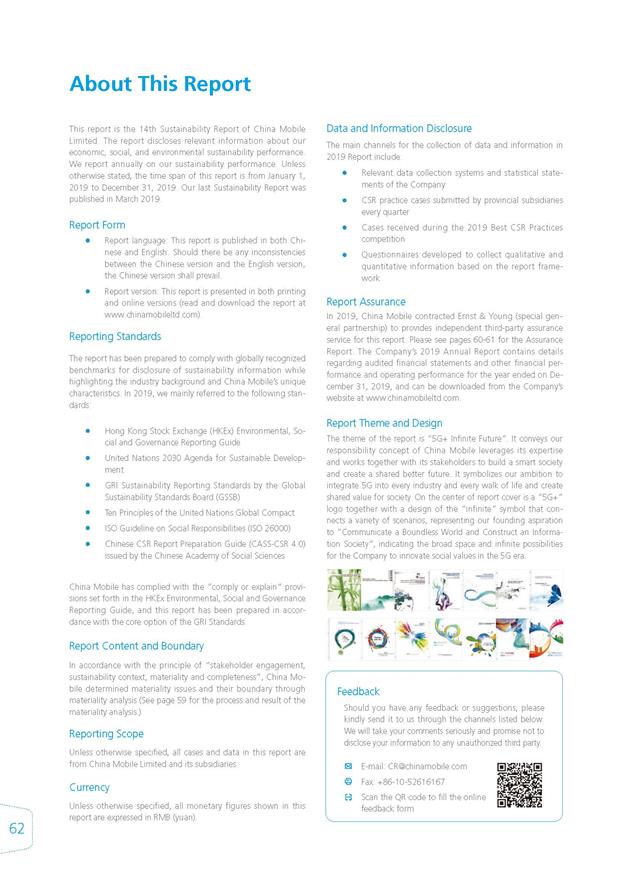
62 About This Report This report is the 14th Sustainability Report of China Mobile Limited. The report discloses relevant information about our economic, social, and environmental sustainability performance. We report annually on our sustainability performance. Unless otherwise stated, the time span of this report is from January 1, 2019 to December 31, 2019. Our last Sustainability Report was published in March 2019. Report Form Report language: This report is published in both Chinese and English. Should there be any inconsistencies between the Chinese version and the English version, the Chinese version shall prevail. Report version: This report is presented in both printing and online versions (read and download the report at www.chinamobileltd.com). Reporting Standards The report has been prepared to comply with globally recognized benchmarks for disclosure of sustainability information while highlighting the industry background and China Mobile’s unique characteristics. In 2019, we mainly referred to the following standards: China Mobile has complied with the ”comply or explain” provisions set forth in the HKEx Environmental, Social and Governance Reporting Guide, and this report has been prepared in accordance with the core option of the GRI Standards. Hong Kong Stock Exchange (HKEx) Environmental, Social and Governance Reporting Guide United Nations 2030 Agenda for Sustainable Development GRI Sustainability Reporting Standards by the Global Sustainability Standards Board (GSSB) Ten Principles of the United Nations Global Compact ISO Guideline on Social Responsibilities (ISO 26000) Chinese CSR Report Preparation Guide (CASS-CSR 4.0) issued by the Chinese Academy of Social Sciences Report Content and Boundary In accordance with the principle of ”stakeholder engagement, sustainability context, materiality and completeness”, China Mobile determined materiality issues and their boundary through materiality analysis (See page 59 for the process and result of the materiality analysis.) Reporting Scope Unless otherwise specified, all cases and data in this report are from China Mobile Limited and its subsidiaries. Data and Information Disclosure Currency Report Assurance The main channels for the collection of data and information in 2019 Report include: Relevant data collection systems and statistical statements of the Company CSR practice cases submitted by provincial subsidiaries every quarter Cases received during the 2019 Best CSR Practices competition Questionnaires developed to collect qualitative and quantitative information based on the report framework Unless otherwise specified, all monetary figures shown in this report are expressed in RMB (yuan). In 2019, China Mobile contracted Ernst & Young (special general partnership) to provides independent third-party assurance service for this report. Please see pages 60-61 for the Assurance Report. The Company’s 2019 Annual Report contains details regarding audited financial statements and other financial performance and operating performance for the year ended on December 31, 2019, and can be downloaded from the Company’s website at www.chinamobileltd.com. Report Theme and Design The theme of the report is ”5G+ Infinite Future”. It conveys our responsibility concept of China Mobile leverages its expertise and works together with its stakeholders to build a smart society and create a shared better future. It symbolizes our ambition to integrate 5G into every industry and every walk of life and create shared value for society. On the center of report cover is a ”5G+” logo together with a design of the ”infinite” symbol that connects a variety of scenarios, representing our founding aspiration to ”Communicate a Boundless World and Construct an Information Society”, indicating the broad space and infinite possibilities for the Company to innovate social values in the 5G era. Feedback Should you have any feedback or suggestions, please kindly send it to us through the channels listed below. We will take your comments seriously and promise not to disclose your information to any unauthorized third party. E-mail: [email protected] Fax: +86-10-52616167 Scan the QR code to fill the online feedback form
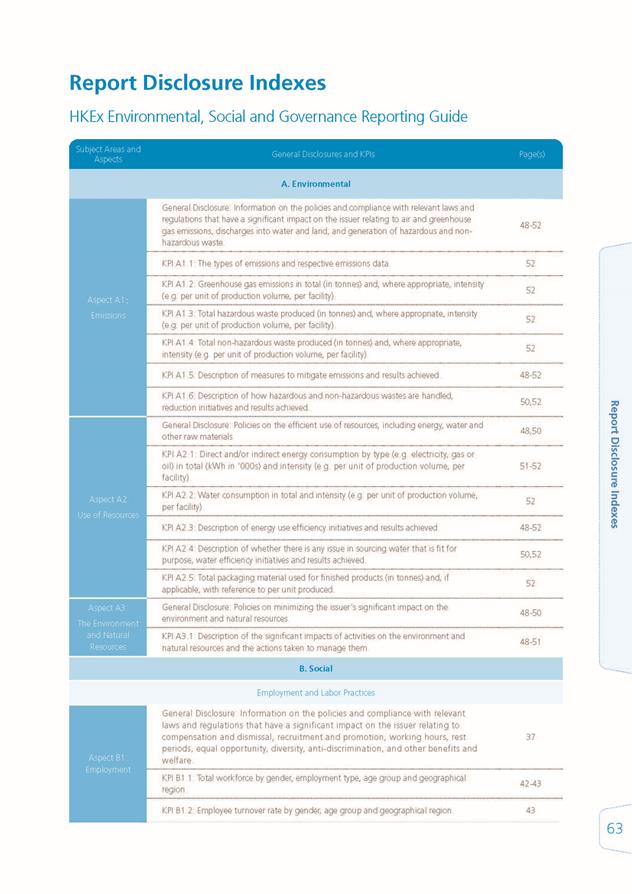
Subject Areas and Aspects General Disclosures and KPIs Page(s) A. Environmental Aspect A1: Emissions General Disclosure: Information on the policies and compliance with relevant laws and regulations that have a significant impact on the issuer relating to air and greenhouse gas emissions, discharges into water and land, and generation of hazardous and nonhazardous waste. 48-52 KPI A1.1: The types of emissions and respective emissions data. 52 KPI A1.2: Greenhouse gas emissions in total (in tonnes) and, where appropriate, intensity (e.g. per unit of production volume, per facility). 52 KPI A1.3: Total hazardous waste produced (in tonnes) and, where appropriate, intensity (e.g. per unit of production volume, per facility). 52 KPI A1.4: Total non-hazardous waste produced (in tonnes) and, where appropriate, intensity (e.g. per unit of production volume, per facility). 52 KPI A1.5: Description of measures to mitigate emissions and results achieved. 48-52 KPI A1.6: Description of how hazardous and non-hazardous wastes are handled, reduction initiatives and results achieved. 50,52 Aspect A2: Use of Resources General Disclosure: Policies on the efficient use of resources, including energy, water and other raw materials. 48,50 KPI A2.1: Direct and/or indirect energy consumption by type (e.g. electricity, gas or oil) in total (kWh in '000s) and intensity (e.g. per unit of production volume, per facility). 51-52 KPI A2.2: Water consumption in total and intensity (e.g. per unit of production volume, per facility). 52 KPI A2.3: Description of energy use efficiency initiatives and results achieved. 48-52 KPI A2.4: Description of whether there is any issue in sourcing water that is fit for purpose, water efficiency initiatives and results achieved. 50,52 KPI A2.5: Total packaging material used for finished products (in tonnes) and, if applicable, with reference to per unit produced. 52 Aspect A3: The Environment and Natural Resources General Disclosure: Policies on minimizing the issuer's significant impact on the environment and natural resources. 48-50 KPI A3.1: Description of the significant impacts of activities on the environment and natural resources and the actions taken to manage them. 48-51 B. Social Employment and Labor Practices Aspect B1: Employment General Disclosure: Information on the policies and compliance with relevant laws and regulations that have a significant impact on the issuer relating to compensation and dismissal, recruitment and promotion, working hours, rest periods, equal opportunity, diversity, anti-discrimination, and other benefits and welfare. 37 KPI B1.1: Total workforce by gender, employment type, age group and geographical region. 42-43 KPI B1.2: Employee turnover rate by gender, age group and geographical region. 43 63 Report Disclosure Indexes Report Disclosure Indexes HKEx Environmental, Social and Governance Reporting Guide
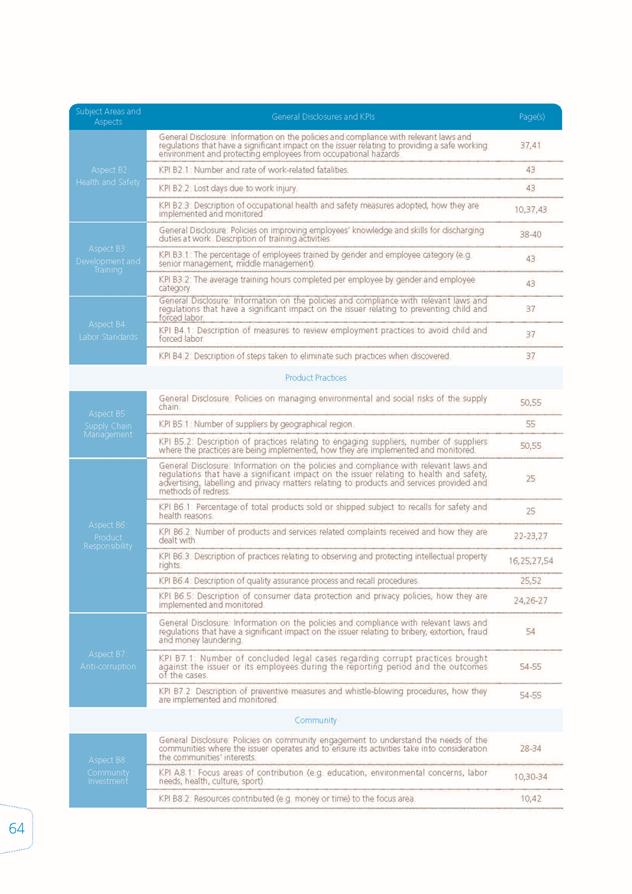
64 Subject Areas and Aspects General Disclosures and KPIs Page(s) Aspect B2: Health and Safety General Disclosure: Information on the policies and compliance with relevant laws and regulations that have a significant impact on the issuer relating to providing a safe working environment and protecting employees from occupational hazards. 37,41 KPI B2.1: Number and rate of work-related fatalities. 43 KPI B2.2: Lost days due to work injury. 43 KPI B2.3: Description of occupational health and safety measures adopted, how they are implemented and monitored. 10,37,43 Aspect B3: Development and Training General Disclosure: Policies on improving employees' knowledge and skills for discharging duties at work. Description of training activities. 38-40 KPI B3.1: The percentage of employees trained by gender and employee category (e.g. senior management, middle management). 43 KPI B3.2: The average training hours completed per employee by gender and employee category. 43 Aspect B4: Labor Standards General Disclosure: Information on the policies and compliance with relevant laws and regulations that have a significant impact on the issuer relating to preventing child and forced labor. 37 KPI B4.1: Description of measures to review employment practices to avoid child and forced labor. 37 KPI B4.2: Description of steps taken to eliminate such practices when discovered. 37 Product Practices Aspect B5: Supply Chain Management General Disclosure: Policies on managing environmental and social risks of the supply chain. 50,55 KPI B5.1: Number of suppliers by geographical region. 55 KPI B5.2: Description of practices relating to engaging suppliers, number of suppliers where the practices are being implemented, how they are implemented and monitored. 50,55 Aspect B6: Product Responsibility General Disclosure: Information on the policies and compliance with relevant laws and regulations that have a significant impact on the issuer relating to health and safety, advertising, labelling and privacy matters relating to products and services provided and methods of redress. 25 KPI B6.1: Percentage of total products sold or shipped subject to recalls for safety and health reasons. 25 KPI B6.2: Number of products and services related complaints received and how they are dealt with. 22-23,27 KPI B6.3: Description of practices relating to observing and protecting intellectual property rights. 16,25,27,54 KPI B6.4: Description of quality assurance process and recall procedures. 25,52 KPI B6.5: Description of consumer data protection and privacy policies, how they are implemented and monitored. 24,26-27 Aspect B7: Anti-corruption General Disclosure: Information on the policies and compliance with relevant laws and regulations that have a significant impact on the issuer relating to bribery, extortion, fraud and money laundering. 54 KPI B7.1: Number of concluded legal cases regarding corrupt practices brought against the issuer or its employees during the reporting period and the outcomes of the cases. 54-55 KPI B7.2: Description of preventive measures and whistle-blowing procedures, how they are implemented and monitored. 54-55 Community Aspect B8: Community Investment General Disclosure: Policies on community engagement to understand the needs of the communities where the issuer operates and to ensure its activities take into consideration the communities' interests. 28-34 KPI A8.1: Focus areas of contribution (e.g. education, environmental concerns, labor needs, health, culture, sport). 10,30-34 KPI B8.2: Resources contributed (e.g. money or time) to the focus area. 10,42
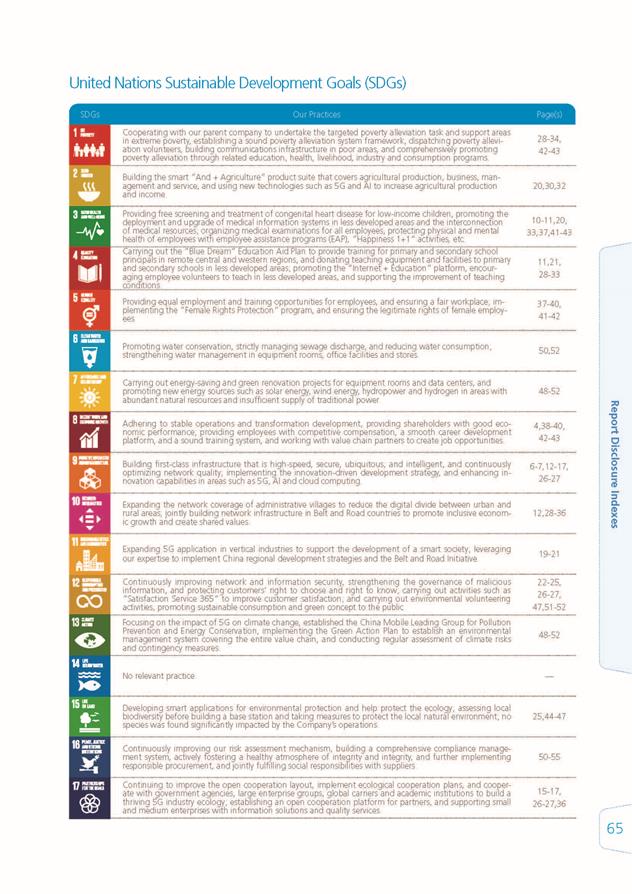
65 United Nations Sustainable Development Goals (SDGs) SDGs Our Practices Page(s) Cooperating with our parent company to undertake the targeted poverty alleviation task and support areas in extreme poverty, establishing a sound poverty alleviation system framework, dispatching poverty alleviation volunteers, building communications infrastructure in poor areas, and comprehensively promoting poverty alleviation through related education, health, livelihood, industry and consumption programs. 28-34, 42-43 Building the smart ”And + Agriculture” product suite that covers agricultural production, business, management and service, and using new technologies such as 5G and AI to increase agricultural production and income. 20,30,32 Providing free screening and treatment of congenital heart disease for low-income children, promoting the deployment and upgrade of medical information systems in less developed areas and the interconnection of medical resources; organizing medical examinations for all employees, protecting physical and mental health of employees with employee assistance programs (EAP), ”Happiness 1+1” activities, etc. 10-11,20, 33,37,41-43 Carrying out the ”Blue Dream” Education Aid Plan to provide training for primary and secondary school principals in remote central and western regions, and donating teaching equipment and facilities to primary and secondary schools in less developed areas; promoting the ”Internet + Education” platform, encouraging employee volunteers to teach in less developed areas, and supporting the improvement of teaching conditions. 11,21, 28-33 Providing equal employment and training opportunities for employees, and ensuring a fair workplace; implementing the ”Female Rights Protection” program, and ensuring the legitimate rights of female employees. 37-40, 41-42 Promoting water conservation, strictly managing sewage discharge, and reducing water consumption; strengthening water management in equipment rooms, office facilities and stores. 50,52 Carrying out energy-saving and green renovation projects for equipment rooms and data centers, and promoting new energy sources such as solar energy, wind energy, hydropower and hydrogen in areas with abundant natural resources and insufficient supply of traditional power. 48-52 Adhering to stable operations and transformation development, providing shareholders with good economic performance; providing employees with competitive compensation, a smooth career development platform, and a sound training system, and working with value chain partners to create job opportunities. 4,38-40, 42-43 Building first-class infrastructure that is high-speed, secure, ubiquitous, and intelligent, and continuously optimizing network quality; implementing the innovation-driven development strategy, and enhancing innovation capabilities in areas such as 5G, AI and cloud computing. 6-7,12-17, 26-27 Expanding the network coverage of administrative villages to reduce the digital divide between urban and rural areas; jointly building network infrastructure in Belt and Road countries to promote inclusive economic growth and create shared values. 12,28-36 Expanding 5G application in vertical industries to support the development of a smart society; leveraging our expertise to implement China regional development strategies and the Belt and Road Initiative. 19-21 Continuously improving network and information security, strengthening the governance of malicious information, and protecting customers’ right to choose and right to know; carrying out activities such as ”Satisfaction Service 365” to improve customer satisfaction; and carrying out environmental volunteering activities, promoting sustainable consumption and green concept to the public. 22-25, 26-27, 47,51-52 Focusing on the impact of 5G on climate change, established the China Mobile Leading Group for Pollution Prevention and Energy Conservation, implementing the Green Action Plan to establish an environmental management system covering the entire value chain, and conducting regular assessment of climate risks and contingency measures. 48-52 No relevant practice. — Developing smart applications for environmental protection and help protect the ecology; assessing local biodiversity before building a base station and taking measures to protect the local natural environment; no species was found significantly impacted by the Company’s operations. 25,44-47 Continuously improving our risk assessment mechanism, building a comprehensive compliance management system, actively fostering a healthy atmosphere of integrity and integrity, and further implementing responsible procurement, and jointly fulfilling social responsibilities with suppliers. 50-55 Continuing to improve the open cooperation layout, implement ecological cooperation plans, and cooperate with government agencies, large enterprise groups, global carriers and academic institutions to build a thriving 5G industry ecology; establishing an open cooperation platform for partners, and supporting small and medium enterprises with information solutions and quality services. 15-17, 26-27,36 Report Disclosure Indexes1 2 3 4 5 6 7 8 9 10 11 12 13 14 15 16 17
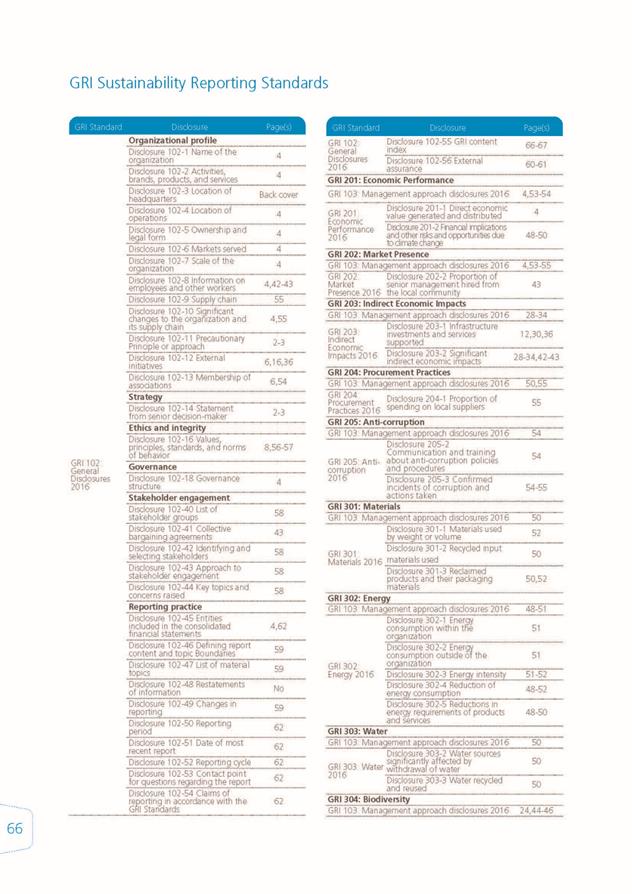
66 GRI Sustainability Reporting Standards GRI Standard Disclosure Page(s) GRI 102: General Disclosures 2016 Organizational profile Disclosure 102-1 Name of the organization 4 Disclosure 102-2 Activities, brands, products, and services 4 Disclosure 102-3 Location of headquarters Back cover Disclosure 102-4 Location of operations 4 Disclosure 102-5 Ownership and legal form 4 Disclosure 102-6 Markets served 4 Disclosure 102-7 Scale of the organization 4 Disclosure 102-8 Information on employees and other workers 4,42-43 Disclosure 102-9 Supply chain 55 Disclosure 102-10 Significant changes to the organization and its supply chain 4,55 Disclosure 102-11 Precautionary Principle or approach 2-3 Disclosure 102-12 External initiatives 6,16,36 Disclosure 102-13 Membership of associations 6,54 Strategy Disclosure 102-14 Statement from senior decision-maker 2-3 Ethics and integrity Disclosure 102-16 Values, principles, standards, and norms of behavior 8,56-57 Governance Disclosure 102-18 Governance structure 4 Stakeholder engagement Disclosure 102-40 List of stakeholder groups 58 Disclosure 102-41 Collective bargaining agreements 43 Disclosure 102-42 Identifying and selecting stakeholders 58 Disclosure 102-43 Approach to stakeholder engagement 58 Disclosure 102-44 Key topics and concerns raised 58 Reporting practice Disclosure 102-45 Entities included in the consolidated financial statements 4,62 Disclosure 102-46 Defining report content and topic Boundaries 59 Disclosure 102-47 List of material topics 59 Disclosure 102-48 Restatements of information No Disclosure 102-49 Changes in reporting 59 Disclosure 102-50 Reporting period 62 Disclosure 102-51 Date of most recent report 62 Disclosure 102-52 Reporting cycle 62 Disclosure 102-53 Contact point for questions regarding the report 62 Disclosure 102-54 Claims of reporting in accordance with the GRI Standards 62 GRI Standard Disclosure Page(s) GRI 102: General Disclosures 2016 Disclosure 102-55 GRI content index 66-67 Disclosure 102-56 External assurance 60-61 GRI 201: Economic Performance GRI 103: Management approach disclosures 2016 4,53-54 GRI 201: Economic Performance 2016 Disclosure 201-1 Direct economic value generated and distributed 4 Disclosure 201-2 Financial implications and other risks and opportunities due to climate change 48-50 GRI 202: Market Presence GRI 103: Management approach disclosures 2016 4,53-55 GRI 202: Market Presence 2016 Disclosure 202-2 Proportion of senior management hired from the local community 43 GRI 203: Indirect Economic Impacts GRI 103: Management approach disclosures 2016 28-34 GRI 203: Indirect Economic Impacts 2016 Disclosure 203-1 Infrastructure investments and services supported 12,30,36 Disclosure 203-2 Significant indirect economic impacts 28-34,42-43 GRI 204: Procurement Practices GRI 103: Management approach disclosures 2016 50,55 GRI 204: Procurement Practices 2016 Disclosure 204-1 Proportion of spending on local suppliers 55 GRI 205: Anti-corruption GRI 103: Management approach disclosures 2016 54 GRI 205: Anticorruption 2016 Disclosure 205-2 Communication and training about anti-corruption policies and procedures 54 Disclosure 205-3 Confirmed incidents of corruption and actions taken 54-55 GRI 301: Materials GRI 103: Management approach disclosures 2016 50 GRI 301: Materials 2016 Disclosure 301-1 Materials used by weight or volume 52 Disclosure 301-2 Recycled input materials used 50 Disclosure 301-3 Reclaimed products and their packaging materials 50,52 GRI 302: Energy GRI 103: Management approach disclosures 2016 48-51 GRI 302: Energy 2016 Disclosure 302-1 Energy consumption within the organization 51 Disclosure 302-2 Energy consumption outside of the organization 51 Disclosure 302-3 Energy intensity 51-52 Disclosure 302-4 Reduction of energy consumption 48-52 Disclosure 302-5 Reductions in energy requirements of products and services 48-50 GRI 303: Water GRI 103: Management approach disclosures 2016 50 GRI 303: Water 2016 Disclosure 303-2 Water sources significantly affected by withdrawal of water 50 Disclosure 303-3 Water recycled and reused 50 GRI 304: Biodiversity GRI 103: Management approach disclosures 2016 24,44-46
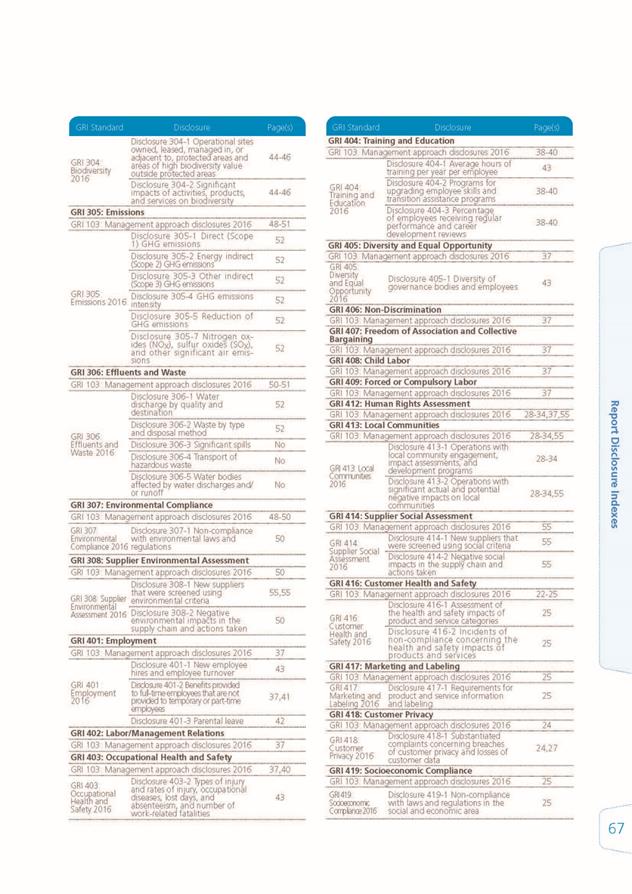
67 GRI Standard Disclosure Page(s) GRI 304: Biodiversity 2016 Disclosure 304-1 Operational sites owned, leased, managed in, or adjacent to, protected areas and areas of high biodiversity value outside protected areas 44-46 Disclosure 304-2 Significant impacts of activities, products, and services on biodiversity 44-46 GRI 305: Emissions GRI 103: Management approach disclosures 2016 48-51 GRI 305: Emissions 2016 Disclosure 305-1 Direct (Scope 1) GHG emissions 52 Disclosure 305-2 Energy indirect (Scope 2) GHG emissions 52 Disclosure 305-3 Other indirect (Scope 3) GHG emissions 52 Disclosure 305-4 GHG emissions intensity 52 Disclosure 305-5 Reduction of GHG emissions 52 Disclosure 305-7 Nitrogen oxides (NOX), sulfur oxides (SOX), and other significant air emissions 52 GRI 306: Effluents and Waste GRI 103: Management approach disclosures 2016 50-51 GRI 306: Effluents and Waste 2016 Disclosure 306-1 Water discharge by quality and destination 52 Disclosure 306-2 Waste by type and disposal method 52 Disclosure 306-3 Significant spills No Disclosure 306-4 Transport of hazardous waste No Disclosure 306-5 Water bodies affected by water discharges and/ or runoff No GRI 307: Environmental Compliance GRI 103: Management approach disclosures 2016 48-50 GRI 307: Environmental Compliance 2016 Disclosure 307-1 Non-compliance with environmental laws and regulations 50 GRI 308: Supplier Environmental Assessment GRI 103: Management approach disclosures 2016 50 GRI 308: Supplier Environmental Assessment 2016 Disclosure 308-1 New suppliers that were screened using environmental criteria 55,55 Disclosure 308-2 Negative environmental impacts in the supply chain and actions taken 50 GRI 401: Employment GRI 103: Management approach disclosures 2016 37 GRI 401: Employment 2016 Disclosure 401-1 New employee hires and employee turnover 43 Disclosure 401-2 Benefits provided to full-time employees that are not provided to temporary or part-time employees 37,41 Disclosure 401-3 Parental leave 42 GRI 402: Labor/Management Relations GRI 103: Management approach disclosures 2016 37 GRI 403: Occupational Health and Safety GRI 103: Management approach disclosures 2016 37,40 GRI 403: Occupational Health and Safety 2016 Disclosure 403-2 Types of injury and rates of injury, occupational diseases, lost days, and absenteeism, and number of work-related fatalities 43 GRI Standard Disclosure Page(s) GRI 404: Training and Education GRI 103: Management approach disclosures 2016 38-40 GRI 404: Training and Education 2016 Disclosure 404-1 Average hours of training per year per employee 43 Disclosure 404-2 Programs for upgrading employee skills and transition assistance programs 38-40 Disclosure 404-3 Percentage of employees receiving regular performance and career development reviews 38-40 GRI 405: Diversity and Equal Opportunity GRI 103: Management approach disclosures 2016 37 GRI 405: Diversity and Equal Opportunity 2016 Disclosure 405-1 Diversity of governance bodies and employees 43 GRI 406: Non-Discrimination GRI 103: Management approach disclosures 2016 37 GRI 407: Freedom of Association and Collective Bargaining GRI 103: Management approach disclosures 2016 37 GRI 408: Child Labor GRI 103: Management approach disclosures 2016 37 GRI 409: Forced or Compulsory Labor GRI 103: Management approach disclosures 2016 37 GRI 412: Human Rights Assessment GRI 103: Management approach disclosures 2016 28-34,37,55 GRI 413: Local Communities GRI 103: Management approach disclosures 2016 28-34,55 GRI 413: Local Communities 2016 Disclosure 413-1 Operations with local community engagement, impact assessments, and development programs 28-34 Disclosure 413-2 Operations with significant actual and potential negative impacts on local communities 28-34,55 GRI 414: Supplier Social Assessment GRI 103: Management approach disclosures 2016 55 GRI 414: Supplier Social Assessment 2016 Disclosure 414-1 New suppliers that were screened using social criteria 55 Disclosure 414-2 Negative social impacts in the supply chain and actions taken 55 GRI 416: Customer Health and Safety GRI 103: Management approach disclosures 2016 22-25 GRI 416: Customer Health and Safety 2016 Disclosure 416-1 Assessment of the health and safety impacts of product and service categories 25 Disclosure 416-2 Incidents of non-compliance concerning the health and safety impacts of products and services 25 GRI 417: Marketing and Labeling GRI 103: Management approach disclosures 2016 25 GRI 417: Marketing and Labeling 2016 Disclosure 417-1 Requirements for product and service information and labeling 25 GRI 418: Customer Privacy GRI 103: Management approach disclosures 2016 24 GRI 418: Customer Privacy 2016 Disclosure 418-1 Substantiated complaints concerning breaches of customer privacy and losses of customer data 24,27 GRI 419: Socioeconomic Compliance GRI 103: Management approach disclosures 2016 25 GRI 419: Socioeconomic Compliance 2016 Disclosure 419-1 Non-compliance with laws and regulations in the social and economic area 25 Report Disclosure Indexes

68 No. Index Page(s) Human Rights Principle 1 Businesses should support and respect the protection of internationally proclaimed human rights 28-34,37,55 Principle 2 Make sure that they are not complicit in human rights abuses 28-34,37,55 Labor Standards Principle 3 Businesses should uphold the freedom of association and the effective recognition of the right to collective bargaining 37 Principle 4 The elimination of all forms of forced and compulsory Labor 37 Principle 5 The effective abolition of child labor 37 Principle 6 The elimination of discrimination in respect of employment and occupation 37 Environmental Principle 7 Businesses should support a precautionary approach to environmental challenges 48-50 Principle 8 Undertake initiatives to promote greater environmental responsibility 44-50 Principle 9 Encourage the development and diffusion of environmentally friendly technologies 44-47 Anti-Corruption Principle 10 Businesses should work against corruption in all its forms, including extortion and bribery 54 Ten Principles of the United Nations Global Compact ISO 26000 Core Issues Index Page(s) Organization Governance 4,53 Human Rights 1. Due diligence 53-54 2. Human rights risk situations 28-34,37,55 3. Avoidance of complicity 54-55 4. Resolving grievances 54-55 5. Discrimination and vulnerable groups 28-34,37 6. Civil and political rights 37 7. Economic, social and cultural rights 19-21,41 8. Fundamental principles and rights at work 38-41 Labor Practices 1. Employment and employment relationships 38-41 2. Conditions of work and social protection 37,41 3. Social dialogue 37 4. Health and safety at work 37,41,43 5. Human development and training in the workplace 38-40,43 Environmental 1. Prevention of pollution 48-52 2. Sustainable resource use 46-52 3. Climate change mitigation and adaptation 48-52 4. Protection of the environment, biodiversity and restoration of natural homes 44-45 Core Issues Index Page(s) Fair Operating Practice 1. Anti-corruption 54-55 2. Responsible political involvement — 3. Fair competition 54 4. Promoting social responsibility in the value chain 50,55 5. Respect for property rights 16-17,27,54 Consumer Issues 1. Fair marketing, factual and unbiased information and fair contractual practices 25,54 2. Protecting consumers’ health and safety 24-25 3. Sustainable consumption 47 4. Consumer service, support and compliant and dispute resolution 22-23,27 5. Consumer data protection and privacy 24 6. Access to essential services 22-25 7. Education and awareness 22-25 Community Involvement and Development 1. Community involvement 28-34 2. Education and culture 28-34,37- 40,42-43 3. Employment creation and skills development 30-32,37- 40,42 4. Technology development and access 16-17,27 5. Wealth and income creation 4,42 6. Health 28-29,33,37, 41-43 7. Social investment 28-34,42
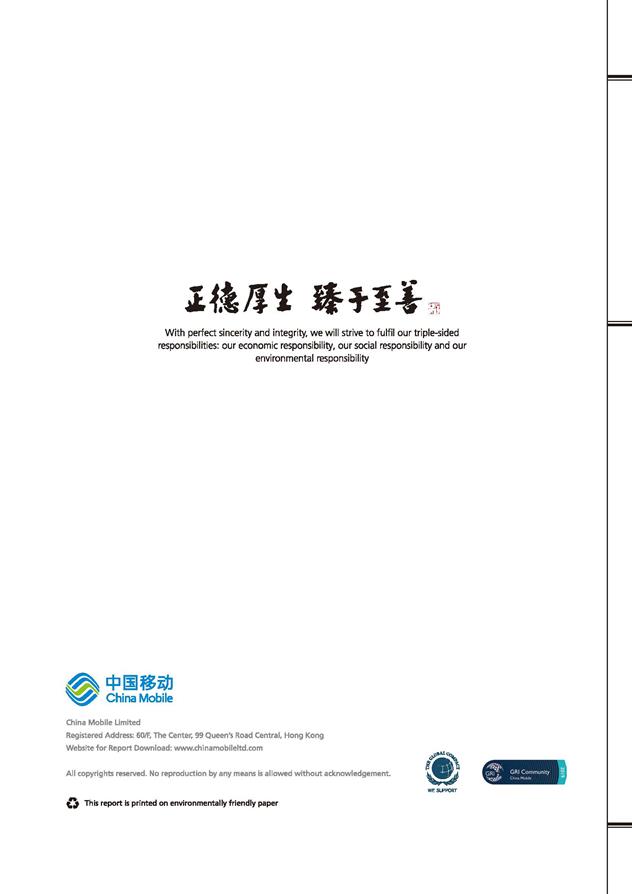
With perfect sincerity and integrity, we will strive to fulfil our triple-sided responsibilities: our economic responsibility, our social responsibility and our environmental responsibility china mobile china mobile limited registered address: 60/f, the center, 99 queen’s road central, hong kong website for report download: www.chinamobileltd.com all copyrights reserved. No reproduction by any means is allowed without acknowledgement. The global compact we support gri gri community 2019 this report is printed on environmentally friendly paper
Exhibit 3.1
Hong Kong Exchanges and Clearing Limited and The Stock Exchange of Hong Kong Limited take no responsibility for the contents of this announcement, make no representation as to its accuracy or completeness and expressly disclaim any liability whatsoever for any loss howsoever arising from or in reliance upon the whole or any part of the contents of this announcement.

NOTICE OF THE ANNUAL GENERAL MEETING
|
IMPORTANT NOTICE
In light of the epidemic situation of COVID-19 and to safeguard shareholders’ health and safety, the Company encourages shareholders to consider appointing the chairman of the annual general meeting as his/her proxy to vote on the resolutions, instead of attending the annual general meeting in person.
In accordance with the Joint Statement in relation to General Meetings in light of the Prevention and Control of Disease (Prohibition on Group Gathering) Regulation issued by the Securities and Futures Commission of Hong Kong and the Stock Exchange on 1 April 2020, the Company will take all practicable precautions to ensure the health and safety of shareholders attending the annual general meeting, including but not limited to mandatory screening of body temperatures, requiring attendees to bring and wear their own surgical masks, physical distancing, no beverage service, no handing out of gifts, restricting the number of non-shareholder attendees, and prohibiting persons under quarantine or in contravention of the above precautions from entering the venue. The directors of the Company may attend the annual general meeting remotely through video or telephone conference facilities.
The Company will continue to monitor the epidemic situation of COVID-19 and may alter the annual general meeting arrangements at short notice. Shareholders are advised to check any future announcement(s) which the Company may publish on the websites of the Stock Exchange and the Company. |
- 1 -
Notice is hereby given that the Annual General Meeting of China Mobile Limited (the “Company”) will be held in the Conference Room, JW Marriott Hotel Hong Kong, Pacific Place, 88 Queensway, Hong Kong on Wednesday, 20 May 2020 at 10:00 a.m. for the following purposes:
|
|
1. |
To receive and consider the audited financial statements and the Reports of the Directors and Auditors of the Company and its subsidiaries for the year ended 31 December 2019. |
|
|
2. |
To declare a final dividend for the year ended 31 December 2019. |
|
|
3. |
To re-elect executive director. |
|
|
4. |
To re-elect independent non-executive directors. |
|
|
5. |
To re-appoint PricewaterhouseCoopers and PricewaterhouseCoopers Zhong Tian LLP as the auditors of the Group for Hong Kong financial reporting and U.S. financial reporting purposes, respectively, and to authorize the Board of Directors of the Company (the “Board”) to fix their remuneration. |
And to consider and, if thought fit, to pass the following as ordinary resolutions:
ORDINARY RESOLUTIONS
|
|
6. |
“THAT: |
|
|
(a) |
subject to paragraph (b) below, the exercise by the Board during the Relevant Period (as defined below) of all the powers of the Company to buy back shares in the capital of the Company including any form of depositary receipt representing the right to receive such shares (“ Shares ”) be and is hereby generally and unconditionally approved; |
|
|
(b) |
the aggregate number of Shares which may be bought back on The Stock Exchange of Hong Kong Limited (the “Stock Exchange”) or any other stock exchange on which securities of the Company may be listed and which is recognized for this purpose by the Securities and Futures Commission of Hong Kong and the Stock Exchange pursuant to the approval in paragraph (a) above shall not exceed or represent more than 10 per cent. of the number of issued shares of the Company at the date of passing this resolution, and the said approval shall be limited accordingly; |
|
|
(c) |
for the purpose of this resolution “Relevant Period” means the period from the passing of this resolution until whichever is the earlier of: |
|
|
(1) |
the conclusion of the next annual general meeting of the Company; or |
|
|
(2) |
the expiration of the period within which the next annual general meeting of the Company is required by law to be held; or |
|
|
(3) |
the revocation or variation of the authority given under this resolution by ordinary resolution of the shareholders of the Company in general meeting.” |
- 2 -
|
|
(a) |
20 per cent. of the number of issued shares of the Company at the date of passing this resolution, plus |
|
|
(b) |
(if the Board are so authorized by a separate ordinary resolution of the shareholders of the Company) the number of Shares bought back by the Company subsequent to the passing of this resolution (up to a maximum equivalent to 10 per cent. of the number of issued shares of the Company at the date of passing this resolution). |
Such mandate shall expire at the earlier of:
|
|
(1) |
the conclusion of the next annual general meeting of the Company; or |
|
|
(2) |
the expiration of the period within which the next annual general meeting of the Company is required by law to be held; or |
|
|
(3) |
the date of any revocation or variation of the mandate given under this resolution by ordinary resolution of the shareholders of the Company at a general meeting.” |
|
|
8. |
“THAT the Board be and are hereby authorized to exercise the powers of the Company referred to in the resolution set out in item 7 in the notice of the annual general meeting in respect of the shares of the Company referred to in paragraph (b) of such resolution.” |
|
|
9. |
“THAT conditional on the Stock Exchange granting approval of the listing of and permission to deal in shares of the Company which fall to be allotted and issued (the “Option Shares”) pursuant to the exercise of any share options granted (the “Share Options”) under the share option scheme proposed to be adopted by the Company (the “Share Option Scheme”), the Share Option Scheme be and is hereby approved to be a share option scheme for the Company and the Board (or a duly authorized committee thereof or such other committee as the Board may authorize) be and is hereby authorized to do all such acts and to enter into all such transactions, arrangements and agreements as may be necessary or desirable in order to give full effect to the Share Option Scheme, including but not limited to: |
|
|
(a) |
granting Share Options during the term of the Share Option Scheme and cancelling Share Options in accordance with the terms of the Share Option Scheme; |
|
|
(b) |
allotting and issuing Option Shares pursuant to the exercise of Share Options in accordance with the terms of the Share Option Scheme; |
- 3 -
|
|
(d) |
applying at the appropriate time or times to the Stock Exchange for approval of the listing of and permission to deal in all or part of the Option Shares; and |
|
|
(e) |
acting as the executive body of the Share Option Scheme, and being responsible for its implementation and administration.” |
By Order of the Board
China Mobile Limited
Wong Wai Lan, Grace
Company Secretary
14 April 2020
Notes:
|
|
1. |
Any member entitled to attend and vote at the annual general meeting is entitled to appoint one or, if he is the holder of two or more shares, more proxies to attend and, on a poll, vote in his stead. A proxy need not be a member of the Company. |
|
|
2. |
In order to be valid, a form of proxy together with the power of attorney or other authority (if any) under which it is signed, or a notarially certified copy thereof, must be deposited at the Company’s registered office at 60/F, The Center, 99 Queen’s Road Central, Hong Kong at least 24 hours before the time for holding the annual general meeting. Completion and return of a form of proxy will not preclude a member from attending and voting in person if he is subsequently able to be present. |
|
|
3. |
The Board has recommended a final dividend of HK$1.723 per share for the year ended 31 December 2019 and, if such dividend is declared by the members passing resolution number 2, it is expected to be paid on or about Tuesday, 23 June 2020 to those shareholders whose names appear on the Company’s register of members on Friday, 29 May 2020. Shareholders should read the announcement issued by the Company on 19 March 2020 regarding the closure of register of members and the withholding and payment of enterprise income tax for non-resident enterprises in respect of the proposed 2019 final dividend. |
|
|
4. |
To ascertain shareholders’ eligibility to attend and vote at the annual general meeting, the register of members of the Company will be closed from Thursday, 14 May 2020 to Wednesday, 20 May 2020 (both days inclusive), during which period no transfer of shares in the Company will be effected. In order to be entitled to attend and vote at the annual general meeting, all transfers, accompanied by the relevant share certificates, must be lodged with the Company’s share registrar, Hong Kong Registrars Limited, at Shops 1712–1716, 17th Floor, Hopewell Centre, 183 Queen’s Road East, Wan Chai, Hong Kong, not later than 4:30 p.m. on Wednesday, 13 May 2020. |
To ascertain shareholders’ entitlement to the proposed final dividend upon passing resolution number 2, the register of members of the Company will be closed from Wednesday, 27 May 2020 to Friday, 29 May 2020 (both days inclusive), during which period no transfer of shares in the Company will be effected. In order to qualify for the proposed final dividend, all transfers, accompanied by the relevant share certificates, must be lodged with the Company’s share registrar, Hong Kong Registrars Limited, at Shops 1712–1716, 17th Floor, Hopewell Centre, 183 Queen’s Road East, Wan Chai, Hong Kong, not later than 4:30 p.m. on Tuesday, 26 May 2020.
- 4 -
|
|
5. |
Concerning resolution number 6 above, the Board wish to state that the Board will exercise the powers conferred thereby to buy back shares of the Company in circumstances which they deem appropriate for the benefit of the shareholders. The explanatory statement containing the information necessary to enable the shareholders to make an informed decision on whether to vote for or against the resolution to approve the buy-back by the Company of its own shares, as required by the Listing Rules, is set out in a separate circular to be despatched to shareholders together with the 2019 Annual Report. |
|
|
6. |
Concerning resolution number 9 above, a summary of the principle terms of the Share Option Scheme and other information required by the Listing Rules are set out in a separate circular titled “Proposed Adoption of Share Option Scheme” to be despatched to shareholders together with the 2019 Annual Report. |
|
|
7. |
In light of the epidemic situation of COVID-19 and to safeguard shareholders’ health and safety, shareholders may consider appointing the chairman of the annual general meeting as his/her proxy to vote on the resolutions, instead of attending the annual general meeting in person. |
As at the date of this announcement, the Board of Directors of the Company comprises Mr. Yang Jie, Mr. Wang Yuhang and Mr. Dong Xin as executive directors and Dr. Moses Cheng Mo Chi, Mr. Paul Chow Man Yiu, Mr. Stephen Yiu Kin Wah and Dr. Yang Qiang as independent non-executive directors.
- 5 -
Exhibit 4.1
THIS CIRCULAR IS IMPORTANT AND REQUIRES YOUR IMMEDIATE ATTENTION
Hong Kong Exchanges and Clearing Limited and The Stock Exchange of Hong Kong Limited take no responsibility for the contents of this document, make no representation as to its accuracy or completeness and expressly disclaim any liability whatsoever for any loss howsoever arising from or in reliance upon the whole or any part of the contents of this document.
If you are in any doubt as to any aspect of this document, you should consult your licensed securities dealer, bank manager, solicitor, professional accountant or other professional adviser.

|
Executive Directors: YANG Jie (Chairman) WANG Yuhang |
|
Registered Office: 60th Floor The Center |
|
DONG Xin |
|
99 Queen’s Road Central |
|
|
|
Hong Kong |
|
Independent Non-executive Directors: |
|
|
|
Moses CHENG Mo Chi |
|
|
|
Paul CHOW Man Yiu Stephen YIU Kin Wah YANG Qiang |
|
14 April 2020 |
To the Shareholders
Dear Sir or Madam,
|
|
1. |
BUY-BACK MANDATE |
This is the explanatory statement required to be sent to shareholders under the Rules Governing the Listing of Securities (the “Listing Rules”) on The Stock Exchange of Hong Kong Limited (the “Stock Exchange”) in connection with the proposed ordinary resolution set out in item 6 of the notice of the annual general meeting dated 14 April 2020 (the “AGM Notice”) for the approval of the renewal of the general mandate for buy-back of shares. This document also constitutes the memorandum required under section 239 of the Companies Ordinance (Chapter 622 of the Laws of Hong Kong). Reference in this document to “Shares” means share(s) of all classes in the capital of China Mobile Limited (the “Company”).
Exercise of the Buy-back Mandate
Whilst the board of directors of the Company (the “Board”) do not presently intend to buy back any Shares immediately, they believe that the flexibility afforded by the mandate granted to them if the ordinary resolution set out in item 6 of the AGM Notice (the “Buy-back Mandate”) is passed would be beneficial to the Company and its shareholders as a whole.
It is proposed that up to 10 per cent. of the number of issued Shares on the date of the passing of the resolution to approve the Buy-back Mandate may be bought back. As at 25 March 2020, the latest practicable date for determining such figures, 20,475,482,897 Shares were issued. On the basis of such figures, the Board would be authorised to buy back up to 2,047,548,289 Shares during the period up to the date of the next annual general meeting in 2021, or
- 1 -
the expiration of the period within which the next annual general meeting of the Company is required by law to be held, or the revocation or variation of the Buy-back Mandate by an ordinary resolution of the shareholders at a general meeting of the Company, whichever of these three events occurs first.
Reasons for Buy-backs
Buy-backs of Shares will only be made when the Board believes that such a buy-back will benefit the Company and its shareholders. Such buy-backs may, depending on the market conditions and funding arrangements at the time, lead to an enhancement of the net value of the Company and its assets and/or its earnings per Share.
Funding of Buy-backs
Buy-backs pursuant to the Buy-back Mandate would be financed entirely from the Company’s available cash flow or working capital facilities. Any buy-backs will be made out of funds of the Company legally permitted to be utilised in this connection in accordance with its articles of association and the laws of Hong Kong, including distributable profits. Under the Companies Ordinance, a company’s distributable profits, in relation to the making of a payment by the company, are those profits out of which the company could lawfully make a distribution equal in value to the payment.
There might be a material adverse impact on the working capital or gearing position of the Company (as compared with the position disclosed in its most recent published audited accounts for the year ended 31 December 2019 dated 19 March 2020) in the event that the Buy-back Mandate is exercised in full. However, the Board does not propose to exercise the Buy-back Mandate to such an extent as would, in the circumstances, have a material adverse effect on the working capital requirements of the Company or the gearing levels which in the opinion of the Board are from time to time appropriate for the Company.
Disclosure of Interests
None of the directors of the Company, and to the best of their knowledge, having made all reasonable enquiries, none of their associates, have any present intention, if the Buy-back Mandate is approved by the shareholders of the Company, to sell any Shares to the Company or its subsidiaries.
No core connected persons (as defined in the Listing Rules) have notified the Company that they have a present intention to sell Shares to the Company, nor have they undertaken not to do so, if the Buy-back Mandate is approved by the shareholders of the Company.
Directors’ Undertaking
The Board has undertaken to the Stock Exchange that, so far as the same may be applicable, it will exercise the Buy-back Mandate in accordance with the Listing Rules and the applicable laws of Hong Kong.
Share Buy-backs Made by the Company
No buy-backs of Shares have been made by the Company during the last six months (whether on the Stock Exchange or otherwise).
Takeovers Code Consequences
If as a result of a buy-back of Shares by the Company, a shareholder’s proportionate interest in the voting rights of the Company increases, such increase will be treated as an acquisition for the purpose of the Hong Kong Code on Takeovers and Mergers (the “Takeovers Code”). As a result, a shareholder, or group of shareholders acting in concert, depending on the level of increase of its or their shareholding, could obtain or consolidate control of the Company and become obliged to
- 2 -
make a mandatory offer in accordance with Rule 26 of the Takeovers Code. The Board is aware of the consequences arising under the Takeovers Code of any buy-back.
As at 25 March 2020 (being the latest practicable date prior to the printing of this document), the immediate controlling shareholder of the Company, China Mobile Hong Kong (BVI) Limited (“CMHKBVI”), was recorded in the registers required to be kept by the Company under section 336 of the Securities and Futures Ordinance (Chapter 571 of the Laws of Hong Kong) (the “SFO”) as having an interest in 14,890,116,842 Shares, representing approximately 72.72 per cent. of the number of issued shares of the Company as at that date. In the event that the Buy-back Mandate is exercised in full and assuming that there is no change in the number of Shares held by CMHKBVI, the shareholding of CMHKBVI in the Company will be increased to approximately 80.80 per cent. of the reduced number of issued shares of the Company immediately after the exercise in full of the Buy-back Mandate. The Board is not aware of any consequences in relation to CMHKBVI which would arise under the Takeovers Code as a result of such share buy-back by the Company. In addition, in exercising the Buy-back Mandate (whether in full or otherwise), the Board will ensure that the Company shall comply with the requirements of the Listing Rules, including the minimum percentage of Shares being held in public hands.
Market Prices
The highest and lowest prices at which the Shares have traded on the Stock Exchange during each of the previous 12 months before the latest practicable date prior to the printing of this document were:
|
|
|
Traded Market Price |
|
|||||
|
|
|
Highest |
|
|
Lowest |
|
||
|
|
|
HK$ |
|
|
HK$ |
|
||
|
2019 |
|
|
|
|
|
|
|
|
|
March |
|
|
87.70 |
|
|
|
79.70 |
|
|
April |
|
|
81.00 |
|
|
|
73.50 |
|
|
May |
|
|
74.65 |
|
|
|
68.45 |
|
|
June |
|
|
71.50 |
|
|
|
68.00 |
|
|
July |
|
|
71.80 |
|
|
|
66.50 |
|
|
August |
|
|
68.10 |
|
|
|
62.05 |
|
|
September |
|
|
67.80 |
|
|
|
63.80 |
|
|
October |
|
|
66.85 |
|
|
|
63.60 |
|
|
November |
|
|
65.30 |
|
|
|
58.85 |
|
|
December |
|
|
66.20 |
|
|
|
58.30 |
|
|
|
|
|
|
|
|
|
|
|
|
2020 |
|
|
|
|
|
|
|
|
|
January |
|
|
70.00 |
|
|
|
62.60 |
|
|
February |
|
|
67.85 |
|
|
|
60.85 |
|
|
March (up to and including 25 March 2020) |
|
|
62.80 |
|
|
|
45.20 |
|
Extension of Share Issue Mandate
A resolution as set out in item 8 of the AGM Notice will also be proposed at the annual general meeting authorising the Board to increase the maximum number of new Shares which may be issued under the general mandate for the issuance and allotment of Shares by adding to it the number of any Shares bought back pursuant to the Buy-back Mandate.
|
|
2. |
RE-ELECTION OF DIRECTORS |
Pursuant to Article 99 of the Company’s Articles of Association, Mr. WANG Yuhang will hold office until the forthcoming annual general meeting of the Company and will then be eligible for re-election. Besides, pursuant to Article 95 of the Company’s Articles of Association, Mr. Paul CHOW Man Yiu and Mr. Stephen YIU Kin Wah will retire by rotation at the forthcoming annual general meeting of the Company and, being eligible, offer themselves for re-election.
- 3 -
The biographies of the directors proposed for re-election at the forthcoming annual general meeting (“Directors for Re-election”) are set out in Appendix I to this document. Except as disclosed in such biographies, the Directors for Re-election have not held any other directorships in any listed public companies in the last three years. Further, except as noted in the biographies, none of the Directors for Re-election is connected with any directors, senior management or substantial or controlling shareholders of the Company. None of the Directors for Re-election has any interests in the shares of the Company within the meaning of Part XV of the SFO.
The service contracts of all the Directors for Re-election do not provide for a specified length of service and each of such directors will be subject to retirement by rotation and re-election at annual general meetings of the Company every three years. Each of the Directors for Re-election is entitled to an annual director’s fee of HK$180,000 as proposed by the Board and approved by the shareholders of the Company. Director’s fees are payable on a time pro-rata basis for any non-full year’s service. Mr. WANG Yuhang has voluntarily waived his annual director’s fees. The remuneration of the Directors for Re-election has been determined with reference to the individual’s duties, responsibilities and experience, and to prevailing market conditions.
None of the Directors for Re-election has an unexpired service contract which is not determinable by the Company or any of its subsidiaries within one year without payment of compensation, other than under normal statutory obligations.
Save as disclosed above, there are no other matters relating to the re-election of the Directors for Re-election that need to be brought to the attention of the shareholders of the Company nor is there any information to be disclosed pursuant to any of the requirements of Rule 13.51(2) of the Listing Rules.
Mr. Paul CHOW Man Yiu was appointed as an independent non-executive director of the Company in May 2013 as proposed by the Nomination Committee of the Company and after review and approval by the Board. With his financial and regulatory expertise that is unique in the Board, he can contribute to the Board diversity of the Company and is a highly valued and respected member of the Board. Each year, he provided the Company with a confirmation of his independence, and the Board is of the view that he is independent. The Board believes that he will make a significant contribution to the Company with his extensive experience gained from the financial services industry as well as various listed companies, public organizations and securities regulatory bodies. Accordingly, the Board is of the view that the re-election of Mr. Paul CHOW Man Yiu as an independent non-executive director of the Company is in the interests of the Company and its shareholders as a whole.
Mr. Stephen YIU Kin Wah was appointed as an independent non-executive director of the Company in March 2017 as proposed by the Nomination Committee of the Company and after review and approval by the Board. With his accounting expertise that is unique in the Board, he can contribute to the Board diversity of the Company and is a highly valued and respected member of the Board, and is also qualified under the Listing Rules as the Chairman of the Audit Committee of the Company. Each year, he provided the Company with a confirmation of his independence, and the Board is of the view that he is independent. The Board believes that he will make a significant contribution to the Company with his extensive experience gained from the accounting profession. Accordingly, the Board is of the view that the re-election of Mr. Stephen YIU Kin Wah as an independent non-executive director of the Company is in the interests of the Company and its shareholders as a whole.
|
|
Yours faithfully |
|
|
Wong Wai Lan, Grace |
|
|
Company Secretary |
- 4 -
APPENDIX I
BIOGRAPHI E S O F T H E DIR E CT ORS PROPOS E D FOR R E - E L E CTION AT TH EFORTHCOMING ANNUAL GENERAL MEETING
EXECUTIVE DIRECTOR
MR. WANG YUHANG
Age 58, Executive Director of the Company, joined the Board of Directors of the Company in October 2019, principally in charge of human resources and inspection matters. He is also a Director of CMCC and CMC. Mr. Wang formerly served as a deputy general manager of Development Department, general manager of Supervision Department, deputy director of Supervision and Inspection Office, the chief director of Legal Center, general manager of Human Resources Department and executive vice president of China Ocean Shipping (Group) Company; a vice president of COSCO Americas Inc.; the general manager of COSCO Shipbuilding Industry Company; the general manager of COSCO Shipyard Group Co., Ltd. as well as the executive vice president of China COSCO SHIPPING Corporation Limited. Over the past three years, Mr. Wang had served as a non-executive director and vice chairman of China International Marine Containers (Group) Co., Ltd. (listed in Hong Kong and Shenzhen), a non-independent and non-executive director and the chairman of COSCO SHIPPING International (Singapore) Co., Ltd. (listed in Singapore), a non-executive director of COSCO SHIPPING Holdings Co., Ltd. (listed in Hong Kong and Shanghai), and an executive director and the chairman of COSCO SHIPPING International (Hong Kong) Co., Ltd. (listed in Hong Kong). Mr. Wang graduated from Dalian Maritime College in 1983 with a major in marine engineering management. He is a senior engineer with many years of experience in the shipping industry and in human resources and corporate management.
INDEPENDENT NON-EXECUTIVE DIRECTORS
MR. PAUL CHOW MAN YIU
Age 73, Independent Non-Executive Director of the Company, joined the Board of Directors of the Company in May 2013. He was appointed as the Chairman of the Nomination Committee in May 2016. He was the Chief Executive of the Asia Pacific Region (ex-Japan) of HSBC Asset Management (Hong Kong) Limited from 1997 to 2003, an executive director and Chief Executive of Hong Kong Exchanges and Clearing Limited from April 2003 to January 2010, the Chairman of Hong Kong Cyberport Management Company Limited from June 2010 to May 2016, an independent non-executive director of Bank of China Limited from October 2010 to August 2016, a member of the Advisory Committee on Innovation and Technology of the Government of the Hong Kong Special Administrative Region from April 2015 to March 2017 and an independent non-executive director of CITIC Limited from March 2016 to June 2019. Mr. Chow currently serves as an independent non-executive director of Julius Baer Group Ltd. and Bank Julius Baer & Co. Ltd.
MR. STEPHEN YIU KIN WAH
Age 59, Independent Non-Executive Director of the Company, joined the Board of Directors of the Company in March 2017. He was appointed as the Chairman of the Audit Committee in May 2018. Mr. Yiu is currently a Non-Executive Director of the Insurance Authority, an Independent Non-Executive Director of Hong Kong Exchanges and Clearing Limited and ANTA Sports Products Limited, a Council member of The Hong Kong University of Science and Technology, and a member of the Exchange Fund Advisory Committee of The Hong Kong Monetary Authority and ICAC Complaints Committee. Mr. Yiu joined the global accounting firm KPMG (“KPMG”) in Hong Kong in 1983 and was seconded to KPMG in London, the United Kingdom from 1987 to 1989. Mr. Yiu became a partner of KPMG in 1994, served as the Partner in Charge of Audit of KPMG from 2007 to 2010, and served as the Chairman and Chief Executive Officer of KPMG China and Hong Kong as well as a member of the Executive Committee and the Board of KPMG International and KPMG Asia Pacific from April 2011 to March 2015. Mr. Yiu formerly also served as a member of the Audit Profession Reform Advisory Committee and the Mainland Affairs Committee of the Hong Kong Institute of Certified Public Accountants. Mr. Yiu is a fellow member of the Association of Chartered Certified Accountants, a fellow member of the Hong Kong Institute of Certified Public Accountants and a member of the Institute of Chartered Accountants of England and Wales. Mr. Yiu received a professional diploma in accountancy from The Hong Kong
- 5 -
APPENDIX I
Polytechnic (now known as The Hong Kong Polytechnic University) in 1983, and holds a master’s degree in business administration from the University of Warwick in the United Kingdom.
- 6 -
Exhibit 5.1
THIS CIRCULAR IS IMPORTANT AND REQUIRES YOUR IMMEDIATE ATTENTION
Hong Kong Exchanges and Clearing Limited and The Stock Exchange of Hong Kong Limited take no responsibility for the contents of this circular, make no representation as to its accuracy or completeness and expressly disclaim any liability whatsoever for any loss howsoever arising from or in reliance upon the whole or any part of the contents of this circular.
If you are in any doubt as to any aspect of this circular, you should consult your licensed securities dealer, bank manager, solicitor, professional accountant or other professional adviser.

PROPOSED ADOPTION OF SHARE OPTION SCHEME
A letter from the Board is set out on pages 3 to 14 of this circular.
The AGM will be held on Wednesday, 20 May 2020 at 10:00 a.m. in the Conference Room, JW Marriott Hotel Hong Kong, Pacific Place, 88 Queensway, Hong Kong. A notice of the AGM is set out on pages 70 to 72 of the Company’s 2019 Annual Report. The form of proxy for use at the AGM has been despatched to the Shareholders together with the Company’s 2019 Annual Report and also published on the websites of the Stock Exchange and the Company. Whether or not you intend to attend the AGM, you are requested to complete and return the form of proxy in accordance with the instructions printed thereon. The form of proxy should be deposited at the Company’s registered office at 60/F, The Center, 99 Queen’s Road Central, Hong Kong as soon as possible and in any event not less than 24 hours before the time appointed for the AGM or any adjournment thereof. Completion and return of the form of proxy will not preclude you from attending and voting in person at the AGM or at any adjournment thereof should you so wish.
14 April 2020
DEFINITION
In this circular, unless the context otherwise requires, the expressions below shall have the following meanings:
|
“Affiliated Unit” |
one of the Company’s operating subsidiaries in 31 provinces, autonomous regions and directly-administered municipalities of the PRC and in Hong Kong, or one of the Company’s other specialised subsidiaries |
|
“AGM” |
the annual general meeting of the Company to be held on 20 May 2020 or any adjournment thereof |
|
“Articles of Association” |
the Articles of Association of the Company |
|
“Board” |
the board of Directors of the Company |
|
“Company” |
China Mobile Limited, a company incorporated in Hong Kong whose Shares are listed on the Stock Exchange and American Depositary Shares are listed on the New York Stock Exchange |
|
“Conditions for Grant” |
the conditions upon which the Company may grant Share Options to the Scheme Participants |
|
“Conditions for Vesting” |
the conditions upon which Share Options shall be vested in and become exercisable by the Scheme Participants |
|
“Director(s)” |
the director(s) of the Company |
|
“Effective Period” |
the period during which the Scheme is effective |
|
“Exercise Price” |
the price determined by the Company when granting the Share Options to the Scheme Participant(s), at which the Scheme Participant(s) subscribe for the Shares upon exercise of the Share Options |
|
“Grant” |
the granting of the Share Options under the Scheme to the Scheme Participants |
|
“Grant Date” |
a date on which the Share Options are granted to the Scheme Participant(s) by the Board pursuant to the Scheme |
|
“Hong Kong” |
the Hong Kong Special Administrative Region of the PRC |
|
“Latest Practicable Date” |
25 March 2020, being the latest practicable date prior to the printing of this circular for ascertaining certain information for inclusion herein |
|
“Listing Rules” |
the Rules Governing the Listing of Securities on The Stock Exchange of Hong Kong Limited |
|
“PRC” |
the People’s Republic of China (excluding, for the purposes of this circular, Hong Kong, the Macau Special Administrative Region and Taiwan) |
|
“SASAC” |
the State-owned Assets Supervision and Administration Commission of the State Council of the PRC |
|
“Scheme” or “Share Option Scheme” |
the share option scheme of the Company proposed to be approved by the Shareholders at the AGM, a summary of the principal terms of which is set out in this circular |
|
“Scheme Participant(s)” |
the participant(s) to the Scheme |
|
“Share Option(s)” |
the option(s) to subscribe for the Shares pursuant to the terms of the Scheme |
|
“Share(s)” |
ordinary share(s) in the issued share capital of the Company |
|
“Shareholder(s)” |
holder(s) of Share(s) |
|
“Stock Exchange” |
The Stock Exchange of Hong Kong Limited |
|
“Vesting Period” |
the period during which the Share Options shall be vested in and exercisable by the Scheme Participants |
-1-
LETTER FROM THE BOARD

|
Executive Directors: |
|
Registered Office: |
|
YANG Jie (Chairman) |
|
60th Floor |
|
WANG Yuhang |
|
The Center |
|
DONG Xin |
|
99 Queen’s Road Central |
|
|
|
Hong Kong |
|
|
|
|
|
Independent Non-executive Directors: |
|
|
|
Moses CHENG Mo Chi |
|
|
|
Paul CHOW Man Yiu |
|
|
|
Stephen YIU Kin Wah |
|
|
|
YANG Qiang |
|
|
|
|
|
|
|
|
|
|
|
|
|
14 April 2020 |
To the Shareholders
Dear Sir or Madam,
PROPOSED ADOPTION OF SHARE OPTION SCHEME
|
1. |
INTRODUCTION |
Reference is made to the announcement of the Company dated 23 January 2020 in relation to the proposed adoption of the Share Option Scheme.
The purpose of this circular is to provide you with, among other things, further details of the terms of the Share Option Scheme, and to seek your approval of the resolution relating to the Share Option Scheme to be proposed at the AGM.
|
2. |
SHARE OPTION SCHEME |
Purposes
The Share Option Scheme aims at (1) further improving the governance structure of the Company, and establishing and improving the balance of interests mechanism between employees and Shareholders, investors and the Company; (2) establishing a benefit sharing and risk sharing mechanism among Shareholders, the Company and employees to enhance the Company’s performance and long-term stable development; and (3) effectively attracting, motivating and retaining the core backbone employees of the Company to support the Company’s strategic transformation and long-term development.
Scope of Scheme Participants
Scheme Participants are in principle limited to Directors (excluding independent non-executive Directors) and senior management of the Company, and backbone management, technical and business personnel who have a direct impact on the Company’s operating performance and sustainable development. The assessment results of the Scheme Participants shall meet or exceed the relevant standards for performance appraisal of the Company.
-2-
LETTER FROM THE BOARD
A person shall not be a Scheme Participant under the Scheme if he/she falls under any of the below:
|
|
(i) |
is not an employee or staff member of the Company; |
|
|
(ii) |
is an independent non-executive Director of the Company; |
|
|
(iii) |
is a Shareholder or de facto controller of the Company individually or collectively holding over 5% of the Shares, or is his/her spouse, parent or child; |
|
|
(iv) |
has been publicly censured or declared as an ineligible candidate by securities regulatory authorities during the last three (3) years; |
|
|
(v) |
has been imposed with administrative penalties by securities regulatory authorities during the last three (3) years due to serious violations of laws or regulations; |
|
|
(vi) |
is prohibited from acting as a Director or a member of the senior management of the Company as stipulated in the PRC Company Law and/or the Companies Ordinance (Chapter 622 of the Laws of Hong Kong); |
|
|
(vii) |
is prohibited from participating in share incentive schemes of the Company as stipulated by laws and regulations; or |
|
|
(viii) |
is determined by the Board to have otherwise seriously violated the Company’s regulations. |
Matters such as the list of Scheme Participants and the number of Shares in respect of which Share Options may be granted shall be confirmed by the Remuneration Committee of the Company, and reviewed and approved by the Board.
Shares
The shares to be issued upon an exercise of the Share Options will be the ordinary shares in the Company.
Effective Period
The Scheme will be effective for a term of ten (10) years commencing from the date on which the Scheme is approved by the Shareholders at the AGM, unless terminated in advance under relevant requirements of the Scheme.
Maximum Quantity of Grant, Grant Date and Interval of Grant
Maximum Quantity of Grant
The maximum number of Shares to be issued upon the exercise of the Share Options granted under the Scheme (and any other schemes) shall not in aggregate exceed 10% of the total share capital of the Company as at the date of approval of the Scheme at the AGM. Share Options that have lapsed in accordance with the terms of the relevant scheme(s) are not counted in the calculation of the total number of the underlying Shares issued when the Share Options granted under the Scheme (and any other schemes) are exercised. By way of reference, the total share capital of the Company as at the Latest Practicable Date comprised 20,475,482,897 Shares, based on which Share Options representing a maximum of 2,047,548,289 Shares could be granted under the Scheme.
The number of Shares that may be issued upon the exercise of all granted but outstanding Share Options under the Scheme (and any other schemes) shall not exceed 30% of the total number of issued Shares at any time.
-3-
LETTER FROM THE BOARD
Unless approved at a general meeting, the Shares issued and to be issued upon the exercise of the Share Options granted to any individual Scheme Participant (including exercised or outstanding Share Options) during the Effective Period shall not exceed 1% of the total share capital of the Company.
In the event of non-market factors affecting the value of Shares such as conversion of capital reserve into new shares, issue of bonus shares, share subdivision, share consolidation or rights issue during the Effective Period, the number of Share Options to be granted will be subject to adjustments in accordance with the relevant requirements of the Scheme.
The expected return of each Scheme Participant from the Share Options granted in principle shall not exceed a certain level of his/her total salary at the time of Grant, assuming that a Grant will be conducted every two (2) years.
Grant Date
Each Grant Date shall be determined by the Board as appropriate, after the Grant proposal is considered and approved by the Board and approved by the SASAC, the Scheme is approved by the Shareholders at the AGM, and the Conditions for Grant are fulfilled.
Each Grant Date shall be a trading day, the determination of which shall comply with the relevant regulatory rules including the Listing Rules and shall not pose any significant risks (including but not limited to compliance risk) to the Company.
The Board shall not grant Share Options after becoming aware of inside information until the announcement of the relevant information. In particular, no Share Options shall be granted during the following periods:
|
|
(i) |
no Share Options shall be granted to any Scheme Participant within one (1) month before the earlier of the following dates: |
|
|
(1) |
the date of the Board meeting for the approval of any annual, half-yearly, quarterly and any other interim results of the Company (whether or not required by the Listing Rules) (being such date of the Board meeting as first notified by the Company to the Stock Exchange in accordance with the Listing Rules); and |
|
|
(2) |
the deadline for the Company to announce its annual or half-yearly results in accordance with the Listing Rules or to announce its quarterly or any other interim results (whether or not required by the Listing Rules), |
until the end of the day of the relevant results announcement; and
|
|
(ii) |
no Share Options shall be granted to any Scheme Participant who is a Director during the period of sixty (60) days immediately preceding the publication date of the Company’s annual results or, if shorter, the period from the end of the relevant financial year up to the publication date of the results. |
Interval of Grant
In principle, upon the fulfilment of the Conditions for Grant, a Grant will be conducted every two (2) years.
-4-
LETTER FROM THE BOARD
Conditions for Grant and Exercise Price
Conditions for Grant
The Company may grant Share Options to a Scheme Participant upon fulfilment of the following conditions by the Company and the Scheme Participant:
Conditions for Grant for the Company
|
|
(i) |
where the Scheme stipulates performance conditions for a Grant, no Grant shall be made unless all performance indicators meet the specified target values; and |
|
|
(ii) |
the Company is not under any circumstances prescribed in the Scheme where the Scheme shall be terminated. |
Conditions for Grant for the Scheme Participant
|
|
(i) |
according to the relevant measures for performance appraisal of the Company, the Scheme Participant should have met or exceeded the relevant performance appraisal conditions for the purpose of the Scheme in the last three (3) financial years before the Grant; and |
|
|
(ii) |
the Scheme Participant is not under any circumstances prescribed in the Scheme where he/she shall not participate in the Scheme. |
Exercise Price
The Exercise Price of the Share Options shall be determined in accordance with the fair market price principle, with the base day for pricing being the Grant Date. The Exercise Price shall not be lower than the higher of the following prices:
|
|
(i) |
the closing price of the Shares on the Grant Date; and |
|
|
(ii) |
the average closing price of the Shares on the five (5) trading days prior to the Grant Date. |
In the event of non-market factors affecting the value of Shares such as conversion of capital reserve into new shares, issue of bonus shares, share subdivision, share consolidation or rights issue during the Effective Period, the Exercise Price will be subject to adjustments in accordance with the relevant requirements of the Scheme.
No fee shall be payable by a Scheme Participant on the application for or acceptance of the grant of Share Options.
Time Limit for Exercise of Share Options
Restriction Period
No Share Options shall be exercised within twenty-four (24) months from the Grant Date.
-5-
LETTER FROM THE BOARD
In respect of each Grant, upon satisfaction of the Conditions for Vesting as provided under the Scheme, the Share Options granted shall be vested in three batches as follows:
|
|
|
Time when Vesting Period begins |
|
Time when Vesting Period ends |
|
Percentage of Share Options vested |
|
|
|
|
|
|
|
|
|
First batch |
|
The first trading day after twenty-four (24) months from the Grant Date |
|
Ten (10) years from the Grant Date |
|
40% |
|
|
|
|
|
|
|
|
|
Second batch |
|
The first trading day after thirty-six (36) months from the Grant Date |
|
Ten (10) years from the Grant Date |
|
30% |
|
|
|
|
|
|
|
|
|
Third batch |
|
The first trading day after forty-eight (48) months from the Grant Date |
|
Ten (10) years from the Grant Date |
|
30% |
Conditions for Vesting
In respect of each Scheme Participant, the vesting of Share Options under the Scheme shall be conditional upon fulfilment of the following conditions by the Company, the Affiliated Unit of the Scheme Participant (if applicable) and the Scheme Participant:
Conditions for Vesting for the Company
|
|
(i) |
where the Scheme stipulates performance conditions for vesting Share Options in each phase, no vesting shall occur unless all performance indicators meet the specified target values for that phase. Such performance conditions may include but are not limited to (1) the increase in operating revenue; (2) the level of net profit margin and the ranking as compared to certain benchmarked telecommunications operators around the world; and (3) the level of economic value added (EVA) margin (being the net operating profit after tax minus the cost of capital corresponding to the average adjusted capital (sum of equity and interest-bearing liabilities minus construction in progress), then divided by the average adjusted capital) and the ranking as compared to certain benchmarked telecommunications operators around the world; and |
|
|
(ii) |
the Company is not under any circumstances prescribed in the Scheme where the Scheme shall be terminated. |
Conditions for Vesting for the Affiliated Unit
|
|
(i) |
according to the relevant measures for performance appraisal of the Company, the vesting of Share Options is linked to the performance conditions of the Affiliated Unit, such that the level of performance determines the percentage of Share Options vested in the relevant year. Such performance conditions may include but are not limited to the annual operating performance appraisal score of the Affiliated Unit. |
-6-
LETTER FROM THE BOARD
Conditions for Vesting for the Scheme Participant
|
|
(i) |
according to the relevant measures for performance appraisal of the Company, the vesting of Share Options is linked to the individual performance appraisal rating of the Scheme Participant in the preceding financial year such that the level of individual performance appraisal rating (divided into five levels, “A”, “B”, “C”, “D” and “E”) determines the percentage of Share Options vested; and |
|
|
(ii) |
the Scheme Participant is not under any circumstances prescribed in the Scheme where he/she shall not participate in the Scheme. |
If the Conditions for Vesting are not satisfied, no Share Options shall be vested.
The specific Conditions for Vesting of the first Grant are expected to be approved by the SASAC together with the approval of the Scheme by the SASAC. The specific Conditions for Vesting of each subsequent Grant are expected to be formulated by the Board and then approved by the SASAC prior to the Grant.
Transferability of Share Options
The Share Options shall be personal to the Scheme Participants whom are granted the Share Options and shall not be transferred or used as guarantee or repayment of debts.
Rights Attaching to Share Options and Shares
The Shares allotted and issued by the Company upon the exercise of the Share Options shall be subject to all the provisions of the Articles of Association and have the same rights as the fully paid Shares that have been issued on the date of the allotment. In other words, the Shares confer the Scheme Participants the rights to receive all dividends or other distributions paid or made by the Company on or after the date of the Share allotment, but the record date for determining the dividend or distribution must be after the date of the relevant Share allotment.
The Shares allotted and issued by the Company upon the exercise of the Share Options shall carry voting rights only after the Scheme Participants or their nominees are registered as Shareholders in the register of members of the Company.
In the case of voluntary winding-up of the Company, a Scheme Participant may, within fifteen (15) business days after the passing of the relevant resolution, elect to request the Company to treat all or part of his/her unexercised Share Options (whether or not vested) as exercised, and pay to the Company the full subscription price of the relevant Shares underlying such Share Options. Upon the Company being notified, such Scheme Participant will enjoy the same rights as other Shareholders and be entitled to receive the assets distributed during the Company’s winding-up in respect of the relevant Shares, with such amount to be received equal to the amount receivable for Shares that carry voting rights.
Adjustments to Share Options
In the event of conversion of capital reserve into new shares, issue of bonus shares, share subdivision, share consolidation or rights issue of the Company, such corresponding adjustments (if any) shall be made by the Board as authorized at a general meeting to the number of Share Options and/or the Exercise Price.
In addition, in respect of any such adjustments, the auditors or an independent financial adviser of the Company must confirm to the Directors in writing that the adjustments satisfy the requirements of Rule 17.03(13) of the Listing Rules.
-7-
LETTER FROM THE BOARD
Adjustment to the Number of Share Options
Subject to compliance with the requirements of the section under “Adjustments to Share Options” in this circular, if there is any conversion of capital reserve into new shares, issue of bonus shares, share subdivision, share consolidation or rights issue prior to the exercise of the Share Options, an adjustment to the number of Share Options shall be made accordingly. The method of adjustment is set out as below:
Conversion of capital reserve into new shares, issue of bonus shares or share subdivision
Q = Q0 × (1 + n)
Where: “Q0” represents the number of Share Options before the adjustment; “n” represents the ratio per Share of the conversion of capital reserve into new shares, issue of bonus shares or share subdivision; “Q” represents the number of Share Options after the adjustment.
Share consolidation
Q = Q0 × n
Where: “Q0” represents the number of Share Options before the adjustment; “n” represents the ratio of consolidation; “Q” represents the number of Share Options after the adjustment.
Rights issue
Q = Q0 × P1 × (1 + n) ÷ (P1+ P2 × n)
Where: “Q0” represents the number of Share Options before the adjustment; “P1” represents the closing price as at the record date; “P2” represents the subscription price; “n” represents the ratio of allotment; “Q” represents the number of Share Options after the adjustment.
Adjustment to the Exercise Price
Subject to compliance with the requirements of the section under “Adjustments to Share Options” in this circular, if there is any conversion of capital reserve into new shares, issue of bonus shares, share subdivision, share consolidation or rights issue prior to the exercise of the Share Options, an adjustment to the Exercise Price shall be made accordingly. The method of adjustment is set out as below:
Conversion of capital reserve into new shares, issue of bonus shares or share subdivision
P = P0 ÷ (1 + n)
Where: “P0” represents the Exercise Price before the adjustment; “n” represents the ratio per Share of the conversion of capital reserve into new shares, issue of bonus shares or share subdivision; “P” represents the Exercise Price after the adjustment.
Share consolidation
P = P0 ÷ n
Where: “P0” represents the Exercise Price before the adjustment; “n” represents the ratio of consolidation; “P” represents the Exercise Price after the adjustment.
Rights issue
P = P0 × (P1 + P2 × n) ÷ (P1 × (1 + n))
Where: “P0” represents the Exercise Price before the adjustment; “P1” represents the closing price as at the record date; “P2” represents the subscription price; “n” represents the ratio of allotment; “P” represents the Exercise Price after the adjustment.
-8-
LETTER FROM THE BOARD
Termination of the Scheme
If any of the following events occurs in relation to the Company, the Scheme shall be terminated, and once the resolution in relation to the termination of the Scheme due to any of the following events is considered and approved by the Board, within one (1) year after the effective date of the resolution of the Board, no new Share Options shall be granted to the Scheme Participants while the Scheme Participants shall not exercise any Share Options or obtain any gains under the Scheme:
|
|
(i) |
failure to engage an auditor to carry out audit work in accordance with the relevant procedures and requirements; |
|
|
(ii) |
issue of an auditors’ report by a certified public accountant with an adverse opinion or a disclaimer of opinion with respect to the annual financial report of the Company; |
|
|
(iii) |
the SASAC or the National Audit Office of the PRC raising material objections to the financial results or the annual financial report of the Company; or |
|
|
(iv) |
imposition of penalties by the China Securities Regulatory Commission or other relevant authorities due to serious violations of the Company. |
Lapse and Cancellation of Share Options
If any of the following events occurs in relation to a Scheme Participant, his/her Share Options will automatically lapse, and the Board shall cease granting new Share Options, cancel Share Options which are not yet exercised by him/her, and recover any gains obtained by him/her from the exercise of the Share Options:
|
|
(i) |
results of economic accountability audit indicate a failure in performing his/her duties effectively or a serious breach or dereliction of his/her duties; |
|
|
(ii) |
violation of applicable PRC and/or Hong Kong laws and regulations or provisions of the Articles of Association; |
|
|
(iii) |
that the Scheme Participant, during his/her employment, has engaged in the acceptance or solicitation of bribes, corruption, theft, leaking commercial and technological secrets of the Company, conducting related party transactions to the prejudice of the interests and reputation of the Company, and other illegal behaviours having a material adverse impact on the image of the Company; or |
|
|
(iv) |
that the Scheme Participant has not performed or duly performed his/her duties, causing the Company to suffer a material loss of asset and other material adverse impact. |
Amendments to the Scheme
The Board may revise the Scheme as it considers necessary for fulfilling state-owned assets supervision procedures in accordance with laws and regulations. If the terms of the Scheme differ from the relevant laws, regulations, Listing Rules or requirements of the Stock Exchange, or the relevant laws, regulations, Listing Rules or requirements of the Stock Exchange are modified, then those relevant laws, regulations, Listing Rules or requirements of the Stock Exchange shall prevail.
Amendments to the Scheme shall be approved at a general meeting of the Company where:
|
|
(i) |
the amendments are required by the relevant documents issued by the Company or the SASAC or the relevant laws, regulations, Listing Rules or requirements of the Stock Exchange to be approved at a general meeting; |
|
|
(ii) |
the amendments relate to the matters set out in Rule 17.03 of the Listing Rules and are to the advantage of the Scheme Participants; |
|
|
(iii) |
the amendments are of a material nature or are amendments to the terms of the Share Options granted (except where amendments take effect automatically under the existing terms of the Scheme); or |
-9-
LETTER FROM THE BOARD
|
|
(iv) |
the amendments relate to the power of the Board to amend the terms of the Scheme. |
Authorization to the Board
The Board proposes to be granted the following authorization to act as the executive body of the Scheme and be responsible for its implementation and administration upon seeking approval from the Shareholders at the AGM:
|
|
(i) |
to grant Share Options to the Scheme Participants upon fulfilment of Conditions for Grant by the Company and the Scheme Participants, and to deal with all matters necessary for Grants; |
|
|
(ii) |
to formulate the Conditions for Vesting of Share Options, to review and confirm if the Company and the Scheme Participants fulfil the Conditions for Vesting, and to deal with all matters necessary for the vesting of Share Options to the Scheme Participants; |
|
|
(iii) |
to approve proposals for Grants, including but not limited to Grant Date, Exercise Price, Conditions for Grant, Conditions for Vesting and vesting arrangements; |
|
|
(iv) |
to adjust the number and price of Shares subject to the Share Options pursuant to the provisions of the Scheme upon conversion of capital reserve into new shares, issue of bonus shares, share subdivision, share consolidation or rights issue, or pursuant to ex-rights or ex-dividends arrangements in relation to the price of the Shares as stated under the Scheme; |
|
|
(v) |
to handle the matters in relation to the exercised or outstanding Share Options pursuant to the provisions of the Scheme if special circumstances stated under the Scheme (such as resignation, retirement and death of the Scheme Participants) occur; |
|
|
(vi) |
to decide pursuant to the provisions of the Scheme whether to recover the gains obtained by the Scheme Participants from the exercise of Share Options; and |
|
|
(vii) |
to administer other matters necessary for the Scheme. The Board, depending on the circumstances, may authorize the Remuneration Committee under the Board to handle some of the matters relating to the Share Options, in which case the same shall be included and explained in a resolution of the Board and the approval by the Shareholders shall be sought in relation to it. |
Application for Listing
Application will be made by the Company to the Stock Exchange for approval of the listing of, and permission to deal in, the Shares to be issued and allotted pursuant to the exercise of any Share Options granted under the Scheme.
Value of All Share Options
The Board considers that it would not be appropriate to state the value of all Share Options that may be granted under the Scheme as if they had been granted on the Latest Practicable Date because there are a number of variables which are crucial for the calculation of the value of the Share Options (including the Exercise Price and other variables). The Board believes that any calculation of the value of the Share Options as at the Latest Practicable Date based on a number of speculative assumptions would not be meaningful and would be misleading to the Shareholders.
Document Available for Inspection
A copy of the terms of the Share Option Scheme will be available for inspection during normal
-10-
LETTER FROM THE BOARD
business hours at the registered office of the Company at 60th Floor, The Center, 99 Queen’s Road Central, Hong Kong from the date of this circular to and including the date of the AGM.
|
3. |
AGM |
The AGM will be held on Wednesday, 20 May 2020 at 10:00 a.m. in the Conference Room, JW Marriott Hotel Hong Kong, Pacific Place, 88 Queensway, Hong Kong. A notice of the AGM is set out on pages 70 to 72 of the Company’s 2019 Annual Report. The form of proxy for use at the AGM has been despatched to the Shareholders together with the Company’s 2019 Annual Report and also published on the websites of the Stock Exchange and the Company.
To ascertain Shareholders’ eligibility to attend and vote at the AGM, the register of members of the Company will be closed from Thursday, 14 May 2020 to Wednesday, 20 May 2020 (both days inclusive), during which period no transfer of Shares will be effected. In order to be entitled to attend and vote at the AGM, all transfers, accompanied by the relevant share certificates, must be lodged with the Company’s share registrar, Hong Kong Registrars Limited, at Shops 1712–1716, 17th Floor, Hopewell Centre, 183 Queen’s Road East, Wan Chai, Hong Kong, not later than 4:30 p.m. on Wednesday, 13 May 2020.
Whether or not you intend to attend the AGM, you are requested to complete and return the form of proxy in accordance with the instructions printed thereon. The form of proxy should be deposited at the Company’s registered office at 60/F, The Center, 99 Queen’s Road Central, Hong Kong as soon as possible and in any event not less than 24 hours before the time appointed for the AGM or any adjournment thereof. Completion and return of the form of proxy will not preclude you from attending and voting in person at the AGM or at any adjournment thereof should you so wish, but in such event the instrument appointing a proxy shall be deemed to be revoked.
To the best of the Directors’ knowledge, information and belief, having made all reasonable enquiries, no Shareholder has a material interest in the Share Option Scheme and therefore no Shareholder is required to abstain from voting at the AGM.
|
4. |
RECOMMENDATION |
The Directors (including the independent non-executive Directors) consider that the proposed adoption of the Share Option Scheme and the proposed authorization to the Board to handle all matters in relation to the Share Option Scheme are in the best interests of the Company and the Shareholders as a whole. Accordingly, the Directors (including the independent non-executive Directors) recommend all Shareholders to vote in favour of the resolution relating to the Share Option Scheme to be proposed at the AGM.
|
5. |
RESPONSIBILITY STATEMENT |
This circular, for which the Directors collectively and individually accept full responsibility, includes particulars given in compliance with the Listing Rules for the purpose of giving information with regard to the Company. The Directors, having made all reasonable enquiries, confirm that to the best of their knowledge and belief the information contained in this circular is accurate and complete in all material respects and not misleading or deceptive, and there are no other matters the omission of which would make this circular or any statement herein misleading.
|
Yours faithfully |
|
Wong Wai Lan, Grace |
|
Company Secretary |
-11-
Serious News for Serious Traders! Try StreetInsider.com Premium Free!
You May Also Be Interested In
- Åsa Vilsson new CFO at Elanders
- Dimensional Fund Advisors Ltd. : Form 8.3 - Irish Residential Properties REIT PLC
- Company announcement no 7/2024 Annual account 2023
Create E-mail Alert Related Categories
SEC FilingsSign up for StreetInsider Free!
Receive full access to all new and archived articles, unlimited portfolio tracking, e-mail alerts, custom newswires and RSS feeds - and more!



 Tweet
Tweet Share
Share